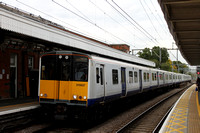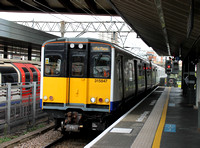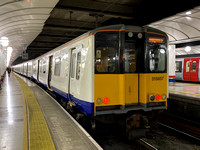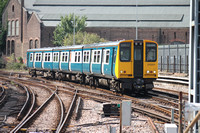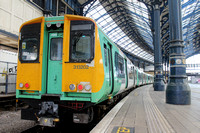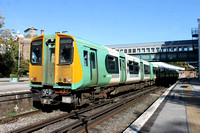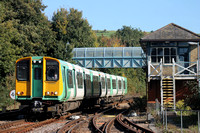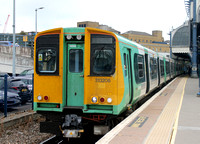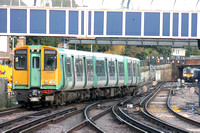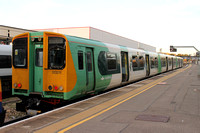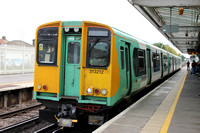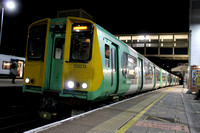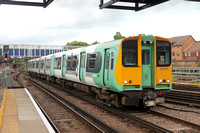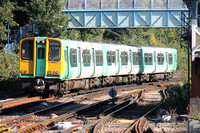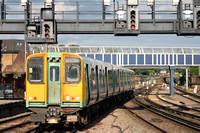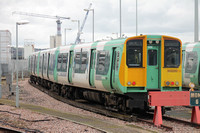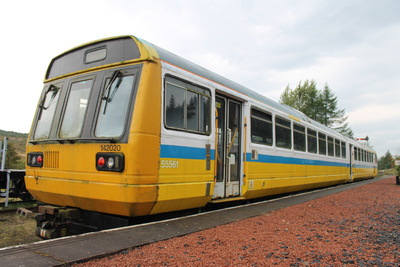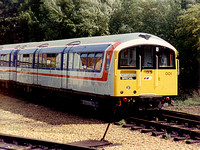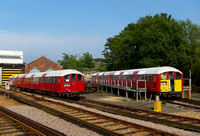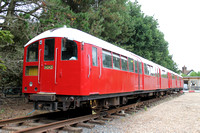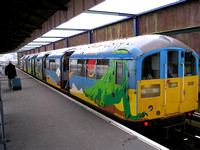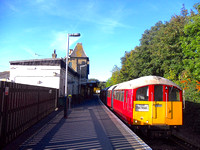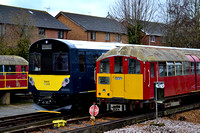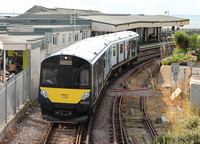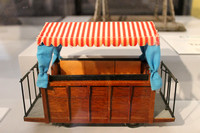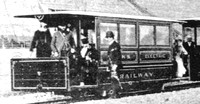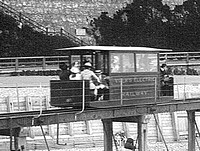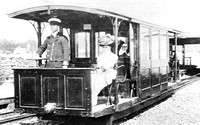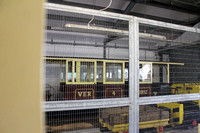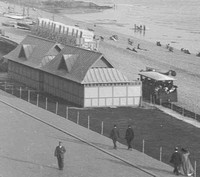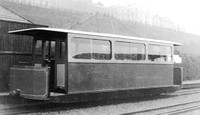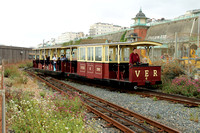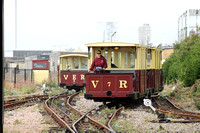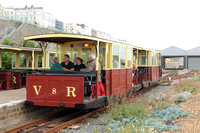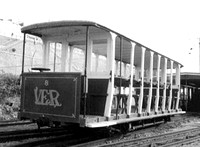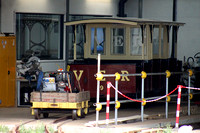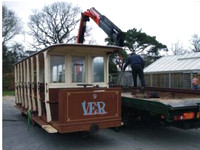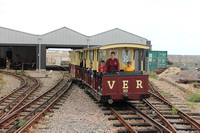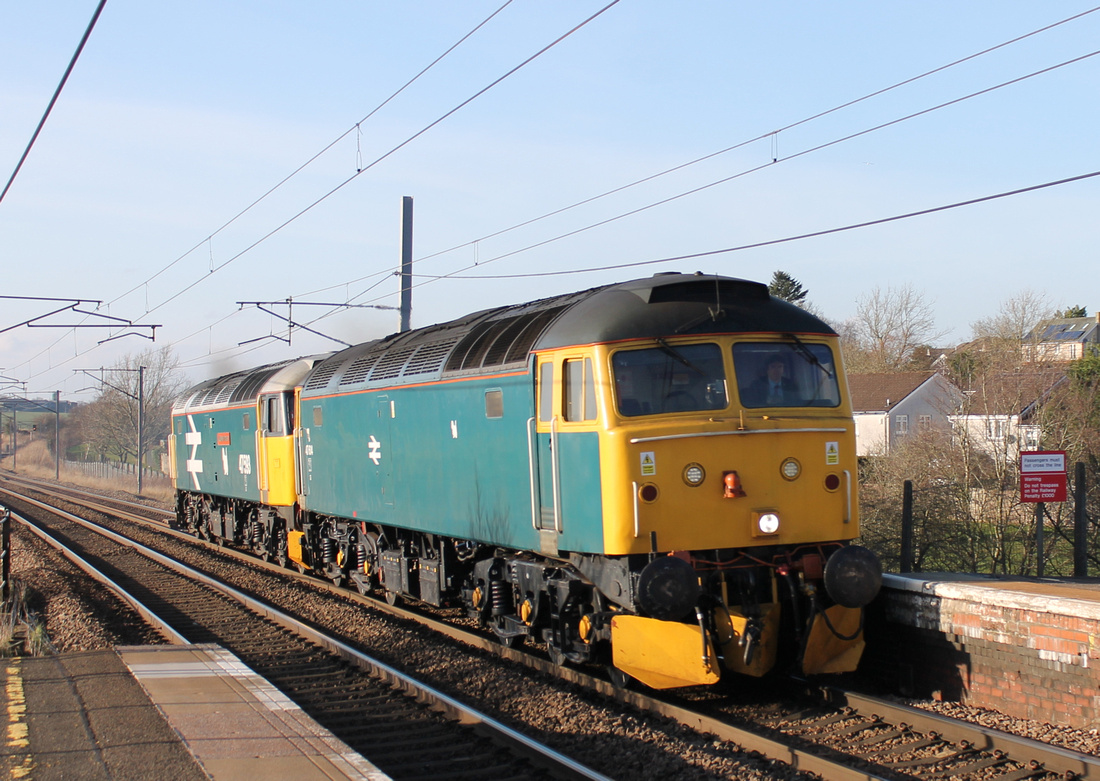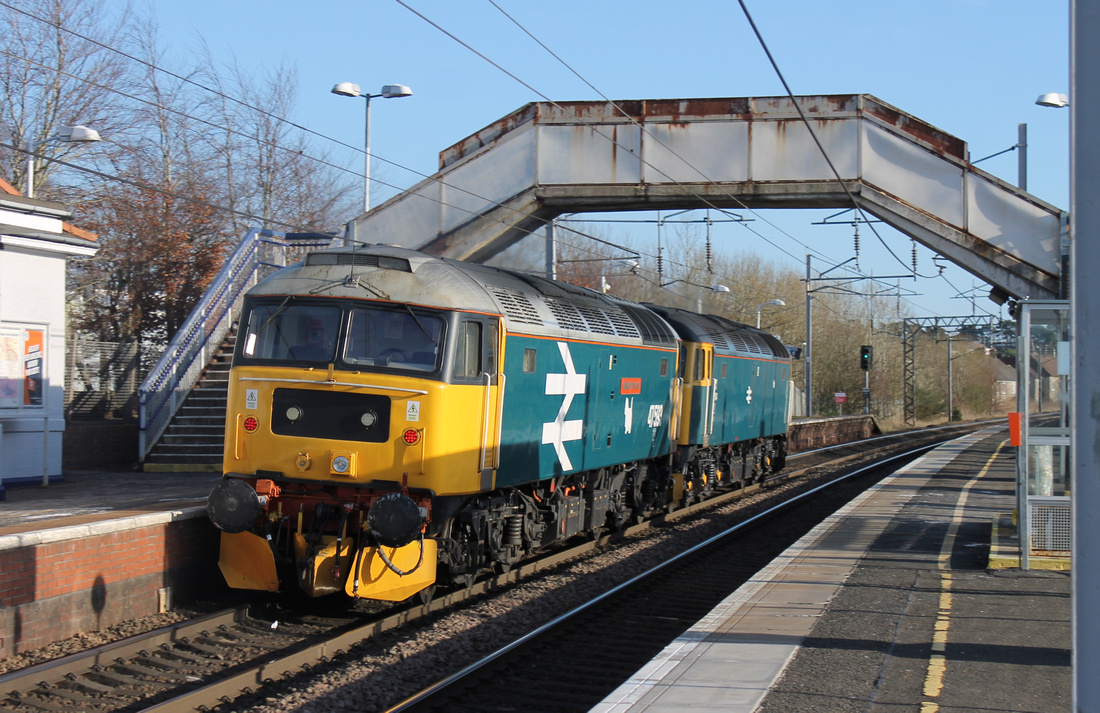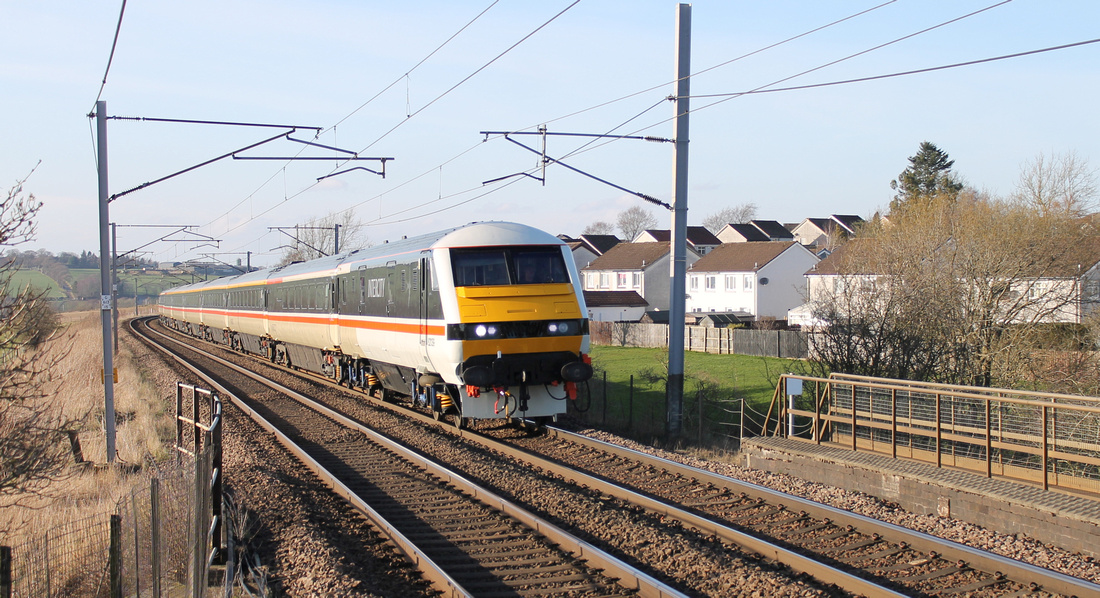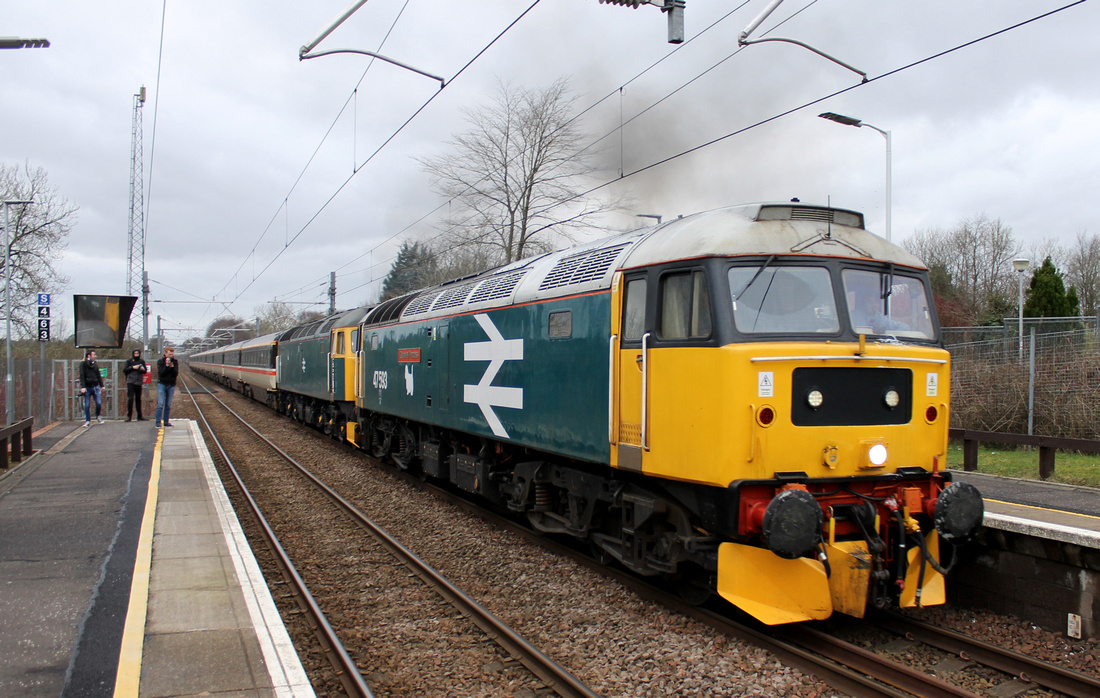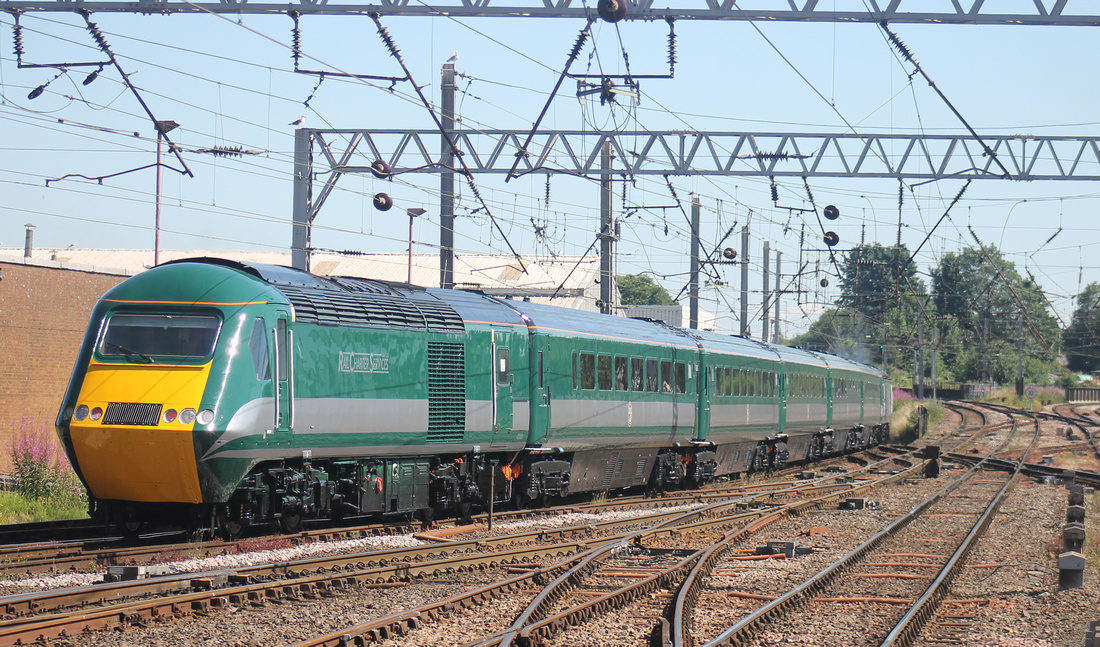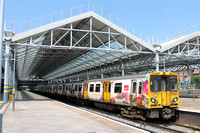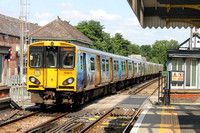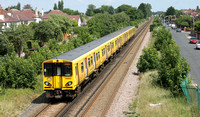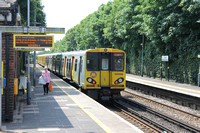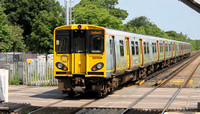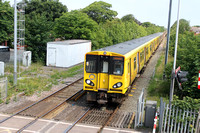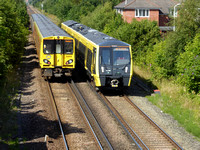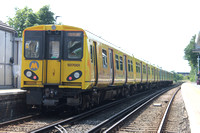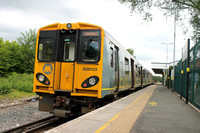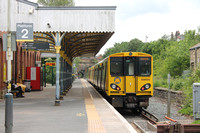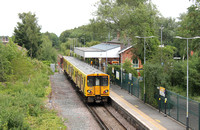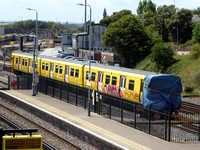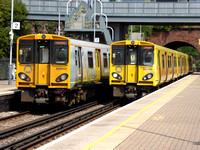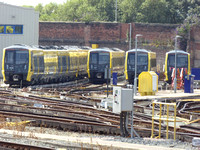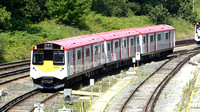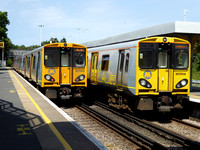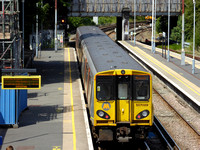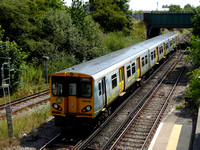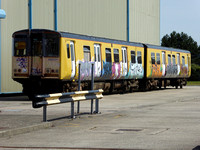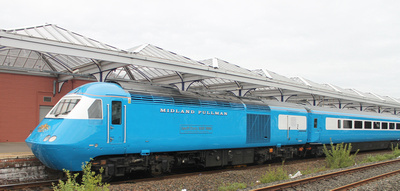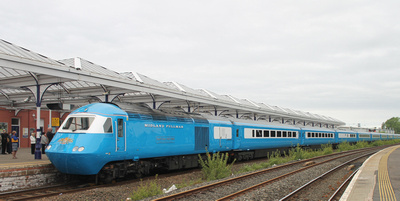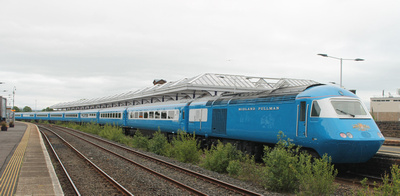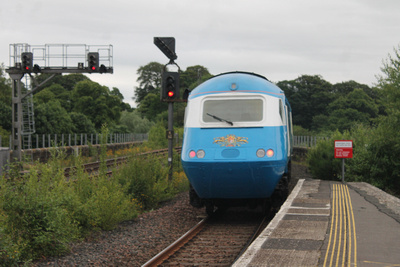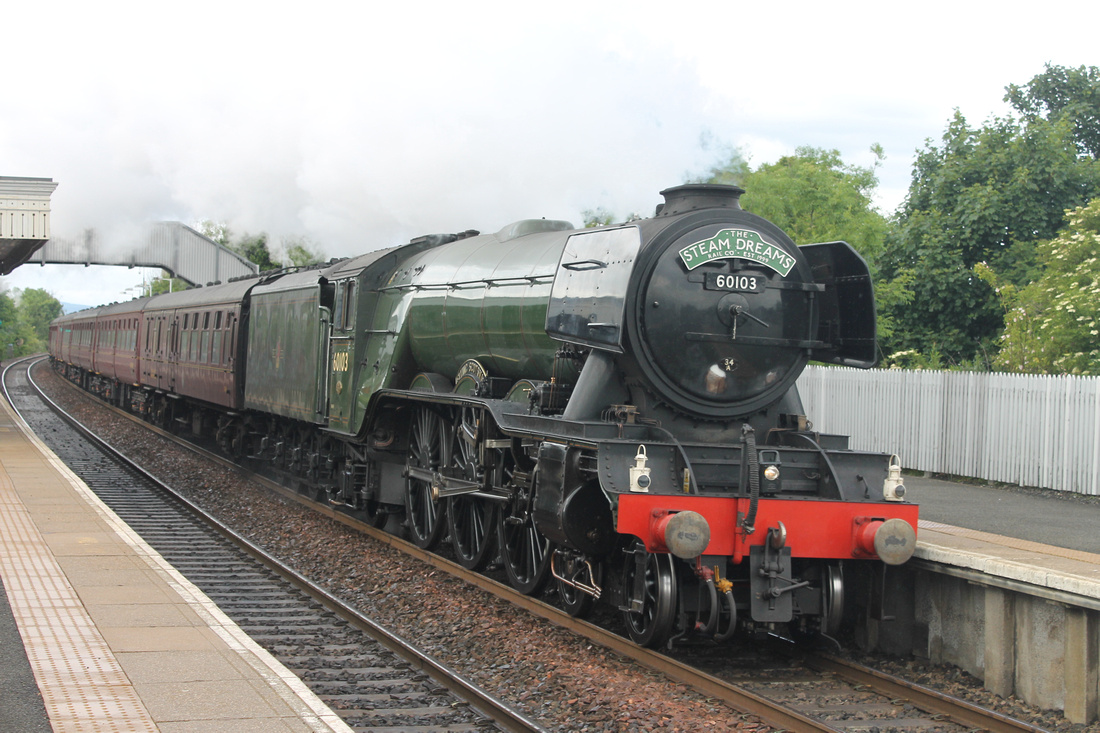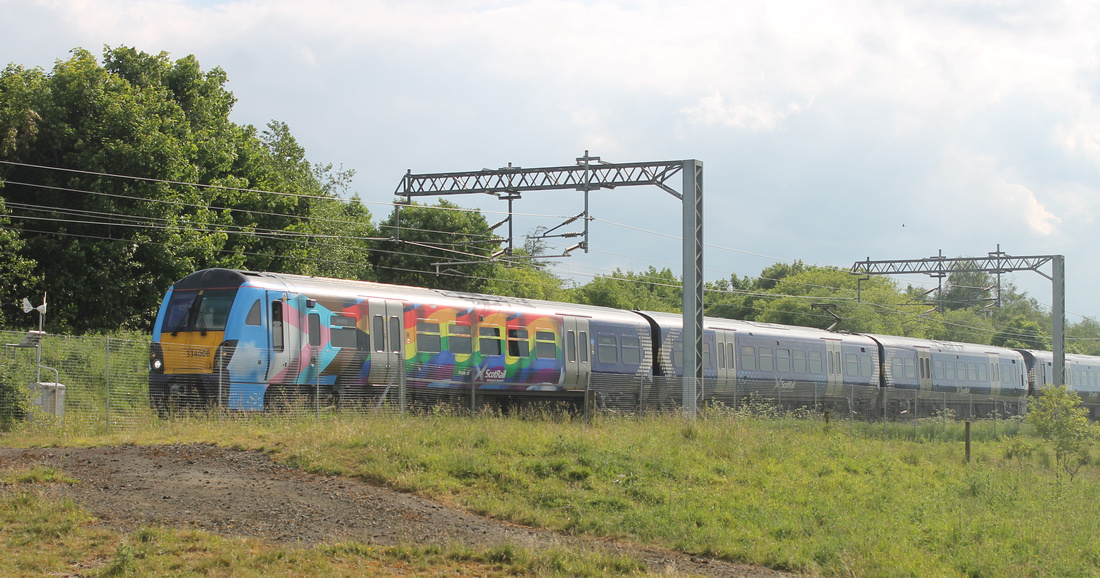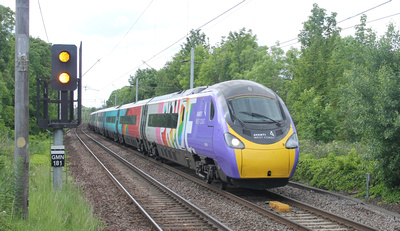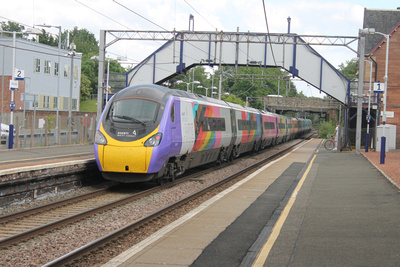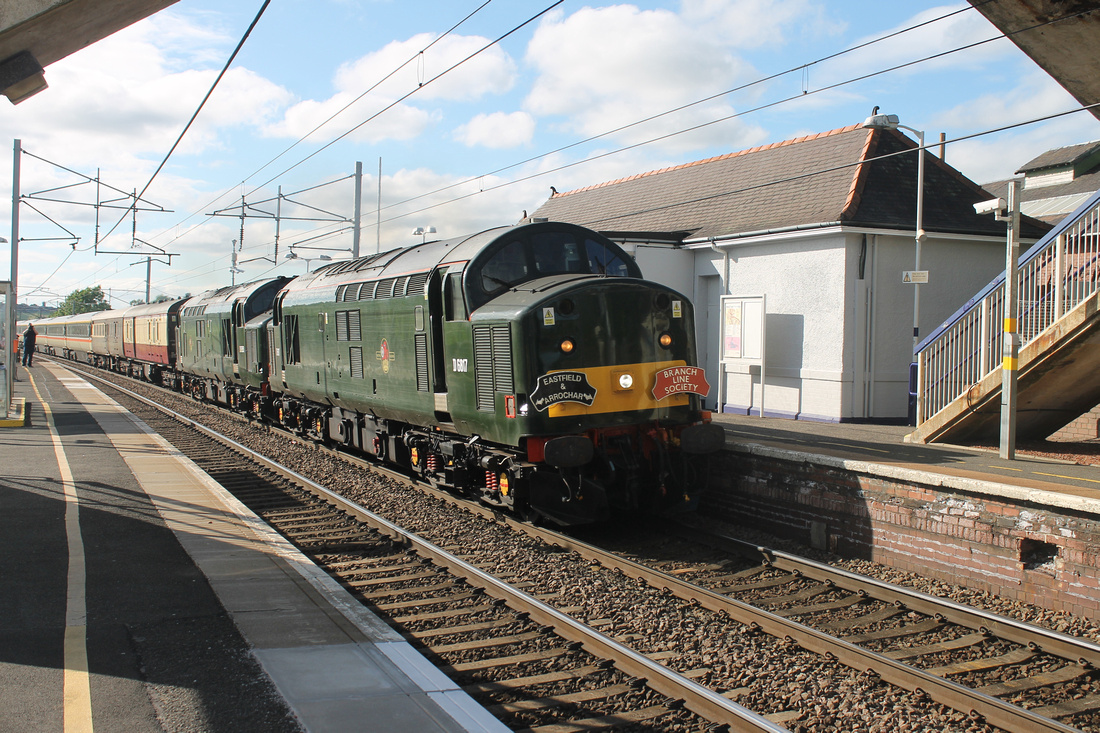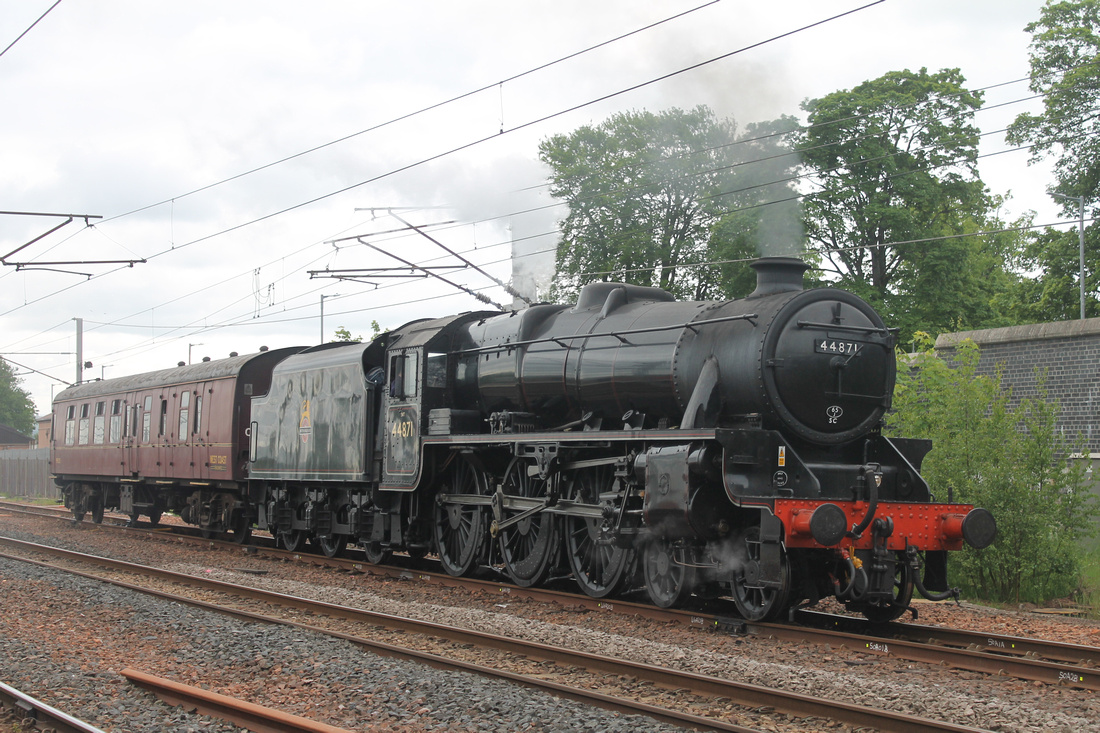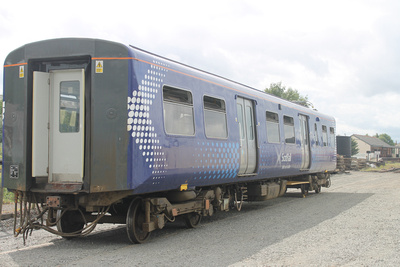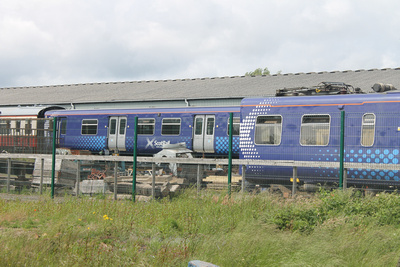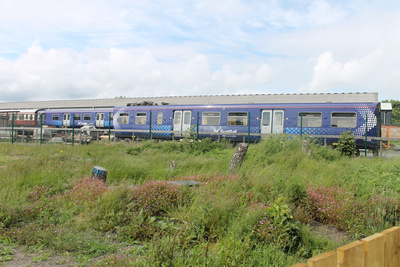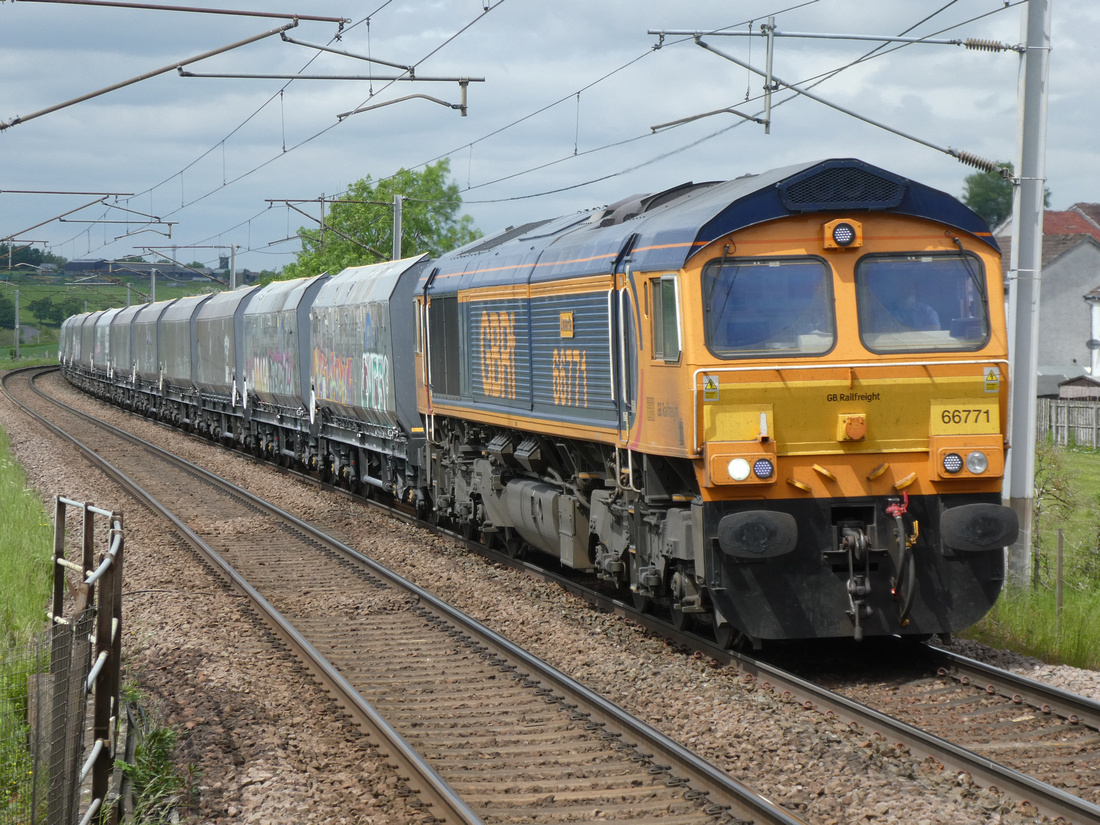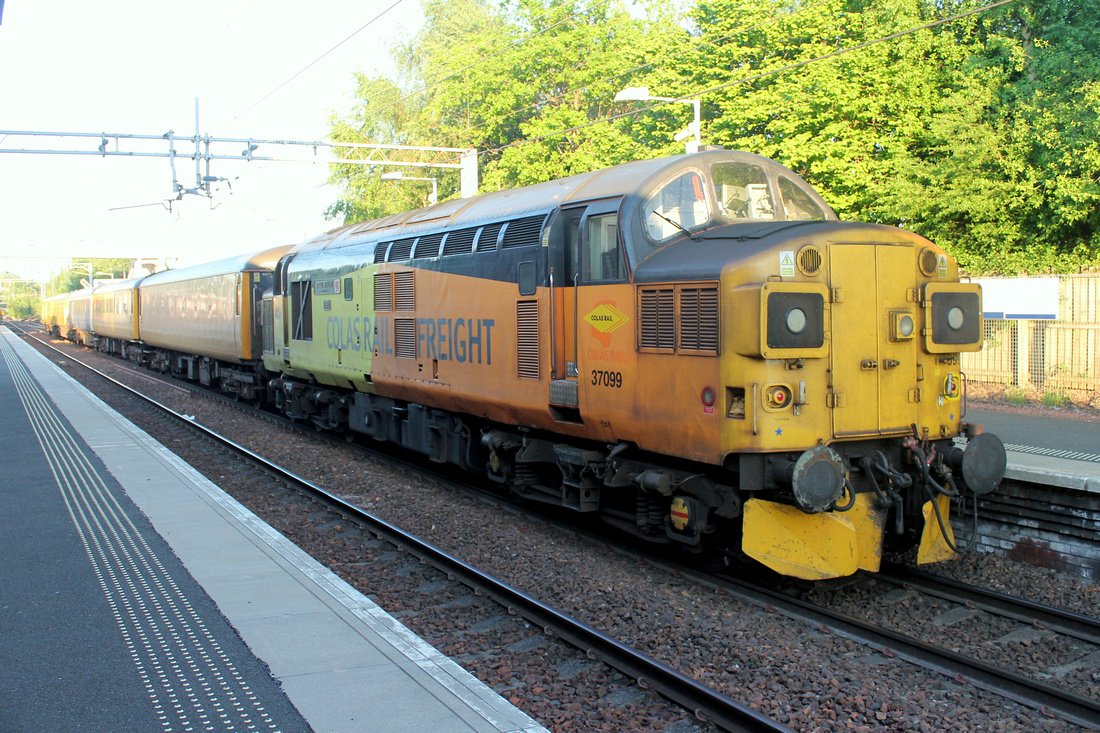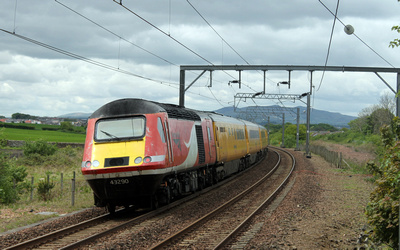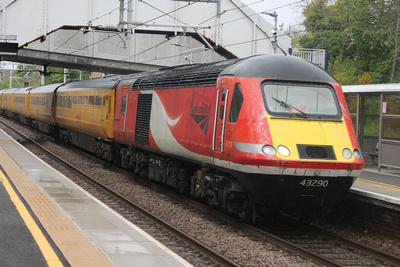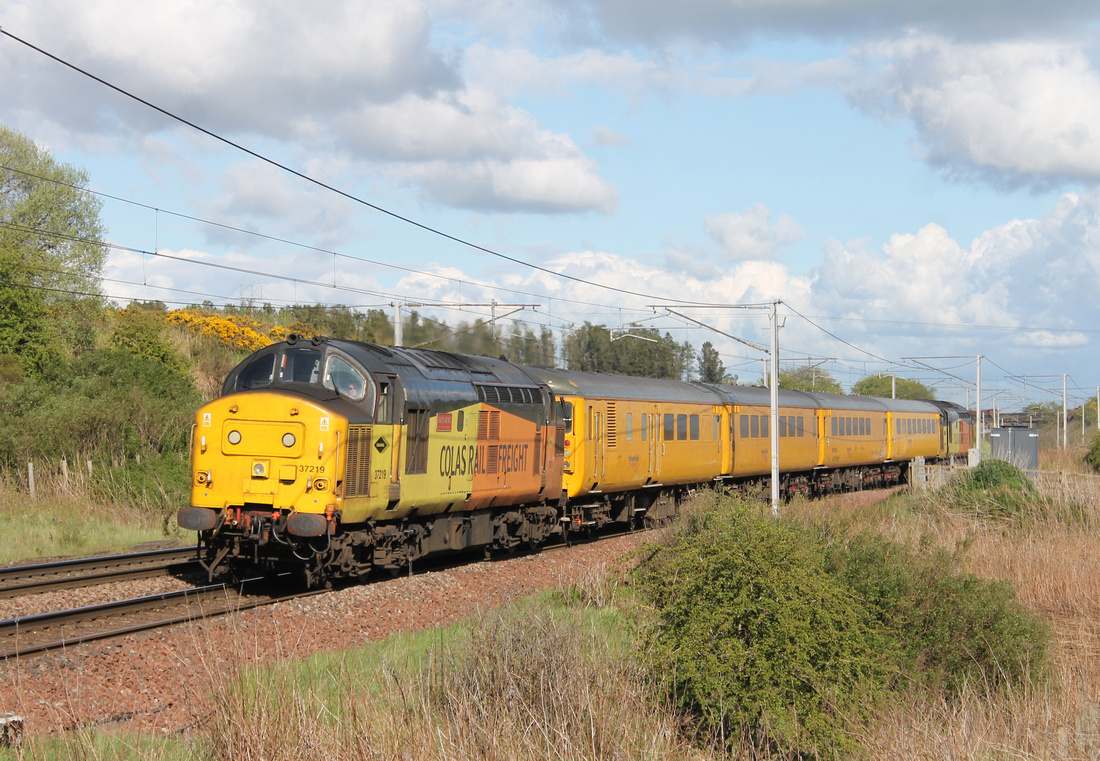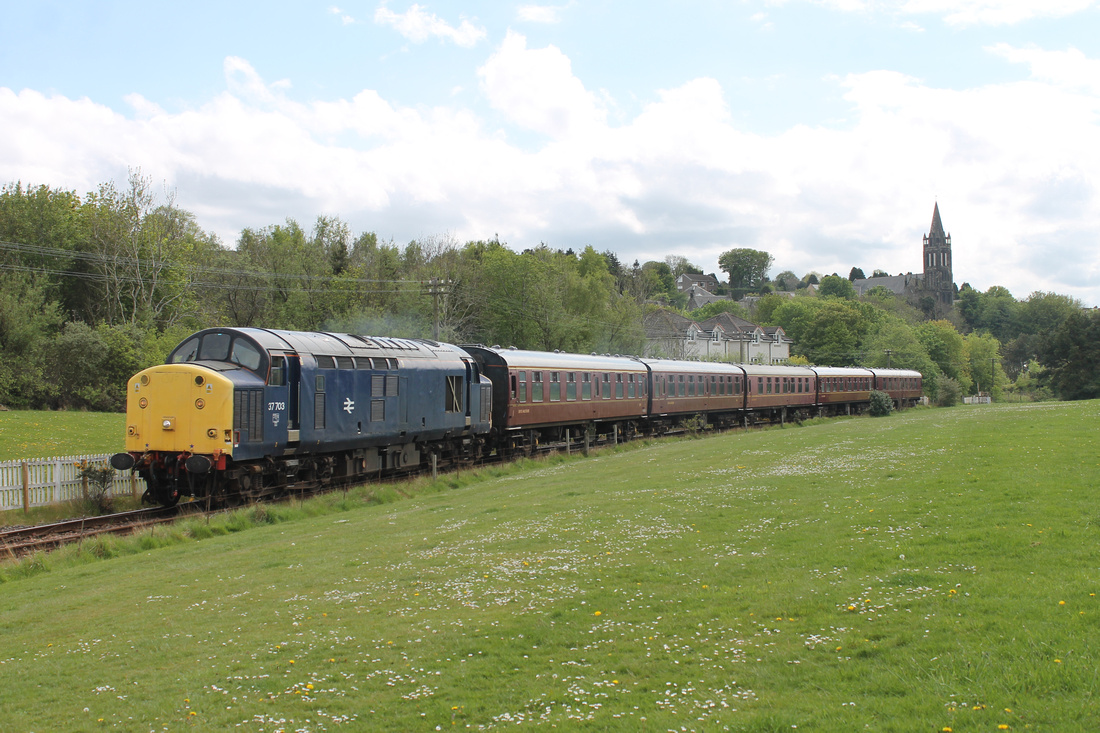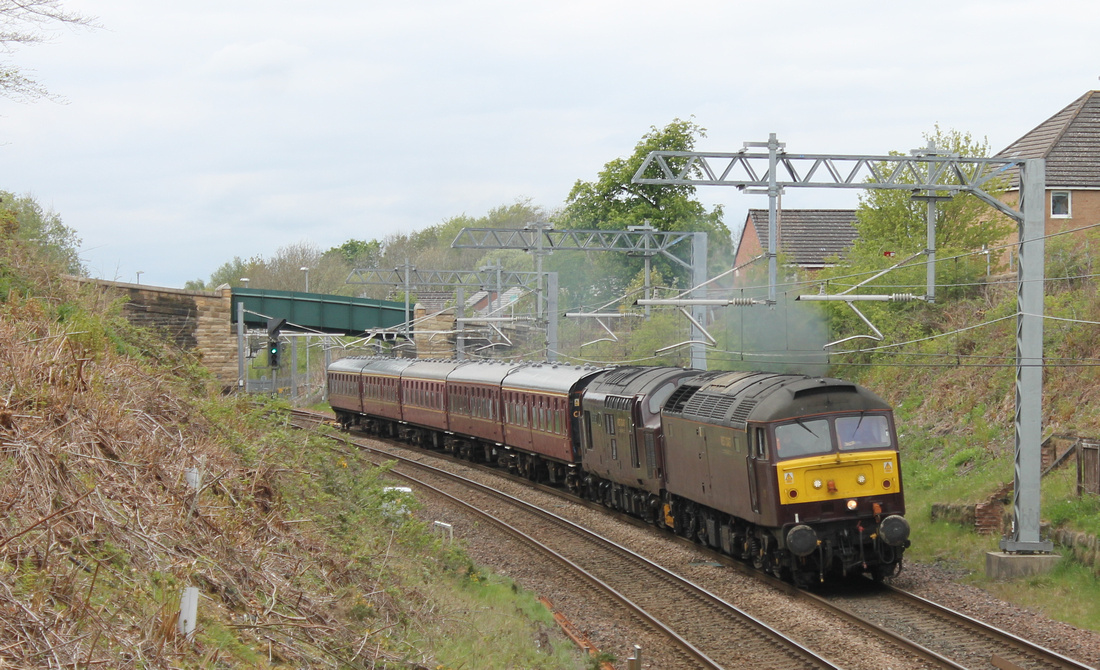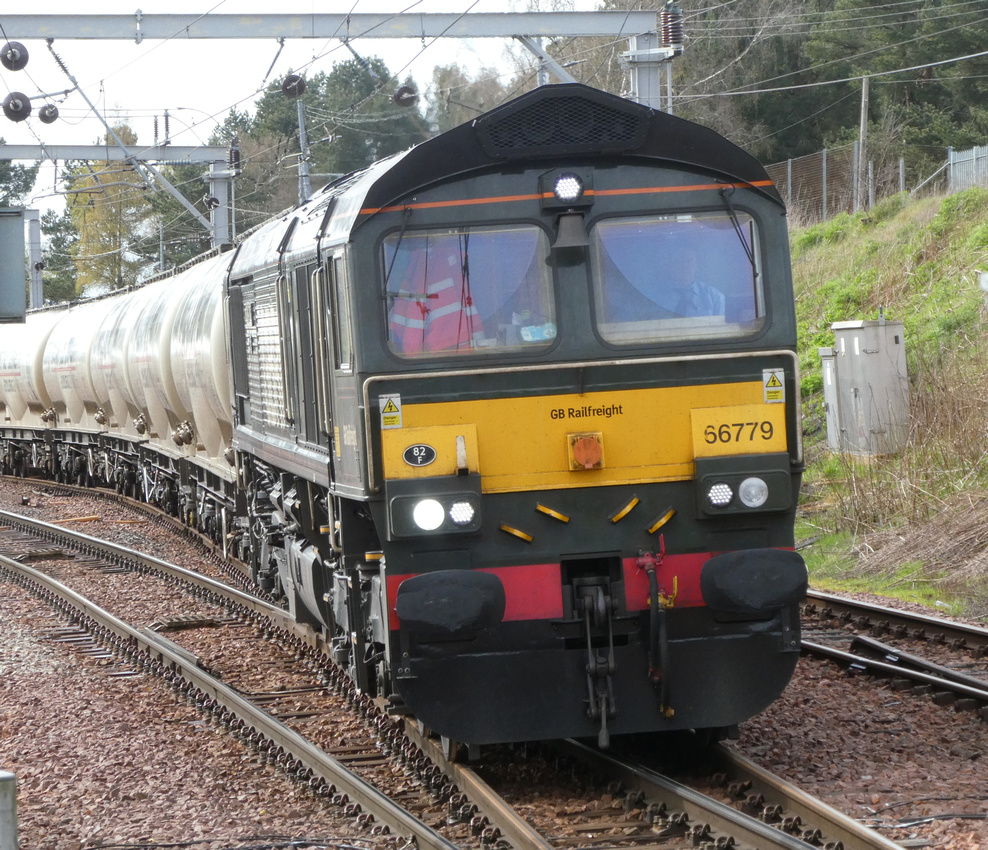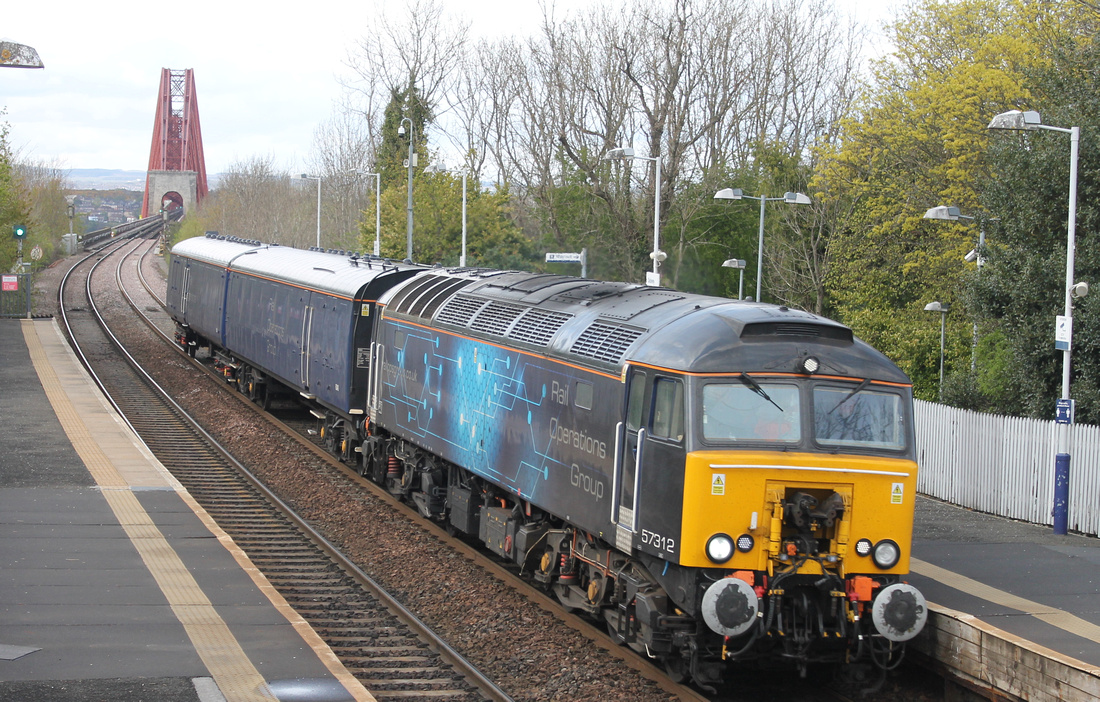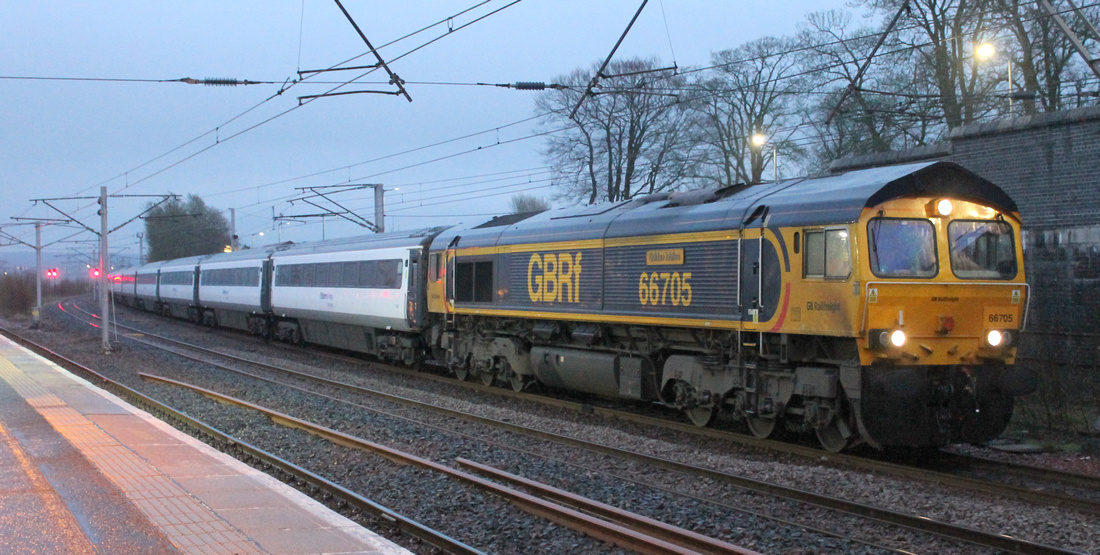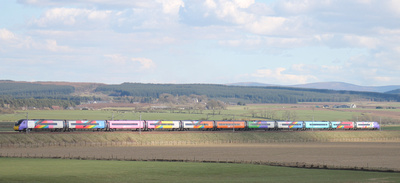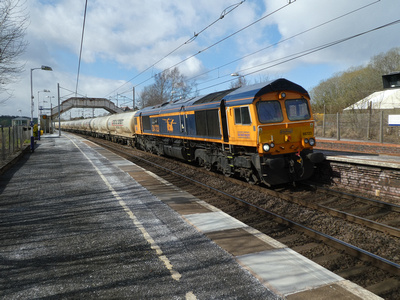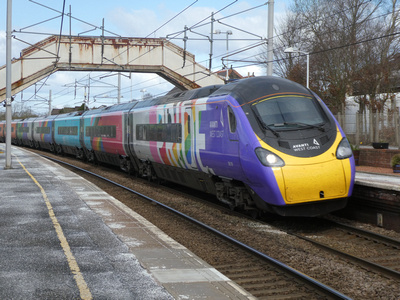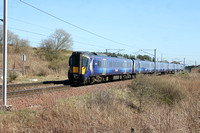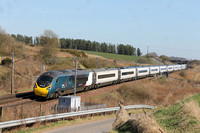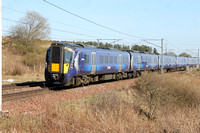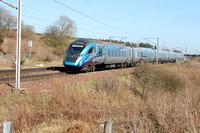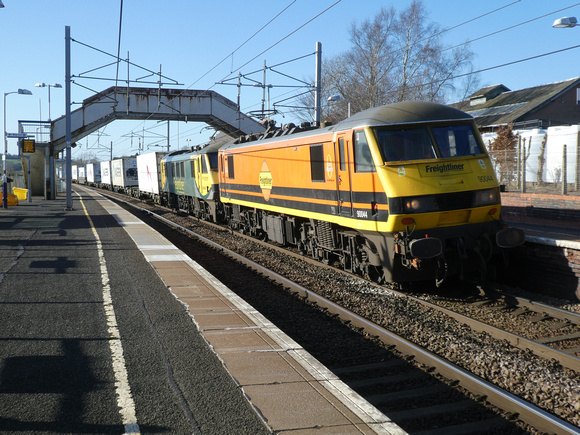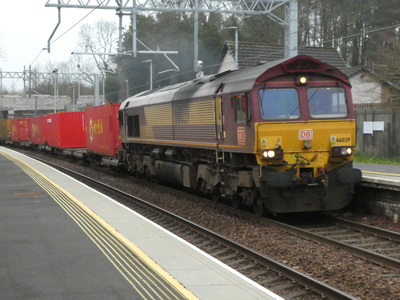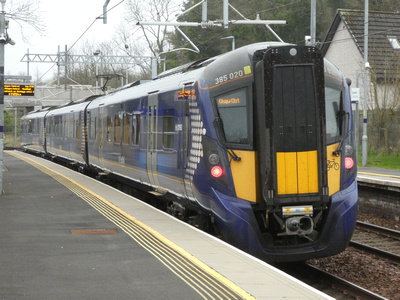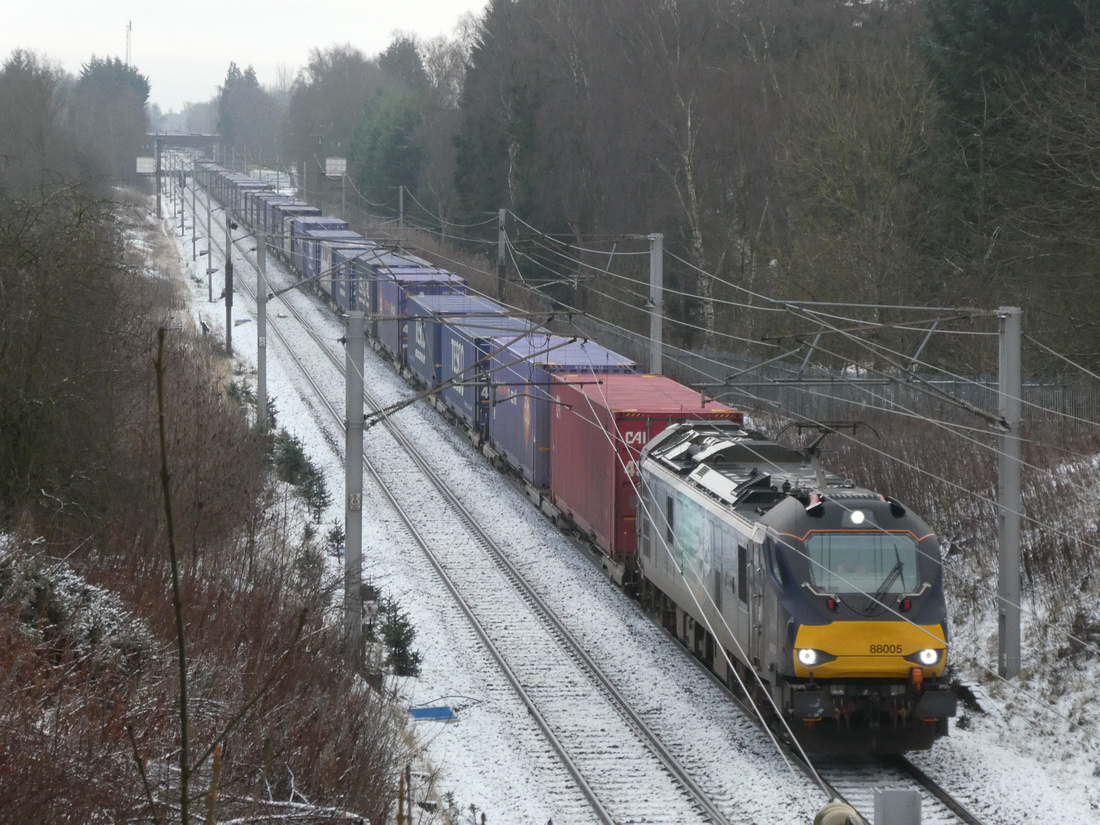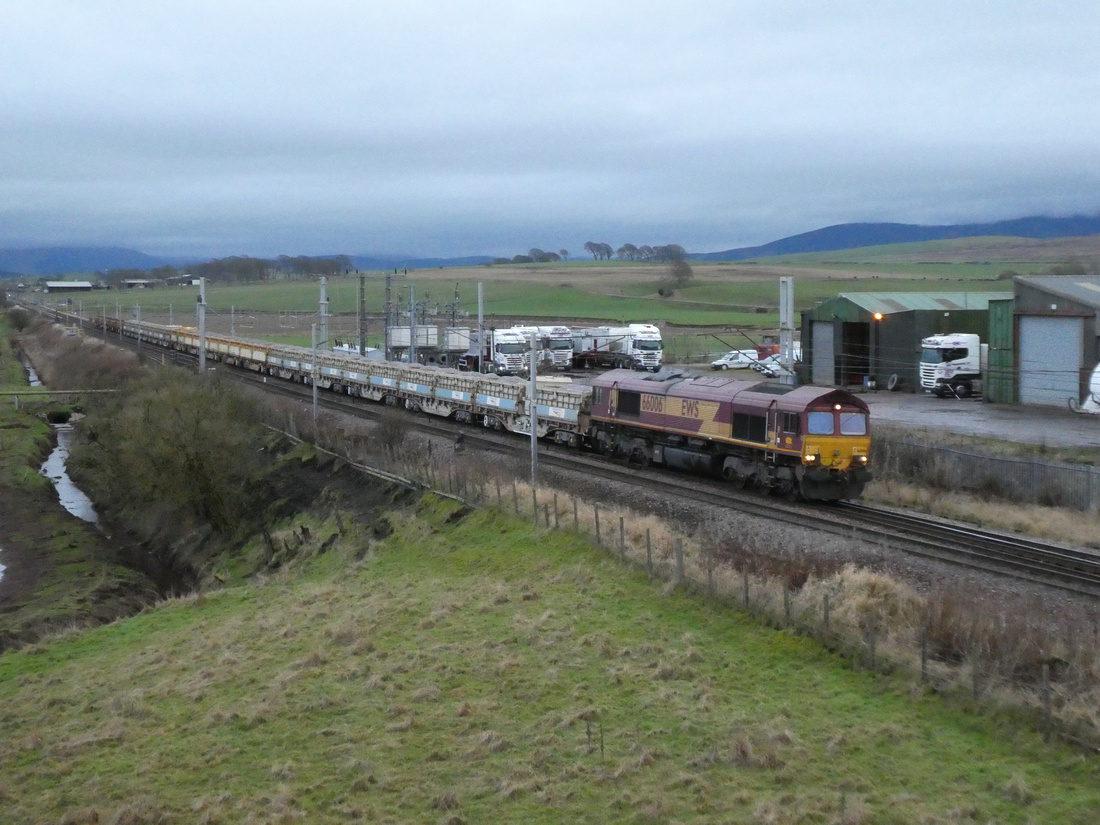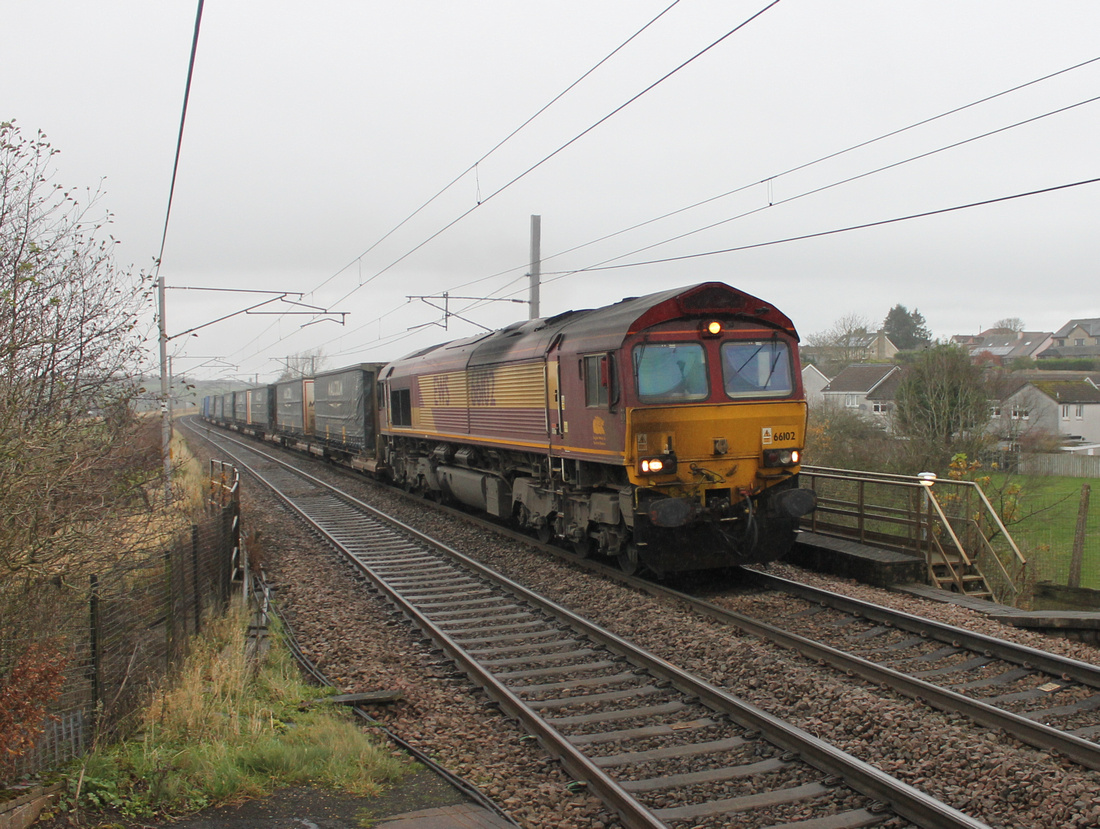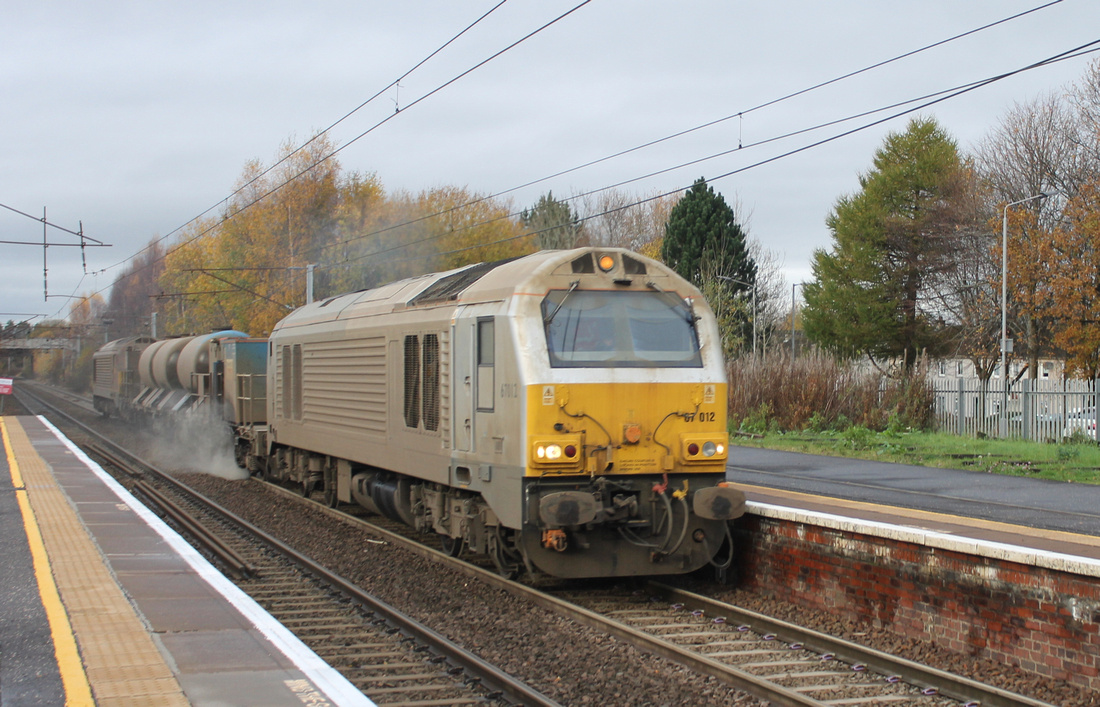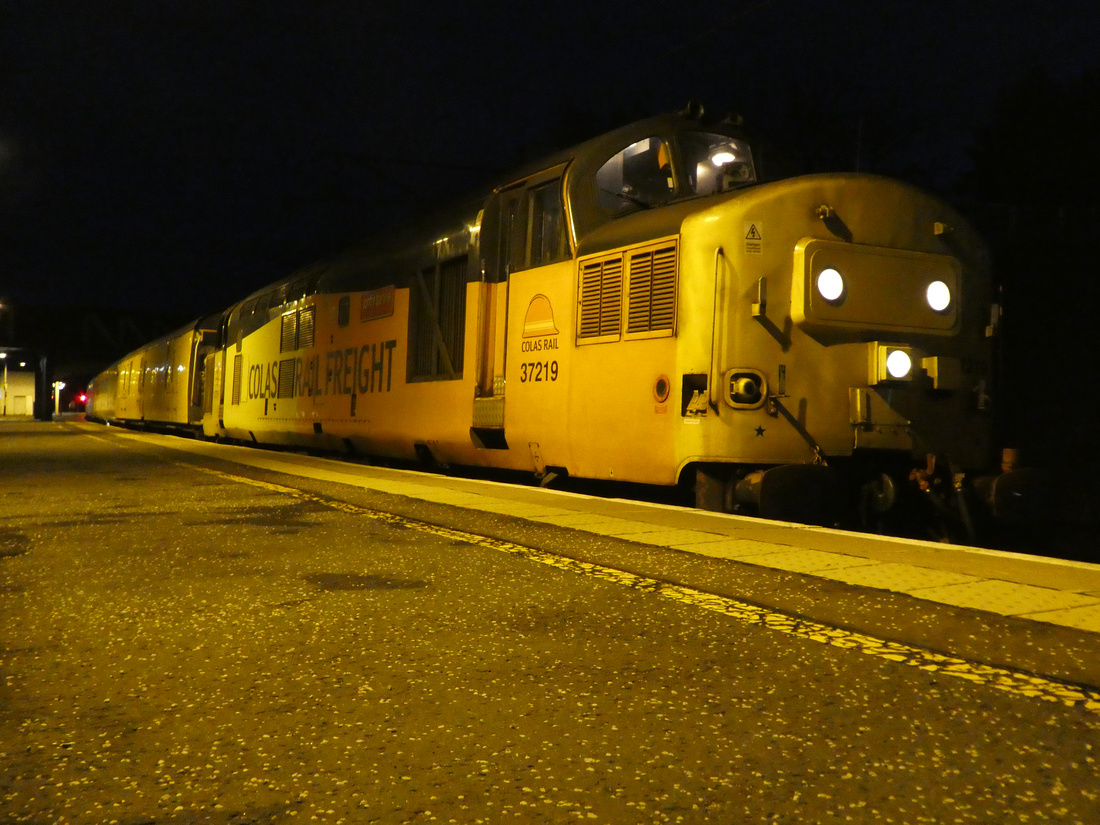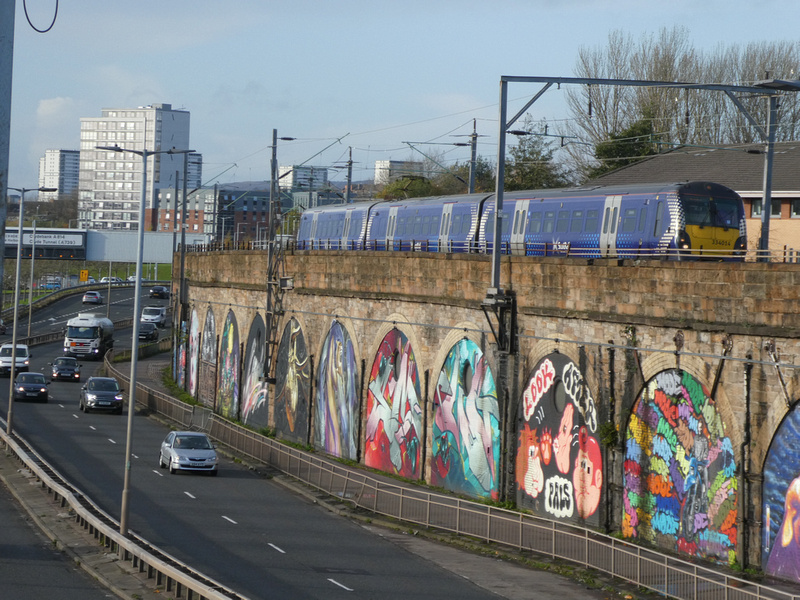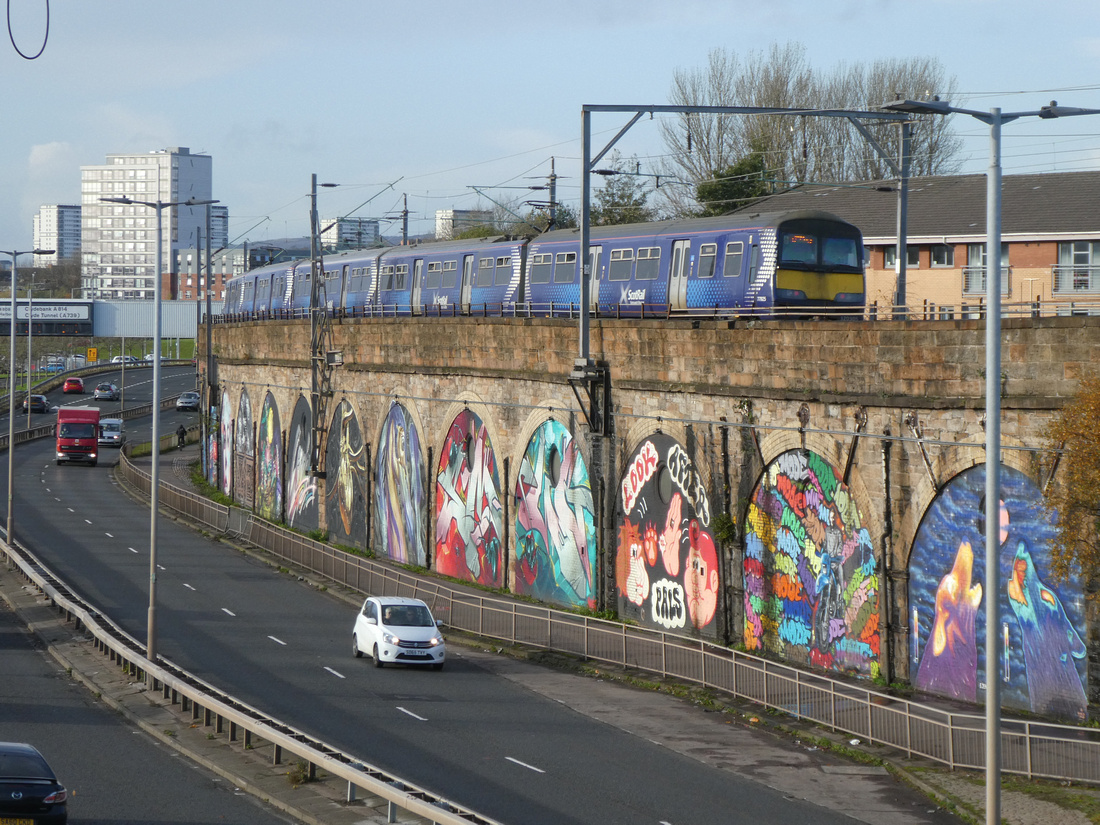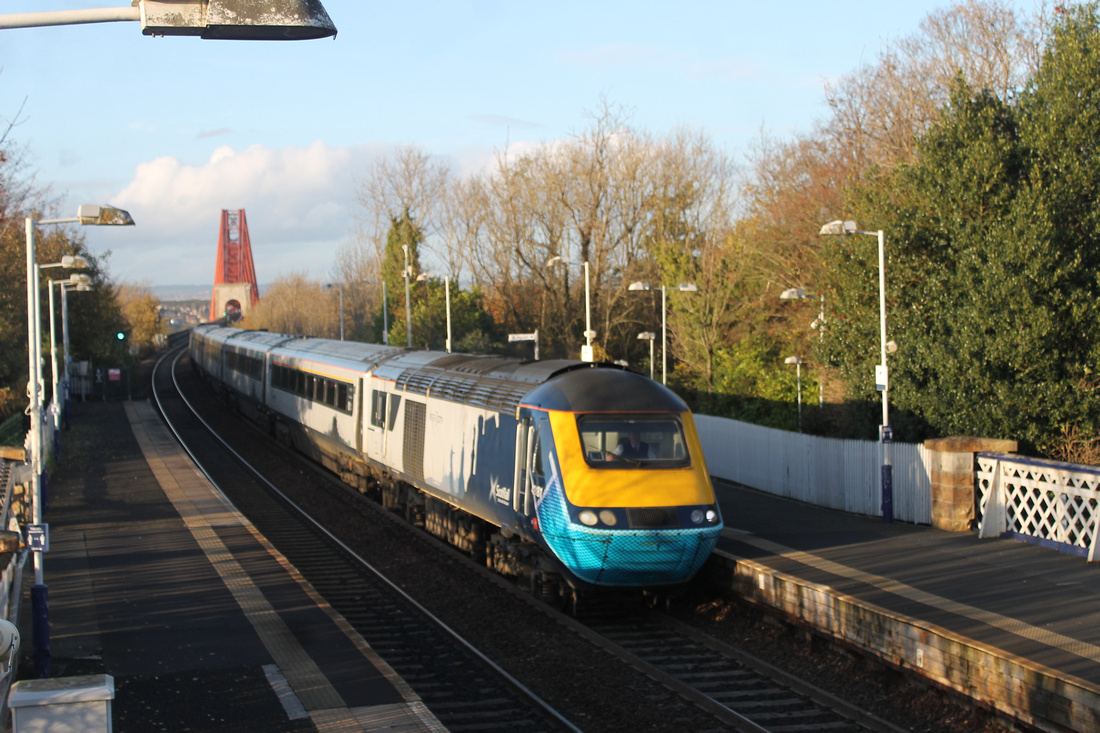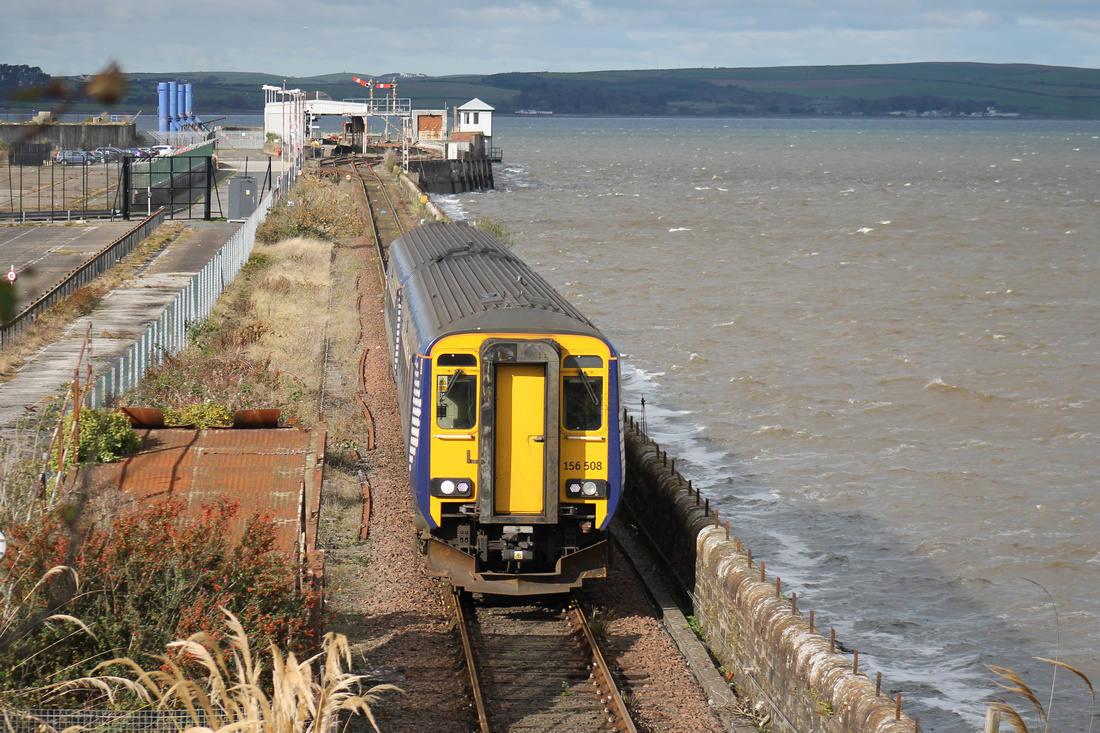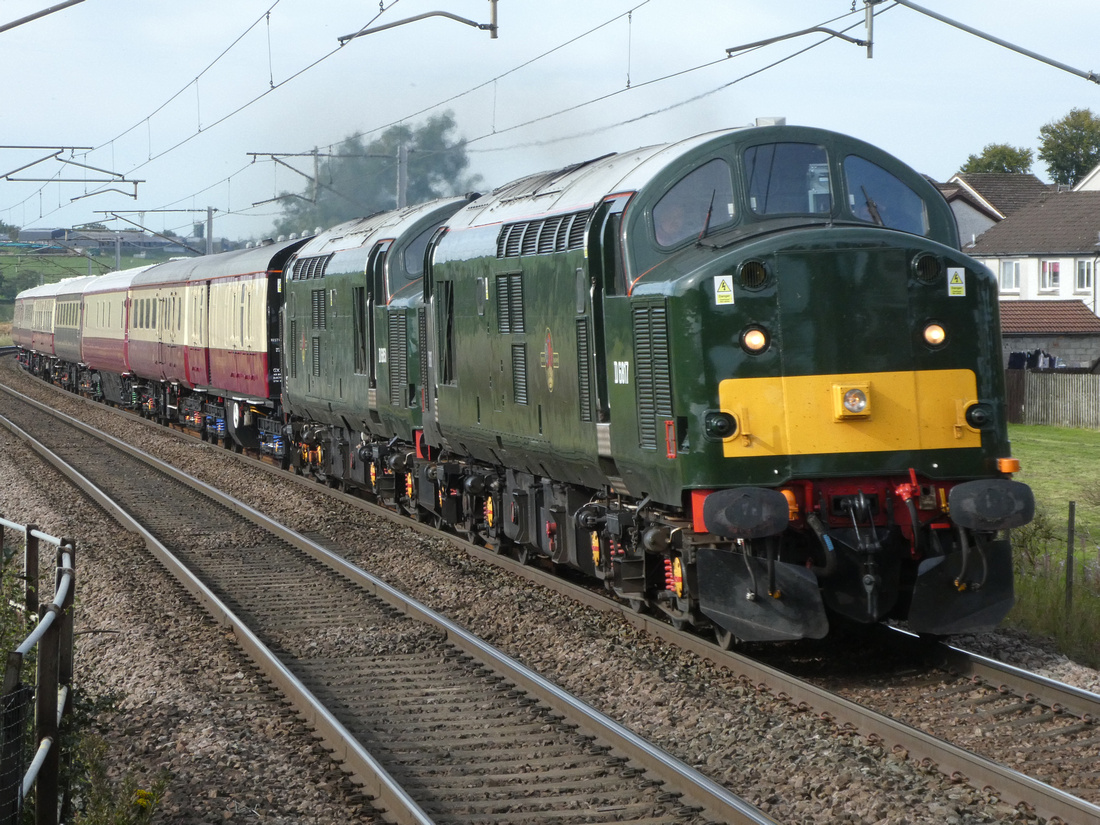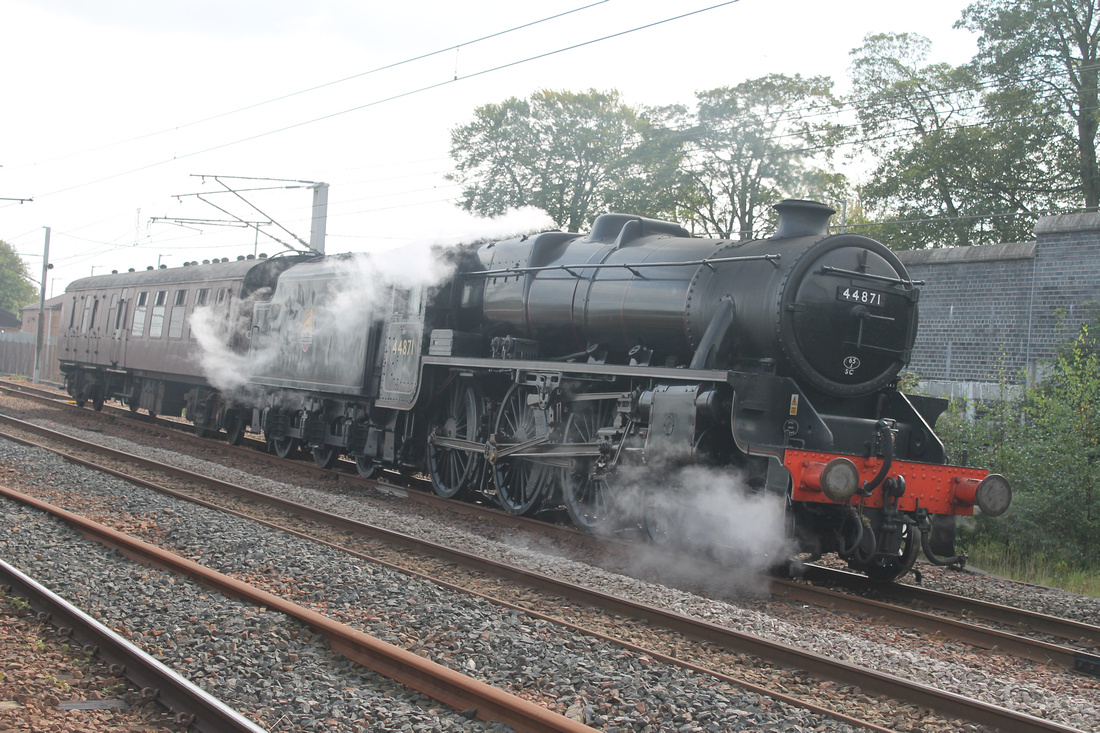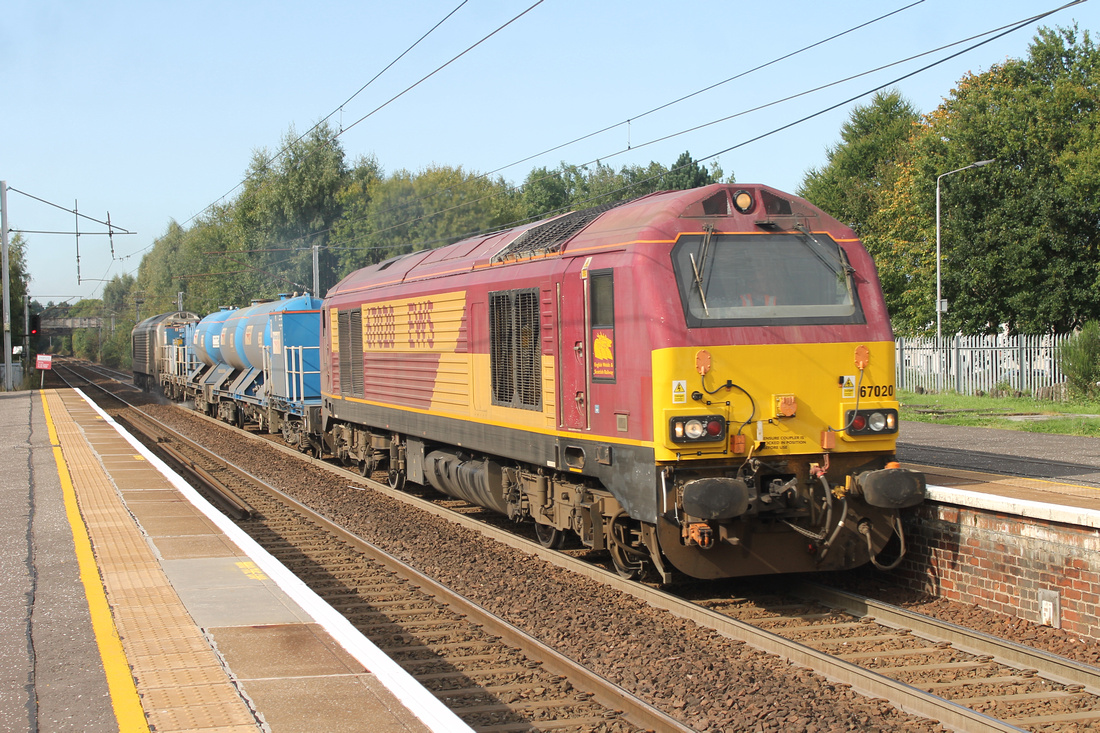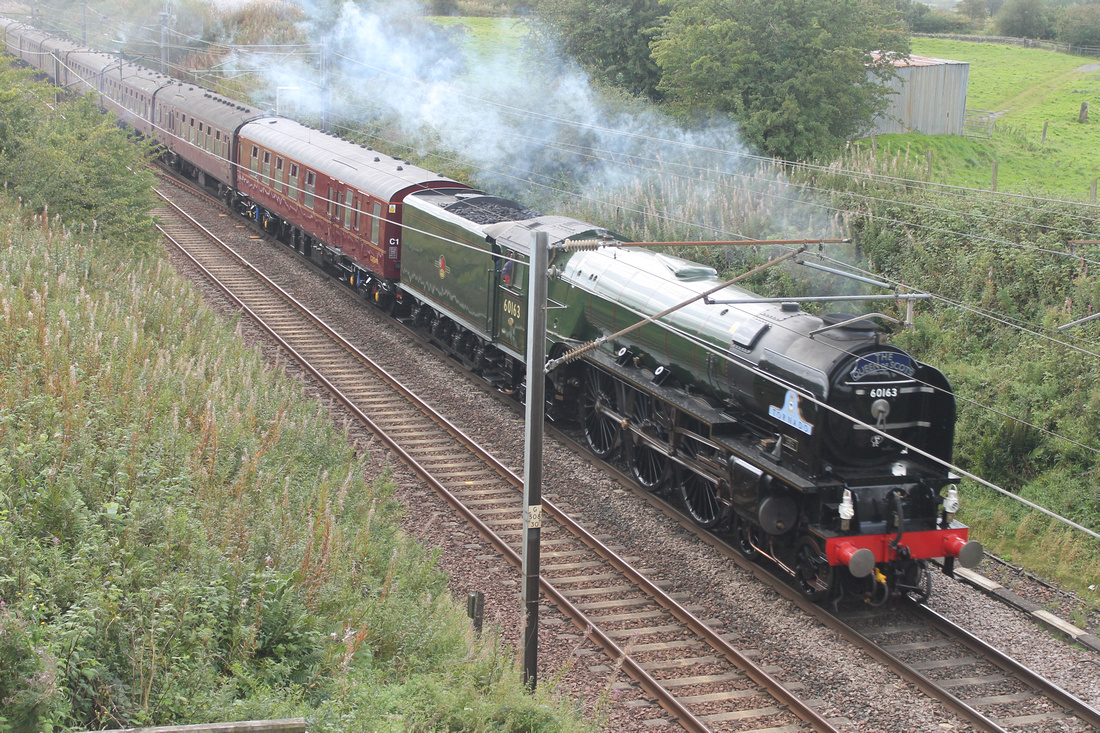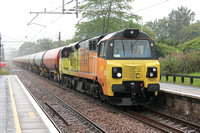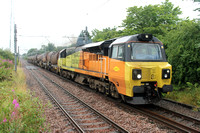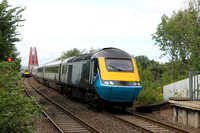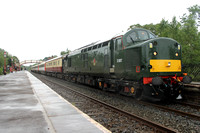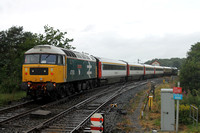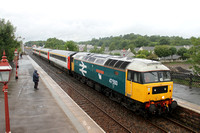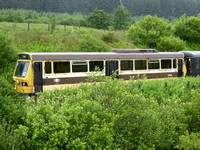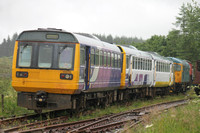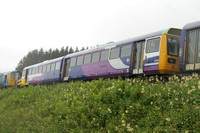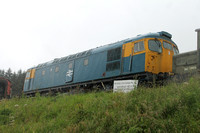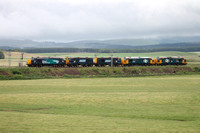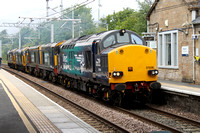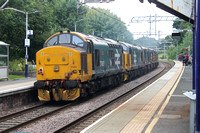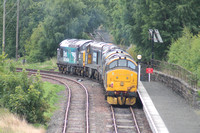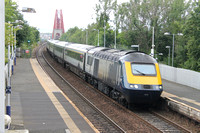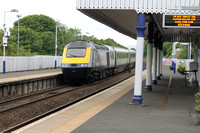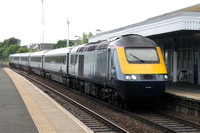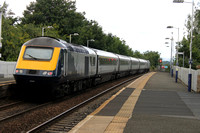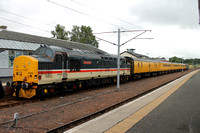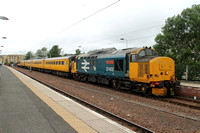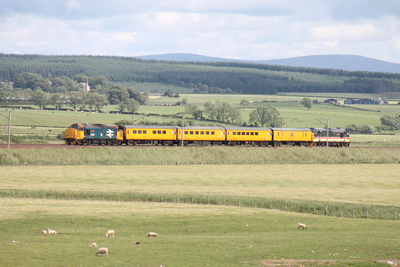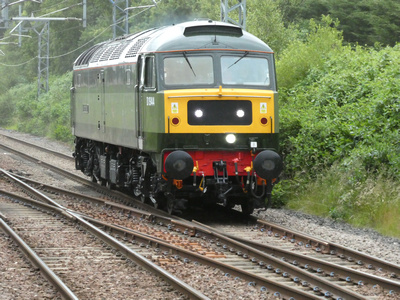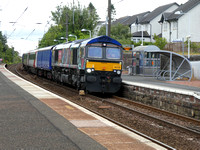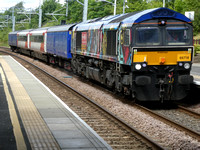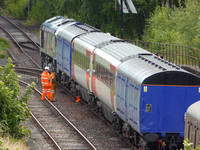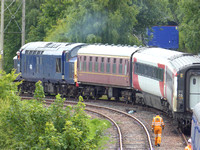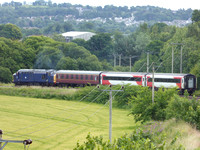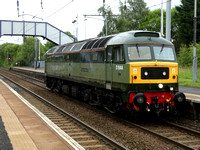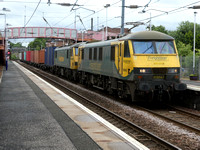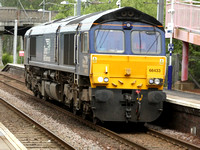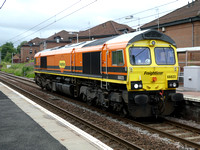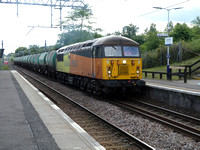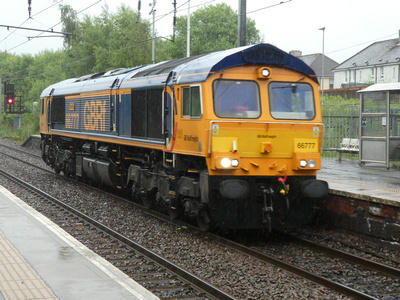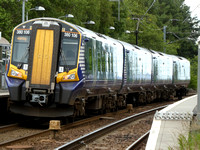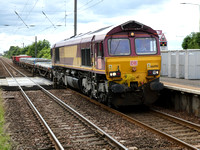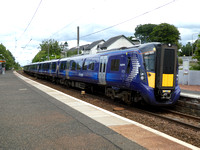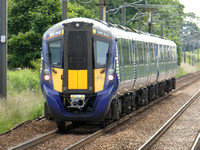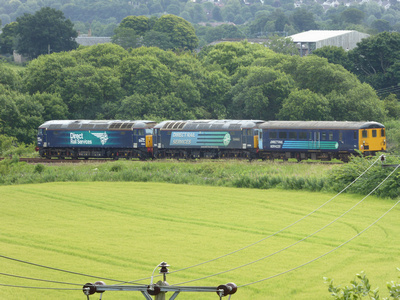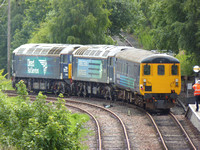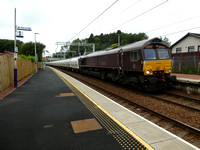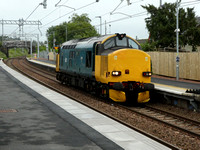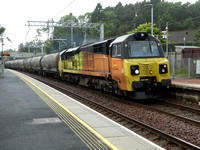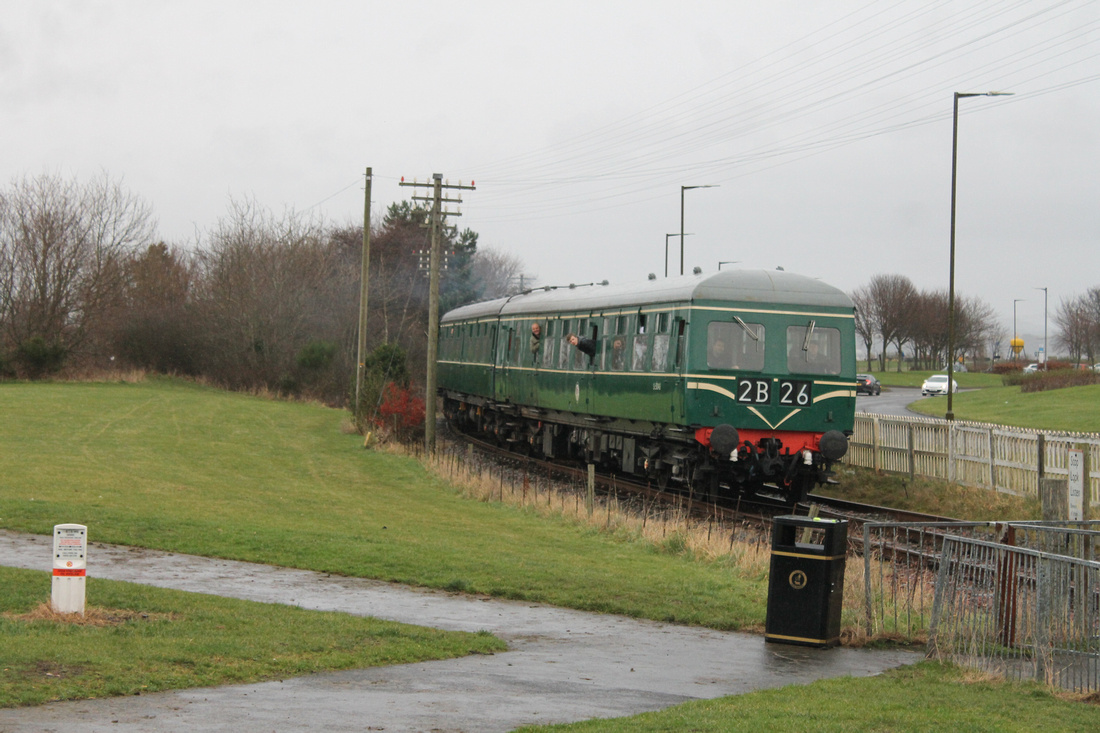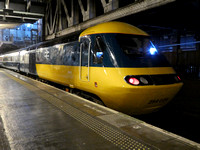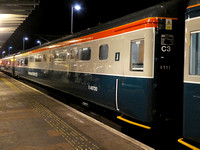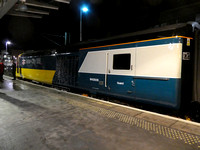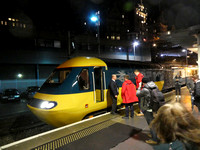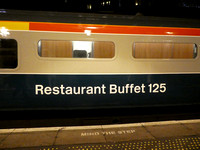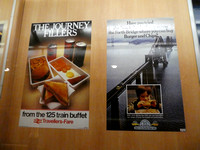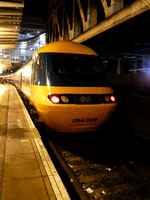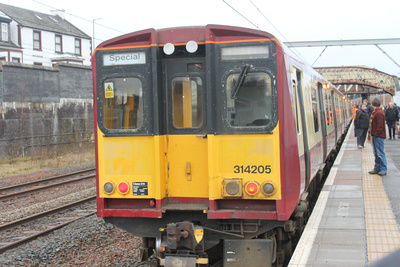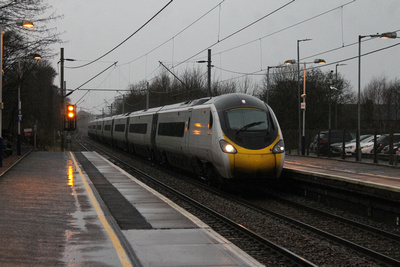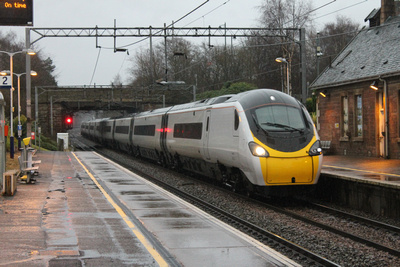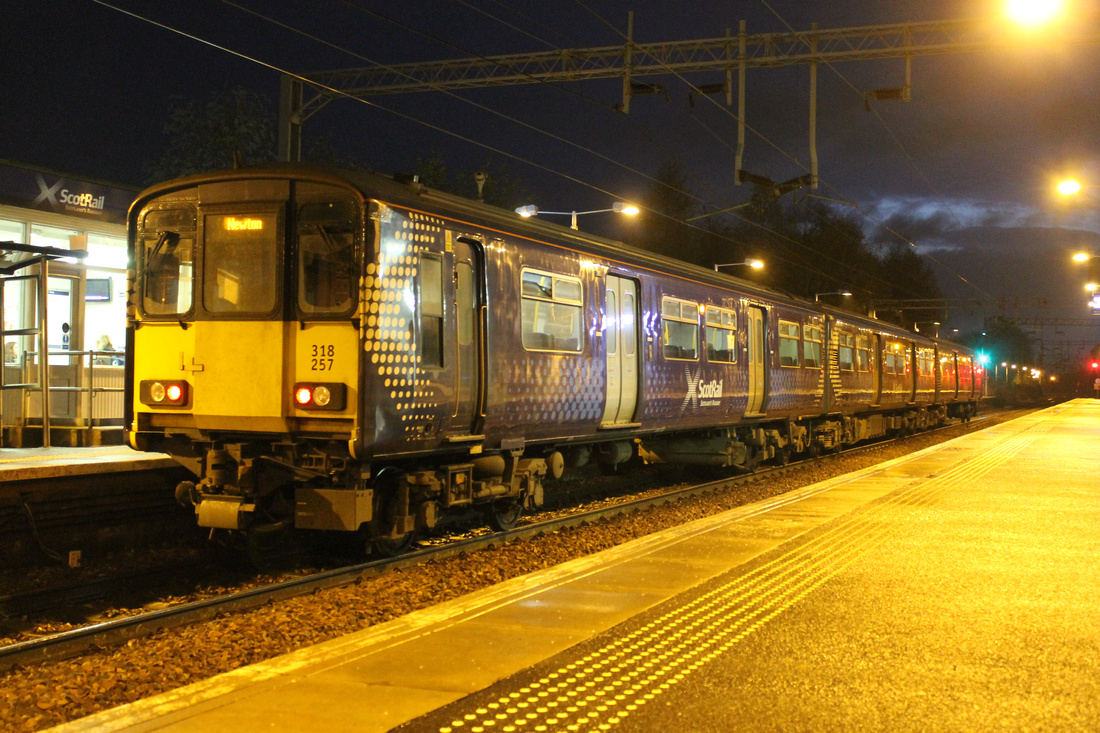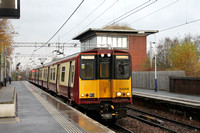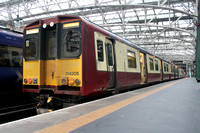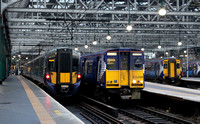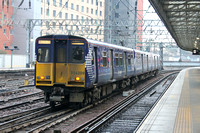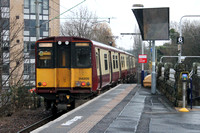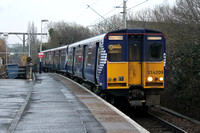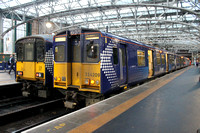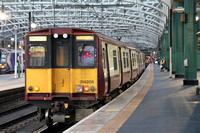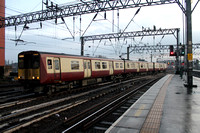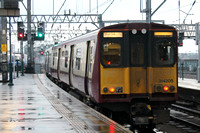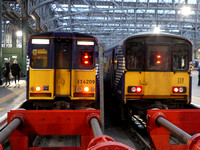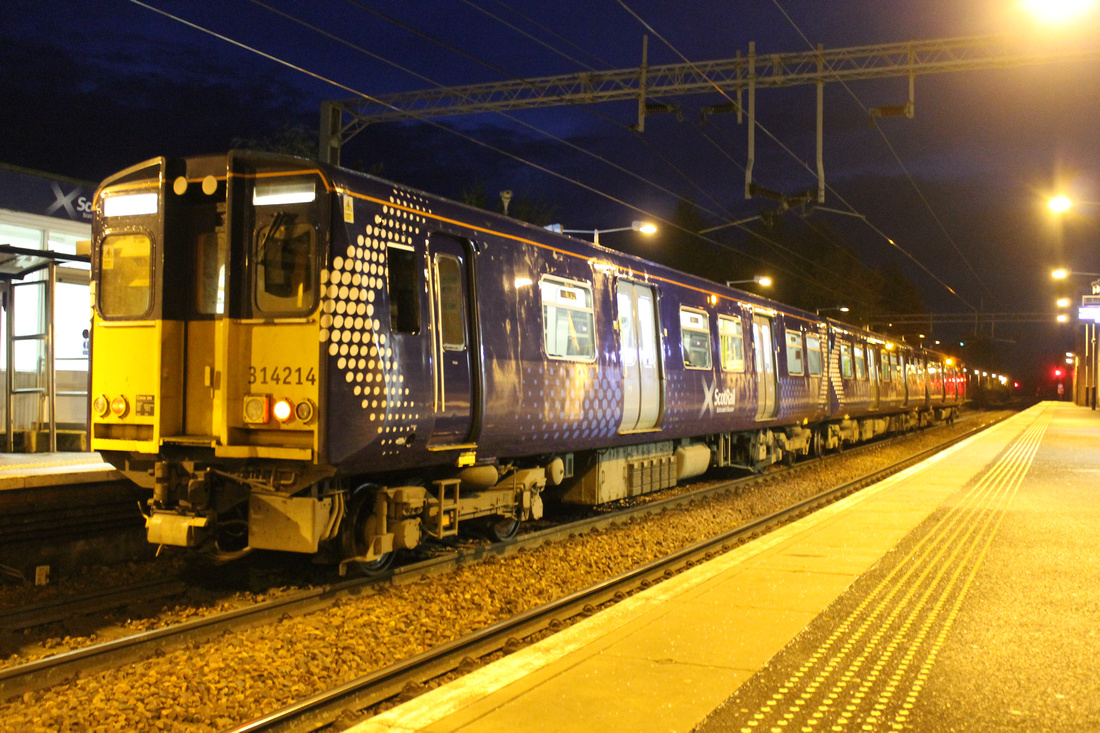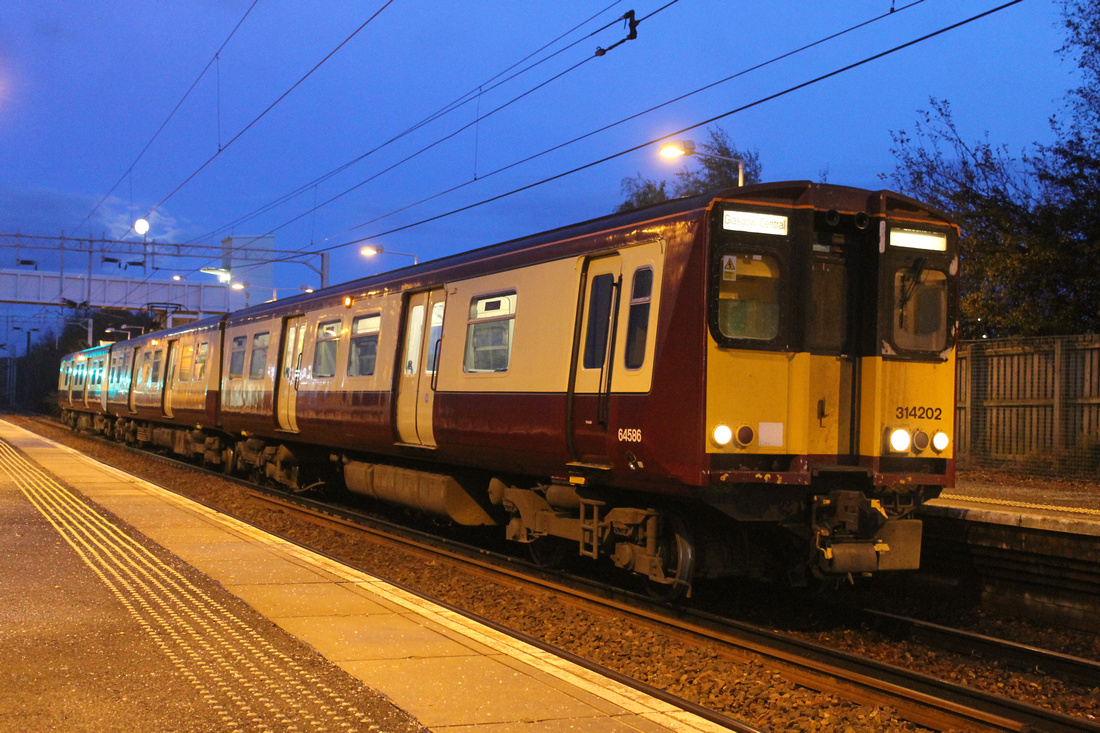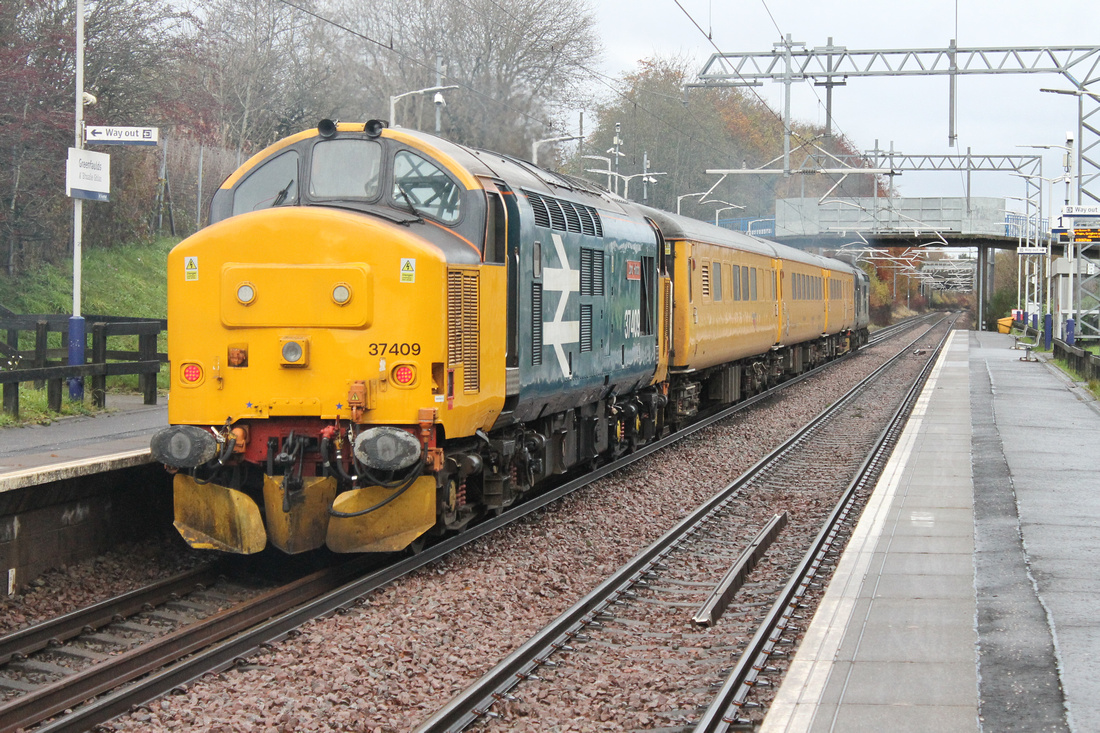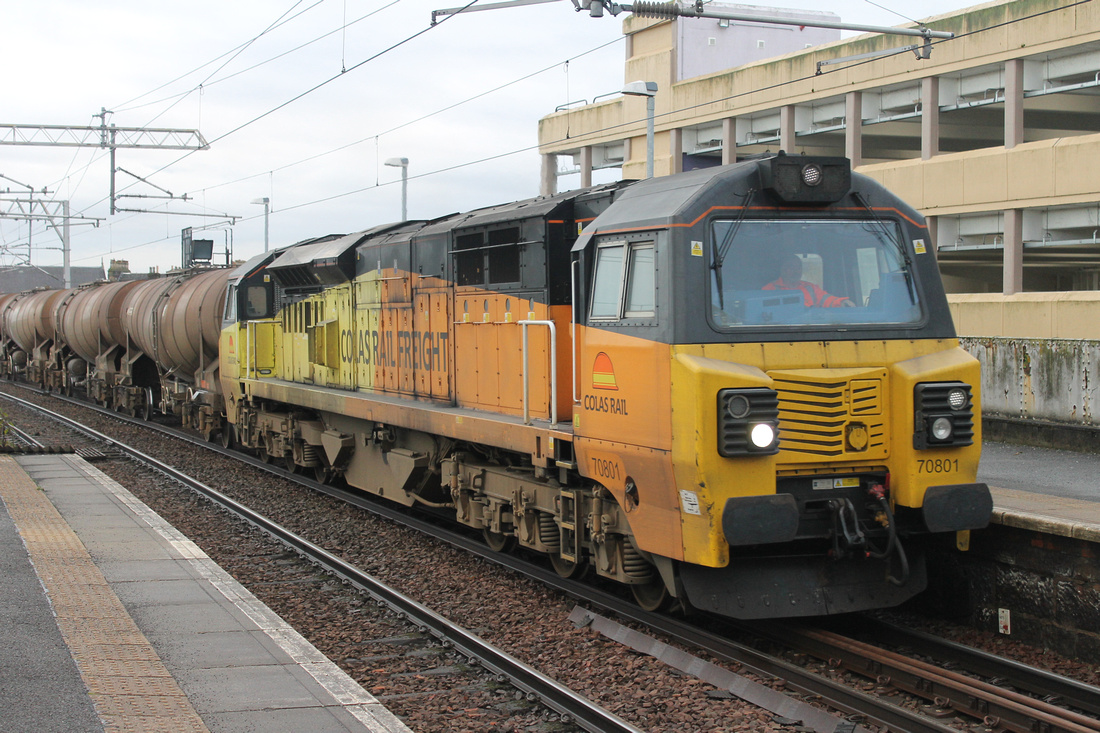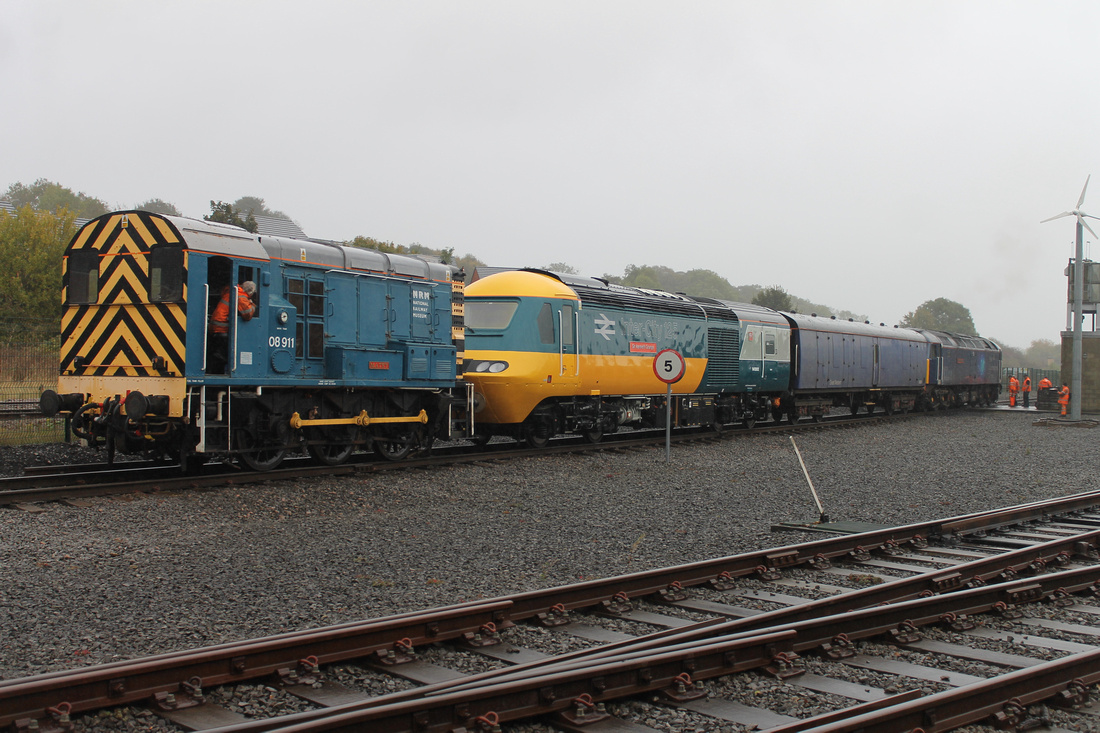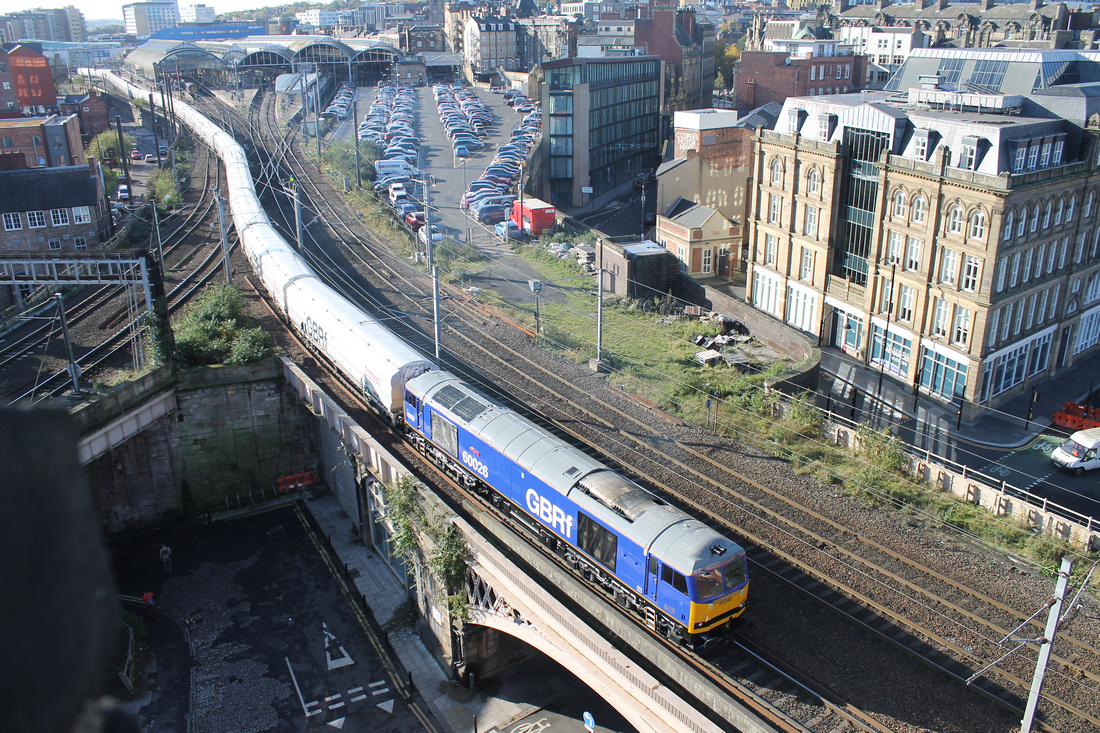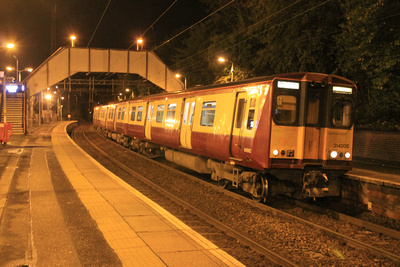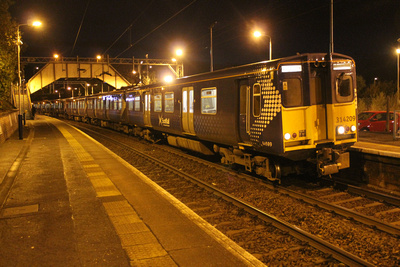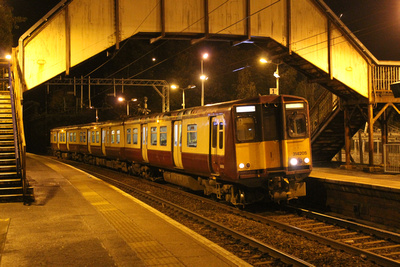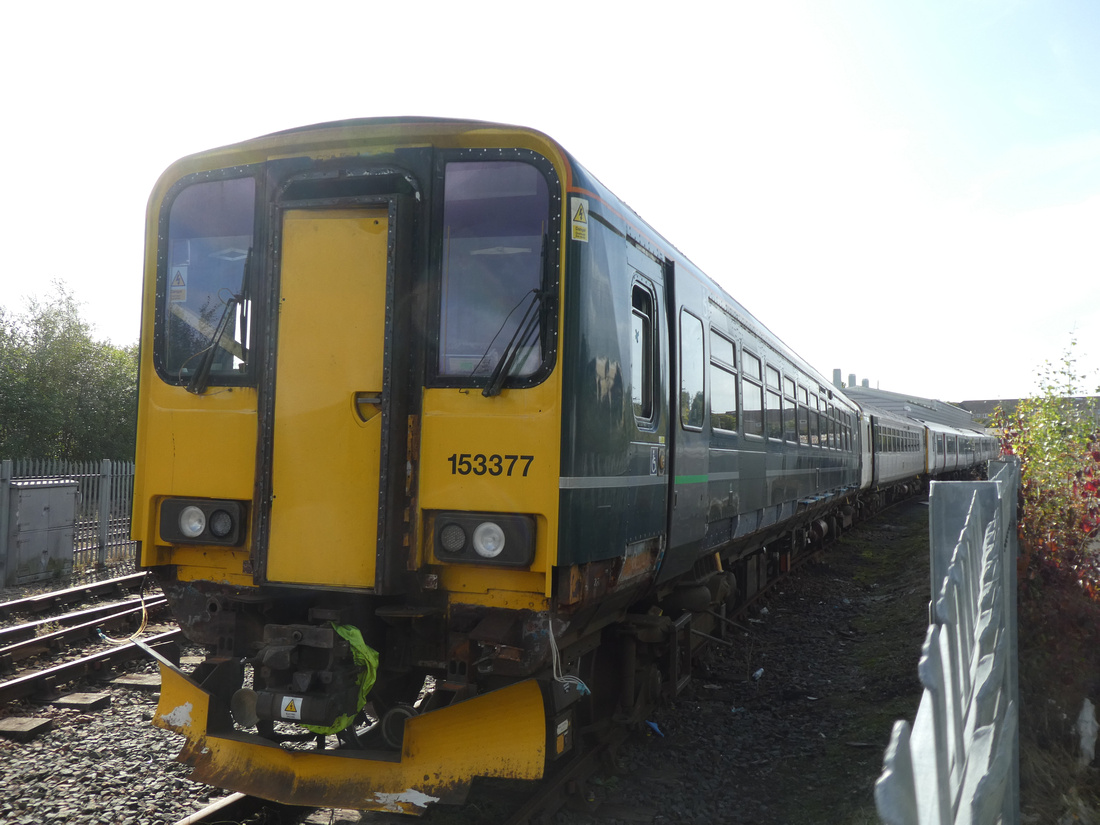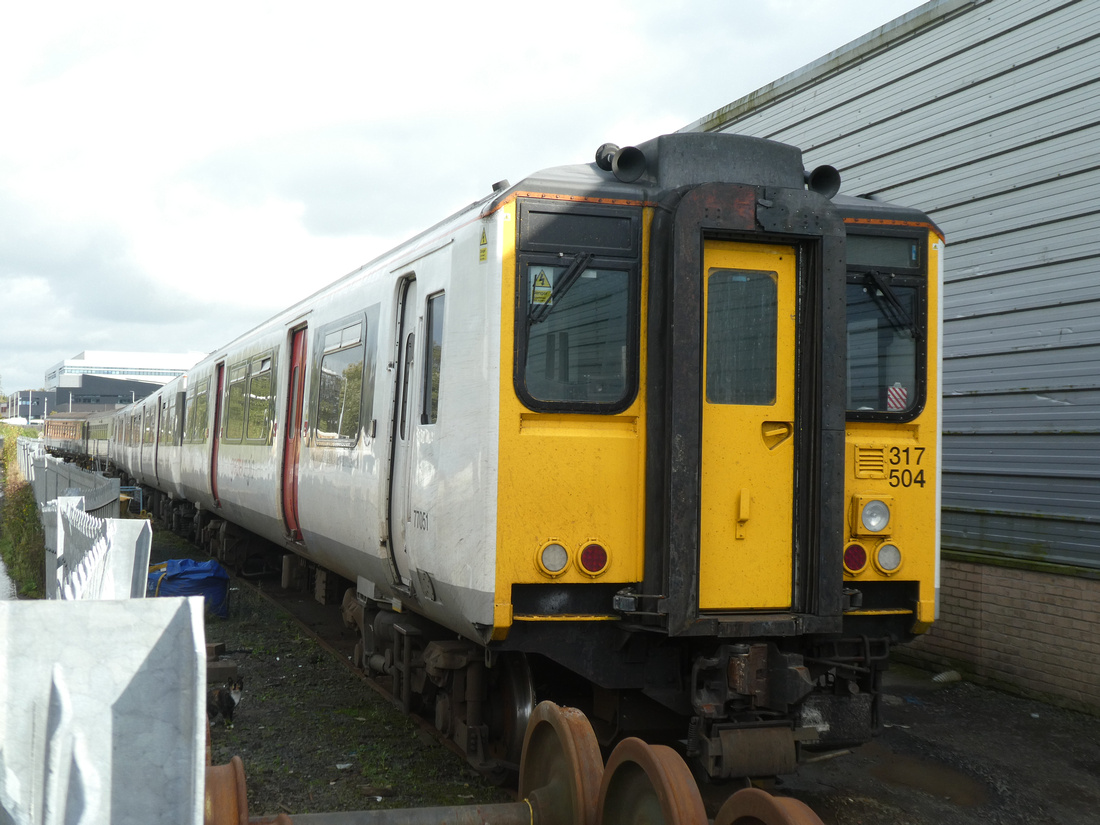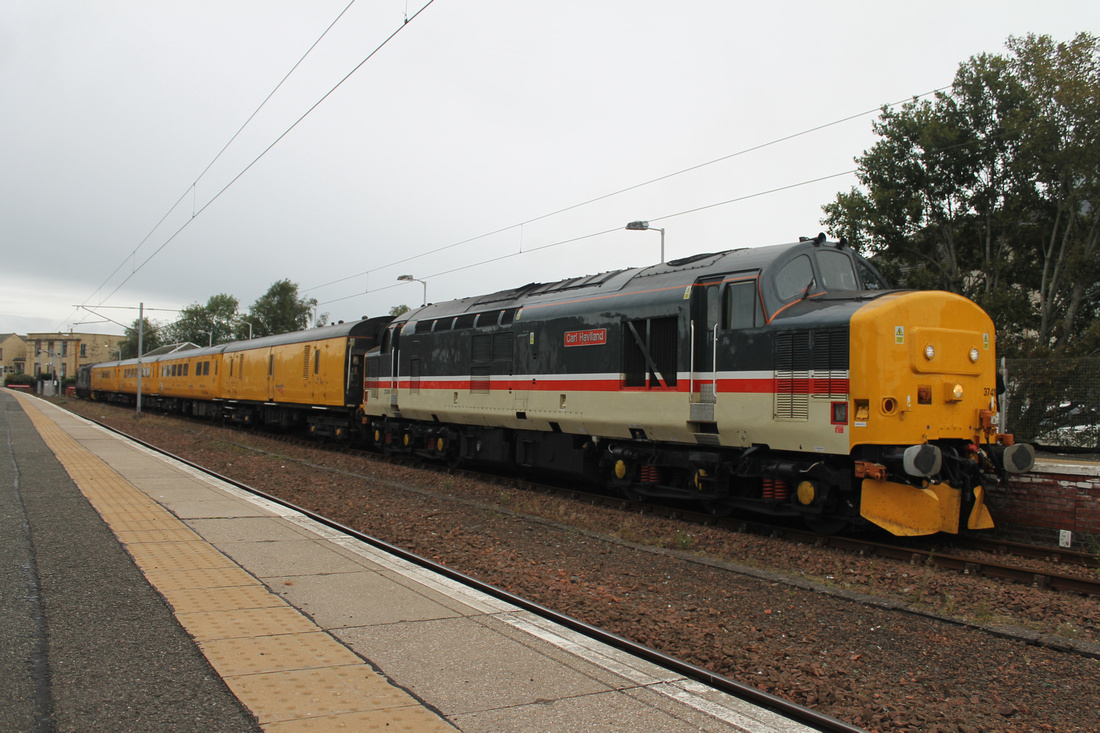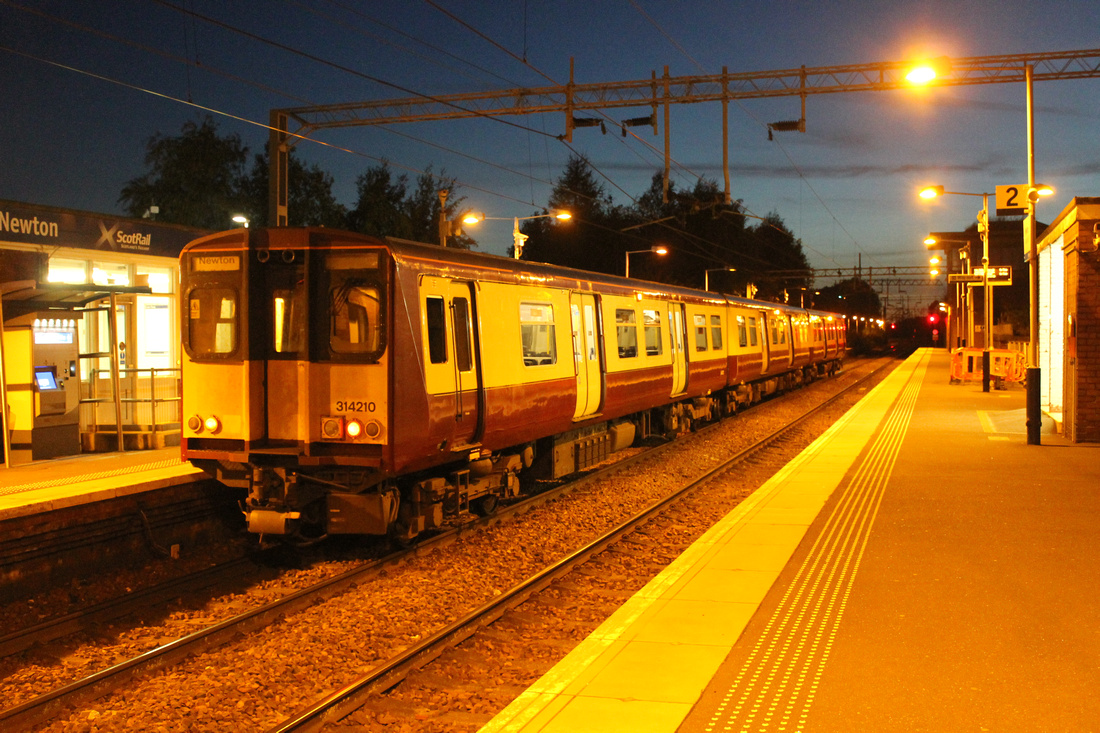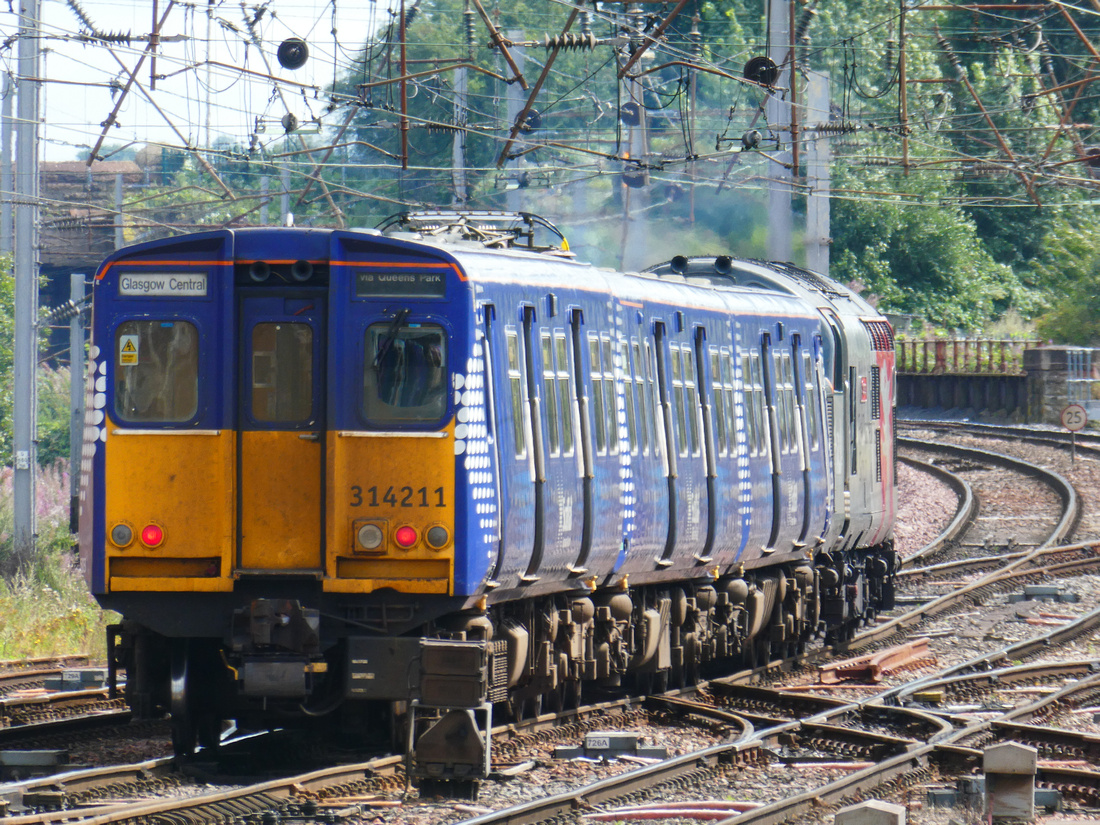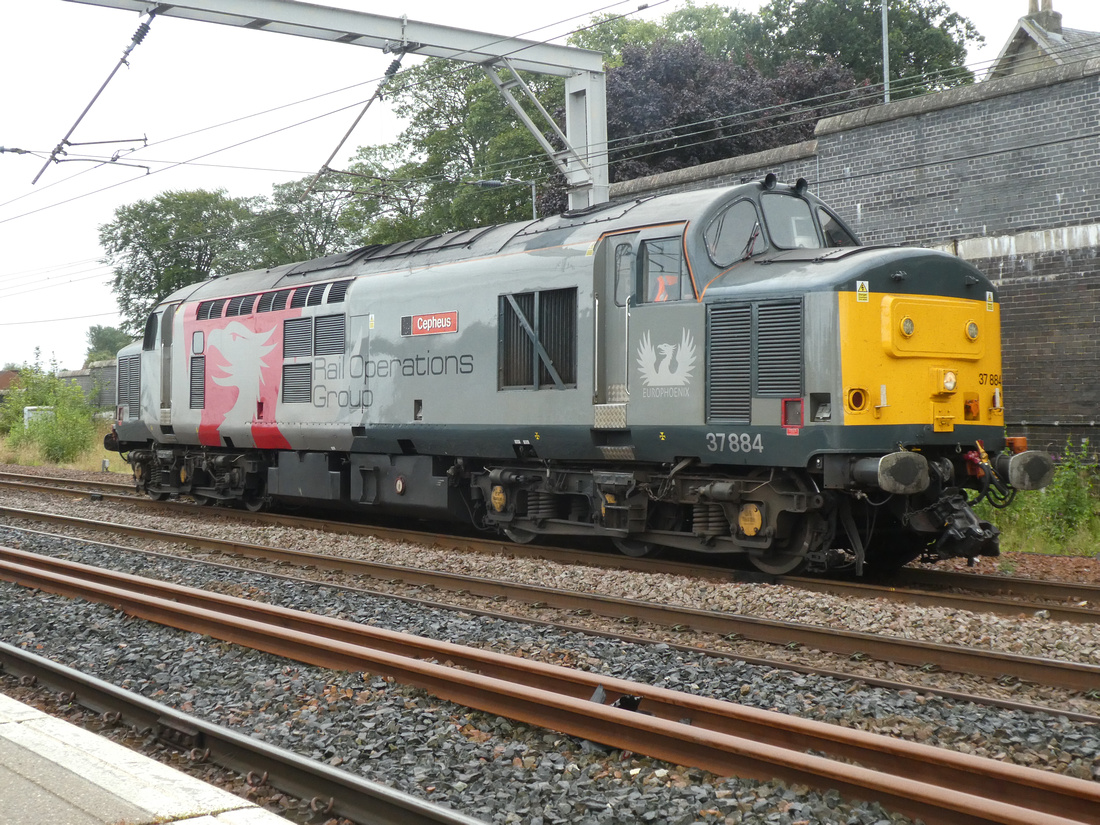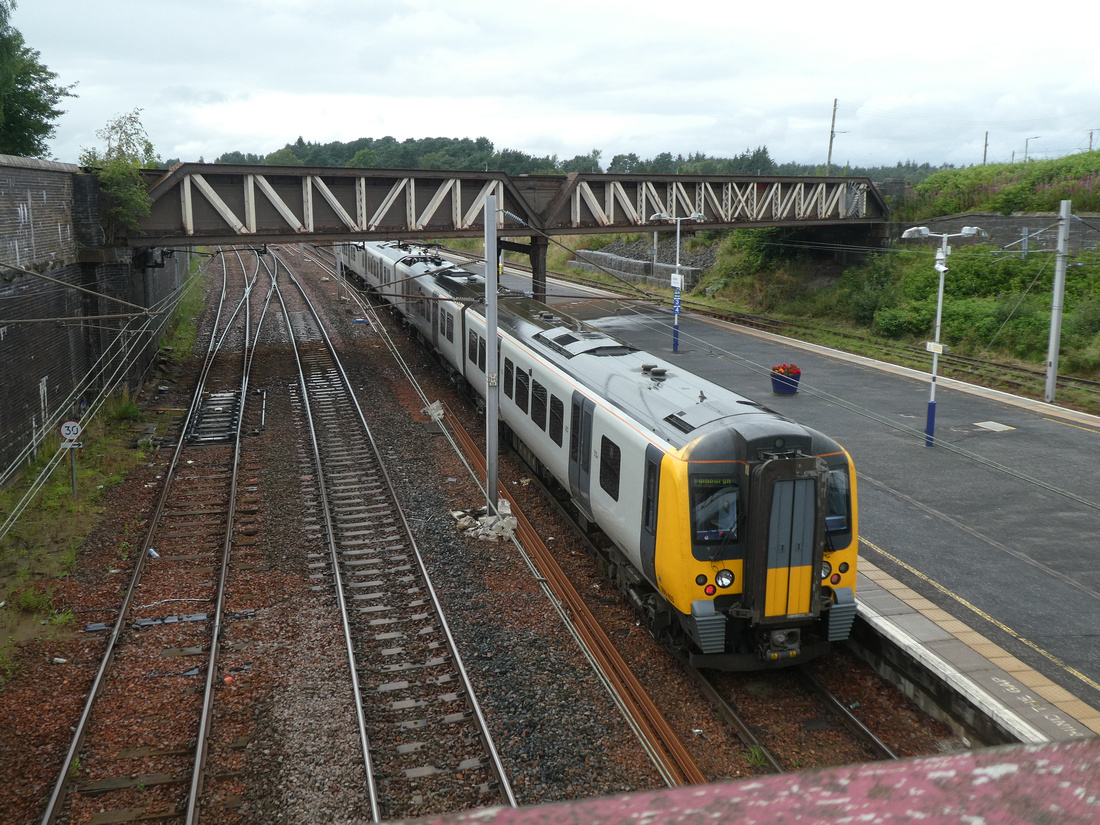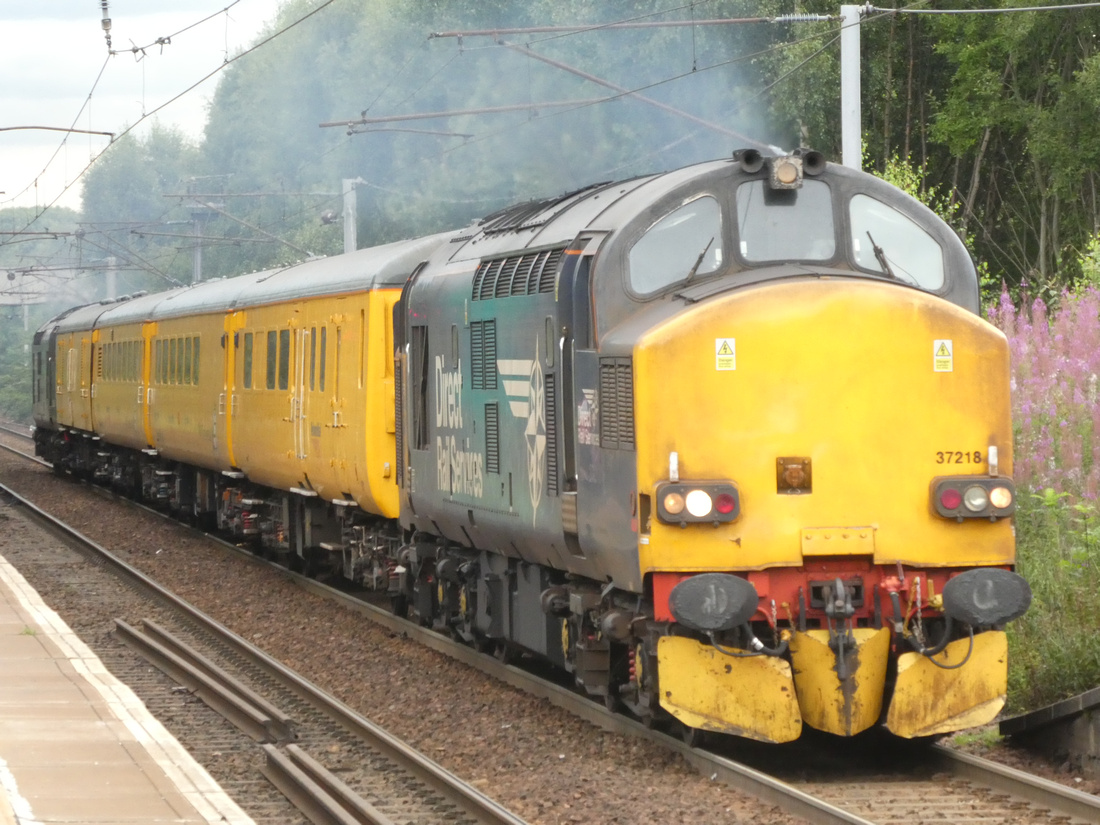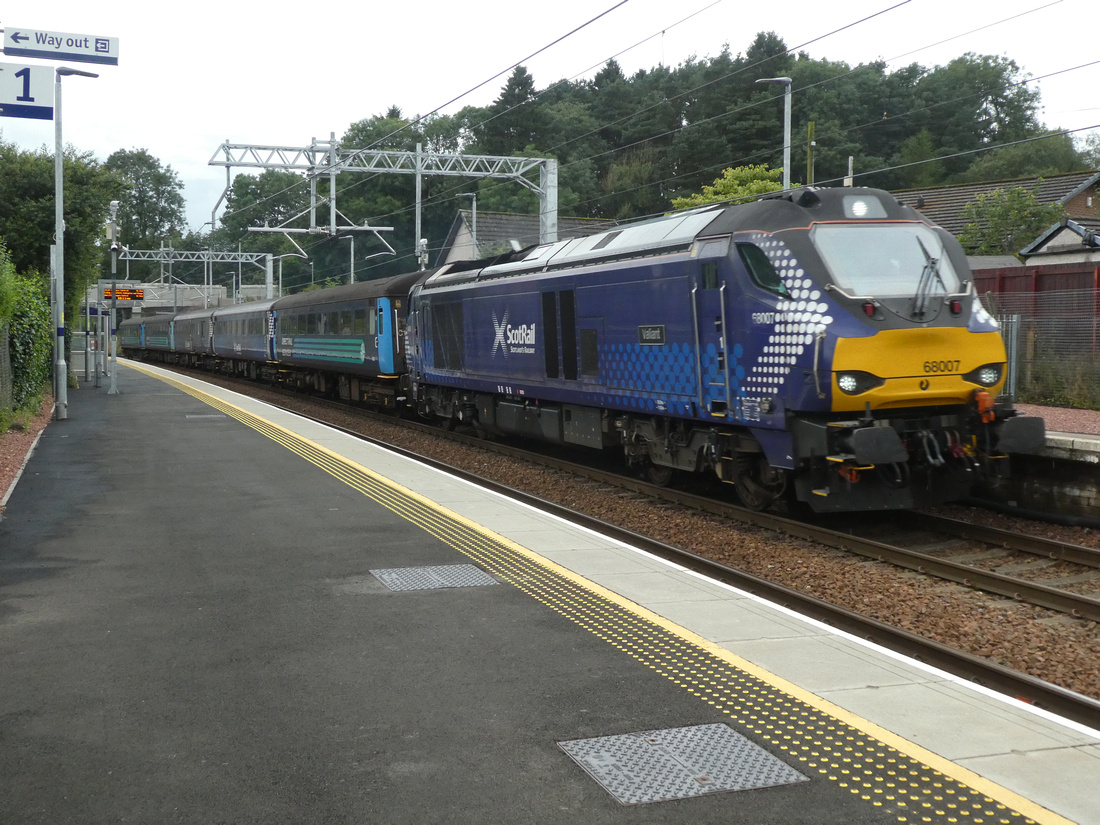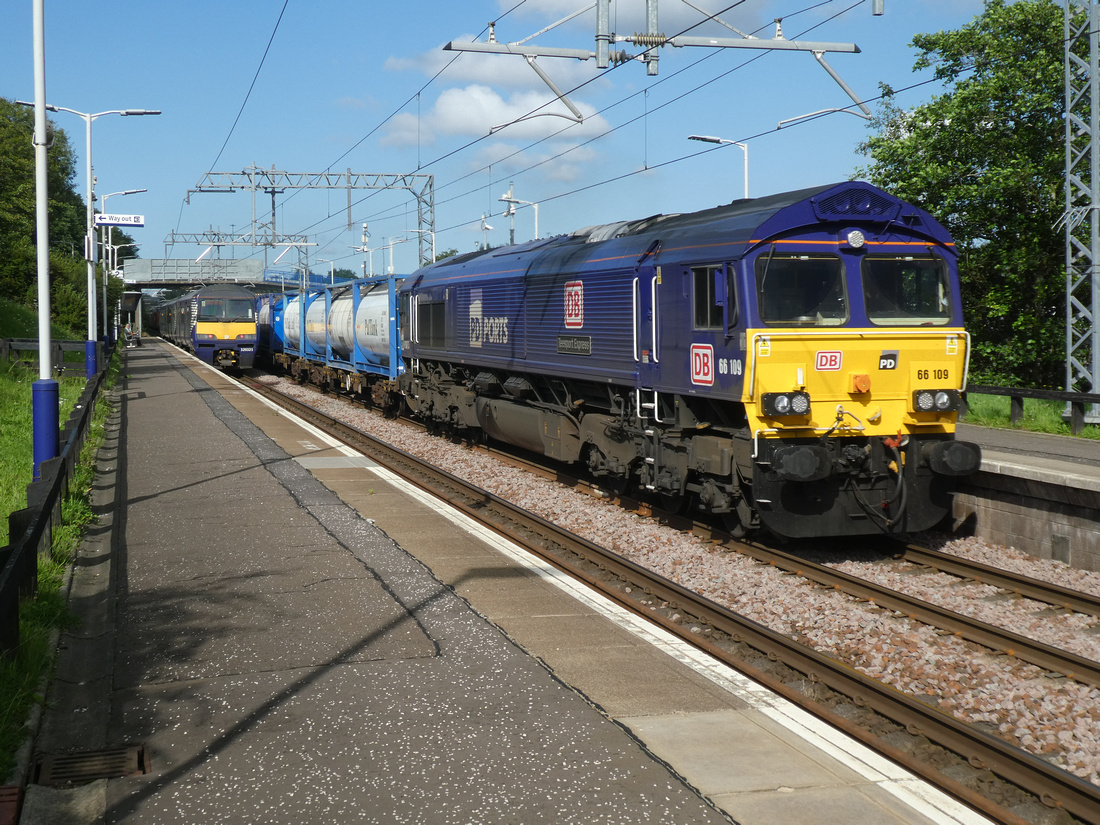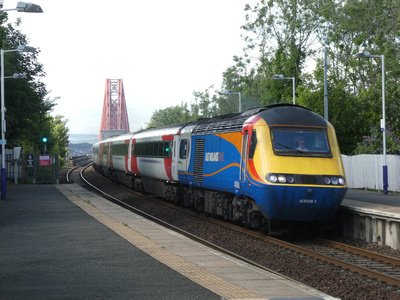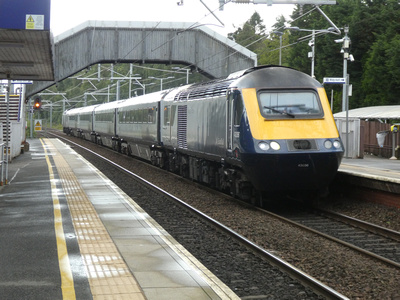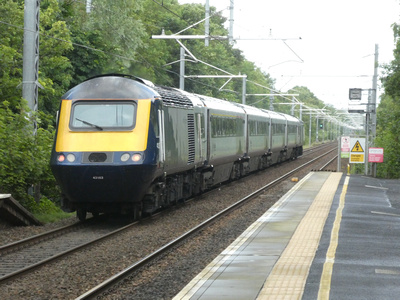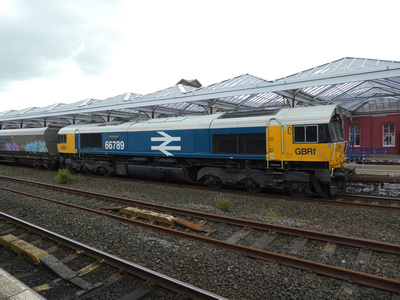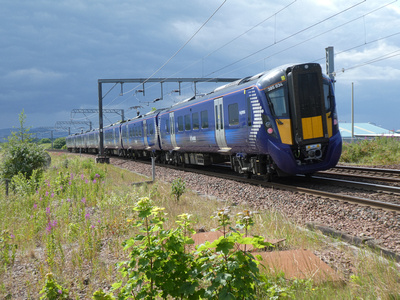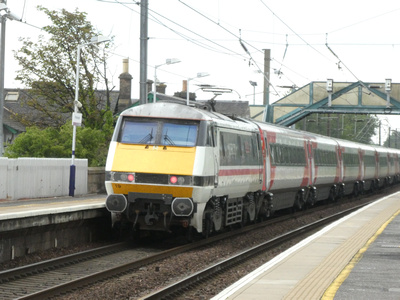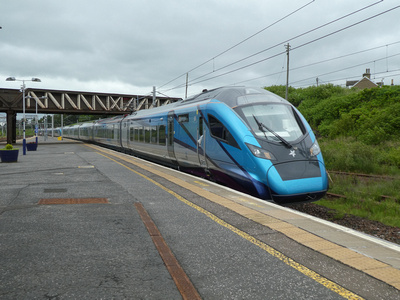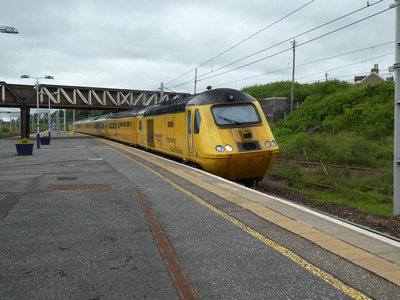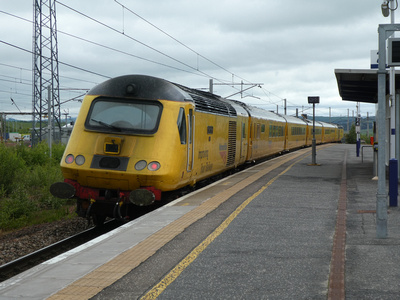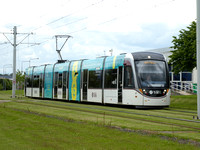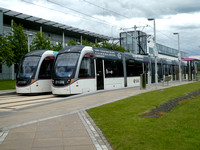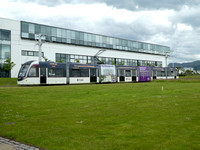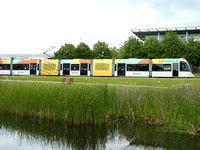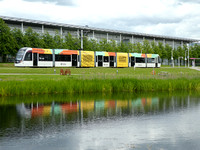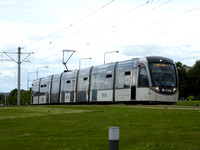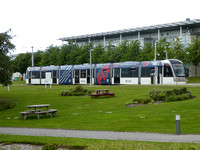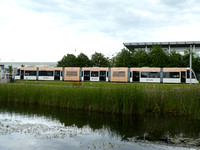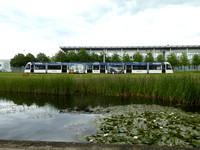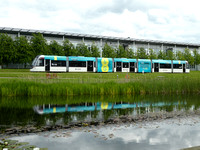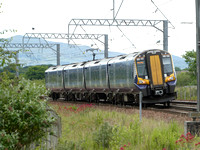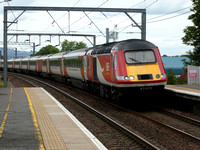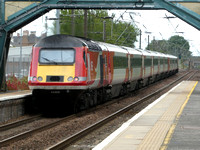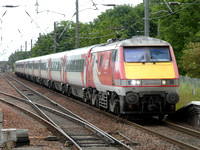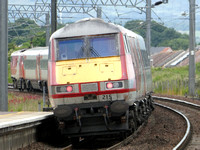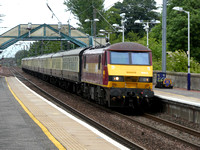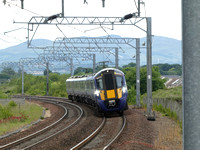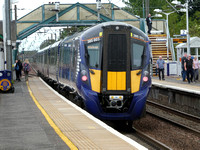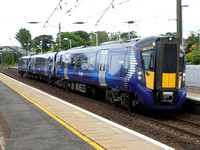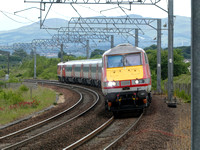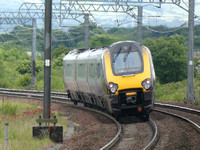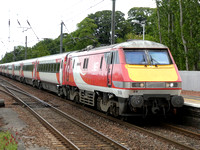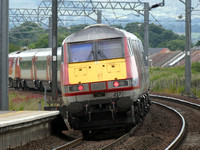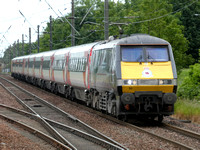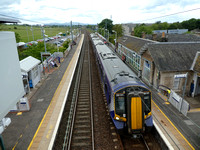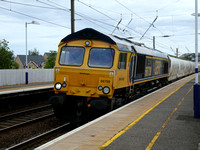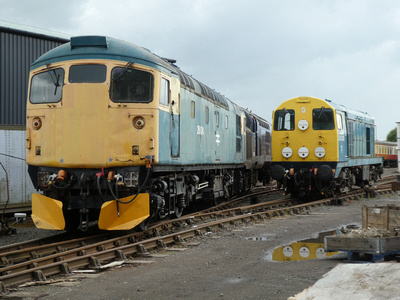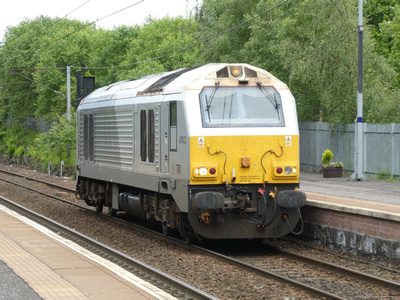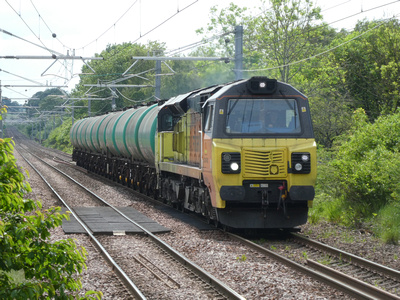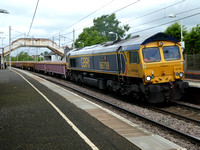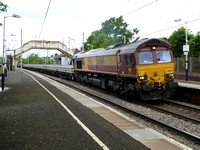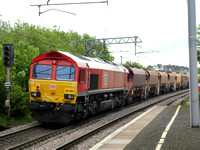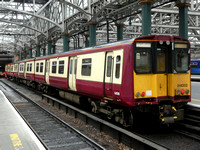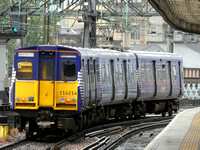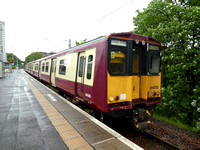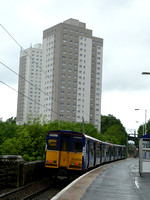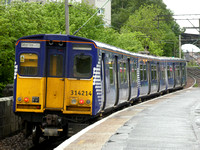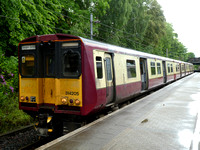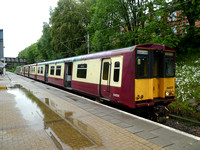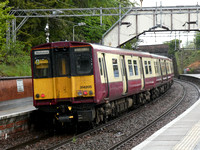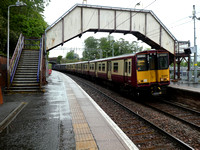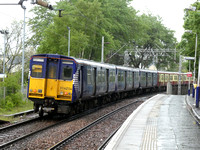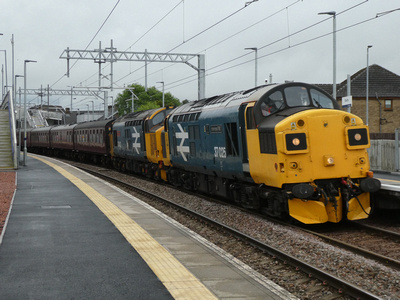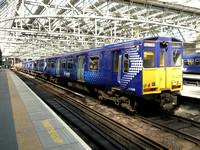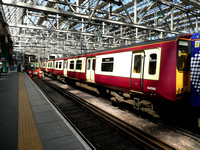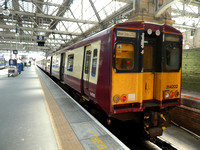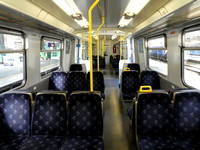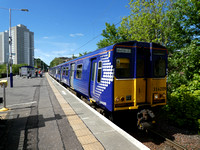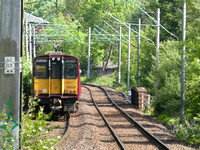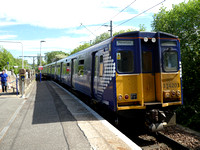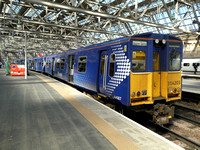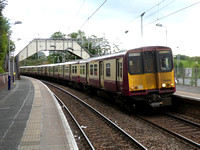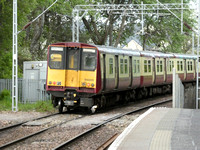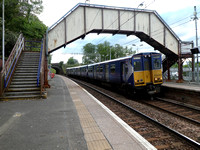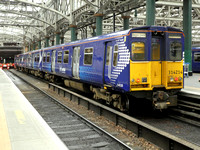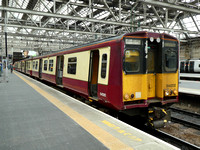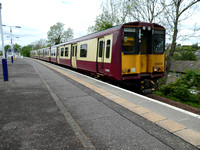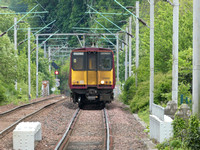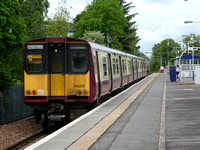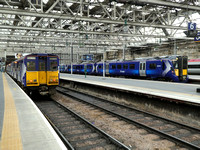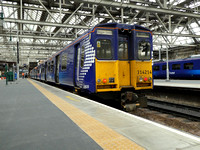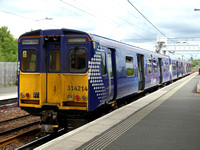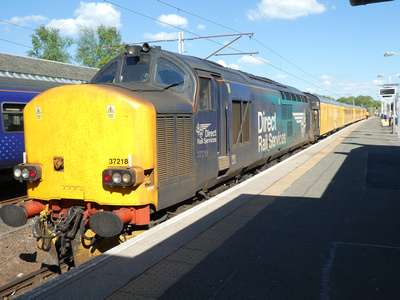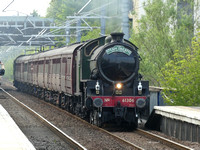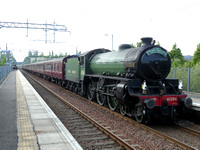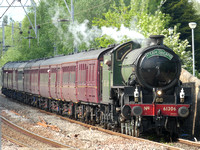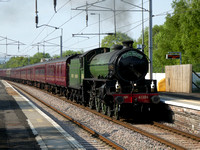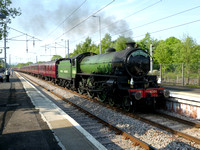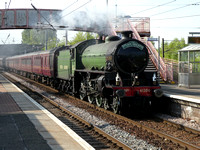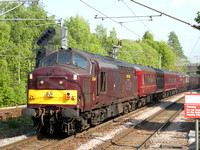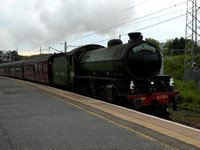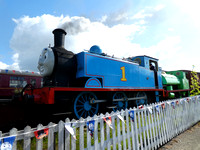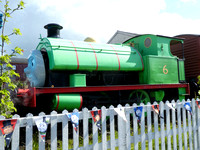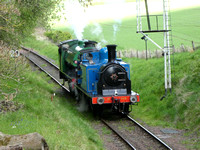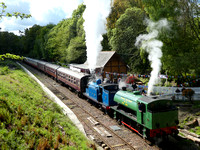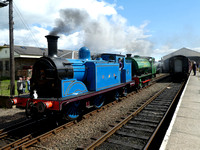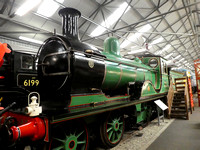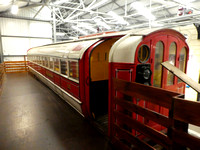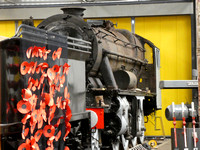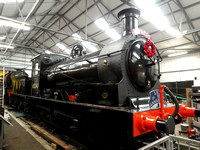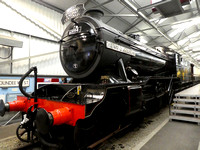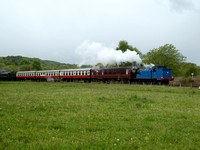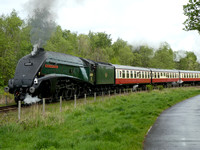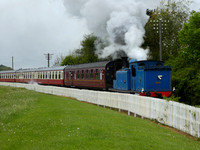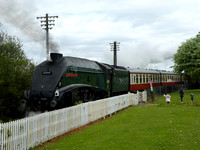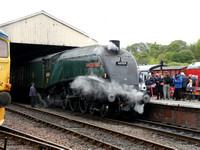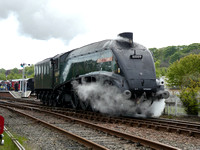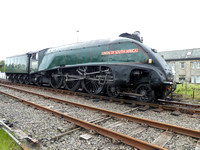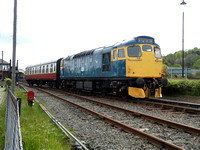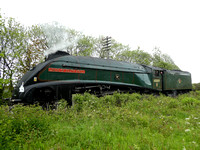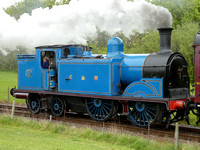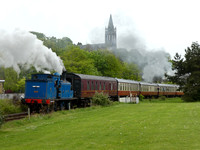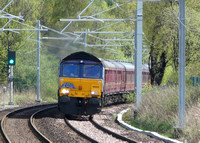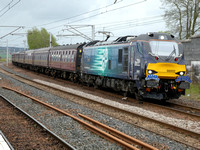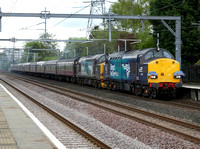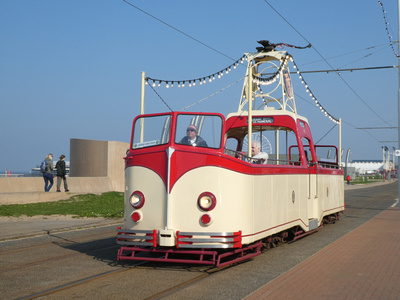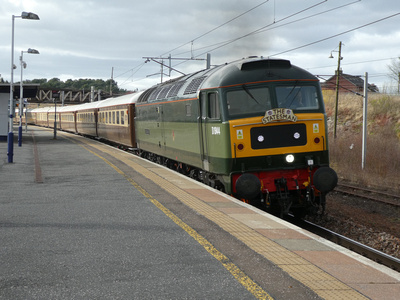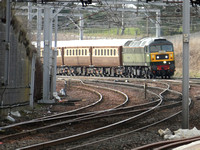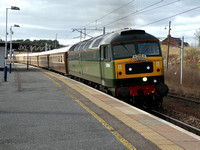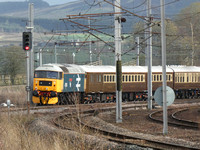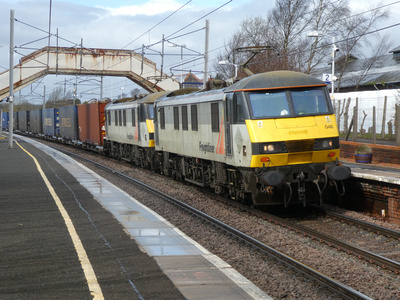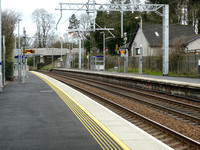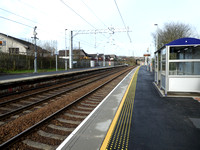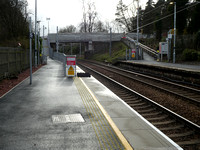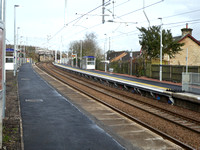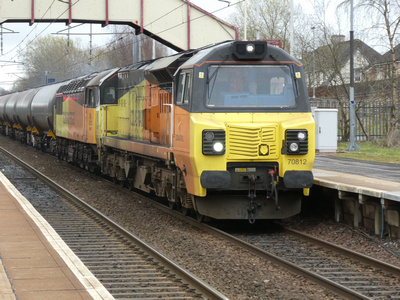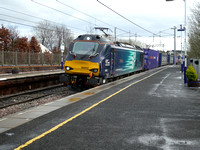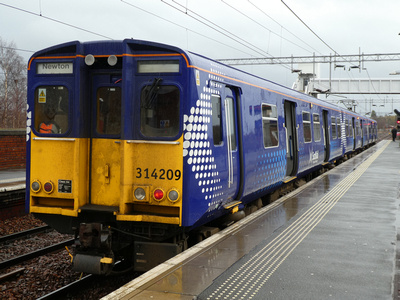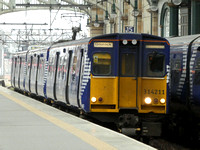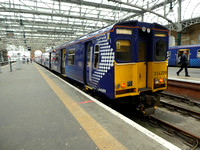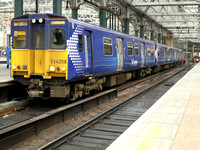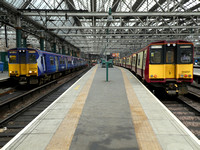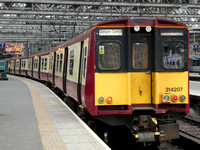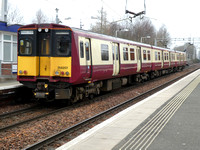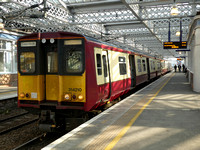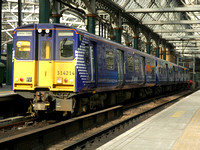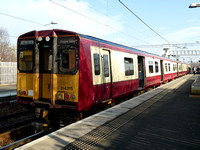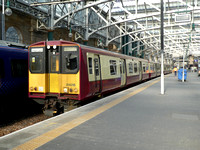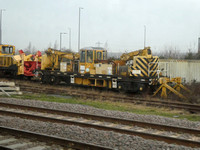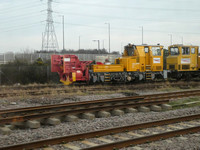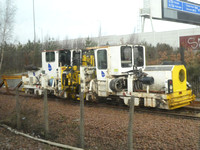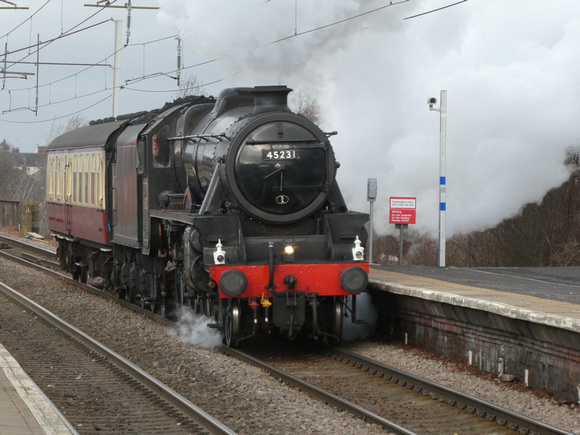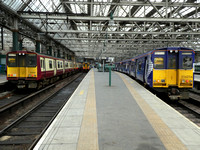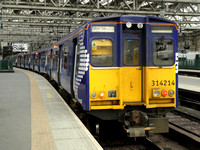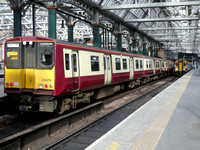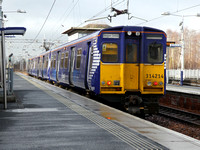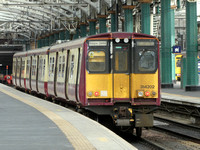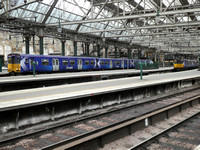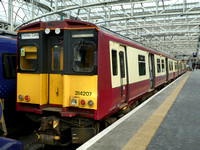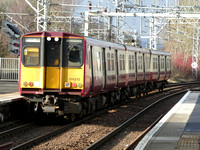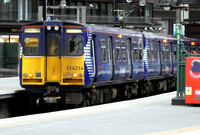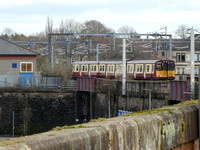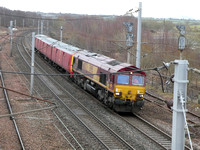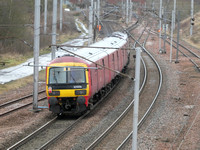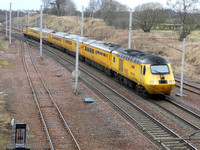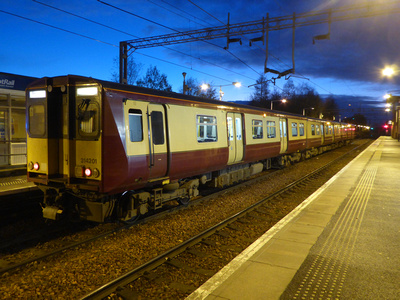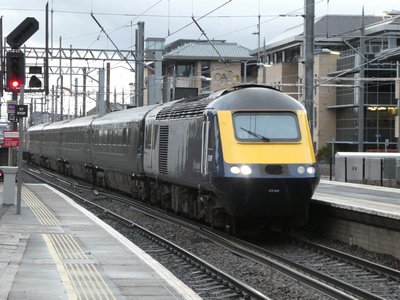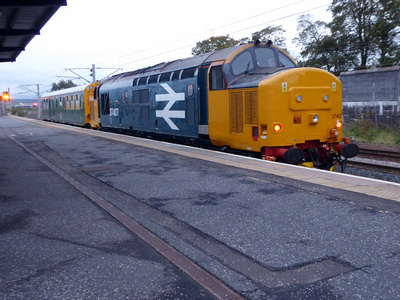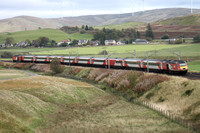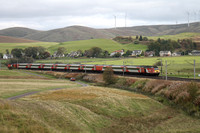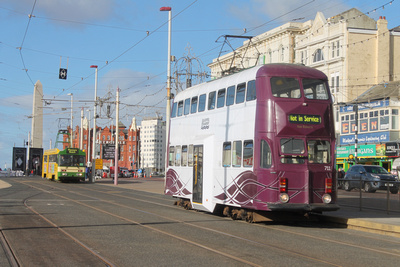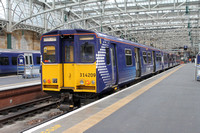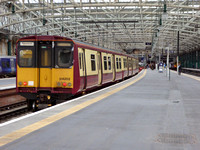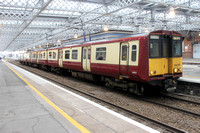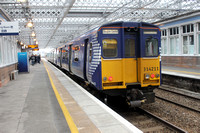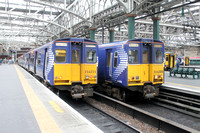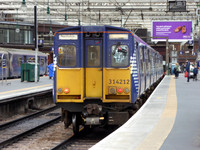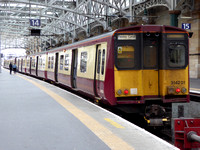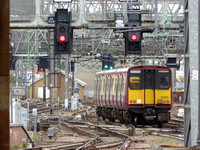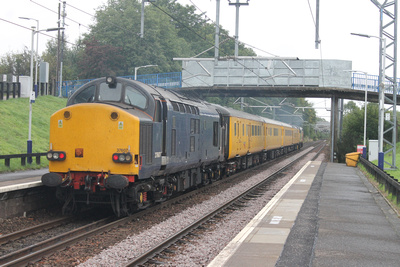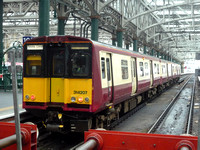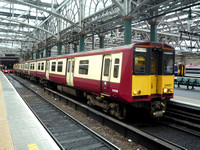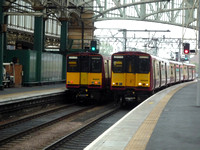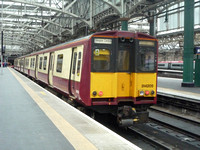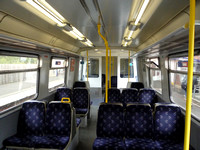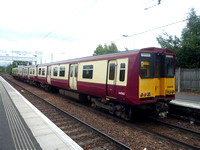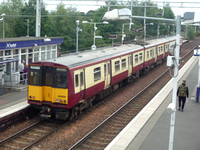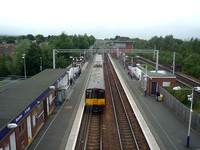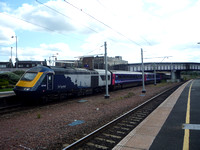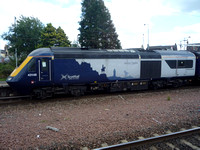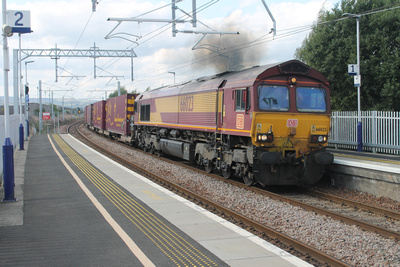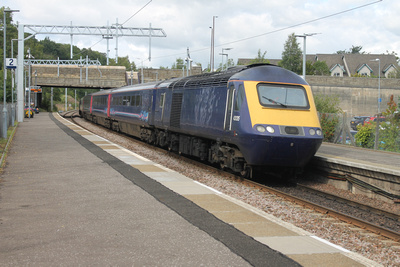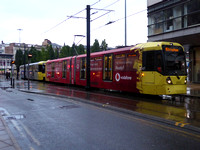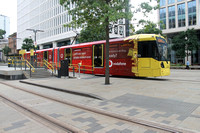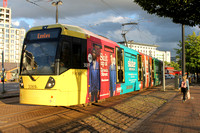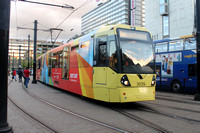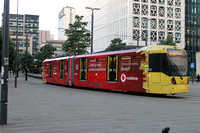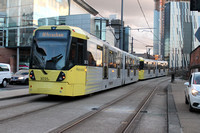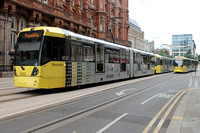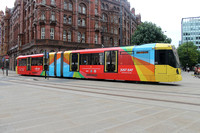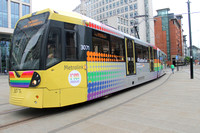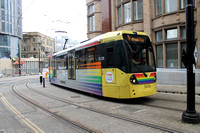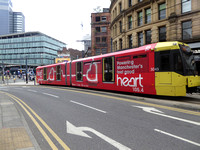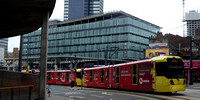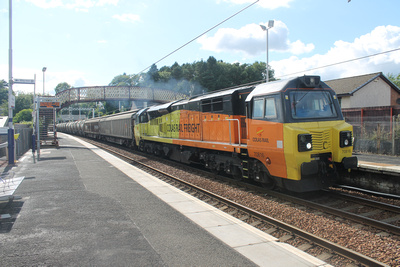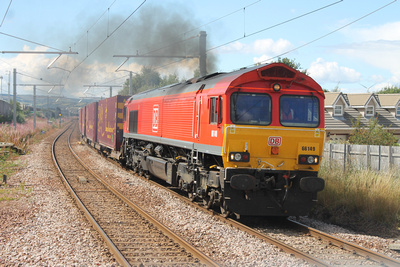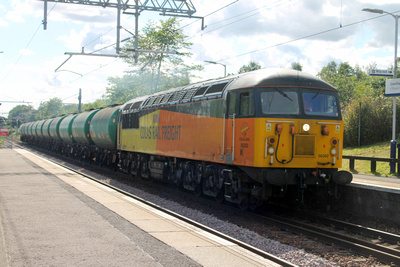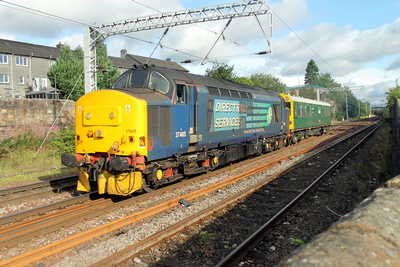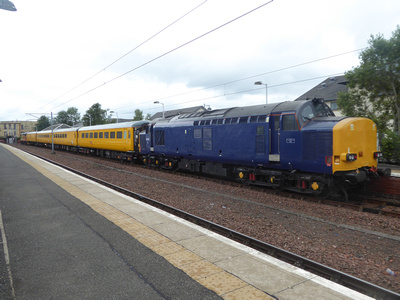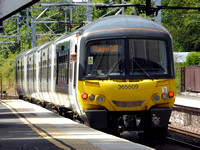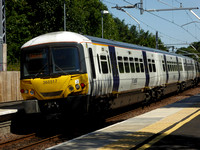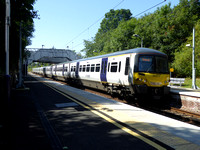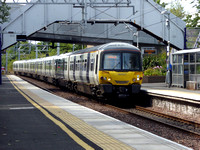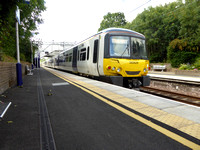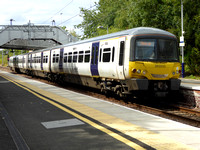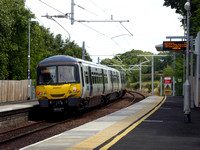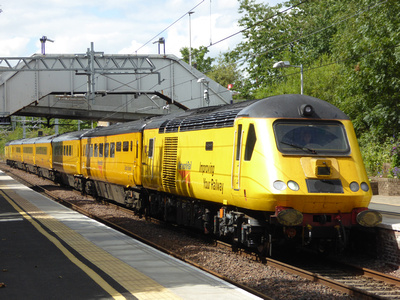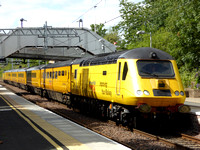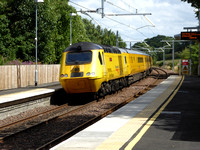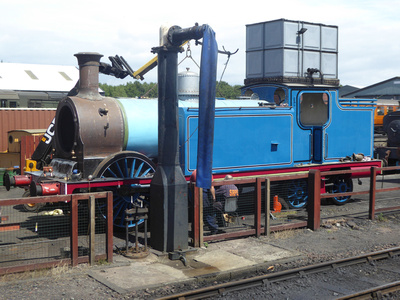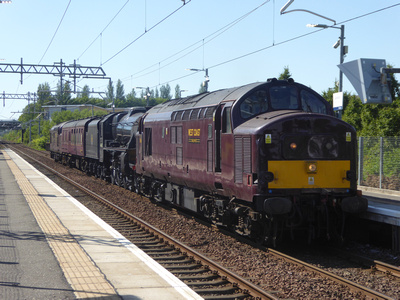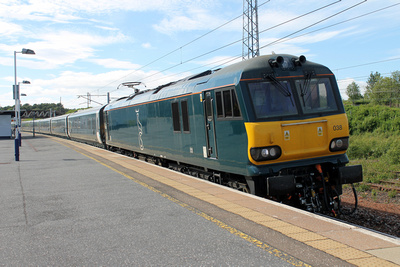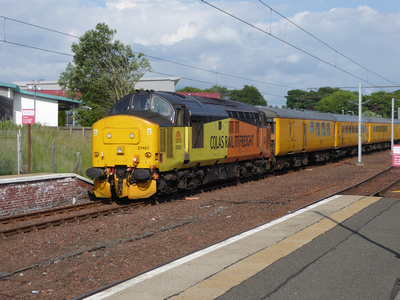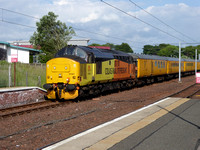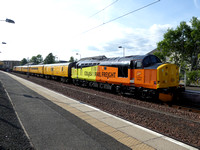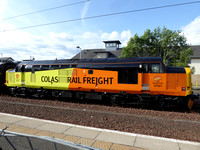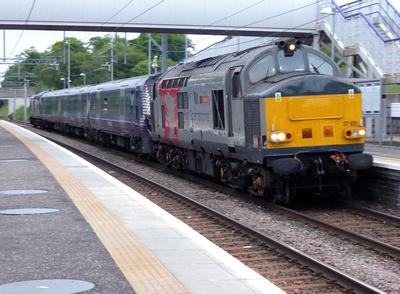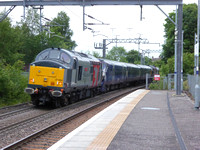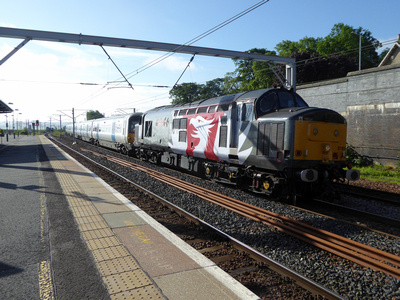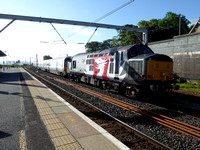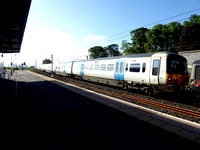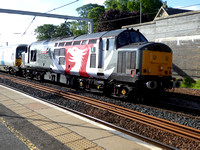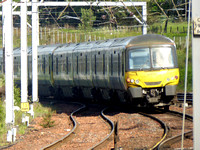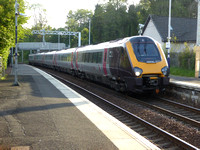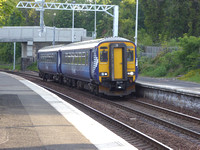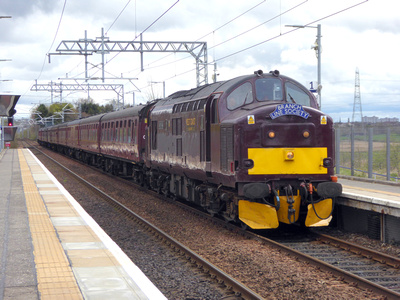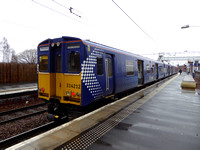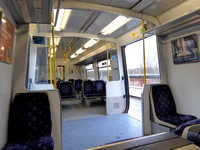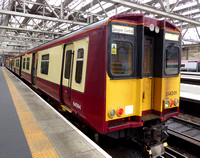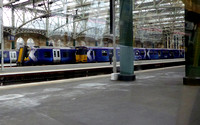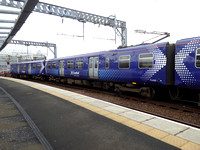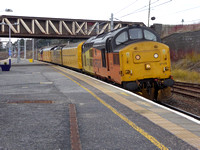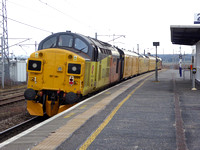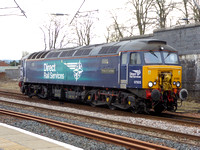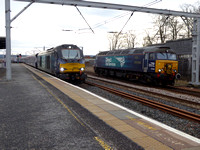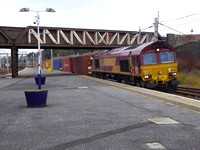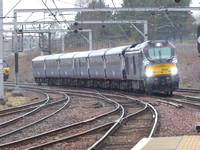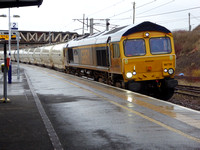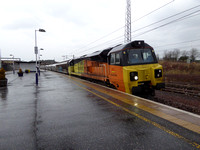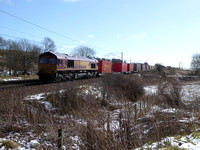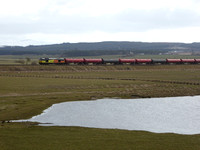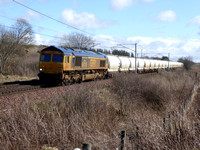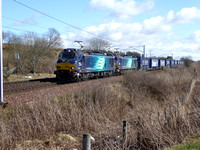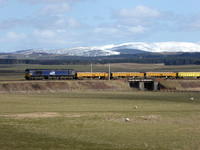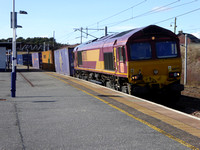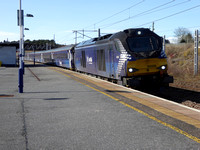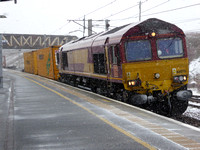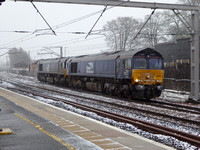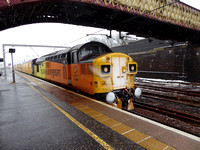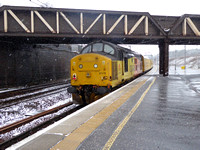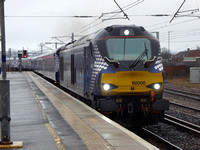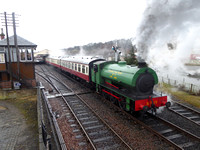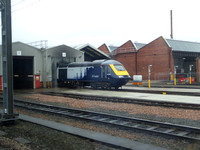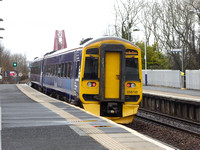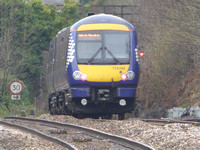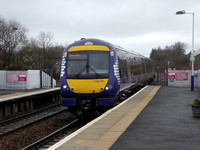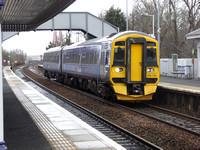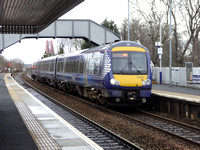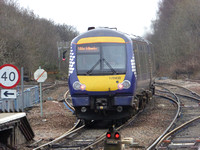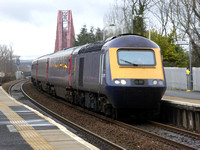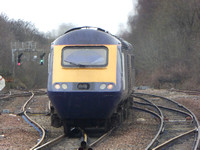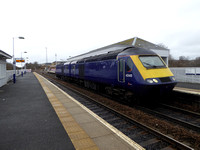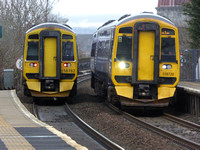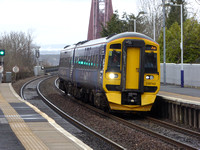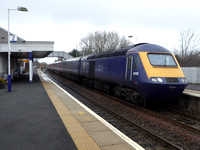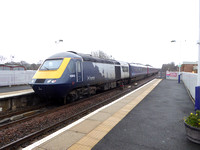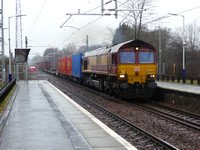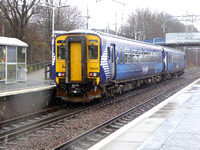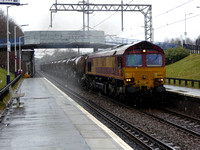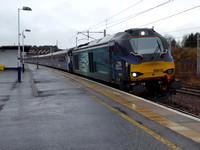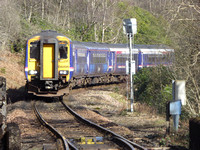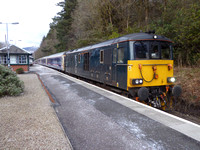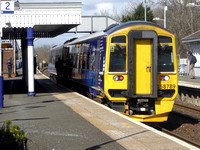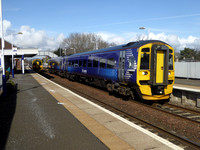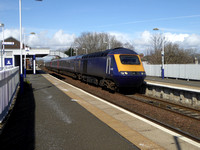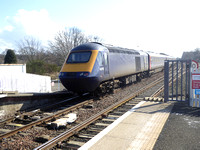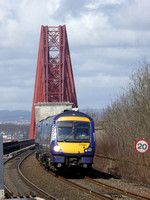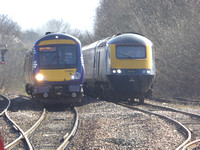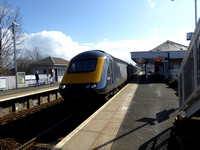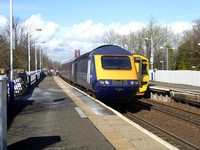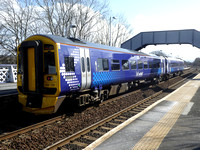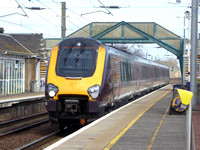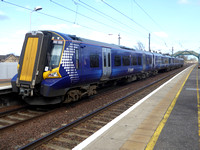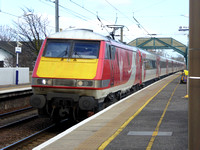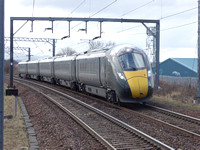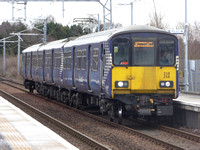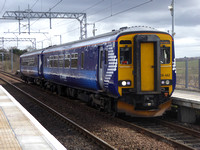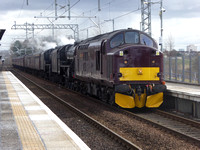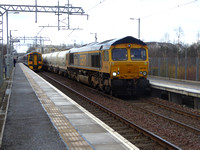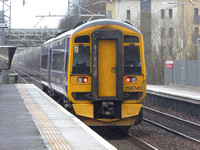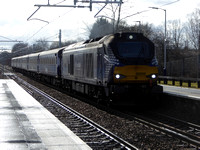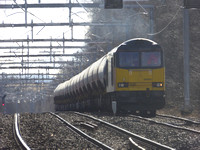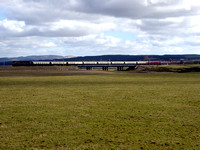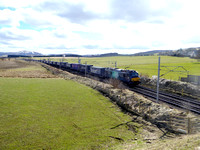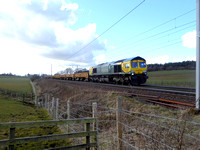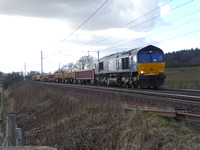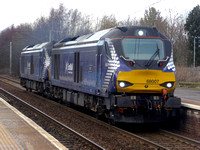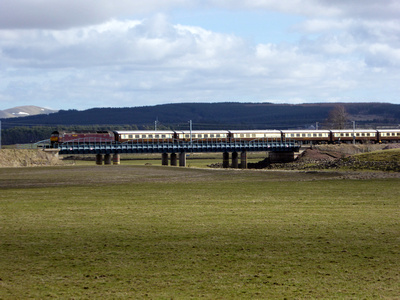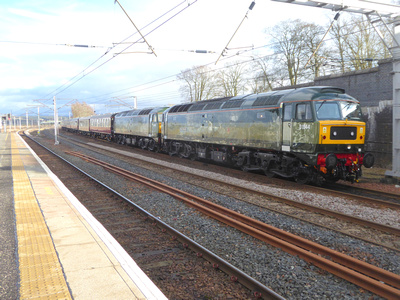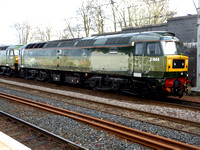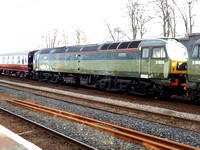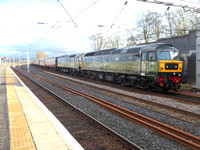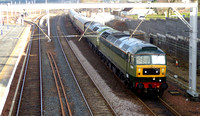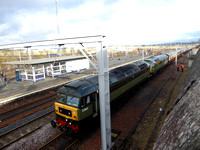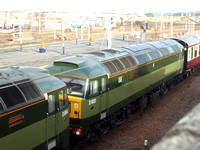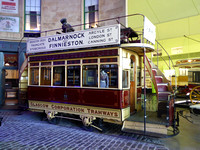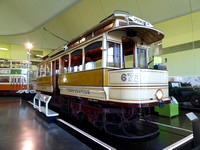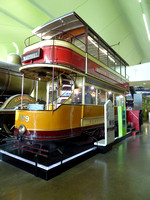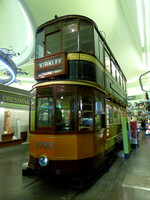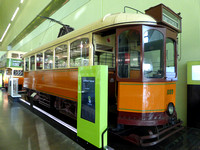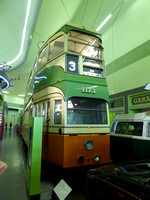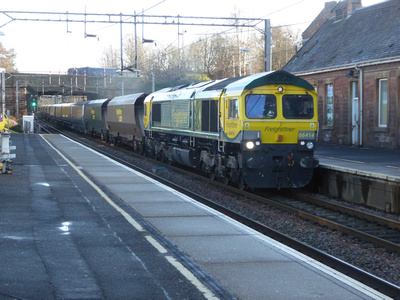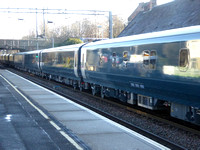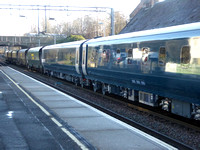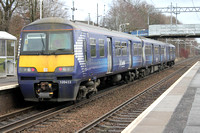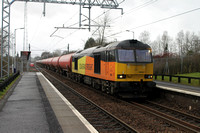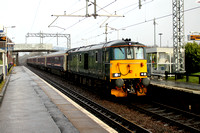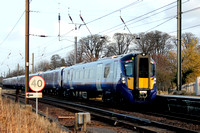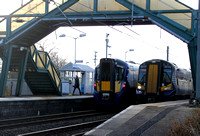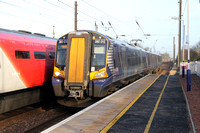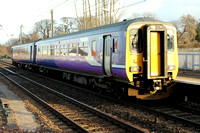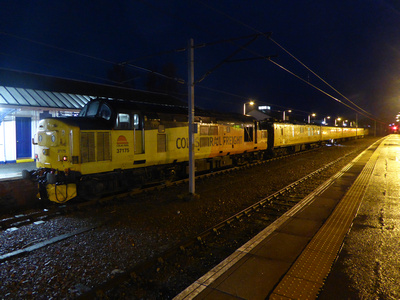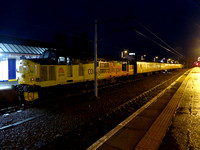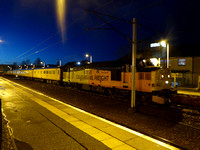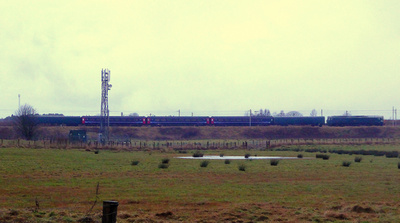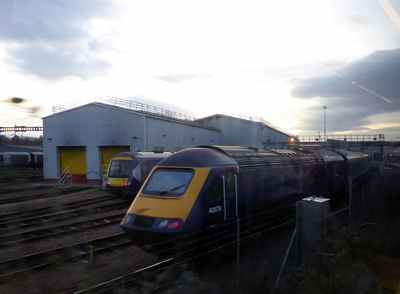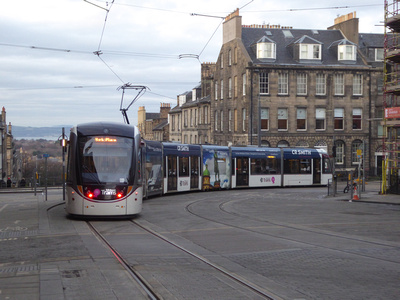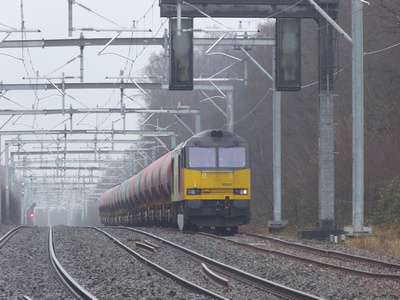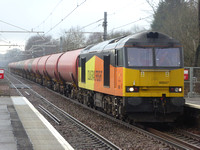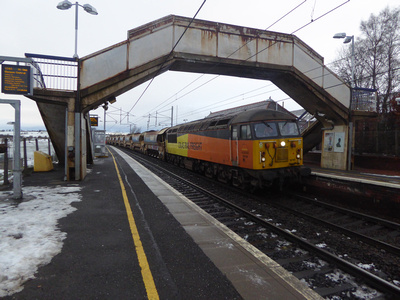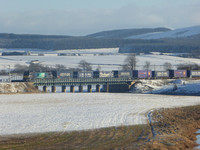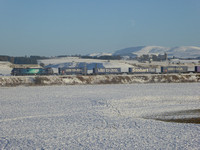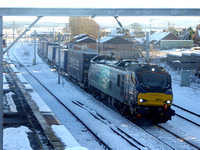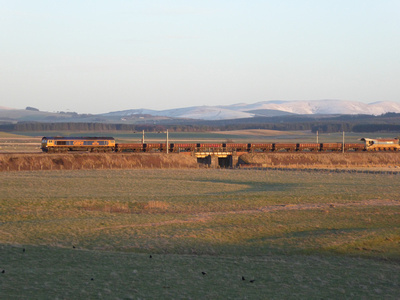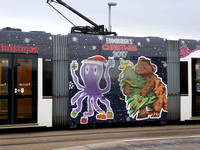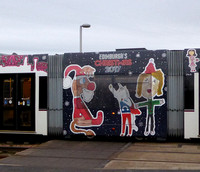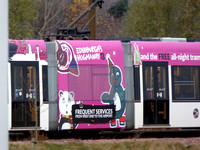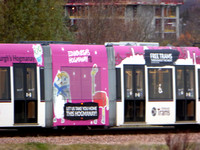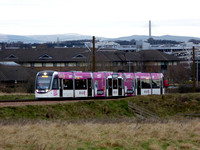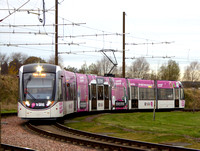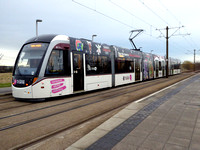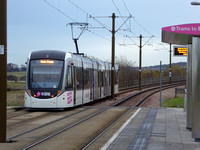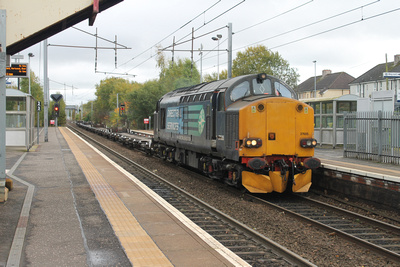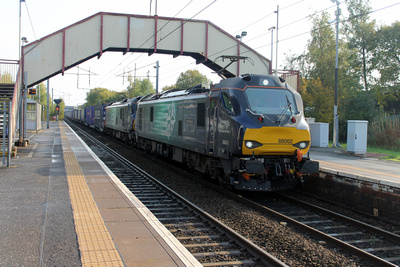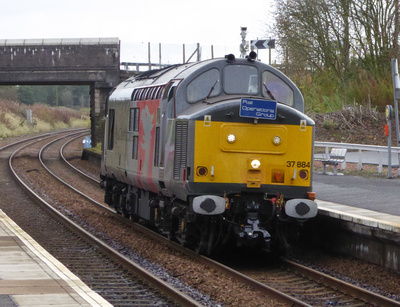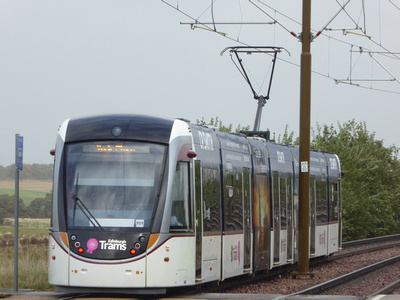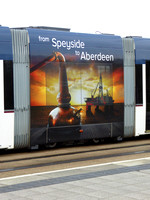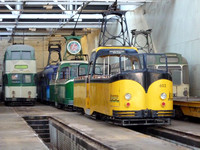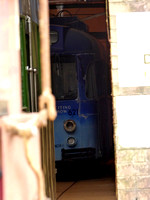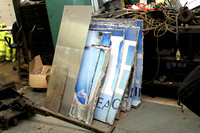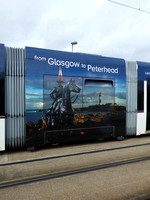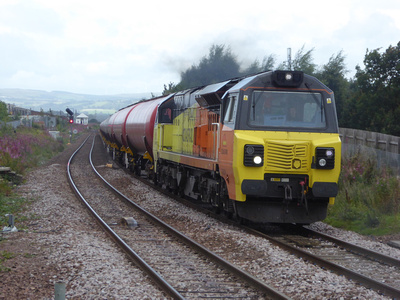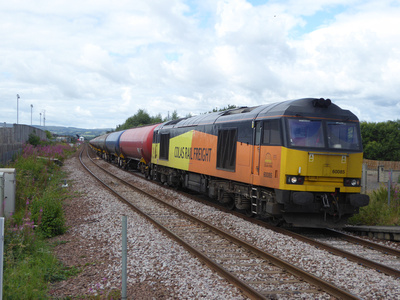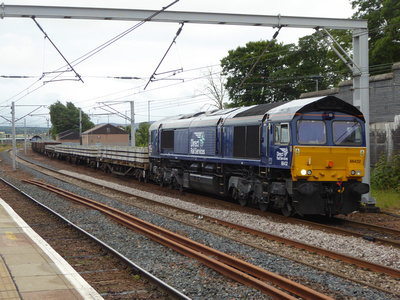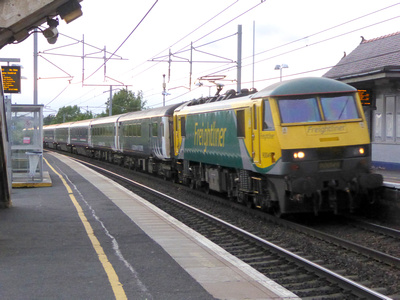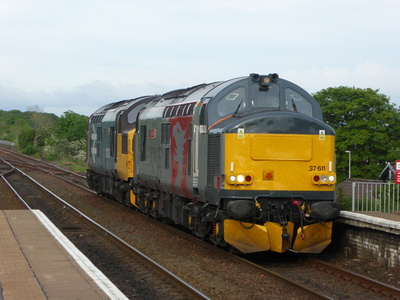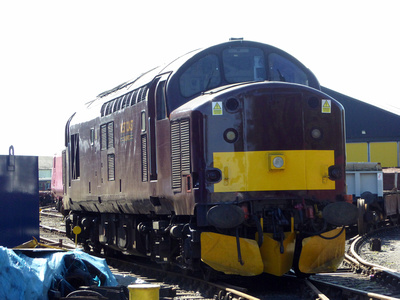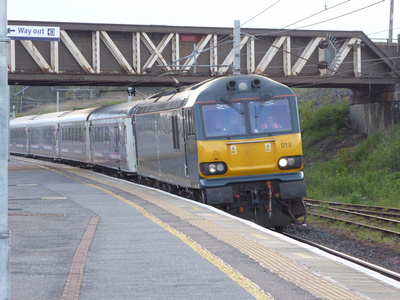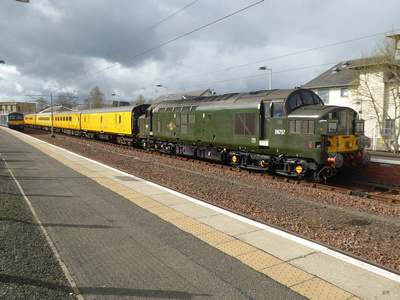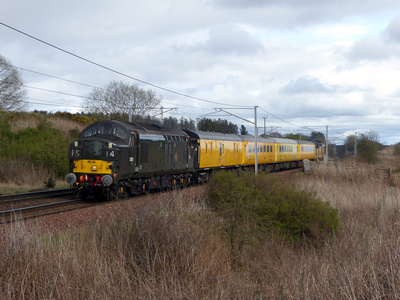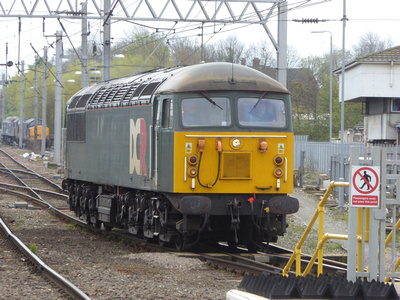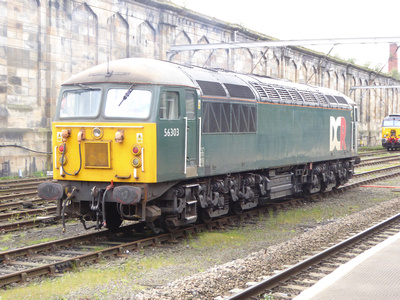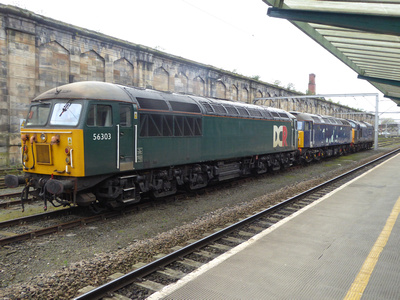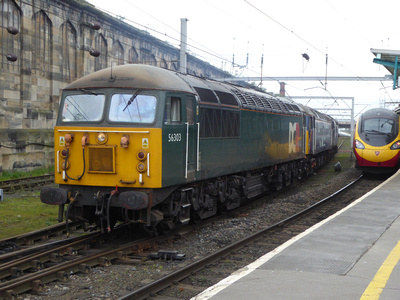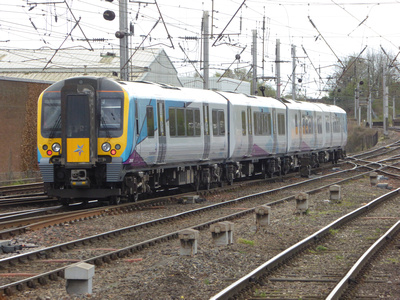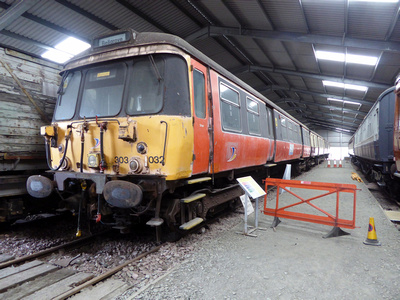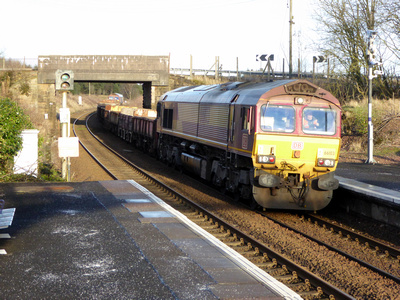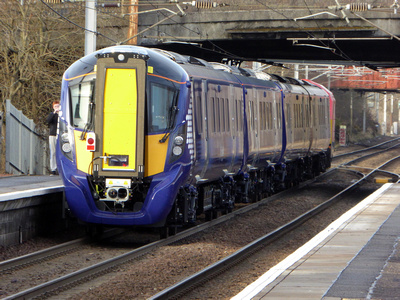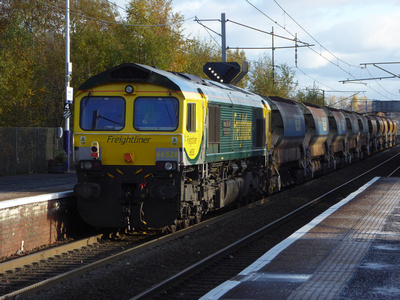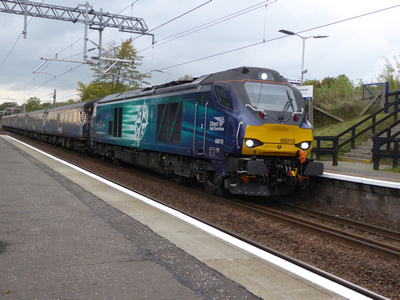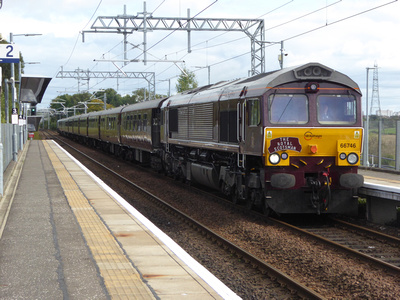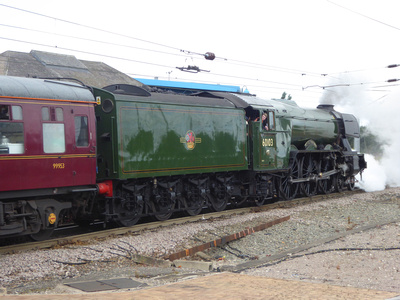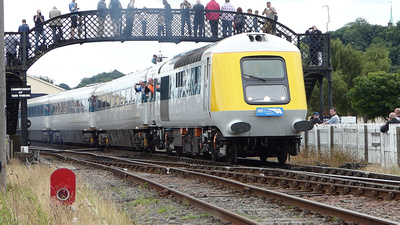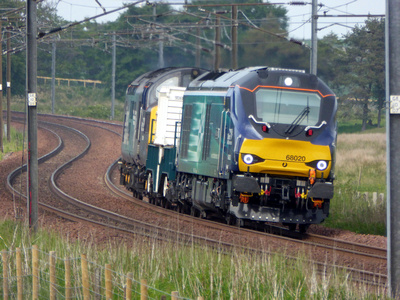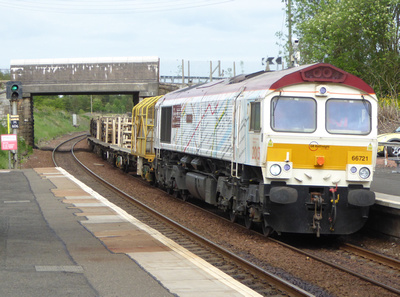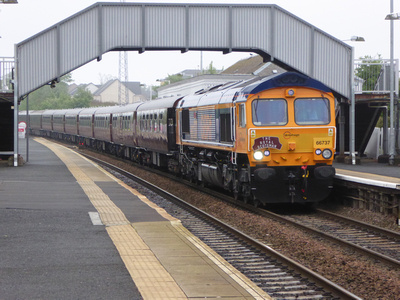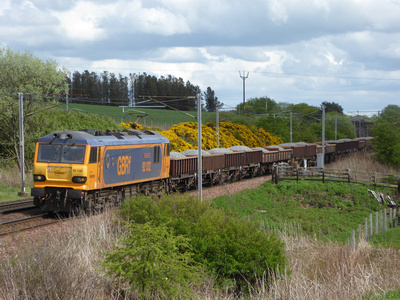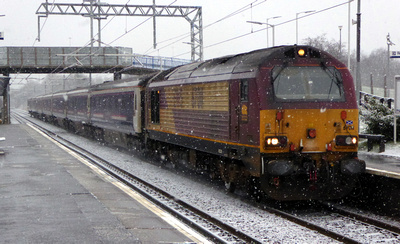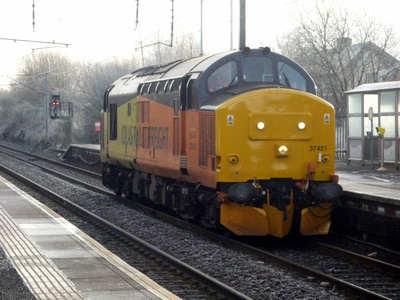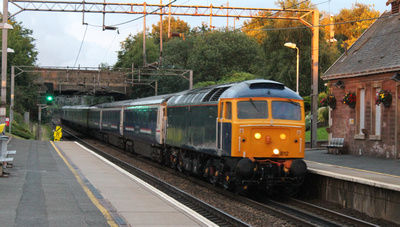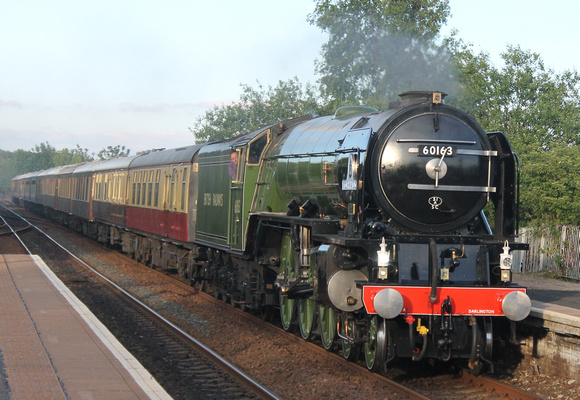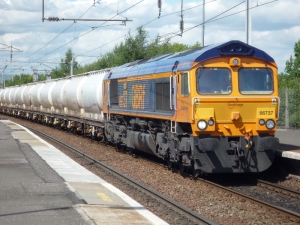314203 and 314211 at Glasgow CentralA scene that will soon become history: 314203 awaits departure from Glasgow Central with 2D27 12.42 service to Paisley Canal and 314211 awaits departure with 2M74 12.45 service to Newton via Maxwell Park 11.1.19 I was passing through Glasgow at lunchtime on Friday 11th January and saw quite a few 314’s.
314201, 314206 and 314209 were stabled at shields, 201 was stabled next to the withdrawn 206. Both had their pantographs down.
At Glasgow central
314216 was on the 12.12 to Paisley canal and 314203 on the 12.42 service
314208 was on the 12.25 to Gourock
314215 was on the 12.19 service from Newton
314211 was on the 12.45 to Newton and 314214 on the 12.51 Cathcart outer circle service.
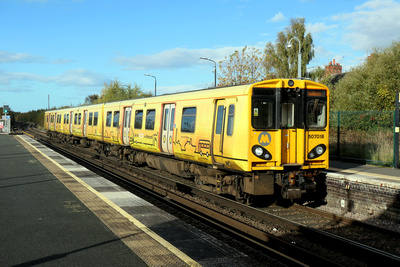 With only a couple of months left before they go off lease, 46 years of service for the remaining Merseyrail fleet will soon be coming to an end. 6 of the 507s remain available for service: 507001, 003, 007, 018, 023 and 029.
With only a couple of months left before they go off lease, 46 years of service for the remaining Merseyrail fleet will soon be coming to an end. 6 of the 507s remain available for service: 507001, 003, 007, 018, 023 and 029.
On 26th October I headed down to the Merseyrail area to photo some of the remaining fleet for what is probably the last time for me.
Initially, only 507018 was out on the Chester line so I headed out to Rock Ferry for it. I was just getting ready to leave when I noticed that 5C31 was activated at West Kirby and I knew that 029 was there so I headed up to Bidston to photo the ECS move. 029 was heading to Birkenhead North, then onwards to Hamilton Square to take over a Chester diagram from a 777 so I headed back to Rock Ferry (getting lost enroute!) and arriving just in time to catch 507029 heading to Chester. So I decided to wait to catch 018 again this time with the yellow side in the sun as it stopped at Rock Ferry. Unfortunately at this time I had to call it a day and head home.
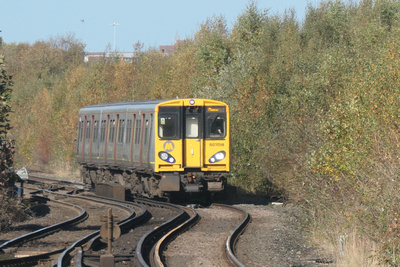
|
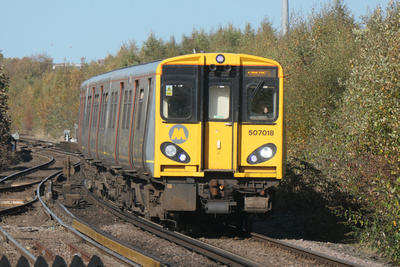
|
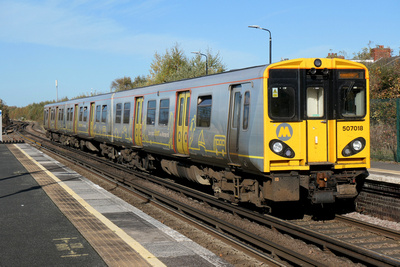
|
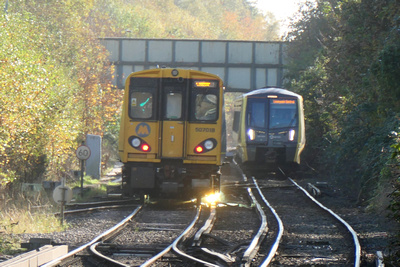
|
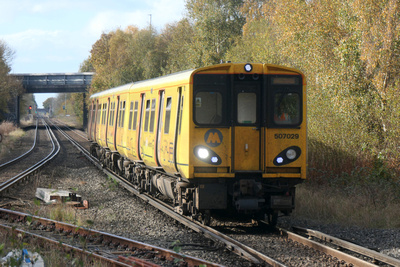
|

|
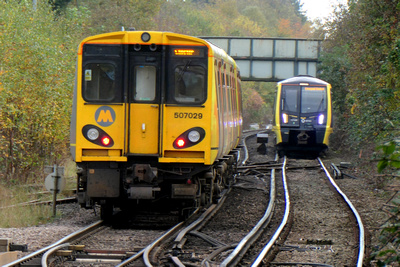
|
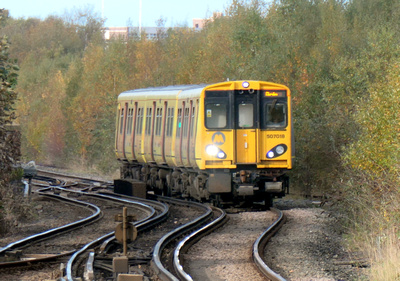
|

|
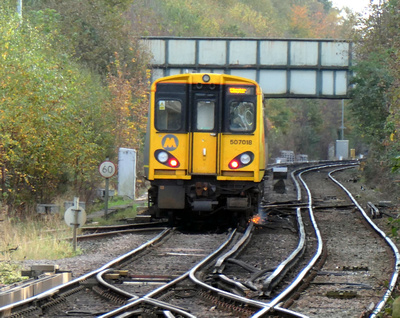
|

|
Scotrail Saltire liveried 320320+320411 arrive at Newton with 2L01 12.03 Larkhall - Dalmuir service 31.8.24 |
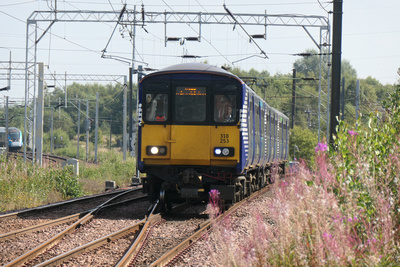
|
Scotrail Saltire liveried 318253 arrives at Newton with 2F27 12.17 Motherwell - Dalmuir service 31.8.24 |
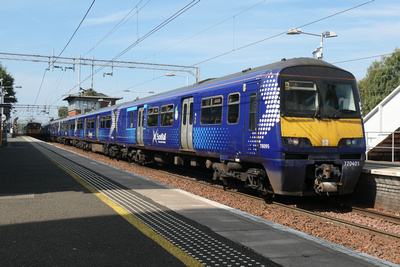
|
Scotrail Saltire liveried 320401+320322 pause at Newton with 2L02 11.47 Dalmuir - Motherwell service 31.8.24 |

|
Scotrail Saltire liveried 320308+320417 arrive at Newton with 2P02 12.20 service from Glasgow Central via Queens Park 31.8.24 |
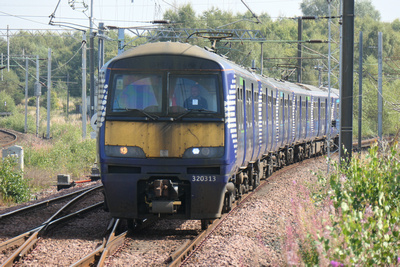
|
Scotrail Saltire liveried 320313+318261 arrive at Newton with 2L03 12.33 Larkhall - Dalmuir service 31.8.24 |

|
Scotrail Saltire liveried 318268+320310 arrive at Newton with 2L04 12.17 Dalmuir - Larkhall service 31.8.24 |
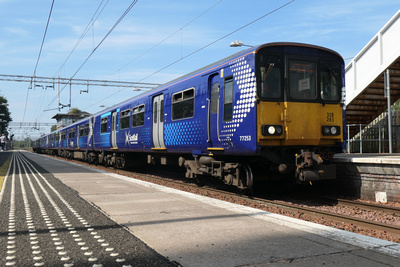
|
Scotrail Saltire liveried 318263+318255 pause at Newton with 2C34 12.28 service from Dalmuir - Motherwell 31.8.24 |
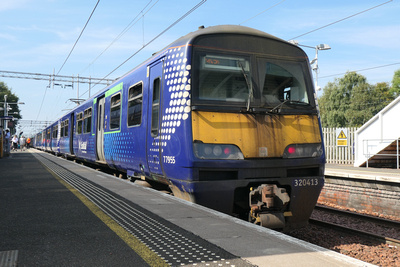
|
Scotrail Saltire liveried 320413+318256 are seen at Newton, having arrived with 2M74 12.45 service from Glasgow Central via Maxwell Park 31.8.24 |
The full list of workings and times
| Units | Working | Time |
| 320320+320411 | 2L01 12.03 Larkhall - Dalmuir | 12.26 |
| 318253 | 2F27 12.17 Motherwell - Dalmuir | 12.35 |
| 320401+320322 | 2L02 11.47 Dalmuir - Motherwell | 12.36 |
| 320308+320417 | 2P02 12.20 Glasgow Central - Newton via Queens Park | 12.43 |
| 320417+320308 | 2P03 12.49 Newton - Glasgow Central via Queens Park | 12.49 |
| 320313+318261 | 2L03 12.33 Larkhall - Dalmuir | 12.53 |
| 318268+320310 | 2L04 12.17 Dalmuir - Larkhall | 13.05 |
| 320301+320309 | 2F29 12.17 Cumbernauld - Dalmuir | 13.08 |
| 318263+318255 | 2C34 12.28 Dalmuir - Motherwell | 13.14 |
| 320413+318256 | 2M74 12.45 Glasgow Central - Newton via Maxwell Park | 13.14 |
| 318256+320413 | 2M75 13.19 Newton - Glasgow Central via Maxwell Park | 13.19 |
 On Thursday 1st August, I'd came off the M8 at Govan to stop off at Starbuck to get a cup of tea prior to heading else where, when I noticed a crane over at the Stadler test track so I had to go and investigate! When viewing from the bridge over Edmiston Drive, Glasgow Subway Metro Cammell Power Car 101 was seen on the rear of a low loader also noted was that there was a different set of cars from the previous batch that was there a few days earlier.
On Thursday 1st August, I'd came off the M8 at Govan to stop off at Starbuck to get a cup of tea prior to heading else where, when I noticed a crane over at the Stadler test track so I had to go and investigate! When viewing from the bridge over Edmiston Drive, Glasgow Subway Metro Cammell Power Car 101 was seen on the rear of a low loader also noted was that there was a different set of cars from the previous batch that was there a few days earlier.
Shortly after I arrived, the low loader departed and headed westwards. I followed the low loader and it went to JR Adams scrap yard at George V Docks near Braehead. There were more cars already there, which I assume to be the cars that were stabled outside on the test track the previous week. These were 101, 103, 104, 113, 116, 119, (probably 132), 203 and 205.
Replacing the cars mentioned above at Edmiston Drive were: 107, 110, 117, 121, 124, 129, 133 and 206. By 26th August those cars were joined by 106, 111, 120, 125, 207 and a couple of other cars which it wasn't possible to identify.
The status of the G2 fleet at the moment appears to be:
Scrapped: 101, 102, 103, 104, 108, 109, 113, 114, 115, 116, 119, 122, 123, 127, 131, 132, 203, 205, 208
Stored at Edmiston Drive: 106, 107, 110, 111, 117, 120, 121, 124, 125, 129, 133, 204, 206, 207
Unknown: 105, 112, 118, 126, 130, 201, 202
Preserved: 128

|

|

|
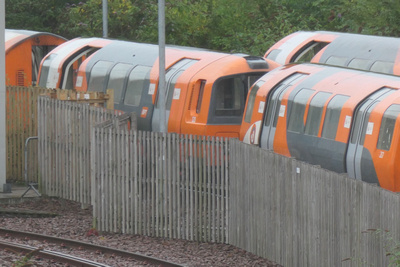
|
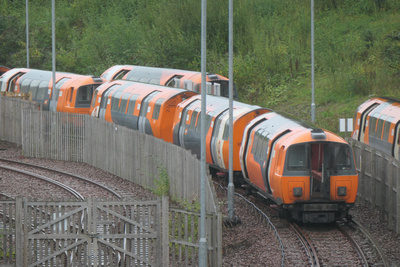
|

|
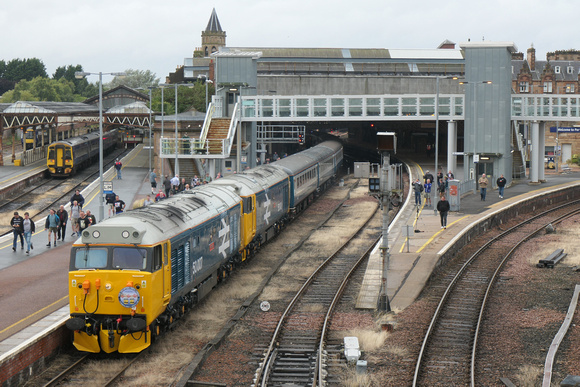 Over the English Bank Holiday Weekend of 24th - 26th August, Pathfinders Railtours operated a 3 day tour departing from Taunton in Somerset called the 'Grampian Highlander', initially using 66306 to haul the train to Gloucester, where 306 was removed and swapped over for newly repainted class 50s 50007 & 50049, which would remain on the tour over the weekend. The tour then made the long journey north, heading to Aberdeen!
Over the English Bank Holiday Weekend of 24th - 26th August, Pathfinders Railtours operated a 3 day tour departing from Taunton in Somerset called the 'Grampian Highlander', initially using 66306 to haul the train to Gloucester, where 306 was removed and swapped over for newly repainted class 50s 50007 & 50049, which would remain on the tour over the weekend. The tour then made the long journey north, heading to Aberdeen!
Sunday 25th August was day 2 of the 'Grampian Highlander' railtour, which travelled from Aberdeen to Inverness, then Inverness to Perth and back to Aberdeen. Monday 26th was the final day of the tour, departing from Aberdeen and visiting the recently opened branch to Leven, before heading south back to Gloucester and a traction swap back to a class 66 for the final leg to Taunton.
I had went out to photo the tour on the Saturday at Greenfaulds, however, having been cloudy and raining off and on for most of the afternoon, the sun came out just before the tour arrived and was right behind the train and unfortunately the backlighting from the sun wrecked the shot! I knew I wouldn't be able to get any photos on the Monday as I was working (Monday wasn't a Bank Holiday in Scotland), so I decided to make a 2nd attempt to photo the tour and headed up to Perth on the Sunday afternoon!
Rather than heading into the station it's self, I parked on Priory Place, and took photos from St Lenoards Bridge, which overlooks the station and also provides a good vantage point for movements from the south.
Having been a dreadful day weatherwise, I didn't hold out much hope of staying dry, however it did stay mostly dry apart from a couple of showers and the sun also came out very briefly as well! The tour was in the vacinity of the station for around an hour with various movements and shunts to get the stock from Platform 4 (on the Inverness line) to Platform 2 on the Aberdeen line. Below are a few photos of the action with a brief description under the shots. The tour featuring the newly repainted GBRF class 50s: 50007 'Hercules' & 50049 'Defiance' in BR Large Logo livery.

|
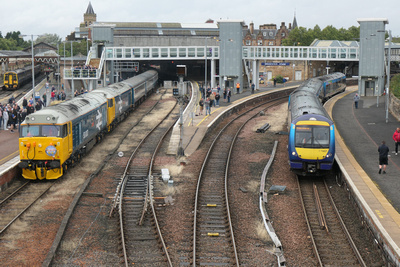
|
| 50007 & 50049 have just arrived at Perth working as 1Z50 from Inverness | 50007 & 50049 await the departure of BTP liveried Scotrail Turbostar 170405 with 1T84 15.32 Aberdeen - Glasgow Queen Street service |
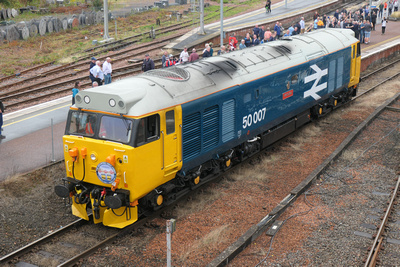
|
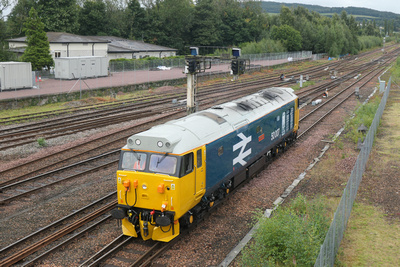
|
| 50007 then draws forward out of Platform 4, under the road bridge | Having crossed over to the northbound line and then reversed, 50007 once again approaches the station and will pass through platform 7 and will reverse onto the rear of the train. |
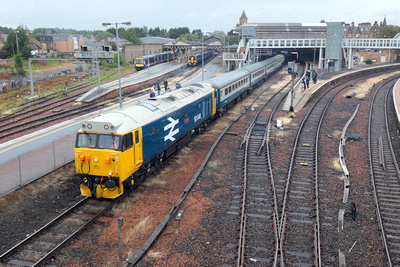
|
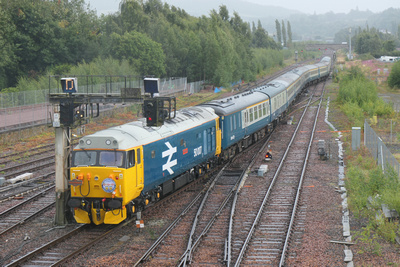
|
| 50049 then leads the tour out of platform 4 with 50007 now on the rear of the train, initially south before crossing over to head northwards via platform 2 | 50007 is seen on the rear as the tour snakes across onto the northbound line before reversing back into the station |
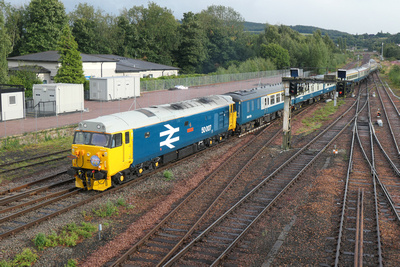
|
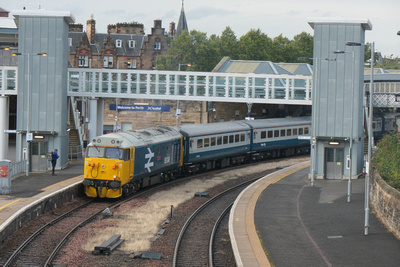
|
| In a brief moment of sunshine, 50007 now leading, heads the tour stock as it heads into platform 2, now working as 1Z51 to Aberdeen. | After picking up some of the passengers that didn't get back on at Platform 4, the tour departed northwards, 50049 is seen on the rear of the stock as the tour leaves. |
It's usually rare to see snowploughs out and about in Central Scotland even in the Winter, and even rarer to see them out in the summer! However, on 19th August, with not a drop of snow in sight, only the typical Scottish summer weather: heavy rain, Harry Needle's 37405 + Colas liveried 56090 are seen with the Inverness independent snowploughs (Front ADB965224 and Rear ADB965230) at Larbert as they are about to reverse into Larbert CE Sidings, having worked 7Z33 from Inverness Millburn Yard.
The ploughs will be taken onward from Larbert CE to MOD Eastriggs for storage. The ploughs from Kingmoor and Motherwell TMD should also be collected and transferred to Eastriggs during the week.

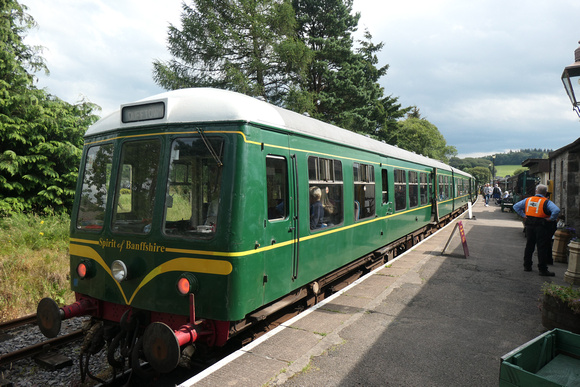 On Friday 2nd August, I finally managed to tick off a Heritage Railway that I've wanted to visit for a long time: The Keith and Dufftown Railway!
On Friday 2nd August, I finally managed to tick off a Heritage Railway that I've wanted to visit for a long time: The Keith and Dufftown Railway!
About the Railway
The Keith and Dufftown Railway is the UK's most northerly Heritage Railway, and is situated around 40 miles North East of Aviemore and 55 miles northwest of Aberdeen in the heart of Whisky Country with many Distilleries close to the railway!
The railway's eastern terminus of Keith Town, is an approx 30 minute walk from the National Rail station in Keith, which is on the Aberdeen - Inverness line.
The Keith and Dufftown Railway running for 11 miles from Dufftown railway station to Keith Town via Drummuir and a request stop at Towiemore Halt.
Originally part of the former Great North of Scotland Railway line which linked Aberdeen with Elgin, the line closed to passengers in 1968 but was retained as a freight-only branch for British Rail, mainly for the many local distilleries, with the line truncated at Dufftown. Sporadic visits to the line by the Northern Belle followed and even an Intercity 125 HST visiting the line until complete abandonment of the line in 1991. The line passed into the hands of the Keith and Dufftown Railway Association in 1998 and the branch was severed from the National Network with the removal of some track panels at Keith. The line was re-opened between Keith Town and Dufftown in 2000 and the scenic line passes through forests and farmland and past lochs, glens and distilleries with wildlife to be seen (when I was there, there was plenty of deer that could be seen lineside and crossing the track in front of the train). There are plans to reopen the line from Keith Town up towards the Junction with the main line to enable better access to the line for the public.
Ticket office facilities and toilets are available at both Keith Town and Dufftown, with a gift shop also being available at Keith Town. Food and refreshments are available at The Buffer Stop cafe at Dufftown, which is located in a pair of Mark 1s and a mark 2 carriage (and is open Tuesday - Sunday during the operating season and is so popular that booking is required to sit in).
Trains operate on Fridays - Sundays from Easter till the end of September with departures from Dufftown at 10.30, 13.30 & 15.30 and Keith Town at 11.30, 14.30 and 16.20 (Journeys last approx 40 minutes each way). There are also special events at other times of the year.
Rolling Stock
Motive power on the line is mainly provided by 5x class 108 vehicles, which can be marshalled into 2 car or 3 car formation depending on demand one of the vehicles, DCTL 56491, has been converted into a mobile Function Coach, housing a bar, whisky snug and tables and chairs and can be used as part of the service train. A recent purchase of an ex Northern 3 car class 144 Pacer, also provides a higher capacity unit for busier times and is also used on the first journey of the day. Another recent purchase is of a class 107 multiple unit from the Strathspey Railway, which will be a future restoration project. Another future restoration project is the Class 140 prototype Pacer unit, which was one of the early purchases for the railway. There are also 3 small shunters which are used for Driving experiences and for works trains on the line.
Multiple unit Fleet List
| Vehicle Type > | DBMS | DMSL | DMCL | DMCL | DTCL | Unit Name | Livery | Notes | Image |
| Class | |||||||||
| 107 | 52030 | 52008 | British Railways Green (faded) | Purchased 2023 from Strathspey Railway, awaiting restoration |
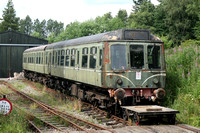
|
||||
| 108 | 51568 | 52053 | Spirit of Banffshire | British Railways Green | Both 51568 & 52053 are power vehicles meaning the unit can tackle the line's gradients with ease! 51568 facing Dufftown and 52053 facing Keith. Both vehicles arrived in 2001 and the KDRA took ownership of them in 2005. |
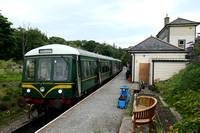
|
|||
| 108 | 53628 | 56224 | Spirit of Speyside | British Railways Green |
53628 faces in the Dufftown direction. Built in 1958 and was based in Chester / Manchester area before transferring to Oxfordshire. Part of the final class 108 working in Oct 1993 and stored at Southall till 1998. Moved to East Anglia Railway Museum in 1998, then to Dufftown on 7th March 2000. 56224 faces in the Keith direction and is a driving trailer. Built in 1959 and initially allocated to Bletchley depot and worked on the Cambridge - Oxford line. Was withdrawn in early 1990s and moved to Mid Norfolk Railway followed by Ecclesbourne Valley Railway in 2004. Arrived at Dufftown on 17th March 2010. |
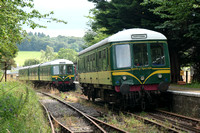
|
|||
| 108 | 56491 | 'Uisge Beatha' | British Railways Green | 56491 faces in the Keith direction. Built in 1960, and after withdrawal eventually ended up at Dufftown. In 2022, the vehicle was converted into a mobile function coach known as the 'Dram Tram' complete with bar, snug and seating compartment. Can carry 28 passengers. |
|
| Fleet Number | DMS | DMSL | Livery | Notes | Photo |
| 140001 | 55500 | 55501 | BR Blue Grey | 1981 built prototype Pacer unit. Was initially used as an evaluation unit before becoming a driver training unit at Neville Hill Depot in Leeds in 1985 before falling out of use. The unit moved to Dufftown in 1994 and work has been carried out for restoration as and when time, resources and funds permit. |
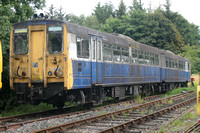
|
| Fleet Number | DMS | MS | DMSL | Livery | Notes | Photo |
| 144022 | 55822 | 55858 | 55845 | Debranded Northern | Built in 1986/87 in Derby and mainly used on services around York and Leeds. Withdrawn in 2000, 144022 moved to Dufftown on 8th September 2000. 144022 Generally used on the 10.30 service from Dufftown and 11.30 return |
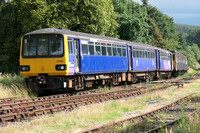
|
Trip Report
I left home around 8.15am and drove the 188 miles up to Dufftown via the M9, A9 and A95 with a 30 minute stop off at Pitlochry and 15 minutes at Boat of Garten, arriving at Dufftown around 1pm. Due to the current temporary timetable in operation on Scotrail services at the moment, I decided not to risk going by train.
Upon arrival I bought a ticket for the 13.30 departure (£16 for a 22 mile round trip which is very reasonable) then went to the Sidings cafe, which is housed in a pair of Mark 1s and a Mark 2f on the platform to buy a tea and cake before getting on the train. The train was formed of DTCL 56491 'Uisge Beatha' + DMCL 52053 +DMCL 51568. I sat in 51568 near to the rear cab so as to get the drivers eye view out through the cab and sat on one of the very comfortable 3+2 seats! It was a lovely journey through the countryside and all too soon, we were at the terminus at Keith Town, where I got off and had a look about the station and got a few photos of our train.
On the 14.30 return journey I once again sat in 51568 and this time had the forward view! We stopped at Drummuir for 5 minutes, which allowed passengers to get off and have a look at some carved wooden statues near the station as well as the view of the nearby river. Once back on, we made our way towards Dufftown passing some deer on the way and having to stop a couple of times as they were on or very near to the track.
We were soon back in Dufftown where I got some photographs of the station and of the recently acquired class 107, awaiting restoration and of DBMS 53628, 'Spirit of Speyside' which was parked up further down the platform. After the 15.30 service departed, I asked if I could photograph 144022 and 140001, which were stabled in a siding outwith the station and the chairman of the KDR Association took me up to see them and also let me go aboard both units for some photos of the passenger saloons and the drivers cabs!
Once I had a look round, it was unfortunately time to head back home. The return journey was not quite as straight forward due to an accident on the A9, leading to a diversion through Aviemore, the closure of the M80 at Haggs (and diversion via Kilsyth and Croy) and the M73/74 junction at Maryville (diversion via Uddingston and Bothwell) , meaning that it took over 5 hours to get home!
I had a fantastic visit to the Keith and Dufftown railway and will definately return there! The railway is very enthusiast friendly, the volunteers and staff were all extremely friendly and could not do enough for you and I would like to say a huge thanks to the chairman, who showed me round the 144 and 140 for taking the time to do this! I would thoroughly recommend a visit! More information on the KDR can be found on their website: https://keith-dufftown-railway.co.uk/
28th June was the final day in service for the Glasgow Subway's 2nd Gen stock consisting of 1977 built Metro Cammell motors and 1992 built Hunslet Barclay central trailers.
Initially, it was announced that one train per circle would run between 1pm and 4pm, however due to demand it was closer to 5.30pm before they returned to depot, with both sets carrying out an additional couple of runs around the circle each!
The final servicable trains were in service, one per circle and were formed of 106+207+120 and 119+203+103. 106+207+120 worked on diagram 16 on the Inner Circle & 119+203+103 worked diagram 6 on the Outer circle. Due to the number of enthusiasts and regular passengers wanting to take photos etc, it was taking longer than normal to do a full circuit with longer than normal dwell times at stations.
119+203+103 returned to depot first, terminating at Govan and with 103 leading, returned to Broomloan depot wrong line. Shortly after, 106+207+120 exited service at Govan at 17.24 and after quite a few photos and videos from well wishers, it returned to Broomloan depot, bringing 44 years of service to an end for the 2nd Gen stock.

|

|

|

|

|

|

|

|

|

|
With the Stadler compound at Edmiston Drive almost empty of G3 Stadler stock (apart from 315 which was stabled on the test track), it was possible to get a side shot of some of the latest batch of withdrawn G2 stock awaiting their fate.
The stock includes trailer 205 and Met Cam Power Cars 104 (in advertising livery), 113 & 116. Going by the advertising livery, the 5th vehicle which is partially visible is either 118 or 125. There is likely to be at least 1 possibly 2 more power cars behind the shed. 23.6.24
Confirmed withdrawn and / or disposed of cars to date are: 102, 104, 108, 109, 113, 114, 115, 116, 122, 123, 127, 128 (preserved), 131, 205 & 208
The final G2 cars are expected to run for the last time on Friday 28th June between 1pm and 3pm with one train per circle.
https://scottishtrains.zenfolio.com/p766507381

|

|

|

|
History is made on 15th June 2024 as Balloon 700 becomes the first of Blackpool's Heritage tram fleet to carry passengers on the new extension to North Station. The short 500 metre extension connects North Station to the Promenade at North Pier with tram services being split into 3: service T1 is Fleetwood - Starr Gate, T2 is Fleetwood - North Station and T3 is North Station to Starr Gate, all 3 services are due to run at 30 minute intervals scottishtrains.zenfolio.com/p493681382
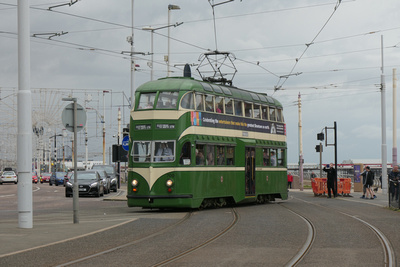
|

|

|

|

|

|
After operating on the Inner Circle on diagram 12 as the rear part of a 3 car formation consisting of 111 (leading), 107 (centre) and 128 (rear) on Monday 10th June, Met Cam Motor 128 was withdrawn from service and was thoroughly cleaned in preparation for its imminent transfer into preservation. Having been selected as it was in the best condition of the remaining Met Cam motor cars, 128 was loaded onto a low loader on Thursday 13th June and transferred from Broomloan depot, its home of 44 years, to its new home: Glasgow Riverside Museum where it is to be preserved and put on display as a static exhibit!
128 was available for public display from Friday 14th June.
The photos show 128 on display in the Riverside Museum on Friday 14th June.
https://scottishtrains.zenfolio.com/p766507381
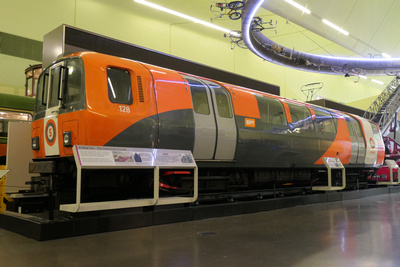
|
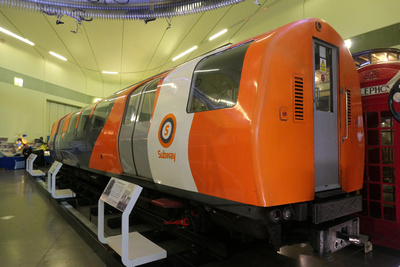
|

|
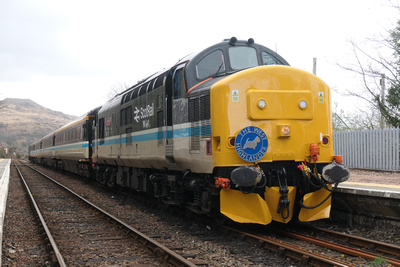 On 3rd April, Locomotive Services Limited's Scotrail liveried 37409, three Scotrail liveried Mark 3s, DBSO 607 and British Railways Green liveried 37667 headed north from Crewe to Fort William. Later that same day, LSL announced that they would be running a tour from Fort William to Mallaig and return on Monday 8th and Tuesday 9th April, with a walk on price of £40 per head.
On 3rd April, Locomotive Services Limited's Scotrail liveried 37409, three Scotrail liveried Mark 3s, DBSO 607 and British Railways Green liveried 37667 headed north from Crewe to Fort William. Later that same day, LSL announced that they would be running a tour from Fort William to Mallaig and return on Monday 8th and Tuesday 9th April, with a walk on price of £40 per head.
Departing on the one free path available (8.52 from Fort William with a 40 minute break at Mallaig and returning at 11.30, arriving at 13.38)
I decided last minute to head up to Fort William to catch 37409! Leaving home at 5.30am I drove up towards Arrochar and Tarbet, where I made a brief stop off to photograph the Caledonian Sleeper! I then got back on the road and got stuck behind a couple of slow moving vehicles. I reached Fort William just as 409 was departing the station, so managed to get in front of it and headed to Glenfinnan Viaduct to photo it there. Once it passed, I got back on the road and headed westwards.
I missed the turning for Polnish so headed Arisaig. I managed to get a few photos of the working there, then after it left, headed onwards to Mallaig, where I caught it coming in to the western terminus. After a few photos of it arriving and in the station, I headed back to Polnish to get a few photos there, then stopped off a couple of miles west of Glenfinnan where I photoed the return working from a small bridge over the line ( ending up soaked up to my ankles in a waterlogged field!). I headed back to Glenfinnan for more photos at the viaduct then back towards Fort William, where I got some photos from the Earl of Inverness Road Bridge. After this, it was time to head back home!
Here are some photos from the trip!
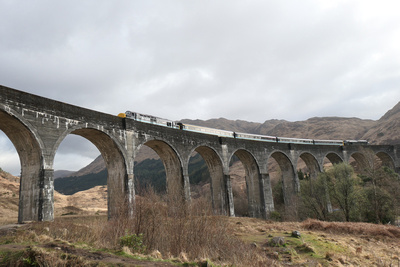
|

|
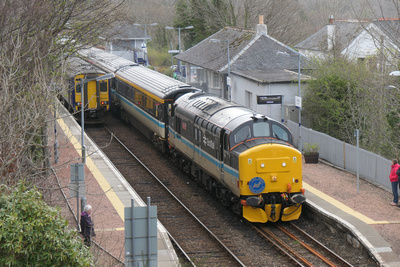
|
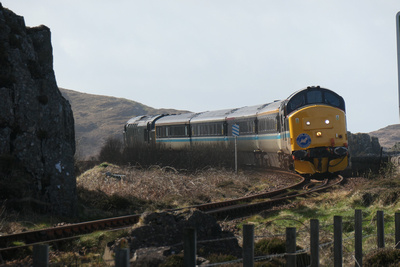
|
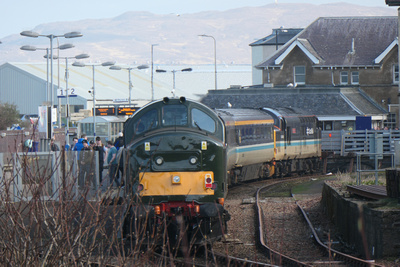
|
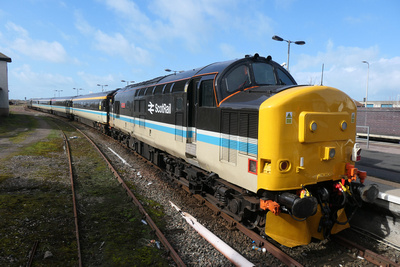
|
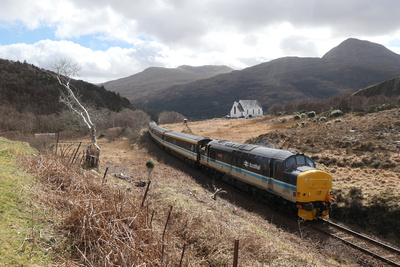
|

|
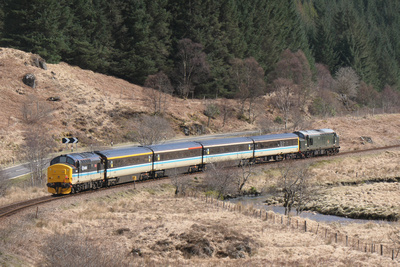
|
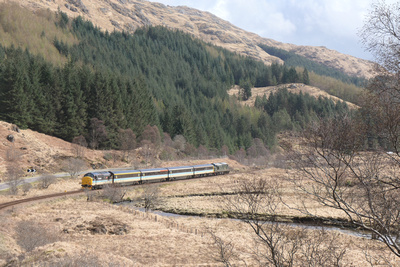
|
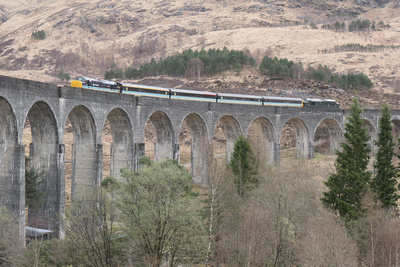
|
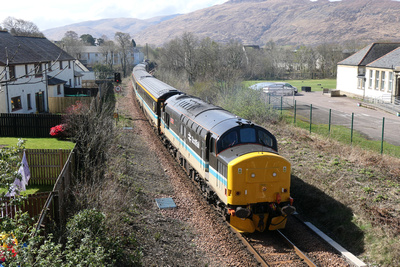
|
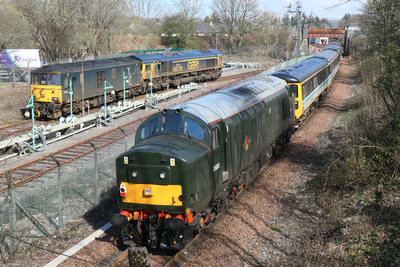
|
 From Friday 29th March - Monday 1st April, I was on a family weekend away to Ardgarten, on the shore of Loch Long, 2 miles from Arrochar and around an hour from Glasgow by car via the A82 and 90 mins by train.
From Friday 29th March - Monday 1st April, I was on a family weekend away to Ardgarten, on the shore of Loch Long, 2 miles from Arrochar and around an hour from Glasgow by car via the A82 and 90 mins by train.
Ardgartan is a lovely place to visit and I'd recommend it not just for the passing trains but also for the stunning views of Loch Long, looking down to Arrochar and of the wildlife including seals, dolphins, thrushes, ducks, geese and robins!
The location allowed for a view of the West Highland Line and the passing workings heading along the hillside. Ardgartan is also handy for Arrochar and Tarbet station, allowing some shots of the Class 156 workings to Oban and Mallaig.
Luckily when I was there the LSL Scotrail Push Pull set tour to Oban was due to pass through so managed to get a few photos of it!
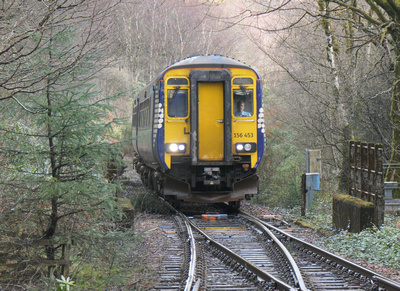
|
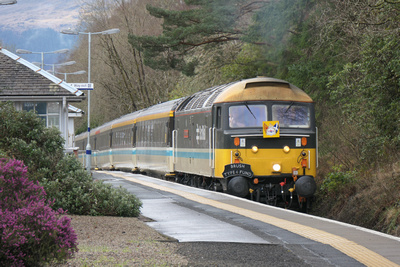
|
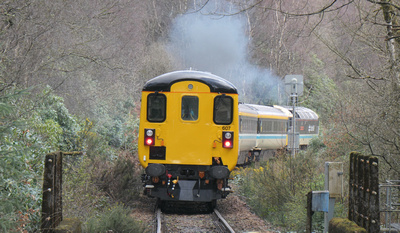
|
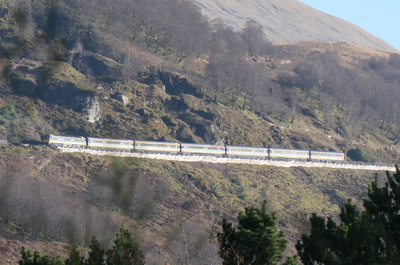
|
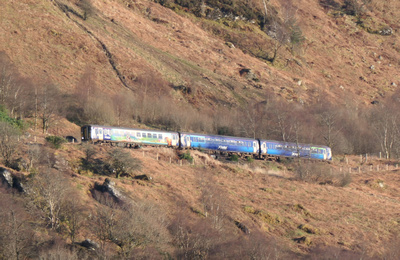
|
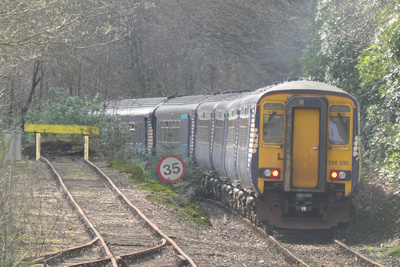
|
Here is what was running over the weekend. I was there from 3pm on the Friday till 12pm on Easter Monday and managed to see the majority of the listed trains and photo a few of them
| Friday 29th March | ||||||
| Fleet Number | Headcode | Time | From | To | Due | Notes |
| 156457 | 1Y31 | 5.20 | Glasgow Queen Street | Oban | 6.39 | |
| 73967+66739 | 1Y11 | 4.50 | Edinburgh Waverley | Fort William | 7.09 | |
| 156499+153377 | 1Y20 | 5.17 | Oban | Glasgow Queen Street | 7.10 | |
| 156493+156453+156474 | 1Y21 | 8.21 | Glasgow Queen Street | Oban and Mallaig | 9.38 | |
| 153380+156492 | 1Y42 | 6.03 | Mallaig | Glasgow Queen Street | 10.06 | |
| 156457 | 1Y22 | 8.57 | Oban | Glasgow Queen Street | 10.43 | |
| 153377+156499 | 1Y25 | 10.36 | Glasgow Queen Street | Oban | 12.00 | |
| 66740 | 0B45 | 8.07 | Fort William Alcan | Millerhill | 12.30 | |
| 156457+156492+156458 | 1Y23 | 12.22 | Glasgow Queen Street | Oban and Mallaig | 13.40 | 156457 to Oban |
| 156477+156446+156493 | 1Y44 | 10.10 | Mallaig and Oban | Glasgow Queen Street | 14.09 | 156493 from Oban |
| 156499+153377 | 1Y26 | 14.41 | Oban | Glasgow Queen Street | 16.27 | |
| 153373+156445 | 1Y29 | 16.34 | Glasgow Queen Street | Oban | 17.57 | |
| 156446+153380+156477 | 1Y27 | 18.23 | Glasgow Queen Street | Oban and Mallaig | 19.37 | 156446 to Oban |
| 156474+156453+156457 | 1Y48 | 16.05 | Mallaig and Oban | Glasgow Queen Street | 20.06 | 156457 from Oban |
| 156445 | 1Y32 | 20.39 | Oban | Glasgow Queen Street | 22.18 | |
| 73967+66739 | 1B01 | 19.50 | Fort William | London Kings Cross | 22.44 | |
| Saturday 30th March | ||||||
| Fleet Number | Headcode | Time | From | To | Due | Notes |
| 156453 | 1Y31 | 5.20 | Glasgow Queen Street | Oban | 6.39 | |
| 73967+66739 | 1Y11 | 4.50 | Edinburgh Waverley | Fort William | 7.09 | |
| 156446+153373 | 1Y20 | 5.17 | Oban | Glasgow Queen Street | 7.10 | |
| 156493+156457+156474 | 1Y21 | 8.21 | Glasgow Queen Street | Oban and Mallaig | 9.38 | 156493 to Oban |
| 153380+156477 | 1Y42 | 6.03 | Mallaig | Glasgow Queen Street | 10.06 | |
| 156453 | 1Y22 | 8.57 | Oban | Glasgow Queen Street | 10.43 | |
| 47712 | 1Z62 | 8.23 | Edinburgh Waverley | Oban | 11.03 | LSL Tour |
| 156373+156446 | 1Y25 | 10.36 | Glasgow Queen Street | Oban | 12.00 | |
| 156453+156477+156500 | 1Y23 | 12.22 | Glasgow Queen Street | Oban and Mallaig | 13.40 | 156453 to Oban |
| 156492+156458+156493 | 1Y44 | 10.10 | Mallaig and Oban | Glasgow Queen Street | 14.09 | 156493 from Oban |
| 47712 | 1Z63 | 14.22 | Oban | Edinburgh Waverley | 16.44 | |
| 156453+153373 | 1Y26 | 16.11 | Oban | Glasgow Queen Street | 17.56 | |
| 153377+156499 | 1Y29 | 16.34 | Glasgow Queen Street | Oban | 17.57 | |
| 156492+156458 | 1Y27 | 18.23 | Glasgow Queen Street | Oban and Mallaig | 19.37 | 156492 to Oban |
| 156457+156474+156446 | 1Y48 | 16.05 | Mallaig and Oban | Glasgow Queen Street | 20.06 | 156446 from Oban |
| 156499 | 1Y32 | 20.39 | Oban | Glasgow Queen Street | 22.18 | |
| Sunday 31st March | ||||||
| Fleet Number | Headcode | Time | From | To | Due | Notes |
| cancelled | 1Y29 | 9.03 | Glasgow Queen Street | Oban | 10.22 | |
| cancelled | 1Y21 | 9.56 | Glasgow Queen Street | Oban | 11.12 | |
| 156474+156453+156493 | 1Y23 | 12.20 | Glasgow Queen Street | Oban and Mallaig | 13.38 | 156474 to Oban |
| 156492+156458+156500 | 1Y24 | 12.11 | Oban | Glasgow Queen Street | 14.09 | 156492 from Oban |
| cancelled | 1Y26 | 16.11 | Oban | Glasgow Queen Street | 17.57 | |
| cancelled | 1Y30 | 17.04 | Oban | Glasgow Queen Street | 18.55 | |
| 156500+156458+156492 | 1Y27 | 18.21 | Glasgow Queen Street | Oban and Mallaig | 19.36 | 156500 to Oban |
| 156477+156453+156474 | 1Y48 | 16.01 | Mallaig and Oban | Glasgow Queen Street | 20.06 | 156474 from Oban |
| 73967+66739 | 1B01 | 19.50 | Fort William | London Kings Cross | 22.44 | |
| Monday 1st April | ||||||
| Fleet Number | Headcode | Time | From | To | Due | Notes |
| 156457 | 1Y31 | 5.20 | Glasgow Queen Street | Oban | 6.39 | |
| 73967+66739 | 1Y11 | 4.50 | Edinburgh Waverley | Fort William | 7.09 | |
| 156500+153377 | 1Y20 | 5.17 | Oban | Glasgow Queen Street | 7.10 | |
| 156446+156474+156453 | 1Y21 | 8.21 | Glasgow Queen Street | Oban and Mallaig | 9.38 | 156446 to Oban |
| 156492 | 1Y42 | 6.03 | Mallaig | Glasgow Queen Street | 10.06 | |
| 156457 | 1Y22 | 8.57 | Oban | Glasgow Queen Street | 10.43 | |
| 153377+156500 | 1Y25 | 10.36 | Glasgow Queen Street | Oban | 12.00 | |
| 156457+156492+156477 | 1Y23 | 12.22 | Glasgow Queen Street | Oban and Mallaig | 13.40 | 156457 to Oban |
| 156493+156458+156446 | 1Y44 | 10.10 | Mallaig and Oban | Glasgow Queen Street | 14.09 | 156446 from Oban |
| 156500+153377 | 1Y26 | 14.41 | Oban | Glasgow Queen Street | 16.27 | |
| 156380+156450 | 1Y29 | 16.34 | Glasgow Queen Street | Oban | 17.57 | |
| 156493+153370+156458 | 1Y27 | 18.23 | Glasgow Queen Street | Oban and Mallaig | 19.37 | 156493 to Oban |
| 156474+156453+156457 | 1Y48 | 16.05 | Mallaig and Oban | Glasgow Queen Street | 20.06 | 156457 from Oban |
| 156450 | 1Y32 | 20.39 | Oban | Glasgow Queen Street | 22.18 | |
| 73967+66739 | 1B01 | 19.50 | Fort William | London Kings Cross | 22.44 |
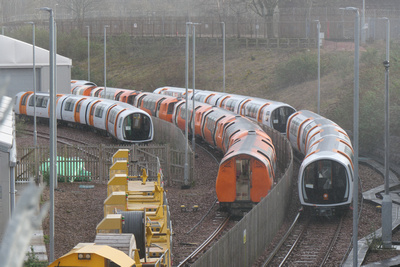 With the introduction to service of the Glasgow Subway Stadler Generation 3 stock gathering pace (5 of the 17 strong fleet of 4 car trains now in service), a start has been made on withdrawing some of the Generation 2 Met Cam and Barclay stock.
With the introduction to service of the Glasgow Subway Stadler Generation 3 stock gathering pace (5 of the 17 strong fleet of 4 car trains now in service), a start has been made on withdrawing some of the Generation 2 Met Cam and Barclay stock.
Officially withdrawn in March 2024 were Met Cam power cars 115, 127 and 131, which were all long term out of service, however in recent weeks, these have been joined by Met Cam cars 102, 109, 114 and 123 as well as Barclay trailer 208. These vehicles have been moved from the main Broomloan Depot complex up to the Stadler testing and storage facility up at the end of the test track, which is visible from the Bridge over Edmiston Drive near Ibrox stadium, offering a rare chance to see the 2nd Generation stock in daylight.
There are 7 vehicles visible, 6 of them identifiable with a zoom lens on a camera from the bridge with one partially visible but not identifiable from the rear of the Ibrox overflow car park, looking at the images, there is possibly one more vehicle behind the storage shed.
From the bridge the order of the vehicles is as follows: Barclay Trailer 208, Met Cams 109, 102, 114, 131 & 123. The 7th vehicle isn't identifiable as the cab end is obscured by a shed. it is possible to get a 2/3rds side on shot of Met Cam 102 from the car park. The remaining vehicles are obscured by Stadler G3 stock.
There were four of the Stadler fleet visible when I visited: 311, 312, 315 and an unidentified unit.
https://scottishtrains.zenfolio.com/p656518172
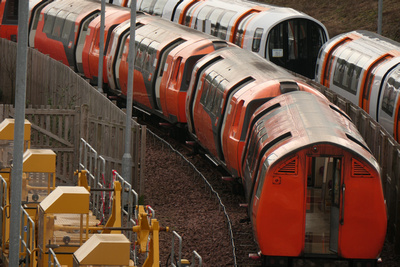
|
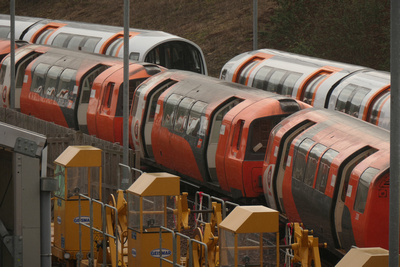
|
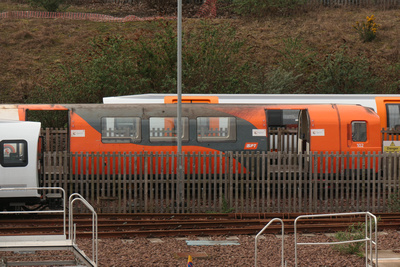
|
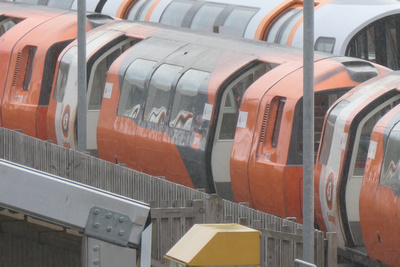
|
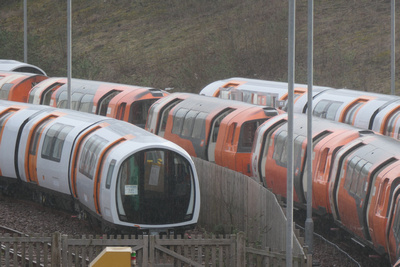
|

|
 In the past couple of weeks, following the introduction to service of the first of the new Stadler units, the withdrawal of Glasgow Subway's 45 year old Met Cam Motor and 32 year old Barclay Trailer fleet has begun. Three long term out of service Met Cam motors which haven't ran in months were officially withdrawn a couple of weeks back, however they have been joined by some more Met Cam motors and one Barclay trailer.
In the past couple of weeks, following the introduction to service of the first of the new Stadler units, the withdrawal of Glasgow Subway's 45 year old Met Cam Motor and 32 year old Barclay Trailer fleet has begun. Three long term out of service Met Cam motors which haven't ran in months were officially withdrawn a couple of weeks back, however they have been joined by some more Met Cam motors and one Barclay trailer.
Until Friday 12th April, at least 7 visible vehicles were stored out in the open at the Stadler compound at the end of the test track at Broomloan depot. 6 of the 7 were identifiable using a zoom lens on a camera from the Edminston Drive bridge.
In order from the bridge were 208, 109, 102, 114, 131 and 123 the others were unidentifiable. On 12th April, they were removed by low loader to S Norton and Co Scrapyard at King George V docks, Govan. I will update the fleetlist as and when other withdrawals of Met Cam or Barclay cars take place or other Stadler sets enter service.
| Number | Vehicle Type | Built by | Entered Service | Current Livery | Status | Notes |
| 101 | Motor Car | Metro Cammell | 1980 | Download Railway Guardian, All over advert | withdrawn | Stored in Stadler Compound, Edmiston Drive till 1st August, when moved to S Norton Scrapyard, KGV Docks, Govan |
| 102 | Motor Car | Metro Cammell | 1980 | SPT Orange, Grey and White livery | Withdrawn 03.24 | Stored in Stadler Compound, Edmiston Drive till 12th April when moved to S Norton Scrapyard, KGV Docks, Govan |
| 103 | Motor Car | Metro Cammell | 1980 | SPT Orange, Grey and White livery | Withdrawn 28.6.24 |
Part of the final G2 train to run on the Outer Circle, Stored in Stadler Compound, Edmiston Drive till 1st August, when moved to S Norton Scrapyard, KGV Docks, Govan |
| 104 | Motor Car | Metro Cammell | 1980 | SPT Net Zero Commitment livery | Withdrawn 06.24 | Stored in Stadler Compound, Edmiston Drive till 1st August, when moved to S Norton Scrapyard, KGV Docks, Govan |
| 105 | Motor Car | Metro Cammell | 1980 | SPT Orange, Grey and White livery | Withdrawn | |
| 106 | Motor Car | Metro Cammell | 1980 | SPT Orange, Grey and White livery | Withdrawn 28.6.24 | Part of the last G2 train to run on the Inner Circle |
| 107 | Motor Car | Metro Cammell | 1980 | SPT Orange, Grey and White livery | Withdrawn | Stored in the Stadler Compound, Edmiston Drive |
| 108 | Motor Car | Metro Cammell | 1980 | SPT Orange, Grey and White livery | withdrawn 03.24 | Stored in Stadler Compound, Edmiston Drive till 12th April when moved to S Norton Scrapyard, KGV Docks, Govan |
| 109 | Motor Car | Metro Cammell | 1980 | SPT Orange, Grey and White livery | Withdrawn 03.24 | Stored in Stadler Compound, Edmiston Drive till 12th April when moved to S Norton Scrapyard, KGV Docks, Govan |
| 110 | Motor Car | Metro Cammell | 1980 | SPT Orange, Grey and White livery | Withdrawn | |
| 111 | Motor Car | Metro Cammell | 1980 | SPT Orange, Grey and White livery | Withdrawn | |
| 112 | Motor Car | Metro Cammell | 1980 | SPT Orange, Grey and White livery | Withdrawn | |
| 113 | Motor Car | Metro Cammell | 1980 | SPT Orange, Grey and White livery | Withdrawn 06.24 | Stored in Stadler Compound, Edmiston Drive |
| 114 | Motor Car | Metro Cammell | 1980 | SPT Orange, Grey and White livery | Withdrawn 03.24 | Stored in Stadler Compound, Edmiston Drive till 12th April when moved to S Norton Scrapyard, KGV Docks, Govan |
| 115 | Motor Car | Metro Cammell | 1980 | SPT Orange, Grey and White livery | Withdrawn 27.3.23 | Withdrawn with Train Control Fault. Stored in Stadler Compound, Edmiston Drive till 12th April when moved to S Norton Scrapyard, KGV Docks, Govan |
| 116 | Motor Car | Metro Cammell | 1980 | SPT Orange, Grey and White livery | Withdrawn 06.24 | Stored in Stadler Compound, Edmiston Drive |
| 117 | Motor Car | Metro Cammell | 1980 | SPT Orange, Grey and White livery | Withdrawn | Stored in Stadler Compound, Edmiston Drive |
| 118 | Motor Car | Metro Cammell | 1980 | Scottish Power / COP 26 advert livery | Withdrawn | |
| 119 | Motor Car | Metro Cammell | 1980 | SPT Orange, Grey and White livery | Withdrawn 28.6.24 | Part of the final G2 train to run on the Outer Circle, Stored in Stadler Compound, Edmiston Drive till 1st August, when moved to S Norton Scrapyard, KGV Docks, Govan |
| 120 | Motor Car | Metro Cammell | 1980 | SPT Orange, Grey and White livery | Withdrawn 28.6.24 | Part of the final G2 train to run on the Inner Circle, |
| 121 | Motor Car | Metro Cammell | 1980 | SPT Orange, Grey and White livery | Withdrawn | Stored in Stadler Compound, Edmiston Drive |
| 122 | Motor Car | Metro Cammell | 1980 | N/A | Scrapped | Withdrawn 2015 and scrapped circa 2017 to provide spare parts for other vehicles |
| 123 | Motor Car | Metro Cammell | 1980 | SPT Orange, Grey and White livery | Withdrawn 3.24 | Stored in Stadler Compound, Edmiston Drive till 12th April when moved to S Norton Scrapyard, KGV Docks, Govan |
| 124 | Motor Car | Metro Cammell | 1980 | SPT Orange, Grey and White livery | Withdrawn | Stored in Stadler Compound, Edmiston Drive |
| 125 | Motor Car | Metro Cammell | 1980 | Scottish Power / COP 26 advert livery | Withdrawn | |
| 126 | Motor Car | Metro Cammell | 1980 | SPT Orange, Grey and White livery | Withdrawn | |
| 127 | Motor Car | Metro Cammell | 1980 | SPT Orange, Grey and White livery | Withdrawn 18.6.23 | Withdrawn with brake resistor fault. Stored in Stadler Compound, Edmiston Drive till 12th April when moved to S Norton Scrapyard, KGV Docks, Govan |
| 128 | Motor Car | Metro Cammell | 1980 | SPT Orange, Grey and White livery | Withdrawn 10.6.24 | In Preservation at the Riverside Museum, Glasgow. Transferred from Broomloan Depot on 13th June, on display from 14th June. |
| 129 | Motor Car | Metro Cammell | 1980 | SPT Orange, Grey and White livery | Withdrawn | Stored in Stadler Compound, Edmiston Drive |
| 130 | Motor Car | Metro Cammell | 1980 | Glasgow Subway 1896-2016 120 years All over Grey livery with orange doors | Withdrawn | |
| 131 | Motor Car | Metro Cammell | 1980 | SPT Orange, Grey and White livery | Withdrawn 4.8.23 | Stored in Stadler Compound, Edmiston Drive till 12th April when moved to S Norton Scrapyard, KGV Docks, Govan |
| 132 | Motor Car | Metro Cammell | 1980 | SPT Net Zero Commitment livery | Withdrawn | Used for the Inaugaration of the new system by the Queen 1.11.79 |
| 133 | Motor Car | Metro Cammell | 1980 | SPT Orange, Grey and White livery | Withdrawn |
Stored in Stadler Compound, Edmiston Drive. Used for the Inaugaration of the new system by the Queen 1.11.79 |
| 201 | Trailer | Hunslet Barclay | 1992 | Scottish Power / COP 26 advert livery | Withdrawn | |
| 202 | Trailer | Hunslet Barclay | 1992 | SPT Orange, Grey and White livery | Withdrawn | |
| 203 | Trailer | Hunslet Barclay | 1992 | SPT Orange, Grey and White livery | Withdrawn 28.6.24 | Part of the final G2 train to run on the Outer Circle, Stored in Stadler Compound, Edmiston Drive till 1st August, when moved to S Norton Scrapyard, KGV Docks, Govan |
| 204 | Trailer | Hunslet Barclay | 1992 | SPT Net Zero Commitment livery | withdrawn | |
| 205 | Trailer | Hunslet Barclay | 1992 | SPT Orange, Grey and White livery | Withdrawn 6.24 | Stored in Stadler Compound, Edmiston Drive till 1st August, when moved to S Norton Scrapyard, KGV Docks, Govan |
| 206 | Trailer | Hunslet Barclay | 1992 | SPT Orange, Grey and White livery | Withdrawn | Stored in Stadler Compound, Edmiston Drive |
| 207 | Trailer | Hunslet Barclay | 1992 | SPT Orange, Grey and White livery | Withdrawn 28.6.24 | Part of the final G2 train to run on the Inner Circle, Stored in Stadler Compound, Edmiston Drive till 1st August, when moved to S Norton Scrapyard, KGV Docks, Govan |
| 208 | Trailer | Hunslet Barclay | 1992 | SPT Orange, Grey and White livery | Withdrawn 03.24 | Stored in Stadler Compound, Edmiston Drive till 12th April when moved to S Norton Scrapyard, KGV Docks, Govan |
| 301 | Unit | Stadler | 2024 | White with black window surrounds & cab ends and orange doors | in service | entered service Jan 2024 |
| 302 | Unit | Stadler | 2023 | White with black window surrounds & cab ends and orange doors | in service | entered service 11.12.23 |
| 303 | Unit | Stadler | 2024 | White with black window surrounds & cab ends and orange doors | in service | entered service Feb 2024 |
| 304 | Unit | Stadler | 2024 | White with black window surrounds & cab ends and orange doors | in service | entered service March 2024 |
| 305 | Unit | Stadler | 2024 | White with black window surrounds & cab ends and orange doors | in service | entered service March 2024 |
| 306 | Unit | Stadler | 2023 | White with black window surrounds & cab ends and orange doors | in service | entered service 11.12.23 |
| 307 | Unit | Stadler | 2024 | White with black window surrounds & cab ends and orange doors | in service | entered service March 2024 |
| 308 | Unit | Stadler | 2024 | White with black window surrounds & cab ends and orange doors | in service | entered service April 2024 |
| 309 | Unit | Stadler | 2024 | White with black window surrounds & cab ends and orange doors | in service | entered service April 2024 |
| 310 | Unit | Stadler | White with black window surrounds & cab ends and orange doors | in service | entered service April 2024 | |
| 311 | Unit | Stadler | White with black window surrounds & cab ends and orange doors | in service | entered service June 2024 | |
| 312 | Unit | Stadler | White with black window surrounds & cab ends and orange doors | in service | entered service June 2024 | |
| 313 | Unit | Stadler | White with black window surrounds & cab ends and orange doors | not entered service yet | In Stadler compound at end of the test track | |
| 314 | Unit | Stadler | White with black window surrounds & cab ends and orange doors | not entered service yet | ||
| 315 | Unit | Stadler | White with black window surrounds & cab ends and orange doors | not entered service yet | In Stadler compound at end of the test track | |
| 316 | Unit | Stadler | White with black window surrounds & cab ends and orange doors | In service | Entered Service July 2024 | |
| 317 | Unit | Stadler | White with black window surrounds & cab ends and orange doors | In Service | Entered Service July 2024 |
Scotrail Saltire liveried 320413+320414 pause at Motherwell with 2B04 6.59 service to Carstairs 15.2.23 https://scottishtrains.zenfolio.com/p334752891/edad3cc78
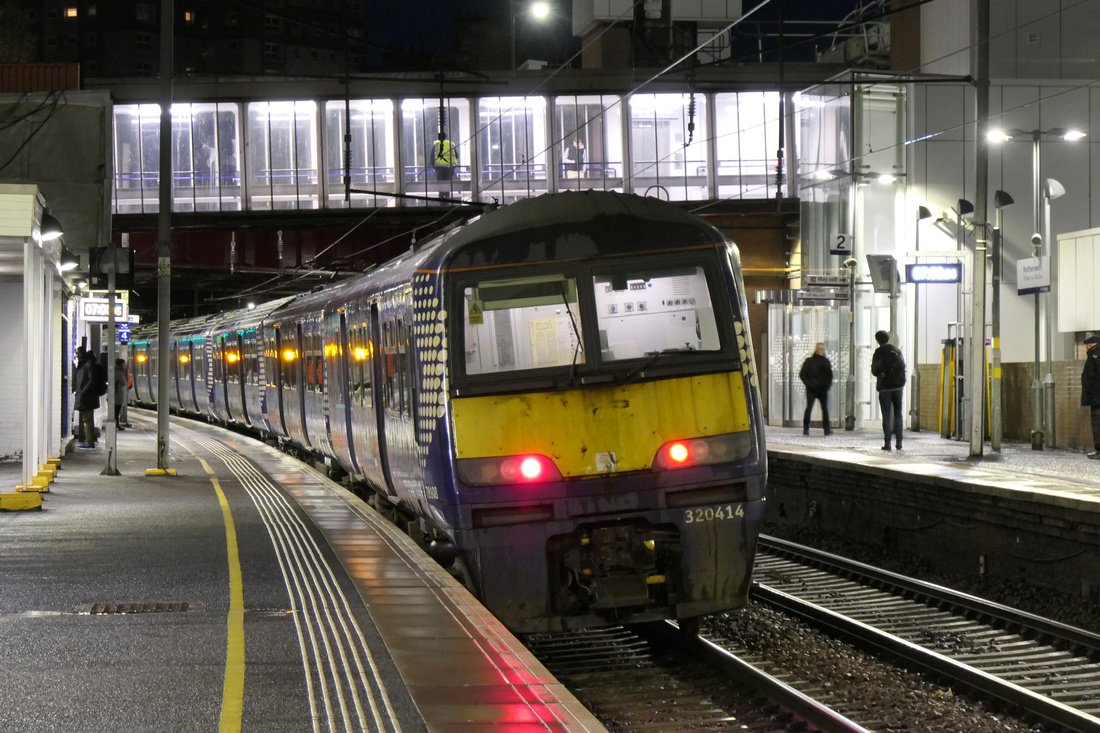
Caledonian Sleeper liveried 92023 and Mark 5 sleeper set pause at Motherwell with 1S26 23:50 London Euston - Glasgow Central Caledonian Sleeper service 15.2.23 https://scottishtrains.zenfolio.com/p334752891/edad3c2cb
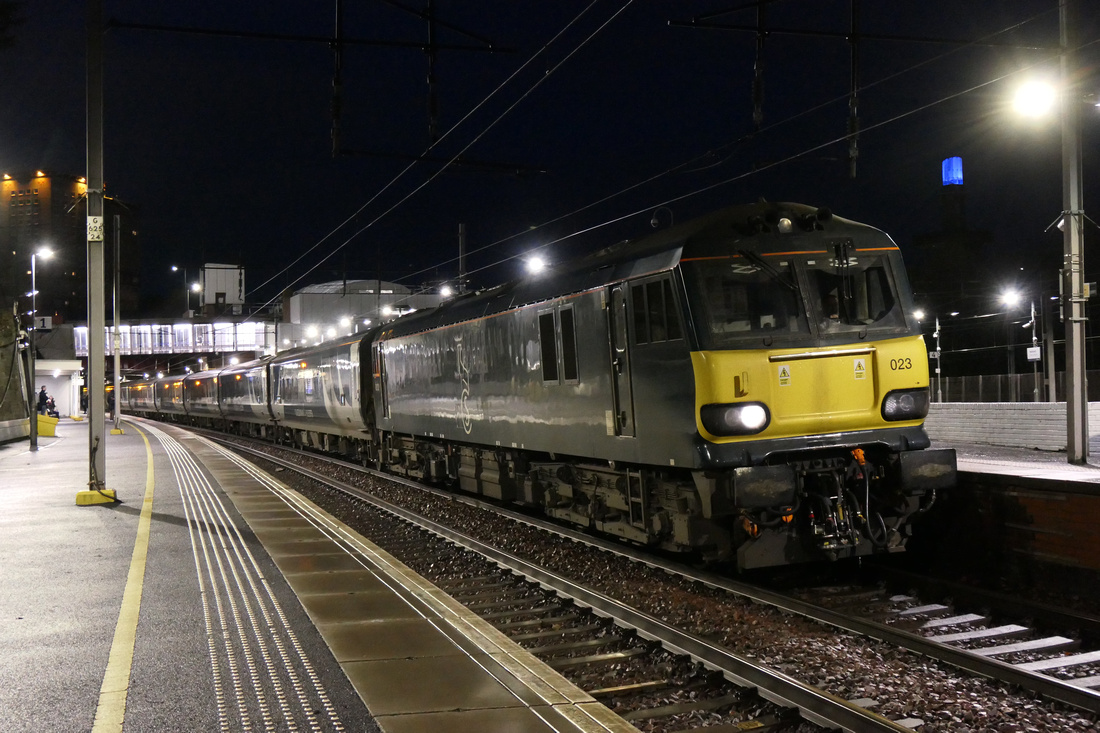
 As part of my week off, I decided to head back down to Merseyside for some more photos and rides of the remaining Merseyrail class 507s. I drove to Ainsdale and parked up there. As there are now 4 out of 10 Southport - Hunts Cross diagrams that are now operated by 777s, it was going to be an hour before a 507 diagram into Liverpool so I caught 777020 into Liverpool Central. At Liverpool Central, I changed over onto the Wirral Line and caught 777005 to Hamilton Square, then changed there for 507020 out to New Brighton.
As part of my week off, I decided to head back down to Merseyside for some more photos and rides of the remaining Merseyrail class 507s. I drove to Ainsdale and parked up there. As there are now 4 out of 10 Southport - Hunts Cross diagrams that are now operated by 777s, it was going to be an hour before a 507 diagram into Liverpool so I caught 777020 into Liverpool Central. At Liverpool Central, I changed over onto the Wirral Line and caught 777005 to Hamilton Square, then changed there for 507020 out to New Brighton.
There were 3 class 507s out on the New Brighton service, which is a 15 minute timetable, however only 3 of the 4 diagrams were running as one diagram an hour is not running due to training on class 777s giving 2 15 minutes service and a 30 minute gap. As 507016 was one of 2 507s that I didnt have a photo of, I waited to catch it and ride it back into Liverpool Central.
Passing Birkenhead North depot I saw 507017 shunting 507002 out of the shed and 507032+013 stored in the shed awaiting scrapping. Due to a shortage of 777s, 507033 was seen operating on the West Kirby line.
Back at Liverpool Central, I caught 507015+507011 back to Ainsdale, however due to heavy loading, the sets lost time reaching there almost 12 minutes late. I got off at Ainsdale and a couple of minutes later, 507003+507018 appeared also heading to Southport (and were almost empty in comparison). 507003 has recently returned from overhaul and is fitted with a track camera on the second mans window of one of the cab ends (the window has been panelled over) and was the last 507003 that I had yet to see!
I then spent about an hour at Ainsdale awaiting the return of 507018+003 and in the meantime photoed the passing workings, which were a mix of 3 and 6 car sets and included BR Blue / Grey liveried 507001 and another unit I haven't seen very often, 507010. After catching 018+003, it was time to head home.
Units seen:
Southport - Hunts Cross
777022, 777030, 777013, 777021 (Sandhills - Hillside training run), 777020, 507015+507011, 507003+507018, 507031. 507001, 507029, 507010+507007
Chester line
777005
West Kirby line
507033
New Brighton line
777034 (stabled at New Brighton), 507016, 507020, 507030
Birkenhead North depot
230006, 230008, 230010, 507017, 507002, 507032, 507013

|
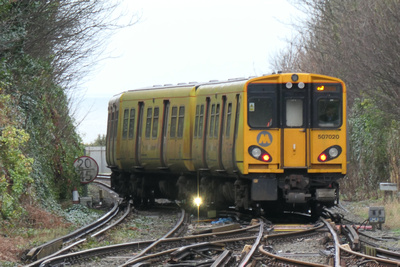
|
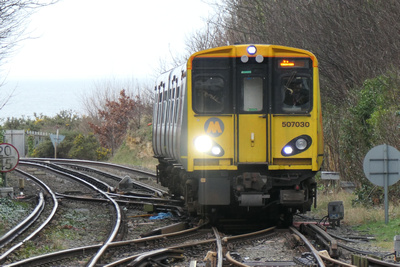
|
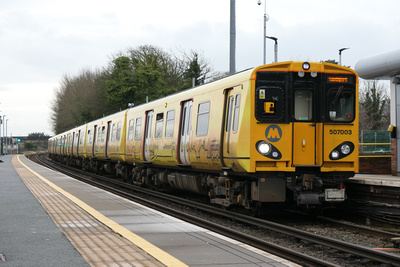
|
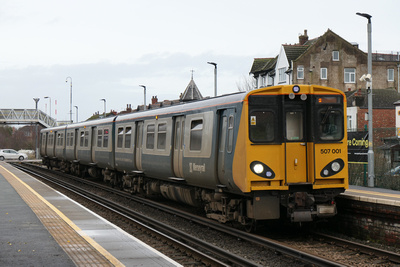
|
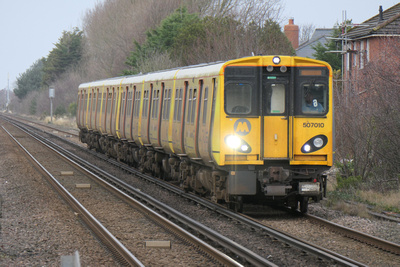
|
The West Coast Rail depot at Carnforth is visible from the platform at Carnforth station. Since my last visit there a few years ago, many of the stored and spares donor locomotives owned by West Coast have been moved over towards the station end of the site and are visible from the station.
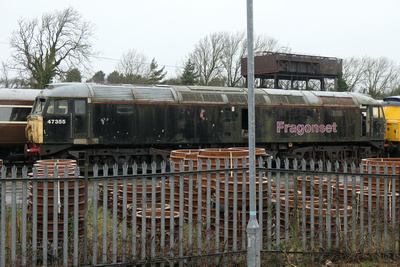
|
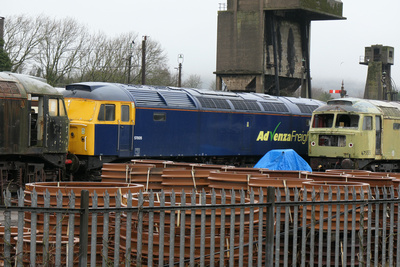
|
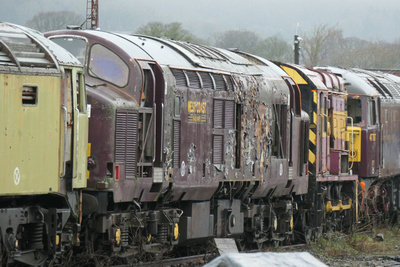
|
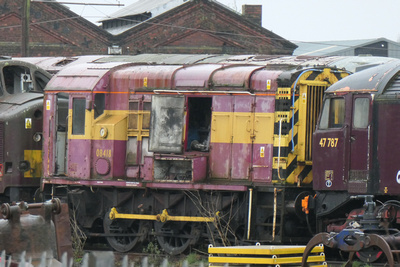
|
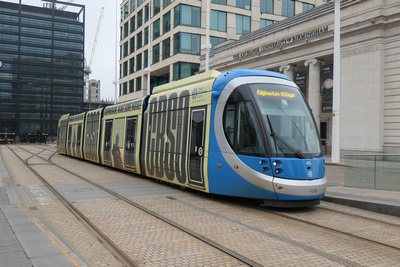 The West Midlands Metro opened in 1999 and originally ran from Wolverhampton St Georges to Birmingham Snow Hill and was operated by 16 AnsaldoBreda built T69 trams, which were similar to the T68 trams which originally operated on the Manchester Metrolink. The T69 fleet were withdrawn by 2015 and replaced by a fleet of 21 CAF Urbos 3 trams, more of these trams were ordered with future expansion planned. In 2015, the line was extended from Snow Hill to Grand Central (New Street). The next extension from Grand Central to Library opened in 2019, however this section did now have OHLE and required the trams to be retrofitted with batteries to operate on this section.
The West Midlands Metro opened in 1999 and originally ran from Wolverhampton St Georges to Birmingham Snow Hill and was operated by 16 AnsaldoBreda built T69 trams, which were similar to the T68 trams which originally operated on the Manchester Metrolink. The T69 fleet were withdrawn by 2015 and replaced by a fleet of 21 CAF Urbos 3 trams, more of these trams were ordered with future expansion planned. In 2015, the line was extended from Snow Hill to Grand Central (New Street). The next extension from Grand Central to Library opened in 2019, however this section did now have OHLE and required the trams to be retrofitted with batteries to operate on this section.
A fleet of 21 CAF Urbos 100 trams were ordered for future extensions and entered service from 2021, however at this point there were a number of CAF Urbos 3 trams withdrawn for repair after cracks were discovered in the frames and later with panel issues. The line was further extended from Library to Edgbaston Village in 2022. At the Wolverhampton end of the line, an extension to Wolverhampton station opened in 2023 allowed for a second branch in the city.
Future extensions are in progress with a line from Wednesbury to Waterfront Merry Hill (and eventually on to Brierley Hill) and in the city centre a branch from Bull Street to High Street Deritend (eventually to Sollihull)
I was on a family holiday down to Birmingham and spent some time riding on and photographing the trams on the West Midlands Metro. Having 4 days in the area, I managed to photograph a number of trams in the City Centre as well as riding them between Library and Wednesbury. I found that it was mostly CAF Urbos 100 trams that were out (numbered 40 and above) and only 1 CAF urbos 3 (28) seen over the few days. There are a number of decent photography spots within the city centre, especially in the area around the Library and City Hall. I would recommend a visit!
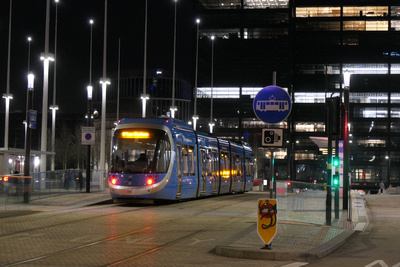
|
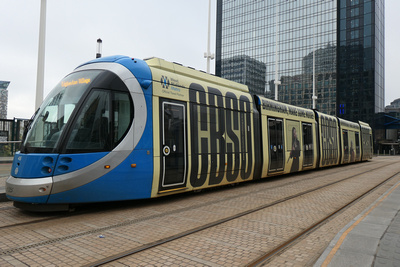
|
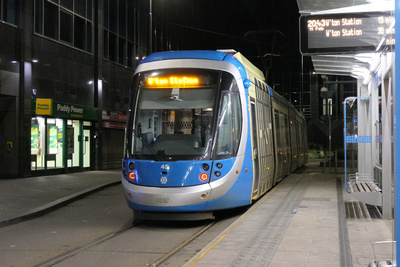
|
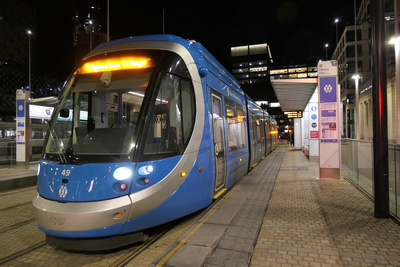
|
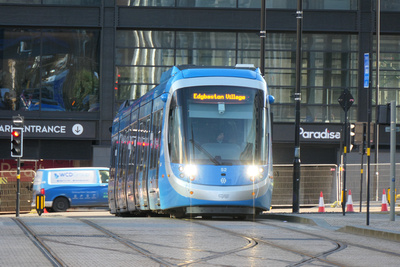
|
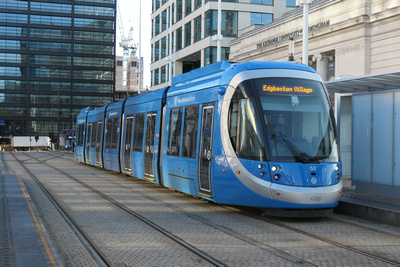
|
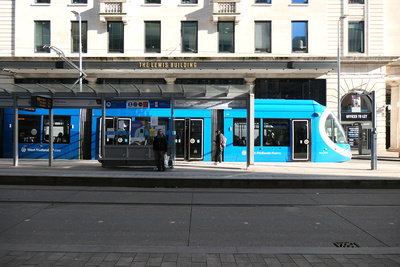
|
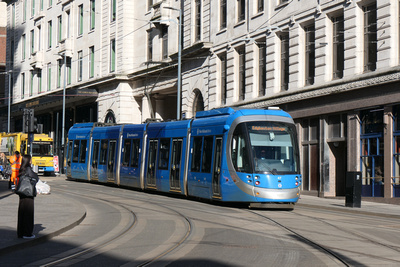
|
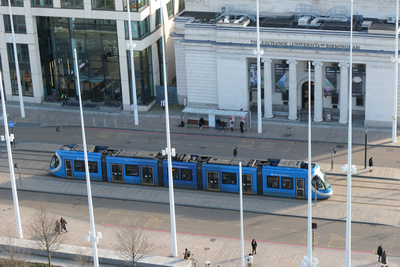
|
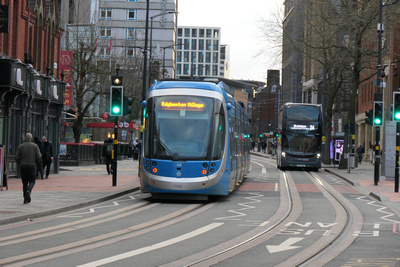
|
I had a trip on Scotrail's Prestwick Town - Ayr shuttle service earlier.
Starting from Prestwick Town, 156445 arrives into Prestwick Town with 5A44 Prestwick Town - Prestwick Town ECS working
The reason for the shuttle was the Station Hotel Fire. 156445 is seen at Ayr having arrived with 2A24 12.23 service from Prestwick Town. The remains of the fire damaged and now partially demolished former Station Hotel are in the background.
Work is progressing on demolishing the totally gutted south wing of the former Station Hotel. The fire in the hotel has meant the limitation of services to 2 car class 156s using the north end of Platform 4, with no services south of Ayr towards Stranraer, covered by replacement buses.
Just down from the station, Scotrail Saltire liveried 156445 passes over the River Ayr with 2A27 12.55 Ayr - Prestwick Town service
Round the other side of the bridge, there is a walkway over the River Ayr crossing. The other unit on the shuttle, Scotrail Saltire liveried 156513 passes over the bridge over the River Ayr with 2A26 12.56 Prestwick Town - Ayr
Scotrail Saltire liveried 156513 is seen at Ayr having arrived with 2A26 12.56 Ayr - Prestwick Town and awaiting departure back to Prestwick Town
Back at Prestwick and Scotrail Saltire liveried 156513 departs Prestwick Town with 5A26 12.35 Prestwick Town - Prestwick Town ECS
working
The ECS working involves the unit heading from Prestwick Town to Barassie Junction 156445 is seen at Barassie with 5A66 15.05 ECS working
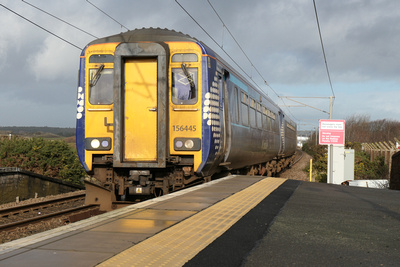
|
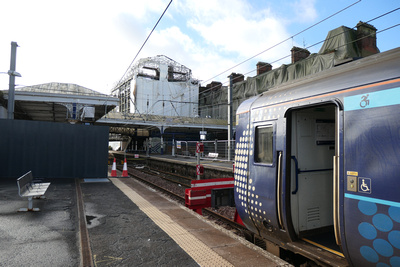
|
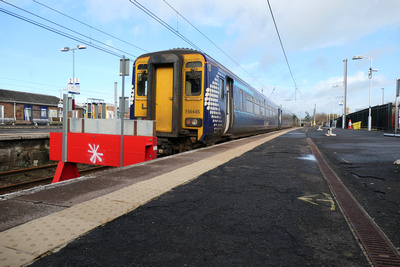
|
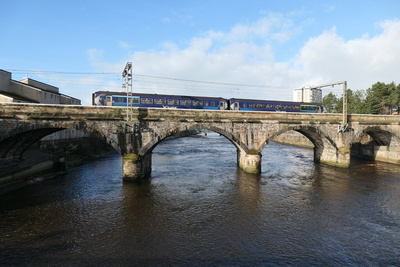
|
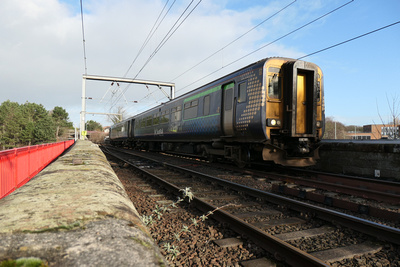
|
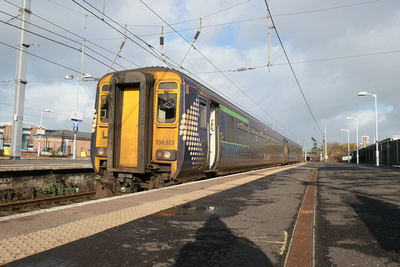
|
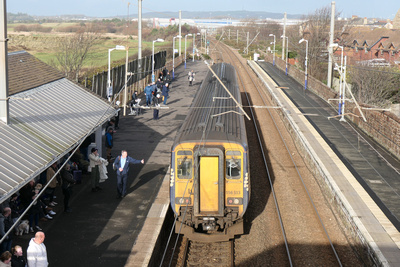
|
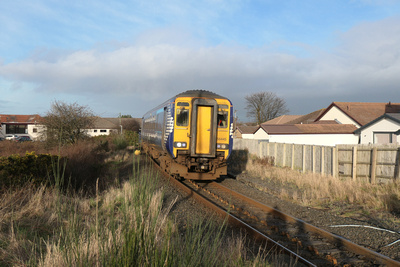
|
On 27th January, I decided to drive down to the Merseyrail area and it was quite an eventful trip!
I reached New Brighton around 12 o clock and the Wirral lines were all massively disrupted following the failure of a 777 on a Chester service on the Mersey loop. There was a 40 minute gap between trains on the New Brighton line so I headed to a spot that I'd seen in Martyn Hilbert's Merseyrail book just outside Wallasey Grove Road Station and got a couple of pics there of late running 507011 with 777016 practically right up its tail.
Time was getting on as I was well over an hour out there waiting for those shots and wanted to try a few other spots so had to miss out Birkenhead North and Bidston and head over the river to Leeds Street to catch some of units going up and down the incline to /from Moorfields as I've been wanting to do there for ages! Luckily 507001 was running 10 + late so I managed to get it there!
Then I drove up to Formby to photo there and caught 001 up to Southport. Got a few pics up there then got 014 down to Ainsdale and got some pics there, then 018 back to Formby. Got a couple of pics there including 001 in the dark as it returned back to Southport. I had been going to stop off at Headbolt lane for a couple of pics there but had run out of time and had to head home!
Units spotted:
New Brighton (stabled): 507028, 777034
New Brighton service: 507011, 777016
Southport - Hunts Cross service: 507014, 017, 033, 018, 023, 015, 007, 029, 030, 001
Stabled at Southport: 507021, 777027, 777004, 777036
Ormskirk: 777022
Headbolt Lane: 777140, 777148
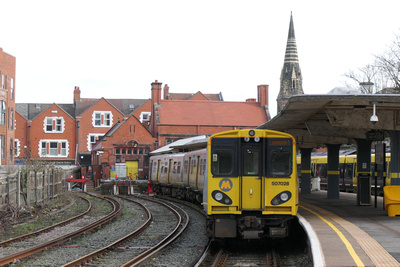
|
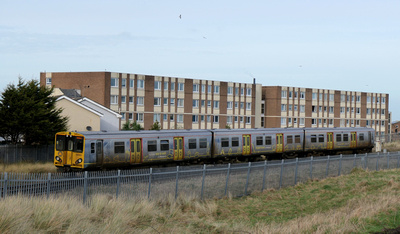
|
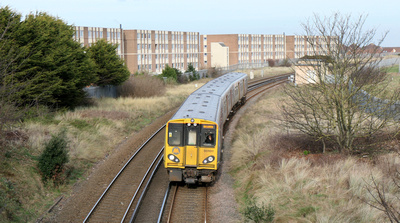
|
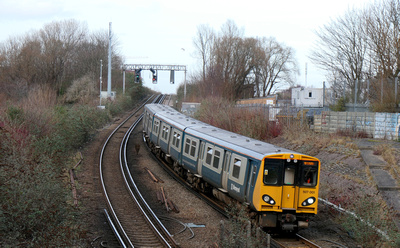
|
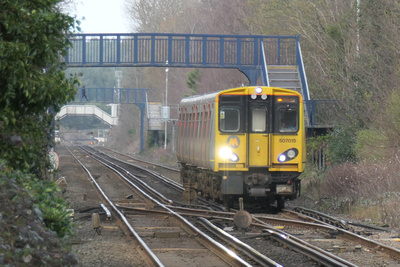
|
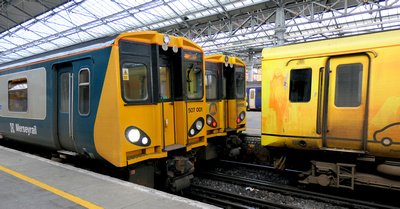
|
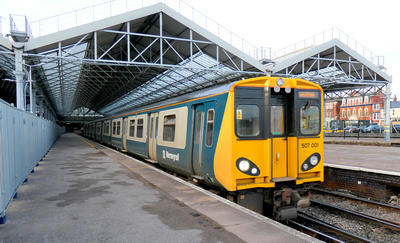
|

|
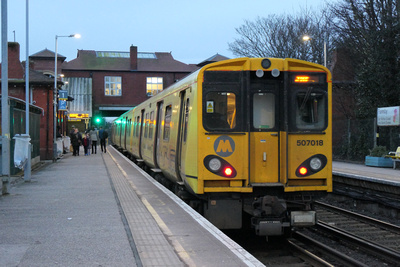
|
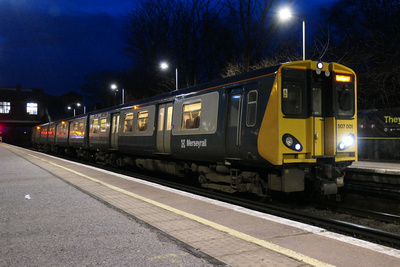
|
Scotrail Saltire liveried 318259+320401 arrive into Newton with 2F37 14.17 Cumbernauld - Dalmuir service 26.1.24
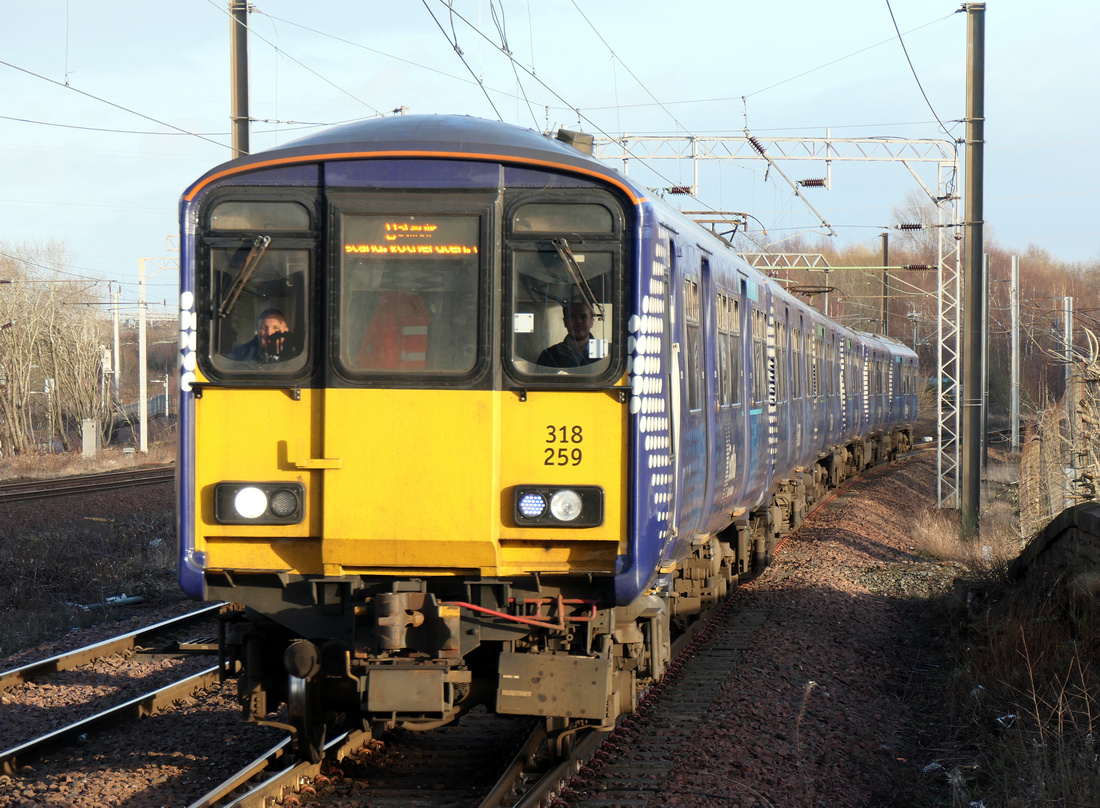
Locomotive Services Limited's Intercity liveried 86101 and 87002 top and tail a matching set of Mark 3s through Hillington West with 1Z31 13.35 Barassie Junction - Glasgow Central leg of 'The Ayr Extension' Railtour 13.1.24
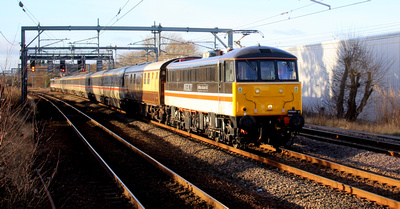
|
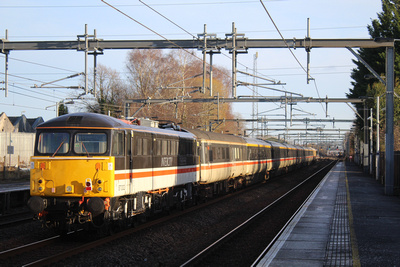
|
Scotrail's Class 385: 385006 is seen crossing Marshall Street Bridge on the approach to Wishaw station at sunset with 1C60 15.34 Glasgow Central - Edinburgh Waverley via Carstairs service 6.1.24
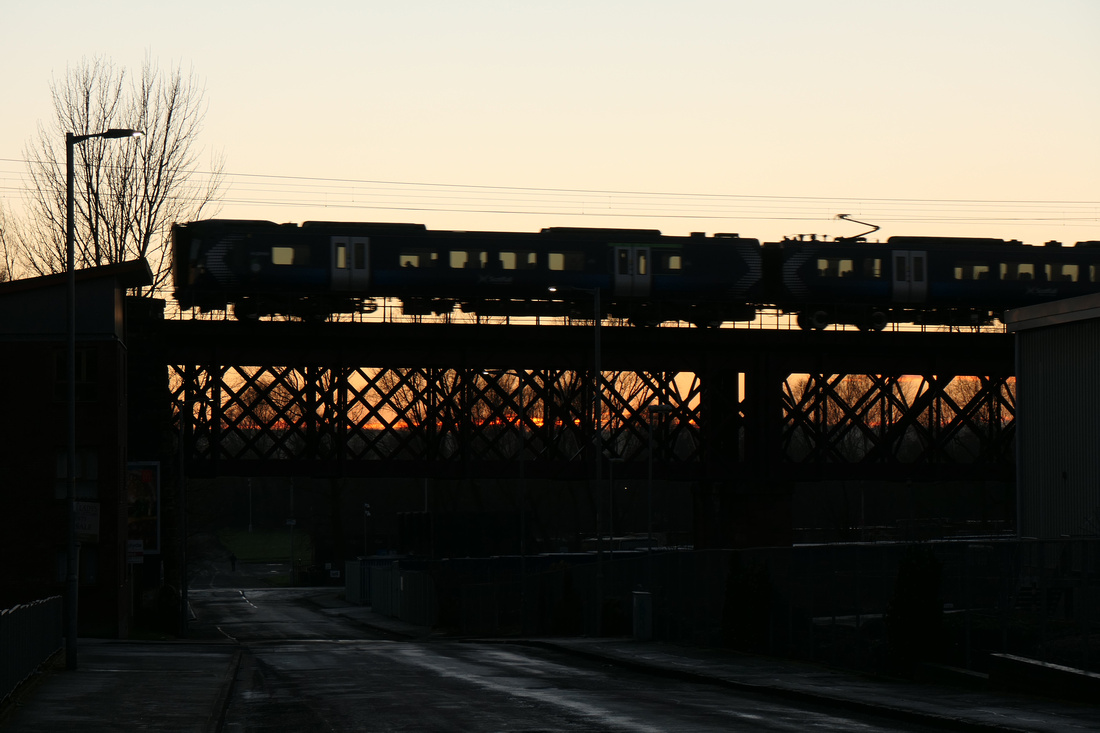
On 3rd January Merseyrail's 508108 and 508114 were withdrawn from service. The withdrawal of this pair of class 508s left 508104 as the final class 508 remaining in service. Seen at Southport, 508104 came in working as 2S37 from Hunts Cross and departed as 2U44 to Hunts Cross. 104 was withdrawn a week later along with 507004. Both units were hauled from Birkenhead North to Crewe South Junction awaiting further movement to Newport for scrapping on 5th February.
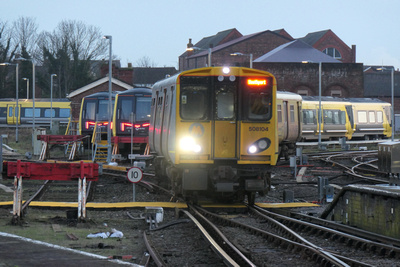
|
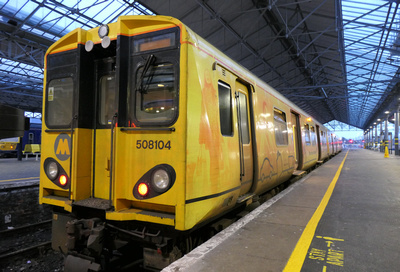
|
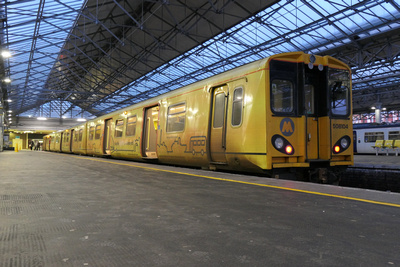
|
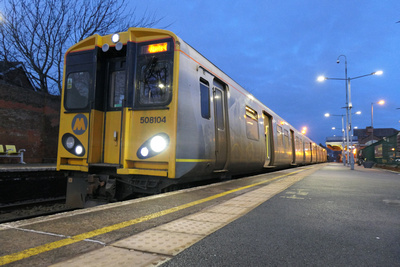
|
The Bo'ness Diesel Gala took place on 29th December, with Colas Class 70s 70807 and 70813 the visiting locos and home fleet locos 37403 and 27001 operating the services. 47643 was on display in the Bay Platform and 37025 was used as a shunter. Here are a few photos from the Gala.
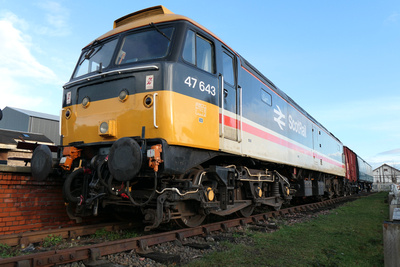
|
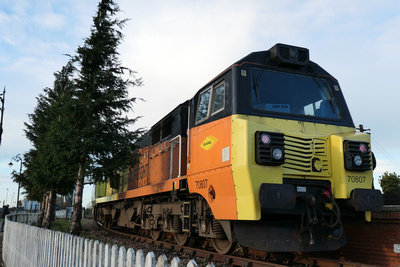
|
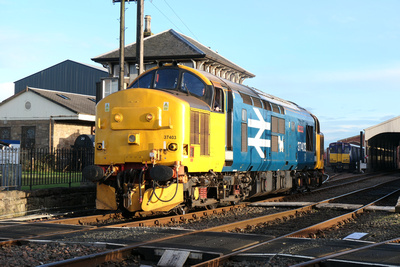
|
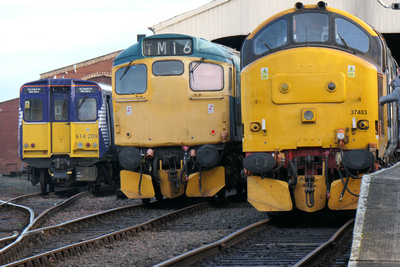
|
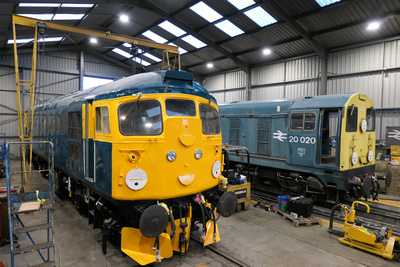
|
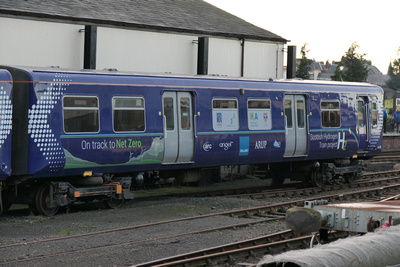
|
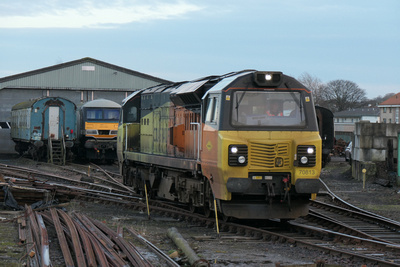
|
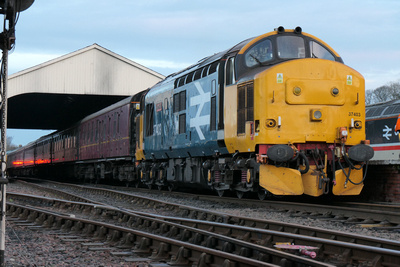
|
Glasgow Subway's new 3rd Generation Stadler Subway units 306 and 302 are seen at Cessnock, Ibrox, Govan, Partick and Kelvinhall on 27th December.
Both units were in service until around 12.40pm with 306 on the front diagram and 302 behind. Both work on consecutive diagrams on the Outer circle at the moment in case of failure that the other unit can rescue the failed one.
The procedure for returning to depot appears to be that the first unit terminates at Govan, then returns wrong line back to the ramps to Broomloan Depot, whilst the 2nd unit terminates at Ibrox and heads straight to the ramps back to depot.
First impressions are that they are so much quieter than the Metro Cammell / Barclay stock, have smoother, faster accelleration and that the interior seems much brighter and more spacious!
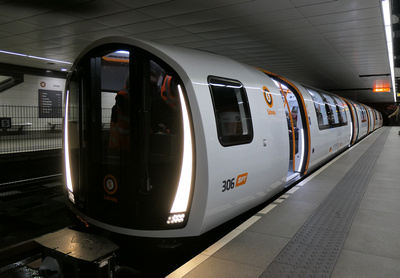
|
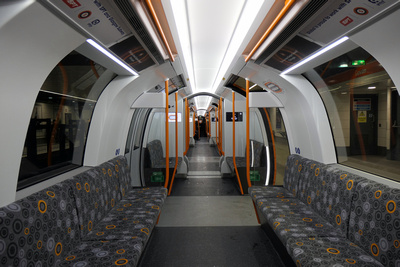
|
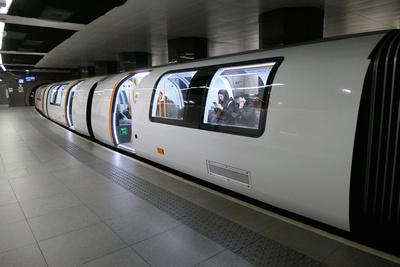
|
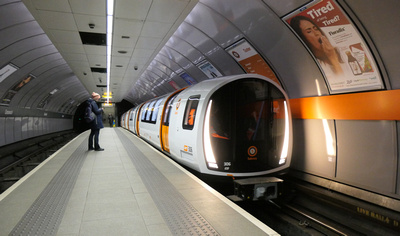
|
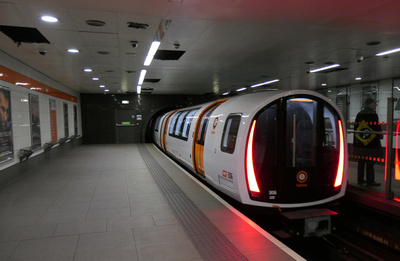
|
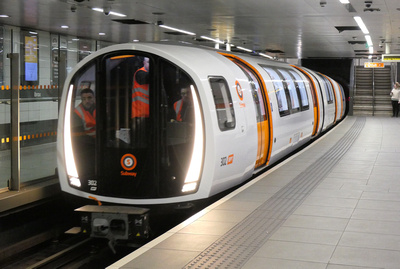
|
I headed over to Edinburgh after work on 21st December to catch a couple of interesting workings at Edinburgh Waverley.
First up was British Railways Green liveried 40013 'Andania' which departed heading southbound with 1Z36 16.53 Edinburgh - Leicester return leg of the 'The Edinburgh Christmas Statesman Railtour'
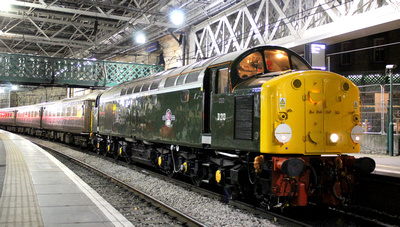
Later on and West Coast Railways 47813 & 47848 top and tail a set of BR Blue / Grey Mark 2s as they prepare to depart with 1Z31 'Edinburgh Polar Express' working to Portobello Junction
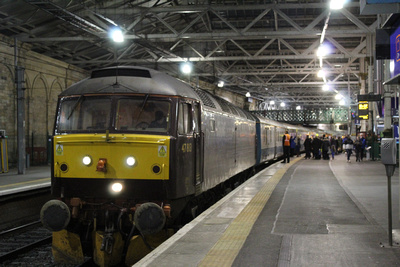
Up on Princes Street the trams are seen passing the Big Wheel and the Star Flyer at the Christmas Village
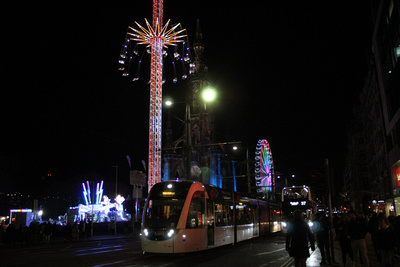

Before heading home, I saw Scotrail Inter7city HST power car 43028 awaits its next duty at Edinburgh Waverley with the Big Wheel, Star Flyer and Scott Monument on Princes Street lit up in the background
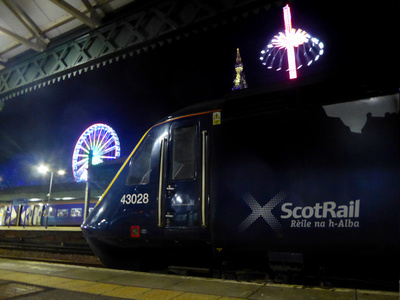
Varamis Rail's newest addition to it's fleet, 321419, which has been converted to carry parcels instead of passengers, passes through Holytown with 1Z07 Mossend - Birmingham International parcels working 8.12.23
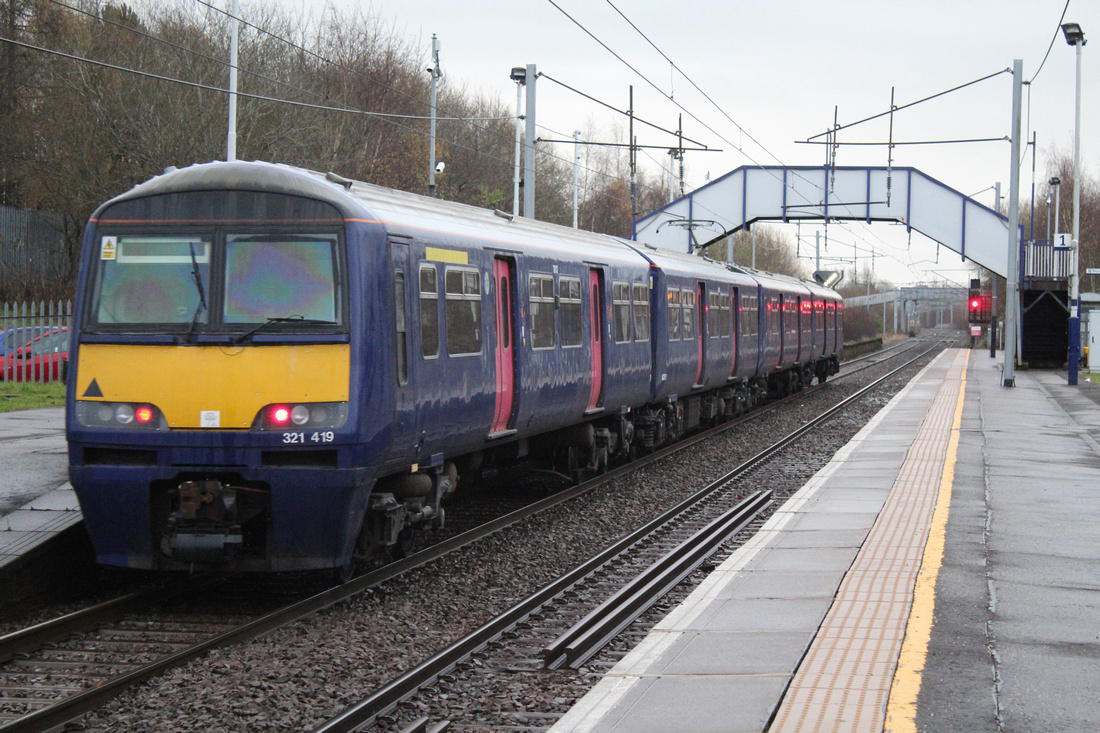
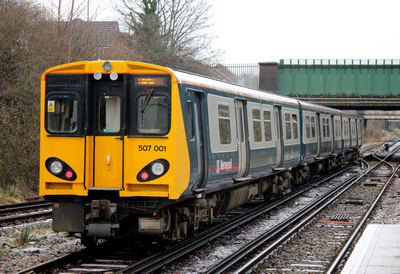 In late November 2023, Merseyrail unveiled 507001 in a modified version of the original BR Blue/Grey livery carried by the fleet when they first entered service in 1978. The livery has been modified with all Grey doors to meet PRM regulations. The livery is also to commemorate the future withdrawal of the fleet during mid 2024.
In late November 2023, Merseyrail unveiled 507001 in a modified version of the original BR Blue/Grey livery carried by the fleet when they first entered service in 1978. The livery has been modified with all Grey doors to meet PRM regulations. The livery is also to commemorate the future withdrawal of the fleet during mid 2024.
On to the trip and on hearing the news of 001's relivery, I decided to drive down to Liverpool to get some photos while the unit was still clean! On the day in question, 001 was in service on the West Kirby branch so it meant a drive through Liverpool and over to Birkenhead North for some photos! Heavy traffic in Liverpool meant that the journey took longer than expected and that I didn't reach Birkenhead North station till 1pm (about an hour later than expected).
Luckily I caught 507001 a few times passing through and 001 looked fantastic! As well as 001, there was also the opportunity to photograph some of the class 508s, which were facing imminent withdrawal at the time and indeed at the time of writing have all been withdrawn and scrapped with 508136, one of the units photographed on the day, being withdrawn just a few days later.
On 2nd December the units passing through Birkenhead North were:
- New Brighton line: 508131, 507030, 508120, 507004
- West Kirkby: 507018, 507001, 777018, 508104, 508136
Thanks to the failure of a class 777 operating on a Chester service on the Mersey Loop, there was chaos in Central Liverpool, with delays and early turn backs on some services to get back to time. Unfortunately I received a notification on my phone whilst in Birkenhead that there was an amber weather warning for snow in Cumbria declared so I took the decision to call it a day around 3.30 after final photo of 507001 and head back up the road alot earlier than planned. It was lucky I did as heavy snow around the M6 between Tebay and Shap almost led to me being stranded, lucky I had left when I did as 30 minutes later and I'd have never made it home to Lanarkshire! Luckily I did though!
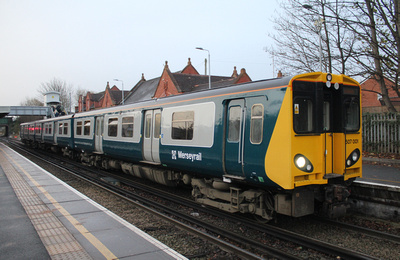
|
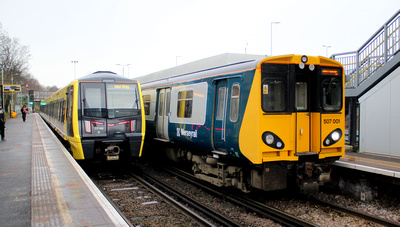
|
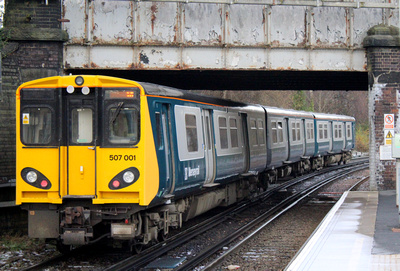
|
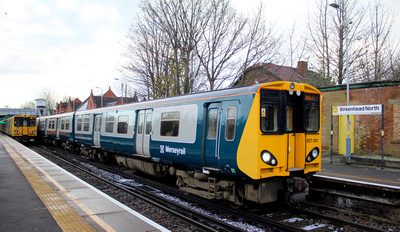
|
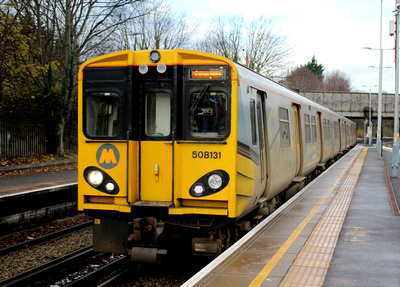
|
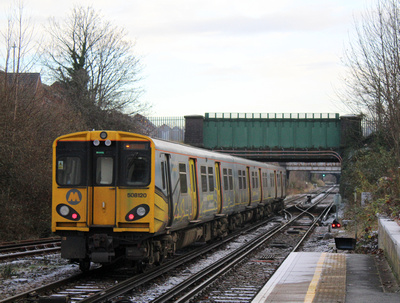
|
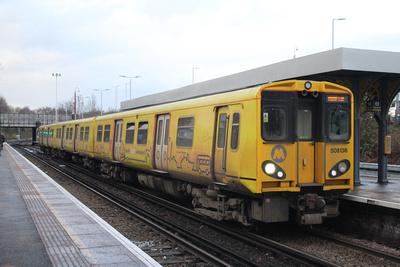
|
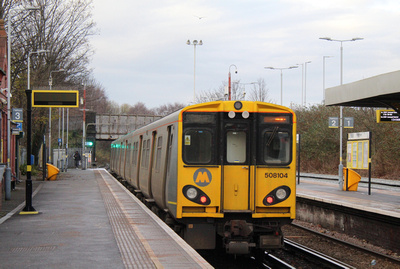
|
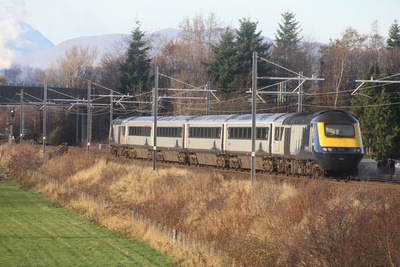
|
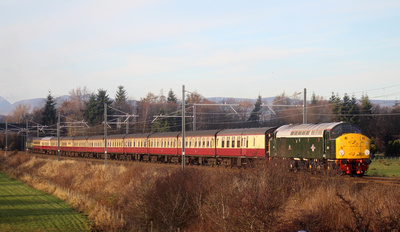
|
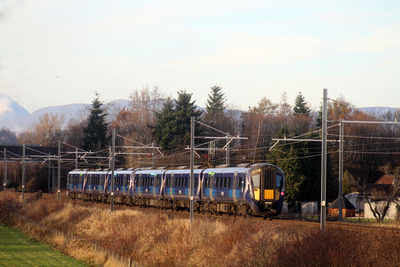
|
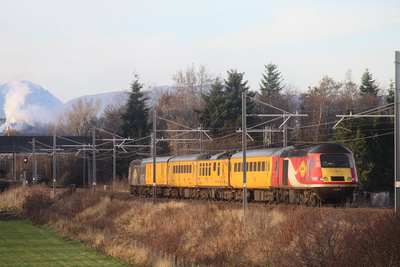
|
- Scotrail Inter7city liveried HST power cars 43035 and 43147 top and tail a set of matching mark 3s past Bannockburn Station Road with 1H17 13.33 Edinburgh Waverley - Inverness service
- British Railways Green liveried D213 (40013) 'Andania', a late replacement for a poorly 60007 'Sir Nigel Gresley' passes Bannockburn Station Road with 1Z51 12.57 Dunfermilne City - Edinburgh Waverley Steam Dreams Forth Bridge Lunchtime
- Scotrail Saltire liveried 385023+385038 pass Bannockburn Station Road with 2N43 13.49 Glasgow Queen Street - Alloa service
- Former Cross Country HST Power car 43285 and Former LNER Power Car 43257 top and tail the Network Rail PLPR Test Train northwards past Bannockburn Station Road with 1Q77 13.35 Mossend - Inverness Millburn working
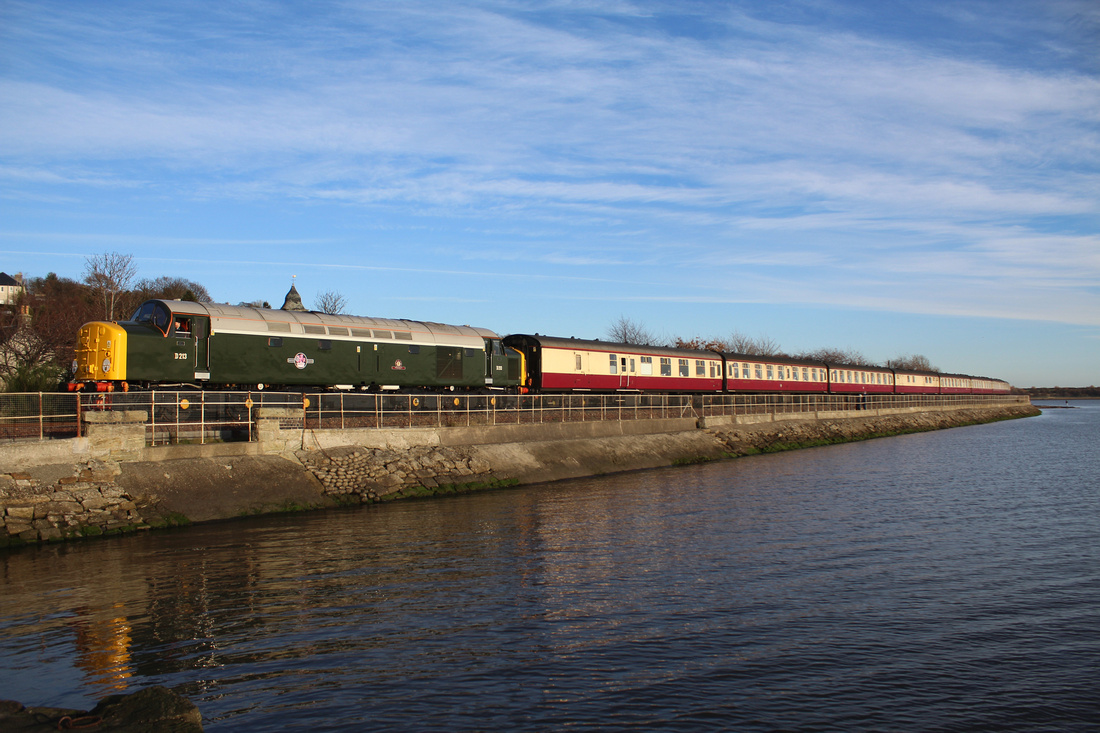
Viewed from Culross Pier, British Railways Green liveried D213 (40013) 'Andania', a late replacement for a poorly 60007 'Sir Nigel Gresley' heads along the shoreline of the River Forth with 1Z51 12.57 Dunfermilne City - Edinburgh Waverley Steam Dreams Forth Bridge Lunchtime Tour 25.11.23
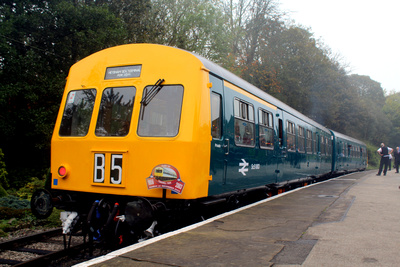
|
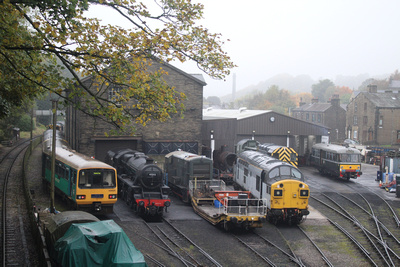
|
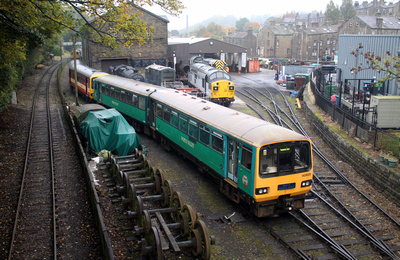
|
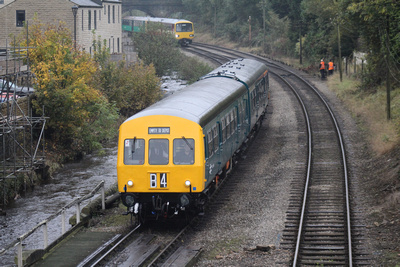
|
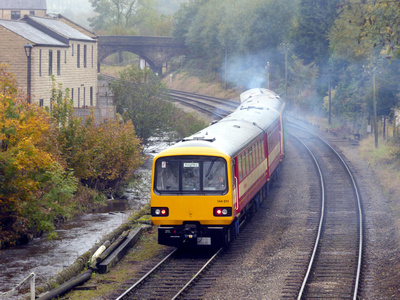
|
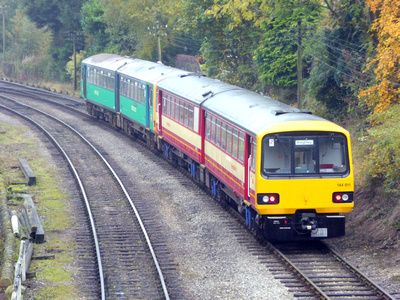
|
On 28th October, I went to the Multiple Unit Gala at the Keighley and Worth Valley Railway to get some photos of the newly repainted class 101 DMU and 143625 making its one and only outing at the railway. Also out and about was the West Yorkshire PTE liveried class 144011 and railbus M79964
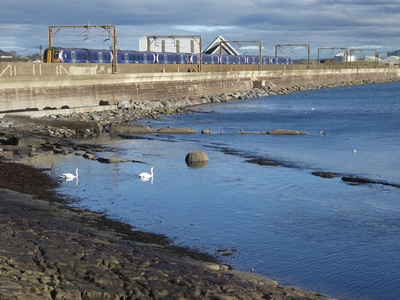
|
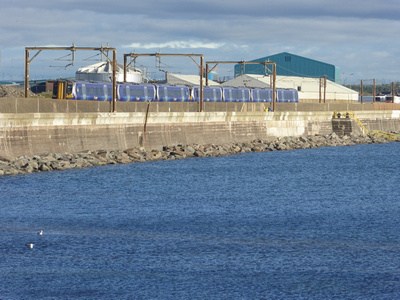
|
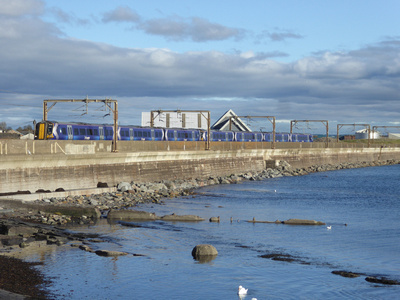
|
Scotrail Saltire liveried 380001+380104 accelerate out of Saltcoats and along the seawall with 2T16 14.07 Largs - Glasgow Central service and 380004+380112 head along the seawall on approach to Saltcoats station with 2T15 13.45 Glasgow Central - Largs services
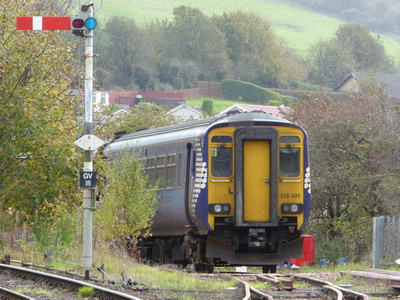
|
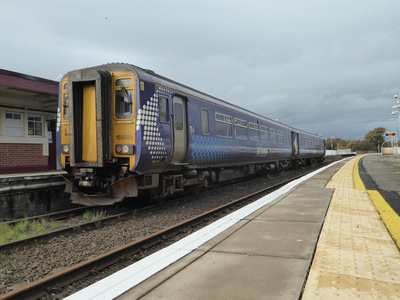
|
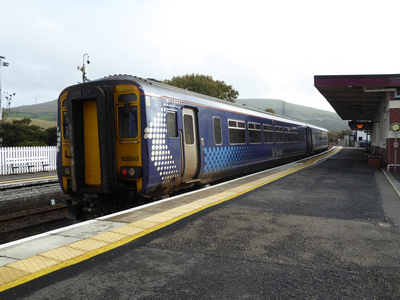
|

|
Following the Ayr Station Hotel Fire in September 2023, Scotrail Class 156s 156495 & 156503 were trapped south of the station without access northwards towards Ayr station. Both units are seen awaiting their next duties at Girvan Station on 19th October 2023
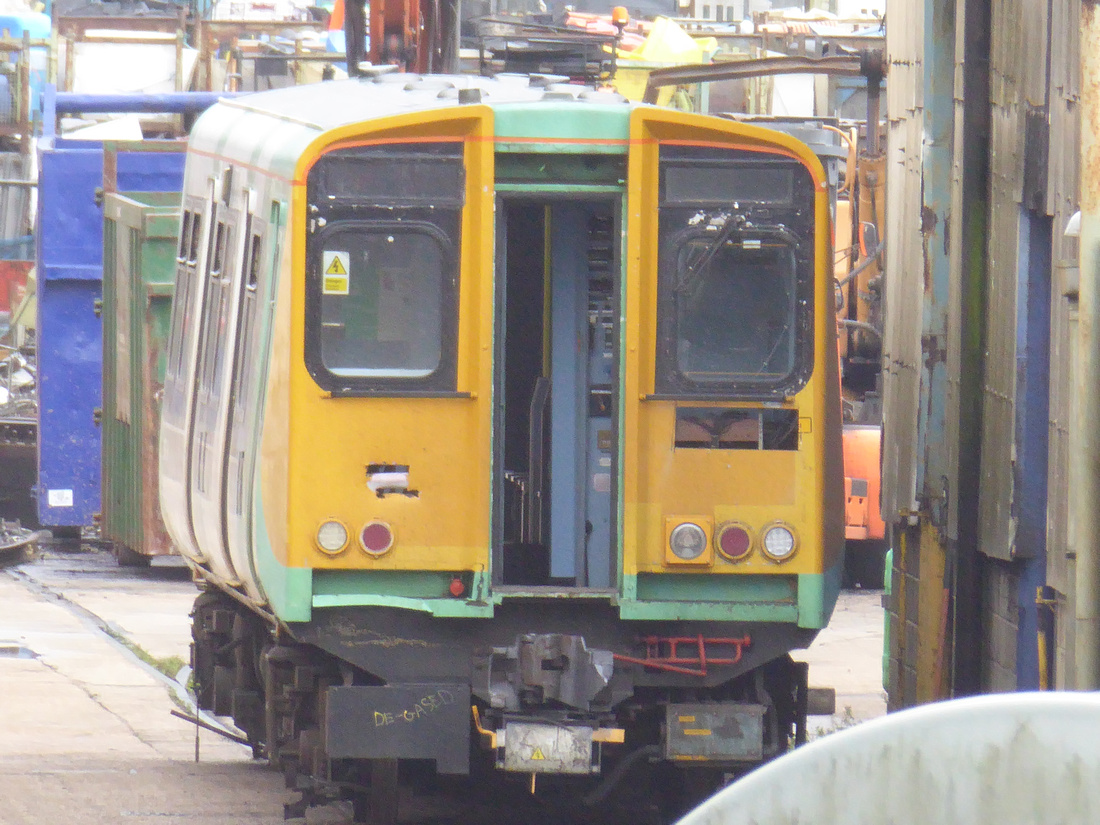
Five months after withdrawal and after a scrapping process that began in July, one Southern liveried class 313 vehicle remains: 62604 from 313212. It is seen awaiting its fate at Eastleigh Arlington works on 13.10.23.
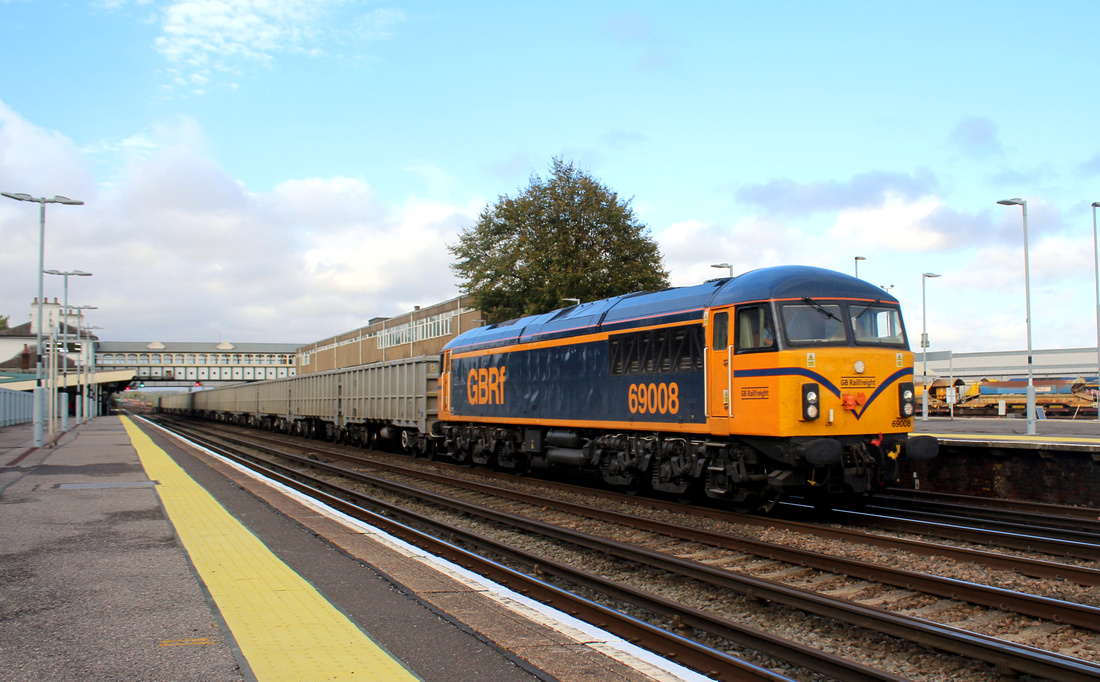
GBRF liveried 69008 passes through Eastleigh with 4Y19 Mountfield Sidings - Southampton West Docks 13.10.23
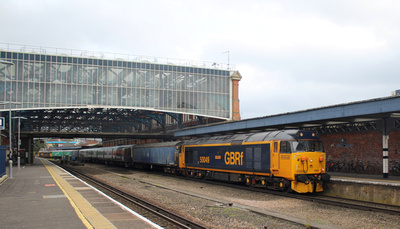
|
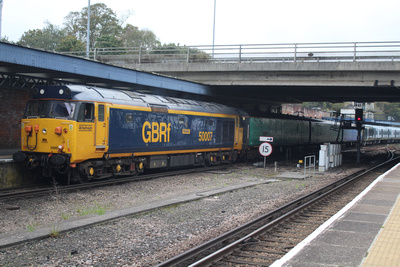
|
GBRF's 50049 & 50007 with 4 barrier coaches and recently refurbished and reduced to 4 carriages Class 458/4 458425 sandwiched inbetween, passes through Bournemouth with 5X72 Wembley Receptions 1-7 - Bournemouth T&RSMD ECS move 11.10.23
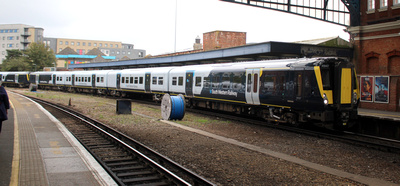
|
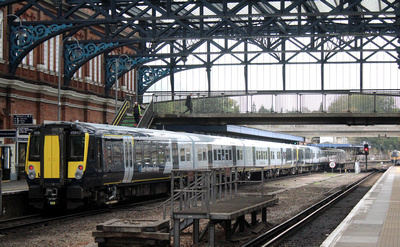
|
Newly refurbished and reduced from 5 to 4 cars, class 458/4s 458407+458417 pass through Bournemouth with 5Q91 Basingstoke - Bournemouth T&RSMD ECS working 11.10.23
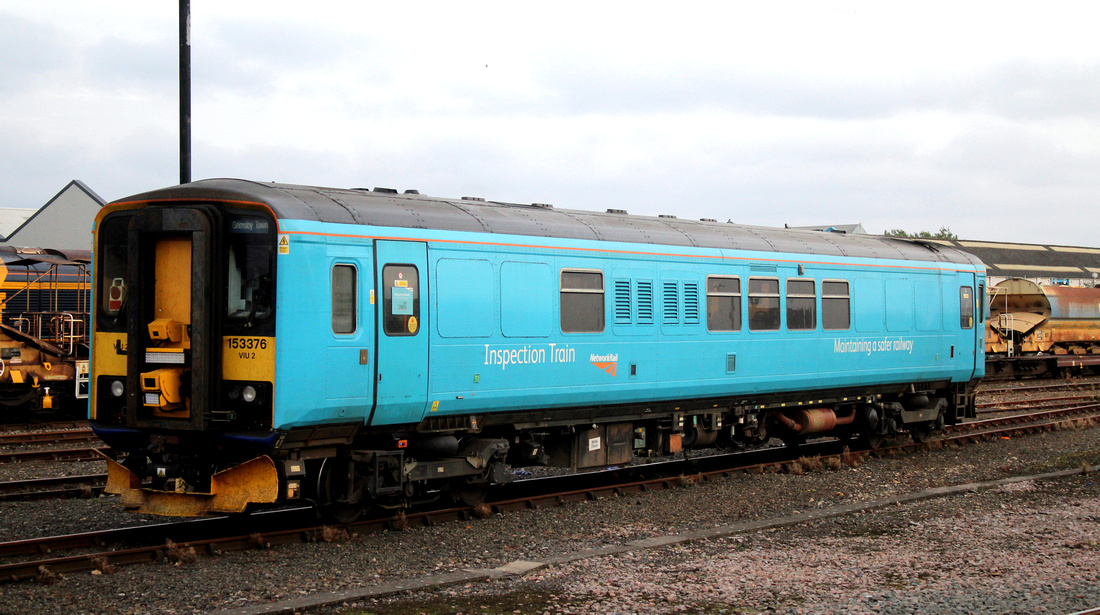
Arriva Blue liveried Network Rail Inspection Train 153376 is seen in the yard at Eastleigh 10.10.23
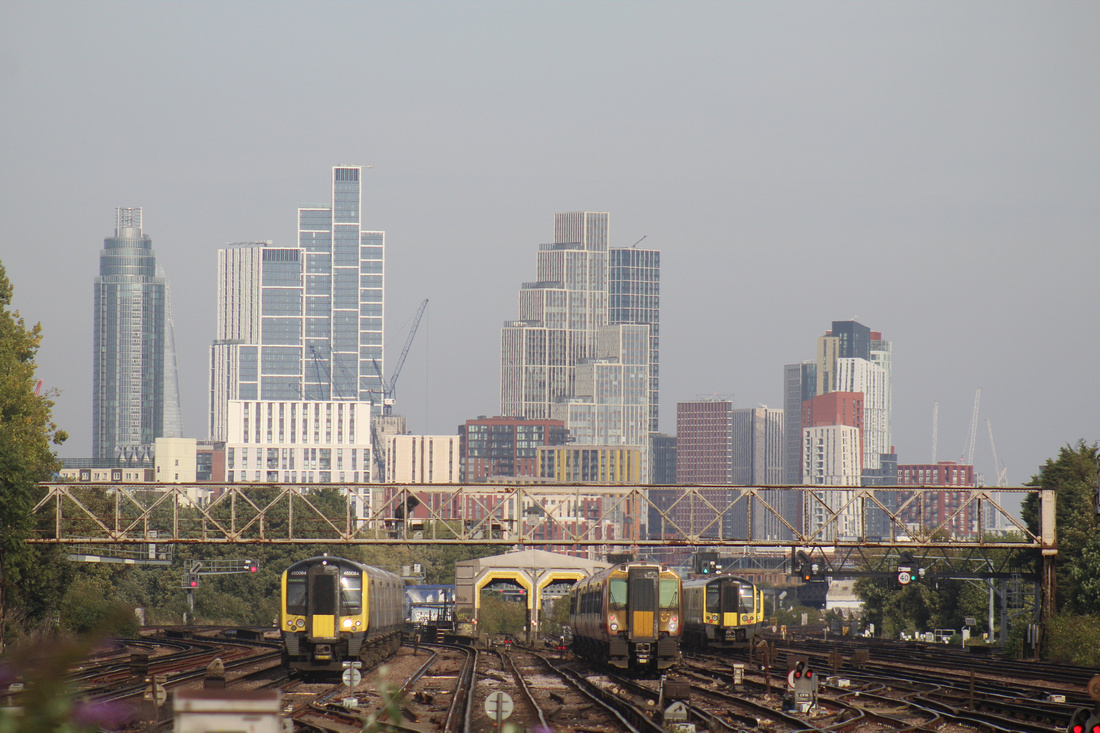
With London's skyline in the background, a selection of units including a South Western Railways 458, a 444 and 450 are seen around Clapham Junction 10.10.23
On 23rd September, I visited the London Transport Museum Store at Acton Depot in London. Catching an early flight from Edinburgh to Gatwick, I then caught a class 377 from Gatwick to Clapham Junction then from Clapham Junction to Wimbledon. From Wimbledon I headed to Acton via the District Line to Earl's Court and then the Picadilly line to Acton Town.
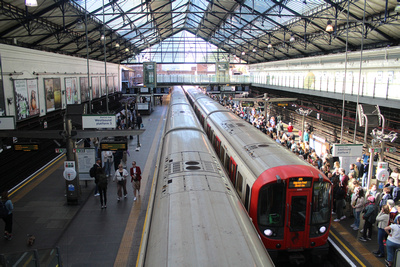
|
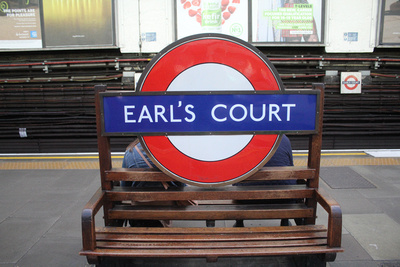
|

|
| Earl's Court Station | Earl's Court station signage | View from overbridge outside Acton Town |
From Acton Town station, its a 2 minute walk to the museum and once inside it's packed to the rafters with items relating to the Underground and London Transport in General. There is a wide selections of Buses, Trams and Underground Trains onsite. The Underground stock was my main interest on the day with plenty of vintage trains and vehicles to see:

|
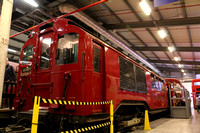
|
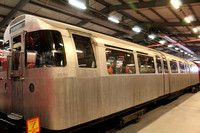
|
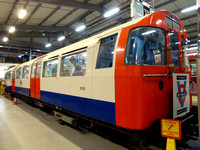
|
| Waterloo & City Car 61 | Standard Car | 1972 Northern Line Stock | 1967 Victoria Line Stock |
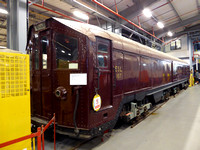
|
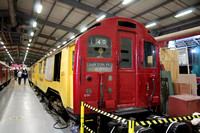
|
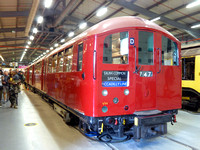
|
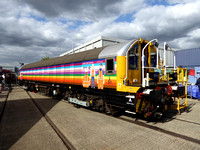
|
| Sleet Car | Standard Car | 1938 Stock | L51 Engineering car in Pride Livery |
It was a very interesting visit to the Museum. Once I'd been, I had a couple of hours spare before returning home, so I visited Northfields to photo some of the Picadilly 73 stock. Then it was off to Heathrow for a flight back to Edinburgh. More photos from the day at: https://scottishtrains.zenfolio.com/p946354454
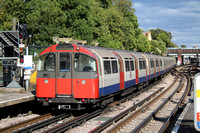
|
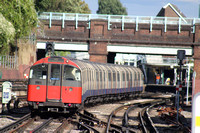
|
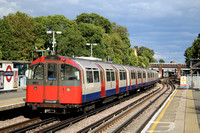
|

|
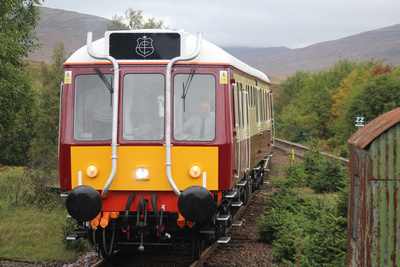 Making its debut following a major overhaul and interior refit, Locomotive Services Ltd's Carmine and Cream liveried Bubble Car 121022 (55022) 'Flora' approaches Rannoch with a private charter working as 2Z28 11.30 Mallaig - Rannoch 30.9.23 and is later seen departing with 2Z29 15.26 back to Arisaig.
Making its debut following a major overhaul and interior refit, Locomotive Services Ltd's Carmine and Cream liveried Bubble Car 121022 (55022) 'Flora' approaches Rannoch with a private charter working as 2Z28 11.30 Mallaig - Rannoch 30.9.23 and is later seen departing with 2Z29 15.26 back to Arisaig.
Also included are photos of the stunning interior of the Bubble Car (I was invited on along with others on the platform for a look round)
The bubble car has been restored for use on private hires.
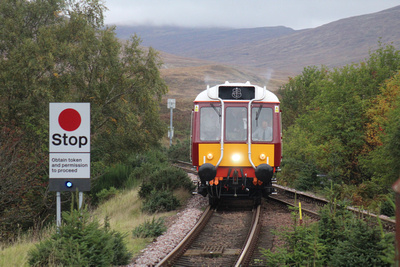
|
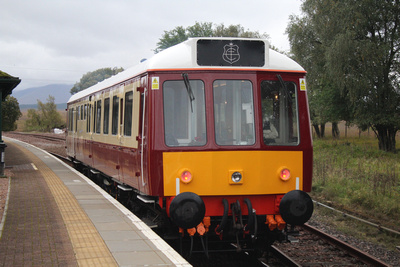
|
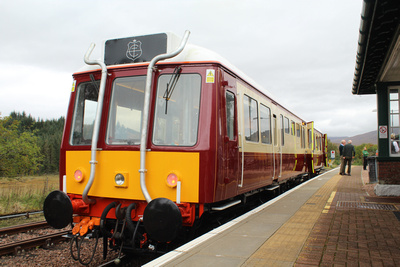
|
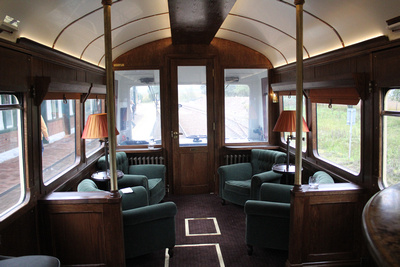
|
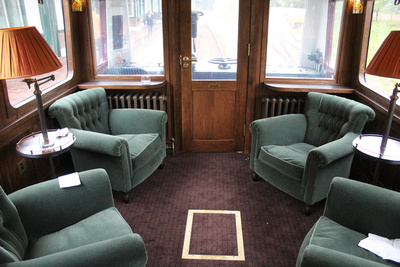
|
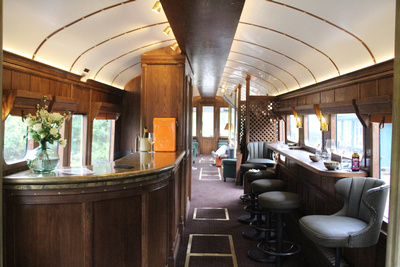
|

|
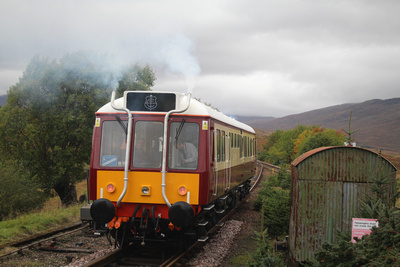
|
The Pathfinders 'Pilgrim Centurion' Railtour visited Scotland on 16th September 2023 with GBRF's 50007 & 50049 providing the traction.
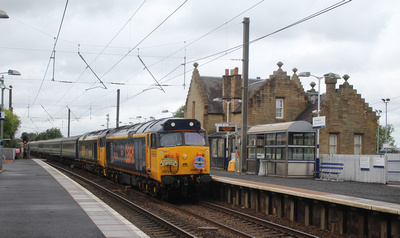
|
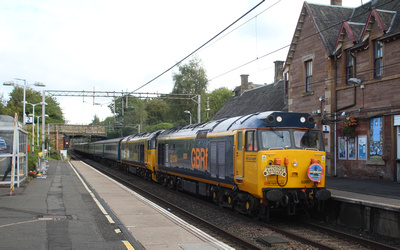
|
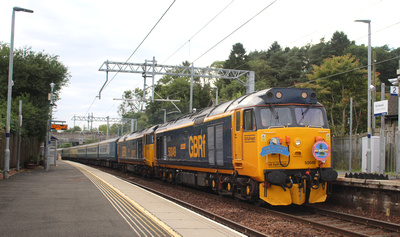
|
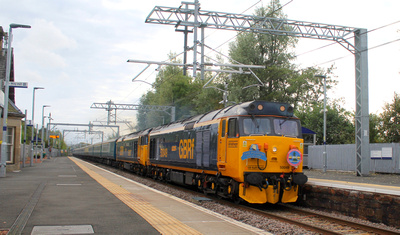
|
Photo 1: 50007 & 50049 are seen passing through Kirknewton with Pathfinders Railtour 'The Pilgrim Centurion' working 1Z50 5:30 Swindon - Edinburgh Waverley
Photo 2: 50007 & 50049 are seen passing through Uddingston with the Pathfinders Railtour 'The Pilgrim Centurion' ECS working as 5Z51 13:22 Edinburgh Waverley - Polmadie
Photo 3: 50049 & 50007 are seen passing through Hartwood at slow speed following a local stopper with the Pathfinders Railtour 'The Pilgrim Centurion' ECS working as 5Z52 15:41 Polmadie - Edinburgh Waverley 16.9.23
Photo 4: 50049 & 50007 are seen passing through West Calder with the Pathfinders Railtour 'The Pilgrim Centurion' ECS working as 5Z52 15:41 Polmadie - Edinburgh Waverley
Locomotive Services Limited's Midland Pullman liveried HST set consisting of 43047 & 43046 and a matching set of mark 3s are seen at Float, south of Carstairs with 1Z43 5.46 Paignton - Fort William Day 1 of the 'West Highland Pullman' railtour 9.9.23
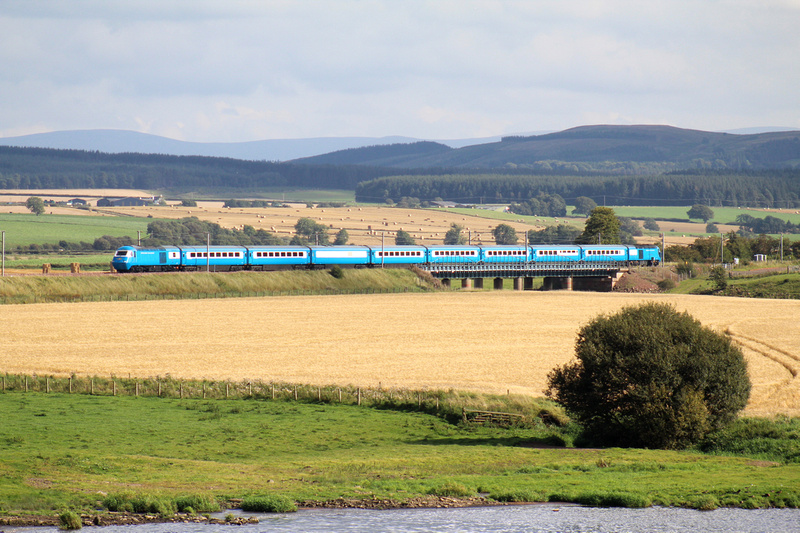
On 2nd September, the Bo'ness and Kinneil Railway held their annual Steam Gala. As well as the home fleet steam locos: Caledonian Railway class 439: 55189 (CR 419), Lord Roberts (No1) & National Coal Board No 19 Fife Area, visiting the railway was Lambton no 29 from the North Yorkshire Moors Railway.
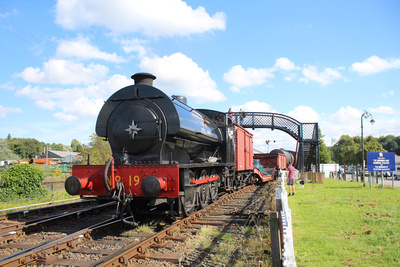
|
National Coal Board No 19 Fife Area in all over black livery shunts the demonstration freight from the Bay Platform |
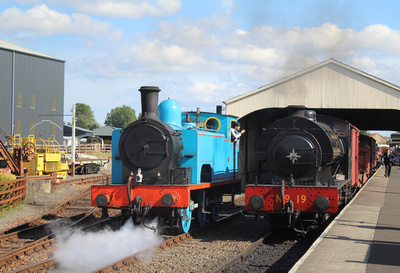
|
No1 'Lord Roberts' reverses along the run round line as National Coal Board No 19 Fife Area prepares to shunt the demonstration freight from the main to the Bay Platform |
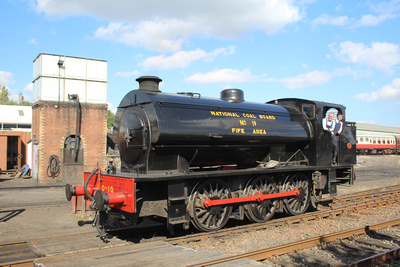
|
National Coal Board No 19 Fife Area in all over black livery is seen waiting in the yard near the steam shed |
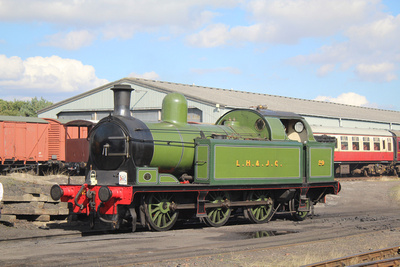
|
Visiting loco from the NYMR, 1904 built Olive Green liveried Lambton no 29 is seen reversing onto the headshunt |
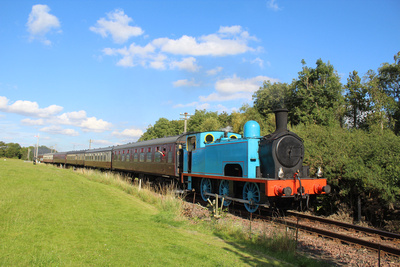
|
1899 built, Coltness Iron Co no 1 'Lord Roberts' heads the 15.45 service from Bo'ness - Manuel |
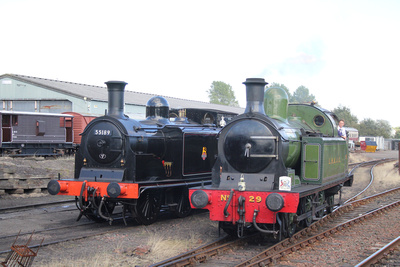
|
British Railways Black liveried Caledonian Railway 439 class 55189 (419) awaits it's next duty as visiting loco from the NYMR, Olive Green liveried Lambton no 29 heads towards to water coloumn to take on water |
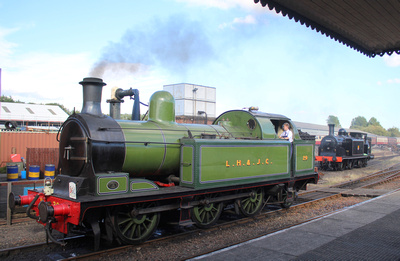
|
Visiting loco from the NYMR, Olive Green liveried Lambton no 29 takes on water at the water coloumn at Bo'ness as Calendonian Railway 439 class 55189 (419) awaits it's next duty in the background |
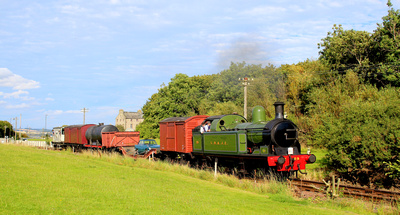
|
Visiting loco from the NYMR, Olive Green liveried Lambton no 29 is seen hauling the 16.45 Bo'ness - Birkhill demonstration goods train along the foreshore at Bo'ness. A Ford Anglia is seen onboard the Lomac wagon. |
70813 with 56105 dead in tow pass through Falkirk Grahamston with the late running (183 late) 6S36 Dalston - Grangemouth tankers 25.8.23
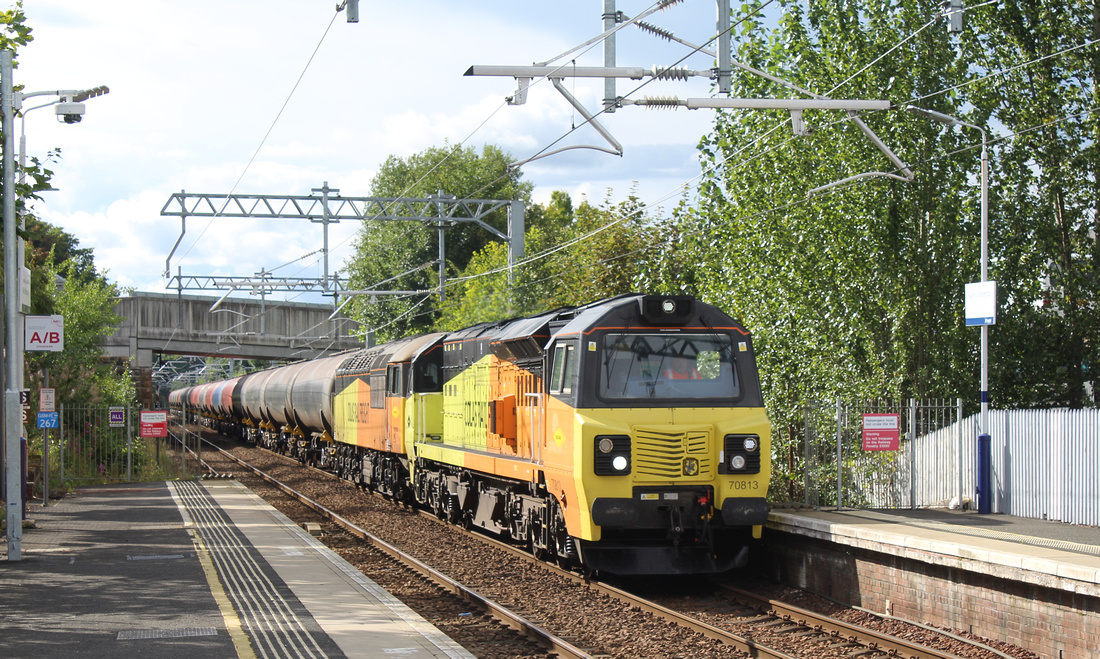
Network Rail liveried dual voltage 313121 'Pan up Pete' is seen stabled at it's new home for preservation at Fife Heritage Railway at Leven 19.8.23
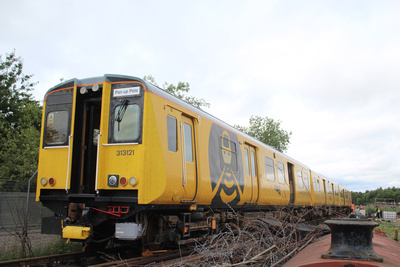
|
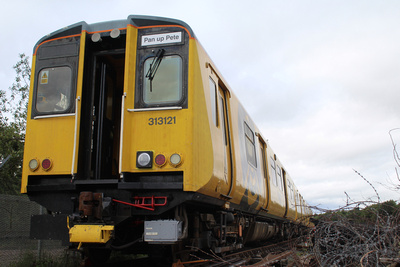
|
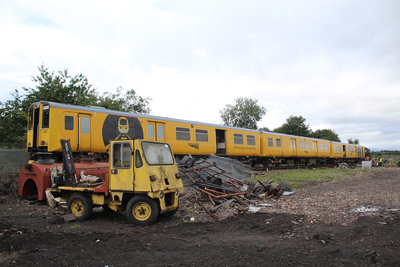
|
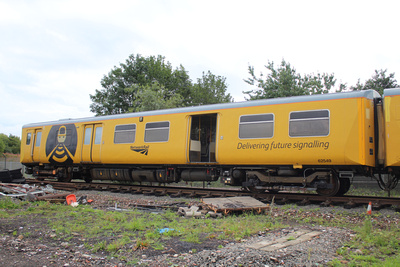
|
Network Rail liveried 313121 is seen on the back of 3 low loaders parked up on the lay-by on the Northbound sliproad of the M90 at the Queensferry Crossing enroute to its new home at the Fife Heritage Railway in Leven 16.8.23
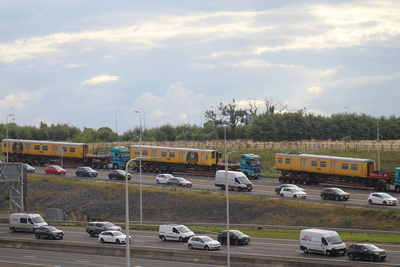
|

|
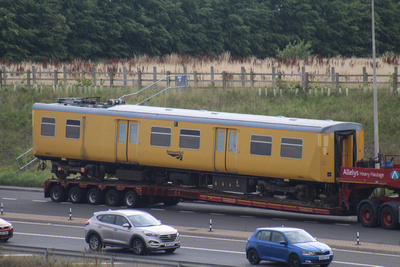
|

|
Rail Adventure HST Power Cars 43468+43480 with 2 HST Stoneblowers in tow are seen waiting in the down loop at Drem and Prestonpans with 6Z44 Peterborough Eastfield Sig - Slateford Depot 14.8.23
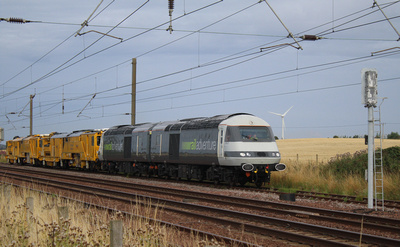
|
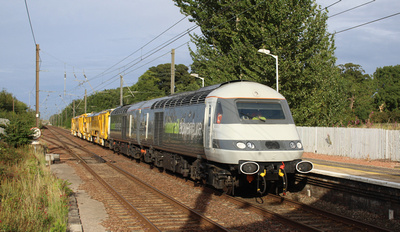
|
Scotrail Inter7city liveried 43132 and 43130 top and tail mark 3 set HA01 through North Queensferry with 1B84 13.56 Aberdeen - Edinburgh Waverley 7.8.23
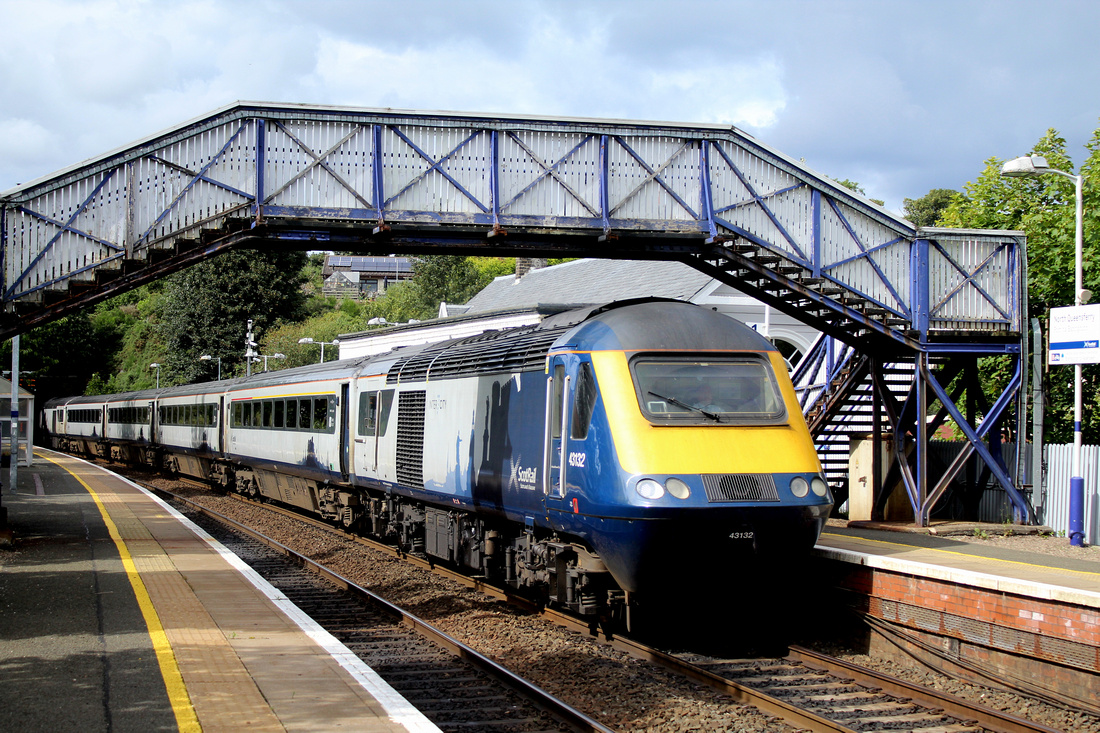
Europhoenix liveried 37884 is seen pushing Scotrail Saltire liveried 318250 out of Kilmarnock with 5Q08 Yoker - Kilmarnock Bonnyton Depot 31.7.23
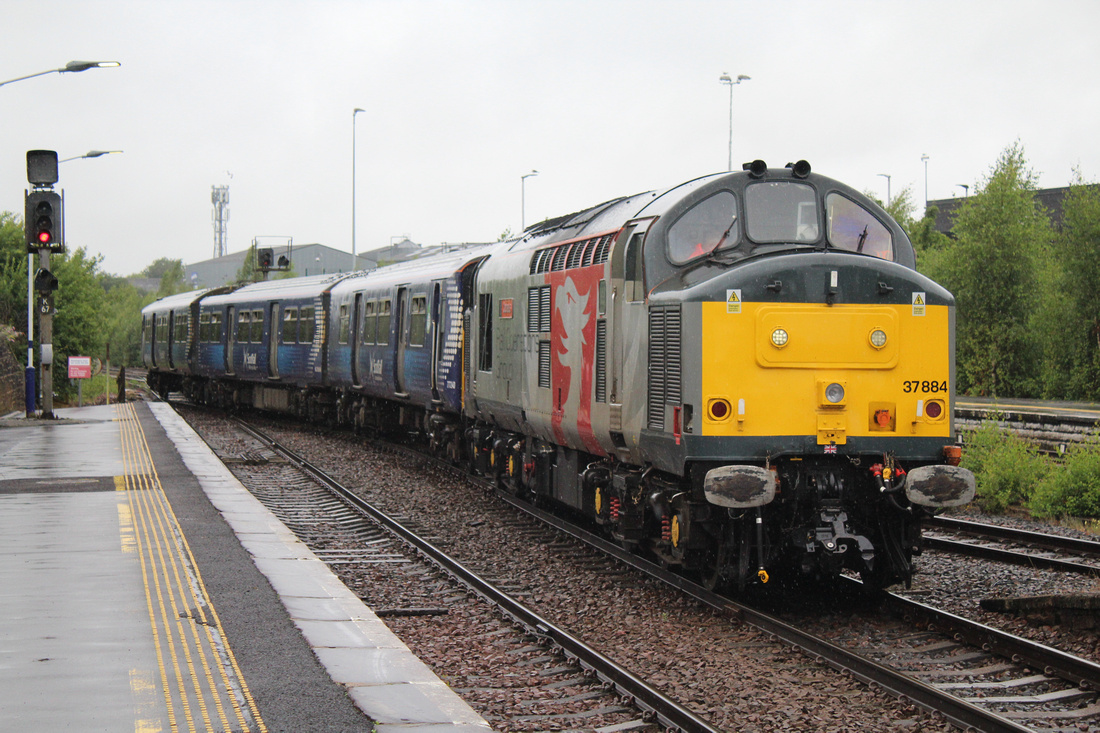
A selection of photos from my visit to the Isle of Wight on 13th July. More can be found at: https://scottishtrains.zenfolio.com/p830529663
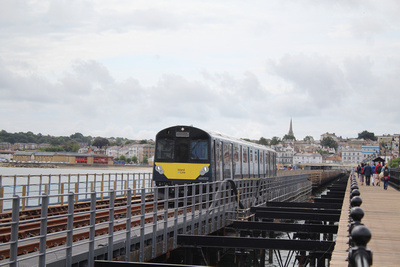
|
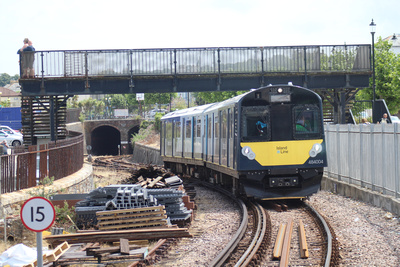
|
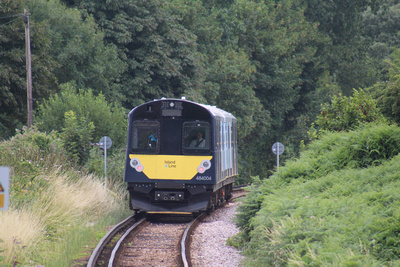
|
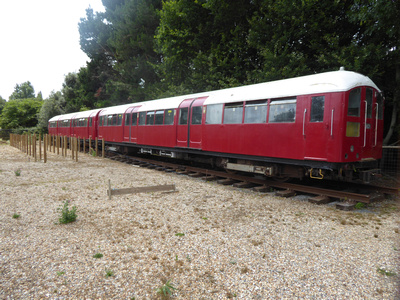
|
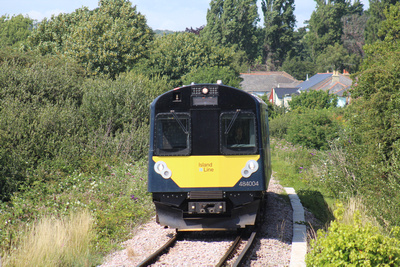
|
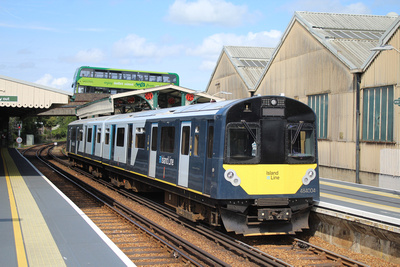
|
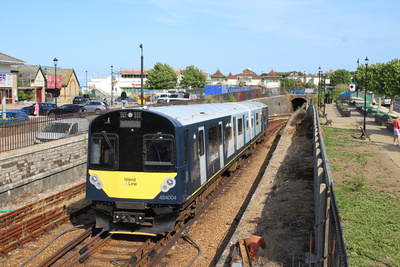
|
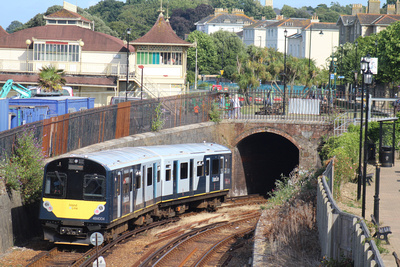
|

|
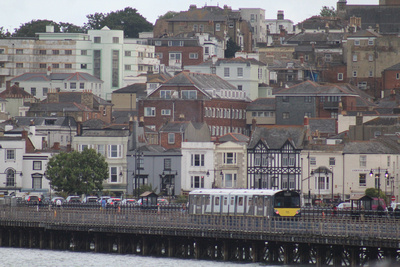
|
Awaiting their date with the scrapman, 313209, 204, 211 & 205 head lines of their sister units at Eastleigh Arlington 14.7.23
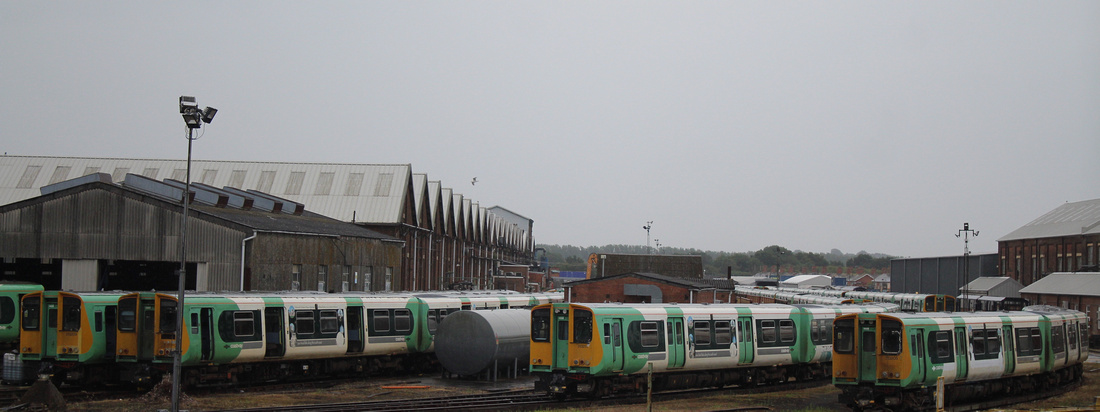
South Western Railway's 455865 is seen on the rear of an unidentified 455 as it departs Clapham Junction depot with an unidentified ECS working 12.7.23

Wearing an eyecatching overall wrap for Pride, a very colourful 378205 awaits departure from Clapham Junction with 2L21 10.23 service to Stratford 12.7.23
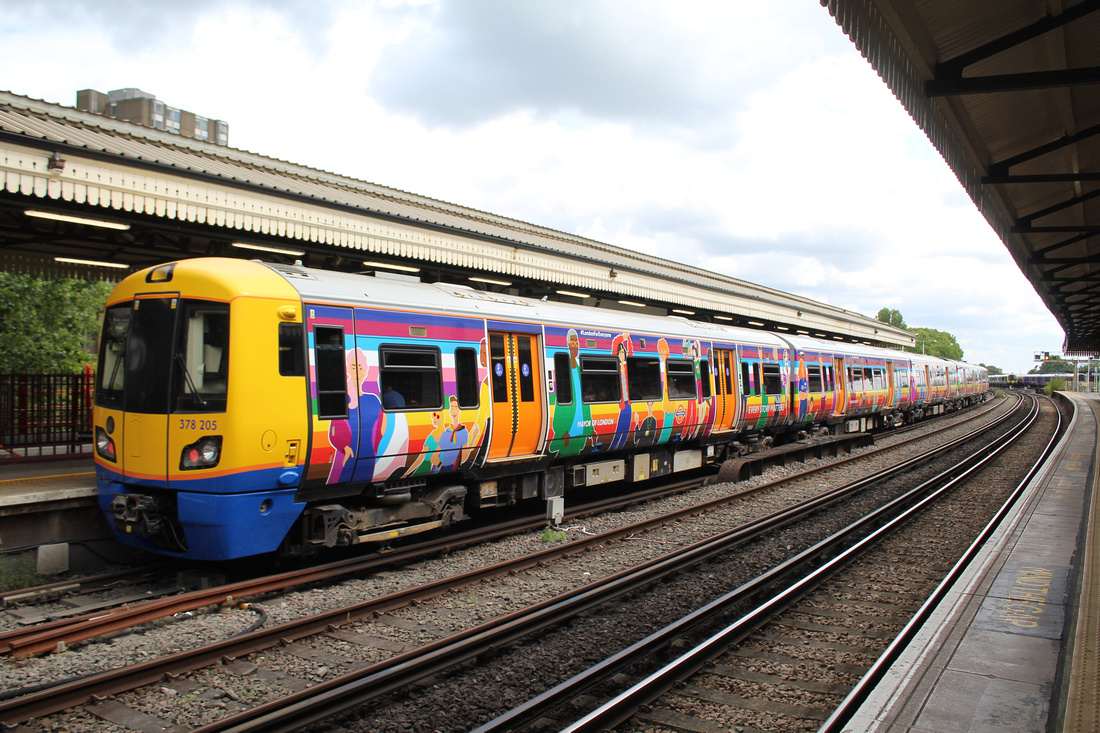
A selection of stored Class 313s awaiting scrapping at Eastleigh Arlington 313203, 204, 206, 207, 208, 209, 210, 212, 213, 215, 216, 217, 219 &220 on 11.7.23
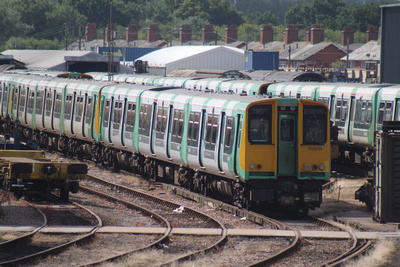
|
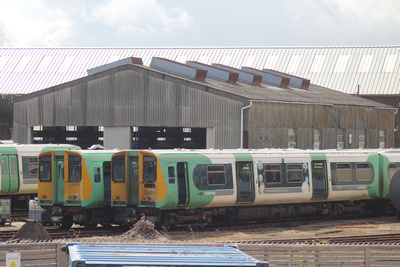
|
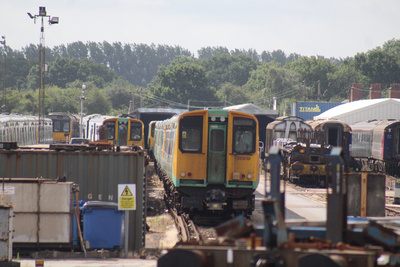
|
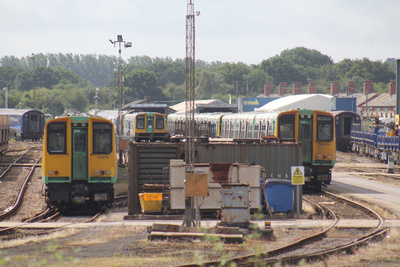
|
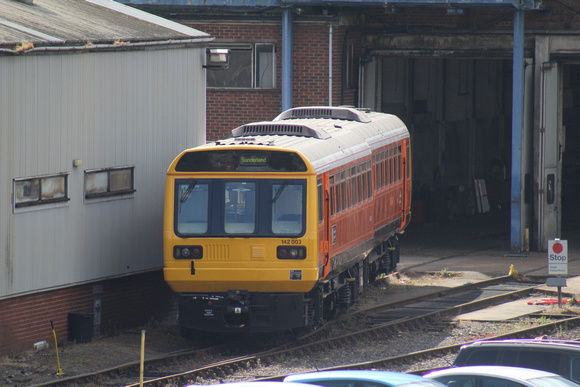 Greater Manchester PTE orange liveried 142003 is seen outside Eastleigh Arlington works 11.7.23
Greater Manchester PTE orange liveried 142003 is seen outside Eastleigh Arlington works 11.7.23
The end of the line for the Southern Class 313 fleet as 313211+313205, the final pair of class 313s to transfer from Hove to Eastleigh Works as 5Z03 for scrapping are seen arriving into Eastleigh for the final time. 11.7.23
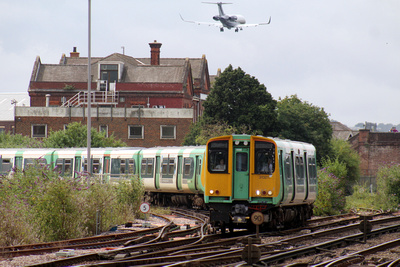
|
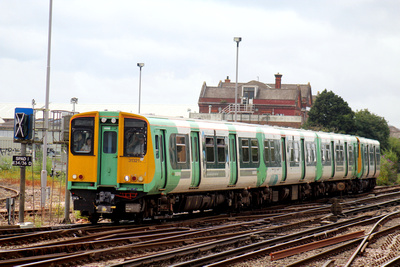
|
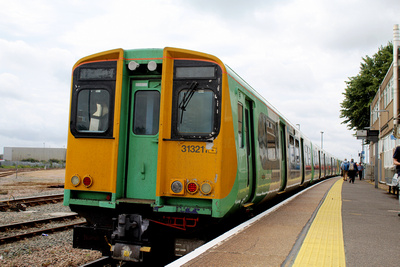
|
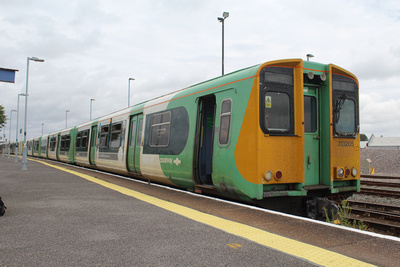
|
 On 4th July after getting a very reasonable last minute deal on thetrainline from Motherwell - Whatstandwell return, I visited Crich Tramway Village!
On 4th July after getting a very reasonable last minute deal on thetrainline from Motherwell - Whatstandwell return, I visited Crich Tramway Village!
Whatstandwell on the Nottingham - Matlock line is the station for Crich. It is 1 mile away from Crich, however it is a 30 minute walk up a very steep hill! I'd advise getting a taxi, however it is a 15 minute walk down hill on the return journey!
On arrival at Crich, I bought my ticket, which was £22 and gives you entry for a year. After leaving the ticket office, the path brings you out at the Bowes Lyon Bridge, where there is also a tram stop.
I decided to visit the museum building, which is close to the bridge and the Town End. There are many of the non running fleet in the museum ranging from horse trams to steam tram through to trams built or liveried in each of the decades up to the 1960s. A wander round and looking at the differing details of each of the different types of tram from the streamlined Balloon 712 and PCC tram, the reversed staircases of Lecister 76, to Blackpool's Conduit 4.
Directly opposite the Museum, is the depot fan complete with traverser. The sheds are open to allow you to wander up and down and have a look at each tram in the depot with the opportunity for some shots of the various trams at the front of the depot and if you're lucky, some of them may be out on the depot fan.
Next I visited the workshop viewing area, where the fantastic LCC1 'Bluebird' and Leeds 399 were under maintenance.
After this I spent the rest of the day riding up and down the line on board the 3 service trams out on the day: Glasgow 22, Sheffield 74 & London United Electric Tramways 159 or taking photos from different locations.
I had an absolutely fantastic day at Crich and would highly recommend a visit!
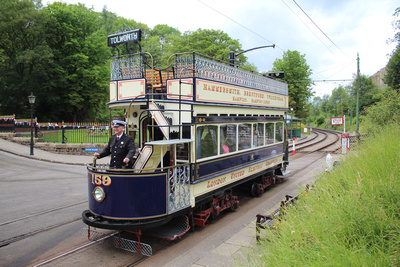
|
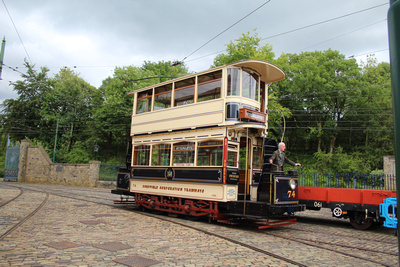
|
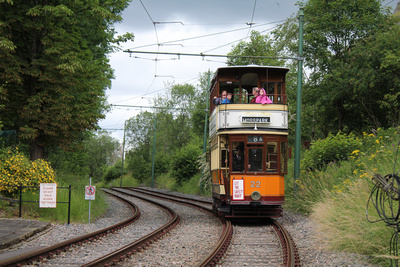
|
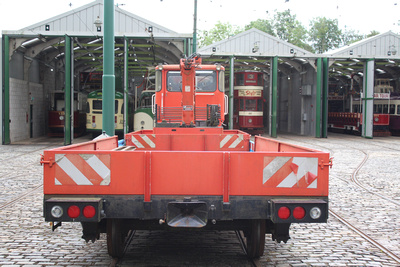
|
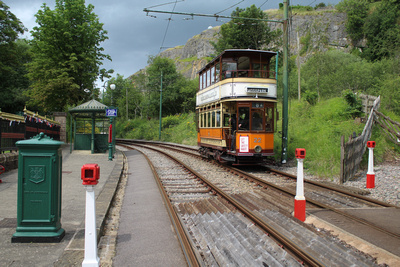
|
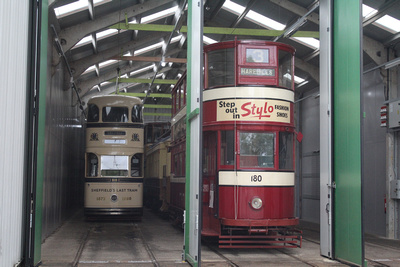
|
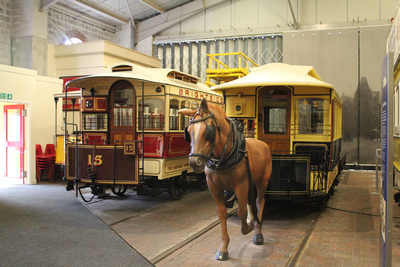
|

|
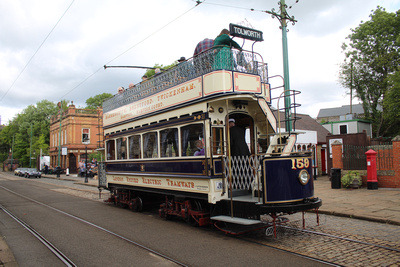
|
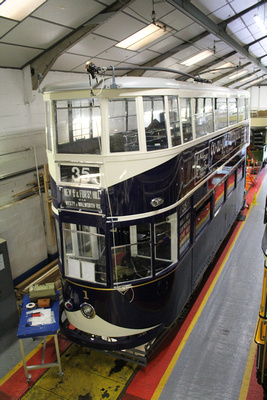
|
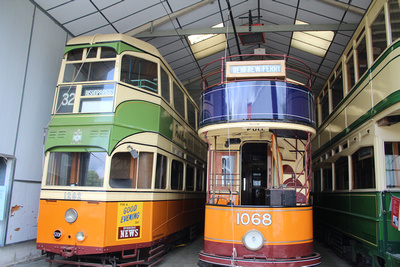
|
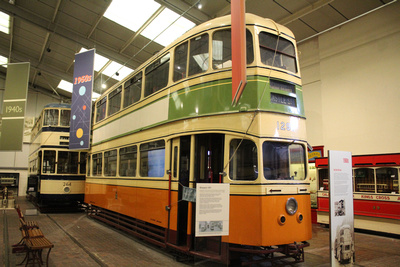
|
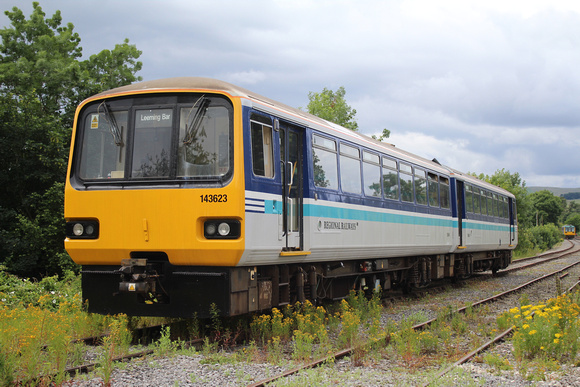 The Wensleydale Railway is based in North Yorkshire with its main station and depot located in Leeming Bar near Northallerton and handily located for the A1(M) motorway and not far from the A66 at Scotch Corner. Currently as I write this, they are running a service from Leeming Bar to Leyburn on Wednesdays, Fridays, Saturdays and Sundays with a shuttle service also running to Scruton from Leeming Bar on selected days. With the English school holidays being on throughout August, a service will also be running on Tuesdays. For more details on times and services visit their Website: https://wensleydale-railway.co.uk/running-days-2023/
The Wensleydale Railway is based in North Yorkshire with its main station and depot located in Leeming Bar near Northallerton and handily located for the A1(M) motorway and not far from the A66 at Scotch Corner. Currently as I write this, they are running a service from Leeming Bar to Leyburn on Wednesdays, Fridays, Saturdays and Sundays with a shuttle service also running to Scruton from Leeming Bar on selected days. With the English school holidays being on throughout August, a service will also be running on Tuesdays. For more details on times and services visit their Website: https://wensleydale-railway.co.uk/running-days-2023/
The Wensleydale Railway's line runs to Redmire at the west end and to Northallerton West at the east end of the line, however the line is only operational between Scruton and Leyburn for passenger services at the moment.
I visited on 5th July, and on this day debranded Northern liveried Pacer 142060 was operating the service. Before boarding I had a look round the station and some of the collection of rolling stock, which includes vehicle 51353 from set 117301, which has been converted to a community hub, former Tyne and Wear Metro shunter TW4, BR Dutch liveried 37250, class 14 D9523 and Class 121 Bubble Car 121032.
To see more of the collection of Pacers and assorted 1st Generation DMUs, you need to catch the train! I caught the 11.30 service formed of 142060 and on leaving Leeming Bar, saw 142087, 142090 & 142018 as well as some of the 1st Gen DMUs and EWS liveried 44785. It was a nice run taking 42 minutes to Leyburn and passing 144020, 142028 & 142035 stored in a passing loop further up the line. At Leyburn, there is cafe facilities and a gift shop and with 25 minutes before the return journey, there is enough time to visit both. The return journey departed Leyburn around 12.30 and was soon back at Leeming Bar.
Once back, one of the volunteers let me have a look at LEV1, the railbus that became one of the pacer prototypes, which was located in their shed. He mentioned that Regional Railways liveried 143623 was up at Redmire, where filming was taking place for the new series of Vera, so I decided to drive up there and get some photos of the unit, which is looking superb!
I then drove back to Leeming Bar for some more photos, stopping off enroute at Leyburn for some photos of 142060, then headed back home. I would recommend Wensleydale Railway for a visit, the staff and volunteers are all friendly and welcoming and the ticket prices are good value for money.
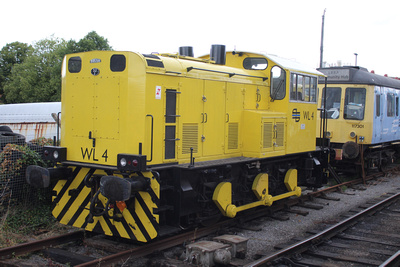
|
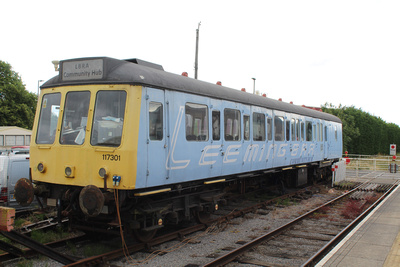
|
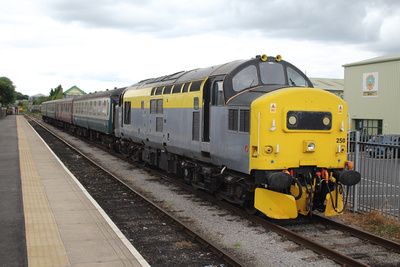
|

|
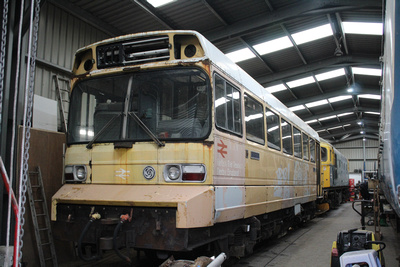
|
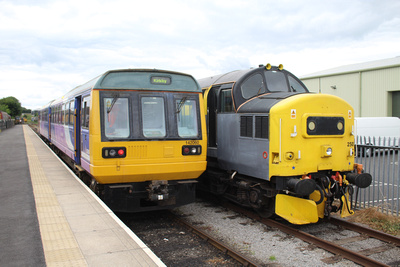
|
 Having opened on 7th June, the extension of the Edinburgh Tramway appears to have been very popular both with passengers and enthusiasts.
Having opened on 7th June, the extension of the Edinburgh Tramway appears to have been very popular both with passengers and enthusiasts.
Stretching 3 miles from York Place to Newhaven, there are 8 stops enroute. At York Place, the former single track and terminus platform has been removed and a new stop has been built at Picardy place complete with 2 platforms, in the middle of a large traffic island at the top of Leith Walk and opposite the Omni Centre.
The line continues down Leith Walk on a central reservation with island platform stops at McDonald Road (Opposite Harburn Hobbies) and Balfour Street (with a crossover installed). There is a double platformed stop at Foot of the Walk, which owing to the narrow nature of the street, takes up the full width of the street with the platforms doubling as the pavement.
From here the tramway moves onto Constitution Street, towards Leith Town Hall and the Burns Statue at The Shore Tram Stop. The Shore is located at the junction of Bernard Street with the tramway sharing the roadway with general road traffic for the full length of Constitution Street. The tramway continues on towards Ocean Way, continuing to share with road traffic on sections of it before taking a 90 degree turn onto Ocean Drive and into the island platform of Port of Leith tram stop.
Departing Port of Leith, the line continues along Leith Harbour sharing the roadway with general traffic and passing the Fingal floating 5 star hotel and restaurant and the Victoria Swing Bridge, before taking a 90 degree turn outside the Ocean Terminal Shopping Centre onto a central reservation for the remainder of the journey. Ocen Terminal tram stop features an island tram stop with crossover outside and it is opposite the Shopping Centre. It is possible visit the Royal Yacht Britannia or to catch the tour buses or normal service buses back up to the city centre at Ocean Terminal. From here the line takes a 90 degrees turn to the right onto Melrose Drive passing many harbourside warehouses and businesses as well as a flour mill. The line then reaches a scissors crossover which allows the trams to switch to a free platform at Newhaven. The line curves here into the 2 outer platforms of Newhaven. Beyond the platform, there is enough room for 2 trams to stable until needed.
Photo Locations
There are many nice locations for photographs of the tramway particularly on Ocean Way (between The Shore and Port of Leith) and Ocean Drive (between Port of Leith and Ocean Terminal), here are a few of the best spots for photos:
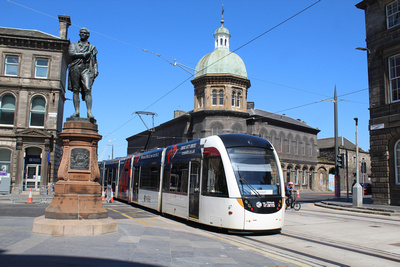
|
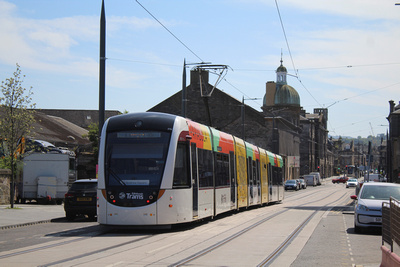
|
| 'The Shore' tram stop at Bernard Street with the Burns Statue to the left and the domed building behind. | Ocean Way near to Port of Leith looking towards The Shore tram stop in the distance. |
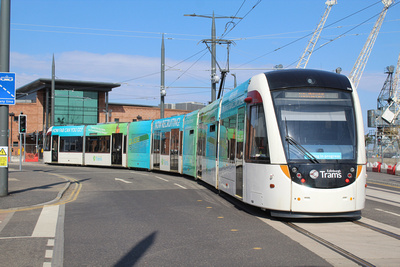
|
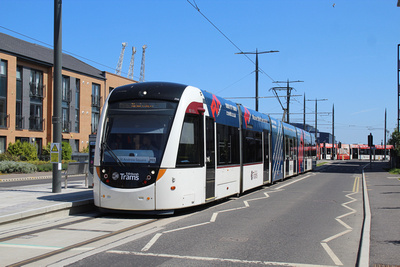
|
| 90 degree curve from Ocean Way to Ocean Drive. Port of Leith tram stop is to the left out of shot. | Port of Leith tram stop looking eastwards |
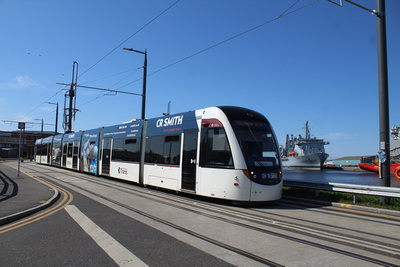
|
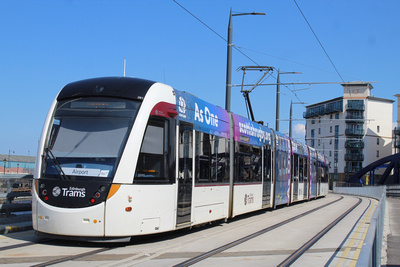
|
| Ocean Drive with RFA Fort Victoria in the Docks in the rear of the image | Ocean Drive |
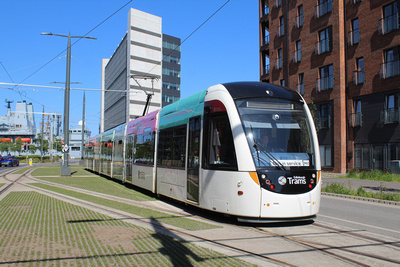
|
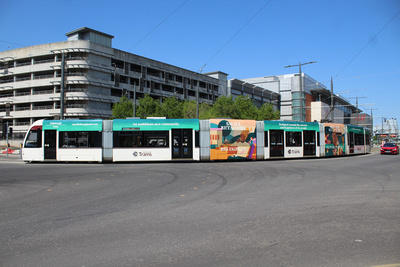
|
| Ocean Terminal | Leaving Ocean Terminal and heading onto Melrose Drive |
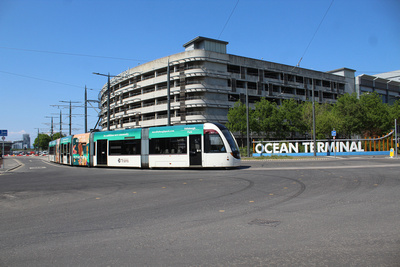
|
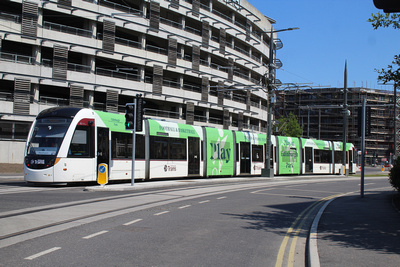
|
| Leaving Ocean Terminal and heading onto Melrose Drive | Passing Ocean Terminal Car Park |
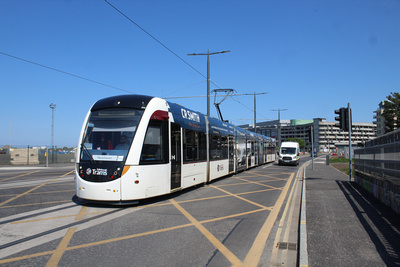
|
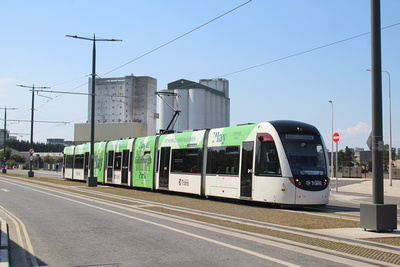
|
| Melrose Drive with Ocean Terminal in the background | Melrose Drive with the Flour Mill in the background |
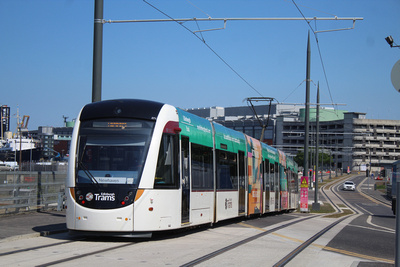
|
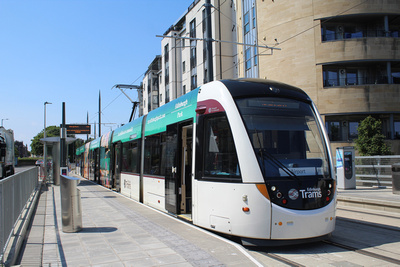
|
| Melrose Drive approaching Newhaven | The terminus at Newhaven |
Since the last post about McGill's Scotland East back in January, there has been a massive change to the fleet with an influx of buses from their Scotland West franchise owing to a large influx of Yutong Electric buses out west. This has seen Mercedes Benz Mellor Stratas, Citaros, AD Enviro 200s, some AD Enviro 200MMCs move west with ex London enviro 400s also entering service. This has seen the near total withdrawal of the B7RLE Wright Urbans and the Scania Omnidekkas with very few remaining in service. Also the relivery of some buses has begun, with some Citaros and Streetlites treated to an updated version of the Midland Bluebird or Eastern Scottish livery.
The changes made include:
- 1 x Mercedes Benz Mellor Strata transferred east (0117)
- The withdrawal of the 4x BMC Probus / Falcons (0300 - 0303)
- 49 out of 74 Wright Streetlite DF buses remaining in service, 2 of which are in the new livery (0405-0479)
- 2x Wright Streetlite SF (Numbered 0480-0481 and Transferred from Xplore Dundee)
- 6x Volvo Plaxton Profiles (Numbered 0600-0605, 3 remaining in service)
- 16x Scania Wright Solars (Numbered 1601-1616, all withdrawn from service)
- 3 out of 22 Scania Omnidekkas remaining in service (Numbered 1811, 1814 & 1818)
- 1 x Volvo Wright Renown (Numbered 2200, training bus)
- 10 x Volvo B7RLE Wright Eclipse 2 (Numbered 2230 - 2239, 6 in Midland Bluebird v 1 livery, 4 in McGill's livery, transferred from McGills West of Scotland)
- 2 our of 66x Volvo B7RLE Wright Eclipse Urbans remaining in service 2297 & 2303 (Numbered 2240 - 2346)
- 5 of 7x Volvo B7TL Wright Eclipse Gemini in service (2808-2811 & 2817) (Numbered 2807-2811, 2817-2818, transferred from Xplore Dundee)
- 1x Volvo B7TL Alexander ALX400 (Numbered 2844, withdrawn training bus)
- 2x Volvo B7TL Plaxton President (Numbered 2845-2846, both withdrawn)
- 12 our of 21x Volvo B7TL Wright Eclipse Gemini remain in service (Numbered 2847-2867)
- 4 x Volvo B9TL Wright Eclipse Gemini (Numbered 2900-2903)
- 9 x Citaro in service (3331, 3332, 3356-3358, 3360-3363)
- 17 out of 19x Alexander Dennis Enviro 200MMC (Numbered 4101-4108 (McGills livery) & 4111-4121(Xplore Dundee)), 4111 & 4118 withdrawn
- 9 x Wright Pulsar 2 withdrawn (Numbered 6001-6009)
- 26x Enviro 200 (All in McGills livery 8001-8008, 8013-8018, 8023-8026, 8038-8041, 8043-8044, 8048 )
- 1 of 6 x Alexander Dennis Enviro 200 in service (8055) (numbered 8050 - 8055)
- 11 of 20 x Alexander Dennis Enviro 300 in service (numbered 8475 - 8496 and transferred from Larbert / Bannockburn - Livingston)
- 12 x Alexander Dennis Enviro 400 (numbered 8924-8935 , Bright bus tours open toppers)
- 15 x Alexander Dennis Enviro 400MMC (numbered 8936-8951 all now based at Larbert / Bannockburn)
- 12 x Alexander Dennis Enviro 400 ( 8961-8974)
- 8 x mix of buses for Bright bus tours (numbered 9901-9908)
The images below show some of the new influx of buses and some of the new liveries to be seen in and around the East Scotland area.
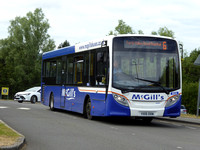
|
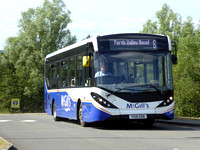
|
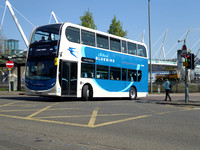
|
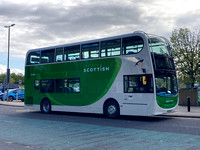
|
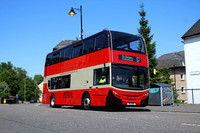
|
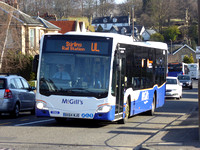
|
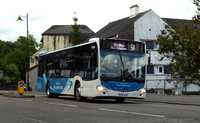
|
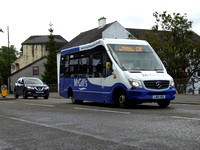
|
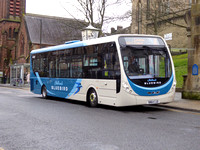
|
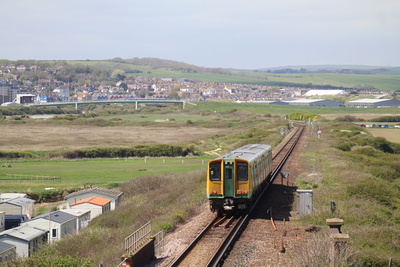 I decided to make the most of an extended weekend off and fly to Gatwick then on to Brighton for a final day out on the Class 313s on the Southern Coastway routes.
I decided to make the most of an extended weekend off and fly to Gatwick then on to Brighton for a final day out on the Class 313s on the Southern Coastway routes.
With the flight arriving early, I was soon on board a class 700 heading into Brighton and passing Lover's Walk, 313209, 313216, 313208 & 313201 were stabled outside the sheds, the latter pair having already been withdrawn with 201 out of hours and 208 with camshaft issues.
On arrival at Brighton, I discovered that the West Coastway services were disrupted due to a broken rail beyond Barnham with all services terminating at Barnham or Bognor Regis. 313205 was waiting to depart with a Bognor service so I managed to get a few photos of it. I then caught a service out to Hove, where I photographed 313203 & 313206 stabled in the sidings there, then caught the shuttle back to Brighton. I was left kicking myself as if I'd waited a further 30 mins, I would have seen 201& 208 move there with 203 & 206 returning to Lovers Walk.
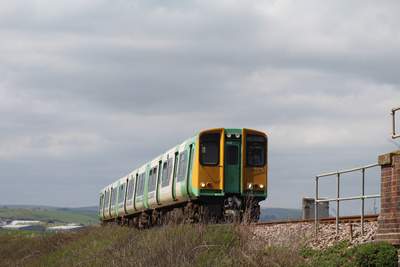 After heading back to Brighton, I decided to stick to the East Coastway line to Seaford due to the disruption out west. East Coastway out to Seaford featured 3 class 313s in service: 313215, 313219 & 313220. I caught 313215 out to Bishopstone, which is a lovely station and location, photoing 313215 departing eastward to Seaford then when it returned, departing westward, with the classic shot looking westwards towards Newhaven. 313219 was next up the branch and I decided to head down the entrance ramp to the station to photo it approaching the station on the embankment. I caught 313219 on it's return journey and got off at Lewes for some lunch and to photo some of the passing units. I then got back on 313215 and headed to Moulsecoombe for some more photos, then caught 313219 back to Brighton, where I spent the final hour photoing more units before heading back to Gatwick for the flight back to Edinburgh.
After heading back to Brighton, I decided to stick to the East Coastway line to Seaford due to the disruption out west. East Coastway out to Seaford featured 3 class 313s in service: 313215, 313219 & 313220. I caught 313215 out to Bishopstone, which is a lovely station and location, photoing 313215 departing eastward to Seaford then when it returned, departing westward, with the classic shot looking westwards towards Newhaven. 313219 was next up the branch and I decided to head down the entrance ramp to the station to photo it approaching the station on the embankment. I caught 313219 on it's return journey and got off at Lewes for some lunch and to photo some of the passing units. I then got back on 313215 and headed to Moulsecoombe for some more photos, then caught 313219 back to Brighton, where I spent the final hour photoing more units before heading back to Gatwick for the flight back to Edinburgh.
The status of the class 313s at this point was:
Available for service: 313203, 204, 205, 206, 207, 209, 210, 211, 212, 213, 215, 216, 219 & 220
Withdrawn: 313201 & 313208
Stored at Eastleigh awaiting scrapping: 313202, 214, & 217
Saturday 20th May
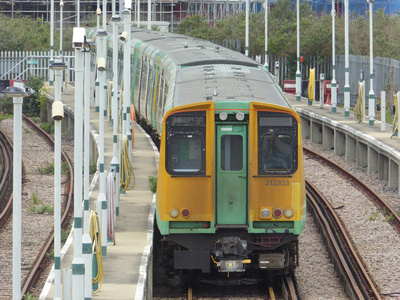 I had booked to go back to Brighton on 20th May as it was initially supposed to be the final day in service for the class 313s, however due to strike action during the previous week and a ban on overtime working leading to a vastly reduced and curtailed timetable, the 313s were withdrawn a day early. Photos from the day of the 313s were limited to 313213 & 313219 stabled outside Lover's Walk and 313204, 205, 207, 209, 211, 215, 216 & 220 stabled in 2 lines of 4 at Hove.
I had booked to go back to Brighton on 20th May as it was initially supposed to be the final day in service for the class 313s, however due to strike action during the previous week and a ban on overtime working leading to a vastly reduced and curtailed timetable, the 313s were withdrawn a day early. Photos from the day of the 313s were limited to 313213 & 313219 stabled outside Lover's Walk and 313204, 205, 207, 209, 211, 215, 216 & 220 stabled in 2 lines of 4 at Hove.
More photos from Brighton and the Class 313s can be found at: https://scottishtrains.zenfolio.com/p86303780
 One of the most interesting bus operators in Central Scotland at the moment is McGill Scotland East. McGill took over operation of the Former First Scotland East franchise in September 2022, inheriting 257 buses in the process. By purchasing the Scotland East Franchise, McGill extended their reach as they already own McGills Scotland West, which is mainly based in the Inverclyde and Renfrewshire and Xplore Dundee, which covers the Dundee City area.
One of the most interesting bus operators in Central Scotland at the moment is McGill Scotland East. McGill took over operation of the Former First Scotland East franchise in September 2022, inheriting 257 buses in the process. By purchasing the Scotland East Franchise, McGill extended their reach as they already own McGills Scotland West, which is mainly based in the Inverclyde and Renfrewshire and Xplore Dundee, which covers the Dundee City area.
Routes and Depots
McGill Scotland East is split into 2 areas: Midland Bluebird and Eastern Scottish, both reviving heritage names and heritage liveries. Midland Bluebird is based at 3 depots: Larbert, Bannockburn and Balfron with Eastern Scottish being based at Livingston.
Livingston depot covers routes in West Lothian and Edinburgh, heading to places such as Shotts (North Lanarkshire), Fauldhouse, Whitburn, Blackridge, Armadale, Bathgate, Linlithgow, Balerno, Queensferry, Kirkliston and Deans
Larbert depot mainly covers routes around the Falkirk area to destinations such as Maddiston, Dunnipace, Bo'ness, Larbert, Grangemouth, Fankerton, Hallglen, Langlees, Forth Valley Hospital, Camelon, Denny, Slamannan, Edinburgh and Glasgow (via Cumbernauld).
Balfron depot mainly covers routes between Stirling and Glasgow via Balfron and Kippen or via Aberfoyle and Milngavie.
Bannockburn depot mainly covers routes around the Stirling area to destinations such as Cambusbarron, Callander, Alloa, Clackmannan, Cowie, Stirling University, St Ninnians, Raploch and Glasgow via Cumbernauld.
The fleet
As mentioned before, McGill inherited 257 buses of various types from First, including the Bright Bus tours operation in Edinburgh. On taking over, McGills had to withdraw 120 of the inherited fleet as they were deemed unsuitable for service. Some of the fleet were returned to service after repairs, however a number of them were replaced by buses from the reserve and withdrawn fleets from the West of Scotland and Xplore Dundee operations.
The current fleet includes:
- 4x BMC ProBus / Falcons (Numbered 0300-0303, only 1 remaining in service)
- 74x Wright Streetlite DF (Numbered 0405-0479)
- 2x Wright Streetlite SF (Numbered 0480-0481 and Transferred from Xplore Dundee)
- 6x Volvo Plaxton Profiles (Numbered 0600-0605, 3 remaining in service)
- 16x Scania Wright Solars (Numbered 1601-1616, all withdrawn from service)
- 22x Scania Omnidekkas (Numbered 1800 - 1820 plus one that hasn't been renumbered, 9 remaining in service)
- 1 x Volvo Wright Renown (Numbered 2200, training bus)
- 6 x Volvo B7RLE Wright Eclipse 2 (Numbered 2234 - 2239, 4 in service in new Midland Bluebird livery, 2 still to enter service, transferred from McGills West of Scotland)
- 66x Volvo B7RLE Wright Eclipse (Numbered 2240 - 2346)
- 7x Volvo B7TL Wright Eclipse Gemini (Numbered 2807-2811, 2817-2818, transferred from Xplore Dundee)
- 1x Volvo B7TL Alexander ALX400 (Numbered 2844, withdrawn training bus)
- 2x Volvo B7TL Plaxton President (Numbered 2845-2846, both withdrawn)
- 21x Volvo B7TL Wright Eclipse Gemini (Numbered 2847-2867)
- 4 x Volvo B9TL Wright Eclipse Gemini (Numbered 2900-2903)
- 11x Alexander Dennis Enviro 200MMC (Numbered 4111-4121)
- 9 x Wright Pulsar 2 (Numbered 6001-6009, 3 in service, 6 still to enter service, being painted a mix of Midland Bluebird and Eastern Scottish liverys, transferred from McGill's West of Scotland)
- 6 x Alexander Dennis Enviro 200 (numbered 8050 - 8055)
- 20 x Alexander Dennis Enviro 300 (numbered 8475 - 8496)
- 12 x Alexander Dennis Enviro 400 (numbered 8924-8935 , Bright bus tours open toppers)
- 15 x Alexander Dennis Enviro 400MMC (numbered 8936-8951)
- 8 x mix of buses for Bright bus tours (numbered 9901-9908)
Liveries
With it being early days in the new franchise and with buses having to be transferred in from other areas, there are a real mix of liveries on the fleet at the moment including
- First Barbie
- First 2012
- First Urban (Midland, West Lothian and plain)
- 2 toned blue
- Midland Bluebird Retro
- Midland Scottish Retro
- Xplore Dundee Green (Streelite SFs, Enviro 200MMC and some ex Xplore Dundee Geminis)
- Debranded National Express Dundee Red and White (some ex Xplore Dundee Geminis)
- New Midland Bluebird Blue and Cream
- New Eastern Scottish Green and Cream
There are also various buses with route branding on them.
With the many bus types and liveries, McGills Scotland East are an interesting company to follow and ride on at the moment! It is best to take the opportunity to do this just now before the inevitable newer, more uniform buses come along and more of the new livery is seen!
Some examples of the current liveries are shown below, more can be found at: https://scottishtrains.zenfolio.com/p1057977495
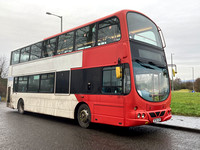
|
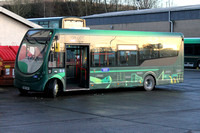
|
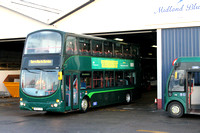
|

|
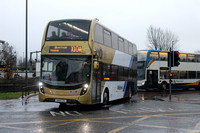
|
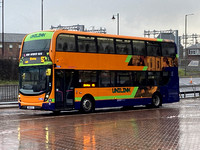
|
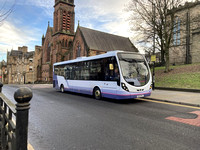
|
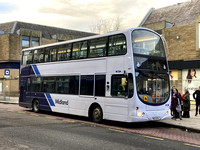
|
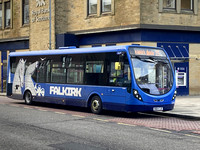
|
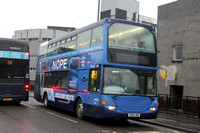
|

|
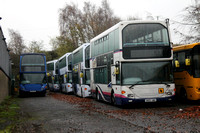
|
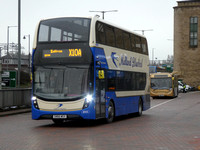
|
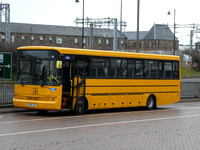
|
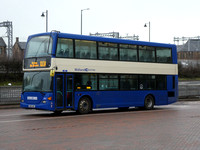
|
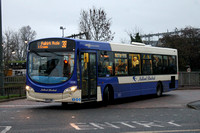
|
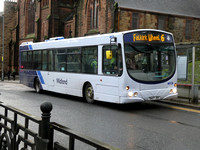
|
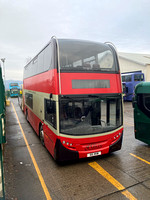
|
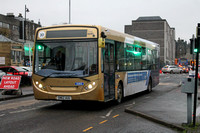
|
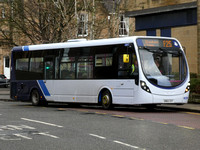
|
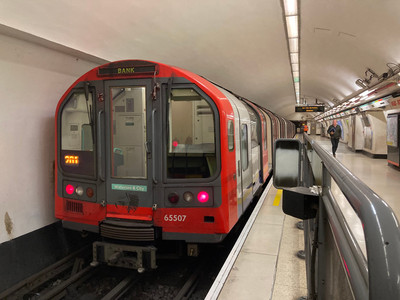 As part of my trip to the South Coast, I wanted to combine my trip to see / ride on a class 315 with a day out on the London Underground network, having not been on it since 2016.
As part of my trip to the South Coast, I wanted to combine my trip to see / ride on a class 315 with a day out on the London Underground network, having not been on it since 2016.
Arriving at London Waterloo at 9.15am, my first port of call was to buy an all zones day ticket, before making my way down to the Waterloo and City station for the short journey to Bank on board the 92 stock. As there was already a train in the station, I didn't get the opportunity to photo one in the turnback siding and another in depot.
At Bank, I found my way via the many cavenous passageways and escalators to finally make it to the Central Line platforms, where I caught an Eastbound Epping service as far as Woodford. I'd wanted to catch the 1962 stock Central line Rail Adhesive Train (or RAT for short), however unfortunately it did not run. After spending some time photing the comings and goings of the 92 stock at Woodford, I caught another 1992 stock train up to Epping, where I walked down to the bottom end of the car park for a look at the former London Underground Shunting Loco L11, which was built by joining the cab ends from 1931 built standard stock cars 3080 and 3109 together. It is part of the Epping Museum, who are also restoring the former Epping signal cabin, which is located next to L11. More info about Epping Museum can be found at: https://www.eppingmuseum.com/home
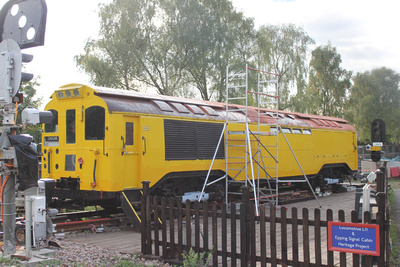 Next I returned to Epping station but before I got on the train, I had a lovely roll and sausage from the van outside! I'd thoroughly reccomend it! I then got back on the train, and had planned on going to Holborn to change to the Picadilly Line, however on arrival at Stratford, our train was held due to a signalling issue further up the line, so I got off there for some air and spotted a pair of class 315s working an ECS movement. I caught a class 345 Elizabeth line train to Liverpool Street and resumed my Central line journey from there to Holborn. There I changed onto the Picadilly line and some 1973 stock for the short 3 stop journey to Piccadilly Circus.
Next I returned to Epping station but before I got on the train, I had a lovely roll and sausage from the van outside! I'd thoroughly reccomend it! I then got back on the train, and had planned on going to Holborn to change to the Picadilly Line, however on arrival at Stratford, our train was held due to a signalling issue further up the line, so I got off there for some air and spotted a pair of class 315s working an ECS movement. I caught a class 345 Elizabeth line train to Liverpool Street and resumed my Central line journey from there to Holborn. There I changed onto the Picadilly line and some 1973 stock for the short 3 stop journey to Piccadilly Circus.
My impressions of the 92 stock were that they were rather tired inside, with worn moquette, grafitti all over the interiors and generally in need of a deep clean and a refurb. The 73 stock in comparison was in excellent condition, very clean looking and had real character.
At Picadilly Circus, I changed over to the Bakerloo line to sample some 72 stock. Heading westbound, I travelled out to Queen's Park, where the Bakerloo line goes from deep tube up to above ground and runs alongside the Overground lines out to Watford Junction as far as Harrow and Wealdstone and the WCML.
Queens Park is a decent place to catch the 72 stock, with its overall roof, the steep incline out of the tunnel at the East End and the uniqueness of the main lines and turnback sidings actually passing through and doubling as part of the
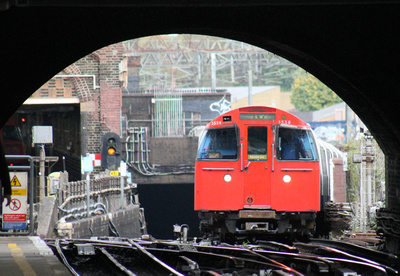 depot! I spent about 45 minutes here photoing the 1972 stock, which although it looks quite shabby and in need of a repaint and overhaul, like most older stock it has alot of character both inside and out (a blog post about the Bakerloo 72 stock will be coming soon).
depot! I spent about 45 minutes here photoing the 1972 stock, which although it looks quite shabby and in need of a repaint and overhaul, like most older stock it has alot of character both inside and out (a blog post about the Bakerloo 72 stock will be coming soon).
After I left Queen's Park, I headed back via 72 stock to Waterloo, where I changed from the Bakerloo to the Jubilee line. I then headed east on the 1996 stock to Stratford, where after a few photos I headed off to catch the peak class 315 working at Shenfield. After riding on the 315s I headed back to Stratford, where after more photos, I caught a Central line train to Bank, then changed for the Waterloo and City line back to Waterloo for the train back to my hotel at Eastleigh.
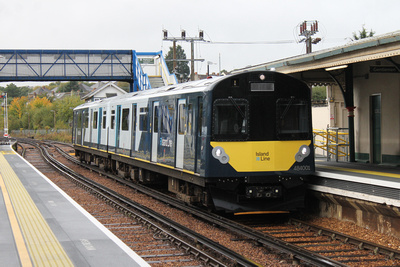 As part of my trip to the South Coast in October, I decided to return to the Isle of Wight so on Thursday 13th October, I made my way from my hotel in Eastleigh by train to Portsmouth and Southsea, where due to a slight delay on my train, I'd unfortunately missed the bus to the Hoverport by 2 minutes. After a very quick taxi ride to the Hoverport at Southsea, I joined the queue for the crossing over to the island.
As part of my trip to the South Coast in October, I decided to return to the Isle of Wight so on Thursday 13th October, I made my way from my hotel in Eastleigh by train to Portsmouth and Southsea, where due to a slight delay on my train, I'd unfortunately missed the bus to the Hoverport by 2 minutes. After a very quick taxi ride to the Hoverport at Southsea, I joined the queue for the crossing over to the island.
The journey by Hovercraft over the Solent to Ryde was very swift and comfortable, reaching Ryde in 7 minutes and luckily, Loganair had a 30% off voucher code when booking flight tickets so the journey was a good deal cheaper than normal. On arrival at Ryde, I made my way to Ryde Esplanade station to catch the Island Line train out to the IOW steam railway. Unfortunately due to a bridge strike, the trains were cancelled for at least an hour, however there was a replacement mini bus running.
I took the mini bus up to Ryde St Johns and visited the Bus Museum. The bus museum was interesting to see with plenty of different types of bus and plenty of historical displays showing the history of Southern Vectis on the island and is less than 5 minutes walk from Ryde St Johns and is on some of the bus routes.
After I had visited the museum, I walked back to Ryde St Johns and by this time, they were getting ready to resume the train service, with 484001 arriving from the Shankin direction, 002 was stabled in platform 3, 004 and 005 were stabled in the yard and 003 was in the maintenance sheds. 001 was then reversed back out of platform 1, crossed over and entered platform 2 where the service was resumed heading towards Shanklin. I got off at Smallbrook Junction and crossed over to the IOW Steam Railway. Smallbrook Junction is a small halt that is only accessible by rail and as such is only open with the steam railway is open. It only has basic facilities but that does include a waiting room, so with around 30 minutes to wait on the steam train coming, I sat and read my Kindle so the time passed quite fast!
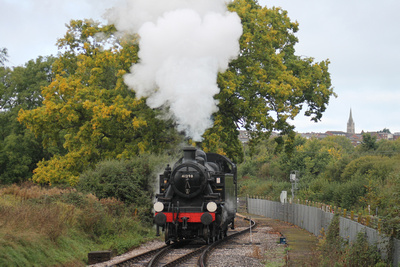 All too soon, British Railways Black liveried Ivatt 2MT 41298 arrived with a rake of beautifully restored Southern 4 wheeler compartment stock. The interior of the carriages was of an excellent quality with the period notices and adverts really adding to the experience as did the very comfy deep sprung seating in the compartment. It is a lovely scenic journey through the Wight countryside up to Wooton with the train passing through Havenstreet non stop heading up the line. After a 10 minute turn around at Wooton, the train returned eastwards to Havenstreet, the main hub of the railway.
All too soon, British Railways Black liveried Ivatt 2MT 41298 arrived with a rake of beautifully restored Southern 4 wheeler compartment stock. The interior of the carriages was of an excellent quality with the period notices and adverts really adding to the experience as did the very comfy deep sprung seating in the compartment. It is a lovely scenic journey through the Wight countryside up to Wooton with the train passing through Havenstreet non stop heading up the line. After a 10 minute turn around at Wooton, the train returned eastwards to Havenstreet, the main hub of the railway.
Having a bit more time to spend at Havenstreet this time (only had 10 -15 minutes last time), spent some time looking round the shop, the carriage workshops where there were a couple of 4 wheeler coaches in for restoration, then up to Train Story, where I spent an hour wandering round taking photos. Of particular interest to me were the old Ryde Pier trams and Island line liveried 483007, which I had a good look around! I then went back outside to watch British Railways Green with wasp stripe ends liveried D2059 'Edward' shunting Southern liveried 'O2' class W24 'Calbourne' into a different siding in the yard. I then went over to the cafe at the other side of the line to have some lunch. At this point the sun came out and despite it being October, it was actually really warm so I sat out in the sun while I waited on the train back to Havenstreet.
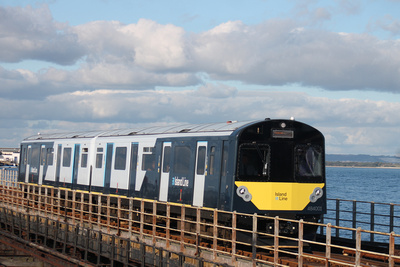 Once at Havenstreet, again having travelled back there onboard 41298, I boarded 484001 and headed up to Shanklin, then on the next working back to Ryde Esplanade. I then walked along the Pier to photo 484001 heading back towards the Esplanade then walked round to the footbridge to photo 484002 arriving with the peak time working from Shanklin, then walking round to the tunnel mouth to catch 002 departing again.
Once at Havenstreet, again having travelled back there onboard 41298, I boarded 484001 and headed up to Shanklin, then on the next working back to Ryde Esplanade. I then walked along the Pier to photo 484001 heading back towards the Esplanade then walked round to the footbridge to photo 484002 arriving with the peak time working from Shanklin, then walking round to the tunnel mouth to catch 002 departing again.
I then decided to catch a bus to see a bit more of the island so I caught the service 3 bus out as far as Ventnor, which was definately worthwhile for the absolutely stunning views of the coastline south of Shanklin! Unfortunately due to timing, I had to get off one bus and catch another straight back but this time I got off at Brading and walked back to the station to photo it and to catch the cross over of the 2 units there. I caught 001 out to the Pier Head for some final photos there before it closes for refurbishment, then back to Esplanade. Finally in the darkness, I caught some photos of 002 at Esplande station from the footbridge as I made my way back for the 7pm hovercraft back to Southsea, then the Hoverbus back to Portsmouth Harbour for my return journey back to the hotel in Eastleigh!
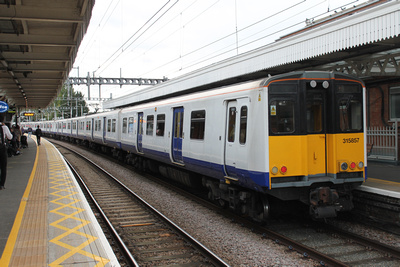 As part of my trip to the South Coast during the October Holidays, I decided to spend the day in London. Most of the trip was spent exploring the Underground, (more about this in a future blog post), however I also took the advantage of the opportunity to sample a ride on a class 315 for the first and probably the last time.
As part of my trip to the South Coast during the October Holidays, I decided to spend the day in London. Most of the trip was spent exploring the Underground, (more about this in a future blog post), however I also took the advantage of the opportunity to sample a ride on a class 315 for the first and probably the last time.
The class 315 is the newest of the PEP family, having been brought into service in 1980. Being powered by the OHLE, the 315 is essentially a four car version of the much missed 1979 build class 314 which ran on the Argyle lines and laterly the Cathcart Circle, Newton and Neilston lines. With a seating capacity of 309 (plus 7 tip up seats), the 315 is formed of 2 outer DMSO vehicles, containing the motors and drivers cabs, with a PTSO, containing the Pantograph and TSO (trailer) in the centre. In their heyday, they could be formed up into 12 car formation, but now they are formed into 8 car formation from 2 sets. Originally 61 sets were built, however now only 6 remain (315837, 315838, 315847, 315853, 315856 and 315857) with the rest having been scrapped.
With the full opening of the Elizabeth Line having now happened and the 315s not being compatible with the signalling or platform doors, their days are numbered. At the time of my visit they were combined to a couple of peak time diagrams between Shenfield and Liverpool Street. Since my visit their route has been further cut back to Gidea Park - Liverpool Street with only 2 morning and evening peak diagrams.
Interestingly, it was announced today (1st December 2022) that 315856 has been purchased for preservation by the Class 315 Preservation Society and will be moving to the Llanelli and Mynydd Mawr Railway in Wales, where it will be restored to original livery, original interior spec and will be converted to be able to carry passengers on preserved lines with the unit being loco hauled.
Trip report
Following an unexpected delay at Stratford as the Central Line 92 stock train I was travelling on was delayed due to a signalling issue around 12.15 ish, I decided to get off and get some fresh air. I'm glad I did, as 315847+315856 passed through the next platform with 5C91 the ECS working from Aldersbrook up CHS to London Liverpool Street, which I luckily managed to get a photo of.
Later in the afternoon, I made my way up to Shenfield onboard an Elizabeth Line class 345 to catch the 15.38 class 315 hauled working to Liverpool Street. As 315837+315857 arrived into the platform, I was struck by how clean and well cared for that both units were and also the fact they had modern LED head and tail lights as well as the electronic destination screen. On stepping onboard the rear carriage of 315857 that opinion was confirmed as not only were they spotless inside but they also looked bright and modern, especially with the LED lighting, CCTV, passenger operated doors and Passenger Information System. Despite it retaining the low back seating, that was standard on the class 314, it did not give the impression of being a 42 year old unit with only weeks left before withdrawal and probable scrapping.
The journey was smooth with both units showing great accelleration and performed well, keeping to time the whole way. The sounds of the motors brought back memories of many journeys onboard the class 314s. At Liverpool Street, after a few quick photos, I decided to get back on again for a ride on board back to Stratford.
The ride back to Stratford was swift, with both sets managing to keep up with an Anglia liveried 745 that left Liverpool Street around the same time as us for most of the journey! Unfortunately due to time constraints as my train back to Eastleigh was at 6pm and I'd still to find my way back to Waterloo via an extremely packed Central Line train and connection via an equally busy Waterloo and City line, I had to leave the train at Stratford.
I was extremely impressed by the Class 315s and it will be sad to see them go, especially considering their excellent condition, compared to the Southern Class 313 and Merseyrail 507 & 508s which are clearly being run down with withdrawal and replacement in the next year / 2 years on the cards for them. Having now travelled on all the PEP fleets, I'd definately say that the class 315 is the best of the lot!
Fleet list of the remaining units
 The Class 313s are rumoured for withdrawal during 2023 so I decided that I had to make sure I sampled them and photoed as many as possible! As part of a week long trip to the South Coast, I enjoyed a couple of days travelling on some 313s
The Class 313s are rumoured for withdrawal during 2023 so I decided that I had to make sure I sampled them and photoed as many as possible! As part of a week long trip to the South Coast, I enjoyed a couple of days travelling on some 313s
The Class 313 is part of the PEP family of units and were built in 1976 / 77 as dual voltage stock. The remaining examples in passenger service are now 3rd rail only and have had their pantograph removed. 19 sets (313201 - 313217, 313219-313220) of the once 64 strong fleet remain, with 17 of them being in passenger service with 313214 and 313217 having already been withdrawn from service.
313221 remains in sporadic use as a dual voltage test train for Network Rail. The class 313s are now one of the oldest main line passenger trains left on the network with only the 1972 Bakerloo line stock and 1973 Piccadilly line stock on the London Underground older.
The Class 313s currently operate on the following services:
- Brighton - Portsmouth & Southsea / Portsmouth Harbour
- Littlehampton - Portsmouth & Southsea / Portsmouth Harbour
- Bognor Regis - Barnham Shuttle
- Bognor Regis - Littlehampton
- Brighton - Hove Shuttle
- Brighton - Seaford
- Football specials in the Brighton area
Trip report
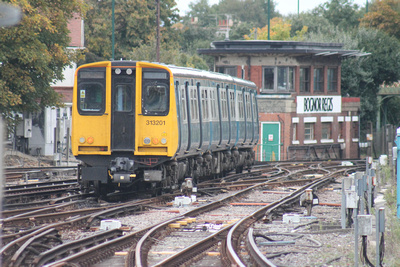 11th October
11th October
Arriving from Eastleigh by 377 on the 11th October, I photoed 313208, which was working on the Hove Shuttle. I then went over to the far end of the station to catch 313204 out to Lewes.
It was very clear from seeing 313204 that the class 313s are in their final months of service, with the exterior condition of the train being poor, with missing, worn out and peeling external vynals and the interior looking very tired and not the cleanest, however, despite this 313204 performed well on the 15 minute journey out to Lewes.
Lewes was a lovely, well kept station, with a nice view at the east end looking towards the old signal box, which gave a nice shot in full sunshine. I spent 90 minutes here and in that time managed to catch the other pair of 313s on the Seaford circuit, 313207 and 313215. As well as the 313s, there was 377s, 387s, 700s, a stone working from Newhaven featuring 59001 and the RHTT top and tailed with 73107 and 73201.
I then headed back into Brighton onboard 313215. After a walk down to Churchill Square for some bus photography, I headed back to the station, where I had time for some more photography while I waited on my train. As well as 313208 shuttling between Brighton and Hove, 313216 had also arrived and was switched off in Platform 2, whilst in the sidings at Lover's Walk, 313203+313205 were coupled up and awaiting use later that night on a football shuttle service. Shortly before 4pm, 313209 arrived from Portsmouth and would form the 4pm train back to Portsmouth and Southsea, which I caught. As I waited for my train back to the hotel in Eastleigh, 313211 arrived from Littlehampton, then soon departed, heading back there.
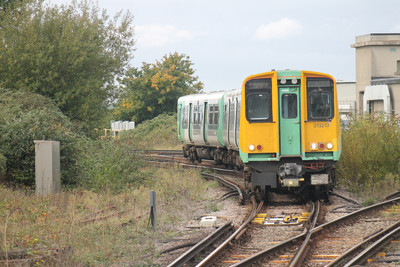 13th October
13th October
After a day out at the Isle of Wight, I returned to Portsmouth and Southsea for the train back to Eastleigh to return to the hotel. As I had time to kill, I caught 313213, which was working on the 19.57 service to Littlehampton to Fratton, where I got off and caught my own train back to Eastleigh.
14th October
I caught a 377 from Eastleigh to Barnham, where I got off and waited for the shuttle to Bognor Regis. 313213 duly arrived from Bognor to operate the return journey, however before getting on the shuttle, I managed to catch a photo of 313212 arriving from Brighton, heading to Portsmouth and Southsea and 313201 'Big Blue' heading to Littlehampton. I then caught the shuttle to Bognor, where I had a wander about then caught 313201 to Littlehampton.
Of all the 313s that I travelled on, 313201, complete with modified BR Blue/Grey retro livery was in by far the best interior and exterior condition of all the 313s that I travelled on, the rest being pretty much run down and tired looking, which is quite understandable given that they will all be withdrawn pretty soon.
At Littlehampton, I caught a pair of 377s to Hove and changed over to 313202 on the Hove Shuttle into Brighton. The sidings at Brighton were reasonably busy with no fewer than 3 x class 313s stabled there, 313211, 313207 and 313220. Unfortunately, I was on a very tight schedule so I didn't have time to catch any of the Seaford workings so I caught the next working back out of Brighton, which was the 2pm service to Portsmouth Harbour with 313215 as the unit of choice and was my final PEP for this trip.
Over the course of this trip and my previous trip down that way in July, I managed to catch / photo 16 of the 20 remaining class in the twilight of their working lives, whether or not they are still in service on my next trip down that way is anyone's guess.
Current Fleet
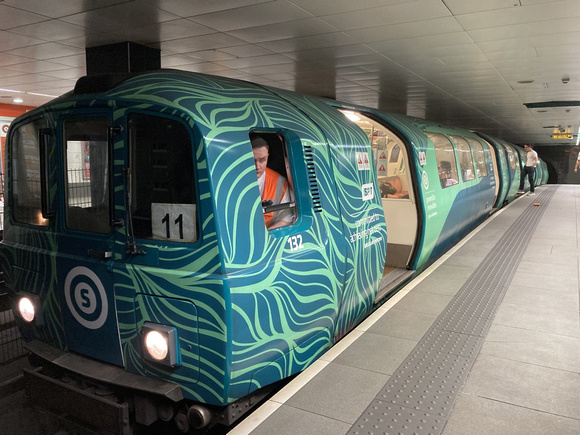 Glasgow Subway's latest vynal wrap sees a 3 car set consisting of Metro Cammell Power Car 132, Barclay Trailer 204 and Metro Cammell Power Car 104 outshopped in a new design advertising SPT's commitment to achieving Net Zero.
Glasgow Subway's latest vynal wrap sees a 3 car set consisting of Metro Cammell Power Car 132, Barclay Trailer 204 and Metro Cammell Power Car 104 outshopped in a new design advertising SPT's commitment to achieving Net Zero.
the three car set are seen paused at St Enoch working diagram 11 on the Inner Circle on 10.9.22
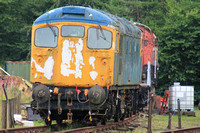
|
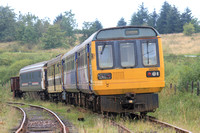
|

|
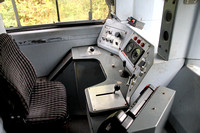
|
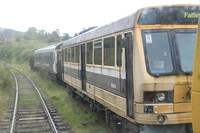
|

|
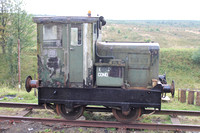
|
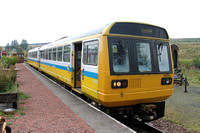
|

|
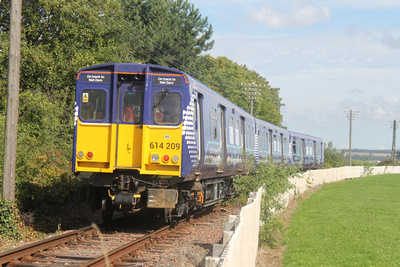 Arcola Energy's Scottish Hydrogen Train, 614209 (former Scotrail Class 314 PEP unit 314209) was out today at Bo'ness operating demonstration runs for some invited guests during the day, between Bo'ness and Kinneil Halt. 614209 was run both on battery and on hydrogen mode on different runs with the mile long run out in each direction giving the invited guests the chance to sample both tractions from this bi-mode unit.
Arcola Energy's Scottish Hydrogen Train, 614209 (former Scotrail Class 314 PEP unit 314209) was out today at Bo'ness operating demonstration runs for some invited guests during the day, between Bo'ness and Kinneil Halt. 614209 was run both on battery and on hydrogen mode on different runs with the mile long run out in each direction giving the invited guests the chance to sample both tractions from this bi-mode unit.
It was great to finally see 209 out on the tracks and good to note that the distinctive compressor sounds remain from 209's days as a class 314 emu as does the sounds of the motors when accelerating in battery mode
I photoed 614209 at Bo'ness station (from the footbridge), Bo'ness foreshore and the area around Kinneil Halt, here are some of my efforts:
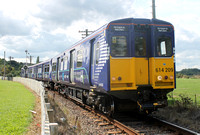
|
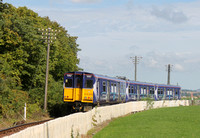
|

|
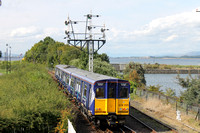
|
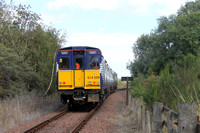
|
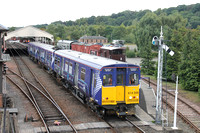
|
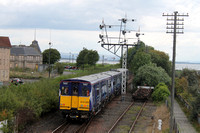
|
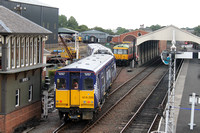
|
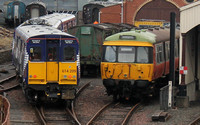
|
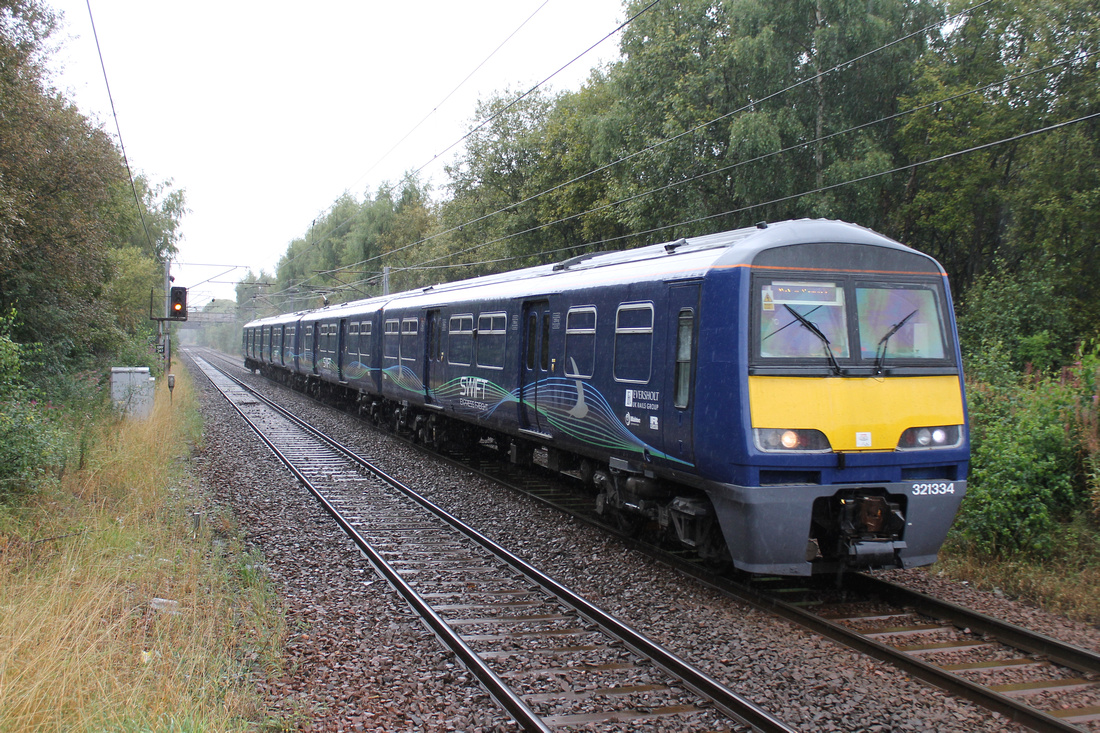
Returning from only its 2nd visit to Scotland, Swift Express Freight's 321334, which has been converted to carry up to 12 tonnes of parcels, approaches Holytown with 5Z84 Mossend - Doncaster ECS working 26.8.22
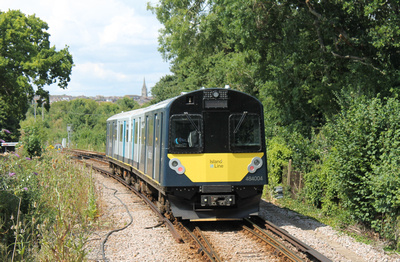 I made my first ever trip to the Isle of Wight on 26th July. My day started with the 40 minute trip from my hotel at Eastleigh by train into Portsmouth Harbour, where I joined a long queue waiting for the Catamaran across to Ryde. I got a good spot up on the top deck to view the Harbour and the coastline of Portsmouth and Southsea on the short 20 minute crossing.
I made my first ever trip to the Isle of Wight on 26th July. My day started with the 40 minute trip from my hotel at Eastleigh by train into Portsmouth Harbour, where I joined a long queue waiting for the Catamaran across to Ryde. I got a good spot up on the top deck to view the Harbour and the coastline of Portsmouth and Southsea on the short 20 minute crossing.
On arrival at Ryde I headed into the Pier Head station where 484004 was waiting to form the 10.45 service to Shanklin. 484004 had just replaced 484002, which had failed on the previous service. It was a really smooth journey and despite the number of people who got off the ferry, I wouldn't have said it was packed.
The interior of 484004 was bright, modern looking, spacious and airy. I travelled to Lake, one stop short of the terminus, where I got off the train.
My reason for getting off one stop short of the terminus was that I was wanting to go and get some photos of 483004 at it's new home at Holliers Park in Arreton. The bus stop was a 5 minute walk from Lake station out on the main Ryde - Ventnor Road. From here I caught service 8, which runs half hourly to Amazon World. The journey took about 20 minutes and once off the bus was a 5 minute walk, turning left at the crossroads and walking about 1/4 mile. In Holliers Park, there is the House of Chilli, a craft centre and the Bus Stop Cafe, which is located in a converted bus.
483004 is currently in a fenced off section of former gravel car park, however the owner of the cafe kindly gave me permission to go in and have a look round and take some photos of the exterior. 483004 is looking excellent in its coat of London Transport Red with white roof. The visible side of the train has been fully painted, however the side that isn't visible is still mostly in the grey primer. The staff who are working on 483004 are really making an excellent job in restoring 483004, which is destined to become a cafe in the future. Before I left, I had a nice lunch at the Bus Stop Cafe, which I'd definately recommend and it cost less than £10.
I headed back towards the Island Line on bus service 8, however after mistakingly thinking that the service stopped at Sandown train station, where as it actually stopped on the front, I had a 15 minute walk up to the station, which meant that I'd just missed the train to Smallbrook Junction by 5 minutes and had almost an hours wait on the next one. Whilst I was waiting, 484003 passed through heading to Shankin on a driver training run and then returned a short time later heading in the direction of Ryde. As it was roasting by this point, I crossed over and decided to catch 484004 up to Shanklin, then from Shankin down to Smallbrook Junction.
At Smallbrook Junction, I got off and transferred over to the Isle of Wight Steam Railway. After a 10 minute wait, Hunslet Austerity 0-6-0 ST WD198 'Royal Engineer' arrived with a trainload of vintage Southern carriages for the journey to Wooton.
On the outbound journey, the train does not stop at Havenstreet so it is a straight end-to-end journey. After running round at Wooton, 198 led the train back to Havenstreet for a 10 minute stopover awaiting the passage of the other train on the line led by LMS Ivatt Class 2 41298.
Unfortunately due to missing the previous Island Line train and 198 being the final train of the day to Smallbrook Junction, I literally had 10 minutes to look round at Havenstreet, which included a very quick sprint up to 'Train Story' for a few shots of 483007. I just made it back to the platform in time for the train back to Smallbrook Junction.
By the time I reached there, the half hourly peak service had started, so I caught 484003, which was operating as the extra unit between Shanklin and Ryde Esplanade as far as Ryde St Johns, where I got a couple of photos of 484001 and 484002 stabled in the yard and 484003 on it's return journey to Shanklin.
I then caught 484004 from Ryde St Johns to Ryde Esplanade, where I got the classic shot of 004 heading along the pier. I then had a wander round the town before photoing the hovercrafts arriving, some buses and the 484003 arriving at Ryde Esplanade, then departing again via the tunnel. After grabbing a quick bite to eat, I walked along the Pier, catching some photos of 484004 heading to the Pier Head. I then ran up to the Pier Head for the Catamaran back to Portsmouth then back to the hotel.
Photos from my trip can be found at https://scottishtrains.zenfolio.com/p37224282
My History of the Island Line Blog can be found via the following links:
- Part 1: https://scottishtrains.zenfolio.com/blog/2022/8/island-line-isle-of-wight-26-7-22
- Part 2: https://scottishtrains.zenfolio.com/blog/2022/8/island-line-a-history-part-2-class-483s-and-484-1990---2022

|
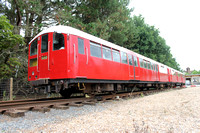
|

|
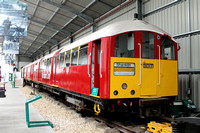
|

|
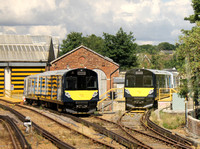
|
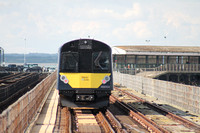
|
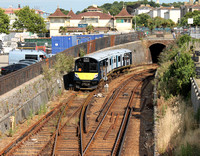
|
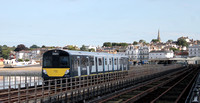
|
Replacement of Standard Stock
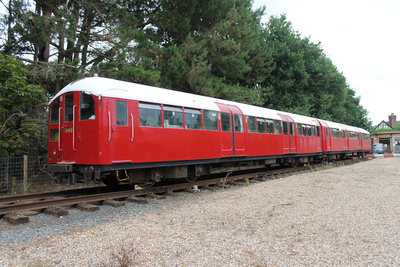 British Rail originally started looking at replacing the Standard stock with the 1938 on the Isle of Wight back in the late 1970s, however they initially rejected the idea of using the 38 stock as the under floor mounted equipment would be vulnerable to waves, flooding and the salt air on Ryde Pier. However by 1988 when it became clear that the Standard stock would no longer be economically viable after 1990 and the offer was there to buy 38 stock, BR took up the offer. Initially they decided to buy 44 cars to allow trains to be made up of 4 cars consisting of a motor, two trailers and another motor. However, as Ryde St Johns depot was only capable of holding 2 cars in their maintenance sheds per road at a time and with storage space at a premium and BR being reluctant to spend money on expanding the depot facilities, it was decided to go with 2 car trains featuring two motor cars (A at the Ryde end and D at the Shanklin end). Electrical and braking equipment carried on the trailers being relocated to the motors.
British Rail originally started looking at replacing the Standard stock with the 1938 on the Isle of Wight back in the late 1970s, however they initially rejected the idea of using the 38 stock as the under floor mounted equipment would be vulnerable to waves, flooding and the salt air on Ryde Pier. However by 1988 when it became clear that the Standard stock would no longer be economically viable after 1990 and the offer was there to buy 38 stock, BR took up the offer. Initially they decided to buy 44 cars to allow trains to be made up of 4 cars consisting of a motor, two trailers and another motor. However, as Ryde St Johns depot was only capable of holding 2 cars in their maintenance sheds per road at a time and with storage space at a premium and BR being reluctant to spend money on expanding the depot facilities, it was decided to go with 2 car trains featuring two motor cars (A at the Ryde end and D at the Shanklin end). Electrical and braking equipment carried on the trailers being relocated to the motors.
Initially BR had planned a minimal refurbishment as they'd planned on the 38 stock being a stopgap that would be withdrawn and replaced in 1995 with 59/62 stock, which was due to be replaced on London Underground at that time, however BR carried out a far more extensive overhaul than expected and this meant a far longer service life was achieved in the end.
Initially 8x2 car trains were to be created and refurbishments and overhauls began in 1988 at Eastleigh and involved the conversion from London Underground's 4 rail operation to 3 rail, the fitting of flourescent lighting, allowing for Conductor / guard operation of the doors, fitting of passenger door controls, fitting of a PA system, reupholstering of seating and improvements to the interior decoration. On the exterior, Network South East livery would be applied.
Delivery and Unveiling
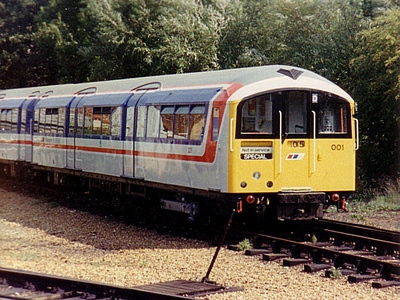 The units were classified as the class 483s on TOPS and the first test run of one of the 2 car units was on 30th June 1989, between Eastleigh and Winchester. On 4th June 483001 was loaded in 2 parts onto low loaders at Fratton and taken to Gunship Wharf in Portsmouth for transfer onto the car ferry. 001 was then taken by road to the yard at Sandown where both halves were unloaded and coupled together and on 6th July 1989, 001 was hauled to Ryde St Johns depot by a train of standard stock and later that evening made its first test run on the island.
The units were classified as the class 483s on TOPS and the first test run of one of the 2 car units was on 30th June 1989, between Eastleigh and Winchester. On 4th June 483001 was loaded in 2 parts onto low loaders at Fratton and taken to Gunship Wharf in Portsmouth for transfer onto the car ferry. 001 was then taken by road to the yard at Sandown where both halves were unloaded and coupled together and on 6th July 1989, 001 was hauled to Ryde St Johns depot by a train of standard stock and later that evening made its first test run on the island.
On 13th July, 483001 was unveiled to the public on the shuttle platform at Ryde Pier Head, where a short ceremony took place before the train headed off to Brading with invited guests on board with a stop off at the site of the future Smallbrook Junction station to unveil a sign hearalding the future extension of the IOW Steam railway to Smallbrook Junction. 001 spent the remainder of the week working on the Pier shuttle and over the following weeks spent time on testing and driver training over the full line before being passed for passenger service.
It would be September before the next arrivals took place with 002 arriving on 26th September and 003 on the 27th. On 1st October 001 and 002 ran as a pair for test purposes with 001, 002 and 003 in that order running as a 6 car to see if it was possible to do so. 6 car running very rarely happened though with the exception of rescuing a failed train. 002 and 003 both entered service on 7th October 1989, joining 001 and the remaining standard cars in service.
The next class 483 to arrive on the island was 483007 on 12th March 1990. 007 was closely followed by 004 on 14th March and 005 on the 15th March. With the arrival of the class 483s, work was also going on to improve the depot facilities at Ryde St Johns with a raised pit road on one track and a full length pit on the other installed / improved and a carriage cleaning platform added in the depot yard. The new facilities were formally opened on 20th March 1990 by the Chairman of the British Rail Board, Sir Robert Reid.
During May 1990, the line was closed for 3 days to allow it to be reballasted and realigned slightly by use of a track machine to try and improve the ride qualities of the 483's which had been fine on the mainland but was decidedly bouncy on the island! 483004 debuted in service on 1st May 1990, with 005 and 007 debuting on 11th and 18th May 1990 respectively. 006 and 008 were delivered on 20th and 21st June, debuting in service on 29th June (008) and 13th July (006). Faults on cars 123 and 224 on sets 003 and 004 resulted in a hybrid unit 003 being formed from vehicles 223 and 124 from June 1990 - October 1991, when both units reverted to their correct formations.
On 20th July 1991, Smallbrook Junction became part of the Island Line when the extension of the steam railway opened to Smallbrook. The wooden halt acting as an interchange station is only open when the steam trains are running. 1991 also saw the end of regular running of the Pier Shuttle, with this being limited to only running ad hoc as and when required (and staff were available) in the following years.
Additional unit
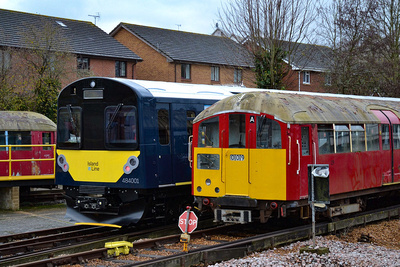 It was decided to introduce an additional set for service from the original 8 planned, so 483009 was refurbished and sent over to IOW arriving on 9th April 1992 and entering service on 18th June 1992. As well as 009, an additional unit nominally numbered 483010 was sent across on 8th April 1992, however it had been stripped to a shell and was painted entirely in dark blue. Both cars were to be kept in case the body shells were required in the event of an accident to be refurbished to replace damaged vehicles. In 1993, the service was mostly cut to 2 trains per hour, however with the earlier singling of the track from Brading to Sandown, this caused the rather unpopular 20/40 minute split timetable. The full 20 minute timetable was restored at really busy times, with 1 train an hour throughout the winter.
It was decided to introduce an additional set for service from the original 8 planned, so 483009 was refurbished and sent over to IOW arriving on 9th April 1992 and entering service on 18th June 1992. As well as 009, an additional unit nominally numbered 483010 was sent across on 8th April 1992, however it had been stripped to a shell and was painted entirely in dark blue. Both cars were to be kept in case the body shells were required in the event of an accident to be refurbished to replace damaged vehicles. In 1993, the service was mostly cut to 2 trains per hour, however with the earlier singling of the track from Brading to Sandown, this caused the rather unpopular 20/40 minute split timetable. The full 20 minute timetable was restored at really busy times, with 1 train an hour throughout the winter.
Hybrids and Withdrawals
Heavy rain caused the flooding of Ryde St John's depot in early January 1994, meaning a temporary formation being made up from vehicles 129 (from 009) and 224 (from 004), this hybrid ran until 8th February 1994. On 10th February 1994, 483005 collided with the buffer stops at Ryde Pier Head, causing damage to the cab on vehicle 125. 483003 was out of service with defects, so the decision was taken to reform 003 with 123 from 003 and 225 from 005, with 125 and 223 becoming set 005 and being withdrawn, the first set to leave service.
Little over a year later in May 1995, 001 and 003 were reformed, with 121 and 225 becoming 001 and 123+221 became 483003 and was withdrawn from service. The number of servicable trains was reduced to 6 in 1996 with a further withdrawal and the final permanent reformation of a class 483 unit. 483001 was reformed with 121 and 222 (from 483002) and 483002 was reformed with 122 and 225 (from 001) with 001 being withdrawn from service. It was decided that 6 units would be enough to provide a service and have spares going forward.
In 1997 the Pier shuttle made a semi permanent return during the season, but only as and when there was enough staff / stock to cover it. The pier shuttle would continue to run on and off but on very rare occasions until the early 00s when the shuttle track was mothballed. In the early hours of March 1st 1998, the bodies of withdrawn cars 121, 125, 222 and 223 as well as the body shells from the nominally numbered but not used 483010 were lifted from the tracks and dumped in the car park at Ryde St John's depot awaiting scrapping 121, 125, 222 and 223 were scrapped on 24th April 2000, 483010 was scrapped by June 2005 . Vehicles 123 and 221 survived on track as a store for spare parts and as a possible spare unit if required but was scrapped in the mid - late 00s.
An interesting move occured at Christmas 1999 with a trio of class 483s working to Ryde Pier Head to get them away from Ryde St John's depot, which was flooded following heavy rain.
Dinsoaur Livery arrives
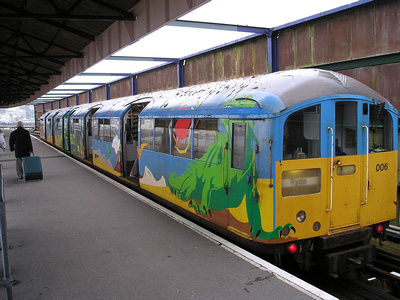 During 2000, a new livery was forthcoming for the veteran class 483 fleet in the form of the rather bright but eyecatching Dinosaur livery! 483006 was first to receive the livery, being unveiled to the public and the press on 21st March 2000. 004 and 009 were repainted into Dinosaur livery around the same time with 008 and 002 following suit in the following months. The five units were named: 'Raptor' (002), T-Rex (004), Terry (006), Iggy (008) and Bronty (009). The repaint was part of a £1 million electrical and mechanical overhaul of the units. The sixth unit (007), was the final unit to remain in NSE livery, being withdrawn for repaint on 12th May 2000.
During 2000, a new livery was forthcoming for the veteran class 483 fleet in the form of the rather bright but eyecatching Dinosaur livery! 483006 was first to receive the livery, being unveiled to the public and the press on 21st March 2000. 004 and 009 were repainted into Dinosaur livery around the same time with 008 and 002 following suit in the following months. The five units were named: 'Raptor' (002), T-Rex (004), Terry (006), Iggy (008) and Bronty (009). The repaint was part of a £1 million electrical and mechanical overhaul of the units. The sixth unit (007), was the final unit to remain in NSE livery, being withdrawn for repaint on 12th May 2000.
Severe Floods and Major Repairs
007 had been repainted in London Transport livery and was nearing completion of it's electrical and mechanical overhaul when disaster struck. A severe flood on 9th/10th October flooded the depot and caused various degrees of damage to 002, 004, 006 and 007, with 007 receiving the worst damage of them all, indeed it was thought that the damage was so severe that the unit would have had to have been scrapped. 008 and 009 escaped damage and following track repairs to replace washed away ballast around Smallbrook Junction, were able to keep the service going. 004 received the least amount of damage and was able to return to service on 13th October. 006 returned to service on 13th December and 002 on 20th June 2001, both units requiring complete motor replacements.
007 took alot longer with many of its underfloor electrical components at the Ryde end having to be completely replaced. This was delayed by a major overhaul to 006 being required and the parts being diverted to it. A second serious flood caused more damage then when 007 was moved out into the yard to allow others into the shed for maintenance, it was attacked by Graffitti 'artists'. By the end of 2002, the damaged components were refitted to 007, the unit was repainted and finished off in authentic London Transport style branding and numerals, with 007's original LT numbers being displayed on the bodysides. Following a relaunch back into service on 24th March 2003, 007 resumed normal passenger duties on 27th March 2003. A second unit, 483009 was repainted into LT livery but minus the LT branding in October 2003, to allow a matching set to run when in 4 car formation.
New Franchise - Retro livery
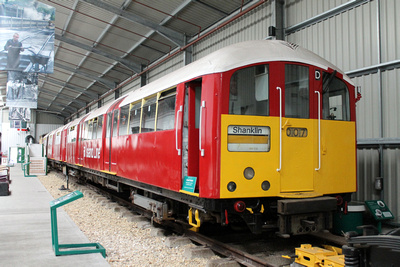 483002 was stored out of use in the yard at Ryde St Johns from sometime in 2004. In 2007, came a new franchise owner in the form of Stagecoach, who decided to repaint the entire fleet in the heritage London Transport red livery. The final by this time rather tired looking Dinosaur liveried train, 483006 being repainted in Winter 2008 / 09. Even the withdrawn 483002 was treated to the new livery!
483002 was stored out of use in the yard at Ryde St Johns from sometime in 2004. In 2007, came a new franchise owner in the form of Stagecoach, who decided to repaint the entire fleet in the heritage London Transport red livery. The final by this time rather tired looking Dinosaur liveried train, 483006 being repainted in Winter 2008 / 09. Even the withdrawn 483002 was treated to the new livery!
Final years of the class 483
In 2016, 483009 was withdrawn from passenger service, being demoted to use as the Ryde depot shunter, with 007 being withdrawn for a 2 1/2 year long overhaul in 2017. This would leave 004, 006 and 008 to operate the service. By this time, services were no longer being operated in 4 car formation. The fleet was further reduced when 004 was withdrawn in 2019 and was used to provide spare parts to keep 006 and 008 going.
On 13th September 2019, South Western Railway announced that due to a 'safety issue' that only one unit was able to run, meaning that it was only possible to run an hourly service. The hourly service remained for 5 weeks, when a 2 car service was able to resume. 3 days into the hourly service commencing, South Western Railway announced that five ex District Line 'D' Stock trains in 2 car formation (the class 484s) would be replacing the class 483s. Meanwhile issues with the class 483s continued into November with several days of disruption and reduced timetables.
The last year
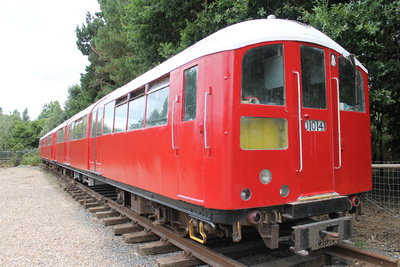 It was announced that the final day of operation for the Class 483s would be Sunday 3rd January 2021 as the line needed to close to allow for upgrade works prior to the class 484s entering service. For most of the final year of the class 483s, Covid 19 led to an hourly service with only one train being used, equaling the burden between sets 006 and 008 for the majority of the year, however for a spell in November 2020 there were no trains available for service at all. 483008 was withdrawn from service on 4th December 2020 and it was expected that 006 would soldier on for the last month alone, however 483007's protracted overhaul was completed in mid December allowing the burden to be shared. On 10th November, the first class 484, 484001 arrived on the island and having been offloaded at Sandown, was driven slowly under it's own power to Ryde St Johns Depot. 484001 was seen out on occasional test runs during December.
It was announced that the final day of operation for the Class 483s would be Sunday 3rd January 2021 as the line needed to close to allow for upgrade works prior to the class 484s entering service. For most of the final year of the class 483s, Covid 19 led to an hourly service with only one train being used, equaling the burden between sets 006 and 008 for the majority of the year, however for a spell in November 2020 there were no trains available for service at all. 483008 was withdrawn from service on 4th December 2020 and it was expected that 006 would soldier on for the last month alone, however 483007's protracted overhaul was completed in mid December allowing the burden to be shared. On 10th November, the first class 484, 484001 arrived on the island and having been offloaded at Sandown, was driven slowly under it's own power to Ryde St Johns Depot. 484001 was seen out on occasional test runs during December.
On 3rd January 2021, the final day of service for the class 483s, 007 started the day with the hourly service and was replaced at lunchtime by 006, which finished the day and brought down the curtain on 31 years of service for the class 483. The final 6 units are all still in existance in various states of repair: 483002 is currently stored in the yard of Railway Support Services in Wishaw (England), 483004 is currently being converted to an on site cafe at Holliers Park, Arreton on the Isle of Wight, 483006 and 483008 are currently preserved by the London Transport Traction Group at the Llanelli and Mynydd Mawr Railway in Wales and will hopefully both be runners again one day, 483007 is currently on display at the 'Train Story' shed on the Isle of Wight Railway and it is hoped to be a runner again in the future. 483009 is in 2 locations with 129 having been restored by a private buyer at the East Somerset Railway and 229 remaining stored in the yard of Reid Freight in Longton.
Line upgrade and introduction of the class 484
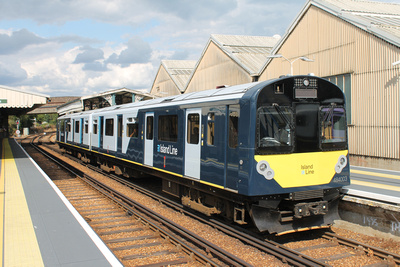 After 483006 returned to depot for the last time and the power was switched off, work quickly commenced on the upgrade of the line with the platforms at all stations needing to be raised in line with the increased line of the 'new' former sub surface stock which were taller than the former deep tube stock that they replaced. Track replacement at some parts of the line was also needed as was work to reinstate the disused 2nd platform at Brading with a passing loop being built. The work was met with delays and with late delivery of the trains and software issues with the trains, the line did not reopen until 1st November 2021, some 8 months after it was due to reopen. 484001-484004 were available for service from reopening with 484005 not being delivered until February 2022 and still not having been handed over to South Western Railway. Trains currently run hourly from Ryde Pier Head to Shanklin, with a second unit entering sevice in the morning and afternoon peaks and operating between Ryde Esplanade and Shankin.
After 483006 returned to depot for the last time and the power was switched off, work quickly commenced on the upgrade of the line with the platforms at all stations needing to be raised in line with the increased line of the 'new' former sub surface stock which were taller than the former deep tube stock that they replaced. Track replacement at some parts of the line was also needed as was work to reinstate the disused 2nd platform at Brading with a passing loop being built. The work was met with delays and with late delivery of the trains and software issues with the trains, the line did not reopen until 1st November 2021, some 8 months after it was due to reopen. 484001-484004 were available for service from reopening with 484005 not being delivered until February 2022 and still not having been handed over to South Western Railway. Trains currently run hourly from Ryde Pier Head to Shanklin, with a second unit entering sevice in the morning and afternoon peaks and operating between Ryde Esplanade and Shankin.
Photos from Wikimedia commons:
- 001: https://commons.wikimedia.org/wiki/File:483_001_at_St_John%27s_Road,_1989_-_geograph.org.uk_-_790855.jpg
- 002: https://commons.wikimedia.org/wiki/File:483002_483007_Ryde_Electric_Depot.JPG
- 006: https://commons.wikimedia.org/wiki/File:Island_Line_train_-_geograph.org.uk_-_836245.jpg
- 008: https://commons.wikimedia.org/wiki/File:483008_Shanklin.jpg
- 009: https://commons.wikimedia.org/wiki/File:484001_and_483009_at_Ryde_Traincare.jpg
- Remainder are my own photgraphs, more of which can be found at: https://scottishtrains.zenfolio.com/p37224282
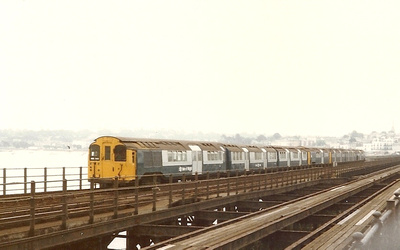 Having visited the Isle of Wight on 26th July, I decided I would write a blog post about my visit, however I wanted to explain a bit of the history of the Island Line first before I write about my visit. The history will be over 2 posts, with this post being mainly about the Standard tube stock and the line from 1967 onwards till 1990/91 and the second part will be about the 1938 stock and the current ex District Line stock, with my trip report being in a third post.
Having visited the Isle of Wight on 26th July, I decided I would write a blog post about my visit, however I wanted to explain a bit of the history of the Island Line first before I write about my visit. The history will be over 2 posts, with this post being mainly about the Standard tube stock and the line from 1967 onwards till 1990/91 and the second part will be about the 1938 stock and the current ex District Line stock, with my trip report being in a third post.
Please note: the photo on this page is from Wikimedia Commons and is of a 3 Tis + 4 Vec (class 486+485) 7 car formation working on the Pier Head - Esplanade Shuttle in 1984. The original photo can be found at: https://commons.wikimedia.org/wiki/File:BR_Class_485_train_on_Ryde_Pier_IoW.jpg
Introduction
The Isle of Wight Railway history stretches back as far as 1862 with the building of a line from Cowes to Newport. Ryde St Johns Road - Shanklin followed in 1864 with a later extension from Shanklin - Ventnor following in 1866. Smallbrook Junction - Newport in 1875 and Ryde St Johns Road - Ryde Pier Head in 1880 also followed. Other branches from Merstone - Ventnor West, Freshwater - Newport, Sandown - Newport and Brading - Bembridge ensured that by 1900, the Isle of Wight was served by 55 1/2 miles of railways.
By 1956 low patronage of many of the branch lines, particularly off season led to closure of the lines from Cowes to Newport, Merstone - Ventnor West, Sandown - Newport, Freshwater - Newport and Brading - Bembridge leaving only the Ryde Pier Head - Ventnor and Newport lines open. Into the 1960s and the Beeching Report recommended the full closure of the remaining lines on the island other than the short but busy stretch between Ryde Pier Head and Ryde St John's Road. A local hard fought campaign for the retention of the Ryde - Ventnor line eventually managed to save the 8 1/2 mile line from Ryde - Shanklin, with the closure of the Shanklin - Ventnor stretch and the Smallbrook Junction - Newport branch of the line in 1966.
Rationalisation and Introduction of the Standard Stock
With the line saved, British Railways announced a modernisation and track rationalisation programme for the 8 1/2 mile stretch of line so next came the challenge of replacing the elderly Adams Class 02 steam locos (with an average age of 74) and wooden bodied, non corridor, 4 wheeled Southern Railways rolling stock with their unique loading gauge. The rolling stock was narrower and shorter that of the trains on the mainland, to allow them to pass under the bridges on the line and the Ryde Tunnel. The option chosen was to approach London Underground to buy some of their recently withdrawn tube stock. It was the right profile for the tunnel and the bridges so would be a suitable option! By chance, London Underground was withdrawing some of it's pre 1938 stock (built between 1923 and 1934) so by 1965 and with the approval of BR to begin a programme of electrification of the Ryde to Shanklin stretch, 46 pre 1938 stock vehicles were purchased.
This was soon reduced to 43 cars to save money, with 19 Driving Motors (numbered S1S-S11S, S13S, S15S, S17S, S19S-S23S and S25S), 6 control trailers (numbered S26S, S28S, S30S, S32S, S34S, S36S), 4 ex control trailers (Numbered S27S, S29S, S31S, S33S) and 14 trailers (numbered S41S-S49S and S92S-S96S) purchased. Initially they were marshalled into 6x 4 cars ('4 VEC' or class 485 numbered 041-046) and 6x3 cars ('3TIS' Class 486 031-036) with one spare motor (S10S). The formation was as follows: 4 car: Motor - Trailer - Trailer - Motor 3 car: Control Trailer - Trailer - Motor. The initial plan was for 2 x 4 car sets to be used for winter traffic and as many as 6 x 7 car (4&3 car combined) on Summer Saturdays. Each set had an 'A' motor (or control trailer) at the Ryde Pier Head end and a 'D' motor at the Shanklin end as A and D motors had different equipment underneath them, it was not possible to have 2 A or D cars as the Driving Motors in the one set.
| 3TIS | Control Trailer (A) | Trailer | Driving Motor(D) | |
| 031 | 26 | 47 | 1 | |
| 032 | 28 | 92 | 3 | |
| 033 | 30 | 93 | 5 | |
| 034 | 32 | 94 | 7 | |
| 035 | 34 | 95 | 9 | |
| 036 | 36 | 96 | 11 | |
| 4VEC | Driving Motor(A) | Trailer | Trailer | Driving Motor(D) |
| 041 | 20 | 27 | 41 | 13 |
| 042 | 22 | 29 | 42 | 15 |
| 043 | 2 | 31 | 43 | 19 |
| 044 | 4 | 33 | 44 | 21 |
| 045 | 6 | 48 | 45 | 23 |
| 046 | 8 | 49 | 46 | 25 |
| Spare | 10 |
The steam era on the Isle of Wight ended on 31st December 1966 as work to complete the electrification and cut the four platform tracks at the Pier head down to two continued whilst platforms at the other stations were lowered to allow the pre 38 standard stock to use them. 11 weeks after the steam era finished, the electric era began on Monday 20th March 1967 with trains operated by 4 VEC 041 and 3 TIS 031 (with the spare Motor car S10S attached to make it up to 4 cars). The Sandown school special was operated by a 7 car set made up of 032 and 044.
Early years of the Tube stock services
By Autumn 1967, a shunting accident caused damage to Motor Car S15S which led to the car being scrapped in 1969 and a replacement was sought in the form of another car that had been withdrawn by London Underground. It was repainted at Stewarts Lane and transferred by ferry over to the Isle of Wight, arriving during 1971. In 1969, the Pier tramway, which ran on a seperate pier alongside the line closed and was replaced by a 7 car set shuttling between the Pier Head and Esplanade stations before running ECS to Ryde St Johns. As a 7 car train was required for the shuttle, the timetable was reduced south of the Esplanade to 4 trains per hour, which meant that the up platform at Shanklin was rarely used in service and by 1971 the platform buildings were demolished and the subway between platforms was filled in.
By 1973 the scissors crossing for access to Pier Head Station was worn out and in need of replacement also the Pier Head Signal Box which was its self in need of replacement. Rather than replace it with a new crossover, plain track was fitted to both tracks and a trailing crossover south of Esplanade station on the ramp to the tunnel was installed, rendering the Pier Head signal box redundant at the same time and allowing its closure and demolition. This led to the southbound track becoming a dedicated bi directional shuttle track for the pier shuttle and removed dead mileage of having to go to St Johns to reverse. The main service used the former northbound track, which also became bi directional as the same time.
Also during 1973, the number of trains available for use decreased following a shunting accident between 4Vec 045 and 3Tis 035, which resulted in the withdrawal and scrapping of 3 vehicles (Driving Motor S23S and Trailers S45S and S48S from 045) and the reformation of the remaining four vehicles into a new formation of 4Vec 045. The fleet was further reduced during 1975 when S25S, the Shanklin end driving Motor from 4VEC 046 was severely damaged and with no spare motor vehicle suitable for working on the Shanklin end available, 046 was disbanded with the remaining vehicles being kept as spares.
By 1979, the service had reduced to 3 trains per hour during the summer and this allowed for further rationalisation at Shanklin with the removal of the headshunt (remains of the former line to Ventnor) beyond the station and the track in the up platform. This also meant that only 1 train could be south of Sandown at a time.
Rundown and Replacement
The pool of available vehicles was further reduced with the disbanding of set 033 in 1982. 033's driving motor replaced that of set 043 with vehicle S30, 033's control trailer being removed from the track at St Johns for use as a store, while S19 from 043 was moved to Sandown to the PW yard there also as a stores vehicle.
Attention started to turn to the replacement of the Standard Stock, with consideration being given to the transfer and use of the Merseyrail class 503s, which were about to be withdrawn and replaced by class 508s and the other option of 1938 stock from London Underground, which was about to be partially withdrawn from the Underground also being considered and initially rejected due to the electrical equipment being located under the floor and this was considered a risk especially with the line travelling along the pier. Some 7 years later, the 1938 stock would come to the Island Line and would replace the Standard stock.
With the replacement of the Standard stock having been rejected, the remaining fleet were treated to an £80,000 interior and exterior refresh, with an interior repaint, new lino and new moquette fitted in the interior and BR Blue / Grey livery painted on the exterior. A further four vehicles were withdrawn in 1985 (Driving motors S13 and S21, Control Trailer S36 and Trailer 96) leaving 29 vehicles for service, these being reformed into 5 x 5 car units (5 Vec) and 2 x 2 car units (2 TIS) and from January 1987, the remaining vehicles began to be repainted into Network South East livery. Also in 1987, the first new station on the line in many decades was opened in the form of the single platformed station at Lake, between Sandown and Shankin, which opened on 11th May 1987. Lake station could only handle a maximum of 5 coach lengths of standard stock, which effectively put an end to the use of 7 car trains.
In August 1988, it was confirmed that 'new' trains were on the way to the Island in the form of then 48 year old 1940 built '38 stock from London Underground, with 8 x 2 carriage trains expected to be delivered and at that point were expected to be in service by May 1989. Network South East were reportedly spending £900,000 on a full refurbishment of the 'new' trains.
Over the weekend of 29th-30th October 1988, the track between Brading and Sandown was reduced to single track, this had the added effect of making the signal boxes at Brading and Sandown redundant, with all signalling concentrated on the one remaining box at Ryde St Johns. Brading signal box became a small museum in later years whilst Sandown box was demolished a year later in 1989.
The singling of the track from Brading (which was reduced to one platform, with the former island platform on the down side becoming redunant) through to just outside of Sandown station was fine for the then 20 minute service in operation using 3 trains, however when the service was further reduced to 2 trains per hour, the timetable became a lop sided affair with a 20/40 minute split.
The first class 483, 483001 was delivered during 1989 and made its offical debut on 15th July 1989 taking invited guests from the Pier Head to Sandown with a stop off at Smallbrook Junction to reveal a sign announcing the extension of the Isle of Wight Steam Railway from Havenstreet through to Smallbrook Junction, where a new halt would be built linking the 2 lines. 483001 would spend time during the summer working on the Esplanade - Pier Head shuttle. Over the course of 1989, the remaining Standard stock reverted to 4 car formations, eventually being reduced to 17 vehicles. By August 1990, there were sufficient class 483s in service for the Standard stock to be reduced to 7 vehicles in service, a 4 car set made up of 2, 26, 49 and 7 and a 3 car set made up of 28, 31 and 5. However by the following month only the 3 car set remained available for service, mainly for de-icing purposes, but also occasionally in service, with the last official recorded passenger service use being on 12th January 1991, with the final de-icing run taking place on 17th January 1991, though unofficially, the train carried passengers from the Esplanade to Pier Head to connect with a catamaran service to Portsmouth.
Most of the cars once withdrawn, were scrapped either on the island or the mainland, however 5 of them were returned to London Transport as part of a Vintage Train project with Motor cars S2S and S7S and Trailers S49S, S27S and S44S chosen. S27S and S44S were repainted into London Transport colours at Ryde St Johns however, the project never really took off and some of the cars remain stored or have been scrapped.
| Number | Type | LT Number | In Service (IOW) | Withdrawn | Disposal |
| 1 | 'D' Driving Motor | 3703 | 20.3.67 | 6.6.90 | Scrapped 7.1.93 |
| 2 | 'A' Driving Motor | 3706 | 20.3.67 | 7.9.90 | LT Heritage Train Project |
| 3 | 'D' Driving Motor | 3251 | 20.3.67 | 1989 | Scrapped 4.10.90 |
| 4 | 'A' Driving Motor | 3702 | 20.3.67 | 28.9.89 | Scrapped 4.10.90 |
| 5 | 'D' Driving Motor | 3185 | 20.5.67 | 13.5.91 | Scrapped 23.4.94 |
| 6 | 'A' Driving Motor | 3084 | 15.5.67 | 1.2.90 | Scrapped 1991 |
| 7 | 'D' Driving Motor | 3209 | 26.4.67 | 7.9.90 | LT Heritage Train Project |
| 8 | 'A' Driving Motor | 3074 | 20.3.67 | 6.6.90 | Scrapped 8.1.93 |
| 9 | 'D' Driving Motor | 3223 | 26.4.67 | 3.10.89 | Scrapped 1991 |
| 10 | 'A' Driving Motor | 3696 | 20.3.67 | 6.6.90 | Scrapped 5.1.93 |
| 11 | 'D' Driving Motor | 3705 | 22.3.67 | 18.1.90 | Scarpped 15.1.93 |
| 13 | 'D' Driving Motor | 3141 | 1967 | 03.85 | Scrapped 1987 |
| 15 (i) | 'D' Driving Motor | 3253 | 20.3.67 | 7.10.67 | Scrapped 10.5.69 |
| 15 (ii) | 'D' Driving Motor | 3273 | 1971 | 11.4.88 | Scrapped 8.5.89 |
| 19 | 'D' Driving Motor | 3045 | 20.5.67 | 12.82 | Scrapped 21.4.89 |
| 20 | 'A' Driving Motor | 3308 | 1967 | 11.4.88 | Scrapped 8.5.89 |
| 21 | 'D' Driving Motor | 3041 | 20.3.67 | 3.85 | Scrapped 6.87 |
| 22 | 'A' Driving Motor | 3010 | 20.3.67 | 14.11.86 | Scrapped 16.5.89 |
| 23 | 'D' Driving Motor | 3315 | 15.5.67 | 10.9.73 | Scrapped 4.5.74 |
| 25 | 'D' Driving Motor | 3313 | 22.3.67 | 8.9.75 | Scrapped 10.82 |
| 26 | 'A' Control Trailer | 5294 | 20.3.67 | 7.9.90 | Scrapped 18.4.94 |
| 27 | Ex Control Trailer | 5279 | 1967 | 18.1.90 | LT Heritage Train Project |
| 28 | 'A' Control Trailer | 5304 | 20.3.67 | 13.5.91 | Scrapped 14.4.94 |
| 29 | Ex Control Trailer | 5293 | 20.3.67 | 25.9.89 | Scrapped 16.10.90 |
| 30 | 'A' Control Trailer | 5312 | 20.5.67 | 12.82 | Scrapped 7.87 |
| 31 | Ex Control Trailer | 5283 | 20.5.67 | 13.5.91 | Scrapped 16.4.94 |
| 32 | 'A' Control Trailer | 5290 | 26.4.67 | 4.9.89 | Scrapped 15.10.90 |
| 33 | Ex Control Trailer | 5291 | 22.3.67 | 20.9.89 | Scrapped 13.10.90 |
| 34 | 'A' Control Trailer | 5302 | 26.4.67 | 6.6.90 | Scrapped 20.10.90 |
| 36 | 'A' Control Trailer | 5350 | 22.3.67 | 3.85 | Scrapped 6.87 |
| 41 | Trailer | 7286 | 1967 | 12.9.86 | Scrapped 8.5.89 |
| 42 | Trailer | 7280 | 20.3.67 | 27.11.86 | Scrapped 16.5.89 |
| 43 | Trailer | 7275 | 20.5.67 | 30.9.88 | Scrapped 25.10.90 |
| 44 | Trailer | 7281 | 20.3.67 | 3.2.90 | LT Heritage Train Project |
| 45 | Trailer | 7293 | 15.5.67 | 10.9.73 | Scrapped 4.5.74 |
| 46 | Trailer | 7283 | 22.3.67 | 7.9.90 | Scrapped 16.5.89 |
| 47 | Trailer | 7279 | 20.3.67 | 11.87 | Scrapped 25.10.90 |
| 48 | Trailer | 7298 | 15.5.67 | 10.9.73 | Scrapped 5.4.74 |
| 49 | Trailer | 7296 | 22.3.67 | 7.9.90 | LT Heritage Train Project |
| 92 | Trailer | 7285 | 20.3.67 | 4.10.88 | Scrapped 14.10.90 |
| 93 | Trailer | 7282 | 20.5.67 | 18.1.90 | Scrapped 20.10.90 |
| 94 | Trailer | 7287 | 26.4.67 | 3.10.89 | Scrapped 17.10.90 |
| 95 | Trailer | 7292 | 26.4.67 | 5.3.90 | Scrapped 23.10.90 |
| 96 | Trailer | 7290 | 22.3.67 | 3.85 | Scrapped 6.87 |
I visited the Volks Electric Railway for the very first time on Monday 25th July. This short 1 mile line has many years of interesting history and is the oldest remaining electric railway in the world.
I will describe my visit later in the blog but first some of the history of the line:
The Founder
Magnus Volk, the son of a German Clockmaker was born in Brighton on 19th October 1851, he was known as an inventor and pioneer in the Brighton area with some of his projects including inventing a fire alarm system, having the first electrically lit house in Brighton, an early attempt at telecommunications with a neighbouring house and having a contract to electrically light Brighton's Royal Pavilion.
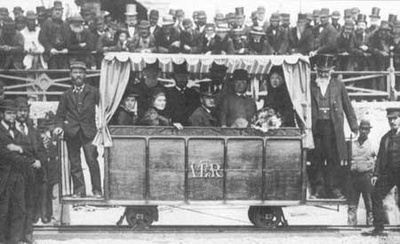 Demonstration Line
Demonstration Line
His successful experimentations with electricity led to his next, most successful and enduring project: the Volk's Electric Railway! After gaining permission from Brighton Corporation for a 1/4 mile long 2 foot gauge line running from the Palace Pier to the Chain Pier, work quickly progressed and before long, the line was ready! The line was powered by a 2 horse power gas engine, which drove a Siemens D5 50 volt DC Generator. The original car, built by William Pollard in 1883, seated 10 passengers and resembled a coal wagon with drivers platforms, awning over the passenger area as well as curtains for the side. The 1 1/2 horse power motor allowed for a top speed of 6 mph. Magnus Volk unveiled this creation to a very interested public at 12 noon on 6th August 1883.
Early years
With the initial line being a success, Volk applied for permission to extend the line Westwards to the town boundary, unfortunately permission wasn't granted, however he did get permission to extend the line eastwards to the Banjo Groyne and rented out the 'Arch' at Paston Place, which was to become the VER Headquarters (remains so to this day) and the line's workshops. A line was built across the promenade to reach the Arch Workshops, which also housed the line's new upgraded power generator.
Over winter 1883/84 the line was relayed to the wider gauge of 2 ft 8 1/2 inches and the new stretch required some structures to be built in the form of timber trestles to bridge the gaps in the shingle and the section at the Chain Pier made on a gradient to allow the line to pass underneath the pier Initally the track was of the 2 rail variety with one rail being the live feed and the other was the return, however this proved unreliable especially in stormy conditions and the system was switched to run off the third rail in 1886. A 2 platform station was opened at the Banjo Groyne with a halt opening halfway along the line, where a passing loop was also built. Palace Pier station was also a 2 platform station. The line now had a total length of 1400 yards.
The original Pollard built car was unable to be converted to the new wider gauge so it was scrapped and replaced by two new cars (numbered 1 & 2). The new cars had a central passenger saloon with seating for 18 passengers on long bench seats with 12 passengers able to be seated outside on the open platforms. Similar to most trams of the time, the passenger saloon was accessed from the centre of the open platforms, which also featured the driver's controls.
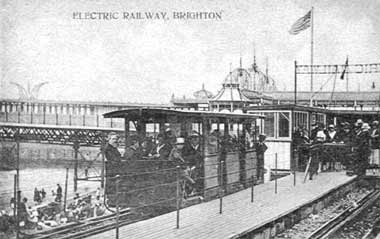 The new extended line opened on 4th April 1884 and only Car 1 was in use at this time as Car 2 did not arrive till Summer 1885. With the installation of the 3rd rail in 1886, the line was also raised and placed onto a wooden viaduct. With the arrival of Car 2, the service level was increased to a car every 5 minutes. The line grew in popularity with it more cars with bigger capacity were required so in 1892, Cars 3 and 4 were built by the VER and initially entered service as open sided cars seating 40 people, however it was soon realised that the cars were unsuitable for winter operation as their canvas blinds were of no real use against the harsh winter weather and they were converted to semi-open trams that winter, with a further refurbishment in 1901 bringing them to the same shape / style that they are in today. A further car was built in 1896, car 5, which was built by the VER to a similar style as that of car 2, seating 30 passengers but with one difference, the window panes were detatchable, making suitable as a summer and a winter car where required.
The new extended line opened on 4th April 1884 and only Car 1 was in use at this time as Car 2 did not arrive till Summer 1885. With the installation of the 3rd rail in 1886, the line was also raised and placed onto a wooden viaduct. With the arrival of Car 2, the service level was increased to a car every 5 minutes. The line grew in popularity with it more cars with bigger capacity were required so in 1892, Cars 3 and 4 were built by the VER and initially entered service as open sided cars seating 40 people, however it was soon realised that the cars were unsuitable for winter operation as their canvas blinds were of no real use against the harsh winter weather and they were converted to semi-open trams that winter, with a further refurbishment in 1901 bringing them to the same shape / style that they are in today. A further car was built in 1896, car 5, which was built by the VER to a similar style as that of car 2, seating 30 passengers but with one difference, the window panes were detatchable, making suitable as a summer and a winter car where required.
The Daddy Long Legs
Magnus Volks wanted to extend the line eastwards towards Rottingdean, however a steep climb to the cliff top or the possibility of building a viaduct over unstable ground ruled this out, so ever being the inventor, he came up with an ingenious invention, 'The Daddy Long Legs'. The Daddy Long Legs was basically a cross between a tram and a boat with large legs reaching the seabed where rails were installed! There was an overhead wire installed with trolley pole giving the tram element. The rails were laid from Paston Place to Rottingdean through the water but reasonably close to the shore. Opening in 1896, the Daddy Long Legs proved popular, however the experiment almost ended in disaster as a massive storm shortly after opening caused serious damage including the vehicle ending up on its side. Volks percivered and repairs were completed, allowing the line to reopen in 1897.
Things wouldn't run smoothly for long as damage to the trackbed closed the line for 2 months in 1900, followed by the news that the line would have to be diverted deeper into the sea to make room for new sea defences between Paston Place and Black Rock essentially ended this unique railway, however the end of the Daddy Long Legs had good effects on the future of the Volks Electric Railway .....
Extension
 Following the demise of the Daddy Long Legs, the Volks Electric Railway was extended further eastwards to Black Rock in 1901, thus allowing the creation of an enduring feature of the line, 'The Tunnel'. The Tunnel was a part of the original car sheds but converted to a through track so you were actually passing through the sheds! Heading eastward from the sheds at Paston Place, the line headed onto a steel viaduct at the Banjo Groyne then along wooden viaducts along the beach to a new 2 platform terminus at Black Rock. Volk intended on trying to extend to Rottendean, but there wasn't the funds to extend further. The extension to Black Rock required further cars, with Volk estimating that 7 cars would be required to operate the service so the railway built an additional cars numbered 6,7 and 8, giving an extra car for extra flexibility / cover for maintenance. 6,7 & 8 were all 40 seater Semi Open cars and had a similar look to cars 3 &4.
Following the demise of the Daddy Long Legs, the Volks Electric Railway was extended further eastwards to Black Rock in 1901, thus allowing the creation of an enduring feature of the line, 'The Tunnel'. The Tunnel was a part of the original car sheds but converted to a through track so you were actually passing through the sheds! Heading eastward from the sheds at Paston Place, the line headed onto a steel viaduct at the Banjo Groyne then along wooden viaducts along the beach to a new 2 platform terminus at Black Rock. Volk intended on trying to extend to Rottendean, but there wasn't the funds to extend further. The extension to Black Rock required further cars, with Volk estimating that 7 cars would be required to operate the service so the railway built an additional cars numbered 6,7 and 8, giving an extra car for extra flexibility / cover for maintenance. 6,7 & 8 were all 40 seater Semi Open cars and had a similar look to cars 3 &4.
In 1926, a further two cars built by the VER joined the fleet in the form of open cars 9 and 10, both of which had seating for 40 passengers.
Cut Backs
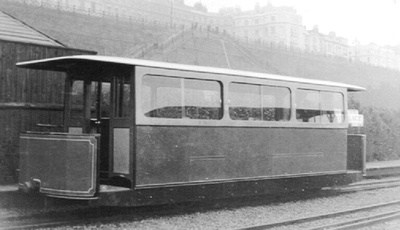 The development of Maderia Drive in 1930, meant that the line was cut back at the west end from Palace Pier to opposite the Aquarium, with the station being renamed 'Aquarium' and being built with a 2 track layout. Volk decided at a winter car was needed and with the original Car 5 needing a rebuild, it was decided to scrap it and built a new one. In a complete change from the traditional wooden built cars, the new number 5, which had it's body built by G Kelsey Coachbuilders of Hove, had its bodywork completely fabricated from steel, with a wooden roof and wooden floor. No 5 had no outside passenger accomodation, all were seated indoors, in 2 long bench seats along the body sides, covered in blue leather and seating 24 passengers. The bodysides had 3 large sliding windows and the outside of the car was painted in a rather striking sky blue and primrose yellow colour scheme.
The development of Maderia Drive in 1930, meant that the line was cut back at the west end from Palace Pier to opposite the Aquarium, with the station being renamed 'Aquarium' and being built with a 2 track layout. Volk decided at a winter car was needed and with the original Car 5 needing a rebuild, it was decided to scrap it and built a new one. In a complete change from the traditional wooden built cars, the new number 5, which had it's body built by G Kelsey Coachbuilders of Hove, had its bodywork completely fabricated from steel, with a wooden roof and wooden floor. No 5 had no outside passenger accomodation, all were seated indoors, in 2 long bench seats along the body sides, covered in blue leather and seating 24 passengers. The bodysides had 3 large sliding windows and the outside of the car was painted in a rather striking sky blue and primrose yellow colour scheme.
The line was also cut back at the East end in 1937 to allow the building of a new open air swimming pool, however this gave the opportunity a modern Art Deco style replacement station, which was officially opened by Magnus Volk and the Deputy Mayor on 7th May 1937. Unfortunately, just 13 days after Black Rock station was opened, Magnus Volk died aged 85, with his son, Herman taking over.
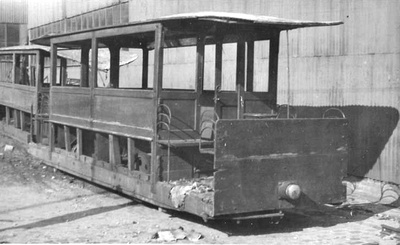 Corporation take over
Corporation take over
In 1938, Brighton Corporation took control of the VER, initially leasing the line and operation back to Herman Volk, however, they assumed complete control on 1st April 1940. Unfortunately by this time Britain was at War and under the serious threat of Nazi invasion. By July 1940, the railway had closed for the duration, with the cars being transfered to Lewes Road tram / bus depot for storage and the stations at Aquarium and Black Rock being demolished. Later in the war, the depot was required for other purposes and the cars were moved out into secure open storage under the arches at Maderia Drive, with the outdoor storage causing irrepairable damage to cars 1, 2 and 5 which had to be scrapped.
Reopening
After the war, the line needed some serious work to get it operational again, Black Rock station was rebuilt again in the same art deco style as pre war, whilst a former tram shelter became the new station building at Aquarium. The full track was relaid as was the third rail. Replacement cars were sought for the scrapped cars and these came in the shape of 2 ex Southend Pier rail trailers, which seated 40 people and were converted to motor vehicles. They were fitted with ex milk float motors and became the fastest cars in the fleet!
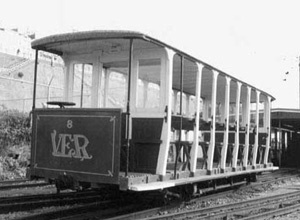 A renumbering of the fleet occured to fill up the numbers left vacant by the scrapped cars with no 10 becoming no 1, no 9 becoming no 2 and no 8 becoming no 5 with the ex Southend cars becoming 8 & 9.
A renumbering of the fleet occured to fill up the numbers left vacant by the scrapped cars with no 10 becoming no 1, no 9 becoming no 2 and no 8 becoming no 5 with the ex Southend cars becoming 8 & 9.
The line reopened on 15th May 1948 and from Winter 1954 became seasonal only.
In 1964, a successful experiment with the coupling of 2 cars together was successful and all cars were converted to allow them to be coupled, meaning less staff and less individual cars could be used, ultimately saving money and allowing for track rationalisation at both termini with only one platform and track required.
Moving on towards the 1990s and the 1948 built station at Black Rock was demolished and a new station was incorporated into the building of a new pump house built next to the station for a storm drain project.
New Millennium
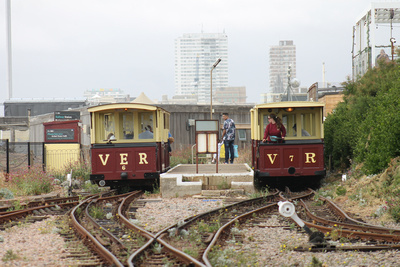 Into the 2000s and the ex Southend cars were withdrawn as surplus and moved on with no 8 going back to Southend and being displayed in a glass box at the pier museum and no 9 going to the South Downs Heritage Centre. Cars 1, 2 and 5 then reverted back to their pre 1948 numbers of 10, 9 and 8.
Into the 2000s and the ex Southend cars were withdrawn as surplus and moved on with no 8 going back to Southend and being displayed in a glass box at the pier museum and no 9 going to the South Downs Heritage Centre. Cars 1, 2 and 5 then reverted back to their pre 1948 numbers of 10, 9 and 8.
After receiving Heritage Lottery funding in 2015, work was started on a major upgrade of the facilities on the line, which was badly needed as the car sheds had been condemned. The carsheds were completely flattened and rebuilt, with the Tunnel being retained through the car shed! Meanwhile the station building at Aquarium was also demolished and rebuilt, complete with a small visitor centre, ticket office and takeaway cafe built in. The car fleet also received some work with major restoration / rebuilt works being carried out on cars 4, 6 and 10. With car 3 also in the midst of a rebuild, the future of the VER is looking good!
Fleet List
|
Original Fleet Number |
Fleet Number (1948-2000) |
Current Fleet Number |
Car Type |
Year Built |
Seating Capacity |
Built By |
Current Status |
Notes |
Photo |
|
1 (I) |
N/A |
N/A |
Open |
1883 |
10 |
William Pollard |
scrapped |
Original car from the original demonstration line, could not be regauged from 2ft - 2ft 8 1/2 inches, scrapped 1884 |
|
|
1(II) |
N/A |
N/A |
Semi-Open |
1884 |
30 |
Unknown |
scrapped |
suffered the effects of outside storage for a long period during wartime, was too far gone for repair and scrapped in 1948 |
|
|
2 |
N/A |
N/A |
Semi-Open |
1885 |
30 |
Unknown |
scrapped |
suffered the effects of outside storage for a long period during wartime, was too far gone for repair and scrapped in 1948 |
|
|
3 |
3 |
3 |
Semi-Open |
1892 |
40 |
VER |
undergoing restoration |
Currently stripped awaiting restoration |
|
|
4 |
4 |
4 |
Semi-Open |
1892 |
40 |
VER |
in service |
received a major restoration between 2016-2018 |
|
|
5 (I) |
N/A |
N/A |
Semi-Open |
1896 |
30 |
VER |
scrapped |
Was in need of a major rebuild in late 1920s, was scrapped instead and replaced by 2nd no 5 |
|
|
5 (II) |
N/A |
N/A |
Closed |
1930 |
24 |
G Kelsey / VER |
scrapped |
Winter car, only car in fleet to have fully enclosed passenger saloons. Suffered the effects of outside storage for a long period during wartime, was too far gone for repair and scrapped in 1948 |
|
|
6 |
6 |
6 |
Semi-Open |
1901 |
40 |
VER |
in servce |
Received a major restoration 2016-2018, works as a pair with Car 10 |
|
|
7 |
7 |
7 |
Semi-Open |
1901 |
40 |
VER |
in service |
Works as a pair with car 8 |
|
|
8 (I) |
5 |
8 |
Semi-Open |
1901 |
40 |
VER |
in service |
Was numbered 5 between 1948 and 2000, works as a pair with car 7 |
|
|
8 (II) |
8 |
N/A |
Open |
1898 |
40 |
Falcon Works |
preserved |
Operational on VER from 1948 - late 1990s, now a static exhibit at Southend Pier Tramway |
|
|
9 (I) |
2 |
9 |
Open |
1926 |
40 |
VER |
in service |
Was numbered 2 between 1948 and 2000, works as a single car only |
|
|
9 (II) |
9 |
N/A |
Open |
1898 |
40 |
Falcon Works |
preserved |
Operational on VER from 1948 - late 1990s, now a static exhibit at South Downs Heritage Centre |
|
|
10 |
1 |
10 |
Open |
1926 |
40 |
VER |
in service |
Was numbered 1 between 1948 and 2000, works as a pair with car 6 |
.
Trip Report
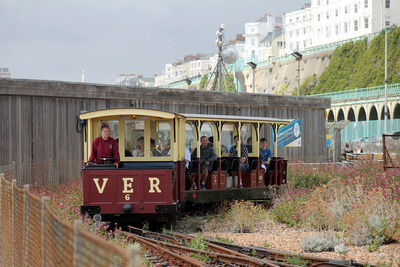 I visited the VER on 25th July 2022 whilst on a daytrip to Brighton. Having only intended to visit for a very short time, I actually ended up spending longer than I expected on the railway (about 3 hours!).
I visited the VER on 25th July 2022 whilst on a daytrip to Brighton. Having only intended to visit for a very short time, I actually ended up spending longer than I expected on the railway (about 3 hours!).
Having never been in Brighton before, I decided to catch the City Sightseeing bus round to get my bearings, it was an interesting experience, especially losing my baseball cap, which blew off on the top deck and was squashed by a passing car!
I arrived at the Aquarium station, which is a couple of minutes walk from the Palace Pier and the City Sightseeing bus stop and bought my ticket then had a look round the visitor centre at the interesting displays and artifacts from the history of the line while I waited for the train to arrive. I didn't have long to wait as the trains run every 15 minutes as 1901 built Semi Open Cars 8 + 7 soon arrived and I boarded the open section of car 8, which would be the rear portion of the train for the mile long journey to Black Rock. We soon departed at a leisurely pace heading to Halfway, where we would await the arrival of the other train in service, made up of 1926 built open car 10 and 1901 semi open car 6 to allow the drivers to swap tokens for each stretch of single line. We continued our journey, passing through the tunnel, where car 4 and some permanent way vehicles were visible on the right hand side of the shed. All too soon we reached the terminus at Black Rock, where we all had to leave the train and reboard it although the driver was kind enough to let me take some photos of the train before I left the platform.
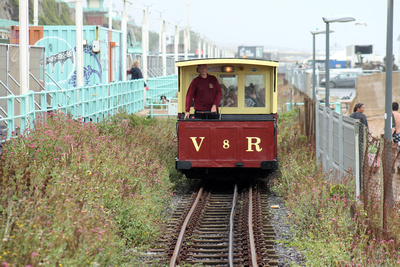 I then joined the queue to reboard and this time I sat in the open section of car 7. On arrival at Halfway, I got off to take some photographs of the trains before heading to the workshop gallery to view the depot. Unfortunately the viewing gallery was closed, however I managed to photograph 1926 built Open Car 9 and a pw trailer, which were stabled in the left hand side of the depot from the station platform. Also out on the lineside at Halfway were some old wheels on axles and an old wooden underframe, which I assume was from Car 3 as it is currently undergoing an overhaul.
I then joined the queue to reboard and this time I sat in the open section of car 7. On arrival at Halfway, I got off to take some photographs of the trains before heading to the workshop gallery to view the depot. Unfortunately the viewing gallery was closed, however I managed to photograph 1926 built Open Car 9 and a pw trailer, which were stabled in the left hand side of the depot from the station platform. Also out on the lineside at Halfway were some old wheels on axles and an old wooden underframe, which I assume was from Car 3 as it is currently undergoing an overhaul.
After taking some more photographs from different locations around Halfway station, I caught Open Car 10+Semi Open Car 6 back to Aquarium, and I decided to take some more photos around that area, when the heavens opened and there was a heavy shower! After getting a few photographs, I made my way back into Brighton to catch the tour bus.
I'd like to thank the Volk's Electric Railway Association for allowing me to use some of their archive photographs in this post. My photos from the trip can be found at: https://scottishtrains.zenfolio.com/p588123192
I would definatley recommend a visit, the price of £5.60 for adults and £3.50 return for children is worth the money, the cars are all well kept and the staff are extremely friendly and helpful and will answer any questions that you have! To find out more about the Volk's Electric Railway (VER) and the Volk's Electric Railway Association (VERA), please visit their websites: https://volksrailway.org.uk/ VER: VERA: http://volkselectricrailway.co.uk/
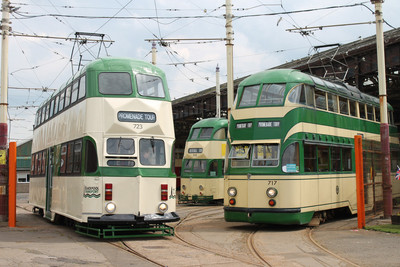 On Thursday 2nd June, I headed down to Blackpool for the day to see the Jubilee Heritage Tram Parade.
On Thursday 2nd June, I headed down to Blackpool for the day to see the Jubilee Heritage Tram Parade.
I arrived in Blackpool around 11.30am and it was already very busy and my usual car park of choice at Pleasure Beach was already full, however I managed to get parked outside the Solaris Centre at Harrowside. I walked up the prom to Manchester Square and round to Rigby Road depot where the trams for the parade were beginning to be shunted round and sorted into order before heading out to the Prom and down to Pleasure Beach for the parade.
The first tram out was red and cream liveried Boat car 227, which was to lead the parade, it was stabled on Hopton road, whilst Balloon 723 was shunted down to the far end of the depot fan and 717 was shunted onto the Electrical compound track to release Boat 600 to move off depot to be stabled on Hopton Road behind Boat 600. Next out was Brush Car 631, which was moved out onto Hopton Road and parked up behind 227 and 600. The fourth tram to leave depot was a nice surprise in 90s Green and Cream liveried Ex Towing Railcoach 680, which was making its first appearance since March 2020 (pre lockdown).
After the trams were checked over by their crews, 227 and 600 departed Hopton Road, turned on to Lytham Road and onto the prom. After being reversed at Foxhall, they made their way to Pleasure Beach for the parade. Once 227 and 600 were clear of Lytham Road, 631 and 680 followed suit.
Next the Frigate 'HMS Blackpool' 736 was brought out on to Hopton Road to reverse onto Blundell Street where it stabled alongside the Fitting Shop wall. Balloon 723, freshly out the Paint Shop in the modernised balloon version of the 90s Green and Cream with black window surrounds, was then shunted out onto Hopton Road and then shunted back into one of the depot roads to release Fisherman's Friend trawler 737. 737 was also shunted out onto Hopton Road and reversed onto Blundell Street in front of 736. 80s Green and Cream liveried Centenary car 648 was then brought out and headed straight to the prom to take up position 5 in the parade. 648 was followed by the Western Train (733+734), which came out with the carriage leading so that it was facing the correct way once it changed ends at Foxhall.
Once the Western Train was clear of Hopton Road, the trawler (737) was turned on the triangle so it was heading out in reverse, with 736 completing the same move with both trams then departing towards the prom. One final shunt move saw Balloon 717 moved off the electrical compound track and onto Hopton Road before being moved further back the depot fan to release Bolton 66. Balloon 717 would then be the next tram to depart towards the prom followed by Balloon 723, Balloon 700 and Millenium Balloon 707.
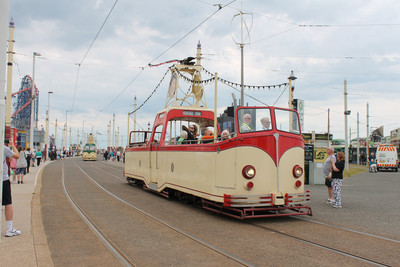 I then walked down to Pleasure Beach where the loop was choc-a-block with heritage trams, passengers, sightseers and enthusiasts! After a few photos on the loop, I took up position near the entrance to the loop and photoed the parade, which featured 13 trams. These were:
I then walked down to Pleasure Beach where the loop was choc-a-block with heritage trams, passengers, sightseers and enthusiasts! After a few photos on the loop, I took up position near the entrance to the loop and photoed the parade, which featured 13 trams. These were:
- Boat 227
- Boat 600
- Brush Car 631
- Ex Towing Railcoach 680
- Centenary 648
- The Western Train (733+734)
- Fisherman's Friend Trawler (737)
- Frigate 'HMS Blackpool' (736)
- Bolton 66
- Balloon 717
- Balloon 723
- Balloon 700
- Millennium Balloon 707
Once the parade departed, I walked up towards Manchester Square to see the trams returning, with all bar Boat 227, Boat 600, Bolton 66 and Balloon 717 returning to depot. Rather than running straight in, The Western Train ran to Pleasure Beach and back to Foxhall where it reversed in.
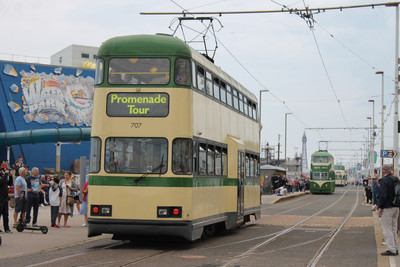 Boat 227, Boat 600, Bolton 66 and Balloon 717 operated a Heritage service between Pleasure Beach and Bispham between 4pm and 7pm, however Boat 600 failed at Bispham and was replaced by Balloon 723. After 7pm, the Western Train operated two evening tours between Pleasure Beach and Little Bispham to round off an excellent day.
Boat 227, Boat 600, Bolton 66 and Balloon 717 operated a Heritage service between Pleasure Beach and Bispham between 4pm and 7pm, however Boat 600 failed at Bispham and was replaced by Balloon 723. After 7pm, the Western Train operated two evening tours between Pleasure Beach and Little Bispham to round off an excellent day.
Well done to everyone at Blackpool Transport, Heritage Tram Tours and Tramtown for organising such an excellent event!
More photos from the day can be found at: https://scottishtrains.zenfolio.com/p50243848
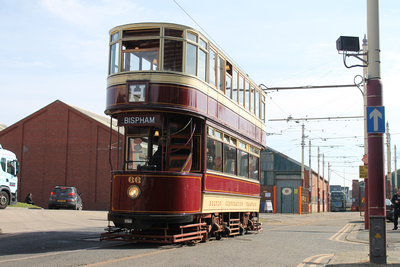 Over the Bank Holiday weekend of 30th April - 2nd May, Blackpool Heritage Tram Tours held a Vintage Weekend with Heritage trams running along the prom every 15 minutes and hourly to Fleetwood. As well as the trams, there was vintage bus rides to Fleetwood and to Lytham St Annes!
Over the Bank Holiday weekend of 30th April - 2nd May, Blackpool Heritage Tram Tours held a Vintage Weekend with Heritage trams running along the prom every 15 minutes and hourly to Fleetwood. As well as the trams, there was vintage bus rides to Fleetwood and to Lytham St Annes!
I visited on Saturday 30th April and after a reasonably quiet journey down the M74, M6 and M55, I arrived at Blackpool and parked up at Pleasure Beach at 9.30am, in the reasonably warm sunshine! I walked from Pleasure Beach up to Manchester Square then round to Rigby Road depot to see the heritage trams coming off depot and going into service.
Heritage trams in Service were Route A: 631, B: Boat 600 (in place of the advertised Boat 227), C: Illuminated Frigate 736, D: Centenary 648, E: Balloon 715 and F: Bolton 66. Also out was Balloon 717 on a private hire.
At 10.30am I joined the first of two Tramtown tours of the day and as it was a good deal drier and sunnier than my last time on the tour in February when it snowed! The tour began outside in the yard where after the safety briefing, we walked along the side of the workshops past the depot fan and round to the Paint Shop.
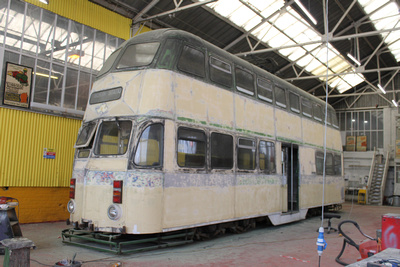 In the paint shop was Balloon 723, which has been stripped of it's Christmas vynals and had the 80s livery that was underneath the vynals sanded down ready for a repaint into an as yet undisclosed livery. It was interesting to hear that the trams are still hand painted using brushes rather than being spray painted as the brushed on paint gives a thicker coat that lasts longer in the harsh salt and sand ladened environment of Blackpool. We also heard how there is now only one painter, who deals with all the heritage tram fleet as well as touching up bus panels as well, the painter does a fantastic job with some stunning paint jobs on display on the heritage fleet!
In the paint shop was Balloon 723, which has been stripped of it's Christmas vynals and had the 80s livery that was underneath the vynals sanded down ready for a repaint into an as yet undisclosed livery. It was interesting to hear that the trams are still hand painted using brushes rather than being spray painted as the brushed on paint gives a thicker coat that lasts longer in the harsh salt and sand ladened environment of Blackpool. We also heard how there is now only one painter, who deals with all the heritage tram fleet as well as touching up bus panels as well, the painter does a fantastic job with some stunning paint jobs on display on the heritage fleet!
The tour then moved into the Body Shop where Brush Car 634 in its new Terror Tram advert was stabled awaiting attention prior to a potential entry into service later this year, also there were the bodies of Lytham 31 and Glasgow 1016, both of which are future major restoration projects. It was interesting to hear how both trams came to be snapped up by Heritage Tram Tours and the future plans for both trams. One current major restoration project on the tramway is that of Balloon 704. 704 has been stripped to its basic framework awaiting the fitting of a new underframe as it's current one is life expired and drooping at the ends. Once some repair work has been done on the current body frame, 704's frame will be transferred onto a new underframe that we will see in the next part of the tour, the fitting shop.
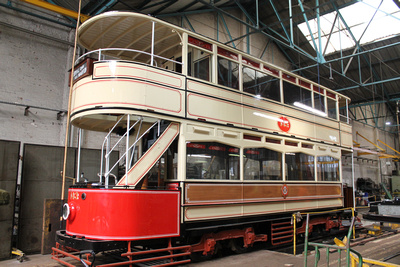 In the fitting shop, we see the large array of blacksmiths tools and the forge that alot of spare parts are made in. Due to the age of the fleet, parts are not available off the shelf so have to be made. One item that has been made recently from scratch is a complete replacement underframe, which will go under Balloon 704. The underframe for 704 which was built by one engineer working from a set of plans initially drawn up 90 years ago and found in the heritage archives. Again, this highlights the 'can do' attitude of the staff and volunteers at Heritage Tram Tours, Tram Town and Blackpool Transport.
In the fitting shop, we see the large array of blacksmiths tools and the forge that alot of spare parts are made in. Due to the age of the fleet, parts are not available off the shelf so have to be made. One item that has been made recently from scratch is a complete replacement underframe, which will go under Balloon 704. The underframe for 704 which was built by one engineer working from a set of plans initially drawn up 90 years ago and found in the heritage archives. Again, this highlights the 'can do' attitude of the staff and volunteers at Heritage Tram Tours, Tram Town and Blackpool Transport.
Also in the Fitting Shop was Standard 143. Standard 143 was transferred to the Fylde Transport Trust in 2003 to restore from a fire damaged works tram back to its original condition as a 1924 built Standard Car. As it was discovered that there was an issue with one of 143s motors following restoration, the motors from Standard 147 have been transferred to 143 to allow the tram to enter service hopefully by the summer and 147 will also be back in service once the repaired motors have returned from the company who are repairing them.
Another feature of the Fitting shop that we got to see was the gas ring that is used to remove old tyres from the tram wheels and for the fitting of new tyres.
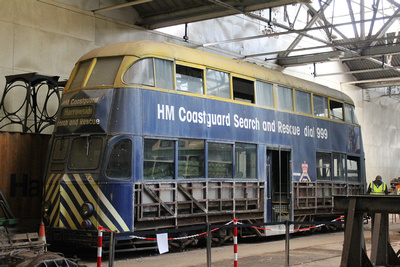 We then crossed over to the main depot building, where it is safe to say that the roof is in a sorry state and full of holes. Part of the reason for Tramtown being set up and the tours running is to help to raise some of the money required to replace the roof and to allow the tram fleet to be in a far more protected environment which will protect the heritage fleet from the elements. Future plans also include the current engineering facilities in the workshops being moved over into the main depot as well as the building being used as a visitor centre for the tramway, however not of the 'stuffed and mounted' variety where every tram in it becomes a non runner. Tramtown want the trams to be running out on the prom and also eventually to bring visitors to Tramtown by tram!
We then crossed over to the main depot building, where it is safe to say that the roof is in a sorry state and full of holes. Part of the reason for Tramtown being set up and the tours running is to help to raise some of the money required to replace the roof and to allow the tram fleet to be in a far more protected environment which will protect the heritage fleet from the elements. Future plans also include the current engineering facilities in the workshops being moved over into the main depot as well as the building being used as a visitor centre for the tramway, however not of the 'stuffed and mounted' variety where every tram in it becomes a non runner. Tramtown want the trams to be running out on the prom and also eventually to bring visitors to Tramtown by tram!
One thing you'll notice when you visit Tramtown is that there are always improvements from your last visit! In the space of 2 months, some new viewpoints have opened up within the sheds allowing you to get closer to and photograph more of the fleet, various parts of the depot have received a new coat of paint including the track numbers having been repainted on the ground on the depot fan. Last time we got to sit onboard Bolton 66, this time we got to sit on board Coronation 660 and found out some of the interesting history of the fleet of 25 Coronation trams that were meant to revolutionise the tramway in the 1950s but had a short working life and were mostly scrapped by the 1970s.
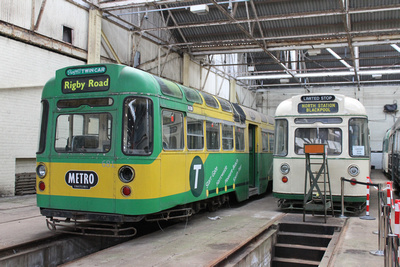 We were then taken to the first of the new viewing areas opened up where we heard some of the history of the illuminated fleet in front of the long stored Hovertram 735. The viewing area also gave the chance for a close look at Brush cars 625 and 632 as well as Twin Car trailers 681 and T2.
We were then taken to the first of the new viewing areas opened up where we heard some of the history of the illuminated fleet in front of the long stored Hovertram 735. The viewing area also gave the chance for a close look at Brush cars 625 and 632 as well as Twin Car trailers 681 and T2.
The next new viewing area gave a view of Princess Alice - Open topped Balloon 706, which is awaiting a new underframe and the long stored 'Tramnik 1' the Rocket tram 732. The final stop of the visit was to the Electrical Compound to see the Western Train and a visit to the shop, where I purchased a TramTown planter for my garden!
Before I left Tram Town, I asked our helpful guide if I could get a couple of photos of Balloons 700 and 703 and Railcoach 279, which is nearing completion of its restoration back to a series 2 EE Railcoach.
I would definately recommend a visit to TramTown for not just enthusiasts, but anyone who is interested in history! Tramtown run tours of the depot every Saturday and Monday both as a depot tour (approx. 1 hr 30 mins) or as a family tour (approx. 45 mins). Available dates and times can be found on their website: https://blackpoolheritage.com/guided-depot-tours/
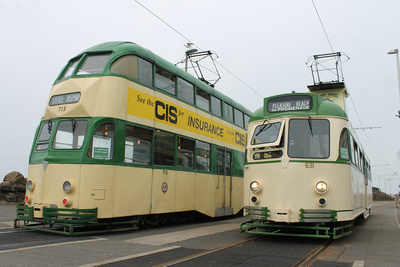 After the tour, I made my way back to the prom and caught Centenary tram 648 to Pleasure Beach (to put my new planter in the car!). I then caught Bolton 66 to Bispham, where I got off to take some photos! Next I caught Balloon 715 to Little Bispham and back before switching to Boat 600 for a rather breezy run to Thornton Gate and back to Bispham! I then caught Centenary 648 to Little Bispham then back down to Pleasure Beach, where I took some more photos then headed home!
After the tour, I made my way back to the prom and caught Centenary tram 648 to Pleasure Beach (to put my new planter in the car!). I then caught Bolton 66 to Bispham, where I got off to take some photos! Next I caught Balloon 715 to Little Bispham and back before switching to Boat 600 for a rather breezy run to Thornton Gate and back to Bispham! I then caught Centenary 648 to Little Bispham then back down to Pleasure Beach, where I took some more photos then headed home!
More Photos from my trip can be found at: https://scottishtrains.zenfolio.com/p820301502
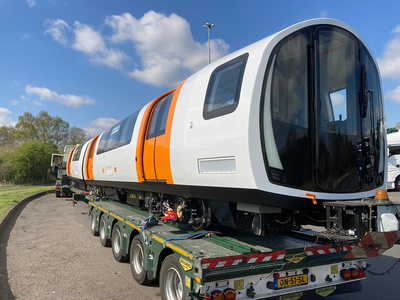 Today as I was driving along the M74 and passing Hamilton Services (Northbound only services between Junction 6 Hamilton / Motherwell and Junction 5 Raith Interchange) I happened to notice one half of one of one of the new Glasgow Subway Trains on the back of a low loader in the lorry park so decided to visit the services to investigate!
Today as I was driving along the M74 and passing Hamilton Services (Northbound only services between Junction 6 Hamilton / Motherwell and Junction 5 Raith Interchange) I happened to notice one half of one of one of the new Glasgow Subway Trains on the back of a low loader in the lorry park so decided to visit the services to investigate!
It so happened that the other half of the same set was also parked up at the far end of the lorry park! The as yet unidentified set number was enroute to Broomloan Depot from Altenrheim in Switzerland and was being held at Hamilton Services until later in the day when the remainder of the route into Glasgow was a bit quieter with less traffic.
Glasgow Subway have ordered 17 Stadler built 4 car Metro trains to replace the 32 1970s built Metro Cammell Motor Cars and 8 1992 built Barclay trailers which are currently used on the system. The new trains are made up of 2 longer outer cars with 2 shorter centre cars and should be roughly the size of the trains they are replacing, with the added advantages of being fully accessible and each vehicle being interconnected, which is not the case just now. Once fully in service, these trains will eventually operate in Driverless mode, with the stations being adapted to have platform screen doors, where the screen doors line up with the train doors and open and close at the same time as the train doors.
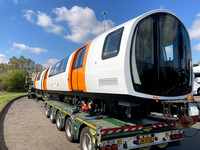
|
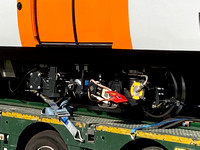
|
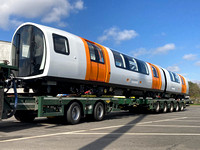
|
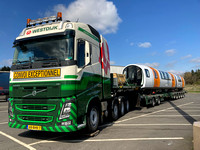
|
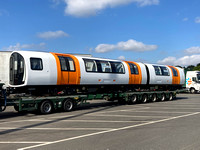
|
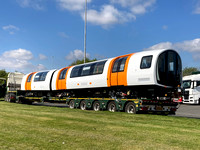
|
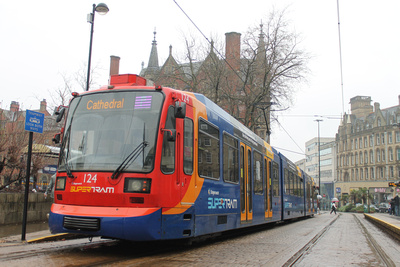 The Sheffield Supertram network is a series of three tram and one experimental Tram-Train line in the city of Sheffield, with the Tram-Train line also service the town of Rotherham.
The Sheffield Supertram network is a series of three tram and one experimental Tram-Train line in the city of Sheffield, with the Tram-Train line also service the town of Rotherham.
The Supertram network opened in stages between 1994 and 1995 as follows:
- 21.3.94: Meadowhall - Fitzalan Square
- 22.8.94: Spring Lane - Fitzalan Square
- 5.12.94: Spring Lane - Gleadless Townend
- 18.2.95: Fitzalan Square - Cathedral
- 27.2.95: Cathedral - Shalesmoor
- 27.3.95: Gleadless Townend - Halfway
- 3.4.95: Gleadless Townend - Herdings Park
- 23.10.95:Shalesmoor - Middlewood / Malin Bridge
An additional extension in the form of a Tram-Train line, where the Tram-Train operated as a normal tram from Cathedral to Meadowhall South / Tinsley opened in 2018. Just past this stop, there is a junction which takes the tramway onto the Heavy rail network, and after a quick stop to change from Tramway control to Network Rail signalling, the TramTrain travels along the heavy rail line, with stops at Rotherham Central, where the stop is configured with tram train platforms and heavy rail platforms next to each other, before the line continues onwards to Rotherham Parkgate. If and when the heavy rail line to and through Rotherham is electrified, the built in switching equipment to allow the trams to change from the tramway's 750 volt power to the 25Kv Network Rail OHLE will come into use.
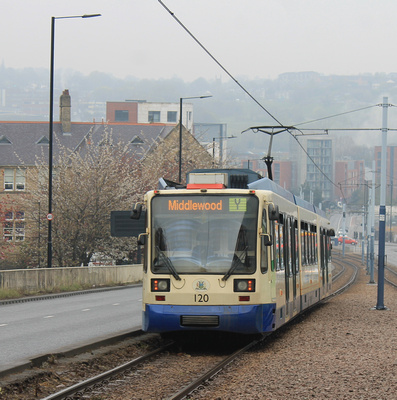 The services are formed with three colour coded routes and the Tram-Train serving the city centre, suburbs, shopping centres and park and rides with 50 tram stops around the city.
The services are formed with three colour coded routes and the Tram-Train serving the city centre, suburbs, shopping centres and park and rides with 50 tram stops around the city.
The 4 routes are:
- The Purple Route: Cathedral - Herdings Park (hourly)
- The Blue Route: Malin Bridge - Halfway (12 minutes)
- The Yellow Route: Middlewood - Meadowhall Interchange (12 minutes)
- Tram-Train Route (TT): Catherdral - Rotherham Parkgate (half hourly)
The routes themselves featured a mixture of on street running, seperate reservations and running on former / or alongside current heavy rail lines and all meet in the City Centre with all services serving the main stops of Cathedral, Castle Square and Fitzalan Square. Some impressive structures were built to carry the tramway over roads and existing railways with the bridge over Commercial Street and Park Square roundabout being particularly stunning. Just south of that bridge is also an impressive triangular junction allowing trams from the city centre / Malin Bridge / Middlewood to head left to Meadowhall / Rotherham Parkgate or right to Herdings Park / Halfway. The third end is rarely used and is mostly used for depot runs or diversions. Nunnery Depot, where the full fleet is maintained, can be found on the Yellow Route.
The Trams
The tram fleet is made up of two types of tram, these are the Duewags, consisting of 25 trams (numbered 101-125) and the Class 399 Stadler Citylink tram-trains (made up of 7 tram-trains numbered 399201-399207).
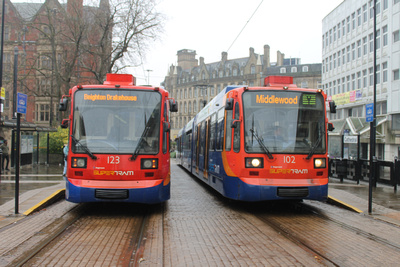 Siemens Duewags:
Siemens Duewags:
Built in 1992, the Siemens Duewag fleet have been the mainstay of the three all tram lines since the system opened. Each tram contains three articulated sections with two driving ends and a central section. The doors are found in the driving ends with 40% of each tram being low floor and step free access. Each tram holds 86 seated passengers with up to 155 standing passengers also accomodated.
Each tram has a maximum speed of 50mph and with every axle powered, can manage the gradients, some as steep as 10% across the network with ease.
Each tram underwent an overhaul between 2006 and 2009 with the majority being painted in the standard red, yellow and blue Stagecoach livery, with some exceptions.
Unfortunately due to not having the relevant Network Rail safety systems and crashworthiness, the Duewags cannot be used on the Tram-Train route between Meadowhall South / Tinsley and Rotherham Parkgate.
| Number | Livery | Status | Notes |
| 101 | Stagecoach Standard | In service | |
| 102 | Stagecoach Standard | In service | Following an accident in 1995, 102 was reformed with a driving end from 111 |
| 103 | Stagecoach Standard | In service | |
| 104 | Stagecoach Standard | In service | |
| 105 | Stagecoach Standard | Accident Repairs | Currently at Kilmarnock Bonnyton works for accident repairs |
| 106 | Stagecoach Standard | In service | |
| 107 | Stagecoach Standard | In service | |
| 108 | Stagecoach Standard | In service | |
| 109 | Stagecoach Standard | In service | |
| 110 | Stagecoach Standard | In service | |
| 111 | Advert for Prettylittlething.com | In service | Following an accident in 1995, 111 was reformed with a driving end from 102 |
| 112 | Advert for Stagecoach Supertram: on track for a greener future | In service | |
| 113 | Stagecoach Standard | In service | |
| 114 | Stagecoach Standard | In service | |
| 115 | Stagecoach Standard | In service | |
| 116 | Advert for XPO Logistics | In service | |
| 117 | Stagecoach Standard | In service | |
| 118 | Advert for Prettylittlething.com | In service | Following a collision in 2015, 118 was reformed with a driving end from 120. |
| 119 | Stagecoach Standard | In service | |
| 120 | Sheffield Corporation Blue and Cream | In service | Following a collision in 2015, 120 was reformed with a driving end from 118. |
| 121 | Stagecoach Standard | In service | |
| 122 | Stagecoach Standard | In service | |
| 123 | Stagecoach Standard with 21st Anniversary Window vynals | In service | |
| 124 | Stagecoach Standard | In service | |
| 125 | Stagecoach Standard | In service |
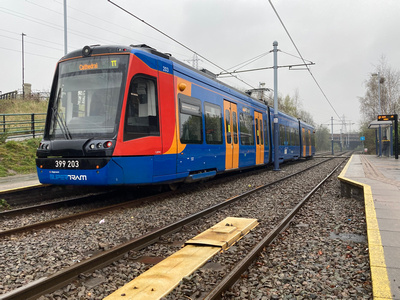 Stadler Citylink Tram-Trains:
Stadler Citylink Tram-Trains:
Built in 2015, the Stadler Citylink Tram-Trains have two main uses, numbers 399201-204 are allocated to operate on the Tram-Train service between Cathedral and Rotherham Parkgate , with numbers 399205-207 being used as Tram only and can operate on the Blue, Purple or Yellow routes to provide additional capacity.
Due to 201-204's wheels being profiled for heavy rail and 205-207's wheels being profiled for tram track, 201-204 are confined to the Tram-Train route and 205-207 are confined to tram routes.
The TramTrains consist of three sections and are fully low floor. They hold 96 seated and 150 standing passengers and have a maximum speed of 60mph.
| Number | Livery | Status | Notes |
| 399201 | Stagecoach Standard | In service | Tram-Train line use only |
| 399202 | Stagecoach Standard | In service | Tram-Train line use only. Named 'Theo' 399202 reformed with part of 399204 following a collision with a road vehicle on a level crossing. |
| 399203 | Stagecoach Standard | In service | Tram-Train line use only |
| 399204 | Stagecoach Standard | In service | Tram-Train line use only. 399204 reformed with part of 399202 following a collision with a road vehicle on a level crossing. |
| 399205 | Stagecoach Standard | In service | Tram line use only |
| 399206 | Stagecoach Standard | In service | Tram line use only. Initally used on Tram-train route, wheels reprofiled to tram profile 2020. |
| 399207 | Stagecoach Standard | In service | Tram line use only |
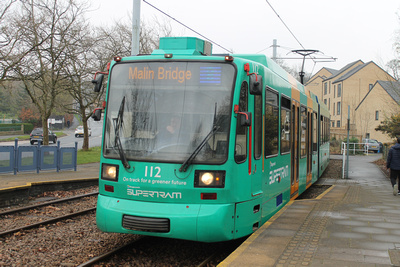 My trip:
My trip:
I only had just over 3 hours to spend in Sheffield on the 12th on my first ever trip to the area so had to make the most of it. I met up with @JamesTGlossop from Twitter, who showed me round! Firstly from Sheffield Station, we bought Day Tickets from the onboard conductor for the excellent price of £4.60 and headed into Sheffield onboard 108 on a Blue Route service towards Cathedral.
After a short time photoing here, we caught Tram 122 on a yellow route service to Meadowhall South / Tinsley, where we caught 399201 to Rotherham Parkgate then back to Meadowhall South/Tinsley. We then walked round to Meadowhall Interchange and caught 120 on a Yellow service as far as Netherthorpe Road.
After a few photos there, we caught 106 on a blue route service to Park Grange Croft, then 112 to Granville Road, where we got off and walked back to Sheffield station taking a few photos on the way!
On the day of my visit, trams on the Blue Route were terminating at Beighton / Drake House Lane due to overhead line issues.
Trams Seen:
Tram-Train 399201, 399203
Yellow Route: 122, 103, 101, 120, 102, 113
Blue Route: 115, 108, 112, 111, 117, 106, 123
Purple Route: 124
Not In Service (0): 109
On depot: 116, 119, 121
I'd definately recommend a visit to Sheffield for the trams and the Tram-Trains and hope to go back there sometime soon! For photos from my trip, either click on the links in the fleet lists above or visit my gallery at: https://scottishtrains.zenfolio.com/p1025895743
 The weekend of 19th and 20th February saw Blackpool Heritage Tram Tours first 'Gold Weekend' of 2022. The weekend was due to start of Friday 18th with an evening tour onboard the Western Train, however the tail end of Storm Eunice put paid to that and an additional tour operated on Saturday 19th instead.
The weekend of 19th and 20th February saw Blackpool Heritage Tram Tours first 'Gold Weekend' of 2022. The weekend was due to start of Friday 18th with an evening tour onboard the Western Train, however the tail end of Storm Eunice put paid to that and an additional tour operated on Saturday 19th instead.
The Gold Weekend saw the use of 6 heritage trams on a series of workings from Pleasure Beach to Little Bispham, Thornton Gate or Fisherman's Walk in Fleetwood. Due to gas pipe works in Fleetwood, both the service and heritage trams could not reach Fleetwood Ferry so terminated at Fisherman's walk instead. There was also the chance for a twice daily run by heritage bus to Fleetwood and back on both the Saturday and Sunday and twice daily tours of Rigby Road Depot.
The initial allocation for the Heritage Fleet on the Saturday was Diagram A: Balloon 717, Diagram B: Brush Car 631, Diagram C: Millennium Balloon 718, Diagram D Boat 600, Diagram E: Bolton 66 and Diagram F: Centenary 648. This was to be Centenary 648's first run in service since pre pandemic in early 2020. Due to the poor weather, Boat 600 and Bolton 66 were removed from the roster and replaced by the more suitable enclosed Brush Car 621 and Balloon 715.
I arrived in Blackpool around 10.15am to torrential rain. By the time I got parked at Pleasure Beach and made my way to Rigby Road depot, the rain had turned to rather large flakes of snow and spotted enroute were Brush Car 621 and Balloon 717! I was booked on to the 11am tour at Rigby Road and luckily we were allowed in early to take shelter in the main tram shed!
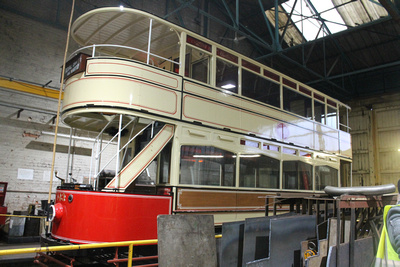 The tour began with a trip to the Fitting Shop, which incidentally was the warmest building on the tour! In the Fitting Shop was Standard 143, which had been getting attention to it's motors and was being prepared a potential return to service at Easter!
The tour began with a trip to the Fitting Shop, which incidentally was the warmest building on the tour! In the Fitting Shop was Standard 143, which had been getting attention to it's motors and was being prepared a potential return to service at Easter!
We were also shown the Blacksmith's forge and some of the tools used. Due to the uniqueness of the heritage fleet and the lack of spares, many of the replacement parts are home made in Rigby Road depot, an example of homemade parts was also layed out in the fitting shop in the form of a brand new underframe for Balloon 704, which was built by only one person!
Balloon 704 has been stripped to a shell for a heritage restoration back to 1950's style. It was good to hear that a second new underframe was also in the pipeline, this one being for open top Balloon 706, which is currently withdrawn.
We also saw the gas burner that is used for the removal / fitting of tyres to the wheels. Also seen in the Fitting shop was a couple of refurbished truck frames from a Centenary car.
Next we were taken into the Paint Shop, it was interesting to hear that all the buses and trams are still hand painted, being worked on at the time was a single and a double deck Palladium bus as well as the replica tank tram. The replica tank tram was a project by some local colleges to replicate a vehicle that would have been created from the body or around the frame of a disused tram on many systems across the country during World War 1 to raise money to buy tanks. There was also an interesting array of art work and posters on the wall.
 After the Paint Shop we moved next door and visited the body shop where the body and frames of Lytham 43 and Glasgow 1016 are stored along with a large scale model of Standard car 40, which was used as part of a display back in 1985 for the Centenary year.
After the Paint Shop we moved next door and visited the body shop where the body and frames of Lytham 43 and Glasgow 1016 are stored along with a large scale model of Standard car 40, which was used as part of a display back in 1985 for the Centenary year.
In the Body Shop, Work was well underway on the bodyframe being carried out on Balloon 704, which as mentioned above had been stripped to a shell for restoration to commence. Once its new underframe is complete, the old underframe will be rolled out from underneath it and scrapped, whilst the new frame is rolled underneath the body frame and work can commence on the restoration. Also in the body shop was Brush Car 634, which was repainted into Terror Tram advert during 2021, complete with skulls on the end, a recreation of an advert carried by the tram in the late 1990s. 634 was awaiting the fitting of a trolley tower and pantograph, to allow it to re-enter service for the first time since 2004.
One of the main reasons the tours are taking place is to help to raise funds to repair the roof of the main tram shed, which is in a terrible state with holes and leaks everywhere and that's where we headed next! We were firstly taken into the Electrical compound, which being the driest part of the main depot is used to store the boat cars and some others that are awaiting attention. Boats 600, 227 (602) and 230 (604) along with
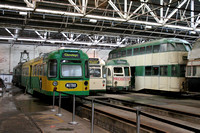 Centenary 642, Standard 147 and Millennium Balloon 707 were seen in there. We were then taken along the rear of the main sheds, where we saw some of the withdrawn trams such as Balloon 726, Coronation 304, Balloon 720, Brush car 290, Twin Cars 676+686 and 272+T2. We were then taken into Bolton 66 for a heat! At this point the main tour was over, though I would like to thank Paul, who took me round to the far side of the sheds to photo the hovertram, Balloon 708, Brush 625 and 632.
Centenary 642, Standard 147 and Millennium Balloon 707 were seen in there. We were then taken along the rear of the main sheds, where we saw some of the withdrawn trams such as Balloon 726, Coronation 304, Balloon 720, Brush car 290, Twin Cars 676+686 and 272+T2. We were then taken into Bolton 66 for a heat! At this point the main tour was over, though I would like to thank Paul, who took me round to the far side of the sheds to photo the hovertram, Balloon 708, Brush 625 and 632.
I then headed back to the prom and by this time, the snow had halted and had began melting. It was a strange sight seeing Brush Cars 621 and 631 with their fronts covered in snow! I caught Brush Car 631 up to Bispham for a few shots of the trams in the snow, then caught 718 down to North Pier. On reaching North Pier, Balloon 711 had appeared in the loop and was being used as the shop tram and the sun had came out! After getting a few photos at North Pier, I walked back along the prom in the wall to wall sunshine, taking photos of the t
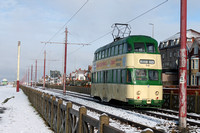 rams on the way. I reached Pleasure Beach at 3.20 and was hoping to catch a couple of photos of 648, however the tram had suffered from a loss of power fault and by the time it was repaired, it was over 20 minutes late in reaching Pleasure Beach. 648 was returned to depot and Balloon 711 took over the remainder of 648's duties. It was at this point it was time for me to head back home.
rams on the way. I reached Pleasure Beach at 3.20 and was hoping to catch a couple of photos of 648, however the tram had suffered from a loss of power fault and by the time it was repaired, it was over 20 minutes late in reaching Pleasure Beach. 648 was returned to depot and Balloon 711 took over the remainder of 648's duties. It was at this point it was time for me to head back home.
Overall, it was an enjoyable day, I'd thoroughly reccomend the depot tour though you will need to be quick to book as they are fully booked up for months! More photos from the day can be found at: https://scottishtrains.zenfolio.com/p490848536
My entire collection of Blackpool Tram photos from 2003 to today can be found at: https://scottishtrains.zenfolio.com/f595940839
I was clearing out my Portable Hard Drive and came across a list of some of my journeys of class 303s and 314s from 2000 and 2001. It's not a complete record as it only features the days that I actually remembered to keep a note! It does however give a snapshot of what was operating on both the Argyle and Cathcart Circle lines in the final years of 303 operation.
Class 303s in service during this period were: 303001, 003, 004, 006, 008, 009, 010 (till Dec 2000), 011, 012, 013, 014, 015, 016, 019, 020, 021, 023, 025 (till Sep/Oct 2000), 027, 032, 033, 034, 037, 043, 045, 047, 054, 056, 058 (till Sep 2000), 065, 070, 077, 079, 080, 083, 085, 087, 088, 090, 091.

29th August 2000:
- 7.44 Lanark - Garscadden Express: 303070+303034
- 8.50 Glasgow Central - Neilston: 314208
- 12.13 Mount Florida - Glasgow Central: 314205
- 12.38 Dalmuir - Motherwell: 303045
30th August 2000:
- 7.44 Lanark - Garscadden Express: 303025+303021
- 8.50 Glasgow Central - Neilston: 314203
- 16.13 Mount Florida - Glasgow Central: 314210+314206
- 16.44 Dalmuir - Lanark: 303085
1st September 2000:
- 8.02 Carstairs - Garscadden Express: 303033
- 8.50 Glasgow Central - Neilston: 314205
- 12.13 Mount Florida - Glasgow Central: 303008
- 12.38 Dalmuir - Motherwell: 303083
4th September 2000:
- 7.44 Lanark - Garscadden Express: 303006+303065
- 8.50 Glasgow Central - Neilston: 314207
- 12.13 Mount Florida - Glasgow Central: 314206
- 12.38 Dalmuir - Motherwell: 303019
5th September 2000:
- 7.44 Lanark - Garscadden Express: 303077+303054
- 8.50 Glasgow Central - Neilston: 314216
- 12.13 Mount Florida - Glasgow Central: 314206
- 12.38 Dalmuir - Motherwell: 303087
6th September 2000:
- 7.44 Lanark - Garscadden Express: 303016+303043
- 8.50 Glasgow Central - Neilston: 314205
- 12.13 Mount Florida - Glasgow Central: 314207
- 12.38 Dalmuir - Motherwell: 303001
7th September 2000:
- 8.02 Lanark - Garscadden Express: 303021
- 8.50 Glasgow Central - Neilston: 314213
- 16.13 Mount Florida - Glasgow Central: 303014+303077
- 16.44 Dalmuir - Lanark: 303020+303088
8th September 2000:
- 7.44 Lanark - Garscadden Express: 303025+303012
- 8.50 Glasgow Central - Neilston: 314216
- 12.13 Mount Florida - Glasgow Central: 314213
- 12.38 Dalmuir - Motherwell: 303001
11th September 2000:
- 7.44 Lanark - Garscadden Express: 303020+303013
- 8.50 Glasgow Central - Neilston: 314214
- 12.13 Mount Florida - Glasgow Central: 314214
- 12.38 Dalmuir - Motherwell: 303033
13th September 2000:
- 8.02 Carstairs - Garscadden Express: 303013
- 8.50 Glasgow Central - Neilston: 314202
- 12.13 Mount Florida - Glasgow Central: 314212
- 12.38 Dalmuir - Motherwell: 303087
14th September 2000:
- 7.44 Lanark - Garscadden Express: 303006+303045
- 8.50 Glasgow Central - Neilston: 314205
- 12.13 Mount Florida - Glasgow Central: 314204
- 12.38 Dalmuir - Motherwell: 303004
8th September 2000:
- 7.44 Lanark - Garscadden Express: 303025+303012
- 8.50 Glasgow Central - Neilston: 314216
- 12.13 Mount Florida - Glasgow Central: 314213
- 12.38 Dalmuir - Motherwell: 303001
5th December 2000:
- 7.44 Lanark - Garscadden Express: 303025+303083
- 8.50 Glasgow Central - Neilston: 314206
- 12.13 Mount Florida - Glasgow Central: 314206
- 12.38 Dalmuir - Motherwell: 303047
6th December 2000:
- 8.02 Lanark - Garscadden Express: 303083
- 8.50 Glasgow Central - Neilston: 314213
- 12.13 Mount Florida - Glasgow Central: 314213
- 12.38 Dalmuir - Motherwell: 303043
7th December 2000:
- 7.44 Lanark - Garscadden Express: 303085+303032
- 8.50 Glasgow Central - Neilston: 314206
- 12.13 Mount Florida - Glasgow Central: 314206
- 12.38 Dalmuir - Motherwell: 303014
8th December 2000:
- 8.02 Carstairs - Garscadden Express: 303001
- 8.50 Glasgow Central - Neilston: 314206
- 12.13 Mount Florida - Glasgow Central: 314206
- 12.38 Dalmuir - Motherwell: 303014
11th December 2000:
- 8.02 Carstairs - Garscadden Express: 303003
- 8.50 Glasgow Central - Neilston: 314206
- 12.13 Mount Florida - Glasgow Central: 314206
- 12.38 Dalmuir - Motherwell: 303009
12th December 2000:
- 8.02 Carstairs - Garscadden Express: 303003
- 8.50 Glasgow Central - Neilston: 314213
- 12.13 Mount Florida - Glasgow Central: 314214
- 12.38 Dalmuir - Motherwell: 303016
13th December 2000:
- 8.02 Carstairs - Garscadden Express: 303008
- 8.50 Glasgow Central - Neilston: 314204
- 12.13 Mount Florida - Glasgow Central: 314208
- 12.38 Dalmuir - Motherwell: 303033
15th January 2001:
- 7.50 Motherwell - Dalmuir: 303070+303088
- 8.50 Glasgow Central - Neilston: 314209
- 12.13 Mount Florida - Glasgow Central: 314212
- 12.38 Dalmuir - Motherwell: 303023
23rd January 2001:
- 7.50 Motherwell - Dalmuir: 303088+303077
- 8.50 Glasgow Central - Neilston: 303021
- 12.13 Mount Florida - Glasgow Central: 303027
- 12.38 Dalmuir - Motherwell: 303047
30th January 2001:
- 7.44 Lanark - Garscadden express: 303003
- 8.50 Glasgow Central - Neilston: 314209
- 12.13 Mount Florida - Glasgow Central: 314212
- 12.38 Dalmuir - Motherwell: 303085
7th February 2001:
- 7.44 Lanark - Garscadden express: 303083+303033
- 8.50 Glasgow Central - Neilston: 314216
- 12.13 Mount Florida - Glasgow Central: 314203
- 12.38 Dalmuir - Motherwell: 303088
13th February 2001:
- 7.44 Lanark - Garscadden express: 303020+303043
- 8.50 Glasgow Central - Neilston: 314209
- 15.50 Mount Florida - Glasgow Central: 318258
- 16.44 Dalmuir - Lanark: 303045
19th February 2001:
- 7.44 Lanark - Garscadden express: 303013+303012
- 8.50 Glasgow Central - Neilston: 314204
- 12.13 Mount Florida - Glasgow Central: 314204
- 12.38 Dalmuir - Motherwell: 303020
20th February 2001:
- 7.44 Lanark - Garscadden express: 303014+303034
- 8.50 Glasgow Central - Neilston: 314205
- 12.13 Mount Florida - Glasgow Central: 314204
- 12.38 Dalmuir - Motherwell: 303037
25th February 2001:
- 7.44 Lanark - Garscadden express: 303037+303027
- 8.50 Glasgow Central - Neilston: 314201
- 16.13 Mount Florida - Glasgow Central: 303011
- 16.38 Dalmuir - Motherwell: 303085
- 16.44 Dalmuir - Lanark: 303009+303019
6th March 2001:
- 7.44 Lanark - Garscadden express: 303014+303090
- 8.50 Glasgow Central - Neilston: 314204
- 12.13 Mount Florida - Glasgow Central: 314209
- 12.38 Dalmuir - Motherwell: 303047
7th March 2001:
- 7.44 Lanark - Garscadden express: 303070+303090
- 8.50 Glasgow Central - Neilston: 314204
- 16.13 Mount Florida - Glasgow Central: 314206+314213
- 16.44 Dalmuir - Lanark: 303008
8th March 2001:
- 7.44 Lanark - Garscadden express: 303090+303011
- 8.50 Glasgow Central - Neilston: 303004
- 12.13 Mount Florida - Glasgow Central: 314214
- 12.38 Dalmuir - Motherwell: 303011
19th March 2001:
- 7.44 Lanark - Garscadden express: 303023
- 8.50 Glasgow Central - Neilston: 314213
- 16.13 Mount Florida - Glasgow Central: 314209
- 16.38 Dalmuir - Motherwell: 303085
- 16.44 Dalmuir - Lanark: 303088+303011
 Locomotive Services Limited's Intercity Swallow liveried 87002 'Royal Sovereign' along with matching set of Mark 3s and DVT 82136 visited Carlisle on 14th January.
Locomotive Services Limited's Intercity Swallow liveried 87002 'Royal Sovereign' along with matching set of Mark 3s and DVT 82136 visited Carlisle on 14th January.
They worked as 5Z50 from Crewe and as 5Z51 back to Crewe mid afternoon as ECS workings as test runs and route learning prior to working on tour duty to Glasgow Central on Thursday 26th January. 87002, the coaching stock and DVT 82136, looked fantastic in their heritage livery and a massive well done goes to all those who restored the vehicles back to this livery.
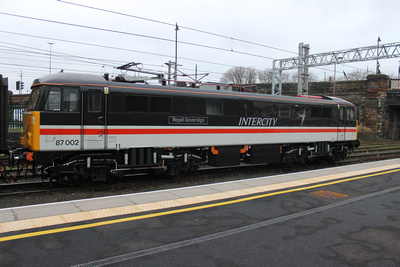
|

|
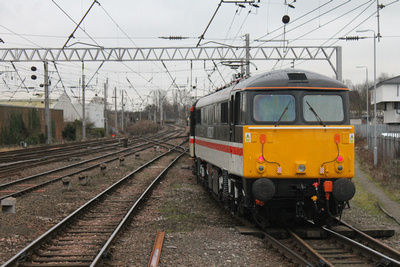
|
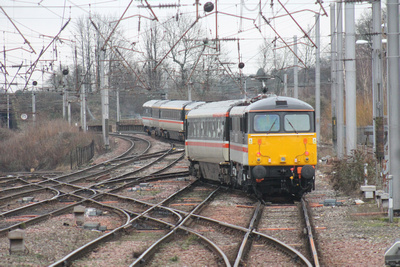
|
 303032 is one of the original set of 35 class 303s (Then known as class AM3) built in 1959 by Pressed Steel of Elderslie for the electrification of the North Clyde lines, a subsequent order of 56 sets raised in 1960 took the number of units up to 91. 303032 wore a succession of liveries starting with Caledonian Blue, then BR Blue and Grey then Strathclyde Transport 'Red' and Black livery from the 1980's through till withdrawal, receiving it's final repaint in the mid 1990's. 032 would operate on the North Clyde lines, Argyle Lines, Cathcart Circle and Clyde Coast lines over 42 years until withdrawal around June / July 2002.
303032 is one of the original set of 35 class 303s (Then known as class AM3) built in 1959 by Pressed Steel of Elderslie for the electrification of the North Clyde lines, a subsequent order of 56 sets raised in 1960 took the number of units up to 91. 303032 wore a succession of liveries starting with Caledonian Blue, then BR Blue and Grey then Strathclyde Transport 'Red' and Black livery from the 1980's through till withdrawal, receiving it's final repaint in the mid 1990's. 032 would operate on the North Clyde lines, Argyle Lines, Cathcart Circle and Clyde Coast lines over 42 years until withdrawal around June / July 2002.
After withdrawal, 303032 was taken to Immingham along with a number of sets that were going for scrapping. 303032 was the lucky one however as it was going for asbestos removal prior to preservation at Bo'ness. Unfortunately 303032's original Motor Coach (the centre coach) 61512 was damaged at Immingham and was scrapped, however 61512 was substituted for Carmine and Cream liveried 61503 from set 303023, which was there for scrapping. Both driving trailers (75597 and 75632) are 303032s originals. 303032 was returned to Bo'ness by low loader from Immingham for preservation in April 2003.
303032 is still occasionally hauled up and down the line at Boness by a Class 26, 27 or 37 working in blue star mode. A ride on the set during the diesel galas brings back memories including the sound of the door closing alarm, the hiss of the air brakes and the driver having to get out and force a set of doors closed before the set will move! 303032 is still in the same coat of paint as it was when it arrived at Boness with the trailers in Orange and Black Strathclyde Transport livery and the motor coach in the SPT Carmine and Cream livery. 303032 hasn't been used for many years and has been on display in the display shed. It was extracted from the shed and placed in the display siding for the Diesel Gala at Bo'ness on 29th December 2021.
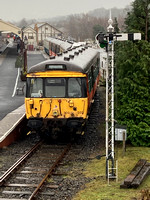
|
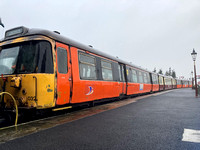
|
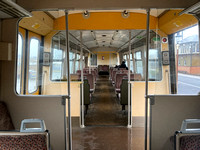
|
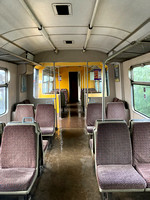
|
 The Bo'ness Diesel Gala took place on Wednesday 29th December. The gala featured the home fleet with BR Large logo liveried 37403 making its debut at Bo'ness following its time on hire to DRS, BR Blue liveried 37703 making its last appearance on loan from DRS, 47643 in its Scotrail Intercity livery and 27001 in BR Blue livery.
The Bo'ness Diesel Gala took place on Wednesday 29th December. The gala featured the home fleet with BR Large logo liveried 37403 making its debut at Bo'ness following its time on hire to DRS, BR Blue liveried 37703 making its last appearance on loan from DRS, 47643 in its Scotrail Intercity livery and 27001 in BR Blue livery.
The visiting locomotive was supplied by GBRF and was 66773 'Pride of GB Railfreight' with Pride rainbow branding.
On display was DRS liveried 20302+20305, which will shortly be leaving Bo'ness as well as Hydrogen Multiple Unit 614209 and former Blue Train: 303032, which was making it's first appearance out in the open for around 6 years.
It was torrential rain for most of the morning, which made photography difficult (and meant having to take most photographs on my phone instead of the camera), however the highlight was seeing 303032 out on display and having a look round the interior and seeing 37403+37703 double heading the 12.30 working.
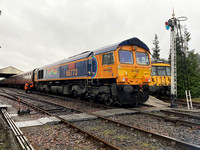
|
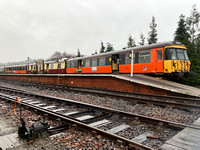
|
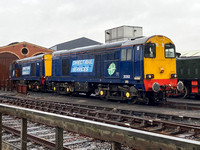
|
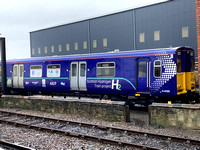
|
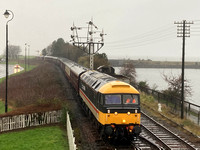
|
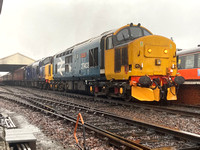
|
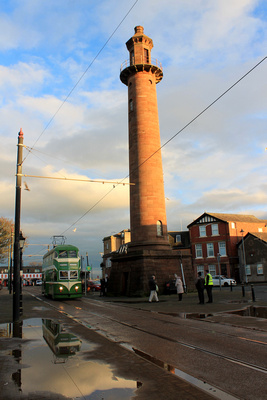 After 10 years in Blackpool Transport's 'Flexity' Purple and White livery, Balloon 700 has been repainted back into the Wartime Green and Cream livery that it carried during the 2nd World War and into the 1950's then again following a major overhaul in 1997 till it was sidelined for the addition of the door pods to make it compatable with the Flexity platforms in 2010.
After 10 years in Blackpool Transport's 'Flexity' Purple and White livery, Balloon 700 has been repainted back into the Wartime Green and Cream livery that it carried during the 2nd World War and into the 1950's then again following a major overhaul in 1997 till it was sidelined for the addition of the door pods to make it compatable with the Flexity platforms in 2010.
700 was initially due to make it's debut run back in Green and Cream at the Anniversary Weekend in September, however was sidelined with a door fault. On 28th December 2021, 700 was used for the FTS Christmas tour along with Atlantean bus 334 (which did a run along the long abandoned former street routes on Lytham Road and the former Marton summer extension terminus on Station Road opposite South Pier.
Balloon 700 then took over and ran first to Starr Gate, then north to Fleetwood before returning to Rigby Road. Millennium Balloon 707 was then used for the third part of the tour, which consisted of an evening tour of the illuminations.
The repainting of Balloon 700 means now that only two of the 'B' fleet Balloons now retain the purple and white livery: 711 and 719.
The current status of the B Fleet is as follows:
| Number | Type | Livery | Current Status |
| 700 | Balloon (original shape with twin destination screens) | Wartime Green and Cream | Operational |
| 707 | Millennium Balloon | Millennium Green and Cream | Operational |
| 709 | Millennium Balloon | Sea Life Centre All over advert | Stored since 2013 |
| 711 | Balloon (refurbished 1990's) | Flexity Purple and White | In paint shop |
| 713 | Balloon (refurbished 2005) | Hounds Hill Centre all over advert | Operational |
| 718 | Millennium Balloon | Millennium Green and Cream | Operational |
| 719 | Balloon (refurbished 1997) | Flexity Purple and White | Currently unavailable |
| 720 | Balloon (refurbished 2011) | Walls Ice Cream all over advert | Stored since 2011 |
| 724 | Millennium Balloon | Lyndene Hotel all over advert | Stored since 2013 |
Some shots of 700

|
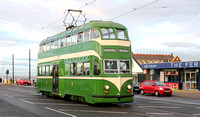
|
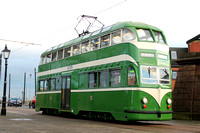
|
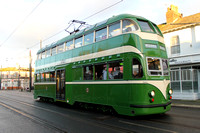
|
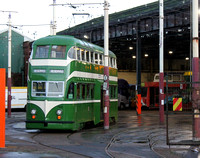
|
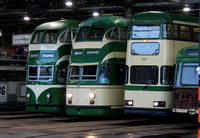
|
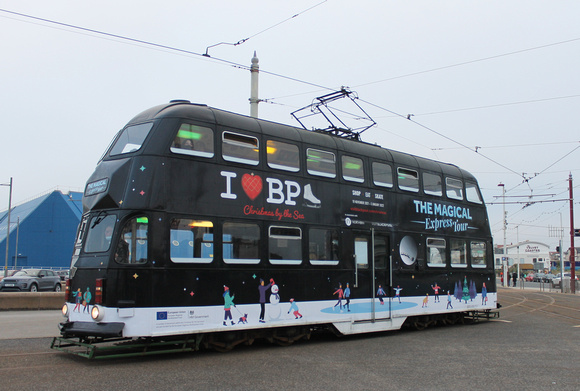 A very quick stop off at Blackpool this afternoon allowed me the chance to grab a couple of photographs of Blackpool's most recent Heritage Fleet tram to receive an all over advert!
A very quick stop off at Blackpool this afternoon allowed me the chance to grab a couple of photographs of Blackpool's most recent Heritage Fleet tram to receive an all over advert!
Balloon 723 has been branded as the 'The Magical Express Tour' tram and has been revynaled on the outside with mainly black vynal with a white strip along the base of the tram. Along the white base and onto the black are various characters including people ice skating, snowmen and Christmas Trees. On the panel on either side where the stair case is located, there is an image of a full moon with Santa on his sleigh being hauled by his reindeers passing it. On the between deck panelling, there are slogans for 'I love BP (Blackpool)', 'Christmas by the sea' and 'The Magical Express Tour'. The destination blinds have been vynaled over and also feature the text:'The Magical Express Tour'. The 'Christmas by the sea' event is taking place at the Tower Headland from 19th November until 3rd January. The event has the 'Star Flyer' ride, an Ice Rink and Christmas Market set up on the Tower headland. 723 is operating tours, which are running from North Pier / Tower heritage stop to Pleasure Beach (non stop) and return with it only being possible to board at the North Pier / Tower stop. See further info and times at: https://blackpoolheritage.com/tours/the-magical-express-tour/
723 is one of Blackpool's iconic Balloon tram fleet and is a regular performer on Blackpool's heritage tram tours and Illuminations tours. Having received a major refurbishment in the 1990's, which involved the removal of it's curved end upper deck windows, curved roof windows and swing over seats, 723 received many other modifications including the fitting of flourescent lighting, high intensity headlights and heating, making it ideal for winter use. 723 was regularly seen in use either on the Fleetwood or Cleveleys services or even on specials until withdrawal in 2011 prior to the completion of the tramway upgrade and introduction of the Flexities in 2012. 723 was not chosen for conversion to one of the 'fat door' 'B' fleet balloons due to it having remedial repairs done to its underframe rather than the full replacement carried out on subsequent refurbishments / overhauls and would join the heritage fleet, first as the 'scruffy surprise' in 2015 when it was used during the Anniversary event, having been stripped of its advertising vynals revealing a rather scruffy coat of 80's green and cream underneath. After a repaint with a fresh coat of 80's green and cream in 2016, 723 became a permanent member of the heritage fleet.
The photos below show Balloon 723 in it's 'Magical Express Tour' livery at Pleasure Beach on 18.12.21
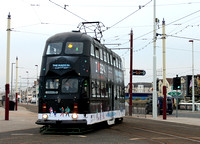
|
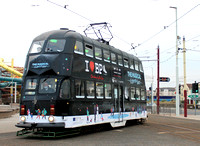
|
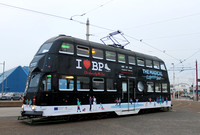
|
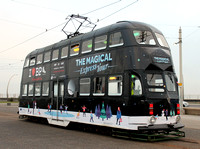
|
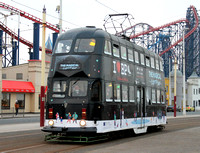
|
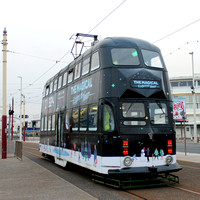
|
Also seen were Flexity 2 trams 006, 001, 003 and 017 also at Pleasure Beach and at Rigby Road Depot OMO 8, Centenary 645, Brush Railcoach 632, Balloon 717, Millennium Balloon 707 and Coronation 663 which were all prominent at the front of the depot.
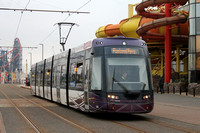
|
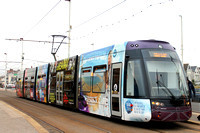
|
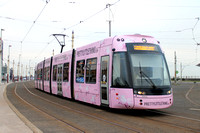
|
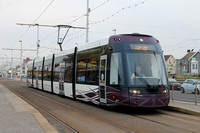
|
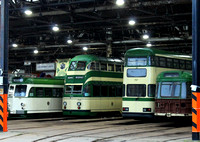
|
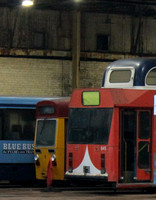
|
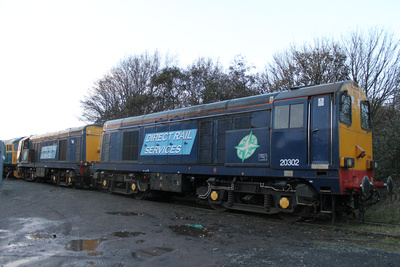 I was late in leaving work on Friday (3pm is late for a Friday!) which meant I didn't have time to go very far before darkness fell so I decided to head home via Bo'ness. I was wanting to have a look to see if any of 614209 (former 314209), was visible next to the fence at the rear (it was). As I was approaching the rear of the yard, I noticed that one of the DRS class 20s was visible near the TMD, so I headed there and found that the gates were open and 20302 and 20305 were sitting out on the track in the car park / public footpath with 26038 'Tom Clift' within the gates. The reason they were shunted out there was that one of the steam locos, NCB No 1 'Lord Roberts', was being driven up and down the yard multiple times either on test or on driver training.
I was late in leaving work on Friday (3pm is late for a Friday!) which meant I didn't have time to go very far before darkness fell so I decided to head home via Bo'ness. I was wanting to have a look to see if any of 614209 (former 314209), was visible next to the fence at the rear (it was). As I was approaching the rear of the yard, I noticed that one of the DRS class 20s was visible near the TMD, so I headed there and found that the gates were open and 20302 and 20305 were sitting out on the track in the car park / public footpath with 26038 'Tom Clift' within the gates. The reason they were shunted out there was that one of the steam locos, NCB No 1 'Lord Roberts', was being driven up and down the yard multiple times either on test or on driver training.
Both in original DRS 'Compass' Livery, 20302 and 20305 have been at Bo'ness since 17th July 2020, when they arrived as part of a convoy with 37038, 37424 and 37403, however both of the class haven't run since.

|
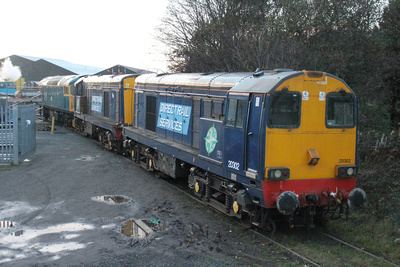
|
DMSO 64600 from 614209 (ex 314209) was parked up next to the fence at the end of the main line headshunt. Work is still under way on the conversion of the unit from an EMU to a unit powered by Hydrogen, with Arcola Energy carrying out the work.
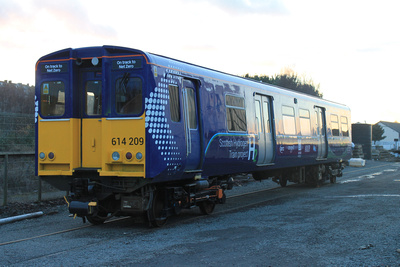
|
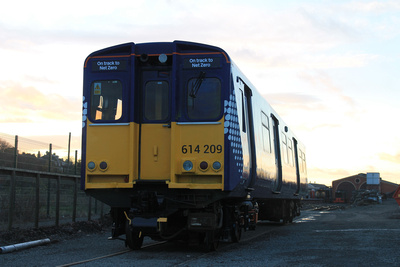
|
During the COP 26 Climate Summit, the eyes of the world were on Glasgow and it was seen as a chance to show off some advances in some more eco friendly advances in rail technology such as hydrogen and battery power to a wider audience, including Royalty and heads of Government.
Visiting Glasgow was Viva Rail's battery powered three car ex District line D Stock: 230001 and Porterbrook Rail's bi mode multiple unit 799201, whilst at Bo'ness Arcola Rail's former class 314, now 614209 and converted to Hydrogen power was also on display.
230001
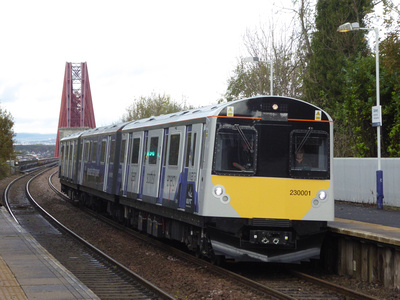 Viva Rail's class 230: 230001 (vehicles 300001 / 300201 / 300101) was developed from ex London Underground District line D78 stock (LU vehicles 7058 / 17128 / 7511), originally as a DEMU, but now as a battery unit with a range of up to 100km, with the batteries able to be recharged in 10 minutes!
Viva Rail's class 230: 230001 (vehicles 300001 / 300201 / 300101) was developed from ex London Underground District line D78 stock (LU vehicles 7058 / 17128 / 7511), originally as a DEMU, but now as a battery unit with a range of up to 100km, with the batteries able to be recharged in 10 minutes!
The Grey, purple and black with Vivarail “Clean Energy/Fast Charge” slogans liveried 230001 arrived at Polmadie by low loader on 24th October and began test and press runs between Glasgow Central and Barrhead / Kilmarnock from 27th October to 29th October. The unit did manage a trip further afield with a trip from Polmadie - Inverkeithing Yard on Friday 29th October and a return trip over the Forth Bridge back to Polmadie, which doubled as a Press run, following a naming ceremony, where 230001 was named 'Viva Venturer'. On weekdays during the COP 26 conference, 230001 would make the short journey into Central Station from Polmadie and would operate between Glasgow and Barrhead either 2 or 3 times per afternoon. During the course of the conference, both Prince Charles and Prime Minister, Boris Johnson were amongst the visiting dignatories to have a look on board.
| 230001 at Glasgow Central | Vivarail's battery powered Class 230 three car 'D' train 230001, which was converted from former London Underground 'D78' stock, is seen arriving at Glasgow Central with 5Z09 ECS working from Barrhead. 230001 is in Glasgow to demo different forms of renewable power sources during the COP 26 conference 29.10.21 |
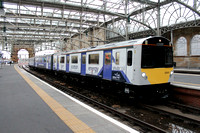
|
| 230001 at Glasgow Central | Vivarail's battery powered Class 230 three car 'D' train 230001, which was converted from former London Underground 'D78' stock, is seen at Glasgow Central having arrived with 5Z09 ECS working from Barrhead. 29.10.21 |
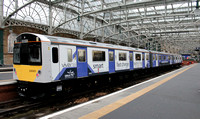
|
| 380110 and 230001 at Glasgow Central | 380110 is seen at Platform 12 in Glasgow Central awaiting it's next departure as Vivarail's battery powered protoype unit 230001 is seen having arrived with 5Z09 ECS working from Barrhead 29.10.21 |
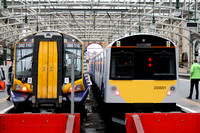
|
| 230001 at Glasgow Central | Vivarail's battery powered Class 230 three car 'D' train 230001, which was converted from former London Underground 'D78' stock, is awaiting departure from at Glasgow Central with 5Z07 ECS working to Polmadie. 29.10.21 |
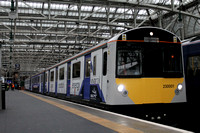
|
| 230001 departing Glasgow Central |
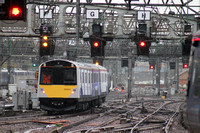
|
|
| 230001 at Dalmeny | Vivarail's battery powered Class 230 three car 'D' train 230001 'Viva Venturer', which was converted from former London Underground 'D78' stock, is seen arriving at Dalmeny having just crossed the Forth Rail Bridge with 5Z12 Inverkeithing yard to Polmadie working. 30.10.21 |
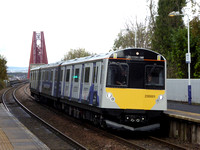
|
| 230001 at Dalmeny | Vivarail's battery powered Class 230 three car 'D' train 230001 'Viva Venturer', which was converted from former London Underground 'D78' stock, is seen pausing at Dalmeny with 5Z12 Inverkeithing yard to Polmadie working. 30.10.21 |
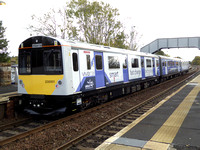
|
799201
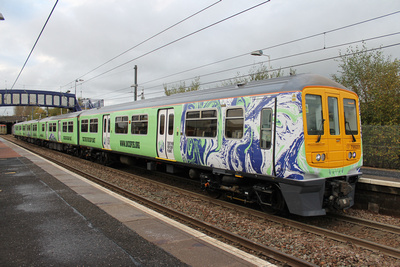 799201 is the second of two tri-mode multiple units adapted from class 319 EMUs (799001 was adapted from 319001 and 799201 was adapted from 319382). The existing 25KV overhead line and 750V Third rail equipment has been retained with both units featuring a full carriage sized hydrogen fuel cell. Porterbrook hope to eventually be able to make the fuel cell to fit in the underframe of the units.
799201 is the second of two tri-mode multiple units adapted from class 319 EMUs (799001 was adapted from 319001 and 799201 was adapted from 319382). The existing 25KV overhead line and 750V Third rail equipment has been retained with both units featuring a full carriage sized hydrogen fuel cell. Porterbrook hope to eventually be able to make the fuel cell to fit in the underframe of the units.
The adaptation of 319001 into 799001 began in 2018 and the unit was unveiled on 20 June 2019. The project became known as 'Hydroflex' and 799001 made its first mainline appearance on testing in September 2020, reaching 50 mph through Warwickshire.
The project evolved and a second unit was required so 319382 became 799201 for showcasing at COP 26. 799201 features a Green livery with COP26 branding and earth vynals around the cab sides. One of 799201's Driving Trailers contains the hydrogen cells, while vehicle 71980 was fitted out with a boardroom styled interior for the COP26 Summit.
799201, consisting of vehicles 77975, 63094, 71980 and 77976 was hauled from Long Marston, where it is based to Mossend on 3rd November 2021 by 57312 and made it's debut run on 4th November, traveling from Mossend to Glasgow Central and travelling 2-3 journeys non stop around the Cathcart Circle (via the outer track) before returning to Mossend, 799201 ran on electric power for the duration of the summit. 799201 made daily runs on weekdays up to 11th November, with the unit returning south on 12th November. Over the course of the conference, both Prince Charles and Prime Minister, Boris Johnson were amongst the many visiting dignatories to have a look on board.
| 799201 at Maxwell Park | Porterbrook Rail's HydroFLEX prototype unit 799201 is seen passing through Maxwell Park on the Cathcart Circle with 2Z02 13.50 Glasgow Central - Glasgow Central via the Cathcart Circle. 799201 is in Glasgow to demonstrate Hydrogen powered technology 5.11.21 |
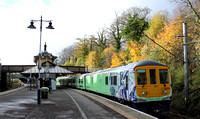
|
| 799201 at Maxwell Park | Porterbrook Rail's HydroFLEX prototype unit 799201 is seen having passed through Maxwell Park on the Cathcart Circle with 2Z02 13.50 Glasgow Central - Glasgow Central via the Cathcart Circle. 5.11.21 |
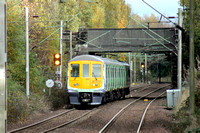
|
| 799201 at Whifflet | Porterbrook Rail's HydroFLEX prototype unit 799201 is seen pausing at Whifflet with 5Z01 14.39 Glasgow Central - Whifflet. 5.11.21 |
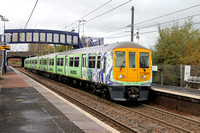
|
| 799201 at Whifflet | Porterbrook Rail's HydroFLEX prototype unit 799201 departs Whifflet with 5Z01 14.39 Glasgow Central - Whifflet. 5.11.21 |
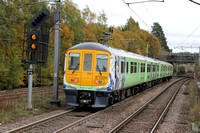
|
614209
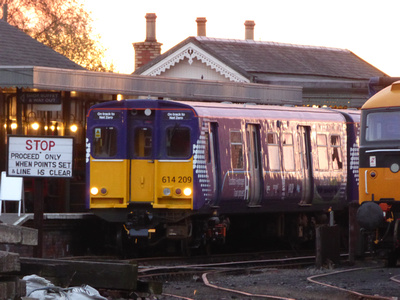 The third and final unit, 614209 (vehicles 64599, 71458 and 64600), was still being worked on at Bo'ness during COP 26, however a series of visits was set up by Arcola Energy to showcase the progress made on the former class 314 unit during its conversion from an EMU to hydrogen power.
The third and final unit, 614209 (vehicles 64599, 71458 and 64600), was still being worked on at Bo'ness during COP 26, however a series of visits was set up by Arcola Energy to showcase the progress made on the former class 314 unit during its conversion from an EMU to hydrogen power.
314209 was withdrawn from service on Friday 13th December, a day before the final withdrawal of the class 314 fleet, having worked on evening peak Neilston services with 314210 and was probably the unit which was in the best condition compared to the then remaining 314 fleet. Despite the scrapping of the other units, 314209 remained stored at Yoker for almost, until it was transferred under it's own power from Yoker to Shields depot on 16th December 2020 for onward transport by low loader to Bo'ness over 17th and 18th December 2020.
Work started on the conversion of the 314 to Hydrogen power in January 2021 and has involved the removal of most of the original electrical equipment from the 314 either for refurbishment or for replacement. New equipment fitted has included AC motors (314209's original motors were DC), a new system of batteries to allow it to run off battery power if required and hydrogen tanks fitted below the underframe. The interior of the unit is also being refurbished with the old seating having been removed and replaced with Pendolino style seating and new flooring. The original wall panels and lighting has been maintained. The Pantograph trailer has been completed, however work is still ongoing on the DMSO vehicles.
314209 became 614209 in October 2021 and has been outshopped in Scotrail Saltire Blue with 'Scottish Hydrogen Train project' branding. The aim is for 614209, to move under its own power around the yard at Bo’ness in March 2022 and and over the full length of the 5 1/2 mile long line in May 2022. 614209 was on static display at Bo'ness station during COP 26.
| 314209 at Gourock | 314209 seen at Gourock having arrived with 1G05 11.55 Glasgow Central - Gourock 6.4.18 |
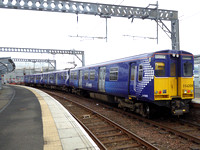
|
| 314209 at Yoker | Seen from the Kelso St overbridge, the final remaining fully intact Class 314, 314209, is seen stabled in a siding at Yoker Depot 24.7.20 |
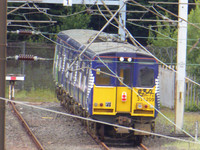
|
| 314209 at Bo'ness | Vehicle 64600 from 314209 is seen being delivered by low loader to Bo'ness, where conversion to hydrogen power will begin 18.12.20 |
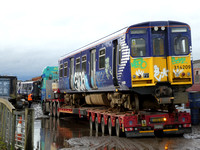
|
| 71458 at Bo'ness | Pantograph trailer 71458 from the newly renumbered 614209 the former class 314209 at Bo'ness 29.10.21 |

|
| 614209 at Bo'ness | DMSO Vehicle 64600 with Pantograph trailer 71458 behind from Arcola Energy's new hydrogen train, 614209 (formerly 314209) are seen at Bo'ness on display for visitors at COP 26 4.11.21 (photo taken through the fence from a public footpath) |
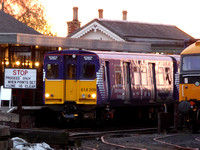
|
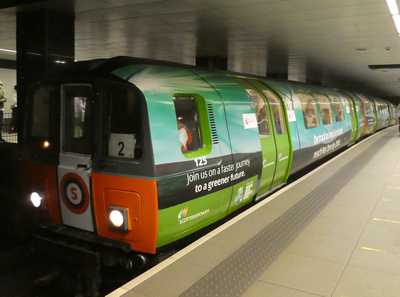 A full set of Glasgow Subway vehicles formed of Metro Cammell Power Car 125, Barclay Trailer 201 and Metro Power Power Car 118 have been reliveried into an all over advert for Scottish Power and COP 26.
A full set of Glasgow Subway vehicles formed of Metro Cammell Power Car 125, Barclay Trailer 201 and Metro Power Power Car 118 have been reliveried into an all over advert for Scottish Power and COP 26.
The advert features the slogans 'Join us on a faster journey to a greener future' and 'On track to help Scotland reach net zero by 2045'. The logos for Scottish Power and COP 26 also feature on the body sides.
The train, with 125 leading, was running on the Outer Circle on route 2 on 16th October 2021. Photos taken at St Enoch and Buchanan St. On 22nd October, the set were seen working route 15 on the Inner Circle, again 125 was leading.
| 125 front view |
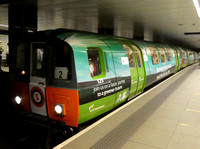
|
| 125 rear view |
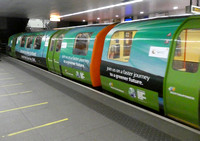
|
| 201 view |
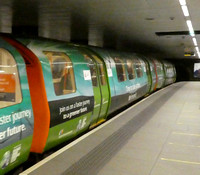
|
| 118 view |
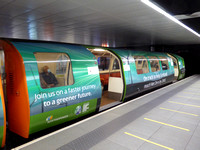
|
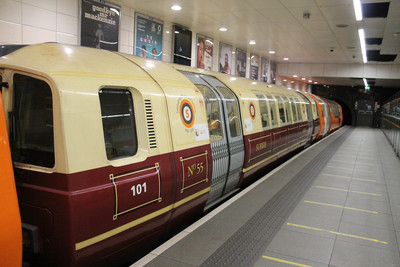 The Glasgow Subway is the third oldest underground Metro railway system in the world, behind London and Budapest. Opening in 1896, the Subway was first cable hauled before switching to electric traction from 1935, using the original rolling stock. Following a major refurbishment from 1977-1980, the current configuration of stations and the current Metro Cammell power cars entered service.
The Glasgow Subway is the third oldest underground Metro railway system in the world, behind London and Budapest. Opening in 1896, the Subway was first cable hauled before switching to electric traction from 1935, using the original rolling stock. Following a major refurbishment from 1977-1980, the current configuration of stations and the current Metro Cammell power cars entered service.
Today's system consists of the inner circle and outer circle serving 15 stations over their 6 1/2 mile route and it is possible to travel around a complete loop of the system in 25 minutes. The stations are a mix of the more traditional narrow island platforms at most stations (Kelvinhall, Kelvinbridge, St Georges Cross, Cowcaddens, Bridge Street, West Street, Shields Road, Kinning Park and Cessnock), with the busier stations of Buchanan St, Ibrox and Hillhead having a combination of side platform and centre platform while St Enoch, Govan and Partick have a pair of side platforms to ease congestion.
The service levels vary from every 4 minutes at peak times (6 trains per circle), every 6 minutes (4/5 trains per circle) or every 8 minutes (3 trains per circle).
The services are operated by trains of the unique 4ft gauge 1978 built Metro Cammell power cars and 1992 Hunslet built trailer cars. The cars are usually run in three car formation, although 2 car is also possible if short of stock. Formations are usually as follows:
- Power Car / Trailer / Power Car
- Power Car / Power Car (acting as trailer) / Power Car
- Power Car / Power Car
There are currently 32 Power Cars in service and 8 trailers, mostly in SPT Orange, Grey and White livery, however there are 2 special liveries, these being on Number 101, which carries a retro Glasgow District Subway Maroon and Cream livery and 130, which carries a special grey livery to celebrate the 120th Anniversary of the Subway in 2016. The only car you won't see is 122 as it was scrapped in 2017 to provide spare parts to keep the others in service.
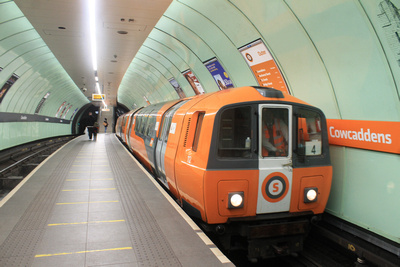 With the introduction to service of 17 new Stadler trains expected during 2022, it is a case of catch the Metro Cammell and Barclay cars while you can.
With the introduction to service of 17 new Stadler trains expected during 2022, it is a case of catch the Metro Cammell and Barclay cars while you can.
Having recently started reading the excellent 'Circles under the Clyde' book, which gives a fascinating history, particularly of the original pre 1977 system and the rolling stock, I was inspired to visit for the first time since 2014 and take photos of the system for the first time!
On both occasions the 6 minute service was in operation using 4 trains per circle, though on my second trip, this was ramping up towards the 4 minute service with 6 trains per circle. As well as having a ride round both the Outer and Inner circles, I stopped off at various stations including St Enoch, Buchanan Street, Govan, Bridge Street and Cowcaddens to take photographs. I would recommend a visit to this small, clean and well kept system.
I have added a fleet list below, which has details of the current Metro Cammell and Hunslet vehicles. Any of the vehicles that I have photographed, I have linked them to the relevant number on the fleet list below:
| Number | Vehicle Type | Built by | Entered Service | Current Livery | Status | Notes |
| 101 | Motor Car | Metro Cammell | 1980 | Retro Glasgow District Subway Company Maroon and Cream livery | In Service | |
| 102 | Motor Car | Metro Cammell | 1980 | SPT Orange, Grey and White livery | In Service | |
| 103 | Motor Car | Metro Cammell | 1980 | SPT Orange, Grey and White livery | In Service | First vehicle to be delivered to upgraded Subway and first to run under it's own power. |
| 104 | Motor Car | Metro Cammell | 1980 | SPT Orange, Grey and White livery | In Service | |
| 105 | Motor Car | Metro Cammell | 1980 | SPT Orange, Grey and White livery | In Service | |
| 106 | Motor Car | Metro Cammell | 1980 | SPT Orange, Grey and White livery | In Service | |
| 107 | Motor Car | Metro Cammell | 1980 | SPT Orange, Grey and White livery | In Service | |
| 108 | Motor Car | Metro Cammell | 1980 | SPT Orange, Grey and White livery | In Service | |
| 109 | Motor Car | Metro Cammell | 1980 | SPT Orange, Grey and White livery | In Service | |
| 110 | Motor Car | Metro Cammell | 1980 | SPT Orange, Grey and White livery | In Service | |
| 111 | Motor Car | Metro Cammell | 1980 | SPT Orange, Grey and White livery | In Service | |
| 112 | Motor Car | Metro Cammell | 1980 | SPT Orange, Grey and White livery | In Service | |
| 113 | Motor Car | Metro Cammell | 1980 | SPT Orange, Grey and White livery | In Service | |
| 114 | Motor Car | Metro Cammell | 1980 | SPT Orange, Grey and White livery | In Service | |
| 115 | Motor Car | Metro Cammell | 1980 | SPT Orange, Grey and White livery | In Service | |
| 116 | Motor Car | Metro Cammell | 1980 | SPT Orange, Grey and White livery | In Service | |
| 117 | Motor Car | Metro Cammell | 1980 | SPT Orange, Grey and White livery | In Service | |
| 118 | Motor Car | Metro Cammell | 1980 | Scottish Power / COP 26 advert | In Service | |
| 119 | Motor Car | Metro Cammell | 1980 | SPT Orange, Grey and White livery | In Service | |
| 120 | Motor Car | Metro Cammell | 1980 | SPT Orange, Grey and White livery | In Service | |
| 121 | Motor Car | Metro Cammell | 1980 | SPT Orange, Grey and White livery | In Service | |
| 122 | Motor Car | Metro Cammell | 1980 | N/A | Scrapped | Withdrawn 2015 and scrapped circa 2017 to provide spare parts for other vehicles |
| 123 | Motor Car | Metro Cammell | 1980 | SPT Orange, Grey and White livery | In Service | |
| 124 | Motor Car | Metro Cammell | 1980 | SPT Orange, Grey and White livery | In Service | |
| 125 | Motor Car | Metro Cammell | 1980 | Scottish Power / COP 26 advert | In Service | |
| 126 | Motor Car | Metro Cammell | 1980 | SPT Orange, Grey and White livery | In Service | |
| 127 | Motor Car | Metro Cammell | 1980 | SPT Orange, Grey and White livery | In Service | |
| 128 | Motor Car | Metro Cammell | 1980 | SPT Orange, Grey and White livery | In Service | |
| 129 | Motor Car | Metro Cammell | 1980 | SPT Orange, Grey and White livery | In Service | |
| 130 | Motor Car | Metro Cammell | 1980 | Glasgow Subway 1896-2016 120 years All over Grey livery with orange doors | In Service | |
| 131 | Motor Car | Metro Cammell | 1980 | SPT Orange, Grey and White livery | In Service | |
| 132 | Motor Car | Metro Cammell | 1980 | SPT Orange, Grey and White livery | In Service | Used for the Inaugaration of the new system by the Queen 1.11.79 |
| 133 | Motor Car | Metro Cammell | 1980 | SPT Orange, Grey and White livery | In Service | Used for the Inaugaration of the new system by the Queen 1.11.79 |
| 201 | Trailer Car | Hunslet | 1992 | Scottish Power / COP 26 advert | In Service | |
| 202 | Trailer Car | Hunslet | 1992 | SPT Orange, Grey and White livery | In Service | |
| 203 | Trailer Car | Hunslet | 1992 | SPT Orange, Grey and White livery | In Service | |
| 204 | Trailer Car | Hunslet | 1992 | SPT Orange, Grey and White livery | In Service | |
| 205 | Trailer Car | Hunslet | 1992 | SPT Orange, Grey and White livery | In Service | |
| 206 | Trailer Car | Hunslet | 1992 | SPT Orange, Grey and White livery | In Service | |
| 207 | Trailer Car | Hunslet | 1992 | SPT Orange, Grey and White livery | In Service | |
| 208 | Trailer Car | Hunslet | 1992 | SPT Orange, Grey and White livery | In Service |
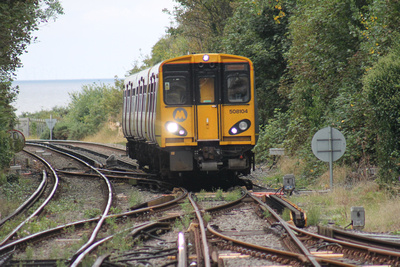 I made my 3rd trip of the year to the Merseyside area to catch some more of the 507 and 508 fleet before they are replaced by the class 777. I'd planned the trip to co-inside with one of the new class 777 fleet being put on display at Birkenhead North.
I made my 3rd trip of the year to the Merseyside area to catch some more of the 507 and 508 fleet before they are replaced by the class 777. I'd planned the trip to co-inside with one of the new class 777 fleet being put on display at Birkenhead North.
As I drove down to Merseyside and expected the roads into Liverpool to be busier with it being the weekend, I parked at Maghull North park and ride, this was less than 1 mile off Junction 3 of the M58 and had ample parking. It is on the Ormskirk and just a 20 minute journey into Liverpool Central.
At Maghull North, I caught 507025 into Moorfields and changed to the deep level platform for the Wirral services. The deep level line is a one way circular line under the city centre with both ends meeting at James St (runs James Street, Moorfields, Liverpool Central, Lime Street, James Street). At Moorfields deep level platform, I caught 508141+508114, which was on an Elsmere Port service to Hamilton Square, here I changed to a New Kirby service led by 507032 to Birkenhead North. After a look round 777010, I caught 508120 to New Brighton.
Travelling to New Brighton, I saw 2 of the Welsh line class 230s, however as the train windows were too dirty, they were hard to photograph. At New Brighton the train arrived into Platform 2. The station its self had a 1930's style canopy which ran around half way up the curved platform. At either side of the lines into the island platform, there was storage sidings, (2 to the left of platform 1 and 1 to the right of platform 2) where four units, 507012+508130 on the left and 507020+507011 on the right. I think that extra units not required are stored here at the weekend. I caught 508104 back to Birkenhead and after another quick look round 777010, I caught 507018 on a New Kirby service back to Moorfields.
I then caught 507001 to Kirkdale for a few photos of the 777s and 507006 which were stabled there. 507006, which was accident damaged following a derailment and collision with a bridge back in March, would be taken away for scrap only a few days later. I then caught 507019+507021 to Maghull North. Rather than head straight home, I drove to Ainsdale, which is only 20 minutes drive from Maghull and photoed a few units there before catching 507030+507002 to Southport, where I photoed a pair of 769s and also 507003 and an unidentified unit in the sidings. After catching 507002+507030 back to Ainsdale, I headed home.
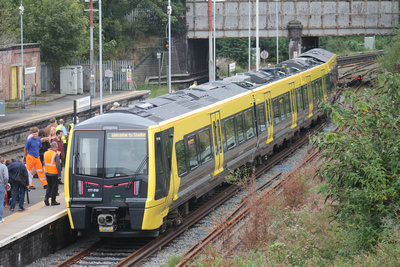 On 9th and 11th September, Merseyrail put one of their brand new class 777 trains on public display on the rarely used Platform 1 at Birkenhead North on Merseyrail's Wirral Line.
On 9th and 11th September, Merseyrail put one of their brand new class 777 trains on public display on the rarely used Platform 1 at Birkenhead North on Merseyrail's Wirral Line.
A healthy number of people went along to view unit 777010, the first of the inital class of 53 units to be accepted for use on the network. The most unique feature of the class is the fitting of sliding steps which allows for wheelchairs users to board without a ramp being needed. Also on the cab ends there is LED lighting in the form of a letter 'M' which light up white or red depending on the direction of travel.
The interior of the units looked bright, airy and spacious with the sections between the bogies lower than the remainder. The units have Wi-fi and USB and electrical sockets. There are bike racks and space for more passengers than carried on the current fleet, however these are more likely to be standing passengers. The corridor connections between each vehicle are almost the full width of the coach, making it more like the interior of a tram.
Overall, I likes the look of the units and look forward to sampling one in service!
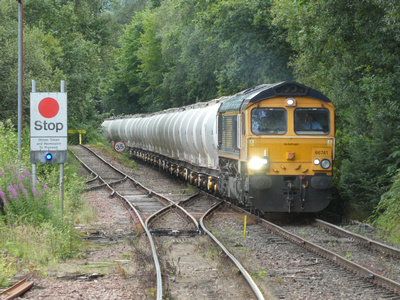 I was on holiday up at Arrochar on the West Highland Line for a week. Arrochar is a lovely part of the country with some stunning views around Loch Long and a massive array of wildlife to see as well. The train service its self is spread out with a train every couple of hours and mainly features Class 156s with the new class 153 'Active Carriages' added on to some of the Oban workings. Adding interest to the timetable is the morning/ evening sleeper and the North Blyth - Fort William Alcan tanks working. There is also the occasional ECS working of Mark 1 stock to / from Fort William / Carnforth for Jacobite workings as well as occasional steam loco moves again for the Jacobite.
I was on holiday up at Arrochar on the West Highland Line for a week. Arrochar is a lovely part of the country with some stunning views around Loch Long and a massive array of wildlife to see as well. The train service its self is spread out with a train every couple of hours and mainly features Class 156s with the new class 153 'Active Carriages' added on to some of the Oban workings. Adding interest to the timetable is the morning/ evening sleeper and the North Blyth - Fort William Alcan tanks working. There is also the occasional ECS working of Mark 1 stock to / from Fort William / Carnforth for Jacobite workings as well as occasional steam loco moves again for the Jacobite.
| West Highland Line workings around Arrochar and Tarbet 26.7.21-30.7.21 | |||||
| Monday (from 2pm) | |||||
| Loco / Unit Numbers | Headcode | Working | Coaches | Time | Notes |
| 156477+156492+156446 | 1Y44 | 10.10 Mallaig and Oban - Glasgow Queen St | 6 | 14.08 | 156446 joined at Crianlarich from Oban |
| 156474+153377 | 1Y26 | 14.41 Oban - Glasgow Queen Street | 3 | 16.27 | |
| 37668+37669 tnt 62005 | 5Z61 | 12.18 Fort William Junction - Carnforth | 8 | 17.18 | 97 late in passing |
| 153305+156457 | 1Y29 | 16.36 Glasgow Queen Street - Oban | 3 | 17.48 | |
| 156477+156492 | 1Y27 | 18.23 Glasgow Queen Street - Oban and Mallaig | 4 | 19.37 | 156477 splits at Crianlarich to Oban |
| 156453+156450+156458 | 1Y48 | 16.01 Mallaig - Glasgow Queen Street | 6 | 20.06 | 156458 joins at Crianlarich from Oban |
| 156457 | 1Y32 | 20.39 Oban - Glasgow Queen Street | 2 | 22.18 | |
| 66740+73967 | 1B01 | 19.50 Fort William - London Euston Sleeper | 22.46 | ||
| Tuesday | |||||
| 156446 | 1Y31 | 5.20 Glasgow Queen Street - Oban | 2 | 6.32 | |
| 66740+73967 | 1Y11 | 21.18 London Euston - Fort William | 7.04 | ||
| 156477+153305 | 1Y20 | 5.21 Oban - Glasgow Queen Street | 3 | 7.12 | |
| 156450+156453+156445 | 1Y21 | 8.23 Glasgow Queen Street - Oban / Mallaig | 6 | 9.38 | 156450 split at Crianlarich for Oban |
| 156492 | 1Y42 | 6.03 Mallaig - Glasgow Queen Street | 2 | 10.06 | |
| 156446 | 1Y22 | 8.57 Oban - Glasgow Queen Street | 2 | 10.43 | |
| 153305+156477 | 1Y25 | 10.34 Glasgow Queen Street - Oban | 3 | 12 | |
| 156499+156492 | 1Y23 | 12.23 Glasgow Queen Street - Oban / Mallaig | 4 | 13.4 | 156499 split at Crianlarich for Oban |
| 156500+156474+156450 | 1Y44 | 10.10 Mallaig and Oban - Glasgow Queen St | 6 | 14.08 | 156450 joined at Crianlarich from Oban |
| 66741 | 6S45 | North Blyth - Fort William Alcans | 16.06 | ||
| 156477+153305 | 1Y26 | 14.41 Oban - Glasgow Queen Street | 3 | 16.27 | |
| 153377+156457 | 1Y29 | 16.36 Glasgow Queen Street - Oban | 3 | 17.48 | |
| 156500+156474 | 1Y27 | 18.23 Glasgow Queen Street - Oban and Mallaig | 4 | 19.37 | 156500 splits at Crianlarich to Oban |
| 156453+156445+156450 | 1Y48 | 16.01 Mallaig - Glasgow Queen Street | 6 | 20.06 | 156450 joins at Crianlarich from Oban |
| 156457 | 1Y32 | 20.39 Oban - Glasgow Queen Street | 2 | 22.18 | |
| 66740+73967 | 1B01 | 19.50 Fort William - London Euston Sleeper | 22.46 | ||
| Wednesday | |||||
| 156457 | 1Y31 | 5.20 Glasgow Queen Street - Oban | 2 | 6.32 | actual arrival 8.15 |
| 66740+73967 | 1Y11 | 21.18 London Euston - Fort William | 7.04 | actual arrival 8.29 | |
| 156500+153377 | 1Y20 | 5.21 Oban - Glasgow Queen Street | 3 | 7.12 | |
| 156453+156450 | 1Y21 | 8.23 Glasgow Queen Street - Oban / Mallaig | 4 | 9.38 | 156450 split at Crianlarich. Oban portion cancelled |
| 156474 | 1Y42 | 6.03 Mallaig - Glasgow Queen Street | 2 | 10.06 | |
| 156450 | 1Y22 | 8.57 Oban - Glasgow Queen Street | 2 | 10.43 | Started at Crianlarich |
| 153377+156500 | 1Y25 | 10.34 Glasgow Queen Street - Oban | 3 | 12 | |
| 66741 | 6S45 | North Blyth - Fort William Alcans | 12.3 | ||
| 156477+156450+156474 | 1Y23 | 12.23 Glasgow Queen Street - Oban / Mallaig | 6 | 13.4 | 156477 split at Crianlarich for Oban |
| 156492+156499+156457 | 1Y44 | 10.10 Mallaig and Oban - Glasgow Queen St | 6 | 14.08 | 156457 joined at Crianlarich from Oban |
| 156500+153377 | 1Y26 | 14.41 Oban - Glasgow Queen Street | 3 | 16.27 | |
| 153305+156476 | 1Y29 | 16.36 Glasgow Queen Street - Oban | 3 | 17.48 | |
| 156499+156492 | 1Y27 | 18.23 Glasgow Queen Street - Oban and Mallaig | 4 | 19.37 | 156499 splits at Crianlarich to Oban |
| 156450+156477 | 1Y48 | 16.01 Mallaig - Glasgow Queen Street | 4 | 20.06 | 156477 joins at Crianlarich from Oban |
| 156476 | 1Y32 | 20.39 Oban - Glasgow Queen Street | 2 | 22.18 | |
| 66740+73967 | 1B01 | 19.50 Fort William - London Euston Sleeper | 22.46 | ||
| Thursday | |||||
| 156457 | 1Y31 | 5.20 Glasgow Queen Street - Oban | 2 | 6.32 | |
| 66740+73967 | 1Y11 | 21.18 London Euston - Fort William | 7.04 | ||
| 156499+153305 | 1Y20 | 5.21 Oban - Glasgow Queen Street | 3 | 7.12 | |
| 156477+156458+156453 | 1Y21 | 8.23 Glasgow Queen Street - Oban / Mallaig | 6 | 9.38 | 156477 split at Crianlarich for Oban |
| 156492 | 1Y42 | 6.03 Mallaig - Glasgow Queen Street | 2 | 10.06 | |
| 156457 | 1Y22 | 8.57 Oban - Glasgow Queen Street | 2 | 10.43 | |
| 153305+156499 | 1Y25 | 10.34 Glasgow Queen Street - Oban | 3 | 12 | |
| 156457+156492+156500 | 1Y23 | 12.23 Glasgow Queen Street - Oban / Mallaig | 6 | 13.4 | 156457 split at Crianlarich for Oban |
| 156450+156474+156477 | 1Y44 | 10.10 Mallaig and Oban - Glasgow Queen St | 6 | 14.08 | 156477 joined at Crianlarich from Oban |
| 66741 | 6S45 | North Blyth - Fort William Alcans | 16.25 | ||
| 156499+153305 | 1Y26 | 14.41 Oban - Glasgow Queen Street | 3 | 16.27 | |
| 153377+156445 | 1Y29 | 16.36 Glasgow Queen Street - Oban | 3 | 17.48 | |
| 156450+156474 | 1Y27 | 18.23 Glasgow Queen Street - Oban and Mallaig | 4 | 19.37 | 156450 splits at Crianlarich to Oban |
| 156458+156453+156457 | 1Y48 | 16.01 Mallaig - Glasgow Queen Street | 4 | 20.06 | 156457 joins at Crianlarich from Oban |
| 156445 | 1Y32 | 20.39 Oban - Glasgow Queen Street | 2 | 22.18 | |
| 66740+73967 | 1B01 | 19.50 Fort William - London Euston Sleeper | 22.46 | ||
| Friday till 12pm | |||||
| 156447 | 1Y31 | 5.20 Glasgow Queen Street - Oban | 2 | 6.32 | |
| 66740+73967 | 1Y11 | 21.18 London Euston - Fort William | 7.04 | ||
| 156450+153377 | 1Y20 | 5.21 Oban - Glasgow Queen Street | 3 | 7.12 | |
| 156456+156478+156453 | 1Y21 | 8.23 Glasgow Queen Street - Oban / Mallaig | 6 | 9.38 | 156456 split at Crianlarich for Oban |
| 156474 | 1Y42 | 6.03 Mallaig - Glasgow Queen Street | 2 | 10.06 | |
| 156477 | 1Y22 | 8.57 Oban - Glasgow Queen Street | 2 | 10.43 | |
| 153377+156450 | 1Y25 | 10.34 Glasgow Queen Street - Oban | 3 | 12 | |
I had a day trip down to Southport and Ormskirk on 28th June to sample some of the class 507's and 508's before they are withdrawn. With the expected entry into service for the 777's being soon (the 777's have just begun test runs / driver training), the days are numbered for the 41/42 year old PEP units. With test running of the 777s having begun and having found out about 2 trailers from a pair of 508/2s being visible at Birkenhead, I decided to return and travel across to Birkenhead and then back over towards Southport via Kirkdale to catch more 507s and 508s as well as some 777s both on depot and 777010 out on a test / training run.
The Class 507 / 508
The Class 507 and Class 508 units are part of the PEP family of units which were built in the late 1970's and run off the third rail at 750v DC only as opposed to the Class 313 which is/was dual voltage and Class 314 and 315 which was/are powered from the overhead line. The units are very similar to the much missed class 314s that we were so used to seeing on the Cathcart Circle as you'll no doubt have guessed!
The exterior of both the 507/508 is broadly similar to the rest of the PEP family, the main differences in comparison to some of the other classes are:
- The cab ends have newer style of lighting clusters, which also includes LED lighting
- The bogies on the DMSO vehicles have collector shoes for 3rd rail operation
- The central Trailer vehicle has a different window layout from the 314 and 315, which have an additional small window below the pantograph well.
- The 507 has a different type of compressor, possibly an older style from the class 508
The interior has been completely modernised with high backed seating, new ceilings and lighting, public information displays, CCTV and modernised entrance vestibules.
Built in 1978-80, the class 507 units have spent their entire lives on the Merseyrail network and mostly remain intact, with 32 units out of the original 33 built still in existance and 31 of the fleet remain in service today.
507022 was withdrawn following a collision with 507004 in 1991, with vehicle 64388 from 022 replacing one of the Driving motor vehicles in 507004 and vehicle 64426 being converted from DC to AC operation and assuming the identity of 64588 and replacing the same vehicle in set 314203, which was destroyed in the Newton train crash in 1991.
More recently in March 2021, 507006 was written off after it overran the buffers and derailed at Kirkby. As the units are fast nearing the end of their operational lives, repairs won't be forthcoming and the unit will most likely be heading for scrap soon.
The 508 was built between 1979-80 and of the original 43 built, 25 are still in use with Merseyrail. The 508 is identical to the 507, and initially worked in the Southern region before heading to Merseyside. The 508 was 4 car variation of the class 507, however before moving to Merseyside one of the TSO vehicles from each set (numbers 71526-71568) were removed and reused to increase the newly delivered class 455 up to 4 car sets, making the class 508 identical to the 507. To make it easier to identify the two classes, 508001-508043 were renumbered to 508101-508143.
Following a reduction in capacity, on services during the 1990's, 12 class 508's were sent southwards to work on some Connex South Eastern services out of Gillingham Depot. 508101, 105, 106, 107, 109, 113, 116, 119, 121, 129, 132 and 133 became 508201-212 and remained in service until 2006. Of this batch, vehicles 64664 and 64707 from 508207 have found further use as barrier vehicles for Arlington Fleet Services, vehicles 64649 from 508201 and 64712 from 508209 as training vehicles for Emergency Services Training Centre in Birkenhead and 508212 is used at Fire Services Training College at Moreton-in-Marsh, the remainder of the sets were scrapped around 2013. 508118 was scrapped after an arson attack at Birkenhead depot during the 2000's.
A further 3 class 508s would transfer to Silverlink and find work on the Watford DC lines, assisting the Class 313s. 508102, 508135 and 508142 became 508301-303 and were scrapped in 2013.
This left 27 units with Merseyrail, however the decision was taken to withdraw and scrap 508110 and 508134 in 2020 rather than overhaul them, this left 25 units are still in service with Merseyrail.
Livery
The current livery carried by the 507 and 508 fleet is the 'Good Communications' livery, which is a half yellow background and half brushed metal background, with 6 different designs applied with each set having one yellow side and one brushed metal side.The passenger doors are white on the yellow sides and yellow on the brushed metal sides. There is Merseyrail 'M' branding on each of the passenger doors, as well as on the cab fronts. The livery is applied as a vinyl skin.
The exception to these liveries are 507002 which carries all over adverts for Liverpool John Moore University, with a white base for the advert and 508111, which carries 'The Beatles Story' all over advert with a blue base.
Routes
The 507 and 508 can be found on the following routes:
- Southport - Hunts Cross
- Ormskirk - Liverpool Central
- Kirkby - Liverpool Central
- Liverpool Lime Street - New Brighton
- Liverpool Lime Street - West Kirby
- Liverpool Lime Street - Ellesmere Port
- Liverpool Lime Street - Chester
Depots are found at Kirkdale and Birkenhead.
Fleet List
Class 507
| Fleet Number | Name | Formation | Livery | Notes |
| 507001 | 64367 71342 64405 | Merseyrail Yellow and Grey | ||
| 507002 | 64368 71343 64406 | Merseyrail White with Liverpool Hope University branding | ||
| 507003 | 64369 71344 64407 | Merseyrail Yellow and Grey | ||
| 507004 | Bob Paisley | 64388 71345 64408 | Merseyrail Yellow and Grey | vehicle 64388 from set 507022 replaced 64370 in 1991 following collision damage |
| 507005 | 64371 71346 64409 | Merseyrail Yellow and Grey | ||
| 507006 | 64372 71347 64410 | Merseyrail Yellow and Grey | Withdrawn following collision with buffers at Kirkby March 2021 | |
| 507007 | 64373 71348 64411 | Merseyrail Yellow and Grey | ||
| 507008 | Harold Wilson | 64374 71349 64412 | Merseyrail Yellow and Grey | |
| 507009 | Dixie Dean | 64375 71350 64413 | Merseyrail Yellow and Grey | |
| 507010 | 64376 71351 64414 | Merseyrail Yellow and Grey | ||
| 507011 | 64377 71352 64415 | Merseyrail Yellow and Grey | ||
| 507012 | 64378 71353 64416 | Merseyrail Yellow and Grey | ||
| 507013 | 64379 71354 64417 | Merseyrail Yellow and Grey | ||
| 507014 | 64380 71355 64418 | Merseyrail Yellow and Grey | ||
| 507015 | 64381 71356 64419 | Merseyrail Yellow and Grey | ||
| 507016 | Merseyrail - celebrating the first ten years 2003-2013 | 64382 71357 64420 | Merseyrail Yellow and Grey | |
| 507017 | 64383 71358 64421 | Merseyrail Yellow and Grey | ||
| 507018 | 64384 71359 64422 | Merseyrail Yellow and Grey | ||
| 507019 | 64385 71360 64423 | Merseyrail Yellow and Grey | ||
| 507020 | John Peel | 64386 71361 64424 | Merseyrail Yellow and Grey | |
| 507021 | Red Rum | 64387 71362 64425 | Merseyrail Yellow and Grey | |
| 507022 | 64388 71363 64426 | Disbanded 1991 following collision with 507004. Vehicle 64388 replaced 64370 in 507004, 71363 scrapped and 64426 converted to AC power and replaced 64588 in set 314203 with Scotrail was withdrawn and scrapped in 2019. | ||
| 507023 | Operations Inspector Stuart Mason | 64389 71364 64427 | Merseyrail Yellow and Grey | |
| 507024 | 64390 71365 64428 | Merseyrail Yellow and Grey | ||
| 507025 | 64391 71366 64429 | Merseyrail Yellow and Grey | ||
| 507026 | Councillor George Howard | 64392 71367 64430 | Merseyrail Yellow and Grey | |
| 507027 | 64393 71368 64431 | Merseyrail Yellow and Grey | ||
| 507028 | 64394 71369 64432 | Merseyrail Yellow and Grey | ||
| 507029 | 64395 71370 64433 | Merseyrail Yellow and Grey | ||
| 507030 | 64396 71371 64434 | Merseyrail Yellow and Grey | ||
| 507031 | 64397 71372 64435 | Merseyrail Yellow and Grey | ||
| 507032 | 64398 71373 64436 | Merseyrail Yellow and Grey | ||
| 507033 | Councillor Jack Spriggs | 64399 71374 64437 | Merseyrail Yellow and Grey |
Class 508
| Fleet Number (Original) | New Fleet number | Original 4th vehicle | Name | Formation | Livery | Status | Notes |
| 508101 | 508201 | 71526 | 64649 71483 64692 | Yellow with white doors | Scrapped | Vehicle 64649 still in existance at Emergency Services Training Centre in Birkenhead | |
| 508102 | 508301 | 71527 | 64650 71484 64693 | Scrapped | |||
| 508103 | N/A | 71528 | 64651 71485 64694 | Merseyrail Yellow and Grey | in service | ||
| 508104 | N/A | 71529 | 64652 71486 64695 | Merseyrail Yellow and Grey | in service | ||
| 508105 | 508202 | 71530 | 64653 71487 64696 | Scrapped | |||
| 508106 | 508203 | 71531 | 64654 71488 64697 | Scrapped | |||
| 508107 | 508204 | 71532 | 64655 71489 64698 | Scrapped | |||
| 508108 | N/A | 71533 | 64656 71490 64699 | Merseyrail Yellow and Grey | in service | ||
| 508109 | 508205 | 71534 | 64657 71491 64700 | Scrapped | |||
| 508110 | N/A | 71535 | 64658 71492 64701 | Scrapped | |||
| 508111 | N/A | 71536 | The Beatles | 64659 71493 64702 | The Beatles Story blue Advertising Livery | in service | |
| 508112 | N/A | 71537 | 64660 71494 64703 | Merseyrail Yellow and Grey | in service | ||
| 508113 | 508206 | 71538 | 64661 71495 64704 | Scrapped | |||
| 508114 | N/A | 71539 | 64662 71496 64705 | Merseyrail Yellow and Grey | in service | ||
| 508115 | N/A | 71540 | 64663 71497 64706 | Merseyrail Yellow and Grey | in service | ||
| 508116 | 508207 | 71541 | 64664 71498 64707 | Green | Departmental | 64664 and 64707 have been converted to barrier vehicles and are used by Arlington Fleet Services. 64664 named Liwet and 64707 named Laberzerin | |
| 508117 | N/A | 71542 | 64665 71499 64708 | Merseyrail Yellow and Grey | in service | ||
| 508118 | N/A | 71543 | 64666 71500 64709 | Scrapped | Scrapped following a fire in 2007 | ||
| 508119 | 508208 | 71544 | 64667 71501 64710 | Scrapped | |||
| 508120 | N/A | 71545 | 64668 71502 64711 | Merseyrail Yellow and Grey | in service | ||
| 508121 | 508209 | 71546 | 64669 71503 64712 | Yellow with white doors | Scrapped | Vehicle 64712 still in existance at Emergency Services Training Centre in Birkenhead | |
| 508122 | N/A | 71547 | 64670 71504 64713 | Merseyrail Yellow and Grey | in service | ||
| 508123 | N/A | 71548 | William Roscoe | 64671 71505 64714 | Merseyrail Yellow and Grey | in service | |
| 508124 | N/A | 71549 | 64672 71506 64715 | Merseyrail Yellow and Grey | in service | ||
| 508125 | N/A | 71550 | 64673 71507 64716 | Merseyrail Yellow and Grey | in service | ||
| 508126 | N/A | 71551 | 64674 71508 64717 | Merseyrail Yellow and Grey | in service | ||
| 508127 | N/A | 71552 | 64675 71509 64718 | Merseyrail Yellow and Grey | in service | ||
| 508128 | N/A | 71553 | 64676 71510 64719 | Merseyrail Yellow and Grey | in service | ||
| 508129 | 508210 | 71554 | 64677 71515 64720 | Scrapped | |||
| 508130 | N/A | 71556 | 64678 71512 64721 | Merseyrail Yellow and Grey | in service | ||
| 508131 | N/A | 71557 | 64679 71513 64722 | Merseyrail Yellow and Grey | in service | ||
| 508132 | 508211 | 71558 | 64680 71514 64723 | Scrapped | |||
| 508133 | 508212 | 71559 | 64681 71511 64724 | Connex yellow & white | Scrapped | At Fire Services College, Moreton in Marsh | |
| 508134 | N/A | 71560 | 64682 71516 64725 | Scrapped | Scrapped 2020 | ||
| 508135 | 508302 | 71561 | 64683 71517 64726 | Scrapped | |||
| 508136 | N/A | 71562 | Wilfred Owen MC | 64684 71518 64727 | Merseyrail Yellow and Grey | in service | |
| 508137 | N/A | 71563 | 64685 71519 64728 | Merseyrail Yellow and Grey | in service | ||
| 508138 | N/A | 71564 | 64686 71520 64729 | Merseyrail Yellow and Grey | in service | ||
| 508139 | N/A | 71565 | 64687 71521 64730 | Merseyrail Yellow and Grey | in service | ||
| 508140 | N/A | 71566 | 64688 71522 64731 | Merseyrail Yellow and Grey | in service | ||
| 508141 | N/A | 71567 | 64689 71523 64732 | Merseyrail Yellow and Grey | in service | ||
| 508142 | 508303 | 71568 | 64690 71524 64733 | Scrapped | |||
| 508143 | N/A | 71569 | 64691 71525 64734 | Merseyrail Yellow and Grey | in service |
Photo Locations
Before heading to Merseyside and Southport, I read and looked at the photographs in Martyn Hilbert's excellent book 'Merseyrail Electrics' I decided to try out a few of the locations and stations seen in the book.
Southport Area
Ormskirk
Ormskirk is about 8 miles and a 20 minute drive from Southport. Ormskirk looks like quite a nice market town and has a one platformed station split in 2, with the northern portion being for the hourly DMU to Preston and the southern portion being the 3rd rail Merseyrail platform. The platform is ample for a 3 car unit but is very tight for a 6 car, making photoing impossible from the southern end of the platform or the road bridge when a 6 car unit is in the platform.
Kirkdale and Kirkdale TMD
Birkenhead North and TMD
Emergency Services Training Centre
Some of the newest additions to the Scotrail fleet, 'Active travel carriage' 153380, 153377 and 153373 featuring vynals depicting many landmarks found on the West Highland Line. 153380 is seen on the rear of a 5 car formation made up of 153373, 153377 and led by 156462 at Dalmuir working 3T91 14.35 Oban - Glasgow Queen Street test working. 20.6.21

|
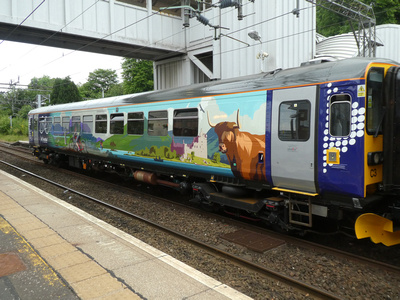
|
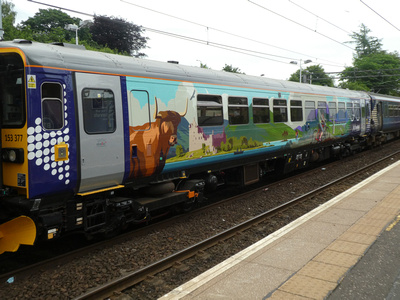
|
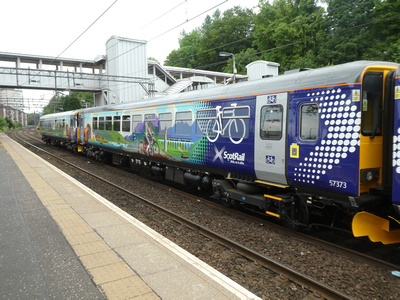
|
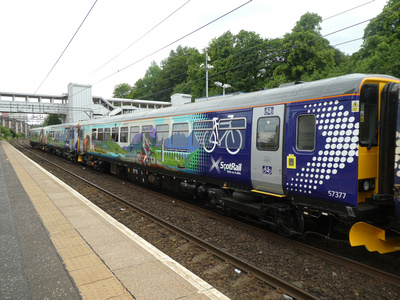
|
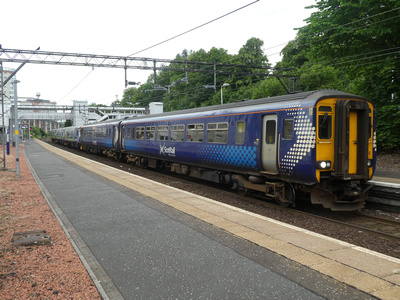
|
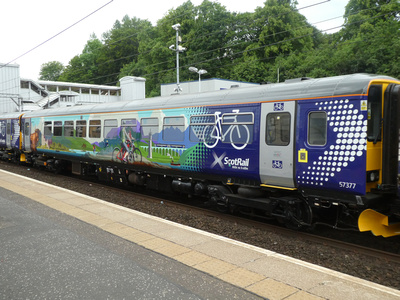
|
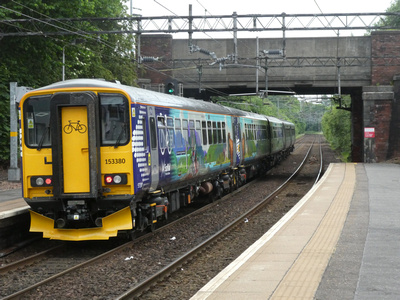
|
A sunny afternoon at Cartland 3.4.21
| 66114 | DB Schenker liveried 66114 passes through Carluke with 4M30 Grangemouth - Daventry containers 2.1.21 |
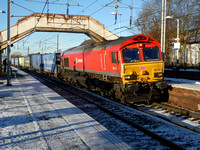
|
| 66421+66738 | DRS liveried 66421 + GBRF liveried 66738 pass through Carluke with 6K53 Cathcart East Junction - Carlisle Yard engineering working 2.1.21 |
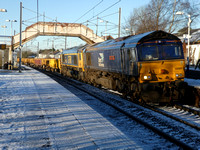
|
| 390011 | Avanti West Coast liveried 390011 passes Cartland (between Carluke and Lanark Junction) with 1M13 12.40 Glasgow Central - London Euston service 29.12.20 |

|
| 385025+385038 | Scotrail Saltire liveried 385025+385038 are seen passing Cartland (between Carluke and Lanark Junction) with 5B76 ECS working from Glasgow Central - Lanark 29.12.20 |

|
| 66765 | GBRF liveried 66765 passes Cartland (between Carluke and Lanark Junction) with 6K34 Cowlairs East Junction - Carlisle Yard engineering working 29.12.20 |
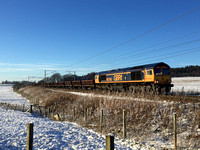
|
| 385044 | Scotrail Saltire liveried 385044 passes Cartland with 2B77 13.19 Lanark - Glasgow Central service 29.12.20 |
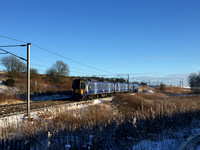
|
| 88005 | DRS 'Compass' liveried 88005 passes Cartland (between Lanark Junction and Carluke) with 4S43 Daventry - Mossend Container working 29.12.20 |
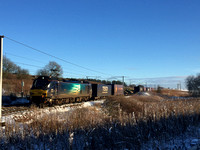
|
DRS liveried 88005 is seen from the Bushelhead Road bridge outside Carluke with 4S43 Daventry - Mossend container working 28.12.20 https://scottishtrains.zenfolio.com/p289014899/ef42b5659
EWS liveried 66006 approaches Carstairs South Junction with 6S50 Carlisle Yard - Millerhill departmental working 23.12.20 https://scottishtrains.zenfolio.com/p289014899/ef4022917
| 90002 | Intercity liveried 90002 with matching Mark 3's and DVT pass through Cartland with 1Z90 London Euston - Glasgow Central Locomotive Services Limited Royal Scot tour 12.12.20 |
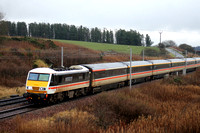
|
| 90002 | In a scene that could easily be from the late 1980's / early-mid 90's Intercity liveried DVT 82139 is seen leading a set of Mark 3's with 90002 pushing on the rear through Carluke with 1Z91 Glasgow Central - Carlisle Locomotive Services Limited's Royal Scot railtour 12.12.20 |
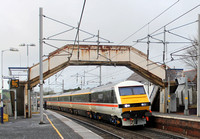
|
| 90002 | In a scene that could easily be from the late 1980's / early-mid 90's Intercity liveried 90002 is seen pushing a set of Mark 3's with 82136 leading as they pass through Carluke with 1Z91 Glasgow Central - Carlisle Locomotive Services Limited's Royal Scot railtour 12.12.20 |

|
EWS liveried 66102 is seen approaching Carluke with 4M30 Grangemouth - Daventry container working 14.11.20 https://scottishtrains.zenfolio.com/p175132471/ef182db78
An extremely dirty Debranded Wrexham and Shropshire liveried 67012 top and tailed with an equally manky EWS liveried 67020 pass through Holytown with 3S93 Stirling - Slateford RHTT working 14.11.20 https://scottishtrains.zenfolio.com/p175132471/ef182db81
| 257 | The latest Edinburgh tram to receive a new advert livery is 257, which is seen arriving at Ingliston Park and Ride on an Airport - York Place service wearing an advert from the Ray Harryhausen 'Titan of Cinema' exhibition at the National Galleries of Scotland 13.11.20 |

|
| 257 | The latest Edinburgh tram to receive a new advert livery is 257, which is seen arriving at Ingliston Park and Ride on an Airport - York Place service wearing an advert from the Ray Harryhausen 'Titan of Cinema' exhibition at the National Galleries of Scotland 13.11.20 |
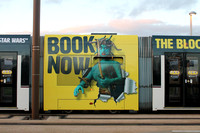
|
| 257 | The latest Edinburgh tram to receive a new advert livery is 257, which is seen arriving at Ingliston Park and Ride on an Airport - York Place service wearing an advert from the Ray Harryhausen 'Titan of Cinema' exhibition at the National Galleries of Scotland 13.11.20 |
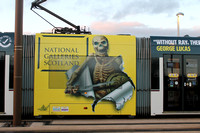
|
| 257 | The latest Edinburgh tram to receive a new advert livery is 257, which is seen arriving at Ingliston Park and Ride on an Airport - York Place service wearing an advert from the Ray Harryhausen 'Titan of Cinema' exhibition at the National Galleries of Scotland 13.11.20 |
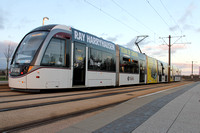
|
| 257 | The latest Edinburgh tram to receive a new advert livery is 257, which is seen arriving at Ingliston Park and Ride on a York Place - Airport service wearing an advert from the Ray Harryhausen 'Titan of Cinema' exhibition at the National Galleries of Scotland 13.11.20 |
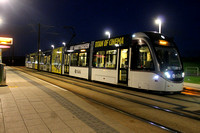
|
| 272 | Edinburgh's CAF Urbos 272, wearing an advert for John Lewis, pauses at Ingliston Park and Ride with a service from Airport - York Place 13.11.20 |
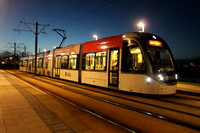
|
| 385103 | With the sunset in the background, 385103 arrives at Greenfaulds with 2J50 16.25 Glasgow Central - Edinburgh Waverley via Cumbernauld service 6.11.20 |
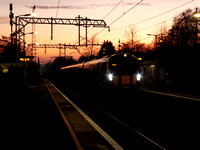
|
| 385106 | 385106 is seen arriving at Greenfaulds with 2J97 16.03 Edinburgh Waverley - Glasgow Queen Street via Cumbernauld service 6.11.20 |
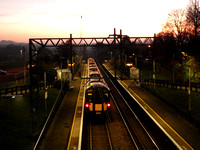
|
| 320414 | 320414 pauses at Greenfaulds with 2C06 15.40 Milngavie - Cumbernauld service 6.11.20 |
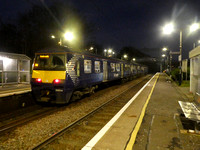
|
| 385032 | 385032 pauses at Cumbernauld with 2J52 16.55 service from Glasgow Central - Edinburgh Waverley 6.11.20 |
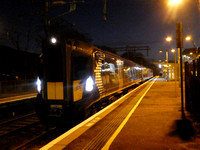
|
With construction work underway for a new office block in the background, Edinburgh's CAF Urbos 3 no 277 departs Edinburgh Park Central with a York Place - Airport service 6.11.20 https://scottishtrains.zenfolio.com/p668072304/ef0fff116
37219 top and tailed with 37116 are seen Carstairs with 1Q80 Mossend - Mossend via Carstairs Network Rail PLPR service 3.11.20 https://scottishtrains.zenfolio.com/p175132471/ef0cc3e0f
334014 is seen having departed Partick and heading towards Charing Cross with 2V52 13.26 Dunbarton Central - Springburn service 3.11.20 https://scottishtrains.zenfolio.com/p175132471/ef0cc3e22
Scotrail Saltire liveried 320418+320303 approach Partick with 2E55 13.16 service from Airdrie - Balloch 3.11.20 https://scottishtrains.zenfolio.com/p175132471/ef0cc3e10
Wearing masks on the cab end to promote the wearing of face masks on all Stations and services, HST powercars 43181 and 43015 (without mask) top and tail a set of Mark 3's as they approach Dalmeny with 1B32 13.12 Montrose - Edinburgh Waverley service 30.10.20 https://scottishtrains.zenfolio.com/p337211789/ef089a423
| 385007 | Scotrail Saltire liveried 385007 prepares to depart from Wemyss Bay with 1W24 14.57 service to Glasgow Central 16.10.20 |
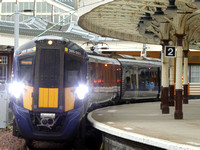
|
| 385007 | Scotrail Saltire liveried 385007 prepares to depart from Wemyss Bay with 1W24 14.57 service to Glasgow Central 16.10.20 |
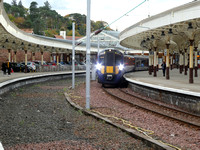
|
| Wemyss Bay | The interior of the stunning 1903 built Wemyss Bay station 16.10.20 |
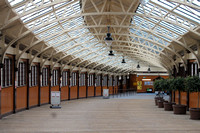
|
| Wemyss Bay | The interior of the stunning 1903 built Wemyss Bay station 16.10.20 |

|
| Wemyss Bay | The platform canopy of the stunning 1903 built Wemyss Bay station 16.10.20 |
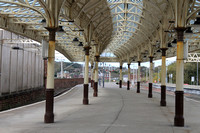
|
Scotrail Saltire liveried 156508 departs Stranraer with 1A67 13.04 service to Kilmarnock 13.10.20 https://scottishtrains.zenfolio.com/p337211789/eef4a4431
| D6817+D6851 | British Railways Green liveried D6817 (37521)+D6851 (37667) approach Carstairs with 0Z39 Carlisle High Wapping sidings - Mossend light engine move 25.9.20 |
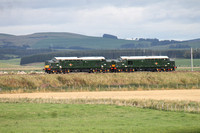
|
| D6817+D6851 | British Railways Green liveried D6817 (37521)+D6851 (37667) pause on the Down Main Line at Carstairs with 0Z39 Carlisle High Wapping sidings - Mossend light engine move 25.9.20 |
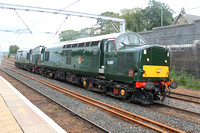
|
| 90001 | Locomotive services Limited's Intercity liveried 90001 approaches Carstairs with 1Z40 London Euston - Mossend private charter 25.9.20 |
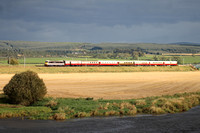
|
| 90001 | A close up of Intercity liveried 90001 'Royal Scot' 25.9.20 |

|
| 90001 | Locomotive services Limited's Intercity liveried 90001 approaches Carstairs with 1Z40 London Euston - Mossend private charter 25.9.20 |
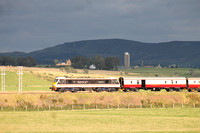 https://scottishtrains.zenfolio.com/p704210871/eee1e6f79
https://scottishtrains.zenfolio.com/p704210871/eee1e6f79 |
| 385045+385021 | Scotrail Saltire liveried 385045+385021 pause at Prestonpans with 2Y09 10.30 North Berwick - Edinburgh Waverley 22.9.20 |
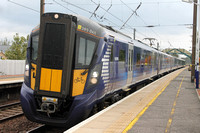
|
| 66164 | 66164 is seen approaching Prestonpans with Prestonpans with 4E96 Mossend - Tees Dock container working 22.9.20 |
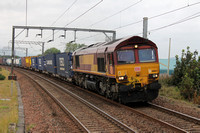
|
| 385004+385039 | Scotrail Saltire liveried 385004+385039 arrive at Prestonpans with 2Y10 10.42 Edinburgh Waverley - North Berwick 22.9.20 |
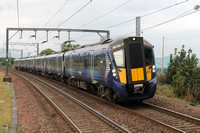
|
| 801220 | LNER Azuma 801220 approaches Prestonpans with 1E12 11.01 Edinburgh Waverley - London Kings Cross 22.9.20 |
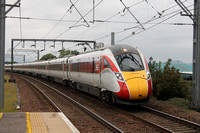
|
| 380111 | 380111 rushes through Prestonpans with 2D86 11.02 Dunbar - Edinburgh Waverley service 22.9.20 |
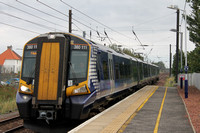
|
| 802205 | TPE Class 802 802205 approaches Prestonpans with 5M11 Craigentinny - Newcastle ECS move 22.9.20 |
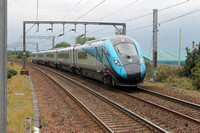
|
| 56302 | Colas liveried 56302 6S31 Doncaster - Millerhill engineers working 22.9.20 |
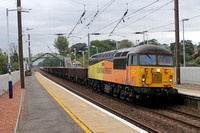
|
| 801228 | LNER Azuma 801228 passes through Prestonpans 1S06 7.30 London Kings Cross - Edinburgh Waverley service 22.9.20 |
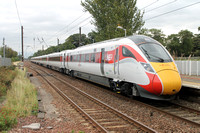
|
| 43143+43142 | Scotrail powercars 43143+43142 approach Prestonpans with a Haymarket - Doncaster Power car move 22.9.20 |
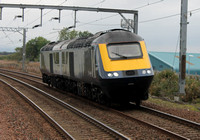
|
Black 5 no 44871 is seen waiting in the Down Goods Loop at Carstairs with 5Z46 Carnforth - Fort William working 21.9.20 https://scottishtrains.zenfolio.com/p704210871/eeddc4a26
EWS liveried 67020 top and tailed with debranded Wrexham and Shropshire liveried 67012 pass through Holytown with 3S93 Shettleston Loop - Slateford RHTT working 18.9.20 https://scottishtrains.zenfolio.com/p704210871/eedaf3e61
| 47712 tnt 40145 | Scotrail liveried 47712 top and tailed with BR blue liveried 40145 arrive into Appleby on the final day of the 'Staycation Express' working 1Z43 12.18 Skipton - Appleby 12.9.20 |
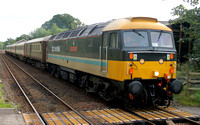
|
| 40145 | BR blue liveried 40145 is seen on the rear of the 'Staycation Express' at Appleby 12.9.20 |
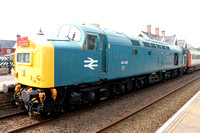
|
| D6817, D8107 and 40145 | British Railways liveried D6817 (37667) and D8107 (20107) are seen in Appleby North sidings, 20107 is being shunted up to couple onto 37667. BR Blue liveried 40145 is waiting to leave with the next 'Staycation Express' 12.9.20 |
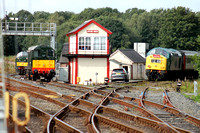
|
| 40145 tnt 47712 | BR Blue liveried 40145 top and tailed with Scotrail liveried 47712 'Lady Diana Spencer' passes Kirkby Stephen with the final day of the 'Staycation Express' 1Z44 14.38 Appleby - Skipton passenger working 12.9.20 |
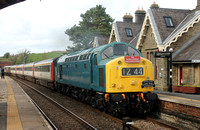
|
| 40145 tnt 47712 |
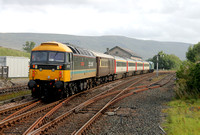
|
A1 Peppercorn class 60163 'Tornado' passes Kirtlebridge with 1Z62 12.11 Carlisle - Edinburgh Waverley 'The Queen of Scots' tour 12.9.20 https://scottishtrains.zenfolio.com/p704210871/eed51ae9c
| 37421+Caroline | Former Southern General Manager's Inspection Saloon 975025 'Caroline' is seen being pushed through Gartcosh by Colas liveried 37421 with 5Z22 Fort William Yard - Mossend 11.9.20 |

|
| 37421+Caroline | Former Southern General Manager's Inspection Saloon 975025 'Caroline' is seen being pushed through Gartcosh by Colas liveried 37421 with 5Z22 Fort William Yard - Mossend 11.9.20 |
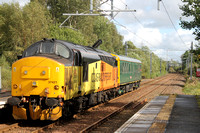
|
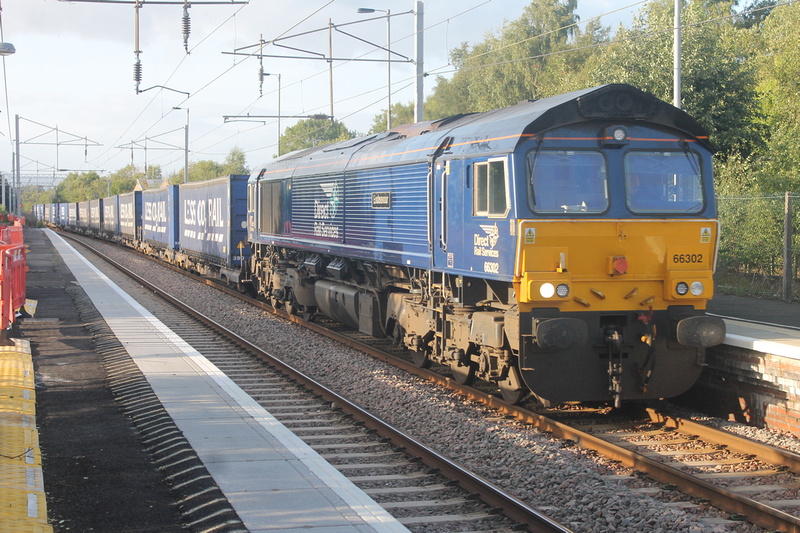
DRS liveried 66302 passes through Coatbridge Central with 4D47 66302 Inverness - Mossend Containers 9.9.20
| 325001+325005 | Royal Mail EMU's 325001+325005 approach Carstairs with 1M03 Shieldmuir - Warrington working 8.9.20 |
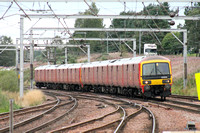
|
| 66746 | Royal Scotsman liveried 66746 approaches Carstairs with 6K73 Polmont - Carlisle Yard engineering move 8.9.20 |
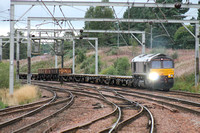
|
| 66069 | 66069 approaches Carstairs with 6O15 Mossend - Dagenham empty car transporters 8.9.20 |
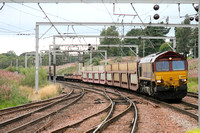
|
| 320414 | 320314 departs Carstairs with 5C05 18.11 ECS move to Yoker 8.9.20 |
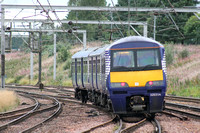
|
| 88005 | DRS liveried 88005 waits in the Down Goods Loop at Carstairs with the early running 4S44 Daventry - Mossend container working 8.9.20 |
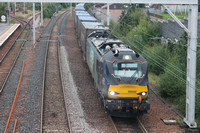
|
| 88005 | DRS liveried 88005 waits in the Down Goods Loop at Carstairs with the early running 4S44 Daventry - Mossend container working 8.9.20 |
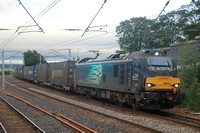
|
| 90007+90042 | Debranded Anglia liveried 90007+Freightliner liveried 90042 pass through Carstairs with 4M11 Coatbridge Freightliner - Crewe Basford Hall 8.9.20 |
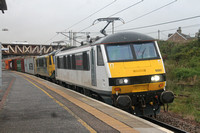
|
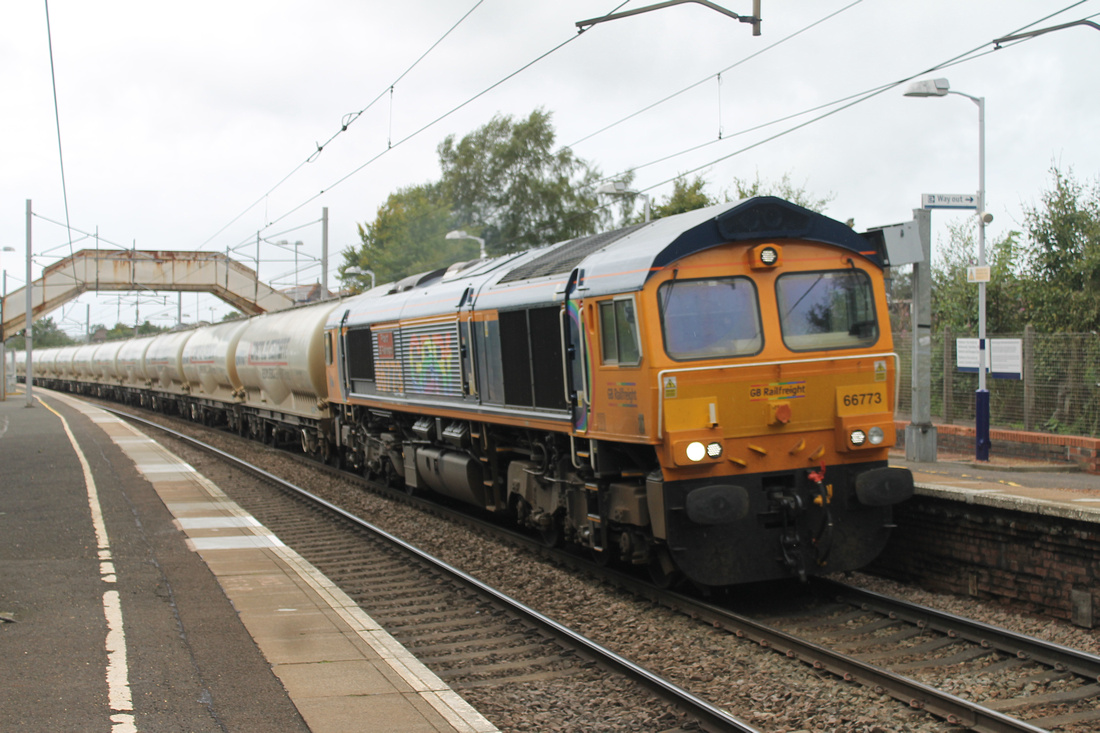
GBRF liveried 66773 'Pride of GB Railfreight' with Rainbow coloured GBRF lettering, passes through Carluke with 4M01 Mossend - Carlisle Yard Cement working 5.9.20
| 37423 tnt 37402 | DRS liveried 37423 top and tailed with BR Large Logo liveried 37402 approach Greenfaulds with 1Q77 Mossend - Inverness Milburn Network Rail PLPR test train 5.9.20 |
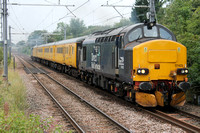
|
| 37423 tnt 37402 | DRS liveried 37423 top and tailed with BR Large Logo liveried 37402 approach Greenfaulds with 1Q77 Mossend - Inverness Milburn Network Rail PLPR test train 5.9.20 |
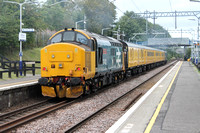
|
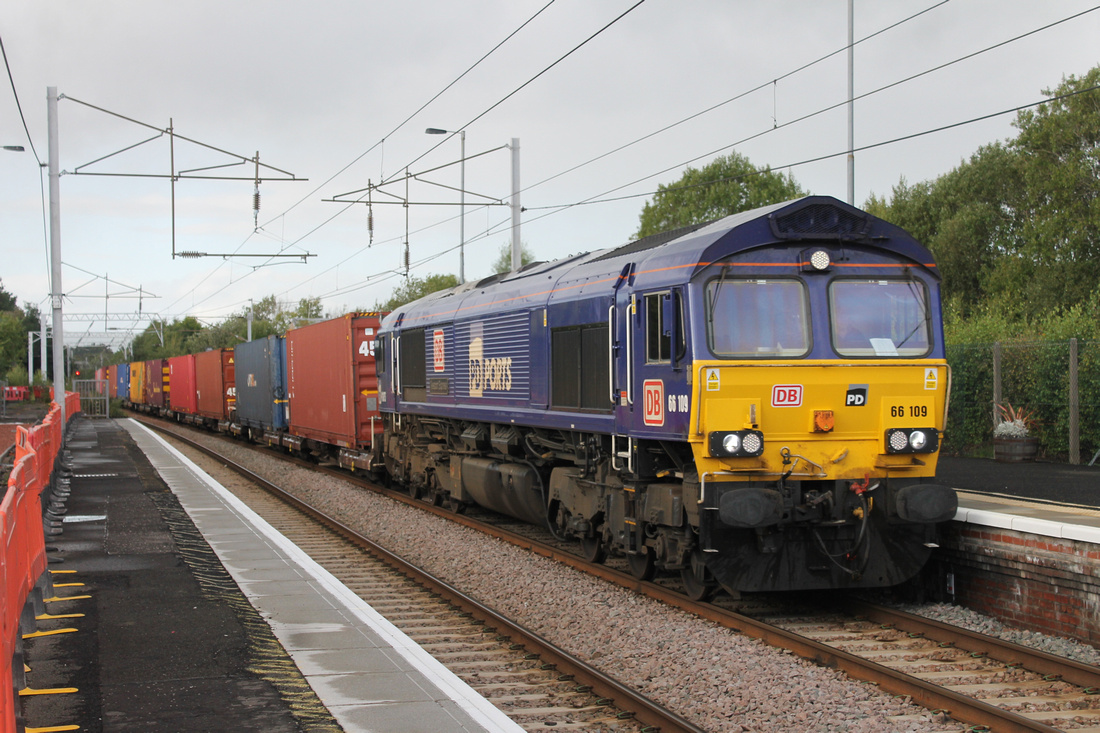
PD Ports liveried 66109 passes through Coatbridge Central with 4E99 Grangemouth - Tees Dock Containers 4.9.20
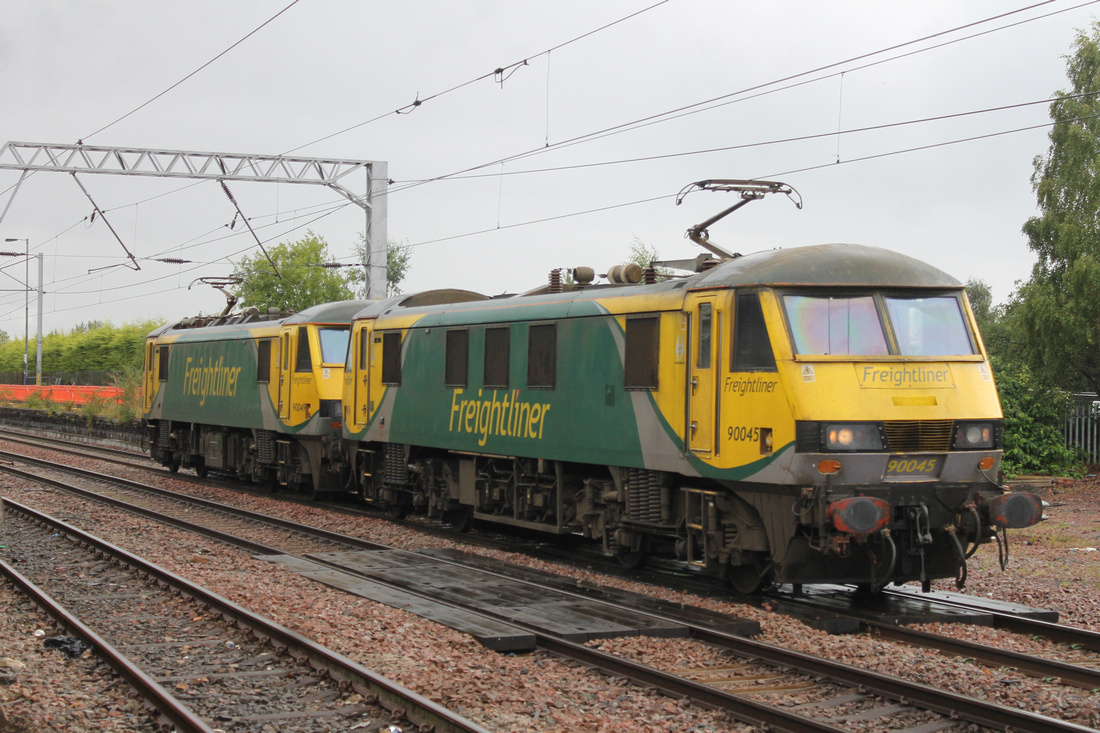
90045+90049 pass Coatbridge Central with 0M11 Mossend - Coatbridge Freightliner depot light engine move 4.9.20
| 390119 | Pride liveried Avanti West Coast Pendolino 390119 is seen approaching Carstairs with 1S69 13.10 London Euston - Glasgow Central service 2.9.20 |
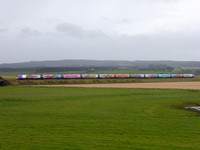
|
| 390119 | Pride liveried Avanti West Coast Pendolino 390119 is seen approaching Carstairs with 1S69 13.10 London Euston - Glasgow Central service 2.9.20 |
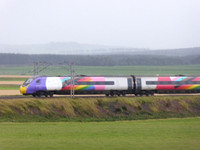
|
| 390119 | Pride liveried Avanti West Coast Pendolino 390119 is seen approaching Carstairs with 1S69 13.10 London Euston - Glasgow Central service 2.9.20 |
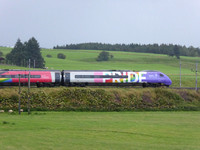
|
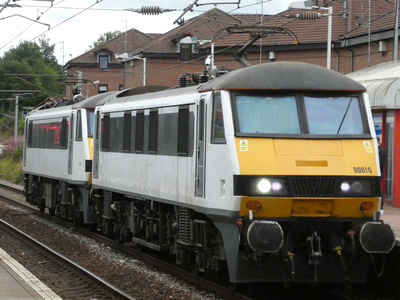 Following the replacement of the class 90's and mark 3 sets by class 745 and class 755 FLIRT units in East Anglia, a number of their redundant class 90's moved to Frieghtliner to replace some of the elderly class 86 locomotives on their intermodal container train workings. The class 90's are no stranger to the Lanarkshire / Glasgow area however as they were often seen in this area when they were with the BR Intercity and later the Virgin West Coast franchise and often worked on the Glasgow - London WCML workings.
Following the replacement of the class 90's and mark 3 sets by class 745 and class 755 FLIRT units in East Anglia, a number of their redundant class 90's moved to Frieghtliner to replace some of the elderly class 86 locomotives on their intermodal container train workings. The class 90's are no stranger to the Lanarkshire / Glasgow area however as they were often seen in this area when they were with the BR Intercity and later the Virgin West Coast franchise and often worked on the Glasgow - London WCML workings.
Here are two of the class 90's 90010+90006 on one of their early working for Freightliner passing through Whifflet
| 90010+90006 | Debranded Anglia liveried 90010+90006 pass through Whifflet with 0L89 Mossend - Coatbridge Freightliner light engine move 1.9.20 |
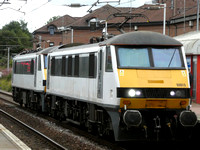
|
| 90010+90006 | Debranded Anglia liveried 90010+90006 pass through Whifflet with 0L89 Mossend - Coatbridge Freightliner light engine move 1.9.20 |
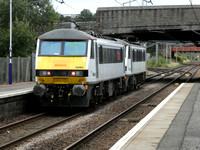
|
| 4CEP 2315 | 4CEP 2315 (61798+70357+70229+61799) in faded South West Trains livery is seen stabled at Warcrop on the Eden Valley Railway (photo taken from a public path) 22.8.20 |

|
| 4CEP 2315 | 4CEP 2315 (61798+70357+70229+61799) in faded South West Trains livery is seen stabled at Warcrop on the Eden Valley Railway (photo taken from a public path) 22.8.20 |
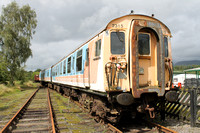
|
| 4CEP 2315 (61798+70357+70229+61799) in faded South West Trains livery is seen stabled at Warcrop on the Eden Valley Railway. Sister unit 2311 (61804+70607+70539+61805) is seen behind (photo taken from a public path) 22.8.20 |

|
|
| 37042 | EWS liveried 37042 is seen stabled at Warcrop. 22.8.20 |
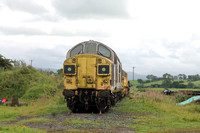
|
| 47712 tnt D6817 | Scotrail liveried 47712 'Lady Diana Spencer' top and tailed with BR Green liveried D6817 (37521) arrives into Appleby with 1Z43 12.18 Skipton - Appleby Locomotive Services Limited passenger working 22.8.20 |
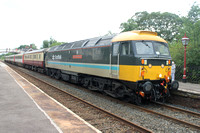
|
| 47712 tnt D6817 | Scotrail liveried 47712 'Lady Diana Spencer' is seen at the front of 5Z44 Appleby - Appleby ECS working 22.8.20 |
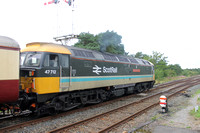
|
| 47712 tnt D6817 | Scotrail liveried 47712 'Lady Diana Spencer' top and tailed with BR Green liveried D6817 (37521) depart Appleby with 5Z44 Appleby - Appleby ECS working 22.8.20 |
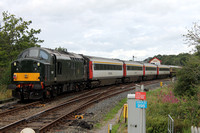
|
| D6817 tnt 47712 | BR Green liveried D6817 (37521) top and tailed with Scotrail liveried 47712 'Lady Diana Spencer' passes Kirkby Stephen with 1Z44 14.38 Appleby - Skipton Locomotive Services Limited passenger working 22.8.20 |
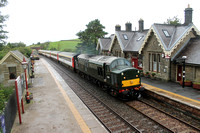
|
| D6817 tnt 47712 | BR Green liveried D6817 (37521) top and tailed with Scotrail liveried 47712 'Lady Diana Spencer' passes Kirkby Stephen with 1Z44 14.38 Appleby - Skipton Locomotive Services Limited passenger working 22.8.20 |
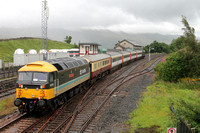
|
| 56103 | DC Rail Freight liveried 56103 is seen hauling the RAUK3 RailVac from one of the sidings at Carstairs Civil Engineers sidings before running round to haul the RailVac as 6X56 to Carlisle 10.8.20 |
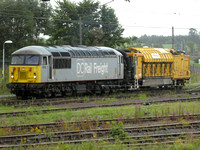
|
| 56103 | DC Rail Freight liveried 56103 is seen hauling the RAUK3 RailVac from one of the sidings at Carstairs Civil Engineers sidings before running round to haul the RailVac as 6X56 to Carlisle 10.8.20 |
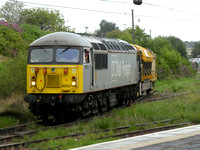
|
| RAUK-3 | RAUK-3 Railvac at Carstairs 10.8.20 |
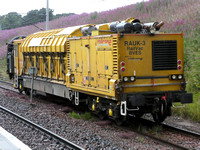
|
| 56103 | As part of the move to collect the RailVac from Carstairs Civil Engineers sidings, 56103 is seen passing through Carstairs station as it runs round the RailVac 10.8.20 |
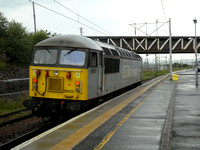
|
| 56103 | DC Rail Freight liveried 56103 is seen at the entry point to Carstairs Civil Engineers sidings with RailVac RAUK-3 before they reverse back into the Up Passing Loop prior to heading south as 6X56 to Carlisle 10.8.20 |
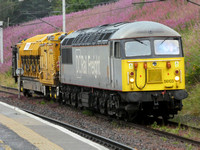
|
| 153373 | Having recently arrived, GWR Green liveried 153373 + 153380 are seen stabled in the yard at Kilmarnock Bonnyton awaiting refurbishment for use with Scotrail alongside class 156's on the West Highland Line 4.8.20 |
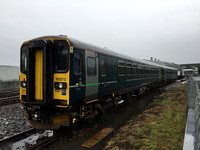
|
| 153380 | Having recently arrived, GWR Green liveried 153373 + 153380 are seen stabled in the yard at Kilmarnock Bonnyton awaiting refurbishment for use with Scotrail alongside class 156's on the West Highland Line 4.8.20 (photo taken through the fence) |
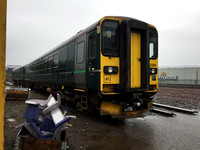
|
| 43032+43134 | Scotrail 7 cities liveried 43032 and 43134 top and tail a set of Mark 3's through a very wet Lenzie with 1A67 13.39 Glasgow Queen Street - Aberdeen service 4.8.20 |
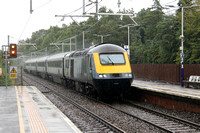
|
| 43032+43134 | Scotrail 7 cities liveried 43032 and 43134 top and tail a set of Mark 3's through a very wet Lenzie with 1A67 13.39 Glasgow Queen Street - Aberdeen service 4.8.20 |
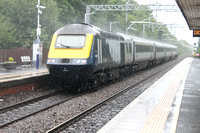
|
| 385006+385002 | In the pouring rain, Scotrail Saltire liveried 385006+385002 arrive at Lenzie with 2N46 13.13 Alloa - Glasgow Queen Street service 4.8.20 |
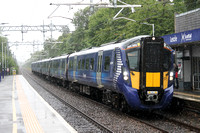
|
| 385006+385002 | In the pouring rain, Scotrail Saltire liveried 385006+385002 arrive at Lenzie with 2N46 13.13 Alloa - Glasgow Queen Street service 4.8.20 |
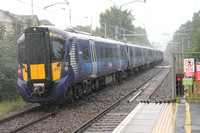
|
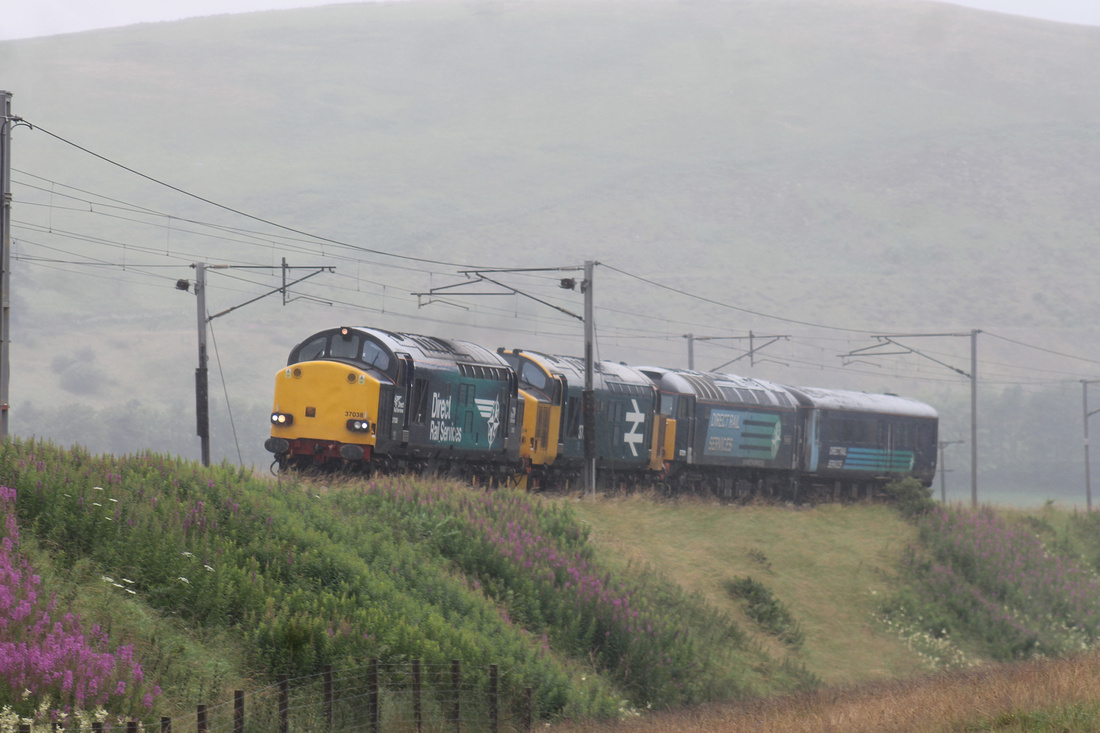 A southbound convoy of 37038+37424+57311 and DBSO 9710 approach Crawford with 5Z37 Bo'ness Ground frame - Carlisle Kingmoor 4.8.20 https://scottishtrains.zenfolio.com/p817242251/eeb4b5162
A southbound convoy of 37038+37424+57311 and DBSO 9710 approach Crawford with 5Z37 Bo'ness Ground frame - Carlisle Kingmoor 4.8.20 https://scottishtrains.zenfolio.com/p817242251/eeb4b5162
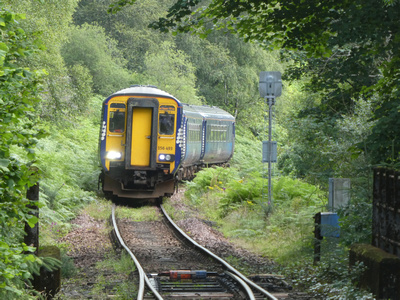 A weekend away by the side of Loch Long just south of Arrochar and Tarbet on the West Highland Line and a great view of the passing trains saw a few interesting sightings!
A weekend away by the side of Loch Long just south of Arrochar and Tarbet on the West Highland Line and a great view of the passing trains saw a few interesting sightings!
| 156493+156499 | Scotrail liveried 156493+156499 approach Arrochar and Tarbet with 1Y22 8.57 Oban - Glasgow Queen Street service 1.8.20 |
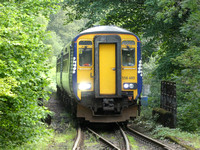
|
| 156493+156499 | Scotrail liveried 156493+156499 pause at Arrochar and Tarbet with 1Y22 8.57 Oban - Glasgow Queen Street service 1.8.20 |
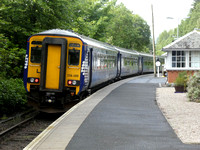
|
| 156445+156457 | Scotrail Saltire liveried 156445+156457 heads along the hillside on the shore of Loch Long having departed Arrochar and Tarbet with 1Y44 11.40 Fort William and Oban - Glasgow Queen Street service 1.8.20 |
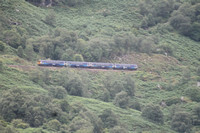
|
| 47245 | West Coast liveried 47245 heads along the hillside above Loch Long on the approach to Arrochar and Tarbert with 0Z47 Mossend - Fort William Yard light engine move 1.8.20 |
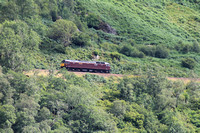
|
| 156499 | Scotrail Saltire liveried 156499 heads along the hillside above Loch Long shortly after departing Arrochar and Tarbet with 1Y26 16.11 Oban - Glasgow Queen Street service 2.8.20 |
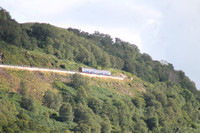
|
| 73968+73969 | Caledonian Sleeper 73968+73969 double head the northbound Caledonian Sleeper along the hillside above Loch Long on the approach to Arrochar and Tarbert with 1Y11 4.46 Edinburgh Waverley - Fort William service 3.8.20 |
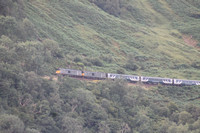
|
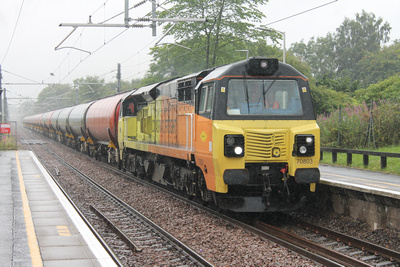
An interesting spell at Greenfaulds on 30.7.20 saw two Colas class 70's on two seperate tank workings:
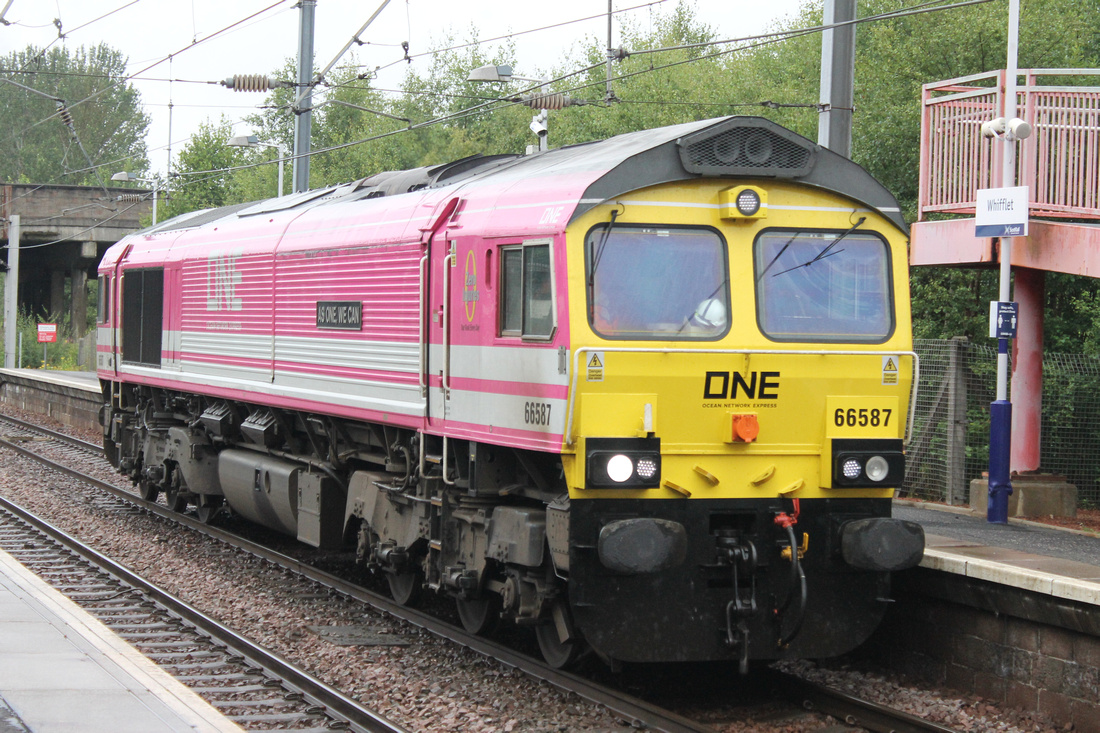 ONE pink and white liveried Freightliner class 66: 66587 'As one we can' is seen passing through Whifflet with 0Z95 Inverness - Mossend light engine move 30.7.20 https://scottishtrains.zenfolio.com/p960637260/eeb0879da
ONE pink and white liveried Freightliner class 66: 66587 'As one we can' is seen passing through Whifflet with 0Z95 Inverness - Mossend light engine move 30.7.20 https://scottishtrains.zenfolio.com/p960637260/eeb0879da
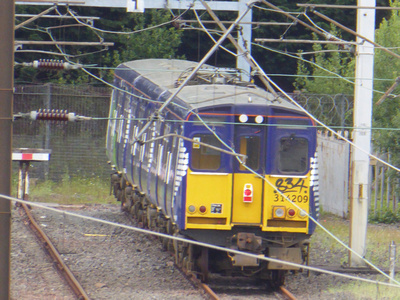 Seen from the Kelso St overbridge, the final remaining fully intact Class 314, 314209, is seen stabled in a siding at Yoker Depot
Seen from the Kelso St overbridge, the final remaining fully intact Class 314, 314209, is seen stabled in a siding at Yoker Depot
314209 is expected to be converted to operate from Hydrogen cells as a test bed for the future. 24.7.20
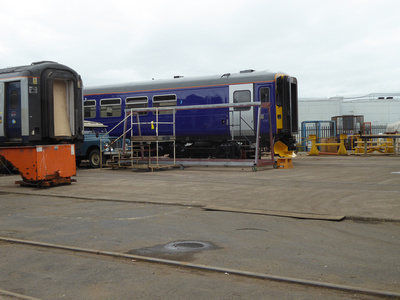 As work progresses with it's overhaul prior to use with Scotrail, an unidentified Class 153 is seen stabled in the yard at Kilmarnock Bonnyton depot 24.7.20
As work progresses with it's overhaul prior to use with Scotrail, an unidentified Class 153 is seen stabled in the yard at Kilmarnock Bonnyton depot 24.7.20
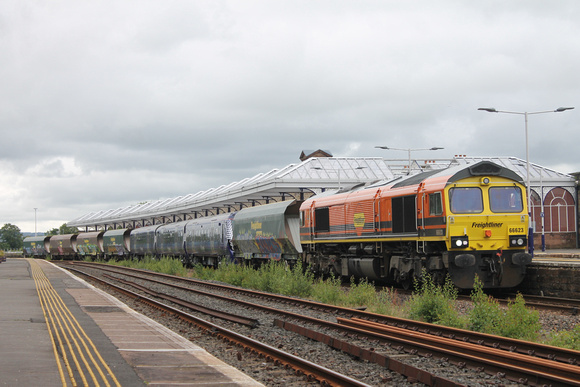 Wearing the new Freightliner livery, 66623 pauses at Kilmarnock with newly repaired class 334 no:334017 in tow along with 5 coal hoppers for brake force, whilst working 5Q34 Kilmarnock Bonnyton Depot - Sheilds EMU move 14.7.20
Wearing the new Freightliner livery, 66623 pauses at Kilmarnock with newly repaired class 334 no:334017 in tow along with 5 coal hoppers for brake force, whilst working 5Q34 Kilmarnock Bonnyton Depot - Sheilds EMU move 14.7.20
With new vynal mask promoting mandatory wearing of face masks on board the trams, CAF Urbos 3 262 pauses at Ingliston Park and Ride with an Airport - York Place service 3.7.20
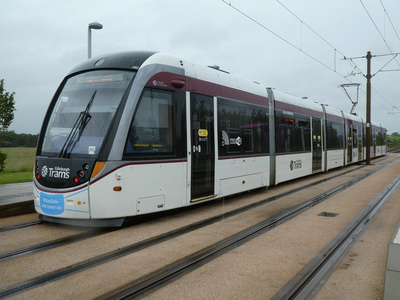
A visit to Kirknewton for the first time:
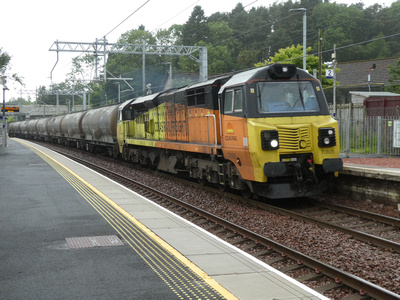 Heading home from work on 1st July 2020, I decided to pop into Hartwood for an hour to catch a couple of freight workings:
Heading home from work on 1st July 2020, I decided to pop into Hartwood for an hour to catch a couple of freight workings:
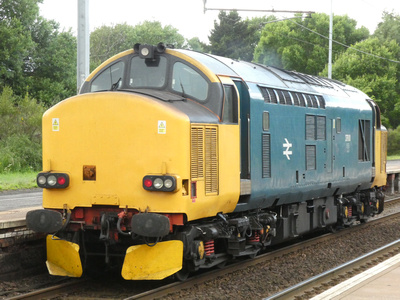 My first trip out to catch any workings since the start of lockdown coincided with BR Blue with yellow ends liveried 37610 out route learning duties. 37610 was seen as it passed through both Holytown and Blantyre with 0F85 Slateford Depot - Slateford Depot route learner on 30th June 2020.
My first trip out to catch any workings since the start of lockdown coincided with BR Blue with yellow ends liveried 37610 out route learning duties. 37610 was seen as it passed through both Holytown and Blantyre with 0F85 Slateford Depot - Slateford Depot route learner on 30th June 2020.
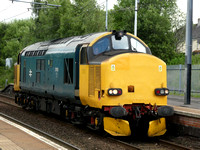
|
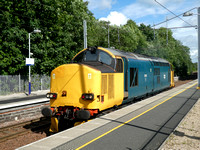
|
| 37610 at Holytown | 37610 at Blantyre |
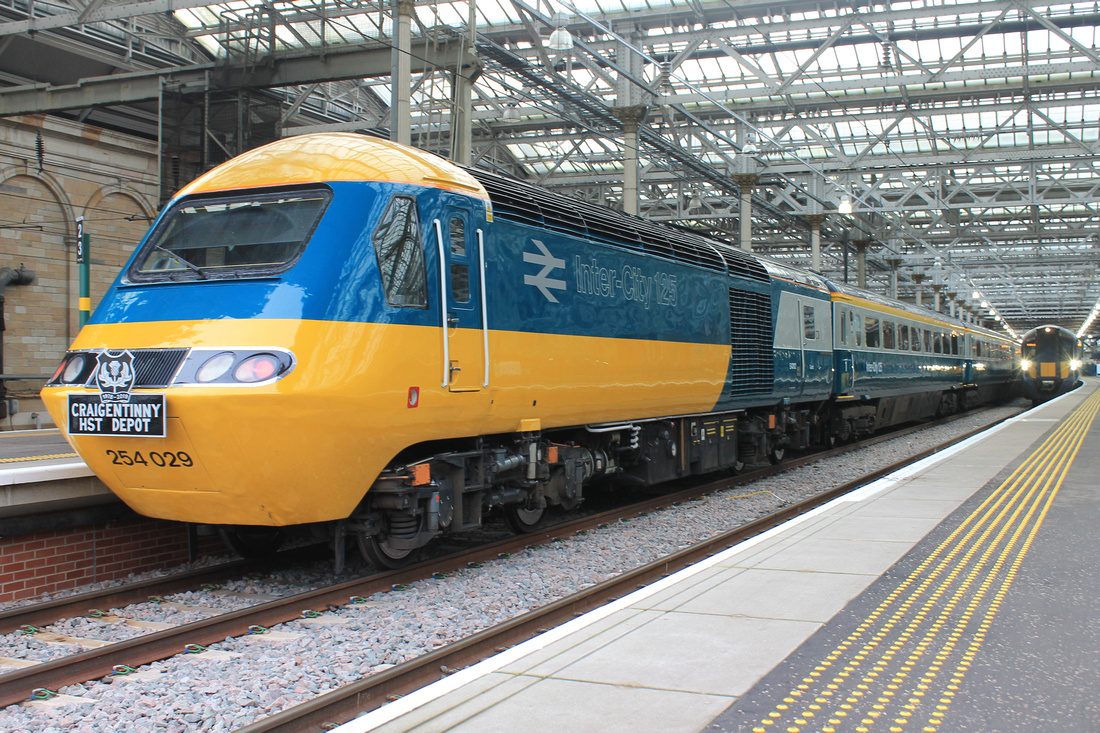 The stunning looking LNER HST set painted into original Intercity livery, is seen at Edinburgh Waverley for it's farewell staff charter to mark the end of use of the HST sets by LNER. 43112 (43312) is seen leading 43006 (43206) as they wait for departure with 1Z25 15.16 Fife Circle LNER staff tour 28.12.19
The stunning looking LNER HST set painted into original Intercity livery, is seen at Edinburgh Waverley for it's farewell staff charter to mark the end of use of the HST sets by LNER. 43112 (43312) is seen leading 43006 (43206) as they wait for departure with 1Z25 15.16 Fife Circle LNER staff tour 28.12.19
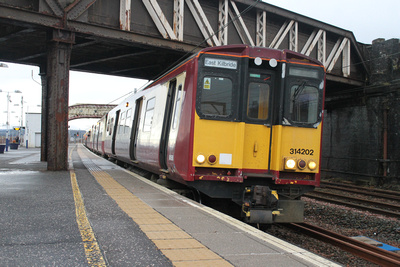 314202 and 314205 operated the farewell tour around the area on Wednesday 18th December. Starting from Glasgow Central, the units headed out to Ayr, then returned back to Glasgow Central before heading to Carstairs and Cumbernauld. After returning to Glasgow Central via a reversal at Motherwell, both units headed out to Helensburgh Central and then returned to Glasgow Central low level where the tour ended. The units then headed off back to Shields before an impending trip to Yoker to await their final journey for scrapping.
314202 and 314205 operated the farewell tour around the area on Wednesday 18th December. Starting from Glasgow Central, the units headed out to Ayr, then returned back to Glasgow Central before heading to Carstairs and Cumbernauld. After returning to Glasgow Central via a reversal at Motherwell, both units headed out to Helensburgh Central and then returned to Glasgow Central low level where the tour ended. The units then headed off back to Shields before an impending trip to Yoker to await their final journey for scrapping.
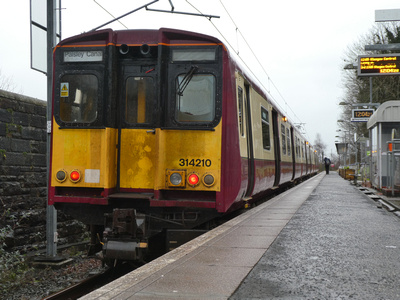 Saturday 14th December was the final day in service for the class 314 initially saw only 314210 out in service (on xx.42 Paisley Canal workings) after 314216 failed with a faulty headlight prior to entering service, however it was soon repaired and entered service from the 12.12 service to Paisley Canal and worked all afternoon. Both units worked until the 17.05 (314210) and the 17.35 (314216) services from Paisley Canal. On their return to Glasgow Central, both units were coupled together and headed back to Corkerhill for the final time.
Saturday 14th December was the final day in service for the class 314 initially saw only 314210 out in service (on xx.42 Paisley Canal workings) after 314216 failed with a faulty headlight prior to entering service, however it was soon repaired and entered service from the 12.12 service to Paisley Canal and worked all afternoon. Both units worked until the 17.05 (314210) and the 17.35 (314216) services from Paisley Canal. On their return to Glasgow Central, both units were coupled together and headed back to Corkerhill for the final time.
At Corkerhill, they were coupled to 314209, which had operated it's last service the previous day, and the three units made their way to Yoker depot, where they will be stored until they are taken away to be scrapped. 314202 and 314205 were moved to Shields Depot, where 314214 has also been in situ since it failed in service on 30th November. It is expected that 2 of those 3 units will operate the farewell tour around the area on Wednesday 18th December.
At present the situation is that of the 16 class 314's, 8 are stored and 8 are scrapped. There will be a farewell tour on Wednesday 18th December featuring any three units from 314202 / 314205 or 314214. See https://www.scotrail.co.uk/about-scotrail/news/so-long-farewell-scotrail%E2%80%99s-class-314-goodbye for more details.
The photo shows: On it's final day of service, SPT Carmine and Cream liveried 314210 preparing to depart Paisley Canal with 2D24 12.05 service to Glasgow Central.
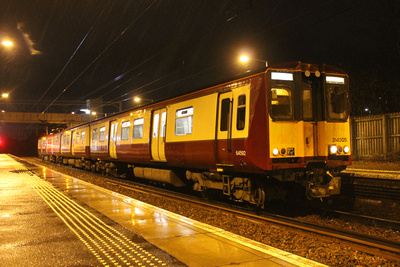 As a final send-off, ScotRail is putting on a special farewell tour around Strathclyde after the trains retire from passenger service.
As a final send-off, ScotRail is putting on a special farewell tour around Strathclyde after the trains retire from passenger service.
The last Class 314 will make its farewell journey on Wednesday, 18 December, on routes around Strathclyde that haven’t seen the trains for a number of years, and on routes that have never seen them.
ScotRail is opening the tours to the public, and in exchange for travel on the final voyage, the train operator is asking for donations to its charity partner, MND Scotland.
Three journeys will depart from Glasgow Central over the course of the day at:
- 1010 Glasgow Central – Ayr return (limited customer capacity).
- 1230 Glasgow Central – Glasgow Central via Motherwell / Carstairs / Cumbernauld.
- 1610 Glasgow Central – Helensburgh return.
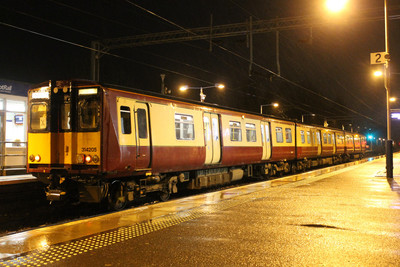 With possibly as little a time as a week left of operation for the Class 314's, six of the class are still seeing use in service. It is still possible to catch 314202 / 205 / 209 / 210 / 214 and 216 in service.
With possibly as little a time as a week left of operation for the Class 314's, six of the class are still seeing use in service. It is still possible to catch 314202 / 205 / 209 / 210 / 214 and 216 in service.
If their use in service ends on Saturday 14th (the day before the timetable changes), it is likely that Saturday 7th was the last time that a 314 will have run from Glasgow Central - Newton via Mount Florida, with 314205 doing the honours.
Sunday 8th will be their last Sunday in service with one unit (probably 314205) due in service working a diagram alternating between Glasgow Central - Newton and Neilston although it is likely that this will be upped to a 6 car set with the League Cup final taking place at Hampden. There is also a chance that a couple of 314's may end up out on Glasgow Central - Mount Florida extras.
Monday 9th - Friday 13th should see the 314's on their usual weekday workings both on peak workings on the Neilston line and the daytime off peak workings on the Cathcart Circle and Newton via Maxwell Park workings with 5 units seeing use daily.
Saturday 14th would see the 314's work for the final time on the Paisley Canal line. It is now a case of photo and ride on them while you still can.
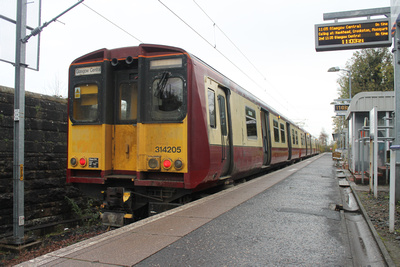 With only a few weeks remaining until the class 314's are withdrawn for good, seven of the original fleet of 16 of the class remain in service (314202 / 203 / 205 / 209 / 210 / 214 / 216), albeit in a much reduced role than they were previously used to.
With only a few weeks remaining until the class 314's are withdrawn for good, seven of the original fleet of 16 of the class remain in service (314202 / 203 / 205 / 209 / 210 / 214 / 216), albeit in a much reduced role than they were previously used to.
Five of the class continue to see use on weekdays, with three on a Saturday and one on a Sunday.
I was in Glasgow for a couple of hours on 2nd November and there was 2 class 314's in service, both on the Paisley Canal service.
314216 was operating the xx.12 service and 314205 on the xx.42 service.
A swap of units occurred and 314216 found its self on the 11.25 service to Gourock with 380016 ending up on the Paisley Canal services.
At Shields - 314203 was seen towards the east of the depot with it's pantograph up while 314210 was stabled at the west end near the sheds with it's pantograph down (presumably for maintenance).
At Corkerhill - 314214, 314202 and 314209 were stabled awaiting their next duties.
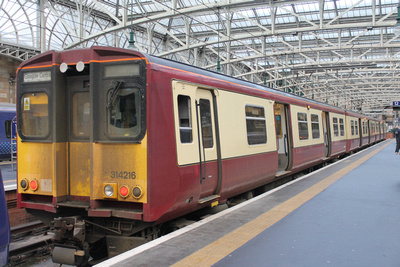
|
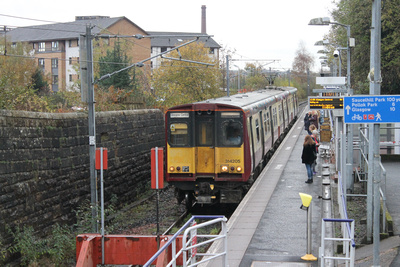
|
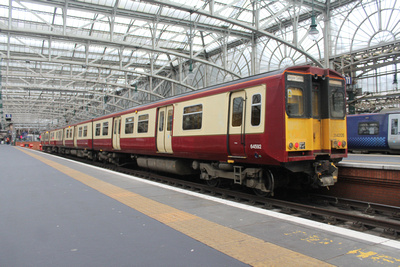
|
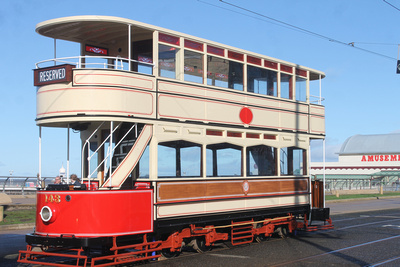 The Blackpool tramway anniversary weekend is one of the highlights for tramway enthusiasts. Over the course of the weekend, every heritage tram that can run will run at some point.
The Blackpool tramway anniversary weekend is one of the highlights for tramway enthusiasts. Over the course of the weekend, every heritage tram that can run will run at some point.
This year was no different!
Friday 27th September
I arrived in Blackpool to torrential rain, which fortunately eased around 3pm. The 2 car heritage tram service was in operation and due to the weather, Brush car 631 and Balloon 723 were used on the service. 631 was on diagram A and 723 was on diagram B (Diagram B operated the 14.40 and 16.40 extended services to Cabin.
Standard 143 was supposed to be working a tour for the Fylde Tramway Society during Friday evening, however it had developed a motor fault, which unfortunately left the tram out of service on what was supposed to be it's debut weekend. Bolton 66 substituted for 143. The tour was eventful as Bolton 66 had an overheated axle and had to be left at Fleetwood Ferry, while it was repaired. The tour participants were transported to Manchester Square on board Flexity 014, where they disembarked and headed over to Rigby Road to continue the tour onboard Centenary 648.
Balloon 715 was seen out on the Ghost Tram tour to Fleetwood and Balloon 717 operated the Fish and Chips special to Fleetwood while Western Train 733+734, HMS Blackpool 736 and Balloon 701 were seen out on Illuminations Tours.
Saturday 28th September
Saturday started bright and sunny. The first day of the anniversary weekend saw plenty of trams out: Bolton 66 had been repaired following the issue the night before and returned to service. Standard 147, Boat 227, Brush Car 631, Centenary 648, Ex Towing Railcoach 680, Balloons 701, 715, 717 and 723. Balloon 713 operated on the depot shuttle service between Rigby Road and Starr Gate. 631 and 680 operated an hourly service between Fleetwood and Starr Gate.
Millennium Balloon 718 was used as the shop tram at North Pier, whilst the superbly restored Standard 143 was on display at North Pier beside 718. At Rigby Road Twin Car 675+685, Brush Car 634 and Boat 230 were on display along the fitting shop wall. All 3 trams are awaiting rewiring before re-entering service. On the depot fan, All over red liveried Centenary 645, Wynsor world of shoes and orange liveried 761 and Plum and Cream liveried OMO 8 were displayed.
In the afternoon, the heavens opened and 227 was quickly dispatched back to depot. Balloon 701 worked the final heritage service of the day from Bispham to Manchester Square.
Into the evening and the Western Train 733+734, HMS Blackpool 736 and Balloons 701, 717 and 723 operated on the illumination tours, 733+734 and 736 operated at least 3 tours each.
Sunday 29th September
Sunday began with more torrential rain, which lasted until 2pm. The tram allocation changed due to the weather. The morning saw Brush Cars 621 and 631, Centenary 648, Balloons 713, 715, 717 and 723 and Illuminated trams 736 and 737 in service. Balloon 711 worked the depot shuttle, while 715 and 723 worked an hourly service between Starr Gate and Fleetwood. Once again Millennium Balloon 718 was used as the shop tram at North Pier, whilst the superbly restored Standard 143 was on display beside 718.
Open topped Balloon 706 'Princess Alice' and stored Balloon 704, which is still wearing it's Eclipse livery that it received in 2000 were on display along the fitting shop wall. Both trams are awaiting new underframes. On the depot fan was Twin Cars 675+685, 676+686, T2+272 and twin car motor 671.
I went on the 11am depot tour. The tour, led by Bryan Lyndop, the Head of Heritage at Blackpool Transport began in the Electrical Compound where Boat 230 and Brush Car 634 were stabled. Both trams are expected to be rewired to allow them to return to service in the next few years. The first tram to be rewired will be Twin Car 675+685. Work has already commenced on removing the old wiring from this tram. Next we were taken into the rear part of the main running shed where we viewed some of the withdrawn or stored trams. Visible were Balloon 726, Boat 600 (which was near the back of the depot to stay dry!), Coronation 304, Balloon 701 and Millennium Balloons 709 and 724.
We were then taken across to the fitting shop, which although empty of trams, had a wide array of parts visible such as motors and seating. The steelwork for the new underframe that will be built for the major restoration of Balloon 704 was also visible. The Body Shop featured the body shells for future restorations Lytham 43 and Glasgow 1016. There was also the framework for a project from a local college for a replica of the 'tank tram', which used to travel around the system during the first world war. There wasn't any trams in the paint shop, however Standard 143 was expected to return there soon to have it's new paintwork varnished.
As our tour slightly over ran and the shuttle tram to take us all to Starr Gate depot for the second part of the tour had left with out us, we got the chance to take some photos of some more of the withdrawn trams from the front of the depot. It was possible to see trams such as Balloon 720, Brush Car 632, Balloon 708 and the Roadliner tram from Preston. After a bus had been scrambled to take us to Starr Gate, we were soon on our way.
At Starr Gate, we saw the stabling sheds, where Flexity 004 was the spare tram and was receiving repairs to a minor fault. In the engineering side of the depot, Flexities 007, 010, 011 and 018 were receiving maintenance. Soon the tour was over and out on the tramway, the weather was beginning to improve and Standard 147, Ex Towing Railcoach 680, Balloon 701 and 733+734 came out into service to join the trams already out.
Into the evening and the weather had improved dramatically! The Western Train 733+734, HMS Blackpool 736 and Balloon 717 were joined in service by Boats 600 and 227 on Illuminations tours. Both boats were fully loaded on both trips made through the lights.
Over the course of the weekend, almost all of the active heritage fleet made an appearance either in service or on display or as a shop tram. The only trams in the active fleet not to see any use were Centenary 642, Millennium Balloon 707 and B Fleet Balloons 700 and 719.
All the Flexities were seen out over the weekend except for 007. 014 returned to service after a number of months out of service.
My Gallery of photos from the Weekend can be found at: https://scottishtrains.zenfolio.com/p117643997
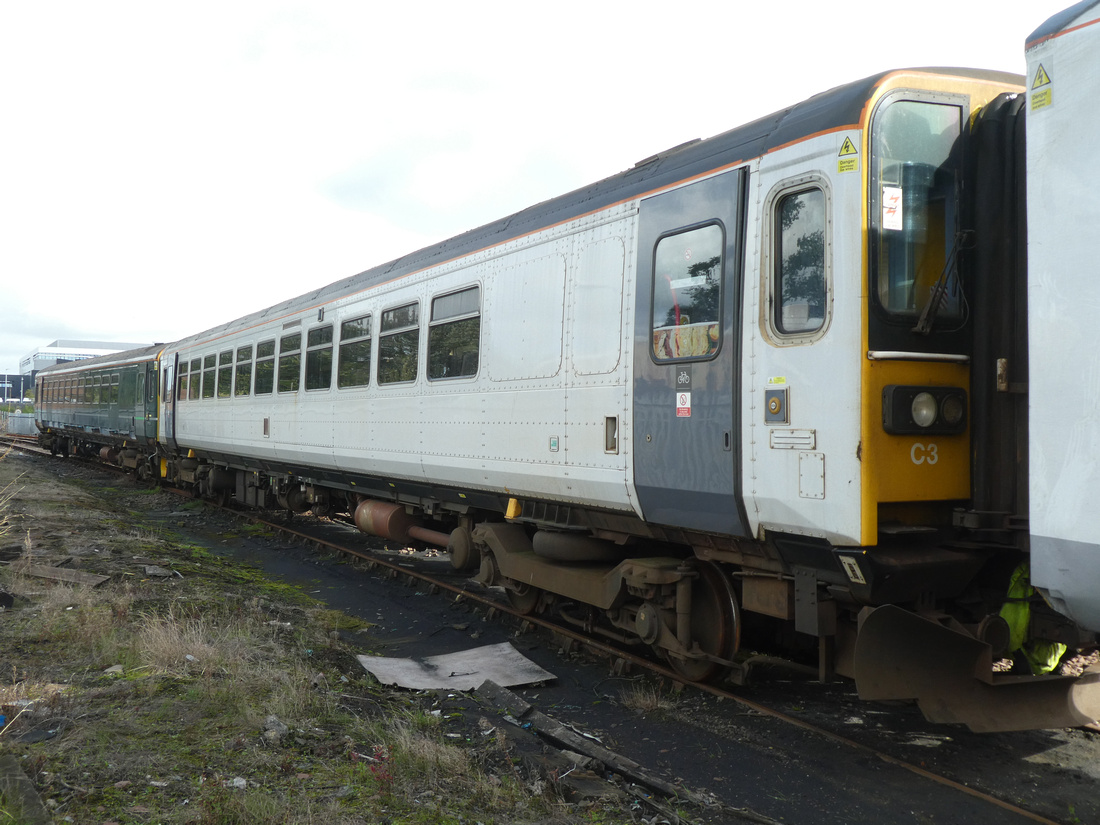 All over White with Grey doors liveried 153305 seen at Kilmarnock Bonnyton awaiting refurbishment prior to entering service with Scotrail. These units will be paired with class 156's on the West Highland Line, allowing more seating and bike storage.13.9.19 (Photo taken through the fence from a public road)
All over White with Grey doors liveried 153305 seen at Kilmarnock Bonnyton awaiting refurbishment prior to entering service with Scotrail. These units will be paired with class 156's on the West Highland Line, allowing more seating and bike storage.13.9.19 (Photo taken through the fence from a public road)
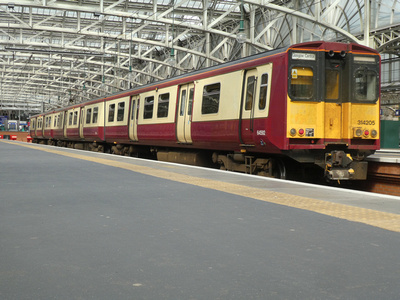 It was Carmine and Cream day as 3 of the 7 remaining servicable Class 314's saw use on Saturday 24th August, all of them in SPT Carmine and Cream livery.
It was Carmine and Cream day as 3 of the 7 remaining servicable Class 314's saw use on Saturday 24th August, all of them in SPT Carmine and Cream livery.
Only 3 diagrams are operated by 314's on a Saturday, 2 on Paisley Canal services and one entering service at 15.20 and working the xx.20 workings to Newton via Queens Park for the remainder of the day.
- 314205 worked on the xx.12 departures from Glasgow Central to Paisley canal
- 314210 worked on the xx.42 departures from Glasgow Central to Paisley canal
- 314216 worked the xx.20 departures from Glasgow Central to Newton via Queens Park from 15.20 onwards.
I had a run out to Paisley Canal and back on 314210 in the morning and noted the following:
- 314203 was stabled at the east end of shields with its pantograph down, this could potentially mean that 314203 has been withdrawn.
- 314202 was parked next to 314203 but had its pantograph up. 202's pantograph looked new.
- 314216, 209 and 214 were stabled at Corkerhill. 314209 and 314214 were coupled together, 216 would later enter service.
The photo shows 314205, waiting under the stunning glazed roof of Glasgow Central before departing with 2D37 15.12 service to Paisley Canal.
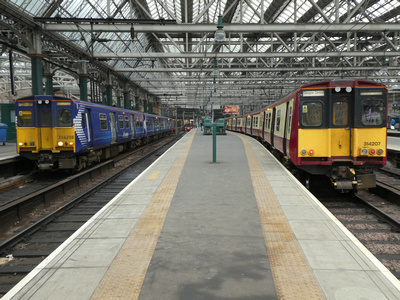 On 22nd August, 314207 became the 6th class 314 to head to Wales for scrapping. 314207 had been withdrawn from service after working the 20.24 Gourock - Glasgow Central service on 18th May. 207 had initially been withdrawn on 21st September 2018 and transferred to Yoker for storage, however after the class 385's had to be withdrawn temporarily at the end of September 2018, 207 however, had a reprieve and was quickly returned to service. Once the 385's returned to service, 207 remained in service with 204 being withdrawn instead.
On 22nd August, 314207 became the 6th class 314 to head to Wales for scrapping. 314207 had been withdrawn from service after working the 20.24 Gourock - Glasgow Central service on 18th May. 207 had initially been withdrawn on 21st September 2018 and transferred to Yoker for storage, however after the class 385's had to be withdrawn temporarily at the end of September 2018, 207 however, had a reprieve and was quickly returned to service. Once the 385's returned to service, 207 remained in service with 204 being withdrawn instead.
The scrapping of 314207 will leave 10 of the original 16 strong class still in existance, however further scrapping moves are expected soon with 314208 and 215 to make their final journeys soon as well.
The current situation with the 314's is as follows:
In Service: 314202 / 203 / 205 / 209 / 210 / 214 / 216
Stored: 314204 (Eastleigh) / 208 (Yoker) / 215 (Yoker)
Scrapped: 314201 / 206 / 207 / 211 / 212 / 213
The photo shows Scotrail Saltire liveried 314208 awaiting departure from Glasgow Central with 2D27 12.42 service to Paisley Canal while SPT Carmine and Cream liveried 314207 will depart with 2M74 12.45 to Newton via Maxwell Park 1.3.19
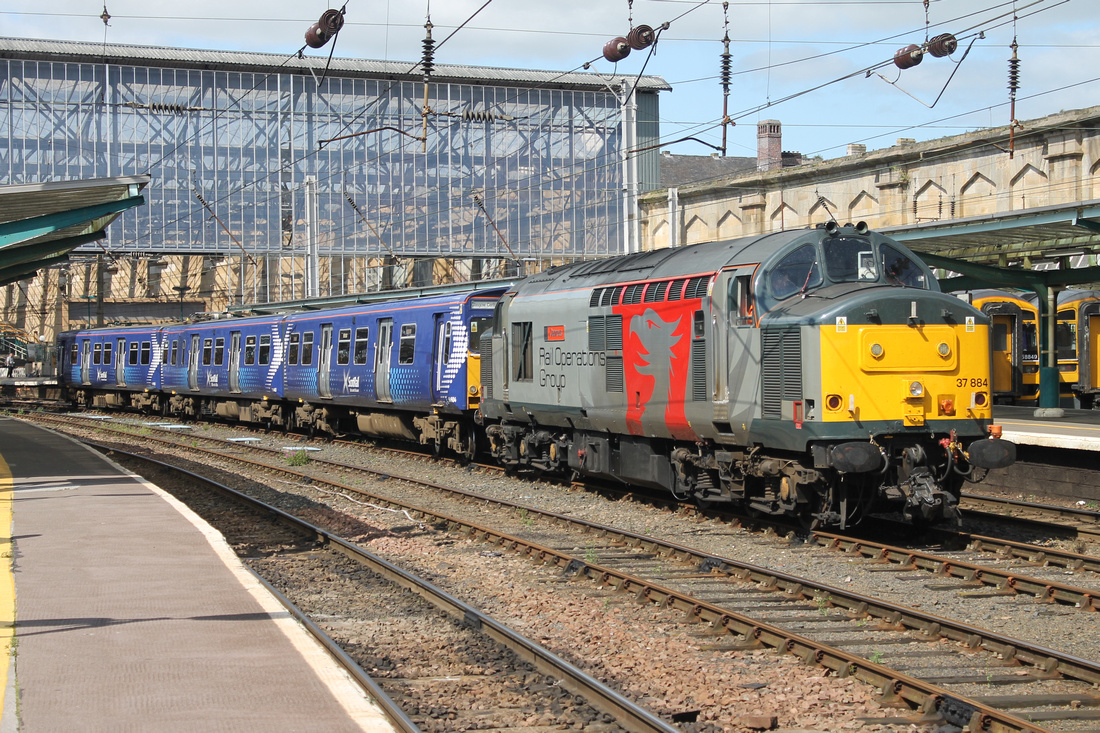 On 15th August, 314211 became the 5th member of the fleet to make it's final journey south for scrapping. 37884 collected 211 from Yoker and hauled it on the first part of it's final journey, heading to Crewe South Yard. It is expected to make the 2nd and final part of the journey from Crewe South Yard to Newport Docks on 16th August.
On 15th August, 314211 became the 5th member of the fleet to make it's final journey south for scrapping. 37884 collected 211 from Yoker and hauled it on the first part of it's final journey, heading to Crewe South Yard. It is expected to make the 2nd and final part of the journey from Crewe South Yard to Newport Docks on 16th August.
The photo shows Europhoenix Rail Operations Group liveried 37884 'Cepheus', hauling Scotrail Saltire liveried 314211 on part one of it's final journey to the scrapyard, pauses at Carlisle whilst working 5Q78 Yoker - Crewe South Yard ECS empty stock move. 15.8.19
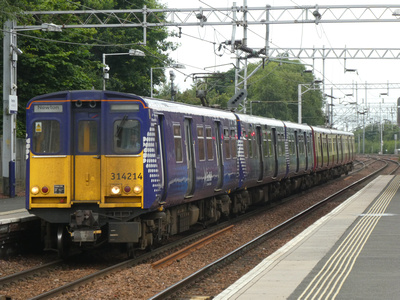 Since the May timetable, class 314 usage on a Sunday has decreased to only 1 diagram. The diagram uses a pair of 314's working in multiple and rotating between the Newton via Maxwell Park and the Neilston service.
Since the May timetable, class 314 usage on a Sunday has decreased to only 1 diagram. The diagram uses a pair of 314's working in multiple and rotating between the Newton via Maxwell Park and the Neilston service.
The Sunday diagram is as follows:
| Glasgow Central - Neilston | Neilston - Glasgow Central | Glasgow Central - Newton (Via Maxwell Park) | Newton - Glasgow Central (via Maxwell park) |
| 8.55 | 9.48 | 10.36 | 11.09 |
| 11.53 | 12.48 | 13.36 | 14.09 |
| 14.53 | 15.48 | 16.36 | 17.09 |
| 17.53 | 18.48 | 19.36 |
20.09 |
| 20.53 | 21.48 | 22.36 | 23.09 |
Weekdays, 5 diagrams work using 5 units, with 3 units (a single and a double) working to Gourock early morning with the remainder of the workings mostly concentrating on peak time Neilston workings and daytime off peak workings on the Cathcart Circle and Newton via Maxwell park services. Only 1 diagram remains out post 20.00 and works on Neilston services.
Saturdays use 3 units, 2 working all day on Paisley Canal services and a third coming out to work on Glasgow Central - Newton via Queens Park services from 15.20 onwards.
Units still in service are Carmine and Cream sets 314202, 314205, 314210 and 314216 with Saltire liveried 314203, 314209 and 314214 also still in use. 314207, 314208, 314211 and 314215 are all stored at Yoker with no further use expected.
The main photo shows 314214 + 314202 arriving into Newton with 2M76 13.36 service from Glasgow Central via Maxwell Park on 4.8.19
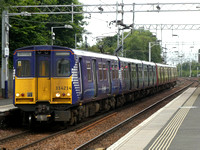
|
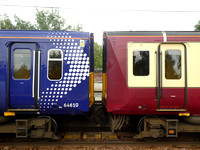
|
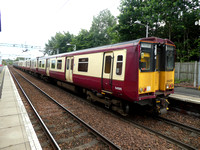
|
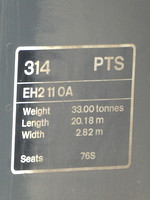
|
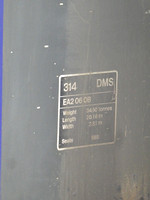
|
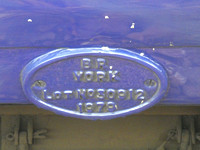
|
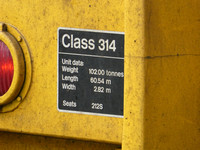
|
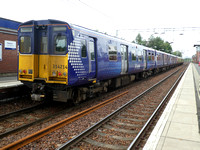
|
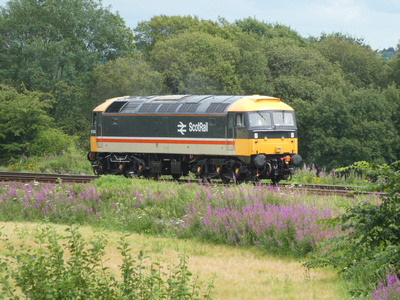 Due to the Steam locomotives at Bo'ness being unavailable on 24th July, fans of diesel traction had an excellent treat, with BR Scotrail Intercity liveried 47643 operating the timetabled passenger services on the line from Bo'ness to Manuel on this day.
Due to the Steam locomotives at Bo'ness being unavailable on 24th July, fans of diesel traction had an excellent treat, with BR Scotrail Intercity liveried 47643 operating the timetabled passenger services on the line from Bo'ness to Manuel on this day.
47643, which in recent months has been treated to a repaint, looked fantastic as it worked in the sunshine.
The photograph shows BR Scotrail Intercity liveried 47643 running round it's train at Manuel to form the 14.50 departure to Bo'ness
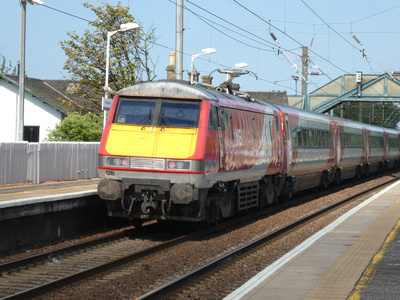 On 22nd July, LNER's 91108 made it's final journeys as part of the LNER 91 fleet. 91108 was to go off lease and due an exam, reckoned to cost somewhere in the region of £50,000 and with the 91's due for replacement by the new Azuma fleet, the decision was taken to withdraw the loco to provide spare parts for the remainder of the fleet. Unfortunately this will likely also lead to the eventual scrapping of 91108.
On 22nd July, LNER's 91108 made it's final journeys as part of the LNER 91 fleet. 91108 was to go off lease and due an exam, reckoned to cost somewhere in the region of £50,000 and with the 91's due for replacement by the new Azuma fleet, the decision was taken to withdraw the loco to provide spare parts for the remainder of the fleet. Unfortunately this will likely also lead to the eventual scrapping of 91108.
The photo shows after 30 years of service and 7.5 million miles on the clock, 91108 heading south through Prestonpans with 1S23 16.30 Edinburgh Waverley - London Kings Cross service on it's final day in service before withdrawal.
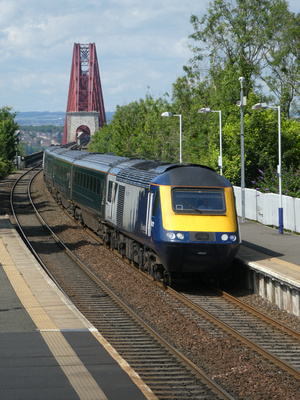 Scotrail Inter7city liveried 43021 and 43026 top and tail 4 GWR liveried Mark 3's through Dalmeny with 1B32 13.12 Aberdeen - Edinburgh Waverley service.
Scotrail Inter7city liveried 43021 and 43026 top and tail 4 GWR liveried Mark 3's through Dalmeny with 1B32 13.12 Aberdeen - Edinburgh Waverley service.
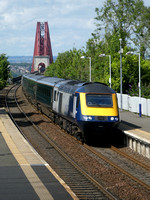
|
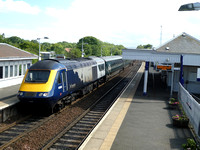
|
Scotrail Inter7city liveried power cars 43130 and 43032 top and tail a set of ex First Great Western Mark 3's as they pass through Dalmeny with 1B35 13.57 Aberdeen - Edinburgh Waverley service
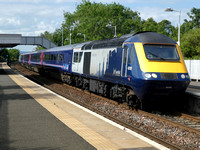
|
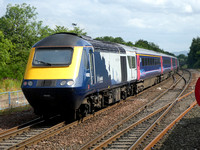
|
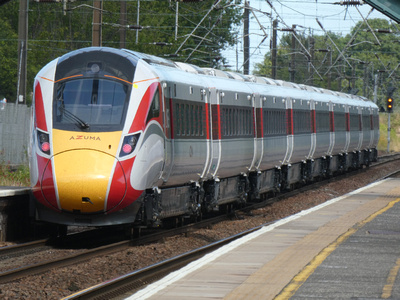 During week beginning 8th July, one of LNER's new class 800 Azuma trains has been seen out on Driver Training between Newcastle and Edinburgh Waverley.
During week beginning 8th July, one of LNER's new class 800 Azuma trains has been seen out on Driver Training between Newcastle and Edinburgh Waverley.
The 9 coach set, has the look of the German ICE sets and the smart livery of Red and White really suits the sets, however how long they remain in pristine condition, especially the large areas of white, is anyones guess!
They are expected to begin to enter service between Kings Cross and Edinburgh next month, although they have already started to see service on the Leeds and Skipton lines.
The down side to their introduction and the eventual introduction of the class 801 sets will be the withdrawal of the LNER HST and Class 91 sets.
The photo shows LNER Azuma 800109 passing through Prestonpans with 5Q44 14.48 Edinburgh Waverley - Newcastle driver training run.
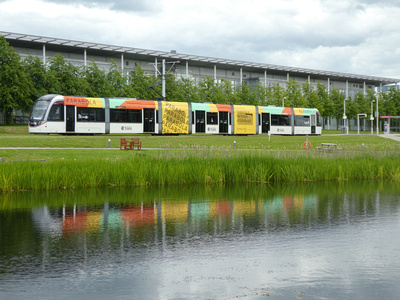 I had my first visit to the Edinburgh Trams since September, here are my photos from the area around Edinburgh Park Central:
I had my first visit to the Edinburgh Trams since September, here are my photos from the area around Edinburgh Park Central:
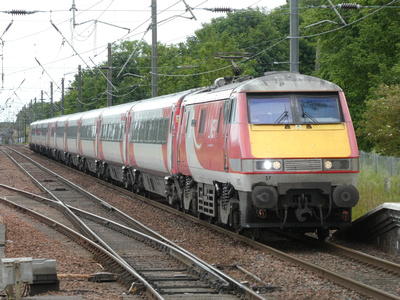 I visited Prestonpans on 22nd June for the first time this year. Here are my sightings:
I visited Prestonpans on 22nd June for the first time this year. Here are my sightings:
 I visited Patterton this evening to catch a couple of the class 314 early evening workings.
I visited Patterton this evening to catch a couple of the class 314 early evening workings.
First up was 314214 arriving with 2N08 19.05 Glasgow Central - Neilston service. This unit working this particular diagram is now the only one to see a full days service (mainly works on Cathcart Circle and Newton services during the day before switching to Neilston services in the evening). The other remaining Class 314 diagrams either finish after the evening peak or are only out during the morning / evening peaks.
The other working that was seen with class 314 operation was Scotrail liveried 314214 and SPT Carmine and Cream liveried 314202 arriving with 2N09 19.28 Neilston - Glasgow Central service.
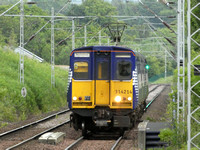
|
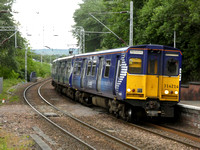
|
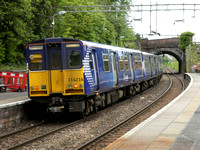
|
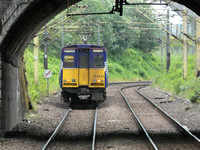
|
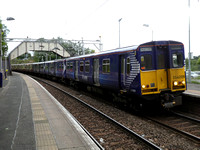
|
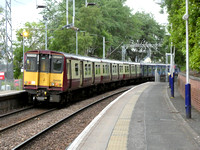
|
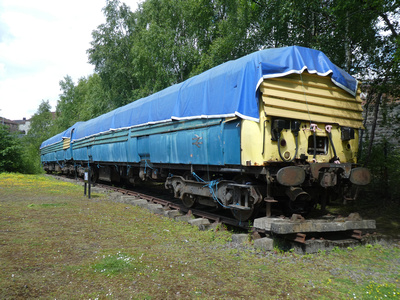 I had a quick look at 311103 today when visiting Summerlee.
I had a quick look at 311103 today when visiting Summerlee.
The 311s and a number of unrefurbished 303s were withdrawn in 1990 when the class 320s entered service on the Balloch, Helensburgh- Airdrie/ Drumgelloch Line. Most of the 311's were scrapped, however two sets, 311103 and 311104 survived and found a new use as Sandite units (renumbered 936103 and 935104), and saw further use until 2001.
311104 was scrapped at Immingham in 2002 whilst 311103 was preserved, finding its way to Summerlee Heritage Park in Coatbridge, where it was repainted into a coat of BR Blue. However in 2006 when the park was being refurbished, the set was moved from its prominent position in front of the main building to an area round at the back at the furthest point away from the entrance. Driving trailer 76414 was sold to VSOE who wanted the Bogies for one of their pullman carriages, whilst the remainder of the vehicle was scrapped. The 2 remaining vehicles had their windows covered with corrugated cladding to protect their windows from vandalism. Both vehicles remain in the same location today looking forlorn.
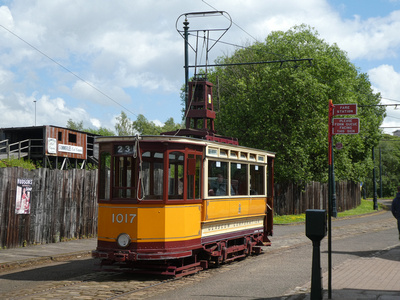 A quick visit to Summerlee this afternoon saw Glasgow 1017 out in service on the museum's tramway.
A quick visit to Summerlee this afternoon saw Glasgow 1017 out in service on the museum's tramway.
Glasgow 1017 has a long and fascinating history, she was built in 1904 by the British and Electric Car Company by the Paisley and District Tramways as number 17. The tram was originally a double decked open top unvestibuled tram. When the Paisley system was bought over by Glasgow Corporation Tramways, 17 became 1017 and still operated in it's original form for a time.
1017 was cut down to a single deck tram and fitted with a short trolley tower and enclosed driver's platforms around 1930 and found it's way onto the Clydebank - Duntocher route (later service 20), which required single deck trams due to a low railway bridge on the route. After the route closed in 1949, 1017 found a new role as the Motor School (Driver Training) car and paint shop shunter at Coplawhill depot, where it served until 1960 in this role.
On withdrawal, the body of 1017 found a new use as a hut and meeting room for the STMS in a garden in Cambuslang. In the 1990's 1017 found it's way to Summerlee, where it was restored to 1930's condition and entered service on the 1/2 mile long tramway in 2002.
The tram still sees regular use along with Lanarkshire 53 and Dusseldorf 392. They should be joined in the future by Glasgow Coronation 1245.
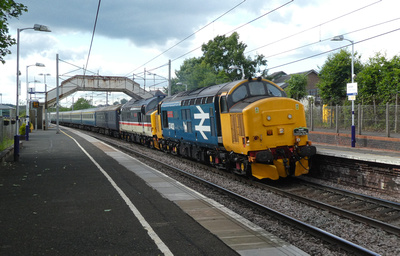 It was class 37's galore in the Lanarkshire area on 15th June with no fewer than 5 different class 37's seen in the space of 3 hours!
It was class 37's galore in the Lanarkshire area on 15th June with no fewer than 5 different class 37's seen in the space of 3 hours!
- First to be seen was DRS Liveried 37059 top and tailed with 37038 passing through Greenfaulds with 1Q77, the Mossend - Inverness Network Rail PLPR Test Train.
- Next was West Coast Liveried 37685 'Loch Arkaig' seen passing through Gartcosh in the sunshine with 5Z38 Fort William - Carnforth ECS working
- Finally was BR Blue liveried 37402 and newly repainted into Intercity livery, 37419 seen passing through Bowling and Carluke with 1Z86 Fort William - Crewe 'Three Peaks Challenge' railtour
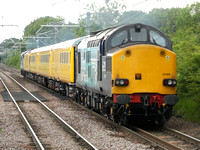
|
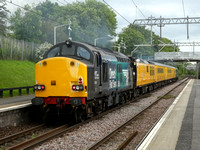
|
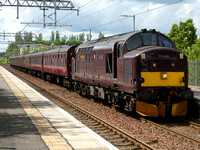
|
| 37059 at Greenfaulds | 37038 at Greenfaulds | 37685 at Gartcosh |

|

|
|
| 37402+419 at Bowling | 37402+419 at Carluke |
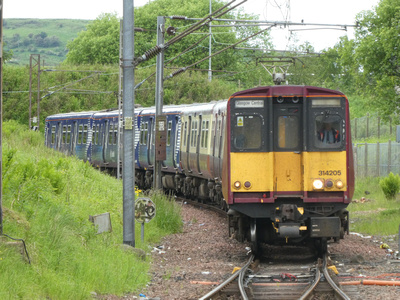 On 8th June, Scotrail Saltire liveried 314209+ and SPT Carmine and Cream liveried 314205 worked one of the 3 Neilston Diagrams in place of the usual class 380. I decided to head out to Neilston for the first time to take a few photos.
On 8th June, Scotrail Saltire liveried 314209+ and SPT Carmine and Cream liveried 314205 worked one of the 3 Neilston Diagrams in place of the usual class 380. I decided to head out to Neilston for the first time to take a few photos.
- 314209+314205 arrived with 2N34 11.35 service from Glasgow Central
- 314209+314205 then headed to the turnback siding working 5N03 Neilston - Neilston
- 314205+314209 arrived back in to form the 2N03 12.28 service to Glasgow Central
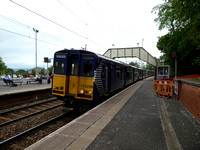
|
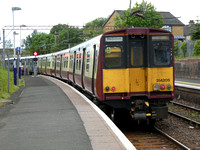
|
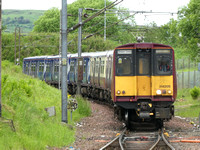
|
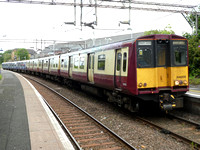
|
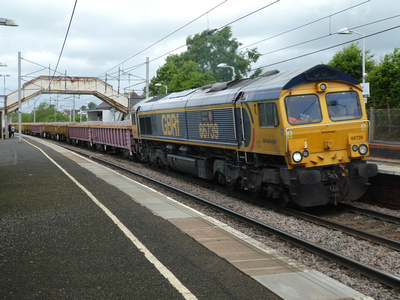 2 Engineering workings in 6 minutes at Carluke
2 Engineering workings in 6 minutes at Carluke
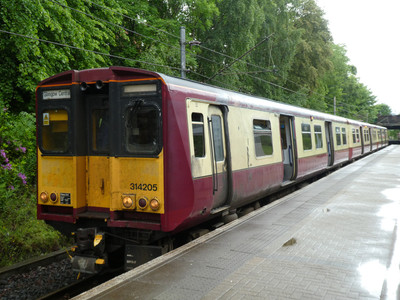 Another quick visit to Glasgow on 31st May allowed me to photo and ride some of the few remaining class 314's in service. Only 3 of the fleet were out when I visited, these were 314202, 205 and 214.
Another quick visit to Glasgow on 31st May allowed me to photo and ride some of the few remaining class 314's in service. Only 3 of the fleet were out when I visited, these were 314202, 205 and 214.
As I got into Central station, 314214 was waiting to work 5O24. 5O24 is an ECS working that heads to Crosshill at 15.08. From here it acts as an unadvertised school train, picking up pupils from Holyrood Secondary School. At 15.20 the service works as 2O24 15.20 service to Glasgow Central via the Outer Circle.
314202 departed with 2I23 15.15 Cathcart Inner circle service. This service is normally formed as a 6 car with the unit from 5O24 on Mondays at Tuesdays or if the schools are on holiday. These 2 units would otherwise join to work the 15.51 Outer Circle service.
I caught 314202 to Pollokshaws East, where I managed to photograph both it and 314214. I then caught 314205, which was working 2M83 15.19 Newton - Glasgow Central back to Pollokshields West, where I changed over to catch 385018 2M86 15.45 service from Glasgow Central - Newton.
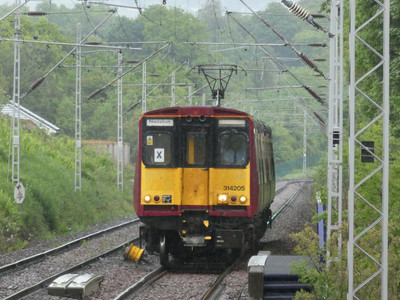 I visited Patterton again to catch some of the peak time class 314's in operation.
I visited Patterton again to catch some of the peak time class 314's in operation.
First up was 314205 arriving with 2N08 19.05 Glasgow Central - Neilston service. This unit working this particular diagram is now the only one to see a full days service as the other remaining diagrams either finish after the evening peak or are only out during the morning / evening peaks. Also noted was that 314205 had a non-multi restriction at one end.
The other working that was seen with class 314 operation was SPT Carmine and Cream liveried 314202 and Scotrail liveried 314214 arriving with 2N09 19.28 Neilston - Glasgow Central service.
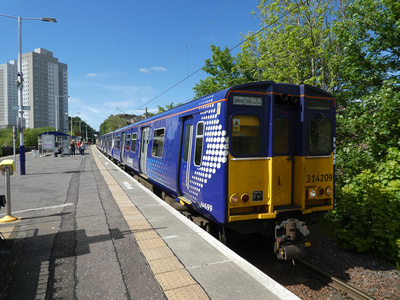 A short trip into Glasgow this afternoon allowed for a couple of runs on the western side of the Cathcart circle by 314.
A short trip into Glasgow this afternoon allowed for a couple of runs on the western side of the Cathcart circle by 314.
Catching the 15.15 Cathcart Inner Circle service, which was formed of Scotrail liveried 314209 and SPT Carmine and Cream liveried 314202, I headed out to Pollokshaws East. This was the first time I had actually got off a train at this station.
I got off here and a short time later, caught 314203 heading the opposite direction with the 15.19 service from Newton - Glasgow Central. I had been going to change at Maxwell Park and head out to Newton onboard a 385, however I decided to stay on board 314203 and return into Glasgow. One of the sets of wheels on the leading bogie of vehicle 64587 of 314203 has a wheel flat, which was really loud and noticible!
314214+216 also came out at the evening peak, to work a couple of Neilston services, however I was already on my way home by this point.
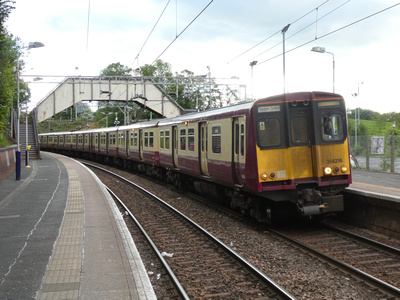 I visited Patterton station on the Neilston line for the first time tonight to get some photos of the class 314's in action here, before they disappear for good.
I visited Patterton station on the Neilston line for the first time tonight to get some photos of the class 314's in action here, before they disappear for good.
The Neilston line seems to have the majority of the dwindling number of class 314 workings in the evening, with 8 return workings to and from Neilston covered by the class.
In the 30 minutes I was there:
- 314216+314205 worked the 2N09 19.28 Neilston - Glasgow Central service
- 314203 worked 2N13 19.58 Neilston - Glasgow Central
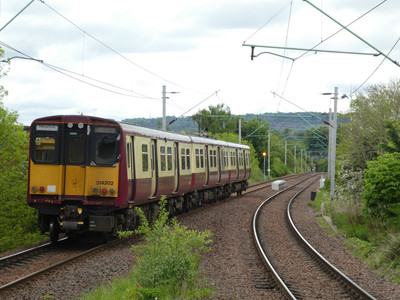 Since the start of the new May 2019 timetable on 19th May, the number of class 314's required for service has shrunk. With around 60 class 385's now available for service and now beginning to operate on the Lanark and on one diagram on the Inverclyde route, class 318's and 320's have been freed up to operate on Gourock, Weymss Bay and Paisley Canal services that were previously worked by class 314's.
Since the start of the new May 2019 timetable on 19th May, the number of class 314's required for service has shrunk. With around 60 class 385's now available for service and now beginning to operate on the Lanark and on one diagram on the Inverclyde route, class 318's and 320's have been freed up to operate on Gourock, Weymss Bay and Paisley Canal services that were previously worked by class 314's.
Prior to the timetable change, 314208 was withdrawn in late April, with 211 also being withdrawn on 1st May, with both units now at Yoker for storage. However after service ended on Saturday 18th May, 314207, 314210 and 314215 were also withdrawn from service. All 3 units are currently stored at Shields.
This leaves only 6 class 314's in service to work 5 diagrams, mainly on the Cathcart Circle and Newton via Maxwell park lines between the morning and evening peak times. In the morning and evening peak, there are also services to Neilston utilising 314's. There are also 3 early morning workings to / from Gourock worked by 314's. The remaining units in service are 314202, 314203, 314205, 314209, 314214 and 314216.
On Monday 20th May, I noted the following
314203+314205 were coupled together and stabled at Shields, most likely they will have worked morning and evening peak Cathcart Circle or Neilston services.
I arrived into Glasgow around 10.10am and 314214+314202 had been uncoupled with 314202 working the 10.15 Cathcart Outer Circle service and 314214 working the 10.45 service to Newton. 314216 worked the 10.51 Cathcart Inner Circle service.
I was in and around Glasgow till around 2.15pm and the units worked the following services departing Glasgow Central:
| Working | Unit |
| 10.15 Cathcart Inner Circle | 314202 |
| 10.45 Newton Via Maxwell Park | 314214 |
| 10.51 Cathcart Outer Circle | 314202 |
| 11.15 Cathcart Inner Circle | 314216 |
| 11.45 Newton Via Maxwell Park | 314202 |
| 11.51 Cathcart Outer Circle | 314216 |
| 12.15 Cathcart Inner Circle | 314214 |
| 12.45 Newton Via Maxwell Park | 314216 |
| 12.51 Cathcart Outer Circle |
314214 |
| 13.15 Cathcart Inner Circle | 314202 |
| 13.45 Newton Via Maxwell Park | 314214 |
| 13.51 Cathcart Outer Circle | 314202 |
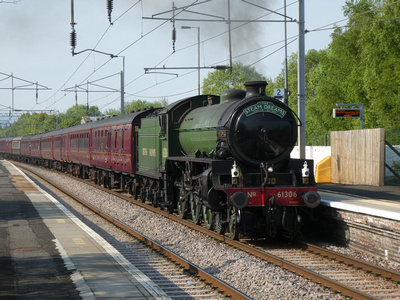 On 15th May, LNER Thompson Class B1 61306 'Mayflower' was in West Central Scotland working on the Steam Dreams 'Highlands and Islands' Day 7 railtour.
On 15th May, LNER Thompson Class B1 61306 'Mayflower' was in West Central Scotland working on the Steam Dreams 'Highlands and Islands' Day 7 railtour.
Looking resplendent in it's LNER Apple Green livery, Mayflower worked 1Z61 Fort William - Coatbridge Central. At Coatbridge Central, the passengers left the train to be taken by bus for dinner, Mayflower then worked ECS as 5Z62 Coatbridge Central - Holytown with a couple of hours layover in Mossend Yard before heading to Holytown to pick up it's passengers once more to work as 1Z62 Holytown - Penrith.
I saw Mayflower at 4 different locations: Gartcosh, Coatbridge Central, Whifflet and Carstairs. Here are my photos:
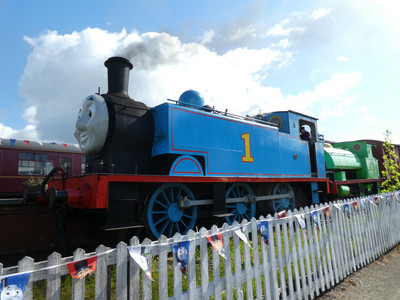 I took my 2 year old cousin along to the Day Out with Thomas at Bo'ness on 11th May. It was a good day out (my cousin had a ball!) and there was plenty to see.
I took my 2 year old cousin along to the Day Out with Thomas at Bo'ness on 11th May. It was a good day out (my cousin had a ball!) and there was plenty to see.
In the Bay Platform was No. 6 'Percy' and No. 1 'Thomas' (Coltness Iron Works No.1 'Lord Roberts'), both locos remained here for the duration of our visit.
The service was operated by Caledonian Railway 439 class No 419 and National Coal Board Fife Area no 19 (both minus their Thomas faces), which operated the hourly service up to Birkhill (where there was a bouncy castle, catering van and tent with entertainer set up) and back.
Meanwhile at Bo'ness, N.C.B. no. 6 was seen shunting a demonstration goods train up and down the run round loop. The Museum was also open as was the display shed so there was plenty to see.
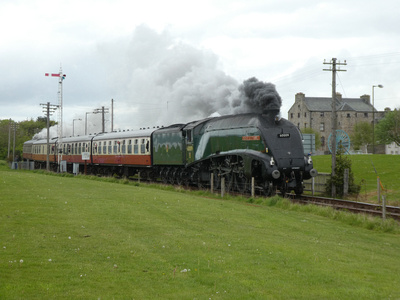 On Monday 6th May (May Day Bank Holiday), the service at the Bo'ness and Kinneil Railway was in the hands of A4 class 60009 'Union of South Africa', which was top and tailed with Caledonian Railway 439 class no 419. 60009 was used as it was visiting the railway, having hauled the previous day's SRPS Railtour to Aberdeen.
On Monday 6th May (May Day Bank Holiday), the service at the Bo'ness and Kinneil Railway was in the hands of A4 class 60009 'Union of South Africa', which was top and tailed with Caledonian Railway 439 class no 419. 60009 was used as it was visiting the railway, having hauled the previous day's SRPS Railtour to Aberdeen.
Unfortunately I couldn't stay to have a journey onboard, however I managed to get a few photos of the 11.25 from Manuel - Bo'ness and the 12.10 from Bo'ness - Manuel.
Due to the number of passengers wanting to get on board, an extra Mark 1 was brought out from the yard by 27001 and attached to the train prior to departing from Bo'ness on the 12.10 service to Manuel.
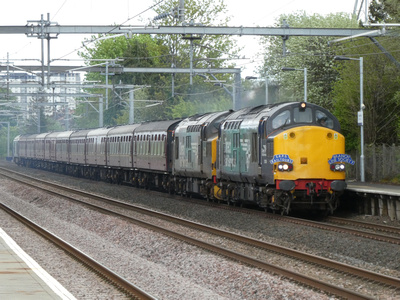 The Branch Line Society operated a railtour from Crewe to Gourock and return on Saturday 27th April. The 'Gourock Growler' operated with DRS locomotives throughout and the SRPS railtour Mark 1's.
The Branch Line Society operated a railtour from Crewe to Gourock and return on Saturday 27th April. The 'Gourock Growler' operated with DRS locomotives throughout and the SRPS railtour Mark 1's.
On Friday 26th, 66425 worked light engine from Carlisle Kingmoor - Bo'ness to collect the railtour set, heading south, the tour worked as 1Z85 and was worked as the 'Bo'ness Bonus' railtour to Crewe. The route taken to Crewe included heading to Edinburgh Waverley then via the Shotts Line to Holytown, then via Motherwell and the West Coast Main Line.
On to Saturday and the main event. The tour left Crewe led by 88007+88002 and was top and tailed with 68018 on the rear, however due to multiple working issues between the pair of 88's, 88007 was removed at Carlisle leaving 88002 to lead to Mossend Up Yard. The tour was running late, therefore missed out many of the loops that it was due to pass through on the way up the West Coast Main Line until it reached Carstairs, where it was held in the Down Passing Loop for 8 minutes to allow 390122 to pass it. It then proceeded to Mossend Up Yard, where it arrived 28 minutes late. It was here that there was a change of traction, with 88002 being removed and 37038+37218 being added for the trip out to Gourock.
37038+37218 with 68018 on the rear of the train then departed Mossend Up Yard 28 minutes late heading to Whifflet South Junction then on the rarely used single track to Sunnyside junction, where the tour headed along the North Clyde Line as far as Anniesland before taking the Maryhill line to Springburn. After Springburn, the tour headed back onto the North Clyde Line at Bellgrove before taking the City of Glasgow Union Line to Shields Junction. The tour then headed towards Paisley Gilmour Street, where it took the Inverclyde line out to Gourock.
After a break at Gourock, 68018 led for the journey back towards Glasgow where the tour stopped at Polmadie Clydesdale Loop. It then reversed with 37038 and 37218 leading once more, it headed back towards Paisley Gilmour Street where this time it headed along the Ayrshire line via Kilwinning then at Newton on Ayr junction it headed along the single track, which would join the GSW line near Mauchline and would continue south to Carlisle. At Carlisle, the 37's were removed and 88009 was added to the front for the remainder of the journey to Crewe.
On Sunday, the final day of the tour, 66305 brought the SPRS stock back north as 1Z66 Crewe - Polmont 'The Sunday Shed' tour. After it arrived at Polmont, 66305 returned the stock to Bo'ness before heading back to Carlisle Kingmoor Light Engine.
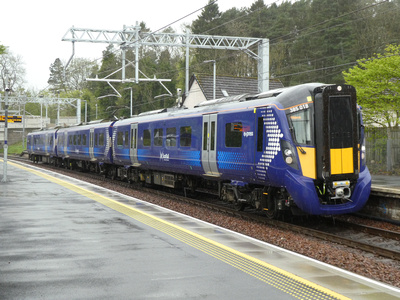 With class 385's now starting to be used on the Glasgow Central - Edinburgh Waverley via Shotts line, the single diagram that has been converted to 385 operation so far has seen a different 385 on it each day on it's first week in service.
With class 385's now starting to be used on the Glasgow Central - Edinburgh Waverley via Shotts line, the single diagram that has been converted to 385 operation so far has seen a different 385 on it each day on it's first week in service.
The following 385's have been used:
| Day | Unit |
| Tuesday | 385019 |
| Wednesday | 385031 |
| Thursday | 385021 |
| Friday | 385018 |
Interestingly, the 385 on the Shotts line has also went on to do some evening services on the Cathcart Circle starting with the 19.45 service to Newton.
The photo shows 385018 arriving at Hartwood with 2Y50 16.16 Scotrail service from Glasgow Central - Edinburgh Waverley on Friday 26th April.
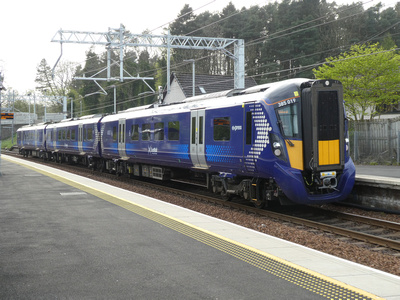 On 23rd April, the class 385's made their debut on the Glasgow Central - Edinburgh Waverley via Shotts Service. Initially only one of the diagrams is currently being operated by the 385, with 019 the chosen unit for the first day in service. Class 156's and 158's remain on the other diagrams for the time being.
On 23rd April, the class 385's made their debut on the Glasgow Central - Edinburgh Waverley via Shotts Service. Initially only one of the diagrams is currently being operated by the 385, with 019 the chosen unit for the first day in service. Class 156's and 158's remain on the other diagrams for the time being.
It's expected that only the class 385/0's (3 car variation) will operate on this route.
The class 385 is expected to work the following services for the remainder of the week:
- 2Y60 0715 Glasgow Central to Edinburgh
- 1Y75 0858 Edinburgh to Glasgow Central
- 2Y52 1016 Glasgow Central to Edinburgh
- 1Y81 1157 Edinburgh to Glasgow Central
- 2Y44 1316 Glasgow Central to Edinburgh
- 1Y87 1457 Edinburgh to Glasgow Central
- 2Y50 1616 Glasgow Central to Edinburgh
- 2Y51 1755 Edinburgh to Glasgow Central
The photo shows 385019 working 2Y50 16.16 Glasgow Central - Edinburgh service on 23.4.19
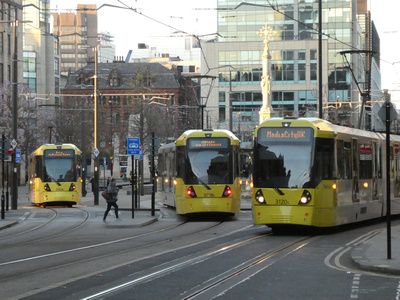 The Manchester Metrolink is the largest light rail network in the UK. The tram network currently boasts 120 Bombadier M5000 trams operating on 18 routes, with a further route and another 27 trams under construction.
The Manchester Metrolink is the largest light rail network in the UK. The tram network currently boasts 120 Bombadier M5000 trams operating on 18 routes, with a further route and another 27 trams under construction.
The services are currently as follows:
| Route | Headway | Notes |
| Altrincham - Bury | 12 mins | operates till approx 8pm Mon - Saturday, uses double units |
| Altrincham - Piccadilly | 12 mins | |
| Bury - Piccadilly | 12 mins | |
| Ashton - Eccles | 12 mins | operates via MediaCityUK Mon - Sat evenings and Sunday all day |
| Ashton - MediacityUK | 12 mins | operates till approx 8pm Mon - Sat |
| East Didsbury - Rochdale | 12 mins | |
| East Didsbury - Shaw | 12 mins | operates till approx 8pm Mon - Sat |
| Manchester Airport - Victoria | 12 mins / 20 mins |
20 min service operates 3-6am Mon - Sat and 3-7am on Sundays from Airport - Deansgate Castlefield. |
Construction is well underway on a new route running from Crumpsall on the Bury route to the Trafford Centre. Crumpsall is having an additional platform added to the existing stop, while the new part of the route, which construction is well underway, leaves the current system at Pomona on the Eccles line and makes its way to the Trafford Centre with a combination of on street and off street running. The new route is expected to open next year with a standard 12 minute headway.
On my visit to Manchester from 8th - 11th April, I noted that the 8 routes ran with the following combinations of trams
- Altrincham - Bury: Double M5000's
- Altrincham - Piccadilly: Single M5000's Mon / Tues / Thurs and Doubles on Weds as Manchester United were playing Barcelona at Old Trafford.
- Bury - Piccadilly: Double M5000's Mon / Tues / Thurs and singles on Weds as doubles operated on Altrincham route instead
- Ashton - Eccles: single M5000's
- Ashton - MediacityUK: Single M5000's
- East Didsbury - Rochdale: mix of single M5000's and doubles
- East Didsbury - Shaw: mix of single M5000's and doubles
- Manchester Airport - Victoria: Single M5000's
The Altrincham and Bury routes appeared to use lower numbered trams with higher numbered trams mainly (but not always) appearing on the other routes.
Less all over advert liveries were noted this year compared to last, with Vodafone adverts being seen on trams 3017, 3047, 3093 and 3100 and 3075 advertising the Body Shop.
Photo spots
There are plenty of places to spot the trams, either running on street or off street:
- St Peter's Square: One of the busiest stops on the system with trams from 7 out of 8 routes stopping here.
- Manchester Central: 7 out of 8 routes pass here
- Princess Street / Cross Street: East Didsbury - Shaw / Rochdale head along here
- Mosley Street: Altrincham - Bury / Piccadilly, Manchester Airport - Victoria and Ashton - Eccles / MediaCityUK pass along here
- Piccadilly Gardens: triangular junction with trams passing with most routes diverging for Piccadilly every couple of minutes
- Victoria: recently modernised stop with 4 platforms on a 3 track layout. Airport services turn back here.
- Deansgate - Castlefield: car park area good for photoing the trams on the sleeper track and coming off former railway bridge
- Salford Quays: good for photoing trams heading along quayside.
- Mediacityuk: 2 platform terminus, triangular junction with Eccles branch.
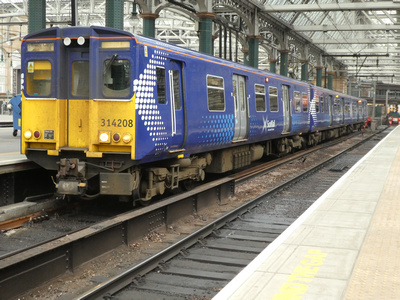 On 5th April, 314208 became the 6th class 314 to be withdrawn from service (really 8th if you include 207 and 210 which were reinstated).
On 5th April, 314208 became the 6th class 314 to be withdrawn from service (really 8th if you include 207 and 210 which were reinstated).
The withdrawal of 314208 leaves 10 units available for service: 314202 / 203 / 205 / 207 / 209 / 210 / 211 / 214 / 215 and 216. This is likely to reduce further following the May timetable change, when it is expected that only 5 units will be required for service on a daily basis.
The photograph shows 314208 awaiting departure from Glasgow Central with 2D27 12.42 service to Paisley Canal on 1st March 2019.
I arrived in Blackpool around 6pm, too late to see the heritage trams in service. The 15 minute service was, as usual in the hands of the Flexity fleet. The timetable went down to every 30 minutes around 8pm.
Saturday 6th April
Blackpool was busy with numerous groups in the area for the Grand National weekend and the prom in particular was busy as there was a coach rally on. The Flexities operated their usual early season timetable of working every 15 minutes during the day and 30 minutes from 8pm onwards. The heritage timetable, however threw up the most interest with the service being doubled to work every 10 minutes from Pleasure Beach - North Pier (with occasional journeys to Cabin) using 4 trams instead of the usual 20 minute service using 2 trams.
With the sun being out albeit with a cold breeze, boat cars 600 and fresh from it's recent interior overhaul, 227, saw use alongside Standard 147 and Balloon 723. Engineering tram 754 was seen at Starr Gate Depot, being used to check the overhead line in the depot roads.
Sunday 7th April
After a cloudy start, by mid afternoon it was a gloriously sunny and warm day in Blackpool. With the coach rally on for the second day running, the enhanced heritage service ran again. The service was operated by Balloon 701, Standard 147 and Boats 600 and 227. Balloon 701 worked the first Cabin trip of the day.
Both boat cars seemed to be well loaded on both days. Engineering tram 754 was seen at North Pier, being used to check the overhead line.
Monday 8th April
The final day of my trip to Blackpool and the normal 20 minute heritage service was in operation, this time utilising Boat 227 and B fleet Balloon 700. 227 worked both morning trips to Cabin, while Balloon 700 operated the afternoon Cabin trips.
Over the course of the 4 days, 15 Flexity trams were used: 001, 002, 003, 004, 005, 006, 007, 008, 009, 010, 011, 013, 015, 016 and 017. 012, 014 and 018 weren't used during the 4 days.
| Day | A | B | C | D |
| Saturday | 147 | 723 | 227 | 600 |
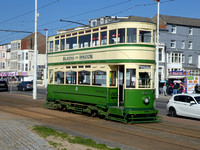
|
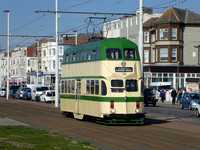
|
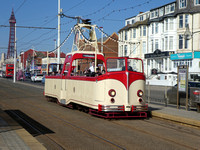
|

|
|
| Sunday | 701 | 147 | 600 | 227 |
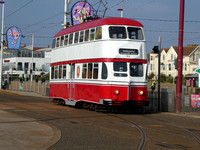
|
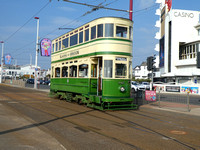
|

|
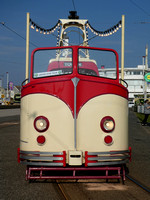
|
|
| Monday | 227 | 700 | ||
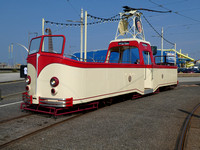
|
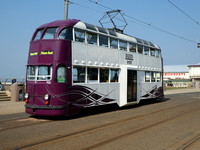
|
North Pier Extension
Work appears to have progressed well since my last visit, with all track on Talbot Road up as far as the current Wilko building complete. The new platform in Talbot Square for East bound workings is complete and the support poles for the overhead were being put up.
See https://scottishtrains.zenfolio.com/p200048606 for the full gallery of photos from the weekend.
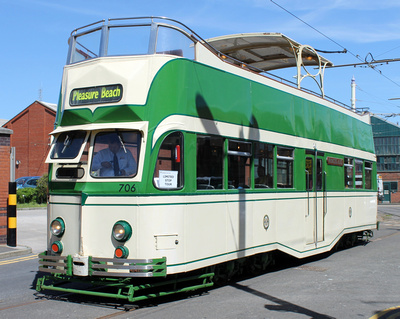 Two excellent pieces of news have came from the Blackpool Tramway this week:
Two excellent pieces of news have came from the Blackpool Tramway this week:
The first is that the major overhaul of the popular open top Balloon car 706 'Princess Alice' will begin later this year, the preliminary work has already begun with the fabrication of a new underframe for the tram now underway. 706 has been stored since the end of the 2015 season in need of an overhaul and the replacement of the underframe.
The Fylde Tramway Society have been fundraising with the target being the estimated £50,000 cost of the work to 706 and have so far raised £10,000, enough to make a start on the underframe. They are still looking for donations, which can be made at https://www.gofundme.com/039princess-alice039-706-appeal?utm_source=facebook&utm_medium=social&utm_campaign=fb_u_g&fbclid=IwAR1ELEFxv1OLYkvJ6-gZxKlH4xgBcOlxefhe7YVgHapJ2R3chmlvfFNHFHg
It is hoped that 706 should return to heritage service in 2021, the Fylde Tramway Society's 50th Anniversary.
The main photograph shows Balloon 706 departing Rigby Road depot on 23rd May 2015 (it's last year in service) to work on the Heritage service.
The other big piece of news is that as well as having the components to create the underframe for Balloon 706, there is a second underframe being created to allow a second Balloon to be restored, with work being undertaken simultaneously with 706.
Balloon 704, which was withdrawn at the end of the 2003 season in need of a major overhaul, will be restored to late 50's / early 60's condition and will be renumbered back to 241. Having 704 back in the heritage fleet should complement Balloon 717 as well as allowing a series 1 balloon to be returned to near original condition. It is expected that 704 will regain it's curved roof windows on the top deck and possibly even the thinly upholstered upper deck seating, which one graced the former open topped series 1 Balloons! An estimate or timescale on when 704/241 will return to service has not been announced as yet.
With both 704 and 706's returns being in the future, 2019 also holds plenty of interest for fans of the Blackpool Tramway.
It is expected that Millennium Balloon 707 will return to use during the year, having been stored since 2013. The flat fronted Balloon is being brought back into use as an additional high capacity tramcar for the illuminations, following Millennium Balloon 718 proving to already be popular in this role due to the large end windows on the top deck giving an excellent forward / rear view. 707 is to receive the Millennium Green / Cream / Grey and Black livery already carried by 718 and originally carried by 707 when it emerged from overhaul in this style in 1998.
August 28th will hopefully see Standard car 143 make it's long awaited return to service following a major rebuild. 143, was withdrawn from passenger service in 1957 before becoming Engineering car 3 / 753. It continued to find use in this role until 1990 when it's diesel engine caught fire, causing extensive damage to the tram. 143 was mostly overhauled by the LTT between 2008 and 2010, however Blackpool Transport and completing the overhaul, which will see 143 in a form, not currently represented by a Blackpool Standard in preservation: open end driving platforms and open balcony ends.
It is also expected that ex towing railcoach 679 will return to service in it's original form as Series 2 Railcoach 279 complete with pointed ends some time this year. The FTT group are currently hard at work on the tram.
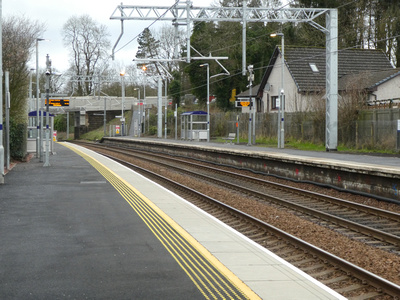 With electrification coming to the Shotts Line, a number of changes have been made to Hartwood station in the past year.
With electrification coming to the Shotts Line, a number of changes have been made to Hartwood station in the past year.
Having visited in the past couple of days for the first time this year, the change in the station even since my last visit in October have been drastic.
Changes made have included:
- Eastbound 2 aspect signal, which was at the end of the platform has been relocated through to the other side of the road bridge
- Both platforms have been shortened
- Both platforms have new shelters with the old ones having been removed
- the old foot bridge, which was half way along the platform has gone
- a new stair case on the westbound platform to the bridge giving access to the old Hartwood Hospital has been built and is now the route between the 2 platforms, the eastbound ramp from before the upgrade remains
- tactile dots indicating the platform edge for partially sighted passengers installed on the Westbound platform
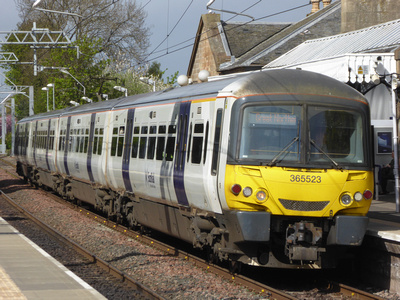 Week beginning 11th March saw the class 365 'Happy Trains' run their final services for Scotrail.
Week beginning 11th March saw the class 365 'Happy Trains' run their final services for Scotrail.
The 365's were on loan for a year due to the initial delays to the class 385's entering service and a shortage of stock as some of the DMU fleet going off lease.
10 of the 365's saw use for Scotrail, initially on the E&G line and laterally on the Edinburgh - Dunblane line, however there are now enough 385's available for service to allow the 365's to be stood down.
The 10 class 365's: 365509, 513, 517, 519, 521, 523, 525, 529, 533 and 537 are currently stored at Yoker, Shields and Eastfield until they are moved back south and returned to their leasing company.
The photo shows 365523 pausing at Linlithgow on its first driver training working for Scotrail with 2Z52 Glasgow Queen Street - Linlithgow UPL on 10th May 2018.
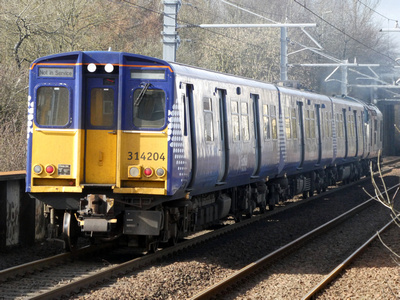 When 314204 was hauled to Glasgow Works on 13th March by 37884, it was expected that the set would be stripped for spares, then transported by low loader to Kingsbury for scrapping, however in a twist to this story, the unit was loaded onto 3 separate low loaders on 14th March and transported south with it's ultimate destination expected to be Eastleigh.
When 314204 was hauled to Glasgow Works on 13th March by 37884, it was expected that the set would be stripped for spares, then transported by low loader to Kingsbury for scrapping, however in a twist to this story, the unit was loaded onto 3 separate low loaders on 14th March and transported south with it's ultimate destination expected to be Eastleigh.
There are rumours that 314204 may see further use with London Overground until their new fleet of units are ready for use.
314206 was hauled by 37884 from Shields to Newport Docks on 14th March for scrapping. 314201 was also expected to be taken for scrapping at the same time, however it had developed air leaks and was unable to be moved so is still stored at Shields depot.
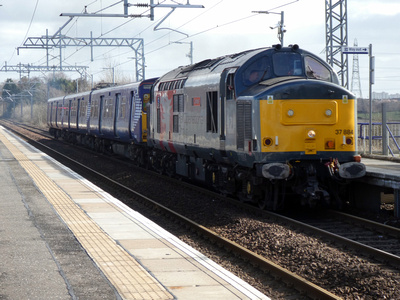 On 13th March, 314204 became the third class 314 to be taken to Glasgow Works to be stripped for spares before scrapping. It was hauled by 37884 on 5Q06 from Yoker to Glasgow Works via Glasgow Central Low Level, Bargeddie and Gartcosh.
On 13th March, 314204 became the third class 314 to be taken to Glasgow Works to be stripped for spares before scrapping. It was hauled by 37884 on 5Q06 from Yoker to Glasgow Works via Glasgow Central Low Level, Bargeddie and Gartcosh.
This was 314204's first and last journey via Gartcosh and its final ever journey by rail. The class 314 disposals are set to continue this week with 37884 hauling 314201 and 314206 from Shields - Newport docks for scrapping on Thursday 14th March. Unfortunately the move is at night, leaving Shields at 22.14 so it won't be possible to photo it.
The photo shows Europhoenix liveried 37884 hauling Scotrail Saltire liveried 314204 on its final journey by rail as it passes through Gartcosh on 5Q06 Yoker - Glasgow Works.

|
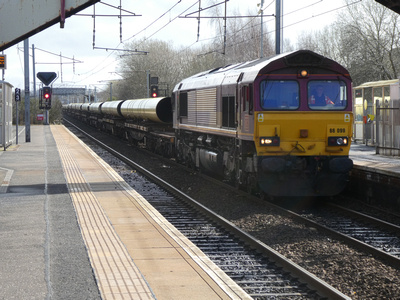 On 12th March, 66099 was seen passing through Holytown with 6X88, Hartlepool - Inverness pipe train.
On 12th March, 66099 was seen passing through Holytown with 6X88, Hartlepool - Inverness pipe train.
The pipes carried are for the Subsea 7 fabrication plant near Wick. After Holytown, the train would head into Mossend Yard, where it would be stabled until later in the day, when it would make the journey north up the Highland Main Line to Inverness. From Inverness, the train would then move to Georgemas Junction, where it would be unloaded.
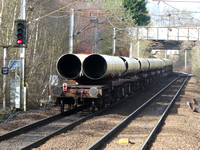
|
| A rear view of 6X88 showing the size of the pipes being carried |
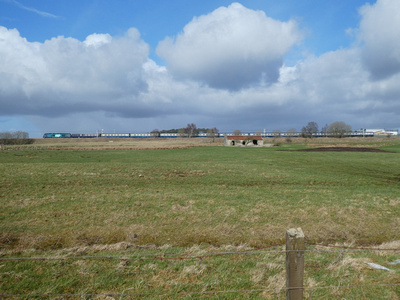 The return working of the Pathfinder Welsh 6 Nations Rugby fans Charter heading to Carmarthen from Motherwell ran on 11th March. 68016 was again used to haul the set, which was made up mainly of Blue / Grey Mark2's. Starting from Motherwell, where supporters staying in Glasgow were picked up, the charter worked south to Carstairs before diverting east over the Cobbinshaw line to Edinburgh Waverley.
The return working of the Pathfinder Welsh 6 Nations Rugby fans Charter heading to Carmarthen from Motherwell ran on 11th March. 68016 was again used to haul the set, which was made up mainly of Blue / Grey Mark2's. Starting from Motherwell, where supporters staying in Glasgow were picked up, the charter worked south to Carstairs before diverting east over the Cobbinshaw line to Edinburgh Waverley.
At Edinburgh, it picked up its remaining passengers before returning along the Cobbinshaw line to Carstairs East Junction. As the charter was running early by this point, it was held here awaiting its correct time and for a southbound Pendilino from Glasgow to pass.
The charter then joined the West Coast Main Line and headed south. At Carlisle, 68016 was replaced by First Transpennine Express liveried 68019 for the remainder of the journey to Carmarthen.
For completeness, the table from the part 1 post, now containing the return working's loco allocation.
| Carmarthen - Carlisle | Carlisle - Motherwell | Motherwell - Carlisle | Carlisle - Carmerthen | |
| 2015 | 68005 | 68002 | 68002 | 68005 |
| 2017 | 68024 | 68004 | 68004 | 68024 |
| 2019 | 68001 | 68016 | 68016 | 68019 |
The Main photo shows 68016 waiting at Carstairs East Junction until its right time while working 1Z27, the return Pathfinder Welsh 6 Nations Rugby fans charter from Motherwell - Carmarthen. The smaller images below show the charter at Carstairs East Junction and on the approach to Float Bridge south of Carstairs. Click on the image to see a larger version.
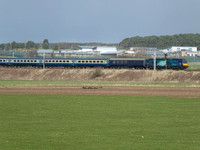
|
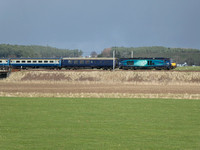
|
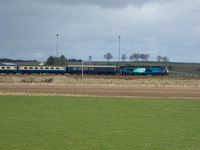
|
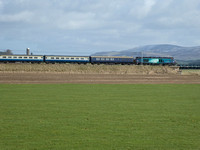
|
 On 2nd March, Blackpool and Fleetwood Box Car 40 ran in Blackpool for the final time. It's loan spell in Blackpool is now over and on Monday 4th March, the tram was moved by low loader to Beamish, where the tram will enjoy a spell on loan before moving to the Crich Tramway Museum.
On 2nd March, Blackpool and Fleetwood Box Car 40 ran in Blackpool for the final time. It's loan spell in Blackpool is now over and on Monday 4th March, the tram was moved by low loader to Beamish, where the tram will enjoy a spell on loan before moving to the Crich Tramway Museum.
Built in 1914 by the United Electric Car Company in Preston, Box Car 40 was one of a batch of 4 additional trams built for all year round use on the tramroad thus giving the tramroad 15 enclosed trams. 40 was a mainstay on the Fleetwood to North Station service until 1928 when the Pantograph Cars were introduced to the service. 40 was renumbered to 114 in 1920 when the Tramroad was bought by Blackpool Corporation Transport.
After 1928, 114 found use on the promenade and occasionally on services on the Lytham Road route. 114 was withdrawn in October 1937 (probably around the same time as the Brush Cars came into service) and found a new life as works car 5 and was used as a mess room and to transfer workmen to the trackwork sites. The tram continued in this role until 1960 when it was restored in time for the 75th anniversary of the tramway and regained it's original number (40).
40 then left for Crich in 1963, later moving to Heaton Park tramway and finally returning to Blackpool for seasonal use on specials in 1995. 40 has remained almost continuously at Blackpool since them with the exception of a return to Crich to celebrate its centenary in 2014.
The photo shows Blackpool and Fleetwood 40 paused at Bispham with a heritage service to Pleasure Beach on 22nd September 2018.
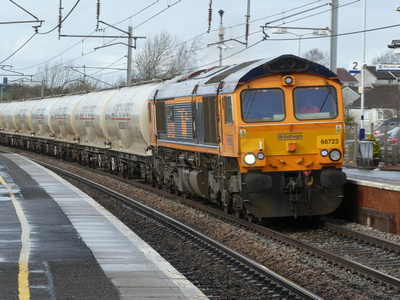 I nipped up to Carluke for around 40 minutes this afternoon and saw no fewer than 4 freights!
I nipped up to Carluke for around 40 minutes this afternoon and saw no fewer than 4 freights!
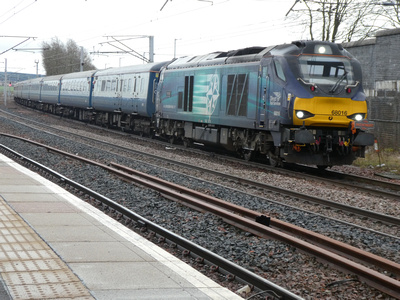 Biannually, there is a Pathfinder Railtour running from Carmarthen in Wales to Wishaw / Motherwell via Edinburgh Waverley in connection with the Scotland v Wales 6 nations rugby match at Murrayfield.
Biannually, there is a Pathfinder Railtour running from Carmarthen in Wales to Wishaw / Motherwell via Edinburgh Waverley in connection with the Scotland v Wales 6 nations rugby match at Murrayfield.
As has been the case since 2015, the tour has been hauled by a DRS Class 68.
The tour has been hauled by the following locomotives:
| Carmarthen - Carlisle | Carlisle - Motherwell | Motherwell - Carlisle | Carlisle - Carmerthen | |
| 2015 | 68005 | 68002 | 68002 | 68005 |
| 2017 | 68024 | 68004 | 68004 | 68024 |
| 2019 | 68001 | 68016 | tbc | tbc |
This morning, 68001 operated the tour from Carmarthen - Carlisle, with 68016 taking over at Carlisle for the rest of the trip north. I photographed the train at the Down Passing Loop at Carstairs with 1Z22 7.05 Carmarthen - Wishaw Pathfinder 6 Nations Welsh Rugby Supporters Charter.
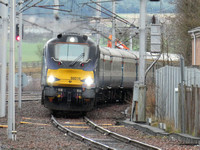
|
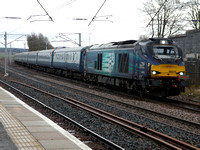
|
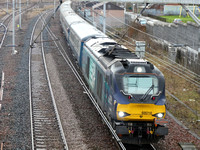
|
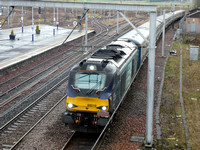
|
 314's seen between 12.00 and 13.15 today
314's seen between 12.00 and 13.15 today
Shields
314201, 314206, 314210
Glasgow Central
314209: 12.12 to Paisley Canal
314202: 12.15 Cathcart Inner Circle and 12.51 Cathcart Outer Circle
314211: 12.25 to Gourock
314208: 12.42 to Paisley Canal
314207: 12.45 to Newton via Maxwell Park
314216: 12.57 to Wemyss Bay
314205: 13.15 Cathcart Inner Circle
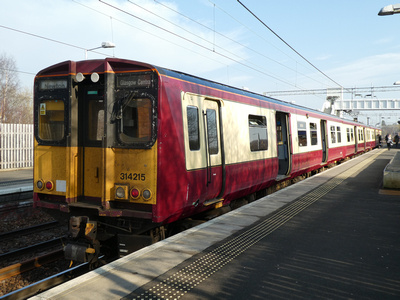 314's seen between 11.30 and 1pm today:
314's seen between 11.30 and 1pm today:
Shields
- 314206,314201 and 314208
Glasgow Central
- 314214: 11.42 and 12.42 to Paisley Canal
- 314202: 11.45 Cathcart Outer Circle
- 314215: 11.51 Cathcart Outer Circle and 12.45 to Newton via Maxwell Park
- 314210: 11.55 to Gourock
- 314209: 12.12 to Paisley Canal
- 314205: 12.15 Cathcart Inner Circle and 12.51 Cathcart Outer Circle
- 314216: 12.25 to Gourock
- 314211: 12.57 to Weymss Bay
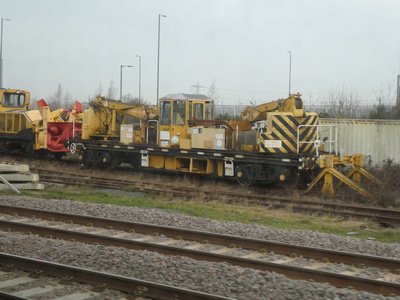 Rutherglen Permanent Way depot is located north of Rutherglen station on the West Coast Main Line. Various different track machines, snow blowers and very occasionally, the odd locomotive can be seen here.
Rutherglen Permanent Way depot is located north of Rutherglen station on the West Coast Main Line. Various different track machines, snow blowers and very occasionally, the odd locomotive can be seen here.
The PW depot is located near to where the tracks from Whifflet join and can be seen on the right hand side when heading into Glasgow.
When passing on the train on Saturday, I got a couple of photos of the various track machines stabled there.
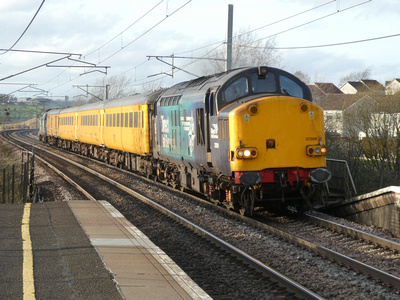 In recent months, the Network Rail PLPR test train has been operated by DRS class 37's instead of Colas.
In recent months, the Network Rail PLPR test train has been operated by DRS class 37's instead of Colas.
On 21st February, the test train was seen out on the West Coast Main Line passing through a sunny Carluke station enroute to Lanark, where upon a quick stop off and change of ends, it would return north through Carluke again about an hour later. 37059 and 37218 were the locomotives used on today's train.
The photograph shows DRS liveried 37059 and 37218 top and tail the Network Rail PLPR Test train as it passes through Carluke whilst working 1Q75 Mossend - Mossend via Lanark 21.2.19
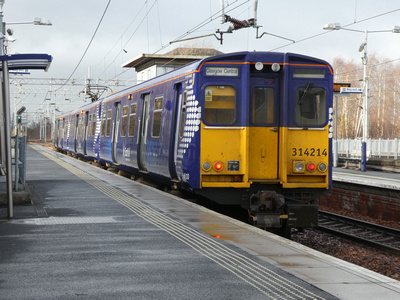 314's seen just before lunchtime at Glasgow Central today:
314's seen just before lunchtime at Glasgow Central today:
- 314202 - 11.12 to Paisley Canal
- 314207 - 11.15 Cathcart Inner and 11.51 Cathcart Outer Circle services
- 314208 - 11.42 to Paisley Canal
- 314214 - 11.45 to Newton via Maxwell Park
- 314210 - 11.55 to Gourock
- 314215 - 12.15 Cathcart Inner Circle
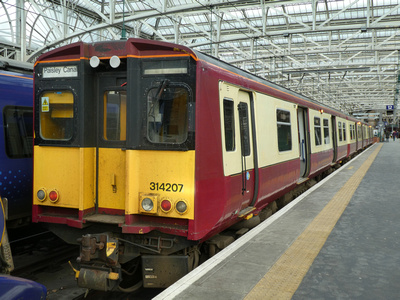 I saw the following 314's out today:
I saw the following 314's out today:
Glasgow Central
314207: 10.42 and 11.42 to Paisley Canal
314202: 10.55 to Gourock
314210: 10.57 to Weymss Bay
3142xx: 11.05 to Gourock (Didn't catch the number but was a Saltire set)
314214: 11.20 to Newton via Queens Park and 15.45 to Newton via Maxwell Park
314203: 15.20 to Newton
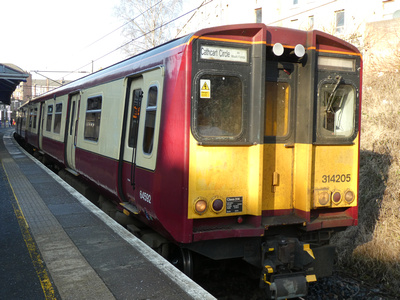 I was passing through Glasgow Central at lunchtime today and saw the following 314's in service:
I was passing through Glasgow Central at lunchtime today and saw the following 314's in service:
- 314205 11.51 Cathcart Outer Circle
- 314214 11.55 Glasgow Central - Gourock
- 314216 12.12 Glasgow Central - Paisley Canal
- 314215 12.15 Cathcart Inner Circle 314211 12.25 Glasgow Central - Gourock
- The 11.42 service to Paisley Canal and the 11.45 service to Newton were both SPT Carmine and Cream 314's, I didn't catch the numbers unfortunately.
The photo shows 314205 departing Queens Park with 2O34 11.51 Cathcart Outer Circle service.
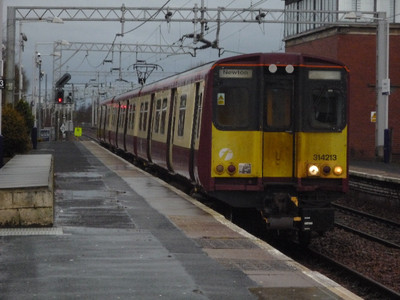 Today, 314213 became the 2nd class 314 to be taken to Glasgow Works to be stripped for spares before scrapping. The spare parts should help to keep the 11 units currently still in service working for the time being.
Today, 314213 became the 2nd class 314 to be taken to Glasgow Works to be stripped for spares before scrapping. The spare parts should help to keep the 11 units currently still in service working for the time being.
314213, one of 9 of the 16 strong fleet to retain the former SPT Carmine and Cream livery, was withdrawn initially on 21st September, before being reinstated in early October. 213 remained in service for only a couple of weeks before failing on 12th October and being transferred to Yoker for further storage.
On 12th February, 213 was collected by 37884 and hauled from Yoker to Glasgow Works via Glasgow Central Low Level, Carmyle and Gartcosh.
Unfortunately, I couldn't make it to catch a photo of today's working, however here is 314213 in happier times arriving at Newton with a service from Glasgow Central via Queens Park on 31.12.2012
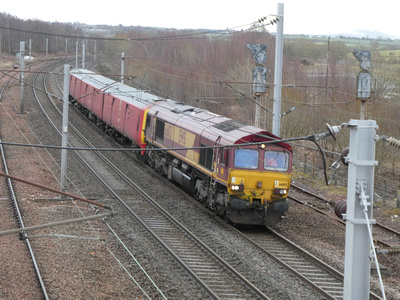 On 5th February, I tried a new photography location for me: Law Junction.
On 5th February, I tried a new photography location for me: Law Junction.
The photos were taken from the B7011 road bridge.
Looking South in the direction of Carluke, there is a view of the WCML as well as the up and down loops and former goods yard and sidings.
Looking North, there is a view of the junction where the WCML curves left to go through the western edge of Wishaw towards Motherwell, while the branch to Wishaw and Mossend curves off to the right.
The station which once existed here was located between the bridge and the junction. Unfortunately the station closed in the 1960's but there is a local campaign to get it reopened.
In the space of 5 minutes, 1 northbound and 1 southbound working passed through.
66102 with 325006 dead in tow passed heading north with a Craigentinny - Mossend working and 43062+43014 passed heading south with the New Measurement train. Click on the photos below for larger images.
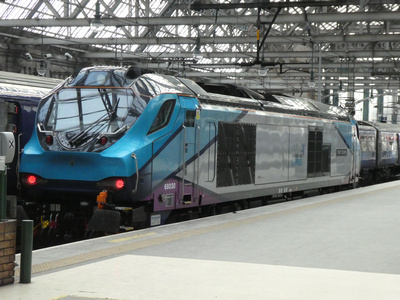 During this week, Transpennine Express have been doing route learning runs with some drivers from their Preston depot between Carlisle and Glasgow. Rather than use a 350 or 185 for the duty, they instead used 68030, which is in First Transpennine Express livery.
During this week, Transpennine Express have been doing route learning runs with some drivers from their Preston depot between Carlisle and Glasgow. Rather than use a 350 or 185 for the duty, they instead used 68030, which is in First Transpennine Express livery.
I saw 68030 'Black Douglas' at Motherwell and at Glasgow Central where it had just arrived on Platform 5 with 0S41 Carlisle - Glasgow Central.
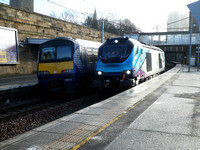
|
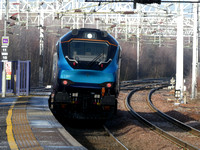
|
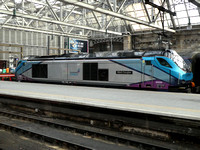
|
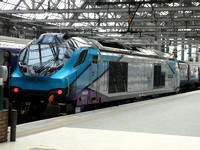
|
| Motherwell | Motherwell | Glasgow Central | Glasgow Central |
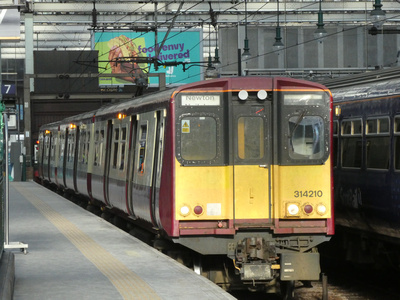 I was in Glasgow today around lunchtime and saw the following 314's
I was in Glasgow today around lunchtime and saw the following 314's
Shields Depot
314201, 314206, 314205. 205 was on the same track as 201 and 206 but had its pantograph up.
Glasgow Central
314216 xx.12 to Paisley Canal
314215 xx.42 to Paisley Canal
314203 11.45 to Newton via Maxwell Park
314208 11.55 to Gourock
314209 12.25 to Gourock
314210 12.45 to Newton via Maxwell Park
314214 12.51 to Cathcart Inner circle
314211 12.57 to Weymss Bay
Also over the past few days, 314212 has been moved south by low loader for scrapping.
11 out of 16 class 314's remain available for service
| Fleet Number | Formation | Notes | ||
| 314201 | 64583 | 71450 | 64584 | Withdrawn 28.12.18. Stored at Shields EMD |
| 314202 | 64585 | 71451 | 64586 | In Service |
| 314203 | 64587 | 71452 | 64588 | In Service |
| 314204 | 64589 | 71453 | 64590 | Withdrawn 3.11.18. Stored at Yoker |
| 314205 | 64591 | 71454 | 64592 | In Service |
| 314206 | 64593 | 71455 | 64594 | Withdrawn 23.11.18. Stored at Shields EMD |
| 314207 | 64595 | 71456 | 64596 | In Service was Withdrawn 21.9.18 then reinstated 2.10.18 |
| 314208 | 64597 | 71457 | 64598 | In Service |
| 314209 | 64599 | 71458 | 64600 | In Service |
| 314210 | 64601 | 71459 | 64602 | In Service was withdrawn November 2018 reinstated Jan 2019 |
| 314211 | 64603 | 71460 | 64604 | In Service |
| 314212 | 64605 | 71461 | 64606 | Withdrawn 21.9.18 - sent for scrapping at Glasgow Works 9.1.19 |
| 314213 | 64607 | 71462 | 64608 |
Withdrawn 21.9.18 - reinstated 2.10.18, withdrawn again 3.11.18 Stored at Yoker |
| 314214 | 64609 | 71463 | 64610 | In Service |
| 314215 | 64611 | 71464 | 64612 | In Service |
|
314216 |
64613 | 71465 | 64614 | In Service |
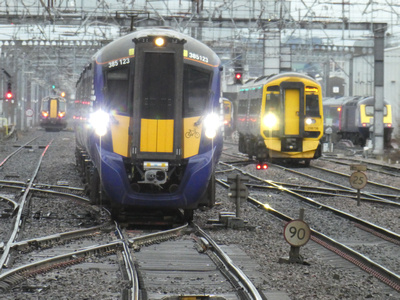 A busy scene at Haymarket as 380014 has departed with 15.05 Edinburgh Waverley - Glasgow Queen Street via Cumbernauld, 385123+385010 arrive with 1R74 14.30 Queen Street - Waverley and 158736 arrives with 2K30 14.21 Glenrothes - Waverley. A unidentified 156 and HST set are also seen stabled at Haymarket depot. 26.1.19
A busy scene at Haymarket as 380014 has departed with 15.05 Edinburgh Waverley - Glasgow Queen Street via Cumbernauld, 385123+385010 arrive with 1R74 14.30 Queen Street - Waverley and 158736 arrives with 2K30 14.21 Glenrothes - Waverley. A unidentified 156 and HST set are also seen stabled at Haymarket depot. 26.1.19
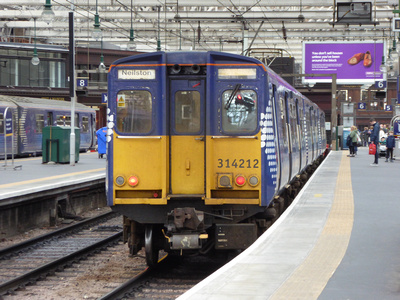 On 9th January, 314212 was moved to Glasgow Works to be stripped for spare parts and then scrapped.
On 9th January, 314212 was moved to Glasgow Works to be stripped for spare parts and then scrapped.
314212, which has been in store at Yoker since withdrawal on 21st September, was the only 314 not reinstated to service when the 385's were temporarily withdrawn in October 2018. 314212 made it's final journey from Yoker to Glasgow works on 9th January when it travelled under its own power as far as Eastfield, where 37884 hauled it the final mile to Glasgow works.
314212 was the first 314 to receive Scotrail Saltire livery and interior refresh in 2011.
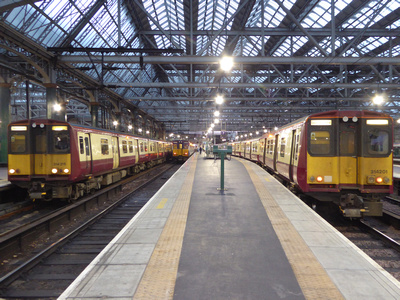 I had a couple of hours to spare in Glasgow this afternoon and in that time, I spotted 11 of the 13 remaining class 314's in service.
I had a couple of hours to spare in Glasgow this afternoon and in that time, I spotted 11 of the 13 remaining class 314's in service.
Units seen in service were: 314201, 202, 205, 207, 208, 209, 211, 214, 215 and 216. 314209 and 314203 were waiting to work an ECS from Shields into Central as well meaning 11 units were in service.
Here are the services that I saw the 314's working on:
| Unit | Headcode | Working |
| 314207 | 2M78 | 13.45 Glasgow Central - Newton via Maxwell Park |
| 2M79 | 14.19 Newton - Glasgow Central via Maxwell Park | |
| 2I23 | 15.15 Cathcart Inner Circle via Maxwell Park | |
| 2O26 | 15.51 Cathcart Outer Circle via Queens Park | |
| 314214 | 5O24 | 15.07 Glasgow Central - Crosshill Via Queens Park |
| 2O24 | 15.20 Crosshill - Glasgow Central via Mount Florida | |
| 314202 | 2N20 | 15.06 Glasgow Central - Neilston |
| 314216 | 2G45 | 15.05 Glasgow Central - Gourock |
| 314205 | 2D39 | 15.42 Glasgow Central - Paisley Canal |
| 314208 | 1G58 | 15.24 Gourock - Glasgow Central |
| 314201 | 2I27 | 16.15 Cathcart Inner Circle via Maxwell Park |
| 314211 | 2P18 | 16.20 Glasgow Central - Newton via Queens Park |
| 314215 | 2N26 | 16.08 Glasgow Central - Neilston |
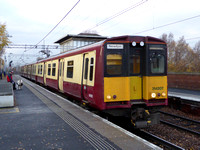
|
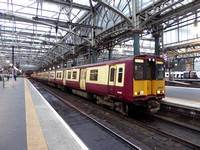
|
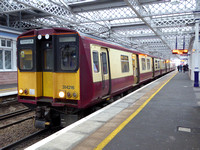
|
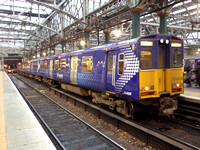
|
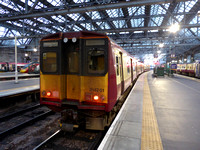
|
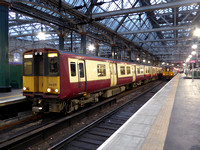
|
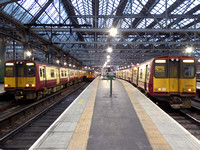
|
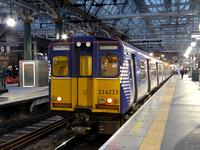
|
 Glasgow Central and Newton Class 314 sightings 7.11.18
Glasgow Central and Newton Class 314 sightings 7.11.18
I was passing through Glasgow Central on my way to/from dinner in the city centre and spotted 9 of the remaining 13 class 314's in service. I also travelled into Central on 314214.
The reduction to 13 in service has happened as 314213 was withdrawn for the second time in recent months and 314204 has also been removed from service.
Both units were moved to Yoker depot sometime last weekend for storage alongside 314212 which was already there.
The units seen were: 314202, 203, 205, 207, 208, 210, 211, 214, 216. There was at least another Carmine and Cream 314 in service, which was running on the 17.12 service to Paisley Canal, unfortunately I didn't manage to catch the number as it was too dark to see it from 314214.
| Unit | Headcode | Service |
| 314214 | 2P18 | 16.20 Glasgow Central - Newton via Queens Park |
| 2P19 | 16.49 Newton - Glasgow Central via Queens Park | |
| 2I31 | 17.23 Cathcart Inner Circle via Maxwell Park | |
| 314210+314205 | 1N32 | 17.18 Glasgow Central - Neilston |
| 314203 | 2P24 | 17.31 Glasgow Central - Newton via Queens Park |
| 314208+314207 | 2N36 | 17.37 Glasgow Central - Neilston |
| 5N03 | 19.28 Glasgow Central - Corkerhill CSMD | |
| 314216 | 2D47 | 17.42 Glasgow Central - Paisley Canal |
| 314211 | 2O31 | 17.51 Cathcart Outer Circle via Queens Park |
| 2I15 | 19.15 Cathcart Inner Circle via Maxwell Park | |
| 314202 | 1W17 | 17.56 Glasgow Central - Weymss Bay |
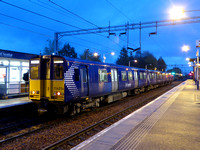
|
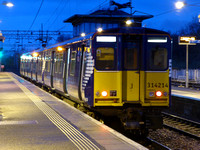
|
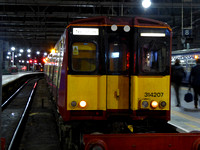
|
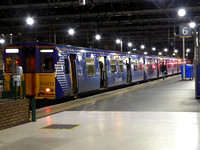
|
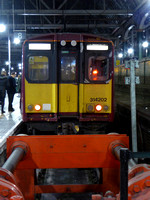
|
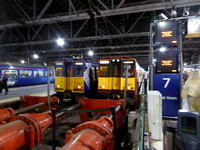
|
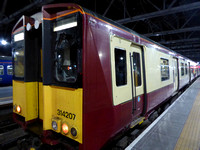
|
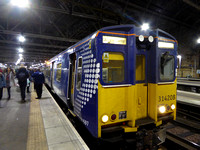
|
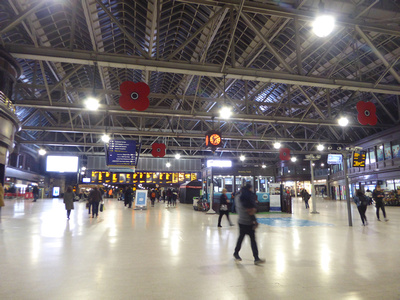 The forecourt of Glasgow Central has been decorated for Remembrance Day. Four large poppies can be seen hanging from the rafters, whilst a poppy Scotland shop is also seen behind the lounge.
The forecourt of Glasgow Central has been decorated for Remembrance Day. Four large poppies can be seen hanging from the rafters, whilst a poppy Scotland shop is also seen behind the lounge.
The Station clock has also had it's bulb changed and is shining red. Inside the clock faces are silhouettes with the following: 'Lest we Forget', '1914-1918' a poppy and a soldier next to a cross.
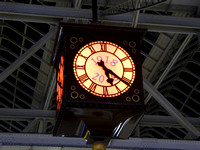
|
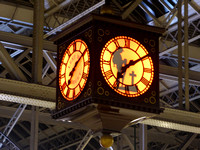
|

|
 The Bo'ness Autumn Steam Gala took place from 2nd - 4th November.
The Bo'ness Autumn Steam Gala took place from 2nd - 4th November.
It was a fantastic weekend, featuring 5 steam locomotives:
- Coltness Iron Works No.1 - 'Lord Roberts'
- N.C.B. No.6
- N.C.B Fife Area No.19
- Caledonian Railway 439 class No.419
- Caledonian Railway 812 class No.828 (on loan from the Strathspey Railway)
I visited for a short time on Friday afternoon and 419 and 828 were being prepared for their starring role on the Saturday and Sunday. No. 19 was working on the passenger service and No.1 arrived into Bo'ness with a short demonstration freight, which No. 6, which was acting as shunter for the weekend, shunted from the yard to the bay platform.
On to the Saturday and I was there for a couple of hours. 828 was in the bay platform with the 2 Caledonian Railway coaches. 419 was then coupled onto the front. A short time later, No.1 and No.19 top and tailed with the Mark 1 set arrived from Manuel. No.1 remained on the rear of the set while No.19 came off the train and 419, 828 and the 2 caledonian coaches coupled onto the front and worked the 12.09 to Manuel.
1, 828 and 419 returned to Bo'ness on the 12.38 from Manuel and 828 and 419 with the 2 caledonian coaches came off and returned to the bay platform. No.19 then returned to the front of the train and worked the next service out to Manuel with No.1 on the rear. 419 then headed to fill up with water next to the steam shed. Unfortunately I had to leave at that point but it was a fantastic event. 419, which was returning to service after 10 years looked superb and visiting loco 828 was also amazing. This was the first time both locomotives had worked together in preservation.
More photos from the weekend can be found at https://scottishtrains.zenfolio.com/p326245263
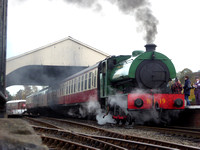
|
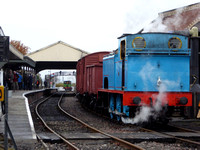
|
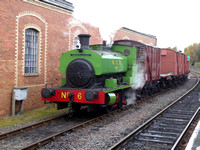
|
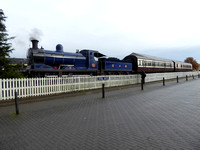
|
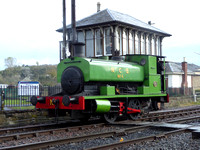
|
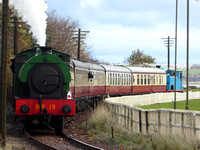
|
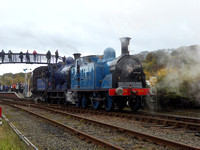
|
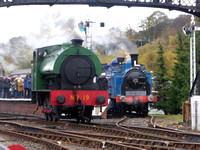
|
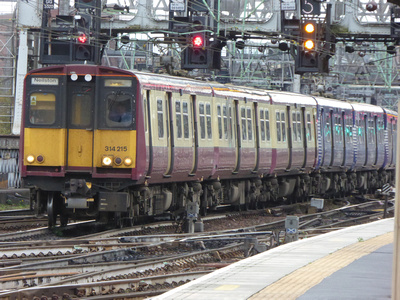 I was in Glasgow this morning and saw 15 of the 16 314's. The workings I saw them on were:
I was in Glasgow this morning and saw 15 of the 16 314's. The workings I saw them on were:
314203 on 10.20 and 13.20 services to Newton via Queens Park
314202+314204 on 10.35 Glasgow Central - Neilston
314216 10.55 Glasgow Central - Gourock
314210 10.57 Glasgow Central - Weymss Bay
314214+314215 11.05 Glasgow Central - Neilston
314206 11.12 Glasgow Central - Paisley Canal
314208 11.35 Glasgow Central - Neilston
314201 and 314209 were stabled at Corkerhill
314205, 314207, 314211 and 314213 were stabled at Shields
The only set I didn't see was 314212.
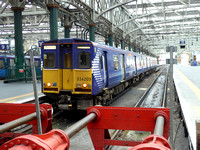
|
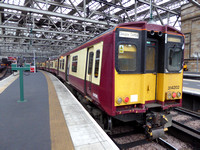
|
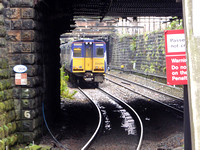
|
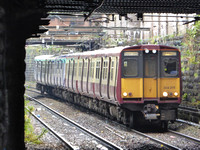
|
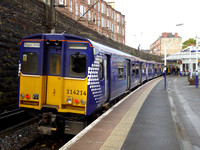
|
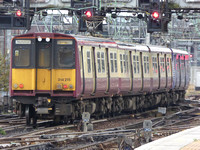
|

|
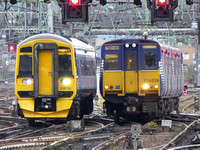
|
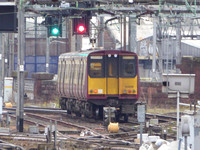
|
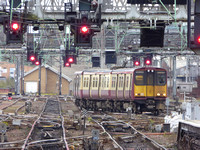
|
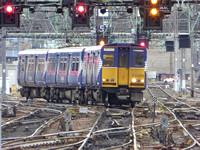
|

|
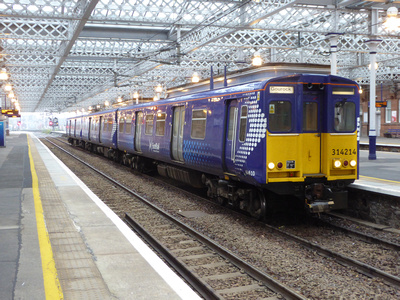 I was heading into Glasgow for lunch, but decided to head in early to ride on and photograph some class 314's. Over the space of 3 hours, I managed to spot, photo or ride on 13 of the 16 members of the fleet.
I was heading into Glasgow for lunch, but decided to head in early to ride on and photograph some class 314's. Over the space of 3 hours, I managed to spot, photo or ride on 13 of the 16 members of the fleet.
Starting at Newton, I caught 314203, the only 314 that I had still to get a decent photograph on. 314203 of course is the unit with the unique driving trailer, 64588. 64588 is the second vehicle to carry this number as the original was destroyed in the Newton crash in 1991, when 314203 and 303037 collided just outside the station. Today's 64588 is actually vehicle 64426 from disbanded 3rd rail class 507022. It was converted to work from ac power and used to reform set 203. When it returned to service in the mid 1990's, 64588 was used as a test bed for a number of different types of seating, flooring, lighting diffusers and grab handles. It now carries the standard class 314 low backed seating.
314203 was working 2P15 9.49 Newton - Glasgow Central via Queens Park and ran to time until it reached Croftfoot, when one of the doors didn't close properly and the driver had to get out and close them. This also happened at Kings Park and Mount Florida. 314203 arrived at Glasgow Central 2 minutes late. 314203 then worked 2P18 10.20 Glasgow Central - Newton via Queens Park and also the 11.20 and 12.20 workings.
Enroute, 314207 was seen between Mount Florida and Cathcart with a Cathcart Outer Circle service and 314206+314216 passed at Pollockshields East with a Glasgow Central - Neilston service. The Neilston services were all worked by pairs of class 314's.
I then headed out to Paisley Gilmour Street, 314202 was just arriving into Central with a Neilston service as the service I was on departed. I noted 314213 and 314211 at Shields EMD, 314213 had it's pantograph down. At Gilmour Street, 314214 on 1G03 10.55 Glasgow Central - Gourock was the first of 2 314's seen there, with 314205 on 1W33 10.57 Glasgow Central - Weymss Bay next to arrive. I then headed back to Central, just in time to see 314206+314216 depart with 2N34 11.35 Glasgow Central - Neilston service.
A short time later 314207 arrived into platform 10 at Glasgow Central with 2M91 11.19 Newton - Glasgow Central service then shortly afterwards Saltire liveried 314209 arrives into platform 11 with 2D22 11.35 Paisley Canal - Glasgow Central service. They would depart with 207 working 2G63 12.05 service to Gourock and 209's next working was 2D25 12.12 service to Paisley Canal.
314202 next arrived coupled to 314201 and would form the 2N02 12.05 service from Glasgow Central - Neilston. I got on this working as far as Mount Florida, where I caught 314210+314204 on 2N01 11.58 Neilston - Glasgow Central. 204's rear vehicle was locked out of use. The double set departed Glasgow Central at 12.35 with 2N04 12.35 service to Neilston.
Heading home in the evening, 314203 was seen getting ready to depart Glasgow Central with 2W15 18.38 service to Weymss Bay, while 314207 was seen arriving with it's centre coach in darkness and locked out of use. The only 3 units I didn't see were 314208, 314212 and 314215.
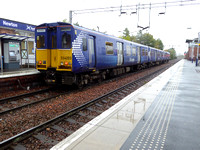
|
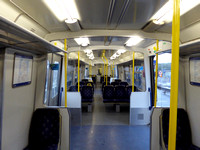
|
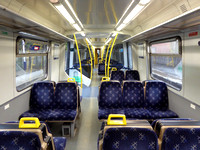
|
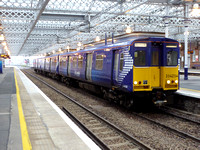
|
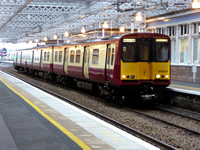
|
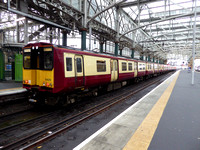
|
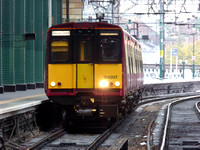
|
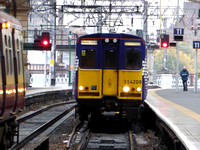
|
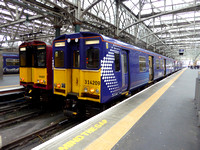
|
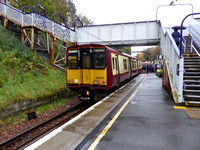
|
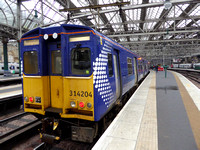
|
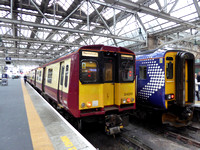
|
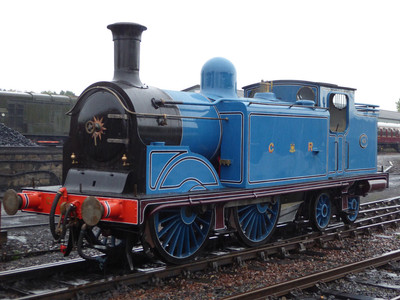 The beautifully restored Caledonian 439 class number 419 is seen stabled outside the steam shed at Bo'ness in torrential rail on Friday 12th October.
The beautifully restored Caledonian 439 class number 419 is seen stabled outside the steam shed at Bo'ness in torrential rail on Friday 12th October.
The loco, which has just undergone a lengthy overhaul, is due to be relaunched into service at the Bo'ness steam gala, which is taking place from November 2nd - 4th November.
As well as 419 being in service, Caledonian Railway 812 class no 828 is visiting on loan from the Strathspey Railway for the weekend and should make a fine sight as it travels along the banks of the Forth.
An interesting fact about the 812 class that I didn't know about until recently is that they were the inspiration for 'Donald' and 'Douglas', the Scottish twin locomotives from Rev W Awdry's 'Railway Series' and it's TV adaptation 'Thomas the Tank Engine'!
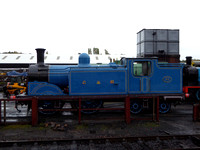
|
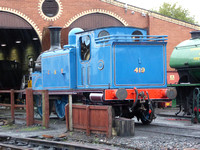
|
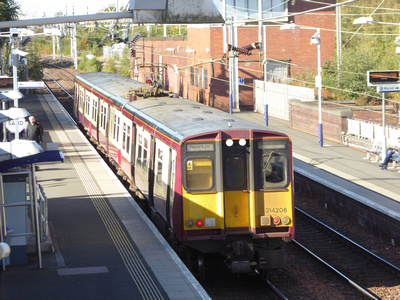 Debranded SPT Carmine and Cream liveried 314206 is seen at Newton prior to departure with the 2P23 11.49 service from Newton - Glasgow Central.
Debranded SPT Carmine and Cream liveried 314206 is seen at Newton prior to departure with the 2P23 11.49 service from Newton - Glasgow Central.
Following the recent withdrawal of the class 385's due to issues with their brakes, 314207 and 213, which had been withdrawn only 2 weeks ago, have been reinstated to service.
This is due to class 380's currently working on the Inverclyde lines being required to work on the Edinburgh - Glasgow line to cover for the class 385's.
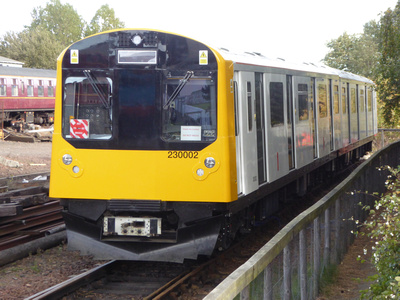 Vivarail's Battery Electric Multiple Unit demonstrator unit 230002, which was constructed from former London Underground 'D' stock, is seen charging at Bo'ness. 230002 is at Bo'ness for testing and demonstration purposes.
Vivarail's Battery Electric Multiple Unit demonstrator unit 230002, which was constructed from former London Underground 'D' stock, is seen charging at Bo'ness. 230002 is at Bo'ness for testing and demonstration purposes.
Bo'ness are offering free rides on the unit on Wednesday 10th, Thursday 11th and Friday 12th October.
See https://www.bkrailway.co.uk/free-rides-on-vivarail-new-class-230-battery-train-at-boness-kinneil-railway/ for more details.
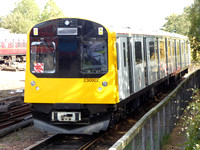
|
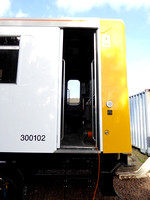
|
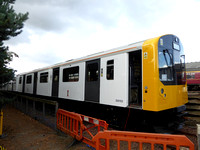
|
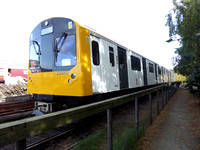
|
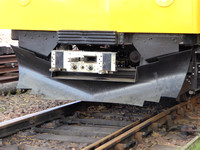
|
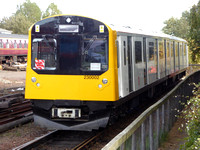
|
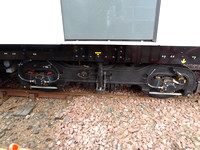
|
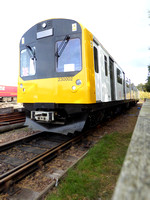
|
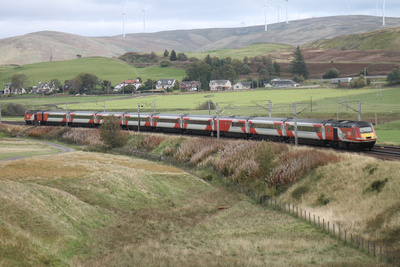 On Saturday 29th September, all LNER services were diverted via the Tyne Valley line from Newcastle - Carlisle and then the West Coast Main Line from Carlisle - Carstairs followed by the Cobbinshaw line from Carstairs - Edinburgh.
On Saturday 29th September, all LNER services were diverted via the Tyne Valley line from Newcastle - Carlisle and then the West Coast Main Line from Carlisle - Carstairs followed by the Cobbinshaw line from Carstairs - Edinburgh.
I managed to catch 2 diverted HST's passing Crawford, just south of Abington.
Also spotted was 390045 'Virgin Pride'
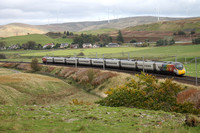
|
| 390045 'Virgin Pride' with rainbow branding on coaches A and K passes through Crawford with 1S58 London Euston - Glasgow Central |
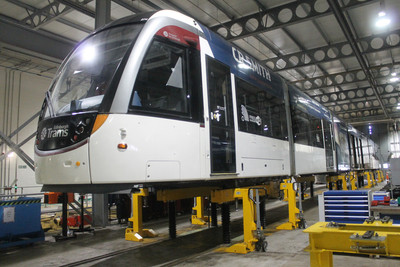 I managed to get a ticket for the Edinburgh Trams depot open day on Saturday 29th September. The depot tour took in a visit to the main building, where we met the training staff, and did a quiz in groups! On the particular tour I was on, all 4 groups scored 2 points each, winning an Edinburgh Trams squishy stress toy! We then got to see the main operations room, where we saw the live map showing the position of the 12 trams in service and whether they were on time or not as well as finding out about the different roles of the team members who worked there. As there was live CCTV images on the screens in the room, we weren't allowed to photograph this particular area.
I managed to get a ticket for the Edinburgh Trams depot open day on Saturday 29th September. The depot tour took in a visit to the main building, where we met the training staff, and did a quiz in groups! On the particular tour I was on, all 4 groups scored 2 points each, winning an Edinburgh Trams squishy stress toy! We then got to see the main operations room, where we saw the live map showing the position of the 12 trams in service and whether they were on time or not as well as finding out about the different roles of the team members who worked there. As there was live CCTV images on the screens in the room, we weren't allowed to photograph this particular area.
Next we were taken to the engineering sheds, where trams 260 and 268 were over the pits for maintenance, 258 was at the west end of the sheds. 258 was receiving repairs having been out of service since June when a bus collided with it, causing 2 sections to derail. We then saw tram 274, which was lifted up on jacks for maintenance. Finally in the shed, we got the chance to view tram 272's roof from the overhead gantry that ran the length of the tram, allowing a closer look at some of the circuit boxes and to see the pantograph close up.
We then went to the sanding shed, where tram 252 was waiting for us to take us round to the yard via the tram wash! Once at the yard, we got to take photos of the driving cabs on board tram 254 and ask one of the drivers some questions about the tram. We then got to see some of the engineering vehicles and some of the attachments for the Unimog.
The final part of the tour was to a small souvenir stand, where for a small donation to Edinburgh Tram's chosen charity, you could get some goodies to take away including: advertising posters, pens, the Edinburgh Trams annual, a cardboard model of a tram and a squishy tram. We also got to keep our special High-Vis vests that we wore on the way round the depot. Then it was then the end of the tour.
Thank you to the Edinburgh Trams staff for an excellent day!
More Photos from the event can be found at : https://scottishtrains.zenfolio.com/p73287662
 In the past month, Blackpool Flexities 003 and 016 have received all over adverts for prettylittlething.com. The adverts consist of a pink basecoat with white unicorns all over the body, with prettylittlething.com displayed in black letters. Fortunately the windows have been kept clear of contravision.
In the past month, Blackpool Flexities 003 and 016 have received all over adverts for prettylittlething.com. The adverts consist of a pink basecoat with white unicorns all over the body, with prettylittlething.com displayed in black letters. Fortunately the windows have been kept clear of contravision.
Both trams have received identical adverts.
In the photo on the right, Flexity 016 is seen at Cabin on a Starr Gate - Fleetwood service on 24th September
I arrived in a very windy Blackpool at 2pm and Brush Car 621 and Ex towing Railcoach 680 were working an afternoon Heritage service from 1.30-5.00pm between Pleasure Beach and North Pier / Cabin. The tramway was in chaos after 4.30pm due to an issue with the overhead line and high winds meaning the tramway was closed temporarily between Starr Gate and Manchester Square.
Into the evening and the Fireworks championship entry for the night had been cancelled due to the weather. The prom was quieter than a normal Illuminations Friday night, meaning only 2 trams out on illuminations tours. Frigate 736 and the Western Train 733+734 were used with Trawler 737 being used for the Ghost tram tour to Fleetwood and back.
Saturday 22nd September
Saturday was a lot calmer with a cool breeze and alot of cloud about. There was a number of heritage trams out on the enhanced heritage services during the day. 711 was stabled at North Pier for the day as the Shop tram. 719 was used on the depot shuttle between Rigby Road Depot and Starr Gate. 621 and 717 operated a heritage service between Starr Gate and Fleetwood, while 40, 147, 600, 631, 642, 701, 715, 718 and 723 operated heritage services and specials between Pleasure Beach and North Pier / Cabin / Bispham / Little Bispham / Cleveleys and Thornton Gate.
At Rigby Road, there was a display of trams along the fitting shop wall and on the depot fan in connection with the depot tours. Brush Car 634, Balloon 703 (still in Sunderland livery) and open top balloon 706 were on display along the fitting shop wall and Jubilee 761, Halle 902 and Engineering tram 754 on the depot fan.
On to the evening and there was 6 trams out on Illuminations tours. 733+734, 736, 147, 701, 718 and 723 saw use during the night with each tram doing 2 tours.
Sunday 23rd September
During the week before heading to Blackpool, the forecast for Sunday was for heavy rain all day, however it turned out to be a fine sunny day! Again there was plenty of trams out. 711 once again had the role of shop tram. 713 started as the depot shuttle tram, however it failed at Manchester Square on it's first trip and was towed back to depot. 719 replaced 713 for the remainder of it's duties. 701 and 715 operated between Starr Gate, with 40, 66, 600, 621, 642, 648, 680, 717, 718 and 737 operating the remainder of the specials and heritage services.
At Rigby Road, 634, OMO 8 and open top Balloon 706 were on display at the Fitting shop wall, while Jubilee 761, Brush 631 and Coronation 304 were on display on the depot fan. I went on the 11am tour of the depot and Balloon 703, Brush 634, Boat 230 (604) and Twin Car 675+685 were in the electrical compound. Standard 143 was in the Fitting shop, Birkenhead 20 in the Body shop along with the lower saloon of Lytham 43 and Glasgow 1016. Boat 227 (602) was in the paint shop and is due to return to service in a couple of weeks time. In the main depot, the City Tram (former Trampower 611), Brush 625, Balloons 708, 723 and 726, Millennium Balloons 707, 709 and 724, Hovertram 735, Rocket 732, The Western Train, the Frigate and Coronation 660 were visible. At Starr Gate, Flexities 005 and 011 were in the storage shed, while 007, 014 and 017 were in the maintenance shed.
On to the evening and 737 was out on a private hire, whilst 733+734 and 736 were joined by Balloons 700, 711 and 719 on illuminations tours, however the 3 balloons only did 1 tour each.
Monday 24th September
I was in Blackpool till 1pm and it was only Flexities out in service. Interestingly, Flexities 003 and 016 have received a pink all over advert for Prettylittlething.com.
Overall it was a fantastic weekend with plenty of trams to see. My full gallery of photos can be found at: https://scottishtrains.zenfolio.com/p725771107
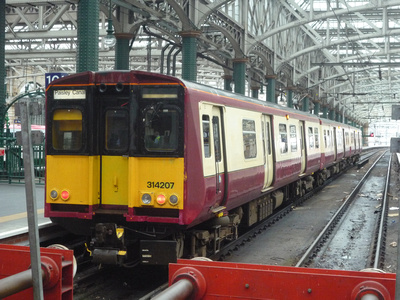 After service on 21st September, the first of the class 314's were withdrawn from service. Carmine and Cream examples: 314207 and 314213 were withdrawn along with Scotrail liveried 314212. This reduces the servicable fleet from 16 down to 13. All 3 withdrawn sets were moved to Yoker depot for storage until they are returned back to Angel Trains, their leasing company.
After service on 21st September, the first of the class 314's were withdrawn from service. Carmine and Cream examples: 314207 and 314213 were withdrawn along with Scotrail liveried 314212. This reduces the servicable fleet from 16 down to 13. All 3 withdrawn sets were moved to Yoker depot for storage until they are returned back to Angel Trains, their leasing company.
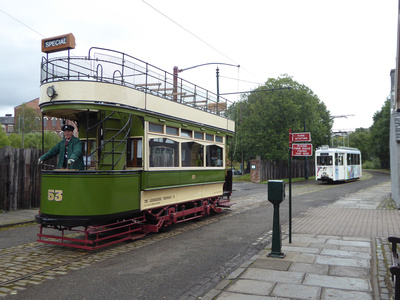 I have been visiting Summerlee on and off since I was around 5 years old and today was the first ever time that I have seen Lanarkshire open topped tram 53 in service! I have seen the tram in the sheds before but it was great seeing it out on the short tramway that runs within the museum! The tram really does look fantastic and is a credit to the volunteers who have restored it!
I have been visiting Summerlee on and off since I was around 5 years old and today was the first ever time that I have seen Lanarkshire open topped tram 53 in service! I have seen the tram in the sheds before but it was great seeing it out on the short tramway that runs within the museum! The tram really does look fantastic and is a credit to the volunteers who have restored it!
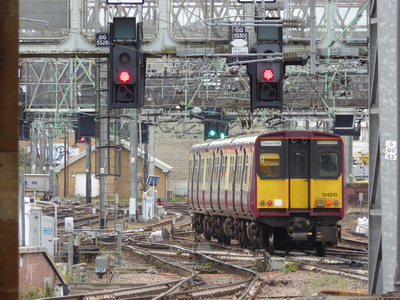 The class 314's are in their final months of service as they will be withdrawn when sufficient class 385's are in service to allow them to be replaced. The is expected to be either later this year or into next year, so it is a case of ride them and photograph them while you can.
The class 314's are in their final months of service as they will be withdrawn when sufficient class 385's are in service to allow them to be replaced. The is expected to be either later this year or into next year, so it is a case of ride them and photograph them while you can.
I've been in Glasgow at various times on Saturdays over the past 3 weeks but mainly in the morning and have noticed a pattern of workings during this time. I have shared my observations below for anyone who is looking to photo / ride on the units. Hopefully they are of some use!
Observations
- Glasgow Central - Newton via Queens Park - worked by class 314, appears to be the same unit for most, if not all the day.
- Glasgow Central - Neilston -worked by 314's possibly 3x 3 car and 1x6 car. I've seen the 6 car working on the 10.57 from Neilston and the 17.35 departure from Central - Neilston in past couple of weeks.
- Glasgow Central - Paisley Canal - worked by 2 x 3 car 314's
- Glasgow Central - Gourock - spotted 3 (possibly 4) class 314's on this working today, however there could have been more.
- Newton via Maxwell Park - appears to be worked by class 318 or class 320 for most of the daytime, but could possibly be a 314 early morning
- Cathcart Inner Circle - appears to be worked by a class 318 or 320 for most of the daytime, but could possibly be a 314 early morning
- Cathcart Outer Circle - appears to be worked by a class 318 or 320 for most of the daytime, but could possibly be a 314 early morning
There appears to be interworking between the Newton via Maxwell Park and circle services e.g. some of the time a unit coming off a Newton service goes on to do either an Inner or outer circle (or inner then outer or vice versa).
 For the 3rd time so far in 2018, Edinburgh Tram 271 has a new advert!
For the 3rd time so far in 2018, Edinburgh Tram 271 has a new advert!
The new advert is for Parabola, the fourth Edinburgh Tram to carry an advert for this company. The 4 advert sections have a unique design on each of them for 'Edinburgh City Vision 2050'.
The tram re-entered service in this new livery on 10th September, having replaced the previous advert for Tiso which had only been applied in July!

|

|

|

|

|

|
 The Class 314's are the only Scotrail units to retain the former SPT Carmine and Cream livery. 9 of the 16 strong fleet: (314201, 202, 205, 206, 207, 210, 213, 215 and 216) still carry the livery that was at one time carried by all the class 314's, 318's, 320's and 334's as well as a number of class 156's and 170's. The livery was also carried by 4 class 303's (303019, 021, 023 and 087) before their withdrawal in 2002.
The Class 314's are the only Scotrail units to retain the former SPT Carmine and Cream livery. 9 of the 16 strong fleet: (314201, 202, 205, 206, 207, 210, 213, 215 and 216) still carry the livery that was at one time carried by all the class 314's, 318's, 320's and 334's as well as a number of class 156's and 170's. The livery was also carried by 4 class 303's (303019, 021, 023 and 087) before their withdrawal in 2002.
The veteran units, which entered service in 1979 operate on the Cathcart Circle, Newton, Neilston, Paisley Canal, Gourock and Wymess Bay lines and are due for withdrawal in 2019 when it is expected that they will be replaced by the brand new class 385 units.
On Saturday 1st September, the Carmine and Cream examples were out in force with 314202, 205, 206, 207 and 210 spotted in and around Glasgow Central in a 20 minute spell.
I got a few photos of 314205 (as well as a journey onboard from Glasgow Central - Newton) and a few of 314207, which was waiting to depart with a service from Glasgow Central to Paisley Canal.
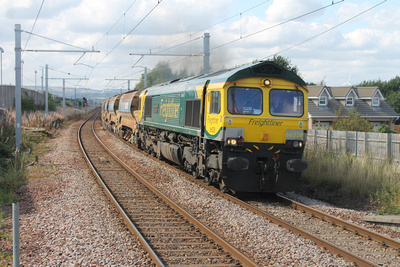 I made a brief visit to Camelon on Friday 31st August to catch Freightliner liveried 66528 passing through heading north with a train load of Autoballasters going to Huntly from Mossend. There had been full sunshine just a minute before 66528 approached, however it disappeared behind a cloud before reappearing just as the train was passing through!
I made a brief visit to Camelon on Friday 31st August to catch Freightliner liveried 66528 passing through heading north with a train load of Autoballasters going to Huntly from Mossend. There had been full sunshine just a minute before 66528 approached, however it disappeared behind a cloud before reappearing just as the train was passing through!
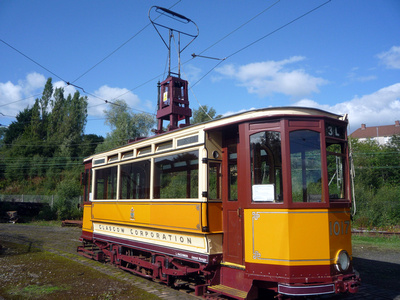 I went to Summerlee for a quick wander round late yesterday afternoon, as I walked round, I saw Glasgow 1017 stabled just outside the depot.
I went to Summerlee for a quick wander round late yesterday afternoon, as I walked round, I saw Glasgow 1017 stabled just outside the depot.
Glasgow 1017 has a long and fascinating history, she was built in 1904 by the British and Electric Car Company by the Paisley and District Tramways as number 17. The tram was originally a double decked open top unvestibuled tram. When the Paisley system was bought over by Glasgow Corporation Tramways, 17 became 1017 and still operated in it's original form for a time.
1017 was cut down to a single deck tram and fitted with a short trolley tower and enclosed driver's platforms around 1930 and found it's way onto the Clydebank - Duntocher route (later service 20), which required single deck trams due to a low railway bridge on the route. After the route closed in 1949, 1017 found a new role as the Motor School (Driver Training) car and paint shop shunter at Coplawhill depot, where it served until 1960 in this role.
On withdrawal, the body of 1017 found a new use as a hut and meeting room for the STMS in a garden in Cambuslang. In the 1990's 1017 found it's way to Summerlee, where it was restored to 1930's condition and entered service on the 1/2 mile long tramway in 2002. T
he tram still sees regular use along with Lanarkshire 53 and Dusseldorf 392. They should be joined in the future by Glasgow Coronation 1245.
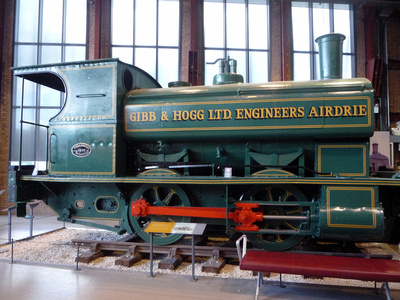 Gibb and Hogg Ltd steam loco, built in 1898 and the only loco built by that company still in existence is seen in the museum at Summerlee. The loco spent most of it's working life at Longlea Collery in Midlothian before moving to Cordowan Collery in 1965. In 1967 the loco moved to Pittencreiff Park in Dunfermilne before moving to Summerlee in 1989.
Gibb and Hogg Ltd steam loco, built in 1898 and the only loco built by that company still in existence is seen in the museum at Summerlee. The loco spent most of it's working life at Longlea Collery in Midlothian before moving to Cordowan Collery in 1965. In 1967 the loco moved to Pittencreiff Park in Dunfermilne before moving to Summerlee in 1989.
Sunday 19th August saw Centenary Car 642 make a return to service for the Blackpool Heritage Tram Tours after just over 2 years out of service. 642 had been sidelined awaiting repairs to a fault following one of the Gold weekends in 2016 (prior to the September Gold weekend as it didn't see any use then). The tram's paintwork had badly faded as it consisted of a yellow basecoat, which was applied in 2005 after it lost it's Mecca Bingo overall advert and had seen 6 years of constant exposure to the elements when in regular everyday service until 2011.
Prior to re-entering service 642 was fitted with retro style radiator grills, headlights and indicators, but retaining the basic shape of it's 1998 overhaul. The tram was repainted into a modern representation of it's 1995 Travelcard livery but advertising a number of different tickets for the Heritage service. The cab ends were repainted in the 1990's Green and Cream livery like the original did.
642 re-entered service working on Heritage route A between Pleasure Beach and Cabin / Bispham and Little Bispham

|
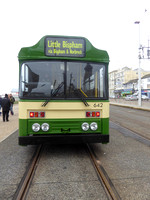
|
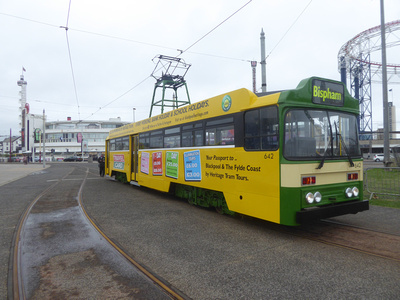 I was in Blackpool from 17th - 19th August. I arrived mid afternoon on the Friday and the promenade heritage service was in operation with Balloon 717 and Brush Car 621 operating between Pleasure Beach and North Pier. Standard 147 was due to be working on the service however, 621 was a late replacement working on route B (operating the 2 extended afternoon journeys to Cabin). Balloon 715 operated the evening ghost tour to Fleetwood and back.
I was in Blackpool from 17th - 19th August. I arrived mid afternoon on the Friday and the promenade heritage service was in operation with Balloon 717 and Brush Car 621 operating between Pleasure Beach and North Pier. Standard 147 was due to be working on the service however, 621 was a late replacement working on route B (operating the 2 extended afternoon journeys to Cabin). Balloon 715 operated the evening ghost tour to Fleetwood and back.
During the first three weekends in August, the heritage trams were extended to operate from Pleasure Beach - Bispham or Little Bispham on a 20 minute frequency (30 minutes between 12 and 2pm) using 4 trams instead of the usual 2. On the Saturday, the service was operated by Blackpool and Fleetwood 40 (route A), Standard 147 (route B), Bolton 66 (route C) and Balloon 717 (route D).
Sunday saw the return to service of Centenary car 642, which was making it's passenger debut in an up to date recreation of the Travelcard advert that the tram carried in 1995. 642, which hadn't ran since 2016, had previously carried a faded yellow basecoat, which it had carried since 2005. 642 debuted on Route A, with Balloon 715 on route B, Brush Car 621 on route C and Blackpool and Fleetwood 40 on route D (instead of the advertised Standard 147).
| A | B | C | D | Ghost Tour | |
| Friday | 717 | 621 | 715 | ||
| Saturday | 40 | 147 | 66 | 717 | |
| Sunday | 642 | 715 | 621 | 40 |
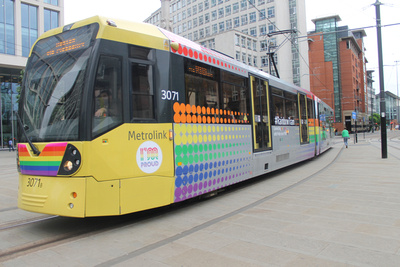 A 3 day visit to Manchester allowed me the chance to sample the Manchester Metrolink! With 120 M5000 trams and a further 27 on order, Manchester Metrolink has the largest fleet of trams in the country.
A 3 day visit to Manchester allowed me the chance to sample the Manchester Metrolink! With 120 M5000 trams and a further 27 on order, Manchester Metrolink has the largest fleet of trams in the country.
Some of the best locations in the city centre include St Peter's Square, the Delta triangle at Picadilly Gardens and Victoria Station. These 3 spots will allow you to see everything that is running on a particular day.
The MediacityUK terminus area is another good spot with all the modern architecture around the area and Salford Quays on the Eccles line is also decent.
The rest of my photos from the visit can be found at https://scottishtrains.zenfolio.com/p1017512799
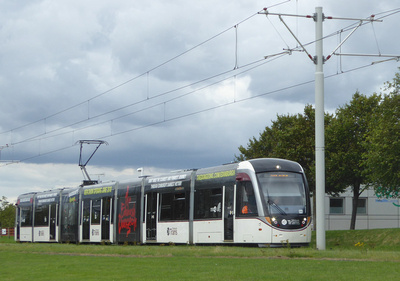 I returned to Edinburgh earlier in the week to try and get some photographs of Edinburgh tram 276 in it's Edinburgh Dungeon livery.
I returned to Edinburgh earlier in the week to try and get some photographs of Edinburgh tram 276 in it's Edinburgh Dungeon livery.
Luckily 276 was the very first tram that I saw that day!
The livery, the same on both sides of the tram, advertises their Braveheart's revenge show, which opened in June 2018.
Also of note, one of the panels on 257's #jointhepact advert has been changed on either side of the tram to show a person signing their name on a wall full of signatures.
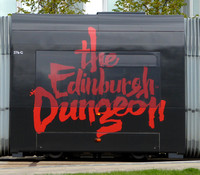
|
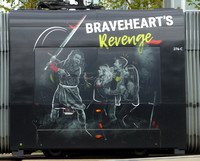
|

|
With the many different advert liveries featured on the Edinburgh Trams, here is a table showing the current advertising livery for each tram and previous adverts carried.
| Number | Current Advert | Previous Adverts |
| 251 | CR Smith (From Cumbernauld to St Fillans) | #tramspotting |
| 252 | CR Smith (From Bannockburn to Dundee) | |
| 253 | CR Smith (From the Royal Mile to Balintore) | |
| 254 | Parabola “community and architectural exemplar” | |
| 255 | CR Smith (Fae Leith tae Alloway) | |
| 256 | CR Smith (Window, Door and Conservatory repair and restoration) | |
| 257 | #jointhepact Johnnie Walker's Don't Drink and Drive campaign. | |
| 258 | CR Smith (From Turnberry to Blair Drummond) | |
| 259 | CR Smith (From Carrbridge to the Forth) | |
| 260 | CR Smith (From Glasgow - Peterhead) | |
| 261 | CR Smith (From Glen Nevis - North Queensferry) |
Edinburgh's Hogmanay 2017 £3.20 return (Promoting return tickets to Scotland v Wales in Rugby 6 nations 2017) Trampede (Promoting the Royal Highland Show 2017) Edinburgh Festival 70 (Promoting Edinburgh Festival's 70th anniversary and travel by tram to it) |
| 262 | CR Smith. (From Dunblane - St Andrews) | |
| 263 | CR Smith.(From Lossiemouth - Kinross) | |
| 264 | Parabola and the Festival Fringe | |
| 265 | CR Smith (Window, Door and Conservatory repair and restoration) | |
| 266 | CR Smith. (From Falkirk to Musselburgh) | |
| 267 | CR Smith. (From Largs - Dundee) | |
| 268 | Parabola “community and architectural exemplar” | |
| 269 | CR Smith (From Inverness to Edinburgh) | |
| 270 | CR Smith (From Fraserburgh - Finneston) | |
| 271 | Tiso | Qatar Airlines |
| 272 | CR Smith (From Troon - Edinburgh) | |
| 273 | #jointhepact Johnnie Walker's Don't Drink and Drive campaign. | |
| 274 | CR Smith (From Pitlochry - Meadowbank) | |
| 275 | CR Smith (From Speyside to Aberdeen) | |
| 276 | Edinburgh Dungeons |
Edinburgh's Christmas 2017 and Hogmanay 2018 Royal Highland Show 2018 |
| 277 | CR Smith. (From Lochmaben to Dunfermilne) |
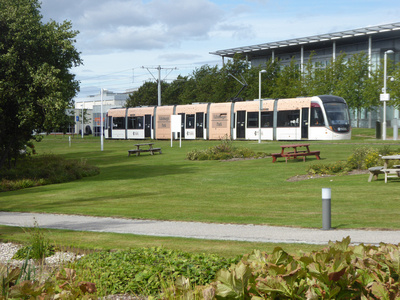 I haven't been to Edinburgh to photo the trams for a couple of months, however as there are a further 3 new adverts on the trams since I was last there, I thought I'd better go for a visit!
I haven't been to Edinburgh to photo the trams for a couple of months, however as there are a further 3 new adverts on the trams since I was last there, I thought I'd better go for a visit!
New adverts
276 has received an advert for the Edinburgh Dungeons. The advert has a mainly black base and is of the standard all over advert design. Unfortunately, the tram wasn't out in service today so didn't manage a photograph. This advert replaced the Royal Highland Show advert previously carried.
264 was the final tram to retain fleet livery and is now the third tram to receive an advert for Parabola, however this one is also advertising the Fringe Society and is due to wear this livery 12 months.
271 has received an advert for Tiso, this has replaced the all over advert for Qatar Airlines that it had carried since January.
During August, the trams are operating through out the night on Saturdays to allow easy travel home from the Festival. Also the trams are beginning to receive fleet numbers above the cab windscreens
Trams seen in service on 4.8.18:
251, 254, 256, 262, 263, 264, 266, 267, 268, 271, 272, 277
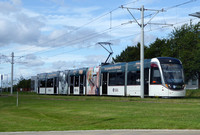
|
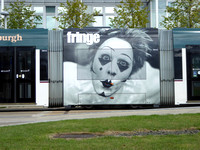
|
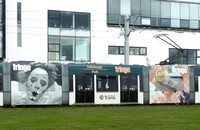
|
| 264 | 264 advert panels | 264 advert panels |
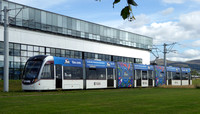
|
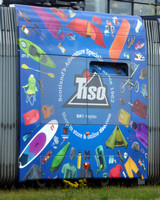
|
|
| 271 | 271 advert panel (all 4 the same) |
With the E&G line going over to all electric unit working from 19th July, there is a greater requirement for class 365's to operate services. 8 of the 10 units delivered have now entered service, with 7 sets operating on 19th July and 8 operating on 20th July. There are 8 diagrams in operation on the E&G line Only 365513 and 365523 have still to operate in passenger service. Class 385's also begin operation on the line on 24th July with 380's also having commenced working on the Falkirk Grahamston services.
Here is a fleet list containing the 10 365's that are in operation.
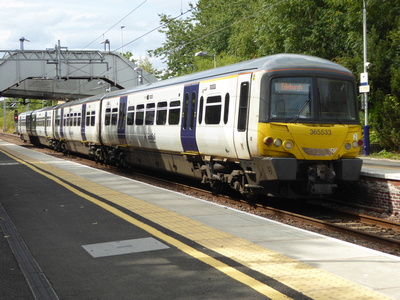 Thursday 19th July saw Electric units working for the first time between Glasgow Queen Street and Falkirk Grahamston. The electrification was recently completed from Cumbernauld up to Falkirk Grahamston and then on to the Edinburgh - Glasgow Line. 380013 and 380017 were the units working on the service on the first day.
Thursday 19th July saw Electric units working for the first time between Glasgow Queen Street and Falkirk Grahamston. The electrification was recently completed from Cumbernauld up to Falkirk Grahamston and then on to the Edinburgh - Glasgow Line. 380013 and 380017 were the units working on the service on the first day.
Meanwhile on the Edinburgh Waverley - Glasgow Queen Street line, the service between the 2 cities was operated entirely by Electric units for the first time, with class 365 and 380's operating the workings.
Units operating were:
- 365519
- 365533
- 365509
- 365517+365529
- 365521+365537
- 380111
- 380107
- 380008+380116
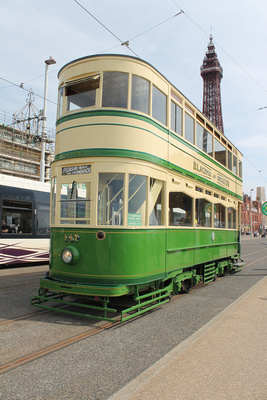 I was in Blackpool for a week long holiday from 1st - 7th July. The blue heritage service was in operation for the full week with 2 trams required to work the promenade service from Pleasure Beach to North Pier with 4 journeys per day extended to Cabin. The tram on Route A did the first 2 journeys to Cabin, while the route B tram did the final 2 journeys.
I was in Blackpool for a week long holiday from 1st - 7th July. The blue heritage service was in operation for the full week with 2 trams required to work the promenade service from Pleasure Beach to North Pier with 4 journeys per day extended to Cabin. The tram on Route A did the first 2 journeys to Cabin, while the route B tram did the final 2 journeys.
The weather was absolutely fantastic with blue sky and sunshine meaning that as boat 600 was the only open topped tram available for use during the week, it was used every day with either Standard 147(looking fantastic after it's repaint) or Bolton 66 working the other route.
Of the other open top trams: Boat 227(602) was still having work done to it's rewire and internal repaint, Boat 230 (604) is awaiting a rewire, Open topped Balloon 706 (Princess Alice) is out of service in need of a new underframe and an overhaul, Birkenhead 20 was still unavailable and Standard 143's overhaul (with open front ends) wont be complete until next year.
Balloon 717 was spotted reversing at Cabin on Thursday evening (5th) following a private hire.
On Friday (6th), the service was thrown into chaos when Boat 600 dewired at the Pleasure Beach, with the trolley wheel also coming off the pole. This meant that nothing could run south of Manchester Square for 2 hours while the overhead was repaired. 600's trolley wheel was refitted and the tram returned to service none the worse the wear.
All the flexity trams saw use at some point over the week, however it was good to see both 017 and 018 in service. Both are identical to 001-016 both externally and internally although the fresh paintwork on the new trams makes 001-016 look in need of a repaint, especially on the purple areas which look faded compared to that on 017 and 018.
A full gallery of photos from the week can be found at: http://scottishtrains.zenfolio.com/p548244318
| Date | Route A | Route B | Private Hire |
| 1.7 | 600 | 147 | |
| 2.7 | 66 | 600 | |
| 3.7 | 600 | 66 | |
| 4.7 | 600 | 147 | |
| 5.7 | 147 | 600 | 717 |
| 6.7 | 600 | 66 | |
| 7.7 | 600 | 147 |
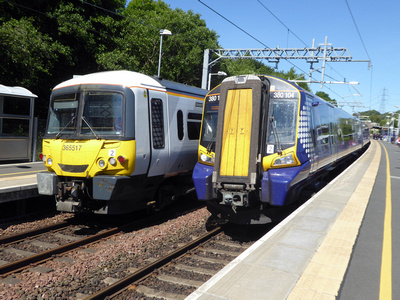 The first pair of class 365's entered service on Saturday 23rd June with 365537+365517 operating on the 22.30 service from Glasgow Queen Street - Edinburgh Waverley returning with the 23.30 working back to Glasgow Queen Street.
The first pair of class 365's entered service on Saturday 23rd June with 365537+365517 operating on the 22.30 service from Glasgow Queen Street - Edinburgh Waverley returning with the 23.30 working back to Glasgow Queen Street.
On 24th June, 365537+365517 were back out on service again operating between Queen Street and Linlithgow as the line was closed beyond Linlithgow for engineering works. 365537 has kept it's name from it's time with Great Northern and is still called 'Daniel Edwards - Cambridge Driver 1974-2010'
8 units are currently based at Eastfield with the final 2 units due to arrive on Wednesday morning. Units currently in Scotland are: 365509, 365513, 365517, 365521, 365523, 365525, 365529 and 365537
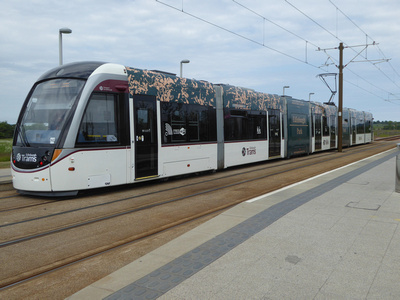 On 4th June, a further 2 Edinburgh trams entered service wearing adverts.
On 4th June, a further 2 Edinburgh trams entered service wearing adverts.
265 has became the 20th tram to carry a CR Smith advert, being the recipient of an identical advert to 256, which received its advert on 21st May. Both trams advertise CR Smith's door window and conservatory upgrade and repair service. One of the panels has 'FIX' in large red letters with the other section listing the items that they can fix. The advert appears to be the same on both sides.
268 became the 2nd tram to carry an advert for Parabola, who are developing a new “community and architectural exemplar” at Edinburgh Park. The advert is identical to the advert that 254 received last week except that the colours are inverted with a mainly green base with the text and patches in the pinky colour (they are the opposite way about on 254).
265 and 268 become the 25th and 26th trams to receive adverts, meaning that tram 264 is now the only Edinburgh tram not currently wearing an advert.
Trams seen on 8th June were: 261, 252, 260, 265, 268, 273, 276
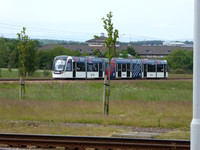
|
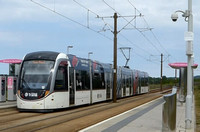
|
|
|
| 265 | 265 | 265 | |
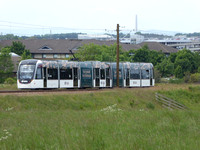
|
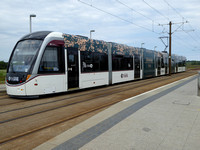
|
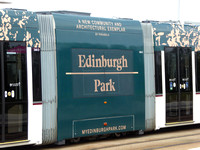
|
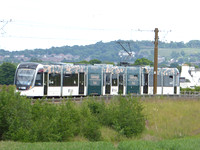
|
| 268 | 268 | 268 | 268 |
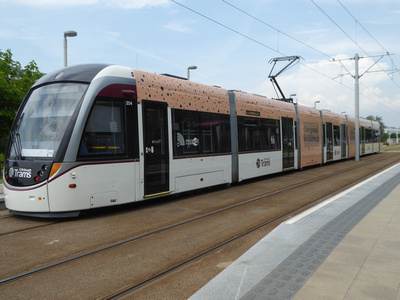 Another week and yet another new advert livery on the Edinburgh Tramway! 254 has received an advert for Parabola, who are developing a new “community and architectural exemplar” at Edinburgh Park. The advert features a pinkish coloured base with dark green spots, which runs along the top of the tram and the whole of sections 3 and 5 on each side.
Another week and yet another new advert livery on the Edinburgh Tramway! 254 has received an advert for Parabola, who are developing a new “community and architectural exemplar” at Edinburgh Park. The advert features a pinkish coloured base with dark green spots, which runs along the top of the tram and the whole of sections 3 and 5 on each side.
On one side, sections 3 and 5 contain the following text: "a new community and architectural exemplar at Edinburgh Park by Parabola" in small text near the top, then "Edinburgh Park" in large text and the website address "myedinburghpark.com" in small writing.
The other side also has the website address but has the following text in sections 3 and 5: "Edinburgh Park" in small text and in large text: "New Ground for Edinburgh".
254 is the 24th tram to receive an advert with only 264, 265 and 268 remaining in fleet livery. A further advert is expected soon as CR Smith have extended their advertising contract to cover 20 trams and 19 trams currently carry CR Smith adverts.
Trams seen in service on 2.6.18 were: 273, 252, 256, 261, 259, 276, 254, 266 and 274
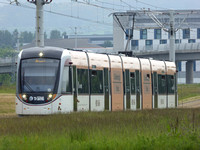
|
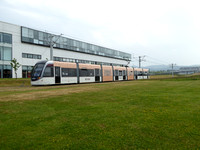
|
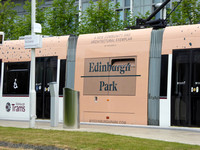
|
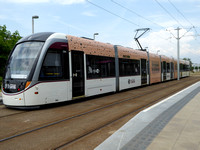
|
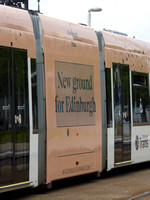
|
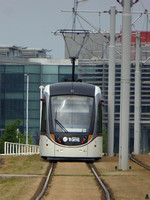
|
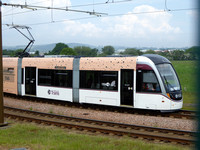
|
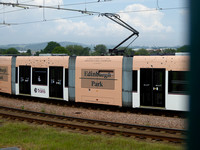
|
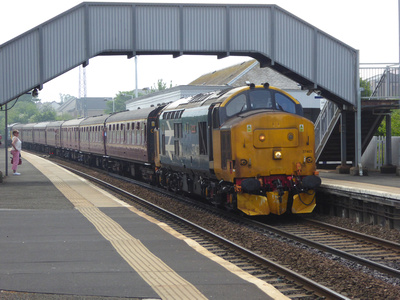 During Friday 1st and Saturday 2nd June, the SRPS operated a 'Routes and Branches' tour, which took in a number of different lines and stations across Central Scotland including, the Neilston Branch, Hamilton Circle, Fife Circle, Larkhall, Cathcart Circle, Ayr, Largs, Helensburgh Central, North Berwick and Edinburgh Waverley.
During Friday 1st and Saturday 2nd June, the SRPS operated a 'Routes and Branches' tour, which took in a number of different lines and stations across Central Scotland including, the Neilston Branch, Hamilton Circle, Fife Circle, Larkhall, Cathcart Circle, Ayr, Largs, Helensburgh Central, North Berwick and Edinburgh Waverley.
The Friday night portion utilised Caledonian Sleeper's 86401 and 37025, which is currently on loan to GBRF. The Saturday portion used 37403, which is currently on loan to DRS and 37025.
I caught the Saturday tour passing through Dalmeny while working 1Z95 from Leith South - Mossend. 37403 was leading with 37025 on the rear.
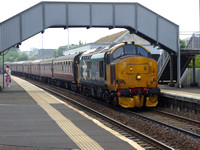
|
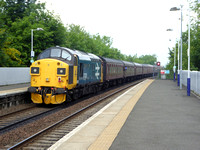
|
| 37403 | 37025 |
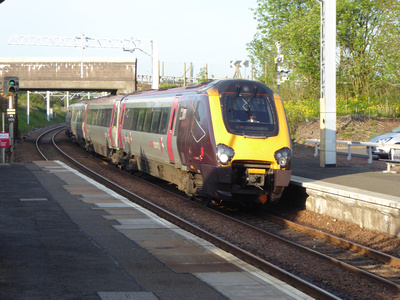 With the Cobbinshaw line closed between Midcalder Junction and Carstairs East Junction for engineering works on 26th May, Crosscountry services between Glasgow Central and Edinburgh Waverley were diverted via the Shotts line instead.
With the Cobbinshaw line closed between Midcalder Junction and Carstairs East Junction for engineering works on 26th May, Crosscountry services between Glasgow Central and Edinburgh Waverley were diverted via the Shotts line instead.
I went to Hartwood to catch 2 of these workings, operated by Cross Country Super Voyagers 221125 and 221126.
- 221125 was operating the 1C80 19.00 Glasgow Central - Edinburgh service
- 221126 was operating the 1S45 Plymouth - Glasgow Central service
Also noted were
- 156501 operating the Scotrail express service 1Y96 Glasgow Central - Edinburgh Waverley.
- 158738 operating the Scotrail express service 1Y95 Edinburgh Waverley - Glasgow Central.
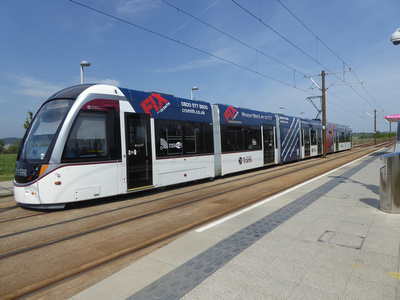 During week beginning 21st May, a 19th Edinburgh Tram has emerged into service in an advert for CR Smith. Tram 256 is the recipient of the advert, which rather than having the From ...... To...... section that the other 18 CR Smith advert trams carry, the tram advertises their door window and conservatory upgrade and repair service. One of the panels has 'FIX' in large red letters with the other section listing the items that they can fix. The advert appears to be the same on both sides.
During week beginning 21st May, a 19th Edinburgh Tram has emerged into service in an advert for CR Smith. Tram 256 is the recipient of the advert, which rather than having the From ...... To...... section that the other 18 CR Smith advert trams carry, the tram advertises their door window and conservatory upgrade and repair service. One of the panels has 'FIX' in large red letters with the other section listing the items that they can fix. The advert appears to be the same on both sides.
With the advert being applied to Tram 256, 23 of the fleet now carry adverts (19 wearing CR Smith adverts: 251, 252, 253, 255, 256, 258, 259, 260, 261, 262, 263, 266, 267, 269, 270, 272, 274, 275 and 277, 1 in Qatar Airways advert: 271, 2 in #jointhepact advert: 257 and 273 and 1 in an inhouse advert for the Royal Highland Show: 276) leaving only 4 of the fleet (254, 264, 265 and 268) in full fleet livery.
Also noted in service on 25.5.18 were 273, 256, 276, 264, 260, 261, 270.
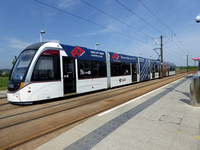
|
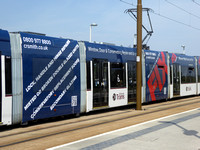
|
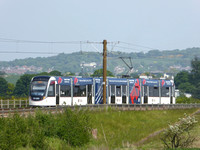
|
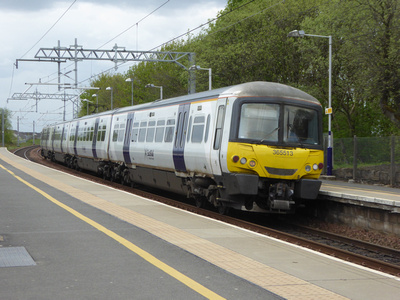 Day 2 of Class 365's on Driver Training saw 365513 debut on runs between Glasgow Queen Street and Linlithgow UPL.
Day 2 of Class 365's on Driver Training saw 365513 debut on runs between Glasgow Queen Street and Linlithgow UPL.
365513 is identical in every respect to 365523, which debuted yesterday.
365517 is still at Glasgow Works, whilst 365525 became the 4th unit to arrive in Scotland and unlike the others delivered so far, it was hauled north by 57303 rather than by road which the first 3 sets were.
A further 6 sets are due to be delivered in the coming weeks and are expected to be odd numbered sets from the 365/5 range. Entry to service is expected to take place by July.
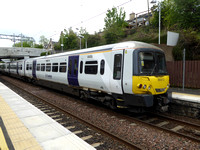
|
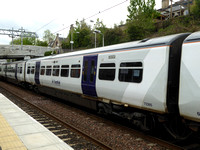
|
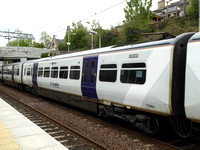
|
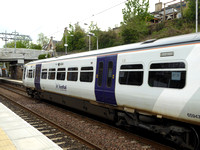
|
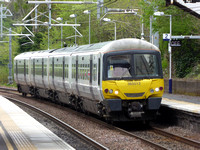
|
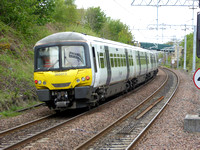
|
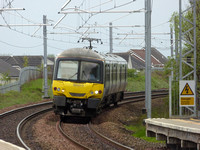
|
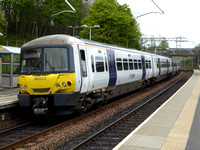
|
 Due to windscreen problems delaying the class 385's from entering service and a number of DMU's due to go off lease in the next few months, Scotrail have temporarily leased 10 class 365's, which have recently gone off lease with Great Northern.
Due to windscreen problems delaying the class 385's from entering service and a number of DMU's due to go off lease in the next few months, Scotrail have temporarily leased 10 class 365's, which have recently gone off lease with Great Northern.
They have kept their front that looks like a smiley face and have essentially kept the Great Northern livery but with doors changed from light to dark blue and Scotrail logos added to the bodysides. The first of three 365's already in Scotland saw its first use on Driver Training today (10th May).
365523 spent the day shuttling between Queen Street or Eastfield and Linlithgow Up Passenger Loop.
Today I caught 366523 on its first journey running from Queen Street - Linlithgow UPL on 2Z52.

|
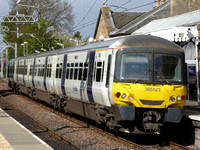
|
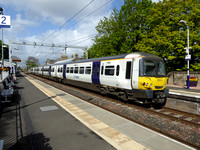
|
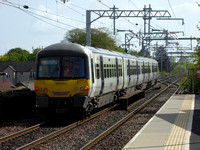
|
Edinburgh Tram 276 is the latest tram to receive an advert livery. It has received an advert for the Royal Highland Show, which takes place in June, replacing the previous advert for Edinburgh's Christmas and Hogmanay, which the tram carried until recently (although the tram did have a spell out of service from January until recently).
The advert is different on both sides of the tram, with one side featuring a green base and advertising the Royal Highland Educational Trust, whilst the other side features Emily the sheep, who was the Blackface Sheep Champion 2017, and advertises Children under 15 traveling for free to the Royal Highland Show when accompanied by and adult.
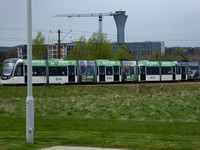
|
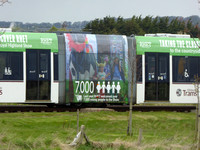
|

|
| 276 | 276 | 276 |
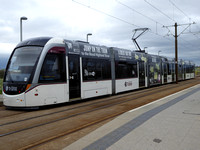
|
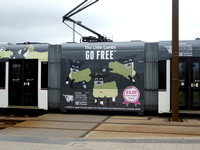
|
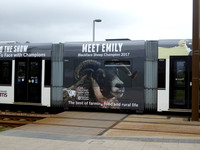
|
| 276 | 276 | 276 |
The 18th and final CR Smith Advert has also recently been unveiled and is carried by tram 251 and this one features on it's advert section 'From Cumbernauld to St Fillans' with the Arria mermaid statue found next to the M80 at Cumbernauld and the Mirror man statue found in Loch Earn at St Fillans. This advert replaces the Tramspotting advert that had been carried since January 2017.
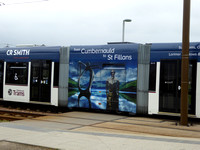
|
| 251 |
Trams seen in service on 4.5.18: 257, 254, 270, 259, 263, 266, 256, 276, 269, 251, 253, 261, 271
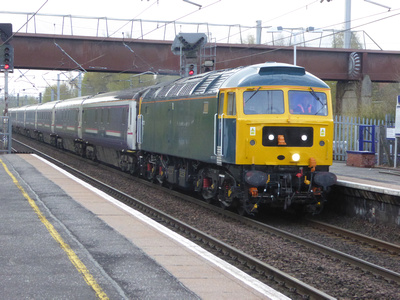 Caledonian Sleeper Blue liveried 47727 is seen passing through Shieldmuir with 5B26 Edinburgh Waverley - Polmadie Caledonian Sleeper ECS working 28.4.18
Caledonian Sleeper Blue liveried 47727 is seen passing through Shieldmuir with 5B26 Edinburgh Waverley - Polmadie Caledonian Sleeper ECS working 28.4.18
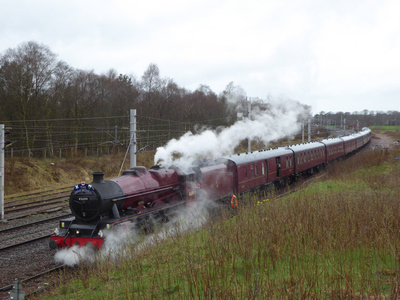 LMS Jubilee 45699 'Galatea' is seen in Carstairs Up Loop taking on water whilst working 1Z70 Inverness - Oxenholme Lake District 'The Great Britain XI' railtour 23.4.18
LMS Jubilee 45699 'Galatea' is seen in Carstairs Up Loop taking on water whilst working 1Z70 Inverness - Oxenholme Lake District 'The Great Britain XI' railtour 23.4.18
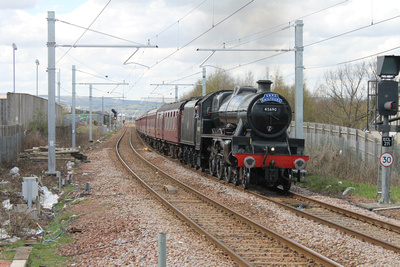 The SRPS Forth Circle tour operated with 45690 'Leander' on 21st April. I spotted it at both Camelon and Dalmeny.
The SRPS Forth Circle tour operated with 45690 'Leander' on 21st April. I spotted it at both Camelon and Dalmeny.
45690 approaches Camelon with 1Z29 Linlithgow - Linlithgow via Burntisland and Stirling Forth Circle SRPS railtour 21.4.18
45690 approaches Dalmeny with 1Z30 Linlithgow - Linlithgow via Burntisland and Stirling Forth Circle SRPS railtour 21.4.18
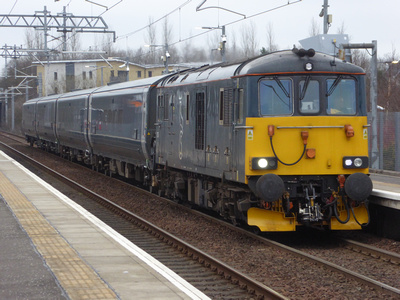 On 9th April, testing and training with Caledonian Sleeper class 73's and the new Mark 5 sleeper coaches that are due to enter service later this year began. The first run on 9th April was from Polmadie - Mossend and return. On 10th April, 73971 and four Mark 5's headed from Polmadie - Arrochar and Tarbet and back for the Mark 5's first run on the West Highland Line.
On 9th April, testing and training with Caledonian Sleeper class 73's and the new Mark 5 sleeper coaches that are due to enter service later this year began. The first run on 9th April was from Polmadie - Mossend and return. On 10th April, 73971 and four Mark 5's headed from Polmadie - Arrochar and Tarbet and back for the Mark 5's first run on the West Highland Line.
Onto today and 73971 worked 5Z73 from Polmadie - Garelochhead and back with Mark 5's 15001, 15302, 15301 and 15002. They had been supposed to have turned at Arrochar and Tarbet, however with the line closed north of Garelochhead due to a sink hole having opened up on or near the track at Glen Douglas, they turned back at Garelochhead with the 73 running round.
This training run is expected to continue to run for the remainder of the week.
The photographs show 73971 approaching Gartcosh with the 4 new Caledonian Sleeper Mark 5's in tow on 5Z73 Polmadie - Polmadie via Garelochhead test and training run.
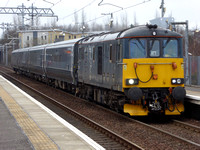
|
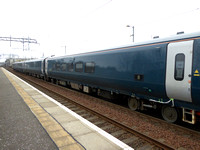
|
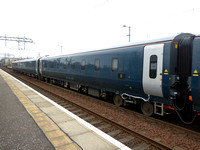
|
| 73971 | 15001 | 15302 |
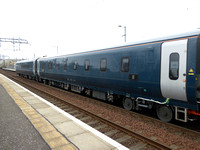
|

|
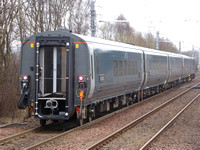
|
| 15301 | 15002 | rear of 15002 |
2018 could potentially be the final year in service for the class 314's in and around Glasgow (depending on whether the issues with the class 385's that are supposed to be replacing them are resolved). The 16 strong fleet have gave excellent service over the past almost 40 years. They initially worked on the Argyle line from 1979 until 1999, when they transferred over to the Cathcart Circle as well as some journeys on the Gourock and Wymess Bay services. Today all 16 units are still in service with 7 in the Saltire livery and the remainder (9) in the SPT Carmine and Cream livery.
SPT Carmine and Cream livery: 314201, 202, 205, 206, 207, 210, 213, 215 and 216
Scotrail Saltire livery: 314203, 204, 208, 209, 211, 212 and 214
I've had some journeys on them this week both on the Cathcart Circle and out to Gourock, they are listed below.
- 4.4.18 314212 on 10.20 Newton - Glasgow Central via Maxwell Park
- 4.4.18 314201 on 10.55 Glasgow Central - Gourock (as far as Paisley Gilmour Street)
- 6.4.18 314206 on 11.20 Newton - Glasgow Central via Maxwell Park
- 6.4.18 314209 on 11.55 Glasgow Central - Gourock
- 6.4.18 314209 on 12.54 Gourock - Glasgow Central
- 6.4.18 314206 on 13.45 Glasgow Central - Newton
Over this week, the Shotts line is closed for engineering works, meaning that the freight and the Fife Circle ECS workings that usually runs on that line is diverted via Wishaw, Carstairs and the Cobbinshaw line towards Edinburgh. Also on this day, I visited Dalmeny to catch some of the Scotrail HST sets out on Driver Training moves.
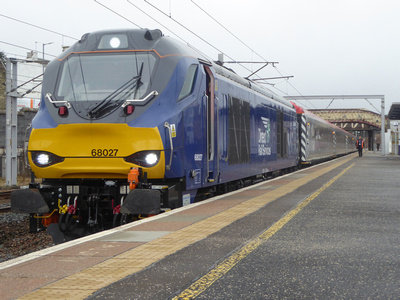 An extremely busy 30 minutes at Carstairs today threw up a couple of interesting workings, mainly the Network Rail PLPR train and a DRS driver training run featuring top and tail 68's and a set of Mark 3 'Pretendilinos'
An extremely busy 30 minutes at Carstairs today threw up a couple of interesting workings, mainly the Network Rail PLPR train and a DRS driver training run featuring top and tail 68's and a set of Mark 3 'Pretendilinos'
Colas liveried 67023 top and tailed with 67027 pass through Carstairs with 1Q18 Derby RTC-Edinburgh Network Rail PLPR test train 27.3.18
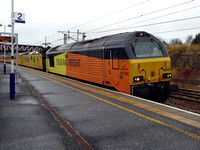
|
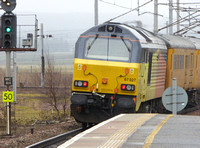
|
380106 waits at Carstairs with 1K81 Edinburgh Waverley - Ayr via Glasgow Central 27.3.18
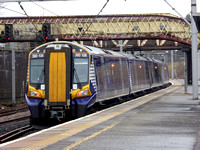
|
68022 top and tailed with 68027 and 4x 'Pretendilino' Mark 3's approach platform 1 at Carstairs with 5Z68 Crewe C.S. - Carstairs driver training run 27.3.18
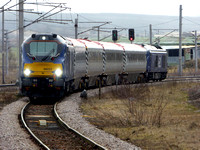
|
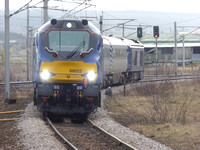
|
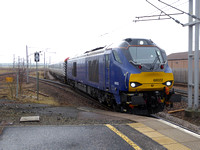
|
390011 passes through Carstairs with 1M13 Glasgow Central - London Euston 27.3.18
1
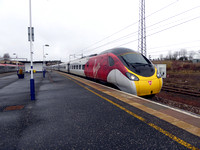
|
88001 approaches Carstairs with 4S43 Daventry - Mossend Containers 27.3.18
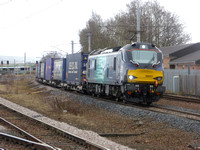
|
68027 top and tailed with 68022 and 4x 'Pretendilino' Mark 3's prepare to depart from platform 1 at Carstairs with 5Z69 Carstairs - Crewe C.S. driver training run 27.3.18
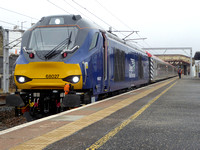
|
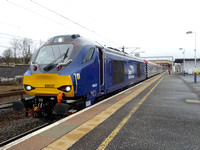
|
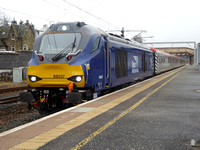
|
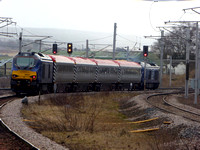
|
60076 passes through Hartwood with 6B34 Viewpark - Oxwellmains Cement 27.3.18
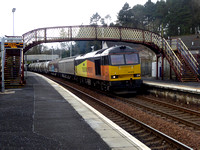
|
On Friday, I caught the northbound working involving the pair of 2 tone green 47's heading to Kingussie, today I caught the southbound working at Carstairs and at Float Viaduct.
British Railways 2 toned Green liveried 47805 (D1935) and 47501 (D1944) are held at the signal on Platform 2 at Carstairs with 1Z56 Kingussie - Crewe railtour
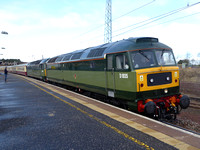
|
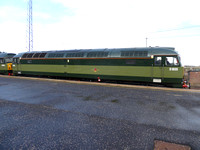
|
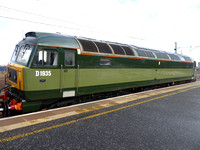
|

|
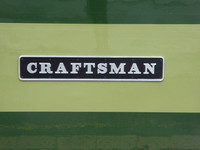
|
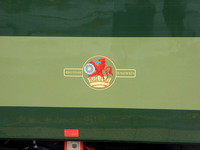
|
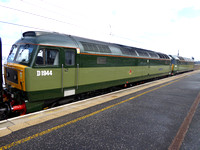
|
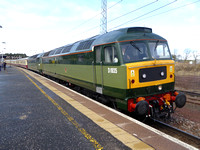
|
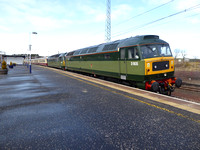
|
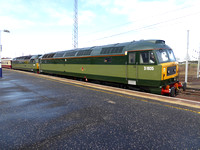
|
British Railways 2 toned Green liveried 47805 (D1935) and 47501 (D1944) cross over the River Clyde south of Carstairs with 1Z56 Kingussie - Crewe railtour
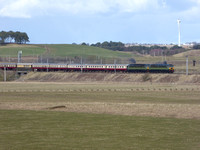
|
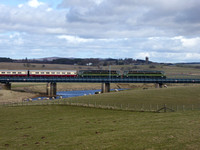
|
In the middle of a snow shower, 60021 approaches Camelon with 6S36 Dalston - Grangemouth tanks
170396 pauses at Camelon with 2P38 Dunblane - Edinburgh Waverley
66302 passes through Camelon with 4A13 Grangemouth - Aberdeen containers
156434 pauses at Camelon with 2J66 Glasgow Queen Street - Falkirk Grahamston
Larbert
170456 approaches Larbert with 2P86 Dunblane - Edinburgh Waverley
170427 prepares to depart Larbert with 2N51 Glasgow Queen Street - Dunblane
37099 top and tailed with 37421 pass through Larbert with 1Q77 Mossend - Inverness Network Rail test train
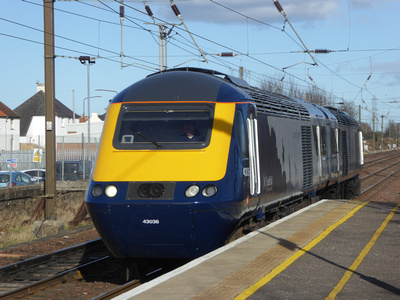 Today, the second pair of Scotrail liveried Class 43's headed north to Craigentinny. The Dark Blue fronted locos with white sides containing some of the landmarks of the bigger cities from around Scotland passed through Prestonpans around 3.30pm this afternoon.
Today, the second pair of Scotrail liveried Class 43's headed north to Craigentinny. The Dark Blue fronted locos with white sides containing some of the landmarks of the bigger cities from around Scotland passed through Prestonpans around 3.30pm this afternoon.
43033 and 43148 were the first pair up arriving last month, the latest pair, 43036 and 43134 are seen passing through Prestonpans with 0S04 Loughborough Brush - Craigentinny light engine move.
I visited the Riverside Museum in Glasgow to see the Glasgow Trams and the old Subway vehicles that were on display.
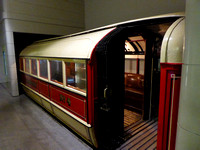
|
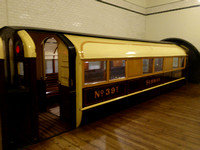
|
| Subway Car 4 | Subway Trailer 39 |
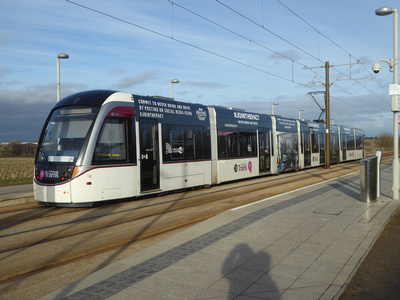 The adverts keep on coming for Edinburgh's CAF Urbos 3 trams with 257 and 273 both receiving adverts in the past week for Johnnie Walker's (Diageo) Don't drink and drive campaign.
The adverts keep on coming for Edinburgh's CAF Urbos 3 trams with 257 and 273 both receiving adverts in the past week for Johnnie Walker's (Diageo) Don't drink and drive campaign.
Both adverts are identical and are in the usual style of Edinburgh adverts with the full section 3 and 5 covered and the other sections having the area above the windows covered.
Both trams are expected to retain the adverts until the end of April. With 257 and 273 receiving their adverts, there is now only 5 of the fleet of 27 trams still in fleet livery: 254, 256, 264, 265 and 268.
In service today was: 252, 253, 255, 257, 258, 261, 264, 267, 273, 274, 275
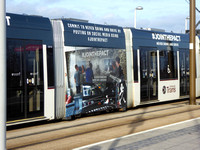
|

|
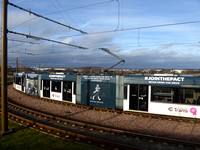
|
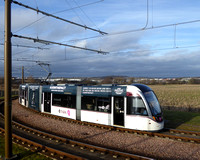
|
| 257 | 257 | 257 | 257 |

|
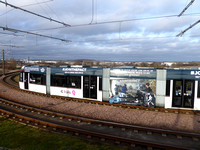
|
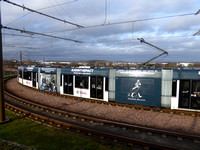
|
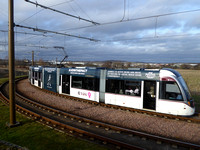
|
| 273 | 273 | 273 | 273 |
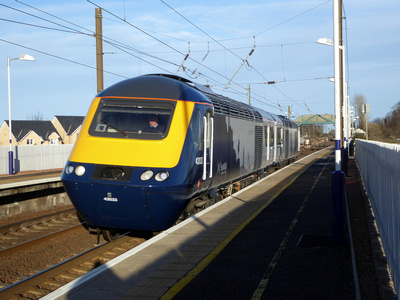 Today, the first pair of Scotrail liveried Class 43's headed north to Craigentinny. The Dark Blue fronted locos with white sides containing some of the landmarks of the bigger cities from around Scotland passed through Prestonpans around 3.30pm this afternoon.
Today, the first pair of Scotrail liveried Class 43's headed north to Craigentinny. The Dark Blue fronted locos with white sides containing some of the landmarks of the bigger cities from around Scotland passed through Prestonpans around 3.30pm this afternoon.
43033 and 43148 are seen passing through Prestonpans with 0S04 Loughborough Brush - Craigentinny light engine move.
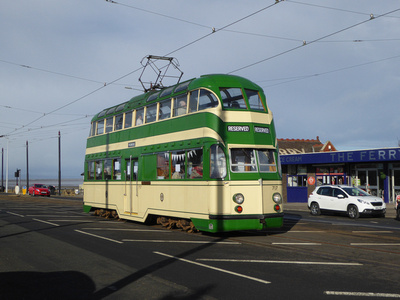 I was in Blackpool for the February holiday weekend and the heritage tram service was in operation. The blue timetable, which operates between Pleasure Beach and North Pier with 4 journeys to Cabin.
I was in Blackpool for the February holiday weekend and the heritage tram service was in operation. The blue timetable, which operates between Pleasure Beach and North Pier with 4 journeys to Cabin.
On Saturday, the service began with Balloon 717 and Ex Towing Railcoach 680 (I think), it was swapped over for Brush Car 630 after 1 journey. 717 was on route A (first 2 workings to Cabin of the day) and 630 was on Route B (last 2 Cabin workings).
680 was later seen stabled in front of the electrical compound at Rigby Road depot. Centenary car 642 was also spotted on the depot fan complete with a pair of newly repainted trucks. Also prominent at the front of the depot was Balloon 711, complete with snowploughs.
It was heat free Sunday as it was absolutely freezing out on the Prom and both trams in service didn't have heaters! However this was more than made up for by Balloon 715 (route B) being one of the trams! The other was Brush Car 631(Route A) (which had its heaters removed when it had its swingover seats retrofitted). Balloon 717 was also out, however it was working a Private Hire, which took in Fleetwood and the Pleasure Beach.
Monday saw a return to heater fitted trams with Brush Car 630 on Route A and Balloon 717 operating on Route B. There was a depot shunt taking place with Brush Car 632 spending some time on the depot fan and Bolton 66 on Hopton Road. Over the weekend Flexities 001, 2, 3, 4, 5, 8, 9, 10, 12, 13, 14 and 15 were seen, however there was no sign of 6,7,11,16, 17 and 18.
| Day | Route A | Route B | Private Hire |
| Sat | 717 | 630 | |
| Sun | 631 | 715 | 717 |
| Mon | 630 | 717 |
photographs from the weekend can be found at: http://scottishtrains.zenfolio.com/p890382945
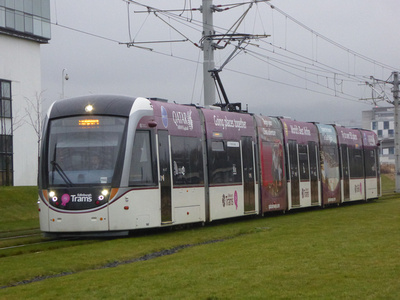 Last Saturday, Edinburgh's CAF Urbos 3 tram 271 became the latest of the Edinburgh fleet to receive an external advert. This is the first time that 271 has received an external advert.
Last Saturday, Edinburgh's CAF Urbos 3 tram 271 became the latest of the Edinburgh fleet to receive an external advert. This is the first time that 271 has received an external advert.
The advert is mainly maroon based and continues the tradition of the advert liveried tram of the advert being located along the top of the tram with sections 3 and 5 having full length adverts containing contravision.
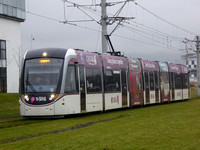
|

|
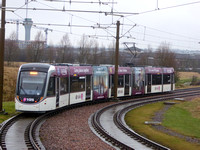
|
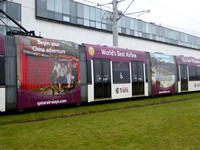
|
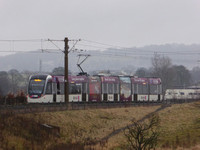
|
| 271 | 271 | 271 | 271 | 271 |
My Sightings from today
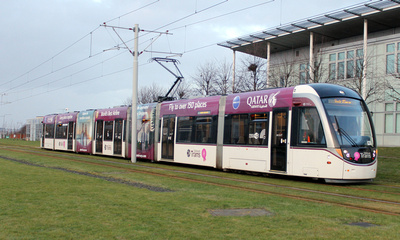 Edinburgh's CAF Urbos 3 tram 271 is the latest of the Edinburgh fleet to receive an external advert. This will be the first time that 271 has received an external advert.
Edinburgh's CAF Urbos 3 tram 271 is the latest of the Edinburgh fleet to receive an external advert. This will be the first time that 271 has received an external advert.
271 is advertising Qatar Airways and is the second company to advertise on the trams.
The advert is mainly maroon based and continues the tradition of the advert liveried tram of the advert being located along the top of the tram with sections 3 and 5 having full length adverts containing contravision.
12 trams were in service today, these were 252, 253, 255, 257, 258, 264, 267, 271, 273, 274, 275 and 277. 253 261 (not in service today) and 273 have all recently returned to service following many months stored. The fleet are cycled in and out of service on a regular basis to allow the fleet to get equal usage.
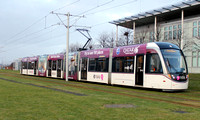
|
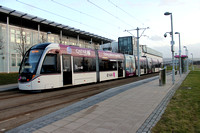
|
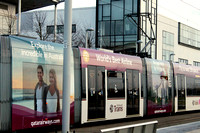
|
| 271 | 271 | 271 |
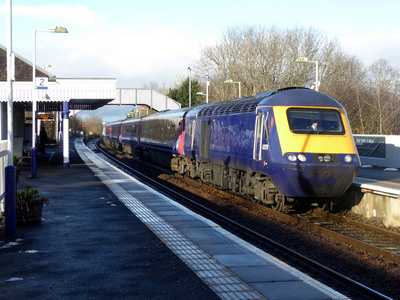 Today saw Scotrail commence driver training between Dundee and Haymarket on the former First Great Western HST's that are beginning to transfer north.
Today saw Scotrail commence driver training between Dundee and Haymarket on the former First Great Western HST's that are beginning to transfer north.
Running today were 43179 and 43126, which had both been debranded and sandwiched in between were 3x Mark 3's. I caught pass through Dalmeny whilst working 2W24 Dundee - Haymarket training run. The HST's will be entering service with Scotrail later in the year.
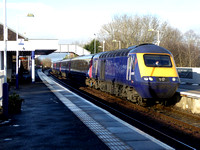
|
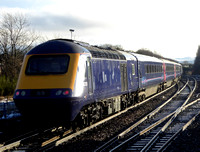
|
| 43179 | 43126 |
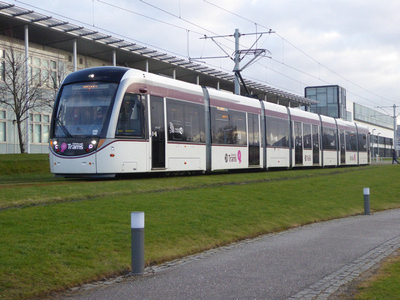 An hour at Edinburgh Park Central this afternoon allowed all 12 trams on todays 7 minute service to be viewed and photographed.
An hour at Edinburgh Park Central this afternoon allowed all 12 trams on todays 7 minute service to be viewed and photographed.
In service today were trams: 255, 274, 265, 267, 258, 277, 252, 270, 269, 275, 257 and 271 (9 in CR Smith adverts and 3 in fleet livery).
Figures released have indicated a 19% increase in passenger numbers during 2017 with 6.6 million passenger journeys, up 1 million on the previous year.
There are also trials underway to double the frequency during peak times.
Also noted today was that no 271 had stickers added to the windows next to 2nd and central sections indicating priority seating.

|

|

|

|
| 255 | 274 | 265 | 267 |

|

|

|

|
| 258 | 277 | 252 | 270 |

|

|

|

|
| 269 | 275 | 271 | 257 |
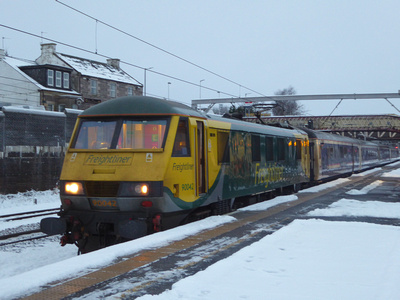 Normally the northbound Caledonian Sleeper service (1S26 from London Euston - Glasgow Central) arrives into Carstairs at 6.21am, however this morning it was running around 104 minutes late by the time it arrived at 8.19 this morning, not only meaning that it was almost daylight but also that I could see it for a change!
Normally the northbound Caledonian Sleeper service (1S26 from London Euston - Glasgow Central) arrives into Carstairs at 6.21am, however this morning it was running around 104 minutes late by the time it arrived at 8.19 this morning, not only meaning that it was almost daylight but also that I could see it for a change!
92010 brought the sleeper into platform 1 at Carstairs, where the train would be divided with the front portion continuing to Glasgow behind 92010 and the rear portion, heading to Edinburgh Waverley as 1B26 and hauled by 90042.
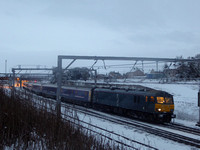
|
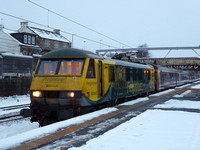
|
| 92010 | 90042 |
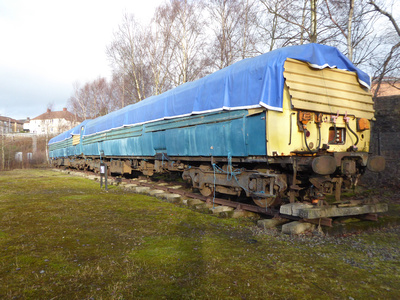 Summerlee Heritage Park in Coatbridge has Scotland's only working heritage tramline. The tramline is about 1/2 mile long and single tracked throughout. There have 4 trams:
Summerlee Heritage Park in Coatbridge has Scotland's only working heritage tramline. The tramline is about 1/2 mile long and single tracked throughout. There have 4 trams:
- Dusseldorf 392, which has a wheelchair lift and sees most use out of the fleet
- Glasgow 1017, a small single decked ex Glasgow Standard car which was formerly a double decker before being reduced to a single decker to allow it to operate on a route with a low bridge.
- Lanarkshire 53, an open topped double decker which used to run to Wishaw, Motherwell, Hamilton, Bellshill, Larkhall and Uddingston.
- Glasgow 1245, a Glasgow Coronation double decker, currently being restored
The short line heads from the main entrance round to a replica coal mine and miners row. Also at the end of the line is former Blue Train 311103, which the motor coach and one of the driving trailers from the set is on display.
- 311103 at Summerlee
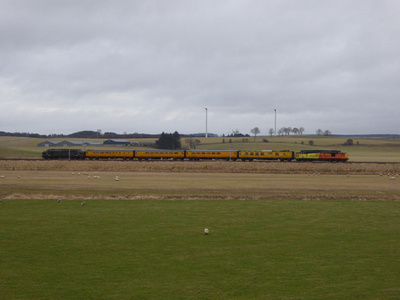 37116 top and tailed with 37057head south past Carstairs with a Mossend - Derby Test Train
37116 top and tailed with 37057head south past Carstairs with a Mossend - Derby Test Train
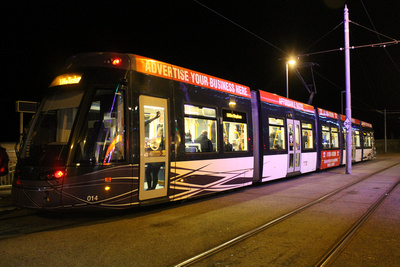 The second of 2 additional Flexity trams ordered by Blackpool Transport has arrived in Blackpool. Flexity 018 arrived at Starr Gate on the back of a low loader on Friday 15th December. Both trams have been ordered in connection with the building of the new 630 metre long extension of the tramway from North Pier to North Station of which construction began during November. The new extension is due to open at Easter 2019.
The second of 2 additional Flexity trams ordered by Blackpool Transport has arrived in Blackpool. Flexity 018 arrived at Starr Gate on the back of a low loader on Friday 15th December. Both trams have been ordered in connection with the building of the new 630 metre long extension of the tramway from North Pier to North Station of which construction began during November. The new extension is due to open at Easter 2019.
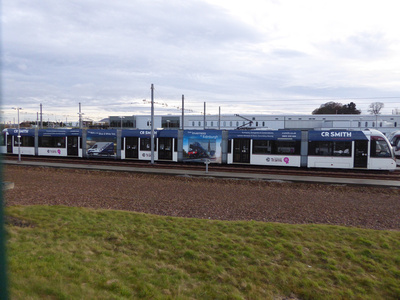 Tram 269 was outshopped in a CR Smith all over advert back in October, however it hasn't been out in service any time I have been to Edinburgh recently so I've never managed to get a photo! (The other tram, which I haven't seen for a while is 253)
Tram 269 was outshopped in a CR Smith all over advert back in October, however it hasn't been out in service any time I have been to Edinburgh recently so I've never managed to get a photo! (The other tram, which I haven't seen for a while is 253)
However today, 269 was stabled on the track nearest the fence at Gogar Depot, so I managed to get a quick photo. As usual for the Edinburgh trams and the CR Smith advertising campaign, the adverts looks fantastic.
The tram carries the standard CR Smith advert with the phrase 'From Inverness to Edinburgh' and features the Flying Scotsman and an Edinburgh Tram on Princes Street.
There are 19 trams currently carrying advertising, these are:
251, 252, 253, 255, 258, 259, 260, 261, 262, 263, 266, 267, 269, 270, 272, 274, 275, 276, 277
This leaves 254, 256, 257, 264, 265, 268, 271 and 273 advert free at the moment.
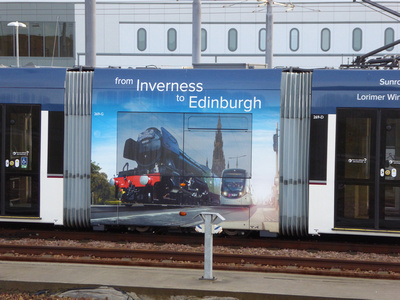
|
| 'From Inverness to Edinburgh' panel on 269 |
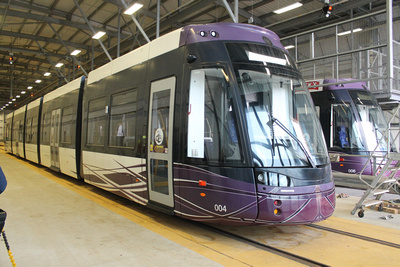 The first of 2 additional Flexity trams ordered by Blackpool Transport has arrived in Blackpool. Flexity 017 arrived at Starr Gate on the back of a low loader on Friday 1st December with 018 due to follow early in the new year. Both trams have been ordered in connection with the building of the new 630 metre long extension of the tramway from North Pier to North Station of which construction began during November. The new extension is due to open at Easter 2019.
The first of 2 additional Flexity trams ordered by Blackpool Transport has arrived in Blackpool. Flexity 017 arrived at Starr Gate on the back of a low loader on Friday 1st December with 018 due to follow early in the new year. Both trams have been ordered in connection with the building of the new 630 metre long extension of the tramway from North Pier to North Station of which construction began during November. The new extension is due to open at Easter 2019.
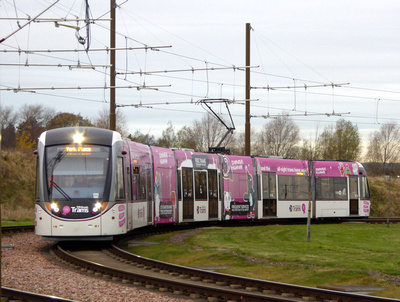 As promised a couple of weeks ago, I managed to get a few more photos of tram 276's Edinburgh's Christmas and Hogmanay advert.
As promised a couple of weeks ago, I managed to get a few more photos of tram 276's Edinburgh's Christmas and Hogmanay advert.
The advert promotes travel by tram into Edinburgh to the Edinburgh's Christmas events, which are taking place throughout December as well as travel to and from the Hogmanay celebrations on 31st December.
There will be free trams running from midnight - 5am roughly every 20 minutes between West End Princes Street and the Airport on 1st January to allow those attending the Hogmanay celebrations to make their return journeys.
If you are heading to Edinburgh to catch the tram, the Christmas advert is on the right hand side when leaving the Airport and the Hogmanay advert is on the left hand side of the tram. The artwork on the tram has been designed by local school children.
Here are a few photos of the tram at Ingliston Park and Ride on Friday 1st December.
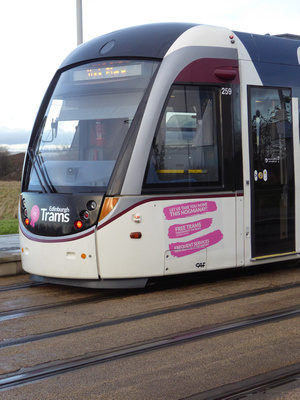 Adverts are starting to appear on Edinburgh Trams advertising their Free tram service running from Midnight - 5am between Princes Street - West End and Airport following the Hogmanay celebrations. The adverts are located underneath the cab sides.
Adverts are starting to appear on Edinburgh Trams advertising their Free tram service running from Midnight - 5am between Princes Street - West End and Airport following the Hogmanay celebrations. The adverts are located underneath the cab sides.
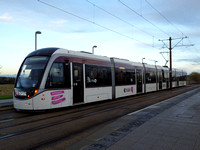
|
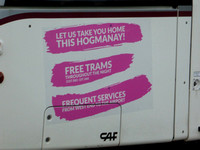
|
| 257 with its Hogmanay advert | a close up of the advert on 260 |
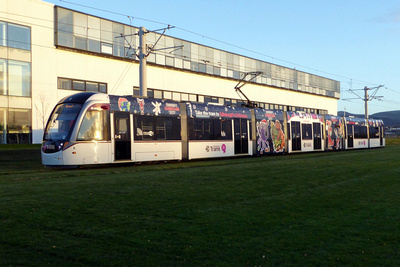 Edinburgh's CAF Urbos 3 tram number 276 has received it's first all over advert as is advertising Edinburgh's Christmas on one side of the tram and Edinburgh's Hogmanay on the other. The artwork on this tram has been designed by local school children.
Edinburgh's CAF Urbos 3 tram number 276 has received it's first all over advert as is advertising Edinburgh's Christmas on one side of the tram and Edinburgh's Hogmanay on the other. The artwork on this tram has been designed by local school children.
The Christmas advert (which is on the right hand side of the tram coming from the Airport) features a black background with some snow flakes, fairies and city skyline along the top, with the all over advert panels featuring an octopus with 8 socks on, a teddy bear hugging a Christmas Tree and what looked like a lion wearing a Santa suit with 2 other characters nearby! The advert states 'Take the Tram to Edinburgh's Christmas and back again'
The Hogmanay advert (which is on the left hand side coming from the Airport) features a pink background with gloves and woolly hats on the top and one of the other sections features an ostrich and what looks like an owl wearing scarves and woolly hats! The advert states 'Take the Tram to Edinburgh's Hogmanay and back again'. Unfortunately as it was a rushed photo as the tram only stopped for a few seconds and the light wasn't great meaning I didn't manage to get the full side in focus, however I will try and get another shot of it if its out next weekend!
The trams will be running a free service from Midnight - 5am on 1st January, running every 20 minutes from West End Princes Street - Airport, to allow people attending Edinburgh's Hogmanay to get back home.
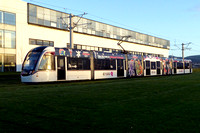
|
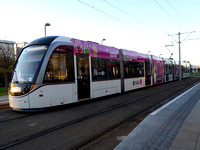
|
| 276's Edinburgh's Christmas Advert | 276's Edinburgh's Hogamanay Advert |
Holytown
68004 passes through Holytown with 5G02 Edinburgh Waverley - Motherwell TMD Fife Circle ECS move
66075 passes through Holytown with 6S58 Tees - Dalziel loaded steel
66221 passes through Holytown with 4S99 Tees - Mossend containers
Bo'ness
37067 at Bo'ness
303032 at Bo'ness
D2767 at Bo'ness
27001 at Bo'ness
37214 at Bo'ness
27001 and 82113 at Bo'ness
37261 at Bo'ness
Holytown
37605 passes through Holytown with 4Z20 Craignetinny - Motherwell TMD container flats
66430+66434 approach Holytown with 4S43 Daventry - Mossend containers
88010 passes through Holytown with 0Z48 Carlisle Kingmoor- Motherwell TMD light engine move
86604+86610 pass through Holytown with 4Z56 Preston - Coatbridge Freightliner terminal containers
RHTT unit 98905+98915 passes through Holytown with 3Z93 Slateford - Slatefort RHTT working
Camelon
68006 passes through Camelon with 5K19 Edinburgh Waverley to Motherwell TMD ECS working
Greenfaulds
66176 passes through Greenfaulds with 6D84 Aberdeen Waterloo - Mossend Nacco Silver Bullet tanks
Holytown
66564 passes through Holytown with 4S53 Daventry - Mossend containers
66524 passes through Holytown with 0Z32 Millerhill - Mossend light engine move
88002+88009 pass through Holytown with 4S43 Daventry - Mossend containers
Carstairs
66565 approaches Carstairs with 6S50 Carlisle Yard - Millerhill engineering working
66221 approaches Carstairs with 4E99 Mossend - Tees Dock containers
66524 passes through Carstairs with 6Z32 Mossend - Carlisle Yard engineering working
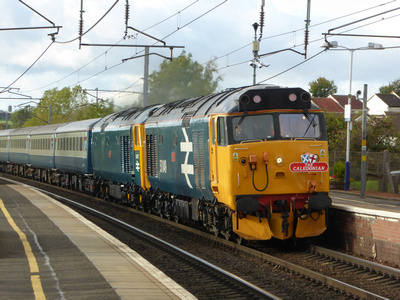 Today, there was a rare sight on the West Coast Mainline, with a pair of Class 50's operating on a railtour from London Euston - Glasgow Central and return. The class 50 (or 'Hoovers' to give them their nickname) was built between 1967 and 1968 and operated on the WCML between Glasgow and Crewe. On completion of the electrification of the WCML in in 1974, the 50's moved to South West England then services on the London - Exeter and London - Hereford services before being withdrawn in the late 80's / early 90's.
Today, there was a rare sight on the West Coast Mainline, with a pair of Class 50's operating on a railtour from London Euston - Glasgow Central and return. The class 50 (or 'Hoovers' to give them their nickname) was built between 1967 and 1968 and operated on the WCML between Glasgow and Crewe. On completion of the electrification of the WCML in in 1974, the 50's moved to South West England then services on the London - Exeter and London - Hereford services before being withdrawn in the late 80's / early 90's.
Today's working was the first time class 50's had been in Scotland since 50007 and 017 visited Bo'ness in 2015 for the Summer Diesel Gala. Unfortunately I had something else on and missed the northbound journey, but did manage to catch the southbound journey at Carluke.
The 50's operating on the railtour were:
- BR Large Logo liveried 50049
- BR Blue Liveried 50007
BR Large Logo liveried 50049 and BR Blue liveried 50007 pass through Carluke with 1Z52 Glasgow Central - London Euston Pathfinder 'The Caledonian' Railtour
Adverts 11 and 15 of 18 of the CR Smith Advertising contract have now been applied to 5 members of the tram fleet. As before, the stunning graphics that have created for each advert features a pair of iconic Scottish locations.
The latest adverts in the series sees:
- Fae Leith tae Alloway featuring featuring a domed building and a statue of Robert Burns. This advert is worn by 255.
- From Bannockburn to Dundee featuring a statue of Robert the Bruce and a statue of Desperate Dan. The advert is worn by 252
- From Turnberry to Blair Drummond featuring a bag of golf clubs and some meerkats on a mound. The advert is worn by 258.
- From Lochmaben to Dunfermilne featuring a statue of Robert the Bruce and Dunfermilne Abbey. The advert is worn by 277.
- There is also a 5th advert tram, number 253, however it was behind another tram and it's advert was only partially visible.
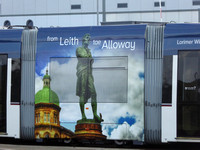
|

|

|
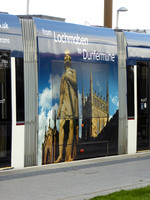
|
| 255 | 252 | 258 | 277 |
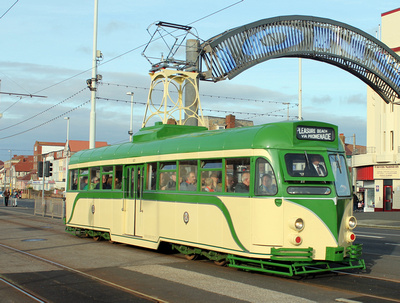 In November 2004, Brush Car 621 was mothballed along with most of her sister cars as part of a general reduction in the size of the fleet. After a period in store, 621 was purchased by the Fleetwood Heritage Transport Trust and moved into further storage at Kirkham Prison. 621 was then purchased by a group of enthusiasts and donated to Beamish Museum in Northumberland, arriving in 2014. Beamish had planned to restore the tram as 284 in the original 1930's style, however a change in policy left the tram surplus to requirements and 621 found its self heading home to Blackpool after the tram was donated back to the Blackpool Heritage Tramway Trust. 621 arrived back in Blackpool in December 2016.
In November 2004, Brush Car 621 was mothballed along with most of her sister cars as part of a general reduction in the size of the fleet. After a period in store, 621 was purchased by the Fleetwood Heritage Transport Trust and moved into further storage at Kirkham Prison. 621 was then purchased by a group of enthusiasts and donated to Beamish Museum in Northumberland, arriving in 2014. Beamish had planned to restore the tram as 284 in the original 1930's style, however a change in policy left the tram surplus to requirements and 621 found its self heading home to Blackpool after the tram was donated back to the Blackpool Heritage Tramway Trust. 621 arrived back in Blackpool in December 2016.
With the 80th Anniversary of the Brush Cars being celebrated during 2017, 'Trams Magazine' sponsored the work required to return 621 back to service in time for the 132nd anniversary weekend. Fortunately 621 was still in reasonable condition despite 13 years out of service, however it did require a re panel and some electrical work, including the fitting of a transponder. The tram was repainted into the 1950's livery and made its debut back on the prom on 22nd September. 621 performed faultlessly all weekend.
621 looks absolutely fantastic and all credit goes to the workshop team at Blackpool Heritage Tram Tours for the excellent job they have done on 621.
 I visited Blackpool for September weekend, which just so happened to co-inside with the Blackpool Tramway's 132nd Anniversary weekend. Here is my report of the weekend:
I visited Blackpool for September weekend, which just so happened to co-inside with the Blackpool Tramway's 132nd Anniversary weekend. Here is my report of the weekend:
Friday 22nd September:
The stars of the weekend were undoubtedly the Brush Cars as this year, the Brush Cars are celebrating their 80th anniversary of their entry to service.
A special service recreating the Cleveleys Flyers that this class of tram featured heavily on at various times of their lives operated on Friday afternoon and saw Brush Car 621 making its first appearance in service since 2004 after a recent overhaul and repaint into 1950's livery. Also featuring Wartime Green and Cream liveried 623, which is on loan from Heaton Park, 90's liveried and refurbished 630 on loan from Crich and 60's liveried 631, which is part of the heritage fleet.
The trams operated between 1.30 and 5.30pm between Pleasure Beach and Cleveleys on the following routes:
- A - 621
- B - 623
- C - 630
- D - 631
631 failed at Pleasure Beach with a controller fault before departure on its final journey of the day. 623 worked to Pleasure Beach and picked up 631's passengers and worked its journey.
Into the evening and out came the Illuminations tour trams. 733+734, 736, 737, 717 and 718 were out on tours operating 2 tours each. Trawler 737 was held at Bispham for a while on its 2nd tour of the night. After 20 minutes, the passengers left the tram while it reversed on the centre track and pulled onto the stop and reloaded, giving it's passengers the rare opportunity for a tour through the illuminations facing backwards!
Saturday 23rd September
Saturday was the first of the two 132nd Anniversary running days and display of rarely seen trams and depot tours. At Rigby Road depot, Balloon 701, Centenary 642 and recently returned Centenary 645 were lined up at the Fitting shop wall, whilst Brush Cars 632, 634, 631 and 627 were lined up on the depot fan. Balloon 711 was used as the shop tram at North Pier and Balloon 700 was used on the shuttle service running between Rigby Road Depot and Starr Gate Depot. Trams that were used on the heritage service during the day were: 66, 600, 621, 623, 630, 648, 680, 700, 711, 713, 715, 717, 723 and 737. 737 replaced 717, which returned to depot around 11am, presumably with a fault as 717 wasn't back out in service again over the weekend. Around noon, 621,623 and 630 were lined up one behind the other at Pleasure Beach. 723 and 713 were the last 2 heritage trams to depart Bispham around 5.30pm.
Into the evening and 733+734, 736, 737, 718 and 723 were out on Illuminations tours operating two tours each. 715 operated on a Private Hire doing a round tour of the illuminations and then working to Cabin and depot.
Sunday 24th September
Sunday was the second of the two 132nd Anniversary running days and display of rarely seen trams and depot tours. At Rigby Road depot, Brush Cars 634, 627 and 632 were lined up at the Fitting shop wall, whilst Brush Car 625, Engineering Car 754, Open topped Balloon 706 and Balloon 726 were lined up on the depot fan. Balloon 711 was used as the shop tram at North Pier and Balloon 713 was used on the shuttle service running between Rigby Road Depot and Starr Gate Depot.
The depot tour started at the depot fan and went to the Electrical Compound, passing Birkenhead 20, which was stabled just outside it. In the compound were numerous spare parts as well as Boat 230 (604) and Railcoach 679. Walking along the front of the fan, many withdrawn trams were seen including twin car 676+686, Coronation 304, Centenary 642 and Centenary 645. Next the tour went into the Paint shop and Standard 147 was on display having been partially rubbed down for a repaint. In the Body shop, Standard 143, Boat 227 (602) were stabled, 227 was receiving an internal tidy up and rewire. The body shells of Lytham 43 and Glasgow 1016 were also in the Body Shop. In the fitting shop Balloon 719 was there for a blown motor to be replaced and 703 was on display. There was various trolley towers and trucks also on display. Also visible was some of the panels removed from 621 while it was being prepared for service. After a ride down to Starr Gate depot on 713 (via the tram wash) we were then shown round Starr gate depot. 004 and 006 were at the front of the sheds in case they were required for service, whilst 013 was on the body lift where its trucks were being removed to allow it's wheels to be replaced.
Trams that were used on the heritage service during the day were: 40, 66, 600, 621, 623, 630, 631, 648, 680, 700, 711, 713, 715, 718, 723 and 737.
Into the evening and 733+734, 736, 737, 715 and 718 were out on Illuminations tours operating two tours each.
My photos from the weekend (all 247 of them!) can be found at http://scottishtrains.zenfolio.com/p123308024
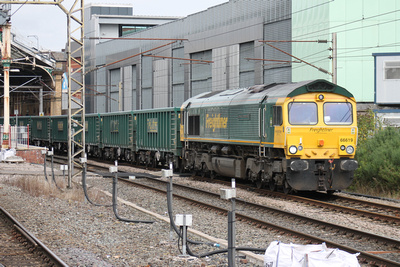 Whilst in Blackpool for the weekend, I nipped out to Preston for an hour's spotting. Here are my sightings:
Whilst in Blackpool for the weekend, I nipped out to Preston for an hour's spotting. Here are my sightings:
156486 approaches Preston with 2N97 Manchester Victoria - Blackpool North
390002 departs Preston with 9M54 Edinburgh - London Euston
319365 approaches Preston with 1N85 Liverpool South Parkway - Preston
66619 waits at Preston with 6H51 Hardendale Quarry - Guide Bridge Yard Ballast working
150xxx with 150133 on the rear depart Preston with 2T06 Blackpool North - Manchester Victoria
158758 departs Preston with 1B23 Blackpool North - York
390151 approaches Preston with 9S60 London Euston - Edinburgh Waverley, whilst 150144 also approaches with 2T62 Manchester Victoria - Blackpool North
156491 departs preston with 2E86 Blackpool North - Huddersfield
158851 approaches Preston with 1B20 York - Blackpool North whilst 153304+153378 also approach with 2N01 Ormskirk - Preston
156464+156479 arrive at Preston with 1T63 Manchester Victoria - Blackpool North
142050+150201 depart Preston with 2N14 Blackpool South - Colne
153378+153304 depart Preston with 2F02 Preston - Ormskirk
66092 approaches Preston with 4S49 Daventry - Coatbridge containers
Passing Gogar Depot earlier today, I decided to look in and see which trams were stabled there. Parked near the fence along side the road was tram 251 in its #tramspotting livery, which promotes the 7 minute service which operates during each day. I took the opportunity to get a few photos of the tram.
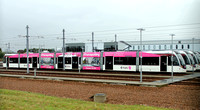
|
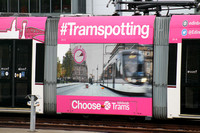
|
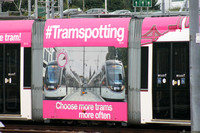
|
| Full Tram | one of the advert sections | the other advert section |
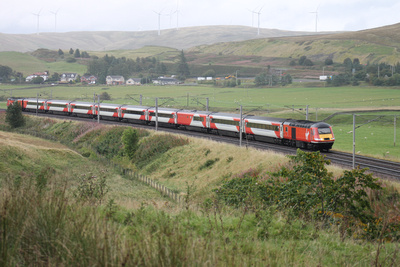 Today was day 1 of the East Coast Diverts via the Tyne Valley, Carlisle and the West Coast Main Line to Carstairs South Junction.
Today was day 1 of the East Coast Diverts via the Tyne Valley, Carlisle and the West Coast Main Line to Carstairs South Junction.
I spent a couple of hours at Crawford, 2 miles south of Abington this afternoon and Here are my sightings:
66737 heads north past Crawford with the diverted 6S45 North Blyth - Fort William Alcans
88003 heads north past Crawford with 4S43 Daventry - Mossend containers
43274 'Spirit of Sunderland' and 43308 head south through Crawford with the diverted 1E15 Aberdeen - London Kings Cross
East Midlands Trains liveried 43061 on the rear of an HST set led by 43309 pass Crawford with the diverted 1E17 Edinburgh Waverley - London Kings Cross
43317+43206 head north through Crawford with the diverted 1S09 London Kings Cross - Edinburgh
66047 passes Crawford with 4M30 Grangemouth - Daventry containers
 Adverts 9 and 10 of 18 of the CR Smith Advertising contract have now been applied to 2 members of the tram fleet. As before, the stunning graphics that have created for each advert features a pair of iconic Scottish locations.
Adverts 9 and 10 of 18 of the CR Smith Advertising contract have now been applied to 2 members of the tram fleet. As before, the stunning graphics that have created for each advert features a pair of iconic Scottish locations.
The latest adverts in the series sees:
- From Largs to Dundee featuring a Viking and Viking Longboat (Vikingar, Largs) and the SS Discovery ship from Dundee. This advert is worn by 267 and appeared in service during week beginning 11.9.17
- From Pitlochry - Meadowbank featuring a leaping salmon making its way up the river and a hurdler jumping over a wall. The advert is worn by 274 and appeared in service during week beginning 11.9.17
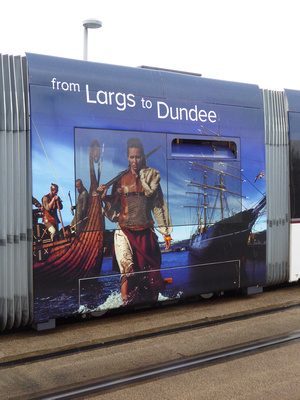
|
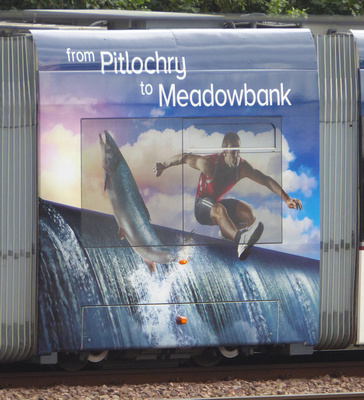
|
| 267 | 274 |
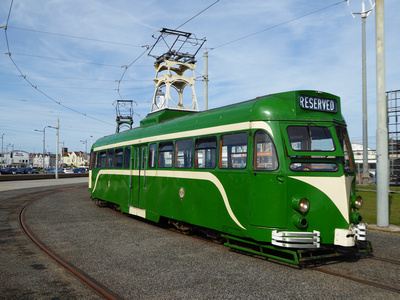 Blackpool Heritage Trams Trust have announced that as part of the 132nd anniversary weekend celebrations, that a bonus event will happen on Friday 22nd September. During the afternoon, a special timetable of 'Cleveleys Flyers', running from Pleasure Beach - Cleveleys, using 4 Brush Cars.
Blackpool Heritage Trams Trust have announced that as part of the 132nd anniversary weekend celebrations, that a bonus event will happen on Friday 22nd September. During the afternoon, a special timetable of 'Cleveleys Flyers', running from Pleasure Beach - Cleveleys, using 4 Brush Cars.
The event should see the following trams in service:
- the debut of 621, which has not run since 2004 (repainted in 50's livery)
- 623 (on loan from Heaton Park and in Wartime Livery)
- 630 (on loan from Crich Tramway Museum and in 90's livery)
- 631
Over the remainder of the weekend, all servicable heritage trams will run at some point, there are also depot tours and a display of stored trams outside the depot and on the depot fan.
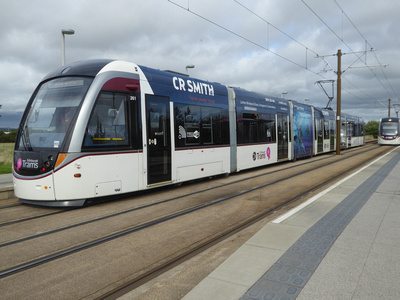 Adverts 7 and 8 of 18 of the CR Smith Advertising contract have now been applied to 2 members of the tram fleet. Like before, the stunning graphics created for each of the advert features a pair of iconic Scottish locations.
Adverts 7 and 8 of 18 of the CR Smith Advertising contract have now been applied to 2 members of the tram fleet. Like before, the stunning graphics created for each of the advert features a pair of iconic Scottish locations.
The latest adverts in the series sees:
- From Fraserburgh to Finnieston featuring a crane of the feathered variety (Fraserburgh) and the famous Finnieston crane (with the SECC in the background) on the banks of the Clyde. This advert is worn by tram 270 and appeared in service early in week beginning 4.9.17.
- From Dunblane to St Andrews featuring a Tennis player (with more than a passing resemblance to Andy Murray!) and a golfer (with more than a passing resemblance to Tiger Woods!) with a tennis net in the foreground and the old course in the background. This advert is worn by 262 and appeared in service during week beginning 4.9.17
I managed to catch both trams at Ingliston Park and Ride as well as tram 260 with the From Glasgow - Peterhead graphics (that I didn't manage to see on Sunday). I also managed to get better photos of the advert sections on trams 259, 266, 272 and 261.
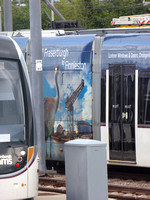
|
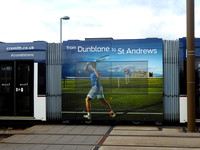
|
|
| 270 | 262 | 260 |

|
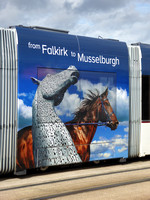
|
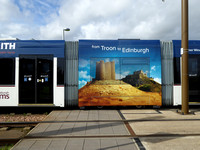
|
| 259 | 266 | 272 |
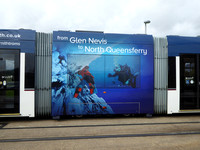
|
||
| 261 |
Also spotted at Ingliston Park and Ride stop today were the following trams:
254
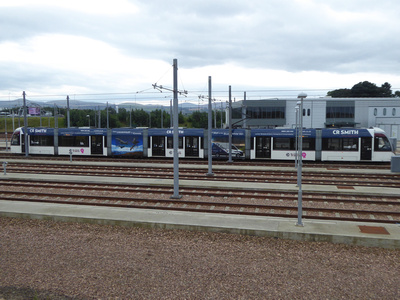 Adverts 3 -6 of CR Smith's advertising contract for 18 trams have now been applied to the Edinburgh fleet. Each advert features stunning artwork pairing iconic Scottish locations or images that reflects not only the geographical spread of CR Smith’s customer base, but also celebrates Scotland’s soul and personality.
Adverts 3 -6 of CR Smith's advertising contract for 18 trams have now been applied to the Edinburgh fleet. Each advert features stunning artwork pairing iconic Scottish locations or images that reflects not only the geographical spread of CR Smith’s customer base, but also celebrates Scotland’s soul and personality.
The latest batch sees:
- Glasgow’s cone crowned Duke of Wellington with the white and orange striped lighthouse at Peterhead (260)
- Lossiemouth's RAF fighter plane and Kinross Geese (263)
- A Mountaineer climbing Glen Nevis and a diver at North Queensferry (261)
- A sandcastle on Troon Beach and Edinburgh Castle (272)
261's advert replaces the Edinburgh Festival advert that the tram carried during late July / August. Unfortunately I didn't catch 260 but saw the other three. Here are the advert sections of the 3 trams.
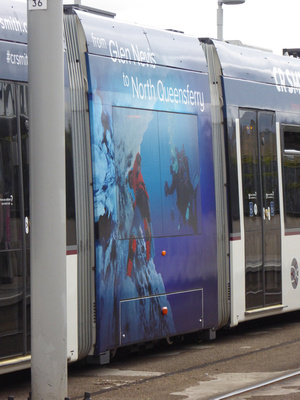
|
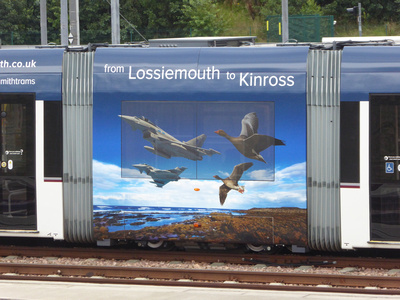
|
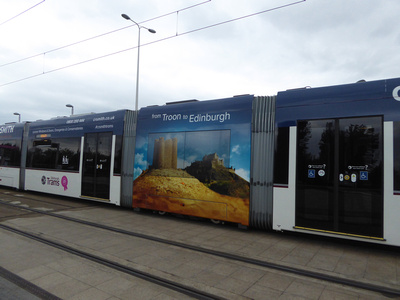
|
| 261 | 263 | 272 |
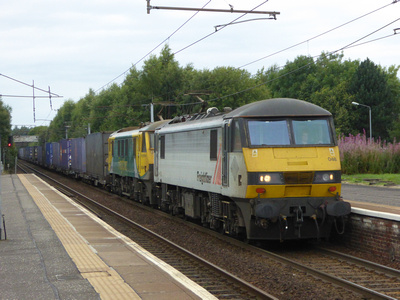 Freightliner class 90's 90048 and 90045 pass through Holytown with 4M49 Mossend - Daventry intermodal 3.9.17
Freightliner class 90's 90048 and 90045 pass through Holytown with 4M49 Mossend - Daventry intermodal 3.9.17
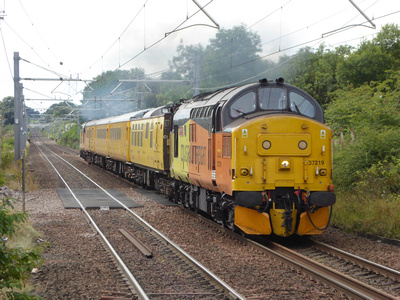 a quick visit to Greenfaulds this afternoon and 2 sightings
a quick visit to Greenfaulds this afternoon and 2 sightings
334015 departs with 2V46 Dumbarton - Cumbernauld service
Colas liveried 37219 top and tailed with 37421 are seen approaching Greenfaulds with 1Q77 Mossend - Inverness Network Rail Test Train
then on the way home, a quick stop off at Holytown for
66733 passing through with 6S45 North Blyth - Fort William Alcans
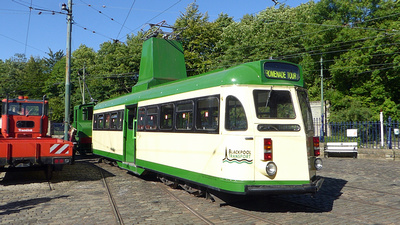 It has been announced that Brush Car 630 will be returning to the Blackpool Tramway from the National Tramway Museum at Crich on loan at some point soon. The loan deal, which will allow 630 to remain in Blackpool until 2018, means that the tram will be able to take part in the Brush Car's 80th Anniversary celebrations taking place during the September Gold Weekend on 23rd and 24th September. The deal will have an added benefit for Crich as the depot there is having its roof replaced this winter and the move will mean them having to find a place to temporarily store the tram, it will allow the tram to be stored undercover and gives Blackpool the advantage of having a heater fitted single decker to use on the heritage service.
It has been announced that Brush Car 630 will be returning to the Blackpool Tramway from the National Tramway Museum at Crich on loan at some point soon. The loan deal, which will allow 630 to remain in Blackpool until 2018, means that the tram will be able to take part in the Brush Car's 80th Anniversary celebrations taking place during the September Gold Weekend on 23rd and 24th September. The deal will have an added benefit for Crich as the depot there is having its roof replaced this winter and the move will mean them having to find a place to temporarily store the tram, it will allow the tram to be stored undercover and gives Blackpool the advantage of having a heater fitted single decker to use on the heritage service.
630, like it's 19 sister cars were built by Brush of Loughborough in 1937, entering service in the same year. Originally the inside of the Brush tramcars were considered to be the most luxurious trams ever built for British Tramways, with cushioned seating, heaters, clock and ceiling panels housing concealed lighting. The Brush Cars have been a popular and reliable member of the Blackpool fleet for 80 years and were still seen in regular service until 2004 when a number of them were mothballed, however a handful survived in service until 2011. Of the 20 trams built, 16 of them are still in existence in some form today.
630 was given a major overhaul in 1994/95 and featured low voltage lighting, trafficators, bumpers, new style lifeguards and fixed bus seats. 630 was the final Brush car to receive a major overhaul. After many years of all year round use on the tramway on both service and specials and with the end of traditional tramway in sight, 630 was withdrawn from service in October 2011, just one week before the end for the traditional fleet. 630 was repainted into the 1990's livery carried when it first re-entered service in 1995 in preparation for its move to Crich. 630 entered service at Crich in 2012 and has seen use there ever since. 630's return to Blackpool will see all 4 of the active (or will be by September) Brush Cars (621, 623, 630 and 631) in service at the Gold Weekend, with a further 5 (624, 625, 627, 632 and 634) probably on display at the depot over that Gold Weekend.
Further information on the Brush Cars can be found at my Blackpool Trams website http://blackpool-trams.yolasite.com/brush-trams.php
| Original Number | Post 1968 Number | Status | Notes |
| 284 | 621 | Being overhauled | Expected to return to service in September 2017 with the heritage fleet. |
| 285 | 622 | Static classroom | Static Classroom at Anchorsholme Primary School |
| 286 | 623 | Heritage Fleet | On loan from Heaton Park until November 2017 |
| 287 | 624 | Stored | Former engineering car 259, stored awaiting restoration to 1937 condition as 287 |
| 288 | 625 | Stored | Stored at Rigby Road on behalf of a private individual |
| 289 | 626 | Stored | In store at Pacific Road, Birkenhead |
| 290 | 627 | Stored | Stored at Rigby Road on behalf of Fleetwood Heritage Leisure Trust |
| 291 | 628 | Stored | Body scrapped in 1968, used as a flat wagon and rail crane. Numbered 260 |
| 292 | 629 | Scrapped | |
| 293 | 630 | In Service (Crich) | Currently based at the National Tramway Museum Crich, going on loan to Blackpool until 2018. |
| 294 | 631 | Heritage Fleet | In service with the Heritage Fleet |
| 295 | 632 | Stored | Stored awaiting an overhaul |
| 296 | 633 | Heritage Fleet | rebuilt in 2001 as Illuminated Fishermans Friend Trawler. Renumbered 737. |
| 297 | 634 | Stored | Stored awaiting overhaul |
| 298 | 635 | Stored Clay Cross | In store at Clay Cross (National Tramway Museum), restoration part complete |
| 299 | 636 | Test Tram | Used for testing at SET Derby |
| 300 | 637 | Stored | Stored at Fleetwood Docks |
| 301 | scrapped | ||
| 302 | 638 | scrapped | received an experimental conversion to one person operation, was later converted back to a conventional tram, scrapped 1984. |
| 303 | scrapped | was used as part of an experiment with VAMBAC controls. Scrapped 1963. |
 Black 5 44871 is seen stabled at Bo'ness
Black 5 44871 is seen stabled at Bo'ness
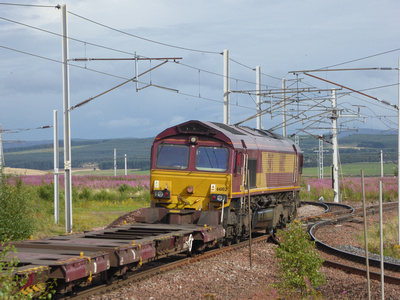 380112 arrives at Carstairs with 1D59 Edinburgh Waverley - Glasgow Central
380112 arrives at Carstairs with 1D59 Edinburgh Waverley - Glasgow Central
3250xx+0xx+014 head south through Carstairs with 1M44 Shieldmuir - Warrington Royal Mail Train
66303+66421 waits in the down goods loop at Carstairs with 6Z18 Carlisle Yard - Mossend engineering working
66102 leaves Carstairs with 4E99 Mossend - Tees Dock Containers
 Black 5 number 44871 stopped off in the Down Goods Loop at Carstairs this afternoon. The loco and its support coach had stopped to take on water whilst working on 5Z78 Carnforth - Bo'ness loco and support coach move. Arriving 15 minutes early, the loco was filled up with water before departing 1 minute early.
Black 5 number 44871 stopped off in the Down Goods Loop at Carstairs this afternoon. The loco and its support coach had stopped to take on water whilst working on 5Z78 Carnforth - Bo'ness loco and support coach move. Arriving 15 minutes early, the loco was filled up with water before departing 1 minute early.
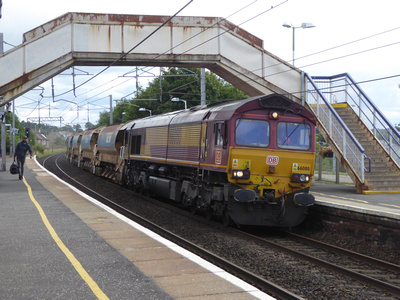 66080 passes through Carluke with 6K14 Millerhill - Kilmarnock engineering working
66080 passes through Carluke with 6K14 Millerhill - Kilmarnock engineering working
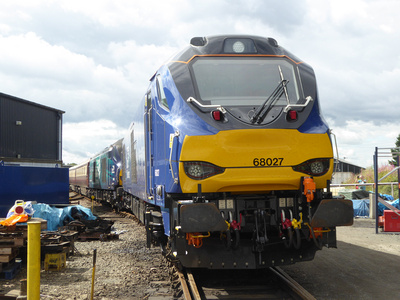 12th August saw 68027 and 68003 reach Bo'ness to become the first of the class to visit the heritage line. They were stabled here for the day as they are required for the Northern Belle, however today 37602 and 37609 took the tour to Oban and back so both locos had an off day! Both locos were seen stabled in the yard at Bo'ness.
12th August saw 68027 and 68003 reach Bo'ness to become the first of the class to visit the heritage line. They were stabled here for the day as they are required for the Northern Belle, however today 37602 and 37609 took the tour to Oban and back so both locos had an off day! Both locos were seen stabled in the yard at Bo'ness.
I had a quick visit to Bo'ness this afternoon and saw a line up of class 37's in the Diesel Yard!
One of Bo'ness' resident 37's 37261 was parked outside of the Diesel shed with DRS 37's 37602+37609, which are up to work the Northern Belle from Edinburgh - Oban tomorrow and West Coast's 37685.
Also seen was 27005, which was stabled in the display shed in between restoration work being carried out on it.
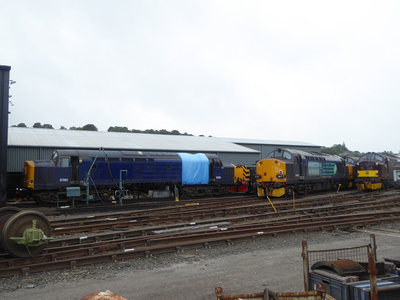
|
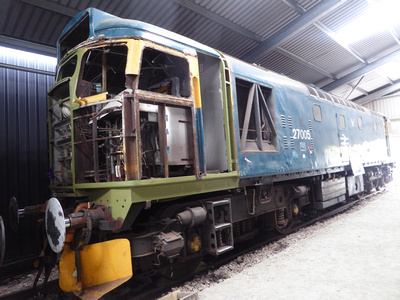
|
| 37261, 37602, 37609 and 37685 at Bo'ness | 27005 in the display shed at Bo'ness in a lul in work to its restoration |
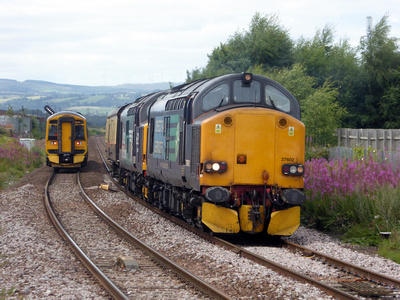 On Saturday the Northern Belle is visiting Oban. Due to Route Availability, traction that can be used on the Oban line is limited so a pair of 37s are required. In connection with this working, 37602 and 37609 complete with a support coach, worked as 5Z37 from Carlisle Kingmoor to Bo'ness.
On Saturday the Northern Belle is visiting Oban. Due to Route Availability, traction that can be used on the Oban line is limited so a pair of 37s are required. In connection with this working, 37602 and 37609 complete with a support coach, worked as 5Z37 from Carlisle Kingmoor to Bo'ness.
37602+37609 were seen today approaching Camelon on 5Z37 Carlisle Kingmoor - Bo'ness
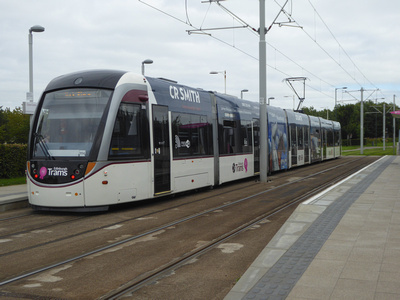 I decided to pop back to Edinburgh and try and get a photo of Edinburgh CAF Urbos 3 tram 266 in its new advert livery, having missed it yesterday and I wasn't disappointed!
I decided to pop back to Edinburgh and try and get a photo of Edinburgh CAF Urbos 3 tram 266 in its new advert livery, having missed it yesterday and I wasn't disappointed!
266's advert for CR Smith features a CR Smith van on one of the wheel sections with a Musselburgh Racehorse and Falkirk Kelpie on the other wheel section.
The advert looks stunning and is very well designed.
Trams 259 and 266 are the first of 18 trams that will carry CR Smith adverts and it is expected that the 3rd advert liveried tram, which will feature the Orange and White striped lighthouse at Peterhead and Glasgow's Duke of Wellington statue complete with traffic cone and is expected out soon.
When the 18 trams are complete, there will be 20 trams in advertising livery, with 251 wearing the #tramspotting advert and 261 wearing the Edinburgh Festival advert, although this will probably be changed for another in house advert once the Festival is over at the end of the month.
Some of the detail of 266's advert
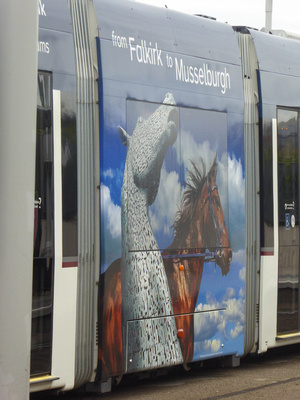
|
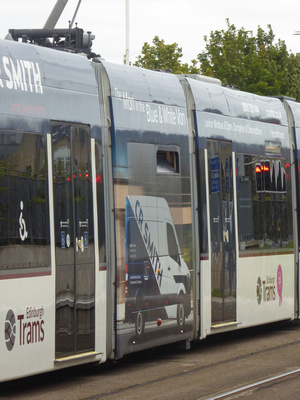
|
| Kelpie and Racehorse on one of the Wheel Sections | CRSmith Van on the other wheel section |
A closer look at 261's advert
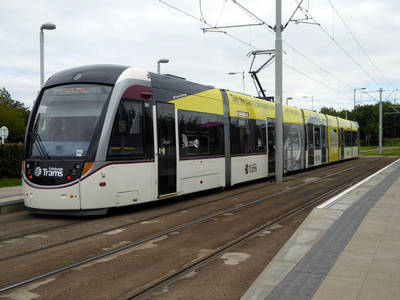
|

|
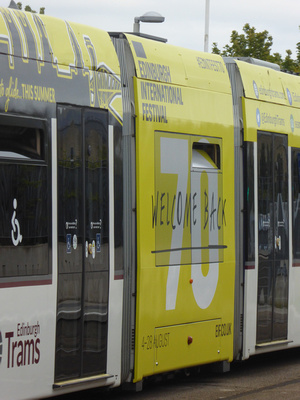
|
| 261's Edinburgh Festival Advert | All Night Trams every Saturday during August panel | 70th Anniversary pane |
 Following on from the Edinburgh Festival advert tram a further 2 trams have appeared in advert liveries, both being launched today. Edinburgh Tram and CR Smith have signed a 2 year deal for CR Smith to advertise on an incredible 18 out of the 27 strong fleet!
Following on from the Edinburgh Festival advert tram a further 2 trams have appeared in advert liveries, both being launched today. Edinburgh Tram and CR Smith have signed a 2 year deal for CR Smith to advertise on an incredible 18 out of the 27 strong fleet!
On 9th August, the first 2 adverts were unveiled featuring stunning artwork pairing iconic Scottish locations or images that reflects not only the geographical spread of CR Smith’s customer base, but also celebrates Scotland’s soul and personality.
The first designs revealed include:
- a Musselburgh racehorse racing alongside a Falkirk Kelpie (carried by 266)
- the oldest stone bridge in the highlands at Carrbridge, arching over the Forth Rail Bridge (carried by 259, see photo on right)
- Glasgow’s cone crowned Duke of Wellington with the white and orange striped lighthouse at Peterhead (still to be unveiled).
It should be an interesting time for the Edinburgh Tramway with as many new advert liveries appearing in the next few weeks, talk of a 3 minute service during morning and afternoon peaks and with thoughts also turning to extending the tramway to Newhaven.
Detail of 259's new advert livery
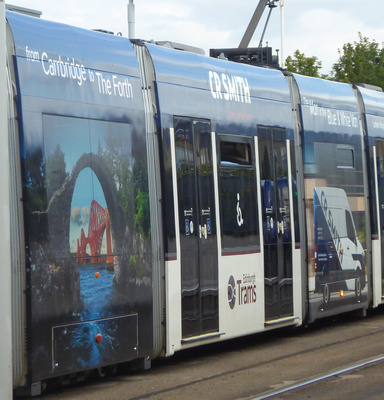
251 in Tramspotting livery at Gogar Depot
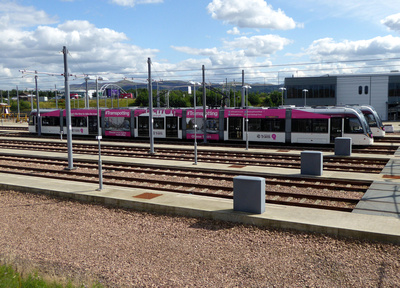
Detail on 251's Tramspotting Livery
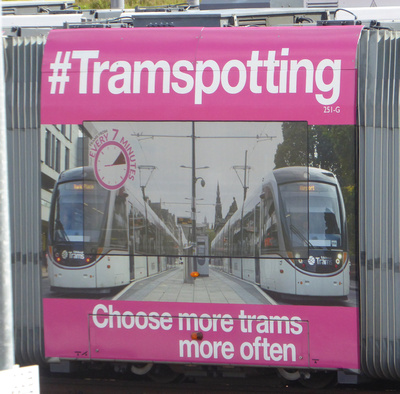
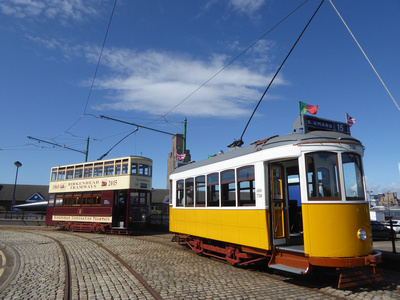 I spent an enjoyable couple of hours on the Birkenhead Tramway on Friday 4th August. It was my first visit to the line and I was very impressed. After getting off the ferry at Woodside, Lisbon 730 and Hong Kong 70 were waiting at the terminus. Lisbon 730 was the service car, whilst Hong Kong 70 was out on Driver Training and was running just in front of the service car.
I spent an enjoyable couple of hours on the Birkenhead Tramway on Friday 4th August. It was my first visit to the line and I was very impressed. After getting off the ferry at Woodside, Lisbon 730 and Hong Kong 70 were waiting at the terminus. Lisbon 730 was the service car, whilst Hong Kong 70 was out on Driver Training and was running just in front of the service car.
Hong Kong (Birkenhead) 70 was built in Hong Kong (to the same style as the famous Hong Kong double deckers) in 1992 along with sister car 69, which was in Taylor Street depot. Both trams were delivered to and used occasionally on the Blackpool tramway until 1994 until the Birkenhead line was ready for testing.
Lisbon 730 was built in 1930 and spent many years operating on its native system before it was acquired for further use at the Seaton Tramway. However this didn't happen and eventually after a period in store, 730 ended up at Birkenhead in 2004, where it was restored (and reguaged from 2ft 11 7/16 inches to standard gauge), returning to service in 2006.
After a short 5 minute journey to the Wirral Transport Museum, both trams waited before heading back to Woodside.
Inside the museum were 4 tramcars, these were:
Warrington 28: A 4-wheel G F Milnes car. This was originally car 2, which was withdrawn in the 1930s, and was used as a shelter on a bowling green at Cuddington until 1977. It was based at St Helen's Bus Garage till 2004. Merseyside Tramway Preservation Society began to procure parts to help with it's preservation. The preservation will include a covered top deck with open balconies. Number 2 did not run in this form but number 8 did so the tram will be numbered 28 when complete.
Liverpool Baby Grand 245: 245 moved to Birkenhead in 2006 and restoration started in 2010. After 4 years of Hard work, 245 was completed and ready to grace the rails once more.
Liverpool Corporation Tramways 'English Electric' fully enclosed 8-wheel bogie car No.762. After withdrawal in 1956, the lower saloon was used as a clubhouse for the Newsham Park bowling green. The remains were rescued by the MTPS in 1977, and it was restored intermittently, arriving on the tramway on 6 February 2000. It entered public service in 2001.
Wallasey Corporation Tramways 'Bellamy' Brush 4-wheel car No.78. This tram was built in 1920, although it was old-fashioned in its design, having a covered central section of the upper deck, but open balconies at each end. On closure of the Wallasey system in 1933, it was used for storage on a farm in North Wales. The farmer gave it to the MTPS in 1986, and some initial restoration work was carried out in 1987. In 1997, the society obtained some Heritage Lottery Funding to allow them to complete the restoration, and the tram entered service in August 2002.
The museum also featured many photographs and displays from all the local and now closed tramways as well as some buses, cars and motorbikes from the local area. There was also a model railway.
After visiting the museum, it was time to catch Lisbon 730 back to Woodside. Once again, Hong Kong 70 followed behind and the pair were once again stabled at the terminus.
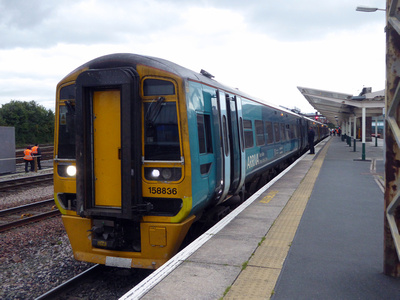 I was at Chester over the weekend, here are my sightings:
I was at Chester over the weekend, here are my sightings:
6.8.17
An unidentified pair of Arriva Class 158's and a class 153 on the rear pass Chester Racecourse with 1G26 Chester - Birmingham International
142044 seen stabled at Chester
Arriva Trains Wales liveried 158836+158837 wait at Chester prior to departure with 1G30 Chester - Birmingham International
175003 and 175010 seen stabled in the DMU sidings to the north of Chester Station
Arriva Trains Wales 175105 prepares to depart Chester with 1H88 Holyhead - Manchester Piccadilly
Colas Track Machines DR73921 and DR73922 at Chester
Mersey Travel liveried 3rd rail unit 508131 departs Chester with 2C46 Chester - Chester via Liverpool Central
7.8.17
67022 approaches Chester Racecourse with 1D34 Manchester Piccadilly - Holyhead Arriva Trains Wales Loco Hauled service
a pair of unidentified Class 221's pass Chester Racecourse with 1D83 London Euston - Holyhead
an unidentified class 158 passes Chester Racecourse with 1D12 Birmingham International - Holyhead via Chester service
On the way home, there was an unexpected stop off in Southport
507007+508126 prepare to depart Southport with 2U41 Southport - Hunts Cross
3rd rail Mersey Travel liveried 508136 and 507017 at Southport
150119 and 150218 seen at Southport
142070 at Southport
508136 and 508117 at Southport
507021 and 508117 at Southport
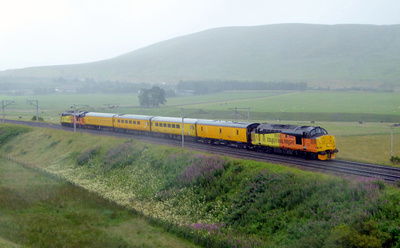 I headed out this afternoon to catch the Colas test train. My intention was to catch it at Carstairs South Junction.
I headed out this afternoon to catch the Colas test train. My intention was to catch it at Carstairs South Junction.
I headed there but as I approached, I saw 66731 heading round the curve at Carstairs East Junction.
66731 with 6S50 Carlisle Yard - Millerhill Departmental
The heavens opened shortly afterwards so I decided to head further south to Crawford to catch the Colas test train, which I did, closely followed by a 68/66 combo.
37219 top and tailed with 37421 1Q74 Carlisle Wapping - Mossend Yard via Ayr, Carstairs South Junction and Shotts
68007+66429 pass with a Carlisle Kingmoor - Motherwell TMD Light engine move
There are currently 2 adverts on the Edinburgh trams, the first is 251 with 'Tramspotting' all over advert and revynaled in the past couple of days tram 261 is wearing a vynal advertising the Edinburgh Festival. Both are seen at Ingliston Park and Ride on 28.7.17.
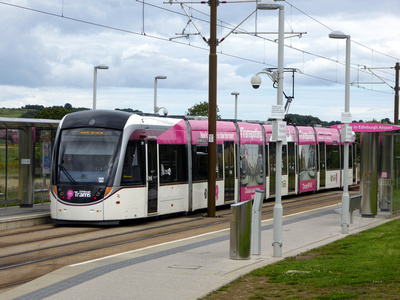 Tram 251 in 'Tramspotting' advert
Tram 251 in 'Tramspotting' advert
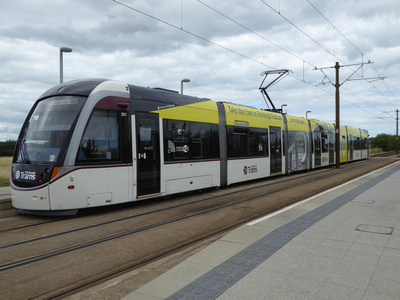 Tram 261 in Edinburgh Festival advert
Tram 261 in Edinburgh Festival advert
The other side of Tram 261's advert
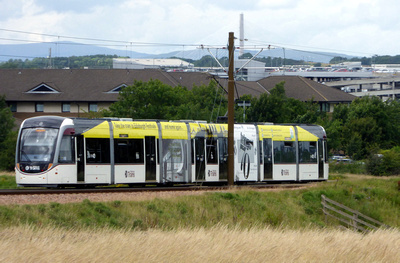
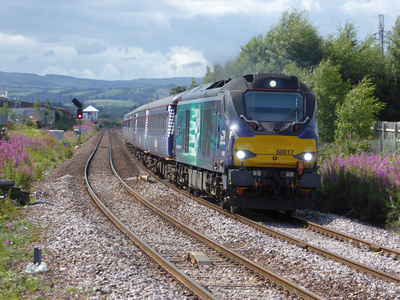 I spent a couple of hours at Camelon this afternoon, here are my sightings:
I spent a couple of hours at Camelon this afternoon, here are my sightings:
68017 approaches Camelon with 5G13 Motherwell TMD - Edinburgh Waverley Fife Circle ECS
170460 pauses at Camelon with 2P32 Dunblane - Edinburgh Waverley
158726 arrives at Camelon with 2J72 Glasgow Queen Street - Falkirk Grahamston
170456 waits at Camelon with 2P34 Dunblane - Edinburgh Waverley
158726 arrives at Camelon with 2J73 Falkirk Grahamston - Glasgow Queen Street
60095 approaches Camelon with 6R46 Prestwick - Grangemouth tanks
66135 passes through Camelon with 6M80 Grangemouth - Sinfin Sidings Aviation Fuel tanks
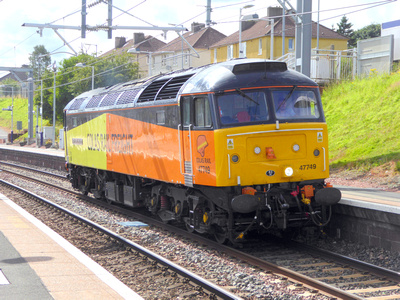 I spent 30 minutes at Bargeddie this afternoon, here is my sightings:
I spent 30 minutes at Bargeddie this afternoon, here is my sightings:
320319+320415 arrive at Bargeddie with 2R40 Dalmuir - Whifflet
56094 passes through Bargeddie with 6R46 Prestwick - Grangemouth oil tanks
318252+320413 depart Bargeddie with 2S01 Motherwell - Dalmuir
Colas liveried 47749 passes through Bargeddie with 0Z47 Polmadie - Mossend light engine move
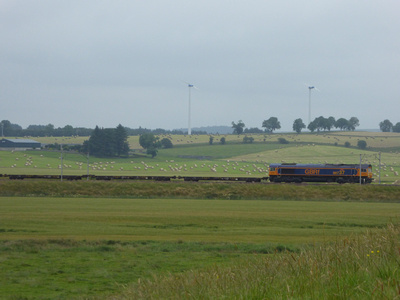 An unexpected early finish led to an afternoon of spotting!
An unexpected early finish led to an afternoon of spotting!
I wasnt expecting to get out spotting today but an unexpected early finish at work meant an afternoon out!
First I headed to Carstairs for 66737 with 4 flats heading south with 6M63 Glen Douglas MOD - Carlisle Yard wagon move
then went to Greenfaulds and saw the following:
68017 with 5G13 Motherwell - Edinburgh Waverley Fife Circle ECS move
318257+320415 with 2F01 Cumbernauld - Dalmuir
320309 departs with 2V54 Cumbernauld - Dumbarton Central
334010 arrives with 2V56 Dumbarton Central - Cumbernauld
156496 arrives with 2J71 Falkirk Grahamston - Glasgow Queen Street
158789 arrives with 2J72 Glasgow Queen Street - Falkirk Grahamston
318253+318252 arrive at Greenfaulds with 2C02 Milngavie - Cumbernauld
60085 approaches with 6R46 Prestwick - Grangemouth oil tanks
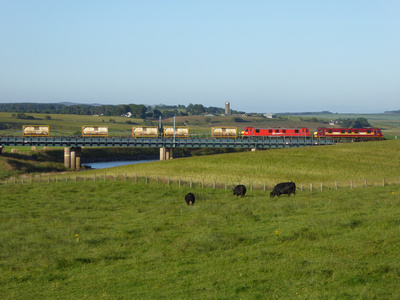 I spent 30 minutes at a gloriously sunny Carstairs and caught 3 freights in that time! Here are my sightings:
I spent 30 minutes at a gloriously sunny Carstairs and caught 3 freights in that time! Here are my sightings:
88007 heads south from Carstairs with 4M48 Mossend - Daventry containers
90039+90040 approach Float Viaduct with 6M76 Mossend to Warrington Arpley
86609+86622 approach Float Viaduct south of Carstairs with 4L81 Coatbridge - London Gateway Containers
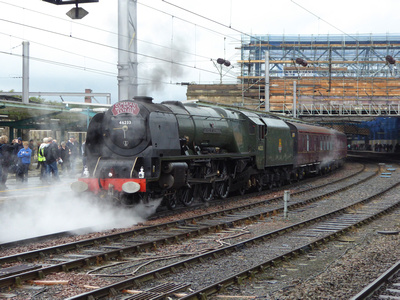 Sightings from Carlisle Station 22.7.17 2.45pm - 5.10pm
Sightings from Carlisle Station 22.7.17 2.45pm - 5.10pm
156483 arrives at Carlisle with 2C33 Lancaster - Carlisle via the Cumbrian Coast service
185153 arrives at Carlisle with 1S61 Manchester Airport - Glasgow Central service
46233 reverses into Carlisle with 5Z46 Carlisle - Carlisle loco and support coach turning move
158907 arrives at Carlisle with 2H88 Leeds - Carlisle service
156490 departs Carlisle with 2N40 Carlisle - Middlesborough service
158859 prepares to enter Carlisle with an ECS working from the siding behind platform 6
46233 prepares to depart Carlisle with 1Z34 'Cumbrian Mountain Express' railtour from Carlisle - Crewe
66096 passes through Carlisle with 4M30 Grangemouth - Daventry containers
66516 passes through Carlisle with a light engine working from Tyne Yard - Carlisle Yard
68004 prepares to depart Carlisle with the Pathfinders railtour from Carlisle - Bristol Temple Meads
156460 arrives at Carlisle with 2C37 Barrow in Furness - Carlisle
142063 arrives into Carlisle with 2N37 Newcastle - Carlisle
West Coast's 37516 passes through Carlisle with 5Z51 Fort William - Carnforth ECS working
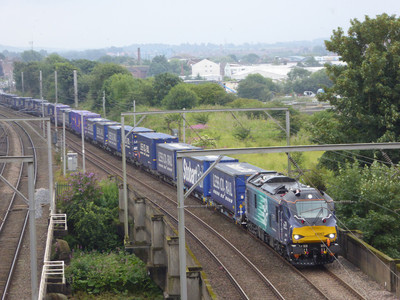 I went to Carlisle for the DRS depot open day in Carlisle. It was a great day out, even if the weather didn't play ball in the afternoon! Here are my sightings:
I went to Carlisle for the DRS depot open day in Carlisle. It was a great day out, even if the weather didn't play ball in the afternoon! Here are my sightings:
From the bridge outside Kingmoor:
- 68022 moves into the headshunt at Carlisle Kingmoor
- 88007 approaches Carlisle Kingmoor with 4S43 Daventry - Mossend containers
Once I had seen 88007 pass, I went into the depot. There was a good selection of locos on display to see throughout the depot. There was a lineup of 4 68's in 4 different liveries with 68026 in the plain blue livery, 68001 in Compass livery, 68012 in Chiltern Livery and 68006 in Scotrail livery. 66301 was also named 'Kingmoor TMD' during the afternoon.
Locos seen included:
- BR Large Logo liveried 37424 named 'Avro Vulcan XH588'
- 66301, It would later be named 'Kingmoor TMD', the name previously carried by 37688
- 88010 'Aurora'
- 68026
- 68012
- 68001
- 68006
- 20312+20302
-
 88001
88001 - 88004
- 88008
- 57312
- 88003
- 57302
- 68029
- 88006
- 37425
The heavens opened at around 1.30pm and it was torrential rain! I hung around till the naming ceremony for 66301 and then went into Carlisle Station.
 I went to Blackpool for the day on Sunday for the annual Fleetwood Transport Festival (Tram Sunday). I arrived in Blackpool at 1pm and went to North Pier for the tram to Fleetwood. There was a 20 minute Heritage service running to Ash Street as well as the regular Flexity service. Trams on the Heritage Service were:
I went to Blackpool for the day on Sunday for the annual Fleetwood Transport Festival (Tram Sunday). I arrived in Blackpool at 1pm and went to North Pier for the tram to Fleetwood. There was a 20 minute Heritage service running to Ash Street as well as the regular Flexity service. Trams on the Heritage Service were:
Route A: Brush Car 623 and Ex Towing Railcoach 680
Route B: Millennium Balloon 718
Route C: Bolton 66
Route D: Balloon 717
Route E: Balloon 715
Route F: Balloon 723
I caught Balloon 717 from North Pier to Ash Street and had a wander round the event. Stabled at Pharos Street was Fleetwood Box Car 40, B Fleet Balloon 711 and Illuminated Trawler 737. I headed back to Ash Street to catch the tram to Blackpool and just as I arrived, Brush Car 623 and Ex towing railcoach 680, which were both operating on route A arrived.
623 has recently returned to Blackpool on loan from Heaton Park Tramway in Manchester and will be in Blackpool till the end of the illuminations as part of the 80th Birthday celebrations for the Brush Cars. It required a reduced height trolley tower to allow it to fit into the depot at Heaton Park. When it returned to Blackpool a couple of weeks ago, it required an extension to the trolley tower to allow the pantograph to be able to reach the wire. 623 had last ran in Blackpool in November 2009 on the last day of service to Fleetwood before the line from Ash Street to the Ferry closed for upgrading. It moved to the Museum of Museums in Manchester along with Balloon 702 in 2010, then to Heaton Park in 2011 where it made its debut in 2012. 623 made it's debut back in Blackpool on a tour on 14th July in Wartime Green and Cream livery.
I caught 680, which ran a short distance behind 623 heading back to Pleasure Beach. At Cabin, 623 and 680 were joined by Balloon 717, which had arrived on a short working from Pleasure beach and was returning there. So from Cabin to Pleasure Beach, there was a 3 car heritage convoy made up of 623, 680 and 717, bringing back memories of the pre upgrade tramway where convoys of trams was commonplace.
Once at Pleasure Beach, the 3 trams unloaded and headed back north to the Foxhall, where they would reverse and head back to Rigby Road. Bolton 66 made an unscheduled journey to Pleasure Beach and was soon followed by Balloon 723, the last Pleasure Beach working of the day. After a trip to the Velvet Coaster for Dinner, it was time to head back to Blackpool North for the train home.
More Photos from Tram Sunday can be found at http://scottishtrains.zenfolio.com/p553573863
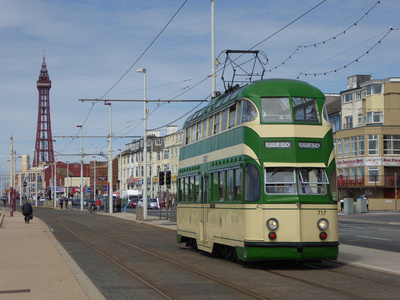 I spent a week on holiday in Blackpool and had a few journeys on the heritage trams!
I spent a week on holiday in Blackpool and had a few journeys on the heritage trams!
The following trams were out on the heritage service during the week:
- Sunday 2nd July: Balloon 715 and Balloon 717
- Monday 3rd July: Balloon 717 and Ex Towing Railcoach 680
- Tuesday 4th July: Balloon 717 and Balloon 723
- Wednesday 5th July: Boat 600 and Balloon 715
- Thursday 6th July: Bolton 66 and Boat 600
- Friday 7th July: Bolton 66 and Balloon 715
- Saturday 8th July: Boat 600 and Balloon 717
6 different trams were used on the service during the week, 66 was out twice, 600 was out 3 times as was 715. 717 was out 4 times and 723 and 680 were out only once during the week.
Balloon 717 also worked a Private Hire from the North Pier heritage siding to the Savoy Hotel near Gynn Square via Little Bispham loop on Friday 7th, while Fleetwood Box Car 40 was out on a tour from Pleasure Beach on Saturday 8th, unfortunately I was already on my way home by this point so didnt manage to get a photograph.
Of interest at Rigby Road, Brush Car 625 and Standard 143 were stabled at the front of the depot as was newly repainted Millennium Balloon 718, while Brush Car 623 was visible in the Electrical Compound.
More photographs from the week can be found at http://scottishtrains.zenfolio.com/p399815755
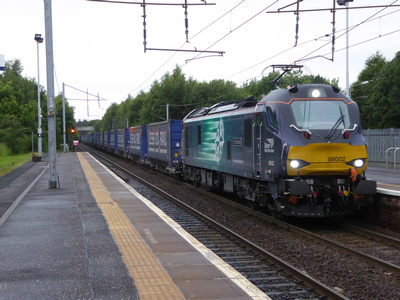 88002 passes through Holytown with 4M48 Mossend - Daventry Tesco Containers 27.6.17
88002 passes through Holytown with 4M48 Mossend - Daventry Tesco Containers 27.6.17
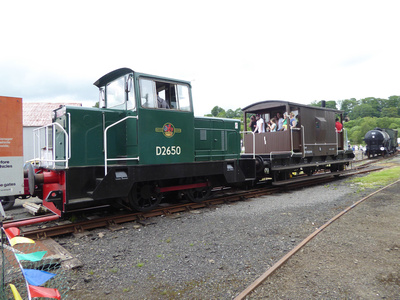 I went to the Vintage Transport festival at the Scottish Bus Museum at Lathalmond near Dunfermilne, here they have the Shed 47 railway, a short railway within the site. Based in the original Locomotive Shed at what was Royal Naval Store Depot Lathalmond, Shed47 Railway Restoration Group is actively recreating some of the vast internal railway network that existed on the site until 1971.
I went to the Vintage Transport festival at the Scottish Bus Museum at Lathalmond near Dunfermilne, here they have the Shed 47 railway, a short railway within the site. Based in the original Locomotive Shed at what was Royal Naval Store Depot Lathalmond, Shed47 Railway Restoration Group is actively recreating some of the vast internal railway network that existed on the site until 1971.
They are also in the process of building a narrow gauge railway to transport visitors through the site.
Here are a few photos from the railway:
Another Narrow Gauge Loco
Another Narrow Gauge Loco
recently repainted Hunslet MOD251
MOD 250 in fictitious BR Green livery and numbered D2650
Also in the Bus Museum is Edinburgh Horse Tram 23
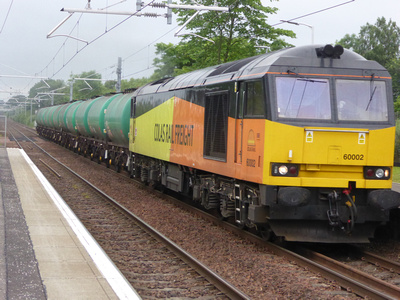 320413+318258 depart Greenfaulds with 2C38 Milngaive - Cumbernauld
320413+318258 depart Greenfaulds with 2C38 Milngaive - Cumbernauld
320308 arrives at Greenfaulds with 2V54 Dumbarton Central - Cumbernauld
68007 passes through Greenfaulds with 5G13 Motherwell TMD - Edinburgh Waverley Fife Circle ECS move
318258+320413 departs Greenfaulds with 2F01 Cumbernauld - Dalmuir
60002 passes through Greenfaulds with 6R47 Prestwick Airport - Grangemouth Tanks
334037 arrives at Greenfaulds with 2V56 Dumbarton Central - Cumbernauld
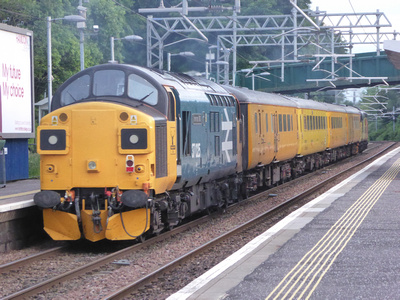 sightings tonight including an HST on an ECS working and a pair of 37's
sightings tonight including an HST on an ECS working and a pair of 37's
43320 top and tailed with 43277 approach Camelon with 5S22 Stirling - Craigentinny ECS move
318253 prepares to depart Cumbernauld with 2V47 Cumbernauld - Dumbarton Central
37421 top and tailed with 37025 at Cumbernauld with 1Q81 Mossend - Carlisle High Wapping Sidings Network Rail test train
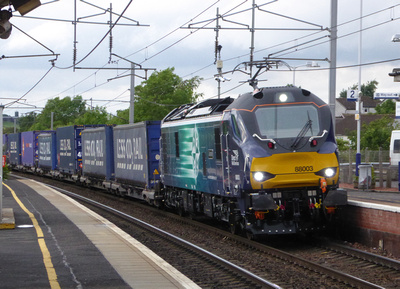 2 freights in opposite directions in 1 minute at Carluke
2 freights in opposite directions in 1 minute at Carluke
Freightliner liveried 90016+90044 passes through Carluke with 4S44 Daventry - Coatbridge containers
88003 passes through Carluke on only the 2nd day of class 88 haulage on 4M48 Mossend - Daventry Tesco containers
 68002 passes through Holytown with 0Z11 Carlisle Kingmoor - Motherwell TMD light engine move 10.6.17
68002 passes through Holytown with 0Z11 Carlisle Kingmoor - Motherwell TMD light engine move 10.6.17
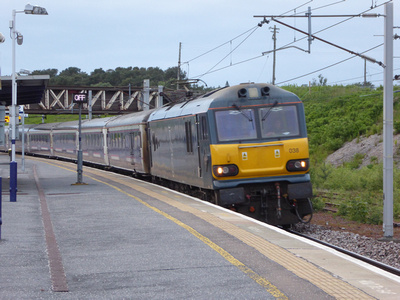 I spent a couple of hours at Carstairs, here are my sightings:
I spent a couple of hours at Carstairs, here are my sightings:
86604+86607 heads south from Carstairs with 4L81 Coatbridge - London Gateway containers
82230 on the rear of an unidentified class 91 heads north past Carstais with 1S23 London Kings Cross - Glasgow Central
60026 passes through Carstairs with 6M34 Grangemouth - Dalston tanks
92038 passes through Carstairs with 5C11 Polmadie - Edinburgh Waverley Sleeper ECS working
390042 waits at Carstairs with 5S80 Edinburgh - Polmadie ECS move
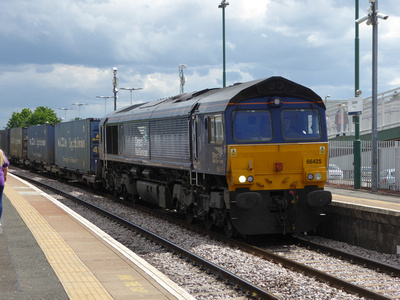 I headed to Camelon today, my intention was to catch the Dalston tanks and the Aberdeen containers. The Dalston Tanks, however were running 25 minutes early and had already passed through before I arrived! I did catch the containers though!
I headed to Camelon today, my intention was to catch the Dalston tanks and the Aberdeen containers. The Dalston Tanks, however were running 25 minutes early and had already passed through before I arrived! I did catch the containers though!
Here are my sightings:
170394 prepares to depart Camelon with 2P38 Dunblane - Edinburgh Waverley
66425 passes through Camelon with 4A13 Grangemouth - Aberdeen containers
156457, still in the First Barbie livery, departs Camelon with 2J66 Glasgow Queen Street - Falkirk Grahamston
After passing through 2 massive downpours with thunder and lightning, I stopped off at Greenfaulds and caught 318268 still in SPT livery
SPT Carmine and Cream liveried 318268 departs Greenfaulds with 2V50 Dumbarton Central - Cumbernauld
I had headed to Gartcosh to catch the Alcan tanks passing through, however another thunderstorm started with torrential rain so I just went home!
 320412 stops at Greenfaulds with 2V54 Garscadden - Cumbernauld service
320412 stops at Greenfaulds with 2V54 Garscadden - Cumbernauld service
Scotrail Saltire liveried 68007 approaches Greenfaulds with 5G13 Motherwell TMD - Edinburgh Waverley Fife Circle ECS working
One of the last few 318s remaining in Carmine and Cream livery, 318267 departs Greenfaulds with 2F01 Cumbernauld - Dalmuir service
Colas liveried 70802 working in place of the usual class 60, approaches Greenfaulds with 6N47 Prestwick - Grangemouth tankers
Scotrail Saltire liveried 68006 passes through Hartwood with 5L69 Motherwell TMD - Edinburgh Waverley Fife Circle ECS working
350407 accelerates away from Carstairs South Junction with 1M94 Edinburgh Waverley - Manchester Airport
an unidentified 390 heads north towards Carstairs with 1S87 London Euston - Glasgow Central
390040 with Virgin Radio advertising approaches Carstairs with 9S85 London Euston - Glasgow Central
92014 passes through Carstairs with 5C11 Polmadie - Edinburgh Waverley sleeper ECS working
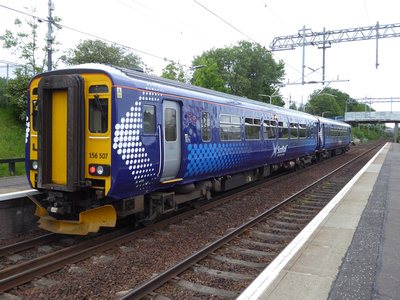 A quick visit to Greenfaulds tonight produced the following sightings:
A quick visit to Greenfaulds tonight produced the following sightings:
66107 passes through Greenfaulds with 4M30 Grangemouth - Daventry containers
Track Machine DR73915 passes through Greenfaulds with 6T44 Stirling Sidings -Abington
newly revynaled and repainted Saltire liveried 156507 at Greenfaulds with 2J82 Glasgow Queen Street - Falkirk Grahamston
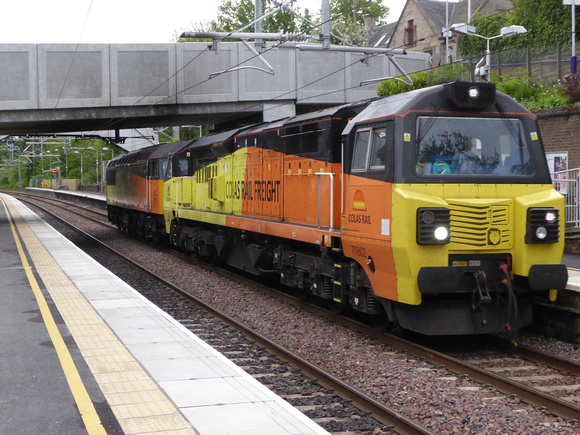 Colas liveried 70802, with 56302 in tow had been on a Driver Training Run to Oxwellmains. They are seen passing through Polmonton their return journey to Grangemouth.
Colas liveried 70802, with 56302 in tow had been on a Driver Training Run to Oxwellmains. They are seen passing through Polmonton their return journey to Grangemouth.
Colas liveried 70802 and 56302 seen with 0Z61 Oxwellmains - Grangemouth Driver training run
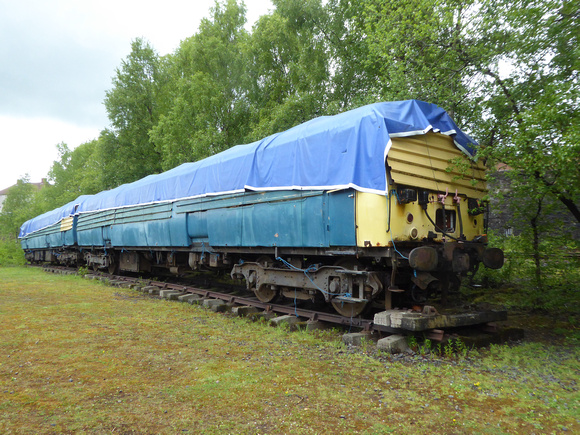 I saw the following at Summerlee:
I saw the following at Summerlee:
311103 at Summerlee
Summerlee's access tram, Dusseldorf 392 is seen passing the depot fan and heading towards the park entrance
Glasgow 1017 stabled at the rear of the tram shed
Lanarkshire 53 seen stabled in the tram depot
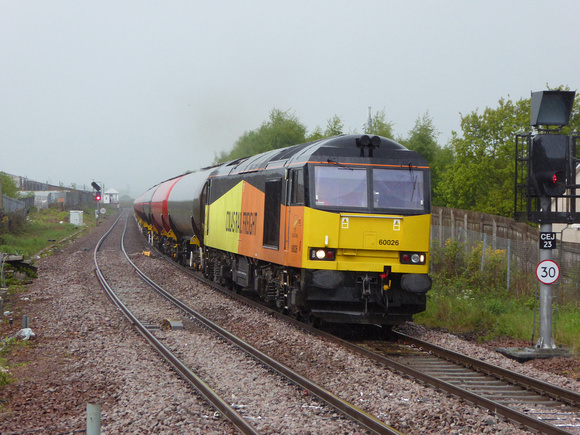 I went up to Camelon to catch 2 freights passing through and as soon as I arrived, the heavens opened!
I went up to Camelon to catch 2 freights passing through and as soon as I arrived, the heavens opened!
In torrential rain, 66425 passes through with 4A13 Grangemouth - Aberdeen Craiginches containers
156430 departs with 2J67 Glasgow Queen St - Falkirk Grahamston
60026 approaches with 6S36 Dalston - Grangemouth tanks
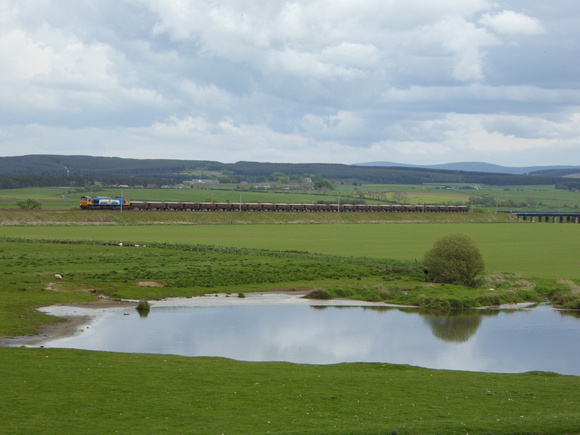 I spent an hour at Float Viaduct just to the south of Carstairs South Junction today. Here are my sightings:
I spent an hour at Float Viaduct just to the south of Carstairs South Junction today. Here are my sightings:
Old First TPE liveried 350405 leads new liveried 350404 south with 1M99 Edinburgh Waverley - Manchester Airport
350408+350402 in the New First TPE livery with 1S56 Manchester Airport - Edinburgh Waverley
An unidentified 390 approaches with 9S55 London Euston - Glasgow Central service
66709 approaches with 6S50 Carlisle Yard - Millerhill Departmental
66529 heads south with 7M69 Mossend - Carlisle Yard crane move
I spent the Bank Holiday weekend in Blackpool from 28th April - 1st May and there were plenty of heritage trams out during that time. 11 different heritage/ illuminated trams were out in service over the weekend with 3 B Fleet trams also seeing use. The only servicable trams from the heritage/B fleet not used were: 227(602) (undergoing an internal repaint), 230(604) (stored awaiting an internal repaint), 675+685 (work going on to its wiring), 718 (being repainted) and 719 (unknown).
Friday 28th
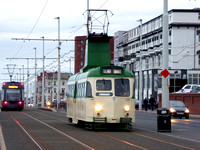
Friday wasnt originally organised as having heritage trams running, however a late change saw Brush car 631 and Balloon 701 out on Pleasure Beach - North Pier/Cabin workings from 13.40 and into the evening, a couple of runs to Cleveleys and Fleetwood.
The Photo on the right shows Brush Car 631 passing the site of the old Imperial Hotel tram stop en route from Fleetwood - North Pier on a heritage working on 28.4.17.
There was to be a 7 tram heritage service operating over the weekend instead of the usual 6 route Bank holiday service. Route G was an extra bonus working over the weekend and featured an illuminated tram on each of the 3 days. It started later on the Saturday as it was used to take the FTS group from Rigby Road to Fleetwood for their annual convention around lunchtime. Route F duties were shared between Bolton 66 and Fleetwood 40, whilst Route C was the shop tram and utilised a B Fleet balloon on each of the 3 days.
Saturday 29th
7 Heritage trams were due out on Saturday, allocated routes A-G.

A: Ex towing railcoach 680
B: Balloon 701
C: Balloon 700
D: Brush Car 631
E: Balloon 723
F: Bolton 66
G: Frigate 736
Balloon 723 had replaced Balloon 715, which had been due to work on route E. The tram was later seen parked outside the electrical compound.
Also spotted at Rigby Road was Balloon 703, which has recently returned to Blackpool from Beamish and is sporting red and cream Sunderland livery from its time masquerading as Sunderland 101. Brush Car 621, which is in the process of being prepared for a return to service in September for the Brush Car's 80th Anniversary in service, was partly visible parked at the front of the electrical compound (seen via the 60 x zoom on my camera). I didn't travel on the heritage trams on this day as I decided to take photographs instead. The photo above shows F736 and Balloon 701 stabled at Pleasure Beach in between workings on 29.4.17.
Sunday 30th
7 Heritage trams were due out on Sunday, allocated routes A-G.
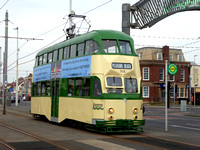
A: Brush Car 631
B: Balloon 715
C: Balloon 711
D: Balloon 723
E: Centenary 648
F: Fleetwood 40
G: The Western Train 733+734
The 7 trams ran as per the original allocations although 631 on route A and 648 on route E swapped routes during the afternoon. I managed to travel on 6 of the 7 trams during the day including a run from Cabin - Cleveleys on 648, Cleveleys - North Pier on 631, North Pier Cabin on Fleetwood 40, Cabin - Fleetwood on the top deck of 711, Fleetwood - Pleasure Beach on the Western train, Pleasure Beach - Bispham on 723. The above photo shows Balloon 715 at Bispham on a working to Pleasure Beach.
Monday 1st
7 Heritage trams were due out on Monday, allocated routes A-G.
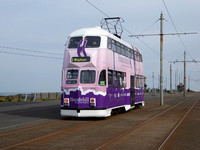
A: Centenary 648
B: Balloon 717
C: Balloon 713
D: Balloon 701
E: Boat 600
F: Bolton 66
G: Frigate 736
Once again, all 7 ran as per their original allocations and again I managed to travel on 6 out of 7 trams. The use of Balloon 713 on this day was a highlight as I havent seen or been on this particular tram since July 2011. Journeys included Cabin - Bispham - Pleasure Beach on 713, Pleasure Beach - North Pier on 736, North Pier - Bispham on 701, Bispham - Little Bispham - Pleasure Beach on 717, Pleasure Beach - North Pier on 66 and Pleasure Beach - Cabin on 648. The photo above shows Balloon 713 in all over advert for Hounds Hill Shopping Centre working the first heritage working of the day from Pleasure Beach - Bispham on 1.5.17.
As well as the heritage workings, the usual diet of Flexities were out with 14 out of 16 seen. Only 003 and 016 weren't seen out over the weekend. Overall, it was a fantastic weekend and the weather was good, which is always a bonus!
My photos from the weekend can be found at: http://scottishtrains.zenfolio.com/p474188147
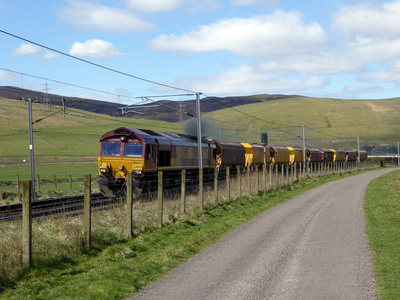 Engineering works were taking place on the West Coast Mainline at 2 Scottish locations today, these were Lockerbie and Abington. As a result, the area around Crawford was busy with engineering workings this morning.
Engineering works were taking place on the West Coast Mainline at 2 Scottish locations today, these were Lockerbie and Abington. As a result, the area around Crawford was busy with engineering workings this morning.
In the space of 1 hour, the following workings were seen passing Crawford:
66063 heads south past Crawford with 6K05 Millerhill - Lockerbie engineering working
66004 passes Crawford with 6K10 Carlisle Yard - Abington engineering working
66415 approaches Crawford with 6K15 Millerhill - Lockerbie engineers
66031 waits at Crawford with 6K11 Carlisle Yard - Abington engineering working
66551 passes Crawford with 6K12 Carlisle Yard - Abington engineering working
66507 waits at Crawford with 6K14 Carlisle Yard - Abington engineering working
66621 waits at Crawford with 6K13 Carlisle Yard - Abington engineering working
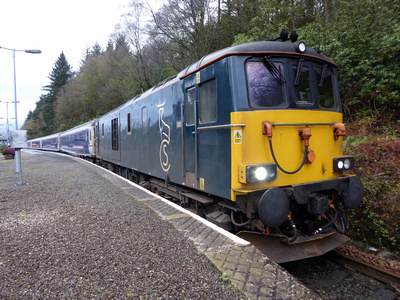 The Caledonian Sleeper Edinburgh Waverley - Fort William Portion has been in the hands of one of GBRF's pool of 6 Caledonian Sleeper Class 73 locos for a number of months. They took over the workings from the DBS owned class 67's.
The Caledonian Sleeper Edinburgh Waverley - Fort William Portion has been in the hands of one of GBRF's pool of 6 Caledonian Sleeper Class 73 locos for a number of months. They took over the workings from the DBS owned class 67's.
73967 is seen preparing to depart Arrochar and Tarbet with 1Y11 London Euston - Fort William (Edinburgh Waverley - Fort William Portion) Caledonian Sleeper service.
Colas liveried 37421 top and tailed with BR Green liveried 37057 were out and about today working 1Q75 Mossend - Mossend Network Rail PLPR test train. It was seen in 3 different places: Holytown, Lanark and Cartland. Here are the photos of the working today.
Holytown with 37421 leading
Lanark with 37057 leading
Cartland with 37057 leading
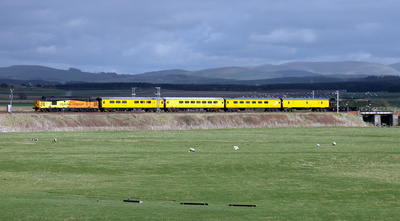 Colas liveried 37421 top and tailed with BR Green Liveried 37057 seen approaching Carstairs South Junction with 1Q74 Carlisle Wapping Sidings - Mossend Network Rail PLPR Test Train
Colas liveried 37421 top and tailed with BR Green Liveried 37057 seen approaching Carstairs South Junction with 1Q74 Carlisle Wapping Sidings - Mossend Network Rail PLPR Test Train
Also seen were:
An unidentified triple set of class 325's heads south from with 1M44 Shieldmuir - Warrington Royal Mail delivery
New Transpennine Express liveried 350402 accelerates away from Carstairs South Junction with 1M91 Edinburgh Waverley - Manchester Airport
66592 heads south from Carstairs with 0Z82 Coatbridge Freightliner Terminal - York South Yard light engine movement
Rail Operations Group sent DCR liveried 56303 to Carlisle today (11.4.17) to collect ex DRS locos 37601 and 47813. 37601 has been bought by Europhoenix and 47813 by Rail Operations Group. Here is the move in pictures:
56303 arrives at Carlisle with 0N09 Leicester LIP - Carlisle light engine movement
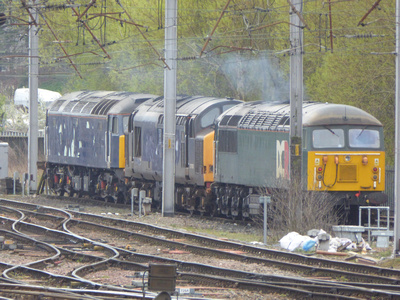 56303 couples up to 37601 and 47813 in High Wapping Sidings
56303 couples up to 37601 and 47813 in High Wapping Sidings
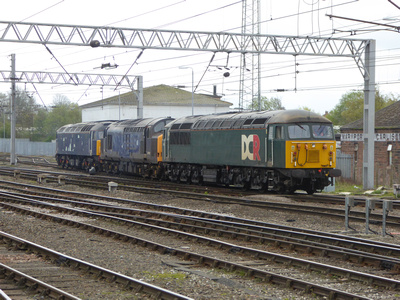 56303 hauls 37601 and 47813 from High Wapping Sidings to the sidings behind Platform 1
56303 hauls 37601 and 47813 from High Wapping Sidings to the sidings behind Platform 1
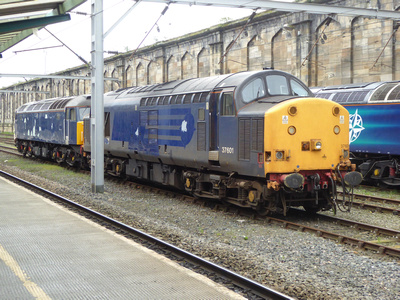 56303 uncoupled from 37601 and 47813 and headed north to run round
56303 uncoupled from 37601 and 47813 and headed north to run round
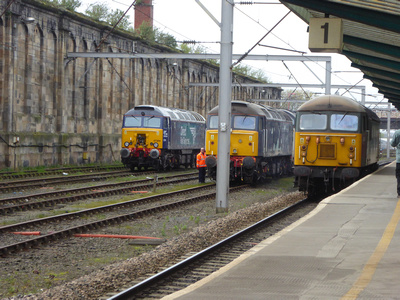 56303 runs round on Platform 1 and heads south
56303 runs round on Platform 1 and heads south
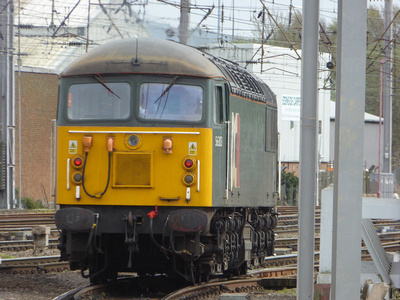 56303 runs round at the south end of Platform 1
56303 runs round at the south end of Platform 1
 DCR Liveried 56303 with 47813 and 37601 dead in tow depart Carlisle with 0M59 Carlisle - Leicester LIP loco move
DCR Liveried 56303 with 47813 and 37601 dead in tow depart Carlisle with 0M59 Carlisle - Leicester LIP loco move
 I went back to Carlisle today for the last time over the Easter Holidays. After a very quiet start (with no freight or loco moves from 11am when I arrived until 1.30pm) the afternoon was quite busy!
I went back to Carlisle today for the last time over the Easter Holidays. After a very quiet start (with no freight or loco moves from 11am when I arrived until 1.30pm) the afternoon was quite busy!
Here are my sightings
350403 departs with a Glasgow Central - Manchester Airport service
142021 departs with a service for Newcastle
153317+158851 depart Carlisle with a service for Leeds
153307 at Carlisle (on this service, which arrived more than 25 minutes late 153307, the rear unit on arrival which should have formed the 12.08 to Barrow was removed from the train at Carlisle and stored in platform 6 for a time. It appeared to have developed a fault, the other 153 formed the service back out to Barrow departing almost 45 minutes late)
158855 is shunted into the siding behind platform 6
156490 departs with a service to Newcastle
142053 arrives with a service from Barrow in Furness
158872+158907 arrive with a service from Leeds
88002+88001 (making it's debut run) approach with 0Z89 Crewe - Carlisle Kingmoor light engine test run
66304+37259 wait on the centre track at Carlisle for a path heading southwards with 0K27 Carlisle Kingmoor - Crewe Basford Hall light engine move
66100+67014+66099 pass with 6E50 Carlisle Yard - Tyne Yard engineers
56303 arrive with 0N09 Leicester LIP - Carlisle light engine movement
BR Large Logo Liveried 37401 approach with 2C49 Barrow in Furness - Carlisle Northern Service
156509 departs Carlisle with a service from Glasgow Central - Newcastle
BR Large Logo Liveried 37402 departs Carlisle with 2C34 Carlisle - Barrow in Furness Northern Service (37402 and the spare set replaced 401 at Carlisle and subsequently broke down 50 minutes later and had to be towed back by 57304!)
153332 prepares to depart with a service for Barrow in Furness
DCR Liveried 56303 with 47813 and 37601 dead in tow depart with 0M59 Carlisle - Leicester LIP loco move
68001 'Evolution'
68002 'Intrepid'
68003 'Astute'
68004 'Rapid'
68005 'Defiant'
68006 'Daring'
68007 'Valiant'
68008 'Avenger'
68009 'Titan'
68010 'Oxford Flyer'
68011
68012
68013
68014
68015
68016 'Fearless'
68017 'Hornet'
68018 'Vigilant'
68019 'Brutus'
68020 'Reliance'
68021 'Tireless'
68022 'Resolution'
68023 'Achilles'
68024 'Centaur'
68025 'Superb'
68026
68027
88001 'Revolution'
88002 ' Prometheus'
88003 'Genesis'
88004 'Pandora'
88005 'Minerva'
88006 'Juno'
88007 'Electra'
88008 'Ariadne'
88009 'Diana'
88010 'Aurora'
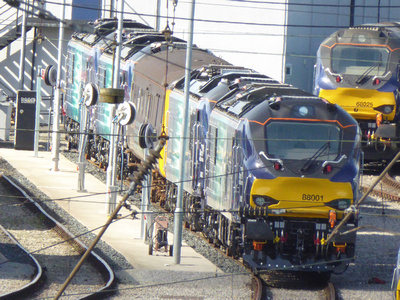 Since I visited the Nature Reserve at Kingmoor last week, a shunt has taken place, with 68026 and 027 having been moved, with a further 2 88's added to the lineup along the fence at the edge of Kingmoor.
Since I visited the Nature Reserve at Kingmoor last week, a shunt has taken place, with 68026 and 027 having been moved, with a further 2 88's added to the lineup along the fence at the edge of Kingmoor.
From right to left is:
88005 'Minerva'
88004 'Pandora'
88007 'Electra'
88010 'Aurora'
88009 'Diana'
88006 'Juno'
From the bridge 88001 'Revolution' is at the head of the 2nd line. 88002 is next then behind the DBSO is 88003 and 008
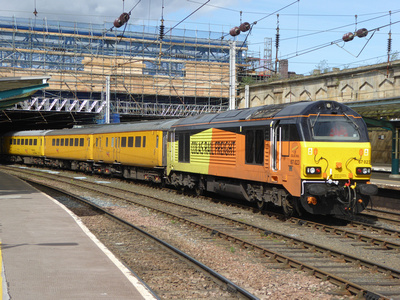 I decided to visit Carlisle again today to catch the Colas Test Train, operating with top and tailed Colas 67's. Here are my sightings:
I decided to visit Carlisle again today to catch the Colas Test Train, operating with top and tailed Colas 67's. Here are my sightings:
66432 with 66957 dead in tow pass through with 6K05 Carlisle Yard - Crewe Basford Hall Engineers
66717 approaches with 4S05 Tyne Yard - Killoch Colliery empty coal
37405 departs on the rear of a Cumbrian Coast set on test on an unidentified working heading for the Cumbrian Coast line
Newly revynaled into the new Trans Pennine Express livery, 350403 departs with a Glasgow Central - Manchester Airport service
142020 departs with a service for Newcastle
158845+153331 arrive with a Leeds - Carlisle service
156482 departs with a service to Newcastle
Colas Liveried 67023 top and tailed with 67027 pause with 1Q13 Heaton - Derby PLRP Test train
37405 passes through with an unidentified test run from the Cumbrian Coast to Carlisle Kingmoor
350402 arrives with a Manchester Airport - Glasgow Central service
158903+158905 depart with a service to Leeds
DRS liveried 37409 arrives with 2C49 Barrow in Furness - Carlisle Northern Service
66304 departs Carlisle with 6K27 Carlisle Yard - Crewe Basford Hall Engineers
156439 departs Carlisle with a service from Glasgow Central - Newcastle service
DRS Liveried 37409 departs Carlisle with 2C34 Carlisle - Barrow in Furness Northern Service
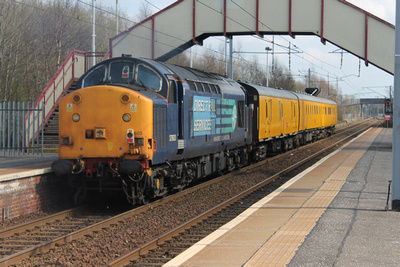 37603 has been stored with worn wheelsets. The loco was transferred to Derby from Crewe during the week as it will now be donating it's power unit to 37407 as 407's power unit was found to have serious faults when it was undergoing its load bank tests.
37603 has been stored with worn wheelsets. The loco was transferred to Derby from Crewe during the week as it will now be donating it's power unit to 37407 as 407's power unit was found to have serious faults when it was undergoing its load bank tests.
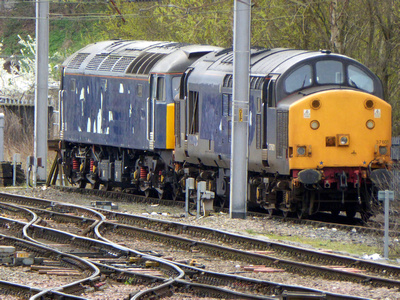 ex DRS locomotives 47813 and 37601 are stabled in Carlisle High Wapping Sidings awaiting collection by their new owners. 47813 has been bought by Rail Operations Group, while 37601 is heading to Europhoenix. They are expected to be collected on Monday (10th April) and taken to their new owners.
ex DRS locomotives 47813 and 37601 are stabled in Carlisle High Wapping Sidings awaiting collection by their new owners. 47813 has been bought by Rail Operations Group, while 37601 is heading to Europhoenix. They are expected to be collected on Monday (10th April) and taken to their new owners.
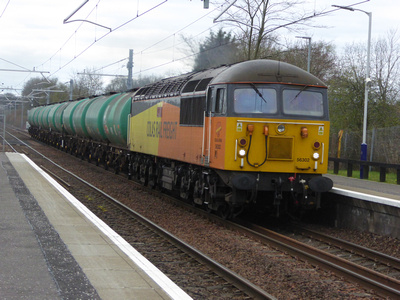 I had planned to go back to Carlisle again today to travel on the loco hauled Cumbrian coast set, however I slept in and decided to do a Strathclyde daytripper instead.
I had planned to go back to Carlisle again today to travel on the loco hauled Cumbrian coast set, however I slept in and decided to do a Strathclyde daytripper instead.
I caught the following services
320310 10.50 Newton - Glasgow Central via Mount Florida
380101 11.30 Glasgow Central - Ayr (troon)
380018 12.17 Troon - Kilwinning
380020 12.50 Kilwinning - Glasgow Central
320414 13.27 Glasgow Central - Newton via Whifflet
I then headed over to Greenfaulds and saw
318254 arrive with a Dalmuir - Cumbernauld service
68017 passes through with 5G13 Motherwell TMD - Edinburgh Waverley Fife Circle ECS movement
Colas liveried 56302 passes through with 6N47 Prestwick - Grangemouth tankers
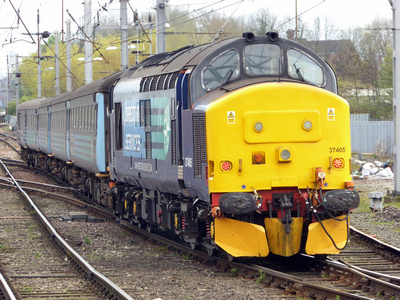 37405 made its debut on the Cumbrian Coast line yesterday (5.4.17). 405, which is usually allocated to the Anglian loco haul diagrams is sharing duties on the coast just now with 37401. Of DRS's current operational 37/4's, 422 is the only loco yet to make it's debut on the service. 37413, meanwhile has been scrapped. The photo shows 37405 at Carlisle on 6.4.17.
37405 made its debut on the Cumbrian Coast line yesterday (5.4.17). 405, which is usually allocated to the Anglian loco haul diagrams is sharing duties on the coast just now with 37401. Of DRS's current operational 37/4's, 422 is the only loco yet to make it's debut on the service. 37413, meanwhile has been scrapped. The photo shows 37405 at Carlisle on 6.4.17.
37/4's current locations
| Number | Livery | Name | Status | Current Location |
| 37401 | BR Blue Logo | Mary Queen of Scots | Operational | Cumbrian Coast Diagram |
| 37402 | BR Blue Logo | Stephen Middlemore | Operational | Carlisle Kingmoor |
| 37403 | BR Blue Logo | Isle of Mull | Operational - on long term loan from Bo'ness | Crewe Gresty Bridge |
| 37404 | Scrapped | |||
| 37405 | DRS Livery | Operational | Cumbrian Coast Diagram | |
| 37406 | Scrapped | |||
| 37407 | BR Blue Logo | Under overhaul at Derby | Derby RTC | |
| 37408 | Scrapped | |||
| 37409 | DRS Livery | Lord Hinton | Operational | Carlisle Kingmoor |
| 37410 | Scrapped | |||
| 37411 | Scrapped | |||
| 37412 | Scrapped | |||
| 37413 | Scrapped | |||
| 37414 | Scrapped | |||
| 37415 | Scrapped | |||
| 37416 | Scrapped | |||
| 37417 | Scrapped | |||
| 37418 | BR Blue Logo | Preserved - East Lancashire Railway | Bury | |
| 37421 | Colas | operational | Neville Hill | |
| 37422 | DRS Livery | Operational | Barrowhill | |
| 37423 | DRS Livery | Spirit of the Lakes | Operational | Norwich |
| 37424 | BR Blue Logo | Avro Vulcan XH558 | Operational | Crewe Gresty Bridge |
| 37425 | DRS Livery | Sir Robert McAlpine/Concrete Bob | Operational | Anglia Diagram |
| 37426 | Scrapped | |||
| 37427 | Scrapped | |||
| 37428 | Scrapped | |||
| 37429 | Scrapped | |||
| 37430 | Scrapped | |||
| 37431 | Scrapped |
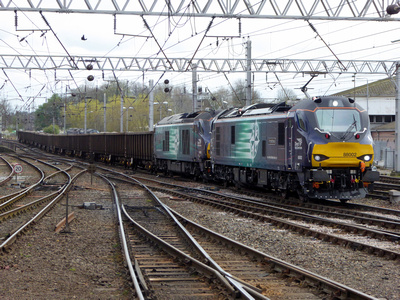 I decided to go back to Carlisle today as 88002 was running again today, this time with 68025 and a trainload of loaded ballast wagons on a test run from Crewe to Carlisle.
I decided to go back to Carlisle today as 88002 was running again today, this time with 68025 and a trainload of loaded ballast wagons on a test run from Crewe to Carlisle.
66432 passes with 6K05 Carlisle Yard - Crewe Basford Hall engineers
156438 arrives with a service from Newcastle
153307 prepares to depart with a service to Barrow in Furness
350407 arrives into Carlisle with a service from Manchester Airport - Glasgow Central whilst 153307 departs with a service to Barrow in Furness, passing ex DRS locos 37601 and 47813 which are stabled in High Wapping Sidings
66100 arrives with 6C48 Workington Docks - Carlisle Yard slurry tanks
Royal Scotsman liveried 66743 arrives with 4S27 Tyne Dock - Hunterston empty coal hoppers
142036+153315 prepare to depart Carlisle with a service to Lancaster via the Cumbrian coast
60095 heads south with 0Z60 Carlisle Yard - Toton TMD light engine move
156471 in the new Northern livery departs Carlisle with a service for Newcastle
66427 with 68004 dead in tow pass through with 0K27 Carlisle Yard - Crewe Basford Hall light engine move
158818+158851 departs with a service to Leeds while an unidentified 390 arrives with a London Euston - Glasgow Central service
66100 arrives with 6E50 Carlisle Yard - Tyne Yard engineering working
DRS liveried 37405 arrives with 2C49 Barrow in Furness - Carlisle Northern Service
Newly repainted and vynaled 156505 departs Carlisle with a Glasgow Central - Newcastle service
158860 shunts from the siding behind platform 6 into Platform 6
DRS Liveried 37405 departs with 2C34 Carlisle - Barrow in Furness Northern Service
156478 arrives with a Newcastle - Glasgow Central service
15333x + 153332 departs Carlisle with a service to Barrow
88002+68025 arrive into Carlisle with 6Z89 Crewe Basford Hall - Carlisle Yard training run
57002+57003 pass through Carlisle with 6M22 Hunterston - Sellafield flasks
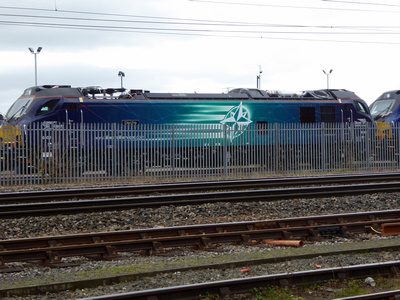 I stopped off at Kingmoor on my way home from Carlisle to see if I could spot any of the new 68's and 88's and wasn't disappointed! Spotted from the Nature Reserve were:
I stopped off at Kingmoor on my way home from Carlisle to see if I could spot any of the new 68's and 88's and wasn't disappointed! Spotted from the Nature Reserve were:
68026: as yet unbranded (still in blue basecoat)
88007: 'Electra'
68027: as yet unbranded (still in blue basecoat)
88010: 'Aurora'
88009: 'Diana'
88006: 'Juno'
From the bridge
the same locos could be seen as well as a 2nd row behind them led by
88002: ' Prometheus' which had just returned from its test run.
unfortunately I could not ID the other 3 stabled behind 002. I was impressed by the 88 and noticed how quiet it was when 88002 pulled out of Carlisle earlier. The 88 has the same body shape as the 68 which many similarities between the 2 different classes.
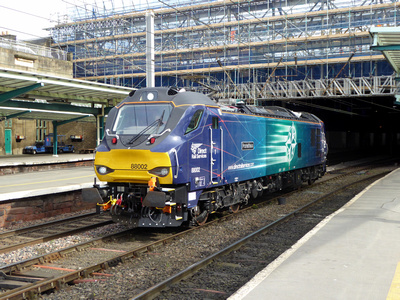 I decided to head down to Carlisle for the day today, to catch 88002 on it's test run. Carlisle was very quiet freight wise with 2 freight workings and 3 light engines in 5 hours. The failure of 92032 on the China Clay working (6S94) near Grayrigg, which resulted in 88002 towing it back to Grayrigg loop caused a long delay for northbound workings in the afternoon as well. Here are my sightings:
I decided to head down to Carlisle for the day today, to catch 88002 on it's test run. Carlisle was very quiet freight wise with 2 freight workings and 3 light engines in 5 hours. The failure of 92032 on the China Clay working (6S94) near Grayrigg, which resulted in 88002 towing it back to Grayrigg loop caused a long delay for northbound workings in the afternoon as well. Here are my sightings:
66432 waits on the centre track with 0K05 Carlisle Yard - Crewe Basford Hall light engine working
156472 prepares to depart with a service to Barrow in Furness
142015 prepares to depart with a service to Newcastle
debranded former DRS locomotives 37601 and 47813 are seen stabled in Carlisle High Wapping sidings
57304 stabled at Carlisle
60095 waits at the signal at the end of platform 3 with 6J37 Carlisle Yard - Chirk Logs
142066 arrives with a service from Newcastle - Carlisle
158816 seen stabled at Carlisle
66100 passes through platform 3 with 6E50 Carlisle Yard - Tyne Yard engineering working
158816+158795 depart with a service to Leeds
BR Large Logo Liveried 37401 approaches Carlisle with 2C49 Barrow in Furness - Carlisle Northern Service
BR Large Logo Liveried 37401 departs Carlisle with 2C34 Carlisle - Barrow in Furness Northern Service
156514 departs Carlisle with a Glasgow Central - Newcastle service
66424 passes through Carlisle with 1Z99 Carlisle Kingmoor - Grayrigg, where it would rescue 6S94, which had failed
wearing the new First TPE livery, 350402 approaches Carlisle with a Manchester Airport - Edinburgh service
88002 passes through Carlisle with the late running 0Z89 Crewe Basford Hall - Carlisle Kingmoor test run
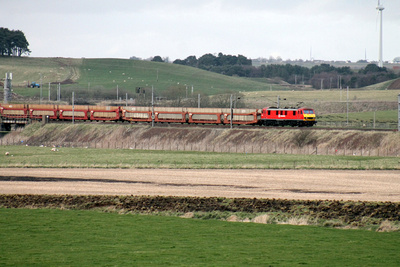 Tonight I saw 90040 heading south from Carstairs towards Float Viaduct with 6V15 Mossend - Didcot empty car wagons
Tonight I saw 90040 heading south from Carstairs towards Float Viaduct with 6V15 Mossend - Didcot empty car wagons
Thank you to everyone who has visited this blog or http://scottishtrains.zenfolio.com/. The site has now reached 15,000 visitors!
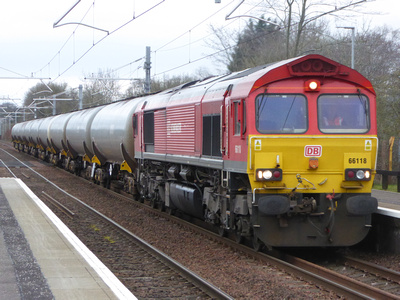 An early finish today meant that I could visit Greenfaulds for an hour!
An early finish today meant that I could visit Greenfaulds for an hour!
Todays Sightings were:
318252 on a Cumbernauld - Dalmuir service
66078 with 4N30 Mossend - Grangemouth container working
318255 on a Cumbernauld - Dalmuir service
318250 on a Dalmuir - Cumbernauld service
320412+320318 on a Dalmuir - Cumbernauld service
320308 on a Dalmuir - Cumbernauld service
68007 with 5G13 Motherwell TMD - Edinburgh Waverley Fife Circle ECS movement
66118 with 6D19 Mossend - Grangemouth tankers
Today I did the Glasgow Central Tour, it was very interesting, especially seeing the abandoned Victorian platform in the Low level. I would recommend booking to go on the tour if you get the chance.
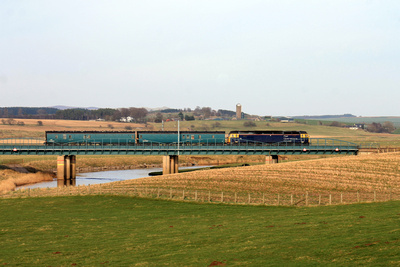 Rail Operations Group liveried 47815 crosses Float Viaduct, south of Carstairs with 2 translator vehicles in tow whilst working 5N09 Shields TMD - Carlisle High Wapping Sidings translator vehicle move
Rail Operations Group liveried 47815 crosses Float Viaduct, south of Carstairs with 2 translator vehicles in tow whilst working 5N09 Shields TMD - Carlisle High Wapping Sidings translator vehicle move
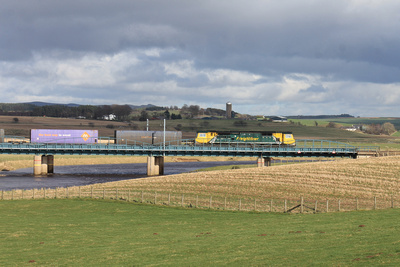 I nipped down to Carstairs to catch the 70 operated Coatbridge - Crewe Intermodal.
I nipped down to Carstairs to catch the 70 operated Coatbridge - Crewe Intermodal.
70015 accelerates away from Carstairs with 4M49 Coatbridge - Crewe Basford Hall intermodal
I was just leaving when 66421 appeared crossing over Float Viaduct just south of Carstairs with an unidentified engineering working for Carlisle Yard, hence the rushed going away shot!
I then nipped into Carluke and caught 66305+66434 pass through with 4M48 Mossend - Daventry intermodal
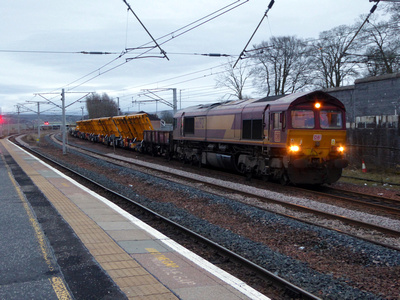 As dusk approaches, 66192 with track panel and ballast wagons arrives into the Down Goods Loop at Carstairs with 6X10 Carlisle Yard - Inverkeithing East Junction engineering working
As dusk approaches, 66192 with track panel and ballast wagons arrives into the Down Goods Loop at Carstairs with 6X10 Carlisle Yard - Inverkeithing East Junction engineering working
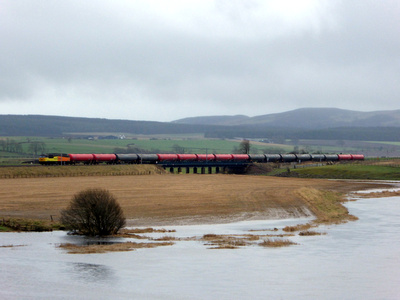 In a change from the usual Class 60, Colas liveried 56302 approaches Carstairs with 6S36 Dalston - Grangemouth tanks. It slowed just outside the approach to the station, then was held on the down fast line to allow the Birmingham - Glasgow Central XC to head out in front of it.
In a change from the usual Class 60, Colas liveried 56302 approaches Carstairs with 6S36 Dalston - Grangemouth tanks. It slowed just outside the approach to the station, then was held on the down fast line to allow the Birmingham - Glasgow Central XC to head out in front of it.
Shortly after 56302 left, Royal Mail unit 325015 passed through with 5Z26 Carlisle - Mossend
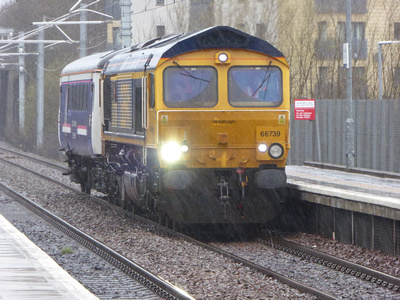 Today, I went to Greenfaulds to catch 56302 on the Prestwick - Grangemouth tanks, here are my sightings:
Today, I went to Greenfaulds to catch 56302 on the Prestwick - Grangemouth tanks, here are my sightings:
318263 departs Greenfaulds with a Dalmuir - Cumbernauld service
68007 passes Greenfaulds with 5G13 Motherwell TMD - Edinburgh Waverley Fife Circle ECS move
unfortunately I didnt catch the tanks as 56302 was bowled by a 6 car 318/320 combo!
I then went to Gartcosh:
158726 arrives at Gartcosh with a Glasgow Queen Street - Falkirk Grahamston service
66739 passes through Gartcosh with a Caledonian Sleeper mark 2 on 5Z74 Glasgow Works - Polmadie ECS move
156474 arrives at Gartcosh with a Falkirk Grahamston - Glasgow Queen Street service
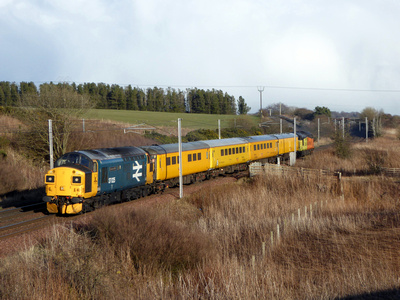 Today, I headed to Cartland to catch the Colas operated Network Rail test train. The locos were BR Large Logo liveried 37025 (on hire to Colas) top and tailed with 37116 and pass through Cartland with 1Q75 Mossend - Mossend via Lanark test train.
Today, I headed to Cartland to catch the Colas operated Network Rail test train. The locos were BR Large Logo liveried 37025 (on hire to Colas) top and tailed with 37116 and pass through Cartland with 1Q75 Mossend - Mossend via Lanark test train.
I then tried a new location on my way home, Hamburg Cottages is on the North Western outskirts of Carluke. Here I saw:
320414 passing with 2B91 17.21 Lanark - Glasgow Central Scotrail service and 66424+66430 with an unidentified light engine working from Carlisle Kingmoor - Motherwell TMD
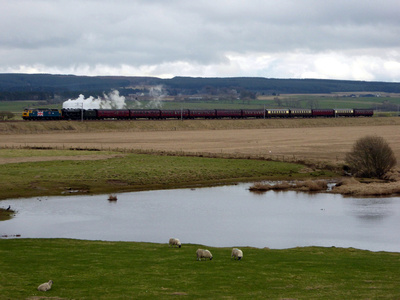 66434+66305 approach Carstairs with 4S43 Daventry - Mossend intermodal
66434+66305 approach Carstairs with 4S43 Daventry - Mossend intermodal
47580+ LMS Royal Scot class 46115 'Scots Guardsman' approach Carstairs South Junction with 1Z31 Manchester Victoria - Edinburgh 'The Mid Day Scot' tour. Image 2
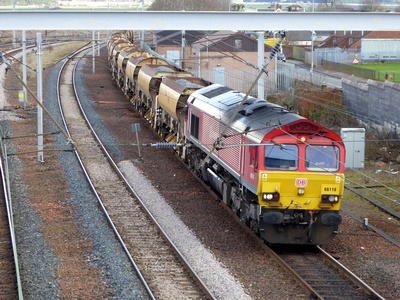 DB Red liveried 66118 waits out time in the Down Goods Loop at Carstairs with 6K08 Carlisle Yard - Glengarnock engineering working
DB Red liveried 66118 waits out time in the Down Goods Loop at Carstairs with 6K08 Carlisle Yard - Glengarnock engineering working
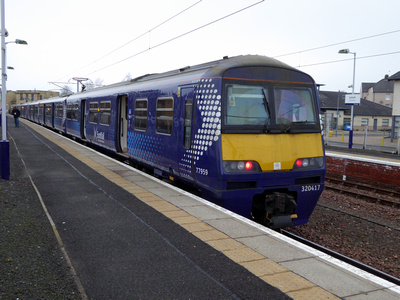 320417+318254 at Lanark and being prepared to depart with 2B89 16.21 Lanark - Glasgow Central
320417+318254 at Lanark and being prepared to depart with 2B89 16.21 Lanark - Glasgow Central
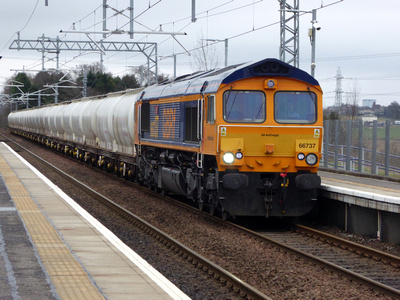 66737 passes through Gartcosh with 6S45 North Blyth - Fort William Alcan tanks working
66737 passes through Gartcosh with 6S45 North Blyth - Fort William Alcan tanks working
 156496 passes through Holytown with 1Y83 Edinburgh Waverley - Glasgow Central fast service
156496 passes through Holytown with 1Y83 Edinburgh Waverley - Glasgow Central fast service
68004+68018 approaches Holytown with 4S43 Daventry - Mossend Intermodal
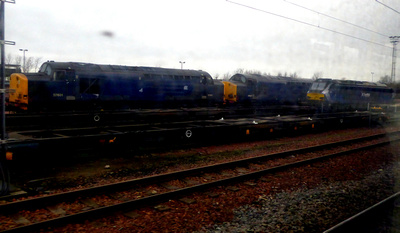 Following their recent sale by DRS, 37601, 607 and 612 were moved to Motherwell TMD for debranding. The following photos show the locos stabled in the yard at the TMD.
Following their recent sale by DRS, 37601, 607 and 612 were moved to Motherwell TMD for debranding. The following photos show the locos stabled in the yard at the TMD.
68007 heads a line of container flats at Motherwell TMD whilst recently sold and debranded 37612 is parked next to it
68007 and container flats at Motherwell TMD with recently sold and debranded 37601, 37607 and out of shot 37612 are stabled behind
68017 and 68020 stabled in the yard at Motherwell TMD
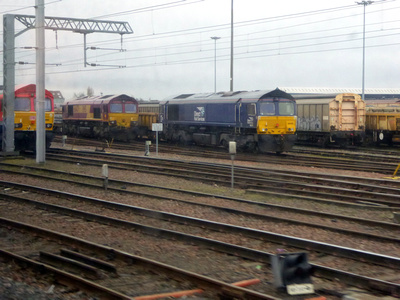 Seen from a passing train, 66092, 66047 and 66430 are seen stabled in Mossend Yard
Seen from a passing train, 66092, 66047 and 66430 are seen stabled in Mossend Yard
DB red liveried 66092 seen stabled at Mossend Yard
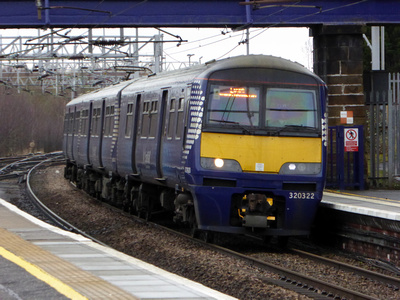 3203xx+320411 departs Motherwell with 2S21 10.25 Motherwell - Dalmuir via Whifflet
3203xx+320411 departs Motherwell with 2S21 10.25 Motherwell - Dalmuir via Whifflet
320311 arrives at Motherwell with 2C22 Milngavie - Cumbernauld
318265+318253 arrive into Motherwell with 2F21 Cumbernauld - Dalmuir
320322 arrives into Motherwell with 2B92 Motherwell - Lanark
Seen from a passing train, 334023 is stabled at Polmadie
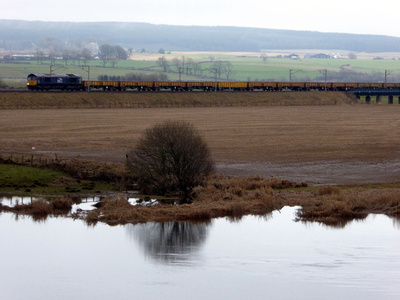 66430 approaches Carstairs with 6Z23 Carlisle Yard - Mossend engineering working
66430 approaches Carstairs with 6Z23 Carlisle Yard - Mossend engineering working
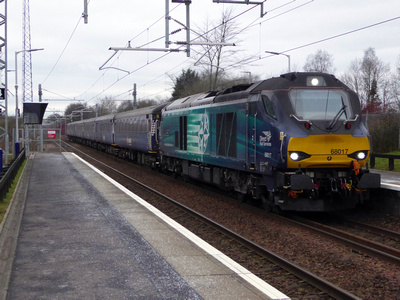 68017 passes Greenfaulds with 5G13 Motherwell TMD - Edinburgh Waverley Fife Circle ECS move
68017 passes Greenfaulds with 5G13 Motherwell TMD - Edinburgh Waverley Fife Circle ECS move
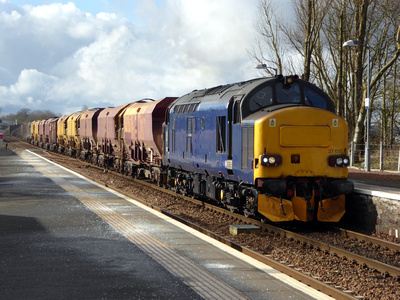 On hire to Colas, Dark Blue liveried 37611 top and tailed with Europheonix liveried 37608 pass through West Calder with 6K29 Bridge of Orchy - Millerhill engineering working.
On hire to Colas, Dark Blue liveried 37611 top and tailed with Europheonix liveried 37608 pass through West Calder with 6K29 Bridge of Orchy - Millerhill engineering working.
Both 37/6's are ex DRS machines with 37611 still retaining the DRS Blue base coat. However 611 is expected to be repainted into Europheonix livery soon.
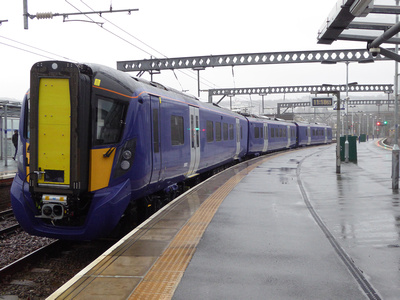 The first of the 3 car version of the Class 385's being delivered for the E & G line electrification was delivered during February, 385001 is seen stabled at Gourock in between test duties and is also seen stabled at Gourock in between test duties whilst 380013 prepares to depart with the 11.24 service to Glasgow Central
The first of the 3 car version of the Class 385's being delivered for the E & G line electrification was delivered during February, 385001 is seen stabled at Gourock in between test duties and is also seen stabled at Gourock in between test duties whilst 380013 prepares to depart with the 11.24 service to Glasgow Central
380013 awaits its departure time at Gourock. It will form the 11.24 service to Glasgow Central
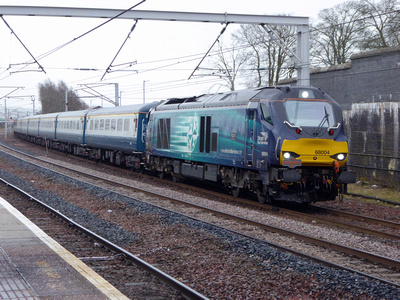 66047+66084 pass Float Viaduct just to the south of Carstairs with an extremely late running (482 late or 8 hours 2 minutes) 6S16 Cardiff Tidal - Mossend Down Yard steel working
66047+66084 pass Float Viaduct just to the south of Carstairs with an extremely late running (482 late or 8 hours 2 minutes) 6S16 Cardiff Tidal - Mossend Down Yard steel working
66744 passes Float Viaduct and approaches Carstairs South Junction with 6S50 Carlisle Yard - Millerhill Departmental working
68004 waits in the Down Goods Loop at Carstairs with 1Z68 Carmarthen - Edinburgh Welsh Rugby Supporters Charter
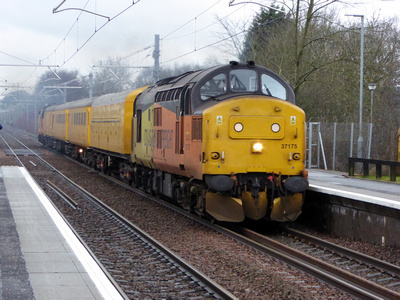 318250 departs Greenfaulds with a Cumbernauld - Dalmuir Service
318250 departs Greenfaulds with a Cumbernauld - Dalmuir Service
60002 passes through Greenfaulds with 6S36 Dalston - Grangemouth tanks
320308 arrives into Greenfaulds with a Cumbernauld - Dumbarton Central service
Caledonian Sleeper liveried 73970 + Royal Scotsman liveried 66743 pass through Greenfaulds with 5A25 Aberdeen - Polmadie Caledonian Sleeper ECS working
334026 approaches Greenfaulds with a Dalmuir - Cumbernauld service
Colas liveried 37175 top and tailed with 37099 accelerate through Greenfaulds with 1Q77 Mossend - Inverness Test Train
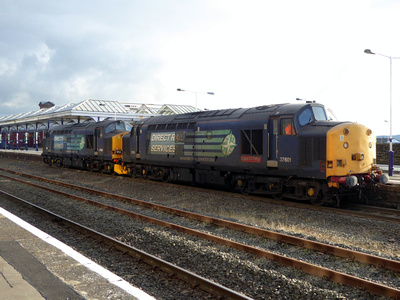 66144+66003 head north past Abington with a late running 6S16 Cardiff Tidal - Mossend Down Yard steel working. A second photo of the working.
66144+66003 head north past Abington with a late running 6S16 Cardiff Tidal - Mossend Down Yard steel working. A second photo of the working.
an unidentified 390 heads south past Carstairs with a Glasgow Central - London Euston service
47815 approaches Carstairs with 5xxx Leicester L.I.P - Shields TMD Translator Van move
320311 departs Greenfaulds with a service from Dalmuir - Cumbernauld
66432 heads south through Greenfaulds with 0xxx Grangemouth - Carlisle Kingmoor light engine move
318261 waits at Greenfaulds with a service from Dalmuir - Cumbernauld
66709 passes through Kilmarnock with 6H97 Greenburn - Drax loaded coal
37601+37605 prepare to depart Kilmarnock with 0Z06 Motherwell TMD - Kilmarnock Bonnyton light engine working
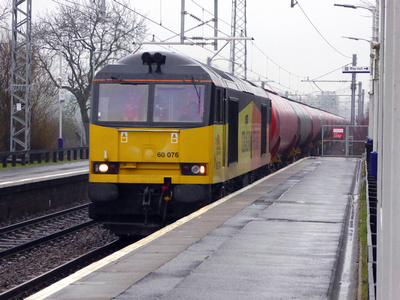 318253 pauses at Greenfaulds with 2F29 Cumbernauld - Dalmuir Scotrail service
318253 pauses at Greenfaulds with 2F29 Cumbernauld - Dalmuir Scotrail service
60076 passes through Greenfaulds with 6S36 Dalston - Grangemouth tankers
318251 pauses at Greenfaulds with 2V35 Cumbernauld - Dalmuir Scotrail service
73968 and 66733 pass through Greenfaulds with 5A25 Aberdeen - Polmadie Caledonian Sleeper ECS movement
334017 approaches Greenfaulds with 2V68 Dalmuir - Cumbernauld Scotrail service
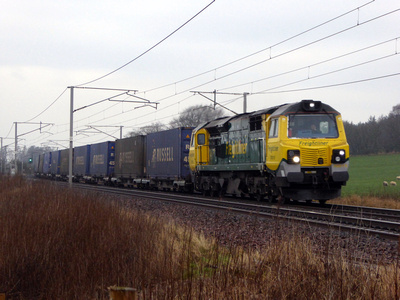 70015 accelerates past Cartland with 4M49 Coatbridge - Crewe Basford Hall Freightliner Intermodal
70015 accelerates past Cartland with 4M49 Coatbridge - Crewe Basford Hall Freightliner Intermodal
320305 passes Cartland with 2B81 Lanark - Glasgow Central Scotrail service
320412 prepares to depart Carluke with 2B84 Glasgow Central - Lanark Scotrail service
68019+68002 pass through Carluke with 4M48 Mossend - Daventry Stobart Containers
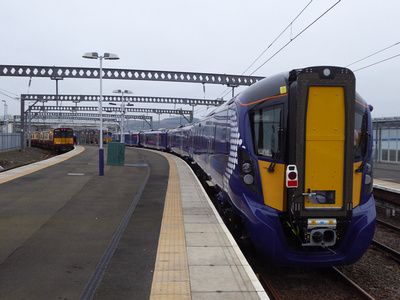 385102 is seen stabled at Platform 2 at Gourock
385102 is seen stabled at Platform 2 at Gourock
314206 prepares to depart Platform 3 at Gourock with the 14.51 service to Glasgow Central
old and new side by side 314206 waits on Platform 3 to depart with the 14.51 service to Glasgow Central and 385102 seen stabled in Platform 2 with 66187 behind it.
66187 seen stabled at platform 2 at Gourock
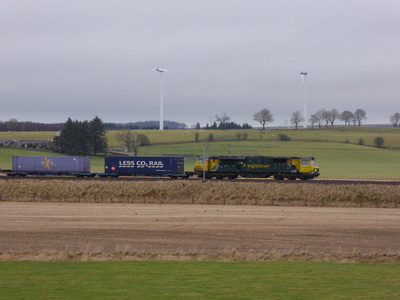 a pair of unidentified class 185's accelerate away from Carstairs South Junction with 1M99 Edinburgh Waverley - Manchester Airport
a pair of unidentified class 185's accelerate away from Carstairs South Junction with 1M99 Edinburgh Waverley - Manchester Airport
70006 accelerates away from Carstairs with 4M55 Coatbridge Central - Daventry intermodal
320304 departs Newton with a service to Dalmuir
320313+318256 arrive into Newton with a service for Larkhall
Since the start of the December timetable, some 320's have been working on Cathcart Circle and Newton workings, allowing more 314's to operate on Gourock and Wymess Bay services whilst 380's are used for driver training for the E&G line. Today 320303 is seen at Newton having arrived with a service via Mount Florida
320308+318260 arrive into Newton with a service from Dalmuir - Cumbernauld
334017 departs Newton with a service from Cumbernauld - Milngavie
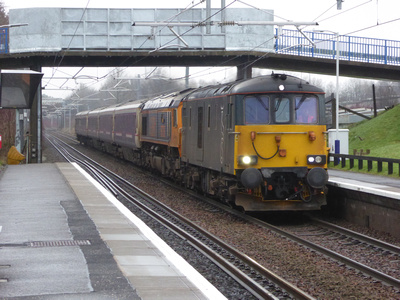 334026 at Greenfaulds with a service from Cumbernauld - Dalmuir
334026 at Greenfaulds with a service from Cumbernauld - Dalmuir
334022 departs Greenfaulds with a Dalmuir - Cumbernauld
73768+66736 passes through Greenfaulds with 5Z25 Aberdeen - Polmadie Sleeper ECS
156458 arrives at Greenfaulds with a Glasgow Queen Street - Falkirk Grahamston
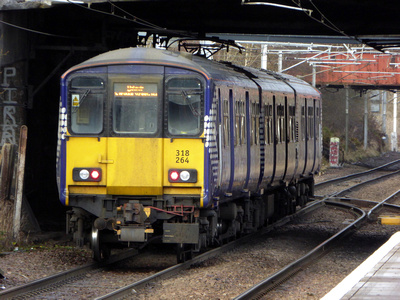 318262+318264 depart Whifflet with a Motherwell - Dalmuir via Whifflet service
318262+318264 depart Whifflet with a Motherwell - Dalmuir via Whifflet service
320315 departs Whifflet with a Whifflet - Dalmuir service
320307 arrives into Whifflet with a Cumbernauld - Dalmuir service
320310 departs Whifflet with a Milngavie - Cumbernauld service
66034 passes through Whifflet with 4M30 Grangemouth - Daventry intermodal
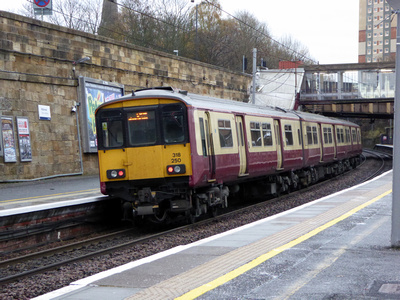 320414+320303 and 318263+320320 await their next turns of duty at Motherwell
320414+320303 and 318263+320320 await their next turns of duty at Motherwell
318250 pauses at Motherwell with a Glasgow Central - Lanark service
320320 on the rear of 318263 departs Motherwell with a service to Dalmuir
320303+320414 wait on platform 4 at Motherwell
66421 seen stabled at Motherwell TMD
68019 and 68007 stabled at Motherwell TMD
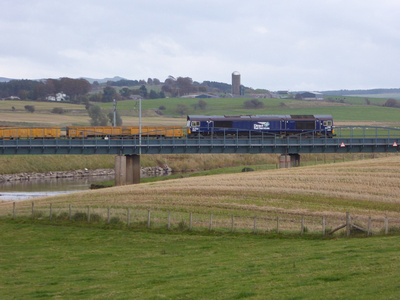 Freightliner's 66524 has just crossed over Float Viaduct on the approach to Carstairs South Junction with 6K10 Carlisle Yard - Falkirk Grahamston engineering working
Freightliner's 66524 has just crossed over Float Viaduct on the approach to Carstairs South Junction with 6K10 Carlisle Yard - Falkirk Grahamston engineering working
an unidentified 9 car 390 accelerates away from Carstairs South Junction heading towards Float Viaduct with an Edinburgh Waverley - London Euston service
66422 accelerates away from Carstairs South Junction towards Float Viaduct with 6K03 Falkirk Grahamston - Carlisle Yard engineering train
66426 approaches Carstairs South Junction with 6K08 Carlisle Yard - Falkirk Grahamston engineering working
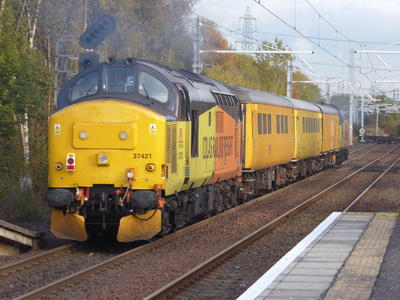 68007 heads West through Holytown with 5G02 Edinburgh Waverley - Motherwell Fife Circle ECS move
68007 heads West through Holytown with 5G02 Edinburgh Waverley - Motherwell Fife Circle ECS move
66122 passes through Holytown with 4S99 Tees Dock - Mossend containers
320318 departs with a Cumbernauld - Dalmuir service
57601 + 47851 head north through Greenfaulds with 0Z30 Carnforth - Bo'ness light engine move
318264 arrives into Greenfaulds with a Cumbernauld - Dalmuir service
156507 arrives into Greenfaulds with a Falkirk Grahamston - Glasgow Queen Street Service
320312 departs Greenfaulds with a Dalmuir - Cumbernauld service
158729 stops at Greenfaulds with a Glasgow Queen Street - Falkirk Grahamston service whilst 170426 passes with an Inverness - Glasgow Queen Street service
318254 stops at Greenfaulds with a Dalmuir - Cumbernauld service
66104 heads south through Greenfaulds with 4D51 Grangemouth - Mossend containers
170474 approaches Camelon with a service from Dunblane - Edinburgh Waverley
68020 approaches Camelon with 4A13 Grangemouth - Aberdeen intermodal
320302 approaches Cumbernauld with a Cumbernauld - Dalmuir service
66122 approaches Greenfaulds with 4N30 Mossend - Grangemouth containers
318264 approaches Greenfaulds with a Cumbernauld - Dalmuir service
60056 passes Gain Road with 6B31 Inverness - Oxwellmains cement empties
318256 arrives into Gartcosh with a Cumbernauld - Dalmuir service
320321 approaches Gartcosh with a Dalmuir - Cumbernauld service
37219 top and tailed with 37421 passes through Gartcosh with 1Q21 Fort William - Mossend Test Train
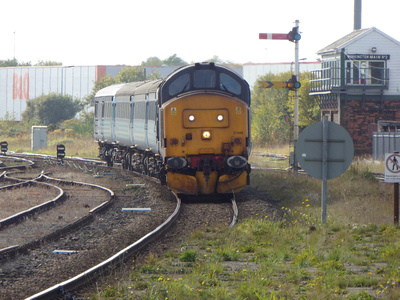 66423 top and tailed with 66429 approach Carlisle with 3J11 Carlisle Kingmoor - Carlisle Kingmoor Rail Head Treatment Train
66423 top and tailed with 66429 approach Carlisle with 3J11 Carlisle Kingmoor - Carlisle Kingmoor Rail Head Treatment Train
153363 pauses at Workington with 2C46 12.08 Carlisle - Barrow in Furness service
37409 approaches Workington with 2C49 Barrow in Furness - Carlisle Northern service
37409 on the rear of DBSO 9709 and Mark 2's departs Carlisle with 2C34 Carlisle - Barrow in Furness Northern service
156506 departs Carlisle with 1E76 Glasgow Central - Newcastle service
'Pendolino Alstom' liveried 390104 waits at Carlisle with 1M14 Glasgow Central - London Euston service
68001 heads through Carlisle with 6K27 Carlisle Kingmoor - Crewe Basford Hall departmental
 66555 approaches Carlisle with 4S51 Daventry - Coatbridge Intermodal
66555 approaches Carlisle with 4S51 Daventry - Coatbridge Intermodal
68025+68023 approach Carlisle with 4S43 Daventry - Grangemouth Stobart intermodal
142088 approaches Carlisle with a service from Newcastle
66735 approaches Carlisle with 6S05 Doncaster - Killoch empty coal hoppers
66423 top and tailed with 66429 approaches Carlisle with 3J11 Carlisle Kingmoor - Carlisle Kingmoor Rail Head Treatment Train
Colas liveried 37116 and Network Rail Test Train stabled in Wapping Sidings to the south of Carlisle Station
390103 with Poppy and Royal British Legion stickers seen at Carlisle
142095 approaches Carlisle with a service from Newcastle
66041 and ballast wagon pass through Carlisle with 6E50 Carlisle Yard - Tyne Yard departmental working
57310 heads through Carlisle with 0K27 Carlisle Yard - Crewe Basford Hall light engine working
BR Large Logo Liveried 37403 approaches Carlisle with 2C49 Barrow in Furness - Carlisle Northern Service
Following a swapover of locomotives, with 37403 being replaced with 37409 departs Carlisle with 2C34 Carlisle - Barrow in Furness Northern Service
90037+90040 arrive into Carlisle with 6S94 Dollands Moor - Irvine slurry train
390107 in Independence Day vynals at Carlisle
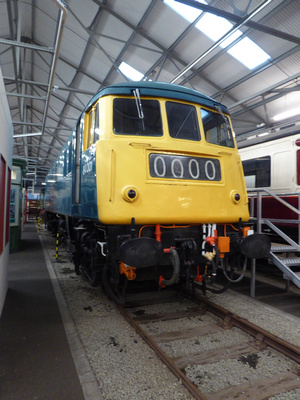 68025+68023 head north towards Carstairs with 4S43 Daventry - Mossend Stobart Intermodal
68025+68023 head north towards Carstairs with 4S43 Daventry - Mossend Stobart Intermodal
390107 in Independence Day branding crosses Float Viaduct with an Edinburgh Waverley - London Euston service
Glasgow Subway Motor 55 at the Scottish Railway Museum, Boness
New addition to the collection, 84001 seen at the Scottish Railway Museum, Boness
8F number 45170 undergoing restoration at the Scottish Railway Museum, Boness
LNER J36 65243 stabled at the Scottish Railway Museum, Boness
37261 at Boness
37703 stabled at Boness
303032 seen stabled at Boness
LNER Teak coach at Boness
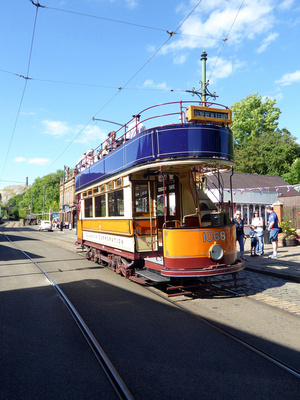 Photos from the National Tramway Museum at Crich, Derbyshire can be found here
Photos from the National Tramway Museum at Crich, Derbyshire can be found here
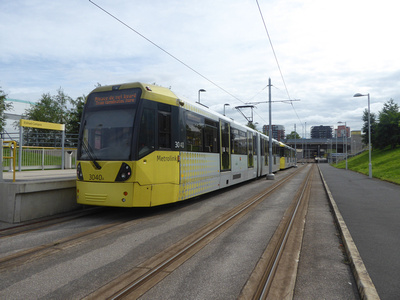 Photos from the Manchester Metrolink from 4.8.16-6.8.16 can be found here
Photos from the Manchester Metrolink from 4.8.16-6.8.16 can be found here
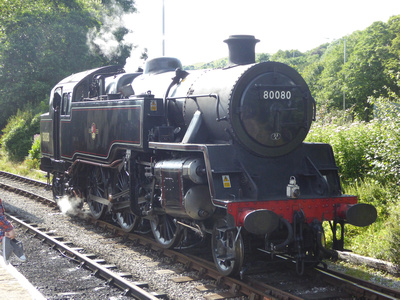 Photos from a visit to the East Lancashire Railway on 5th August can be found here
Photos from a visit to the East Lancashire Railway on 5th August can be found here
 66736 waits in the Loop at Coatbridge Central with 6E45 Fort William - North Blyth Alcans
66736 waits in the Loop at Coatbridge Central with 6E45 Fort William - North Blyth Alcans
66733 with 5Z75 Glasgow Works - Polmadie passes 66736 with 6E45 Fort William - North Blyth Alcans at Coatbridge Central
170415 passes through Coatbridge Central with 1H15 Glasgow Central - Inverness
66733 with Caledonian Sleeper Mark 2 RLO Sleeper Reception Car 6703 passes through Coatbridge Central with 5Z75 Glasgow Works - Polmadie ECS move
37218 heads north through Coatbridge Central with 0Z37 Motherwell TMD - Motherwell TMD via Perth Light engine working
334028 departs at Greenfaulds with 2V41 Cumbernauld - Dumbarton Central
68002 passes Greenfaulds with 5G13 Motherwell TMD - Edinburgh Waverley Fife Circle ECS move
170413 passes through Greenfaulds with 1H15 Glasgow Central - Inverness
68025 passes through Holytown with 5L69 Motherwell TMD - Edinburgh Waverley Fife Circle ECS working
66548 crosses Float Viaduct with 4Z82 Coatbridge - York South Yard empty container flats
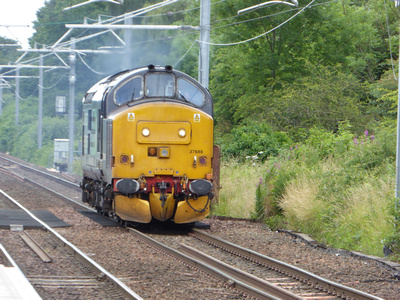 334030 arrives at Greenfaulds with 2V41 Cumbernauld - Dumbarton Central
334030 arrives at Greenfaulds with 2V41 Cumbernauld - Dumbarton Central
318256 seen on the rear of 318263 at Greenfaulds with 2C34 Milngavie - Cumbernauld
170405 passes through Greenfaulds with 1T20 Aberdeen - Glasgow Central
37688 storms towards Greenfaulds with 0Z37 Motherwell - Inverness light engine movement
334002 at Greenfaulds with 2V50 Dumbarton Central - Cumbernauld
66127 approaches Greenfaulds with 0N80 Mossend - Grangemouth light engine move
66092 passes through Greenfaulds with 4N30 Mossend - Grangemouth containers
156502 departs Greenfaulds with 2J69 Falkirk Grahamston - Springburn
170412 passes through Greenfaulds with 1S69 Glasgow Central - Aberdeen
318265 on the rear of London Midland liveried 320416 passes through Greenfaulds with 2C38 Milngavie - Cumbernauld
170409 passes through Greenfaulds with 1T22 Aberdeen - Glasgow Central
320319 waits at Greenfaulds with 2V54 Dumbarton Central - Cumbernauld
London Midland liveried 320416 on the rear of newly repainted in Scotrail liveried 318265 with 2F01 Cumbernauld - Anderston
68006 passes Greenfaulds with 5G13 Motherwell - Edinburgh Waverley Fife Circle ECS
Royal Scotsman liveried 66743 passes through Holytown with 6S48 Tyne Yard - Mossend engineers
 66952 tnt 66597 pass through Greenfaulds with 6K52 Causewayhead Junction - Mossend engineering working
66952 tnt 66597 pass through Greenfaulds with 6K52 Causewayhead Junction - Mossend engineering working
47237 with 33109, 40135 and 40106 dead in tow crosses the Castlecary arches with 0Z40 Castleton - Boness loco move
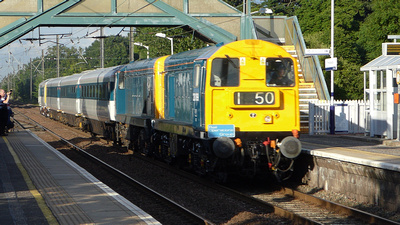 43309+43305 approach Prestonpans with 1S22 London Kings Cross - Stirling
43309+43305 approach Prestonpans with 1S22 London Kings Cross - Stirling
380110 approaches Prestonpans with 2Y27 North Berwick - Edinburgh Waverley
20189+20205 top and tailed with Prototype HST 41001 and matching mark 3's pass through Prestonpans with 5S20 York Holgate - Boness ECS and loco move
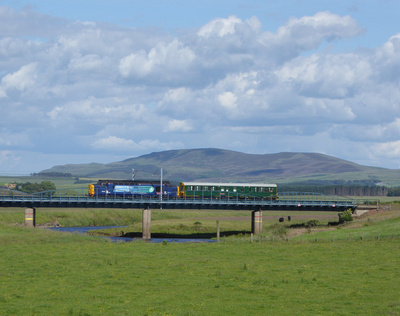 37419 propels rail inspection vehicle 975025 "Caroline" over Float Viaduct with 5Z02 Dalmuir - Carlisle High Wapping Sidings
37419 propels rail inspection vehicle 975025 "Caroline" over Float Viaduct with 5Z02 Dalmuir - Carlisle High Wapping Sidings
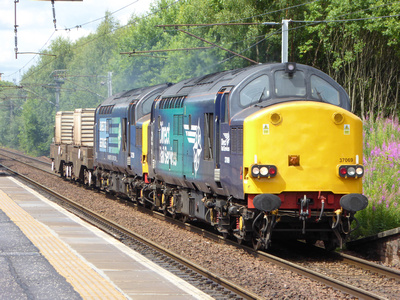 37069+37259 approaches Holytown with 6M22 Hunterston - Carlisle Kingmoor Flasks
37069+37259 approaches Holytown with 6M22 Hunterston - Carlisle Kingmoor Flasks
320301+318264 depart Greenfaulds with an Anderston - Cumbernauld service
334032 departs Greenfaulds with a Cumbernauld - Dalmuir service
68025 approaches Greenfaulds with 5G13 Motherwell TMD - Edinburgh Waverley Fife Circle ECS working
320320 approaches Greenfaulds with a service from Dalmuir - Cumbernauld
In a change from the usual class 60, 56302 passes through Greenfaulds with 6N47 Prestwick - Grangemouth tankers
68007 approaches Holytown with 5L69 Motherwell TMD - Edinburgh Waverley Fife Circle ECS working
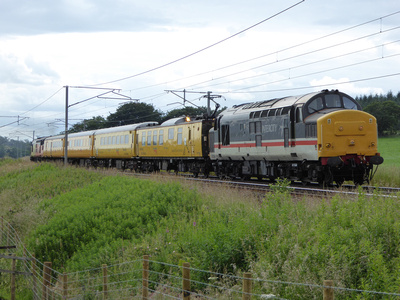 390107 heads south over Float Viaduct with 1M15 Glasgow Central - London Euston
390107 heads south over Float Viaduct with 1M15 Glasgow Central - London Euston
Caledonian Sleeper liveried 92033 waits in the down goods loop at Carstairs with 6S51 Carlisle Yard - Mossend
66037 approaches Cartland with 4E99 Mossend - Tees Dock containers
66547 heads south through Cartland with a Mossend - Carlisle Yard container flat
Intercity liveried 37254 top and tailed with Colas liveried 37175 pass Cartland with 1Q80 Mossend - Mossend test train
Intercity liveried 37254 top and tailed with Colas liveried 37175 seen at Lanark with 1Q80 Mossend - Mossend test train
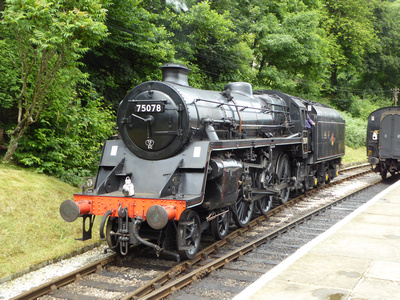 Photos from my visit to the Keighley and Worth Valley Railway can be found here
Photos from my visit to the Keighley and Worth Valley Railway can be found here
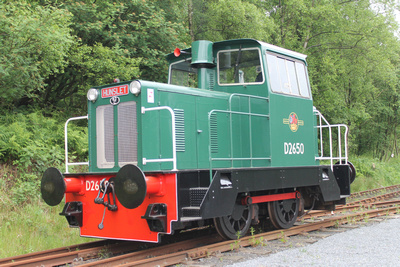 Hunslet MOD 251 and Brake Van at Scottish Bus Museum, Lathalmond near Dunfermilne
Hunslet MOD 251 and Brake Van at Scottish Bus Museum, Lathalmond near Dunfermilne
NCB no 17 undergoing restoration at the Scottish Bus Museum Lathalmond, near Dunfermilne
MOD 250 in fictitious BR Green livery and numbered D2650 seen at the Scottish Vintage Bus Museum Lathalmond near Dunfermilne
Hunslet MOD 251 and Brake Van at Scottish Bus Museum, Lathalmond near Dunfermilne
Covered Van 47930 at the Scottish Bus Museum, Lathalmond near Dunfermilne
Narrow Gauge loco at the Scottish Bus Museum, Lathalmond near Dunfermilne
Narrow Gauge loco T11 'Elquise' at the Scottish Bus Museum, Lathalmond near Dunfermilne
Flat wagon with no 17's boiler and Texaco 3 stabled outside the loco shed at the Scottish Bus Museum, Lathalmond near Dunfermilne
MOD 250 in fictitious BR Green livery and numbered D2650 seen at the Scottish Vintage Bus Museum Lathalmond near Dunfermilne
Narrow Gauge loco T11 'Elquise' at the Scottish Bus Museum, Lathalmond near Dunfermilne
Fowler Diesel. Texaco no 3 at Scottish Bus Museum Lathalmond near Dunfermilne
Edinburgh Horse Tram no 23 seen at the Scottish Bus Museum Lathalmond, near Dunfermilne
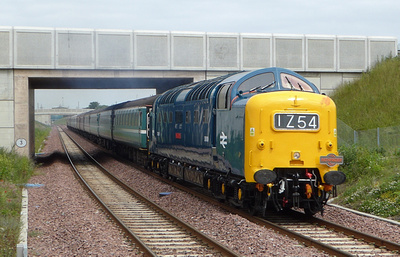 158870 heads north from Prestonpans with 2D86 Dunbar - Edinburgh Scotrail Service
158870 heads north from Prestonpans with 2D86 Dunbar - Edinburgh Scotrail Service
BR Blue liveried D9009 (55009) 'Alycidon' heads north from Prestonpans with 1Z54 Derby - Tweedbank Pathfinder's 'The Deltic Borderer II' tour
43305 with 43251 on the rear approach Prestonpans with 1E13 Inverness - London Kings Cross
158738+158730 approach Shawfair with 2T75 Tweedbank - Edinburgh Waverley
158705+158786 arrive into Shawfair with 2T80 Edinburgh Waverley - Tweedbank
BR Blue liveried D9009 (55009) 'Alycidon' approaches Shawfair with 1Z54 Derby - Tweedbank Pathfinder's 'The Deltic Borderer II' tour
Colas liveried 60026 waits out time in the Down Goods Loop at Carstairs with 6K20 Carlisle Yard - Carmont engineers working
 66104 heads north through Greenfaulds with 4N30 Mossend - Grangemouth containers
66104 heads north through Greenfaulds with 4N30 Mossend - Grangemouth containers
170459 passes through Greenfaulds with 1S69 Glasgow Central - Inverness
37059 heads south through Greenfaulds with 0Z24 Motherwell TMD - Motherwell TMD light engine movement
170472 passes Greenfaulds heading north with an unidentified working
London Midland liveried 320416+320412 arrive into Greenfaulds with 2C38 Milngavie - Cumbernauld
68022 approaches Greenfaulds with 5G13 Motherwell TMD - Edinburgh Waverley Fife Circle ECS working
66056 heads north slowly over Float Viaduct with some empty car transporters towards Carstairs, where it would be looped in the down goods loop. The working is 6Z52 Portbury - Mossend.
Caledonian Sleeper liveried 92014 top and tailed with 92010 with 2 Arlington Fleet Services Translator Vehicles in the centre head south past Float with 5Z70 Mossend - Crewe translator van move
66056 waits out time in the Down Goods loop at Carstairs with 6Z52 Portbury - Mossend
 Royal Scotsman liveried 66746 seen stabled at Gourock with the Royal Scotsman
Royal Scotsman liveried 66746 seen stabled at Gourock with the Royal Scotsman
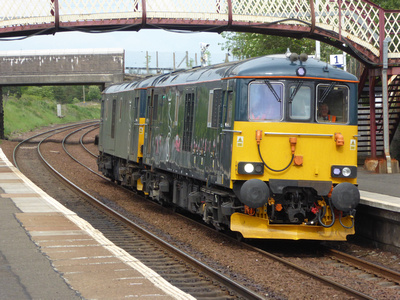 Caledonian Sleeper liveried 73969 and 73967 head west through Hartwood with 0C11 Craigentinny - Polmadie light engine movement
Caledonian Sleeper liveried 73969 and 73967 head west through Hartwood with 0C11 Craigentinny - Polmadie light engine movement
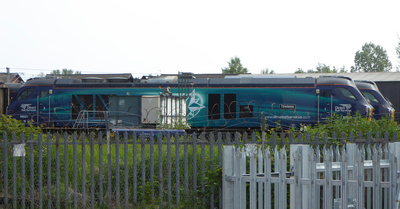 68021 'Tireless' with 68025 stabled behind, seen at Motherwell TMD (photo taken through the fence from the B & Q carpark)
68021 'Tireless' with 68025 stabled behind, seen at Motherwell TMD (photo taken through the fence from the B & Q carpark)
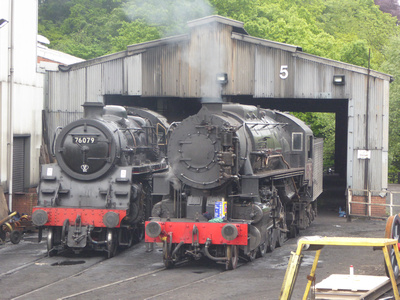 We joined the SRPS Railtour at Carluke heading to Grosmont on the North Yorkshire Moors Railway. West Coast Liveried 47854 top and tailed with 47832 working 1Z35 operated the service, which headed east at Carstairs to Edinburgh then down the East Coast past Durham, then across to Middlesborough and then onto Grosmont. After a look round the sheds, we boarded 37264 and headed to Pickering. As the train was running late, we only got 10 minutes there before 37264 brought us back to Grosmont. After a wait of around 40 minutes, it was time to board the tour heading back home. Photos can be found here
We joined the SRPS Railtour at Carluke heading to Grosmont on the North Yorkshire Moors Railway. West Coast Liveried 47854 top and tailed with 47832 working 1Z35 operated the service, which headed east at Carstairs to Edinburgh then down the East Coast past Durham, then across to Middlesborough and then onto Grosmont. After a look round the sheds, we boarded 37264 and headed to Pickering. As the train was running late, we only got 10 minutes there before 37264 brought us back to Grosmont. After a wait of around 40 minutes, it was time to board the tour heading back home. Photos can be found here
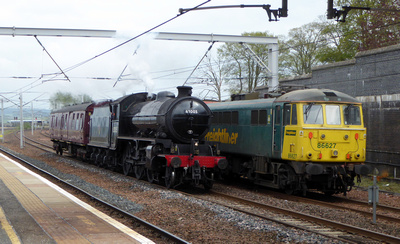 86627+86628 parked up with their pantographs down in the down goods loop at Carstairs
86627+86628 parked up with their pantographs down in the down goods loop at Carstairs
LNER Thomson / Peppercorn class K1 62005 'Lord of the Isles' passes through Carstairs with 5Z25 Grosmont - Fort William Steam Loco and support coach move
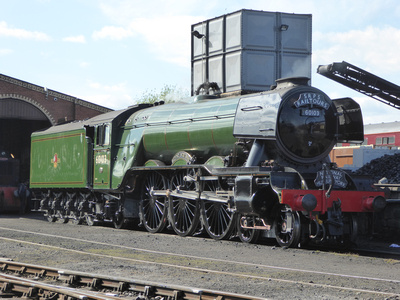 A3 class 60103 'Flying Scotsman' on display at Boness and Kinneil Railway
A3 class 60103 'Flying Scotsman' on display at Boness and Kinneil Railway
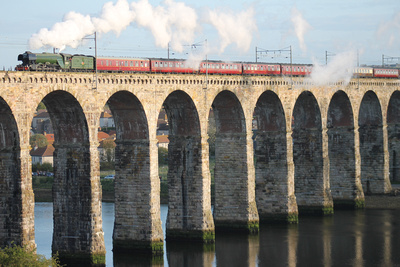 A close up of Flying Scotsman Vynaled 91101 crossing over the Tweed at Berwick upon Tweed on the Royal Border Bridge with 1E23 Edinburgh Waverley - London Kings Cross
A close up of Flying Scotsman Vynaled 91101 crossing over the Tweed at Berwick upon Tweed on the Royal Border Bridge with 1E23 Edinburgh Waverley - London Kings Cross
Flying Scotsman Vynaled 91101 and matching DVT 82201 seen crossing over the Tweed at Berwick upon Tweed on the Royal Border Bridge with 1E23 Edinburgh Waverley - London Kings Cross
91102 'City of York' crosses over the Royal Border Bridge at Berwick upon Tweed with 1S19 London Kings Cross - Edinburgh Waverley
91126 crosses over the Royal Border Bridge at Berwick upon Tweed with 1E24 Edinburgh Waverley - London Kings Cross
43317+43315 crosses the Royal Border Bridge at Berwick upon Tweed with 1S20 King Cross - Aberdeen
A pair of unidentified Cross Country class 221's cross over the Royal Border Bridge at Berwick upon Tweed with 1M80 Edinburgh Waverley - Birmingham New Street
A close up of 43238 with a Vynal advertising the 40th anniversary of the National Railway Museum in York
43238+43318 head south over the Royal Border Bridge in Berwick upon Tweed with 1E25 Aberdeen - London Kings Cross
An unidentified class 221 seen crossing the Royal Border Bridge at Berwick upon Tweed with 1S47 Birmingham New Street - Glasgow Central
66134 heads over the Royal Border Bridge at Berwick Upon Tweed with the diverted 4S49 Daventry - Grangemouth intermodal
91112 passes over the Royal Border Bridge at Berwick upon Tweed with 1S21 London Kings Cross - Edinburgh Waverley
91131 passes over the Royal Border Bridge at Berwick Upon Tweed with 1S22 London Kings Cross - Edinburgh Waverley
An unidentified class 220 heads south over the Royal Berwick Bridge at Berwick Upon Tweed with 1M00 Glasgow Central - Birmingham New Street
43310 +43257 head south over the Royal Border Bridge in Berwick Upon Tweed with 1E27 Edinburgh Waverley - Newcastle
A3 class 60103 'Flying Scotsman' heads north over the Royal Border Bridge in Berwick Upon Tweed with 1Z44 York - Edinburgh
A3 class 60103 'Flying Scotsman' passes Burnmouth with 1Z44 York - Edinburgh
 GBRF's Multicoloured 66720 passes through Hartwood with 6S48 Tyne Yard - Mossend Autoballasters and MHA wagons
GBRF's Multicoloured 66720 passes through Hartwood with 6S48 Tyne Yard - Mossend Autoballasters and MHA wagons
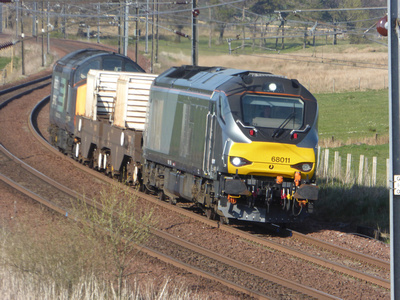 Chiltern liveried 68011 top and tailed with 37604 pass Auchengray with 6M50 Torness - Carlisle Kingmoor Flasks
Chiltern liveried 68011 top and tailed with 37604 pass Auchengray with 6M50 Torness - Carlisle Kingmoor Flasks
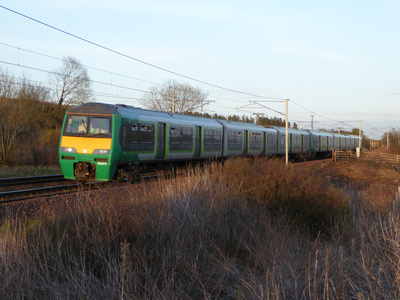 Freightliner liveried 70005 heads north through Cartland with 4Z44 Daventry - Coatbridge Central Freightliner intermodal
Freightliner liveried 70005 heads north through Cartland with 4Z44 Daventry - Coatbridge Central Freightliner intermodal
London Midland liveried 320411+320412 (formerly 321411+321412 and reduced from 4 vehicles to 3 vehicles) heads north through Cartland with 2B79 Lanark - Glasgow Central
 Freightliner liveried 70004 heads south through Cartland with 4Z55 Coatbridge - Crewe Basford Hall intermodal
Freightliner liveried 70004 heads south through Cartland with 4Z55 Coatbridge - Crewe Basford Hall intermodal
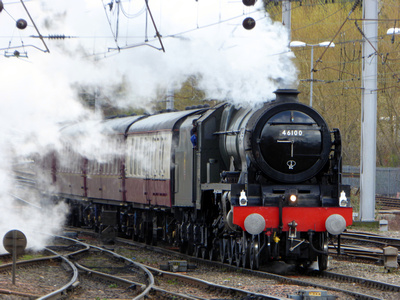 West Coast Liveried 47760 stabled in the sidings next to Platform 1 at Carlisle. It would later reverse northwards out of the station then pull forward into Platform 3.
West Coast Liveried 47760 stabled in the sidings next to Platform 1 at Carlisle. It would later reverse northwards out of the station then pull forward into Platform 3.
DRS liveried 57311 and a Colas liveried Tamper, stabled in Carlisle Wapping Sidings
Debranded Northern Rail liveried 156469 departs platform 2 at Carlisle with 2N36 Carlisle - Newcastle service
First Transpennine Express liveried 350404+350406 depart Carlisle with 1M97 Edinburgh - Manchester Airport service
47760 prepares to depart Carlisle with 1Z53 railtour from Carlisle - Bridlington, whilst 390134 departs with 1M13 Glasgow Central - London Euston
57315 top and tailed with 57316 arrive into Carlisle with 1Z40 Ely - Carlisle via Cumbrian Coast railtour
37409 arrives into Carlisle with 2C45 Barrow in Furness - Carlisle Northern service
185115 arrives into Carlisle with 1S61 Manchester Airport - Glasgow Central
LMS Royal Scot class 46100 'Royal Scot' arrives into Carlisle with 1Z15 Crewe - Carlisle via Cumbrian Coast railtour
66184 heads south through Carlisle with 4M30 Grangemouth - Daventry intermodal
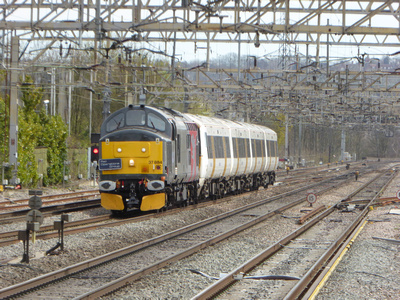 66015 at Carlisle Yard
66015 at Carlisle Yard
66044 and 023 at Carlisle Yard
150118 at Preston
Unidentified London Midland 319 just outside London Euston
London Midland liveried 350110 and London Overground liveried 378212 at London Euston
GWR 4900 class 5972 'Olton Hall' masquerading as 'Hogwarts Castle' on display at the Harry Potter Studios in Watford
London Overground liveried 378234 prepares to depart Watford Junction with a service for London Euston
All over white liveried 319460 prepares to depart Watford Junction with a service to St Albans Abbey
350123+350xxx+350xxx approach Watford Junction with a service for London Euston
Europhoenix liveried 37884 with South Eastern liveried 375612 seen stabled in Wembley Yard
66199 at Wembley Yard
90036 at Wembley Yard
378209 at Williesden
Anglia liveried 86245 and 87002 stabled at Williesden
London Overground liveried 378203 prepares to depart London Euston with a service for Watford Junction
An unidentified S Stock train approaches Euston Square with a Circle Line service
An S Stock train seen heading out of Liverpool Street with a Hammersmith and City Line Service to Hammersmith
S Stock led by vehicle 21478 arrives into Liverpool street with a Circle Line Service
London Overground liveried 378234 is about to depart London Euston with a service for Watford Junction
350244 seen stabled at London Euston. It would work the 13.14 service to Tring
350252 arrives into Euston
350113 seen arriving into London Euston
350108 at London Euston
378213, 87002 and 90044 at Williesden
Europhoenix liveried 37884 seen stabled in Wembley Yard
London Overground 378212 prepares to depart Watford Junction with a service for London Euston
377707 departs Watford Junction with a service for Clapham Junction
378218 arrives at Watford Junction with a service from London Euston
66421 heads south through Watford Junction with an intermodal from Daventry
Europhoenix liveried 37884 with South Eastern liveried 375612 d.i.t at Watford Junction with a Wembley - Derby working
378218 arrives into Watford Junction with a service from London Euston
221103 at Birmingham International
221123 at Birmingham International
390014 at Birmingham International
Arriva Traincare liveried 09204 at Crewe LNWR depot
175007 at Crewe
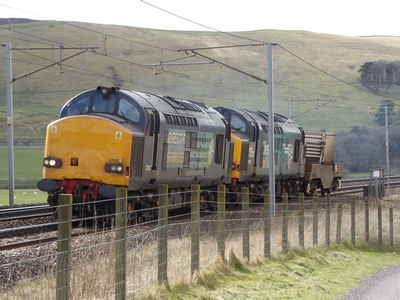 Caledonian Sleeper liveried 92038 heads north past Crawford with 6S51 Carlisle Yard - Mossend Departmental
Caledonian Sleeper liveried 92038 heads north past Crawford with 6S51 Carlisle Yard - Mossend Departmental
37612+37059 heads south through Crawford with 6M22 Hunterston - Sellafield Flasks
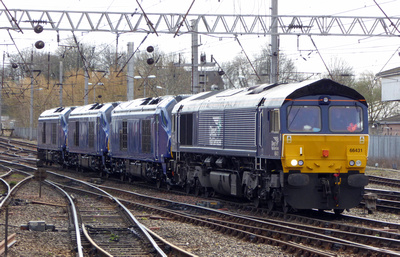 66430 heads south through Carlisle with 6K05 Carlisle Yard - Crewe Basford Hall engineers
66430 heads south through Carlisle with 6K05 Carlisle Yard - Crewe Basford Hall engineers
350408 stabled on the centre track at Carlisle
153315 seen stabled in Carlisle Wapping sidings
Caledonian Sleeper liveried 92018 with 86401 dead in tow head south through Carlisle with 0M49 Carlisle Yard - Crewe light engine movement
90035+037 heads north through Carlisle with 6S94 Dollands Moor - Irvine Slurry tanks
66066 heads south through Carlisle with 0E50 Carlisle Yard - Tyne Yard light engine movement
66431 with newly delivered unbranded class 68025, 024 and 023 dead in tow approach Carlisle with 0Z03 Workington Docks - Carlisle Yard
BR Large Logo Liveried 37402 approaches Carlisle with 2C49 Barrow - Carlisle Northern Service
66304 heads south through Carlisle with 0K27 Carlisle Yard - Crewe Basford Hall light engine working
66015 heads south with 0V71 Carlisle Yard - Margam light engine movement
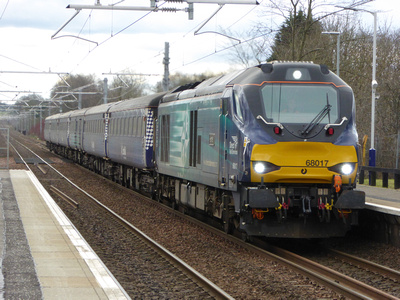 Borders Railway all over advert liveried 170414 seen heading through Greenfaulds
Borders Railway all over advert liveried 170414 seen heading through Greenfaulds
68017 heads north through Greenfaulds with 5G13 Motherwell TMD - Edinburgh Waverley Fife Circle ECS working
68003 heads east through Hartwood with 5L69 Motherwell TMD - Edinburgh Waverley Fife Circle ECS move
66708 heads west through Hartwood with 6S48 Tyne Yard - Mossend engineers working
DB Schenker liveried 67015 with 67009 dead on the rear passes Cartland with 5B26 Edinburgh Waverley - Polmadie Sleeper ECS move
new DRS liveried 66430 heads south through Cartland with 0Z44 Motherwell TMD - Carlisle Kingmoor Light engine
Caledonian Sleeper liveried 73967 stabled at Polmadie (seen through the fence at Jessie St)
Caledonian Sleeper liveried 86401 'Mons Meg' seen stabled at Polmadie (seen through the fence at Jessie Street)
DB Schenker liveried 66114 passes through Bargeddie with an unidentified working
334037 arrives into Bargeddie with a Dalmuir - Motherwell service
380113 waits at Carstairs with an Edinburgh Waverley - Ayr via Glasgow Central service
57316 top and tailed with 57601 pass through Carstairs with 1Z53 Fort William - London Euston West Highland Statesman
66598 passes through Carstairs with an unidentified light engine working
92018 waits in the Down Goods Loop at Carstairs with 6S51 Carlisle Yard - Mossend Departmental
68017 heads east through Hartwood with 5L69 Motherwell TMD - Edinburgh Waverley Fife Circle ECS working
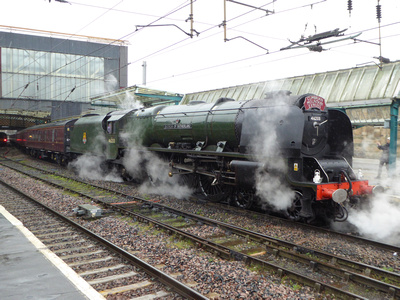 390153 stops at Carlisle with 9M55 Glasgow Central - London Euston
390153 stops at Carlisle with 9M55 Glasgow Central - London Euston
Colas liveried 60095 heads south through Carlisle with 6V38 Carlisle - Chirk logs
LMS Princess Coronation Class 46233 'Duchess of Sutherland' arrives into Carlisle with 1Z86 London Euston - Carlisle 'Cumbrian Mountain Express'
57311 at Carlisle
350407 stabled on the centre track at Carlisle
LMS Princess Coronation Class 46233 'Duchess of Sutherland' departs Carlisle heading south with 5Z87 Carlisle to Carlisle via Upperby Junction where 46233 will be turned so it is facing the correct way for its return journey south
350402 approaches Carlisle with 1S56 Manchester Airport - Edinburgh First TPE service
37423 approaches Carlisle with 2C45 Barrow in Furness - Carlisle Northern service
150752+150275 head north through Carlisle with 5Z58 Leeds Neville Hill - Kilmarnock Barclay Sidings ECS move
156507 departs Carlisle with 1E76 Glasgow Central - Newcastle Service
66956+66603+66616 pass through Carlisle with 0Y50 Crewe Basford Hall - Carlisle Yard Light engine move
156490+153331 arrive into Carlisle with 2C33 Lancaster - Carlisle service
First TPE liveried 185135 approaches Carlisle with a Manchester Airport - Glasgow Central service
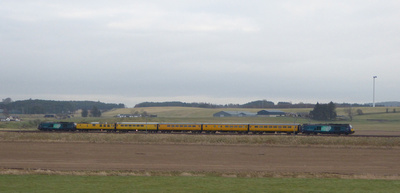 68002 top and tailed with 68004 head south from Carstairs towards Float Viaduct with 1Q26 Edinburgh Craigentinny - Crewe Network Rail test train
68002 top and tailed with 68004 head south from Carstairs towards Float Viaduct with 1Q26 Edinburgh Craigentinny - Crewe Network Rail test train
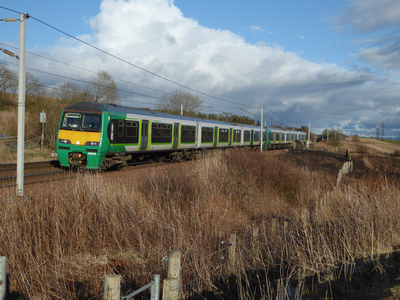 London Midland liveried 320416+320412 (formerly 321416+321412 and reduced from 4 vehicles to 3 vehicles) heads north through Cartland with 2B95 Lanark - Glasgow Central
London Midland liveried 320416+320412 (formerly 321416+321412 and reduced from 4 vehicles to 3 vehicles) heads north through Cartland with 2B95 Lanark - Glasgow Central
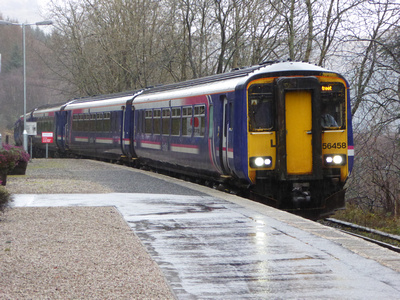 156458+477+500 arrive into Arrochar and Tarbet with 1Y22 Oban - Glasgow Queen Street
156458+477+500 arrive into Arrochar and Tarbet with 1Y22 Oban - Glasgow Queen Street
 London Midland liveried 320411 (formerly 321411 and reduced from 4 vehicles to 3 vehicles) waits in Platform 1 at Carstairs before returning north with 5V00 Polmadie Clydesdale Loop - Polmadie Clydesdale loop via Carstairs
London Midland liveried 320411 (formerly 321411 and reduced from 4 vehicles to 3 vehicles) waits in Platform 1 at Carstairs before returning north with 5V00 Polmadie Clydesdale Loop - Polmadie Clydesdale loop via Carstairs
66515 heads south through Carstairs with 6K10 Montrose - Carlisle Yard engineering working
London Midland liveried 320411 (formerly 321411 and reduced from 4 vehicles to 3 vehicles) heads north through Cartland with 5V00 Polmadie Clydesdale Loop - Polmadie Clydesdale loop via Carstairs
73968 with sleeper stock and 73967 passes Finnieston with 5B01 Polmadie - Oban Sleeper stock ECS move
 67012 in the former colours of Wrexham and Shropshire (minus branding), passes through Uddingston with 5B26 Edinburgh Waverley - Polmadie Sleeper ECS
67012 in the former colours of Wrexham and Shropshire (minus branding), passes through Uddingston with 5B26 Edinburgh Waverley - Polmadie Sleeper ECS
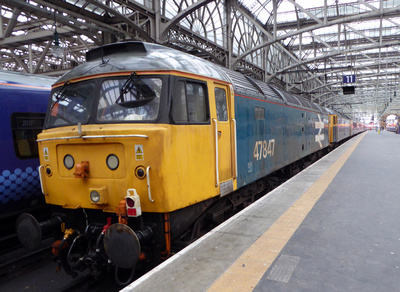 47847+47812 at Platform 11 in Glasgow Central, having arrived with 1S26 London Euston - Glasgow Central Caledonian Sleeper. Both locos worked from Carlisle to Glasgow Central via the Glasgow South Western Line and were about to be hauled out of the station dead on the rear with 92033 working 5S26 to Polmadie
47847+47812 at Platform 11 in Glasgow Central, having arrived with 1S26 London Euston - Glasgow Central Caledonian Sleeper. Both locos worked from Carlisle to Glasgow Central via the Glasgow South Western Line and were about to be hauled out of the station dead on the rear with 92033 working 5S26 to Polmadie
Saltire Liveried 314204 waits to depart Glasgow Central with the 9.12 service to Paisley Canal
Carmine and Cream liveried 314210 prepares to depart with the 9.06 service to Gourock
Caledonian Sleeper liveried 92033 (with 47812 and 47847 dead on rear) prepares to haul 5S26 Glasgow Central - Polmadie sleeper ECS out of platform 11 (seen from 314210)
66176 passes through Kilwinning with 6X65 Didcot - Mossend Car Transporters
320312+318262 arrive into Hamilton West with a Dalmuir - Cumbernauld service
66176 passes through Hamilton West with 6X65 Didcot - Mossend Car Transporters
60087 at Greenfaulds with 6S36 Dalston - Grangemouth tanks
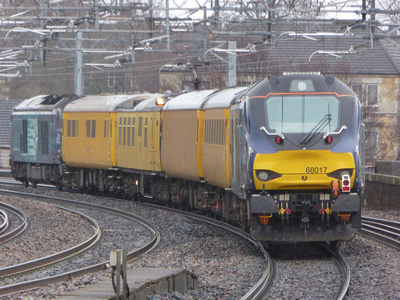 314215 departs Paisley Gilmour Street with a service from Gourock - Glasgow Central
314215 departs Paisley Gilmour Street with a service from Gourock - Glasgow Central
380109 at Paisley Gilmour Street
68004 top and tailed with 68017 pass through Paisley Gilmour Street with 1Q18 Crewe LNWR - Mossend
66303+66422 heads north through Troon with the diverted 4S43 Daventry - Mossend Stobart intermodal
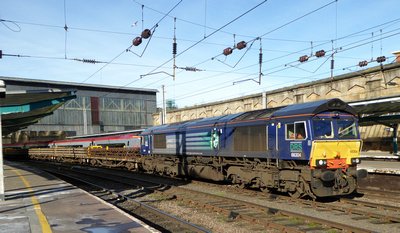 66427+66425 head north through Carlisle with 0xxx Tyne Yard - Carlisle Kingmoor Light Engine move
66427+66425 head north through Carlisle with 0xxx Tyne Yard - Carlisle Kingmoor Light Engine move
66616 passes through Carlisle with 0E54 Carlisle Yard - Leeds Balm Road light engine move
Tamper DR73941 prepares to reverse at Carlisle with 6J51 Kilwinning - Beattock
390107 approaches Carlisle with a service from London Euston - Carlisle
Pacer 142052 waits to depart Carlisle with a service for Barrow in Furness
90040+90039 head south through Carlisle with 4M25 Mossend - Daventry Intermodal
66304 passes through Carlisle with 6K05 Carlisle Yard - Crewe Basford Hall
Network Rail liveried 43014+43013 arrive into Carlisle with 1Q36 Heaton - Derby Test train
66145 heads south through Carlisle with an unidentified working
60095 heads south through Carlisle with 6J37 Carlisle Yard - Chirk Logs
37409 departs Carlisle with 2C34 Carlisle - Barrow in Furness Northern Rail Service
156505 approaches Carlisle with 1S74 Newcastle - Glasgow Central
390046 departs Carlisle with a service from Carlisle - London Euston
66305 heads south through Carlisle with 6K27 Carlisle Yard - Crewe Basford Hall engineers working
90047 stabled at Carlisle
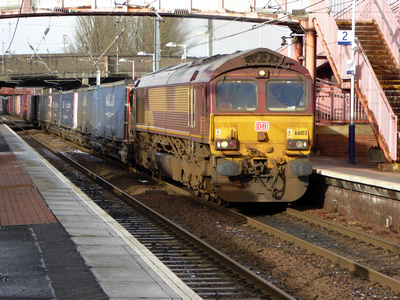 66016 passes through Whifflet with 6X65 Didcot - Mossend Wagonload
66016 passes through Whifflet with 6X65 Didcot - Mossend Wagonload
66103 passes through Whifflet with 4M30 Grangemouth - Daventry intermodal
Caledonian Sleeper liveried 92010 seen stabled at Polmadie (photo taken through the fence at Jessie Street)
Caledonian Sleeper liveried 73966 and 73968 seen stabled at Polmadie (photo taken through the fence at Jessie Street)
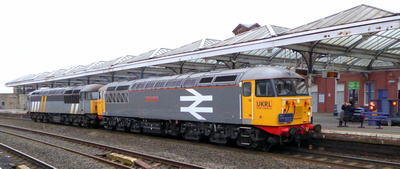 BR Railfreight Grey 56098 and Fastline liveried 56301 pass through Kilmarnock with 0Z56 Leicester L.I.P - Kilmarnock Bonnyton Depot light engine movement
BR Railfreight Grey 56098 and Fastline liveried 56301 pass through Kilmarnock with 0Z56 Leicester L.I.P - Kilmarnock Bonnyton Depot light engine movement
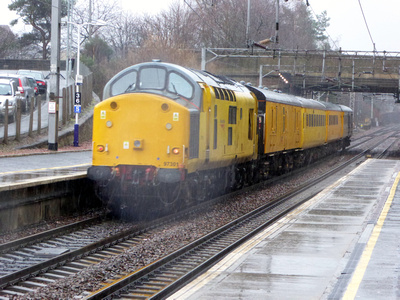 Network Rail yellow liveried 97301 on the rear of DBSO 9703 pass through Uddingston with 1Q05 Mossend Down Yard - Mossend Down Yard via Kilmarnock, Kilwinning and Glasgow Central
Network Rail yellow liveried 97301 on the rear of DBSO 9703 pass through Uddingston with 1Q05 Mossend Down Yard - Mossend Down Yard via Kilmarnock, Kilwinning and Glasgow Central
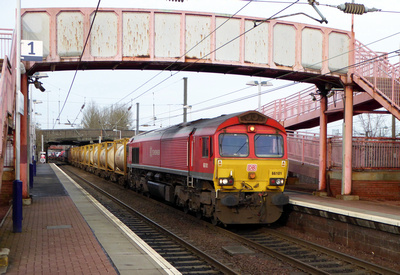 Diverted via the Glasgow and South Western line due to the bridge closure at Lamington, DB Schenker liveried 66101 passes through Whifflet with the diverted 6X65 Didcot - Mossend car transporters
Diverted via the Glasgow and South Western line due to the bridge closure at Lamington, DB Schenker liveried 66101 passes through Whifflet with the diverted 6X65 Didcot - Mossend car transporters
Freightliner liveried 66953 heads north through Greenfaulds with 6G06 Hunterston - Longannet loaded coal
Colas Liveried 60021 heads east through Hartwood with 6S01 Carlisle Bruntwood - Oxwellmains Cement working
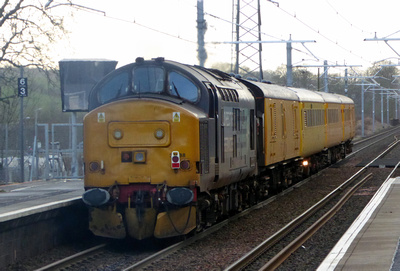 37688 on the rear of a test train with DBSO 9703 leading, pass through Greenfaulds with 1Q05 Inverness - Craigentinny Network Rail test train
37688 on the rear of a test train with DBSO 9703 leading, pass through Greenfaulds with 1Q05 Inverness - Craigentinny Network Rail test train
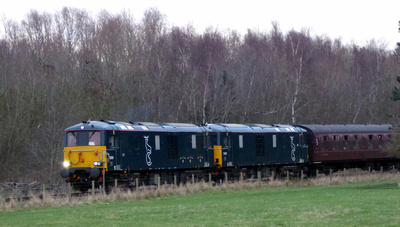 I had a very quick visit to the Diesel Gala at Boness on Saturday. As well as the home fleet being there, visiting locos included Colas liveried 56113 and GBRF's Caledonian Sleeper liveried 73/9's 73966 and 73967.
I had a very quick visit to the Diesel Gala at Boness on Saturday. As well as the home fleet being there, visiting locos included Colas liveried 56113 and GBRF's Caledonian Sleeper liveried 73/9's 73966 and 73967.
Unfortunately I could only stay around 30 minutes but managed to get a few photos, mainly of the 73's.
My photos can be found here http://scottishtrains.zenfolio.com/p749320916
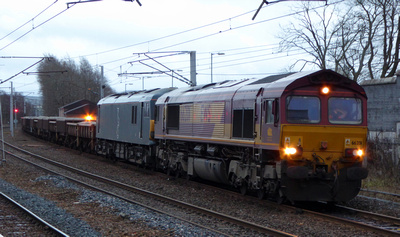 92033 failed with 6S51 and had to be rescued and towed back to Mossend by 66201. 66201 with 92033 dead in tow waits on the Down Goods Loop at Carstairs with the late running 6S51 Carlisle Yard - Mossend Departmental working.
92033 failed with 6S51 and had to be rescued and towed back to Mossend by 66201. 66201 with 92033 dead in tow waits on the Down Goods Loop at Carstairs with the late running 6S51 Carlisle Yard - Mossend Departmental working.
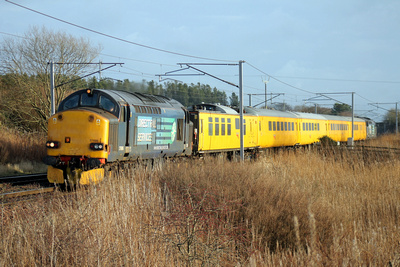 DRS liveried 37606 top and tailed with 37612 pass through Cartland with 1Q26 Derby R.T.C - Edinburgh via Glasgow Central and Aberdeen test train
DRS liveried 37606 top and tailed with 37612 pass through Cartland with 1Q26 Derby R.T.C - Edinburgh via Glasgow Central and Aberdeen test train
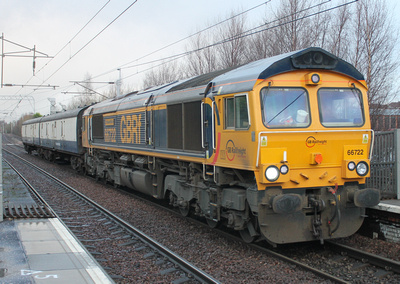 66722 and 2 Translator vans head south through Coatbridge Central with 5Z66 Springburn - Polmadie Translator van move
66722 and 2 Translator vans head south through Coatbridge Central with 5Z66 Springburn - Polmadie Translator van move
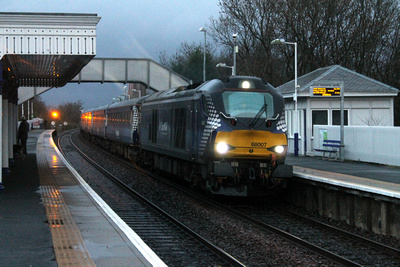 158734 arrives at Dalmeny with 2K05 Edinburgh - Glenrothes with Thornton service
158734 arrives at Dalmeny with 2K05 Edinburgh - Glenrothes with Thornton service
Virgin liveried 43314+43308 pass through Dalmeny with the late running 1S11 Kings Cross - Aberdeen Service
158730 approaches Dalmeny with 2K30 Glenrothes with Thornton - Edinburgh Waverley
EWS liveried 67008 top and tailed with 67021 with mixed ex Virgin and Anglia liveried Mark 2 coaching stock passes through Dalmeny with 1Z71 Haymarket - Inverkeithing Forth Bridge Closure, extra working
158789+158xxx+158868 pass through Dalmeny with 1L06 Perth - Edinburgh Waverley
158719 arrives at Dalmeny with 2G75 Edinburgh Waverley - Glenrothes with Thornton
Scotrail liveried 68007 top and tailed with 68006 and Scotrail mark 2 coaching stock passes through Dalmeny with 1Z18 Cowdenbeath - Haymarket Forth Bridge Closure extra working
 57601 heads north away from Abington with 1Z07 Lancaster - Spean Bridge charter train
57601 heads north away from Abington with 1Z07 Lancaster - Spean Bridge charter train
Caledonian Sleeper liveried 92018 heads north past Crawford with 6S51 Carlisle Yard - Mossend departmental working
37611+37608 heads south towards Crawford with 6M22 Hunterston - Sellafield flask working
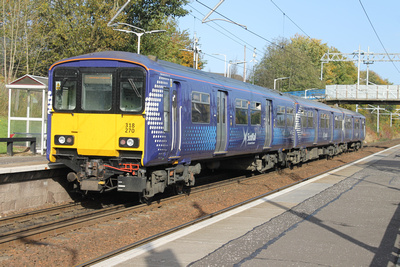 334020 prepares to depart Greenfaulds with a Dalmuir - Cumbernauld service
334020 prepares to depart Greenfaulds with a Dalmuir - Cumbernauld service
66057 heads south through Greenfaulds with 4J06 Longannet - Hunterston empty coal wagons
Saltire liveried 318251 prepares to depart Greenfaulds with a Dalmuir - Cumbernauld service
66140 approaches Greenfaulds 6G06 Hunterston - Longannet loaded coal
334001 prepares to depart Greenfaulds with a service from Dalmuir - Cumbernauld
156509 arrives at Greenfaulds with a Queen Street - Falkirk Grahamston
37667 heads south through Greenfaulds with 1Q06 Inverness - Slateford test train
318270 prepares to depart Greenfaulds with a Dalmuir - Cumbernauld service
66165 heads north through Greenfaulds with 6G07 Hunterston - Longannet loaded coal
66086 heads north through Greenfaulds with 4N30 Mossend - Grangemouth containers
Colas liveried 60076 heads north through Greenfaulds with 6S36 Dalston - Grangemouth empty tankers
68007 passes through Holytown with 5G13 Motherwell TMD - Edinburgh Waverley ECS move
68003 with 66303 and 2x Scotrail liveried Mark 2's in tow head south through Holytown with a Motherwell TMD - Carlisle Kingmoor ECS working
68006 passes through Hartwood with 5L69 Motherwell TMD - Edinburgh Waverley ECS
 1863 built A5 Class 0-4-0 tender engine Furness Railway number 20, Britain's oldest working Standard Gauge Steam Locomotive, seen at Boness on 22.10.15, where it is currently on loan for the Steam Gala taking place on 24th and 25th October.
1863 built A5 Class 0-4-0 tender engine Furness Railway number 20, Britain's oldest working Standard Gauge Steam Locomotive, seen at Boness on 22.10.15, where it is currently on loan for the Steam Gala taking place on 24th and 25th October.
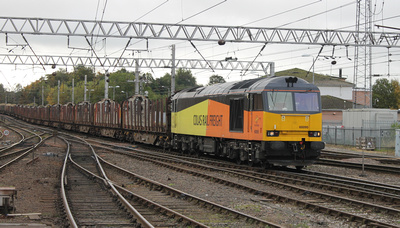 66536 heads north through Carlisle with 4Z54 Daventry - Coatbridge Central Containers
66536 heads north through Carlisle with 4Z54 Daventry - Coatbridge Central Containers
66305+66421 head north through Carlisle with 4S43 Daventry - Mossend Stobart Containers
Colas liveried 60095 heads north through Carlisle with 6Z37 Chirk - Carlisle Yard empty log wagons
37259 heads south through Carlisle with 4Z44 Longtown MOD - Crewe wagon move
66548 top and tailed with 66422 approach Carlisle with 3J11 Carlisle Yard - Carlisle Yard RHTT Train
66429 heads south through Carlisle with 6K05 Carlisle Yard - Crewe Departmental working
66518 heads north through Carlisle with 4S41 Fiddlers Ferry - Hunterston empty coal wagons
66423 heads south through Carlisle with 4M10 Coatbridge - Daventry Intermodal
DB Schenker liveried 60074 heads south through Carlisle with 0E50 Carlisle Yard - Tyne Yard light engine working
37409 on the rear of DBSO 9707 and train at Carlisle heading south with 2C34 Carlisle - Barrow service
66424 heads north through Carlisle with 6C28 Shap Harrison's Siding - Carlisle Yard ballast working
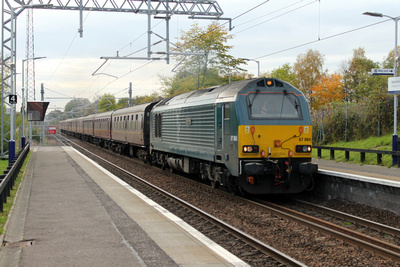 The first day of a week off and plenty of freight and locomotives going around
The first day of a week off and plenty of freight and locomotives going around
92018 on 5B26 Edinburgh - Polmadie Sleeper ECS at Cartland
66176 on 4S99 Tees Dock - Mossend Containers at Cartland
37667 on 1Q06 Slateford - Inverness Test train at Greenfaulds
66515 tnt 66506 on 6K40 Bridge of Orchy - Mossend Engineers at Gartcosh
67004 on 5Z25 Millerhill - Boness ECS working at Greenfaulds
66165 on 6G07 Hunterston - Longannet loaded coal at Greenfaulds
66105 on 4N30 Mossend - Grangemouth containers at Greenfaulds
92032 on 6S51 Carlisle Yard - Mossend Departmental at Holytown
68007 on 5G13 Motherwell TMD - Edinburgh Waverley ECS move at Holytown
66176+66040 on 4E99 Mossend - Tees Dock Containers at Holytown
68003 on 5L69 Motherwell TMD - Edinburgh Waverley ECS move at Hartwood
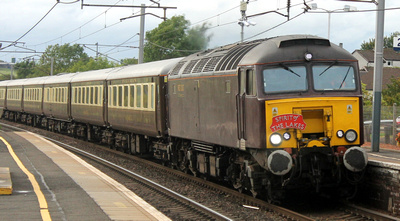 57315 top and tailed with 47786 passes through Carluke with 1Z88 Dundee - Preston 'Spirit of the Lakes' charter
57315 top and tailed with 47786 passes through Carluke with 1Z88 Dundee - Preston 'Spirit of the Lakes' charter
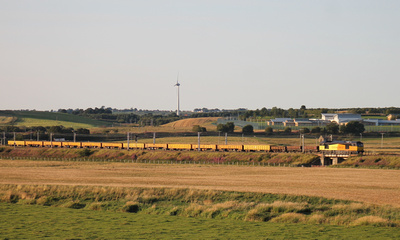 Colas liveried 60085 accelerates away from Carstairs South Junction with 6K18 Dumfries - Carlisle Yard via Motherwell engineering train
Colas liveried 60085 accelerates away from Carstairs South Junction with 6K18 Dumfries - Carlisle Yard via Motherwell engineering train
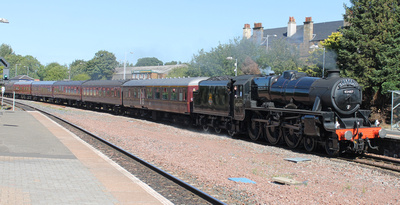 Black 5 45407 'The Lancashire Fusilier' passes through Larbert with 1Z29 Linlithgow - Inverkeithing Forth Circle SRPS Railtour
Black 5 45407 'The Lancashire Fusilier' passes through Larbert with 1Z29 Linlithgow - Inverkeithing Forth Circle SRPS Railtour
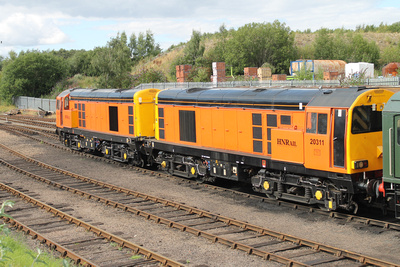 Photos from a visit to Barrowhill can be found here
Photos from a visit to Barrowhill can be found here
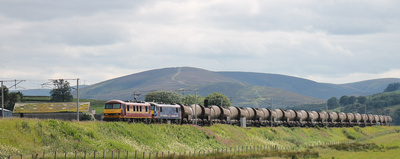 London Transport Museum advert liveried 66718 'Sir Peter Hendy CBE' head north from Crawford with 6S50 Carlisle Yard - Millerhill engineers
London Transport Museum advert liveried 66718 'Sir Peter Hendy CBE' head north from Crawford with 6S50 Carlisle Yard - Millerhill engineers
57009+57010 wait in the up loop at Abington with 6M22 Hunterston - Sellafield flask train
66553 heads north through Wandel with 4S41 Fiddlers Ferry - Hunterston empty coal
90037+90021 head north through Wandel with 6S94 Dollands Moor - Irvine Slurry Tankers
86632+86627 head south from Abington with 4M74 Coatbridge - Crewe Basford Hall intermodal
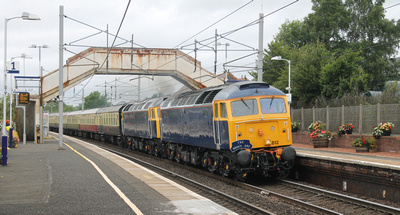 47812+47843 and mark 1's with 66736 dead on the rear heads south through Carluke with 1Z69 Glasgow Central - York via Carlisle and Newcastle (It then continues from York to Crewe as 1Z70) 'Noah's Arc' charity tour
47812+47843 and mark 1's with 66736 dead on the rear heads south through Carluke with 1Z69 Glasgow Central - York via Carlisle and Newcastle (It then continues from York to Crewe as 1Z70) 'Noah's Arc' charity tour
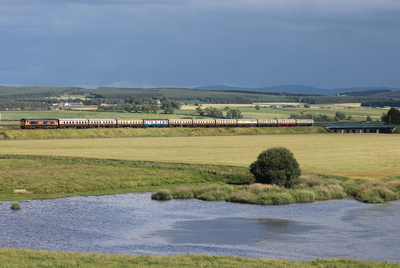 66736 heads north towards Carstairs with 5S67 Crewe - Polmadie ECS movement
66736 heads north towards Carstairs with 5S67 Crewe - Polmadie ECS movement
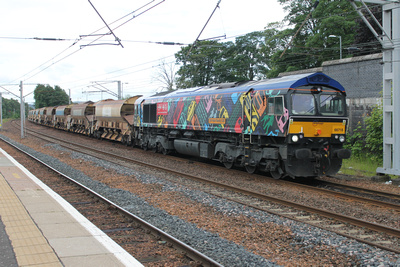 London Transport Museum advert liveried 66718 'Sir Peter Hendy CBE' at Carstairs with autoballasters on 6Z07 Carlisle Yard - Mossend engineers
London Transport Museum advert liveried 66718 'Sir Peter Hendy CBE' at Carstairs with autoballasters on 6Z07 Carlisle Yard - Mossend engineers
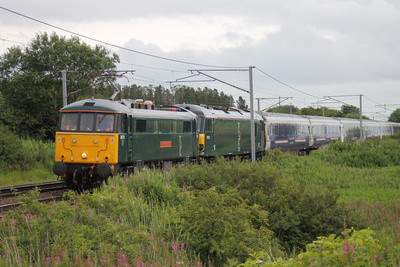 Following 92023 breaking down near Carlisle with the north bound sleeper service, 86101 was sent to rescue the loco and stock. 86101 with 92023 dead in tow, pass Cartland heading north with 5S26 Carlisle - Polmadie Sleeper ECS
Following 92023 breaking down near Carlisle with the north bound sleeper service, 86101 was sent to rescue the loco and stock. 86101 with 92023 dead in tow, pass Cartland heading north with 5S26 Carlisle - Polmadie Sleeper ECS
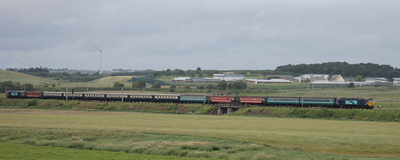 57310 top and tailed with 57301 accelerates away from Carstairs South Junction with 5Z82 Prestonpans - Crewe ECS move
57310 top and tailed with 57301 accelerates away from Carstairs South Junction with 5Z82 Prestonpans - Crewe ECS move
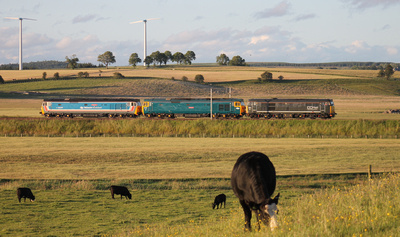 DCR liveried 31601 'Devon Diesel Society' with BR blue liveried 50007 'Hercules' and Network South East liveried 50017 'Royal Oak' dead in tow heading south from Carstairs South Junction towards Float with 0Z50 Boness - Carlisle Yard
DCR liveried 31601 'Devon Diesel Society' with BR blue liveried 50007 'Hercules' and Network South East liveried 50017 'Royal Oak' dead in tow heading south from Carstairs South Junction towards Float with 0Z50 Boness - Carlisle Yard
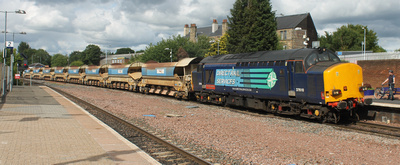 37610 and autoballasters with 66111 and 66432 dead on rear of the train at Larbert with 6K40 Georgemas Junction - Millerhill engineers
37610 and autoballasters with 66111 and 66432 dead on rear of the train at Larbert with 6K40 Georgemas Junction - Millerhill engineers
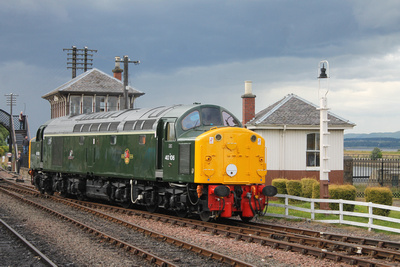 The Boness July Diesel Gala was an excellent weekend with 5 visiting locos including 55022 (disguised as 55003 'Meld' on Saturday and 55007 'Pinza' on Sunday), DCR's 31601, BR Green Liveried 40106, BR Blue liveried 50007 and Network South East liveried 50017.
The Boness July Diesel Gala was an excellent weekend with 5 visiting locos including 55022 (disguised as 55003 'Meld' on Saturday and 55007 'Pinza' on Sunday), DCR's 31601, BR Green Liveried 40106, BR Blue liveried 50007 and Network South East liveried 50017.
Home Fleet locos D2767, D3558, 20020, 26038 and 37703 also worked services.
Photos from the gala can be found here
 91122 in Temporary Virgin East Coast Livery heads north through Prestonpans with 1S10 London Kings Cross - Edinburgh
91122 in Temporary Virgin East Coast Livery heads north through Prestonpans with 1S10 London Kings Cross - Edinburgh
91126 on the rear of 82220 and train heading south through Prestonpans with 1E18 Edinburgh Waverley - London Kings Cross
An unidentified class 221 heads south through Prestonpans with 1V66 Glasgow Central - Plymouth
Newly reliveried into Virgin East Coast livery, 43251 and 43317 head north through Prestonpans with 1S11 London Kings Cross - Aberdeen
91102 on the rear of 82207 and train head south through Prestonpans with 1E19 Edinburgh Waverley - London Kings Cross
I went down to Carlisle for the day on 18th July for the DRS open day at Carlisle Kingmoor. There was a number of locos on display including 57011, 47712, 37401, 37603, 57009,20304, 66304, 47813, 66302, 47828, 57307, 66422, 37606, 57312 and 68003. The undoubted highlight was 47712 in 1980's Scotrail livery and Large Logo liveried 37401.
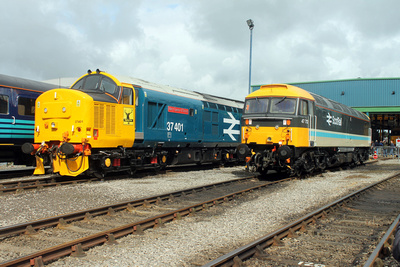 More photos from the Openday can be found here
More photos from the Openday can be found here
Down at Carlisle and some tours had arrived:
LMS Princess Coronation Class 46233 Duchess of Sutherland arrived into Carlisle with 1Z33 Crewe - Carlisle Railtour
47760 then pushed 46233's railtour stock out of Carlisle to the shunt neck
Next 68004 arrived with 1Z68 Newport - Carlisle Pathfinder Railtour
then 66536 headed north through Carlisle with 4C22 Fiddlers Ferry - Carlisle Yard empty coal working
New arrival at Boness, ex DRS 37261 stabled in the yard at Boness TMD on 15th July 2015. As 37261 is heavily stripped, it is likely to take several years to restore back to working order.
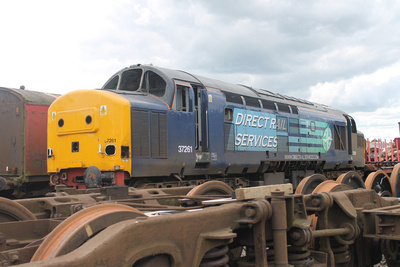
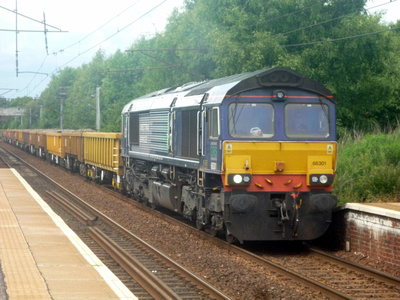 A couple of really late running engineering workings returning from Greenhill Upper heading towards Millerhill were seen on 5th July passing through Holytown a short time after each other.
A couple of really late running engineering workings returning from Greenhill Upper heading towards Millerhill were seen on 5th July passing through Holytown a short time after each other.
First was 66301 passing 218 minutes late with 6K03 Greenhill Upper - Millerhill engineers and followed by 66603 running 116 minutes late with 6K04 Greenhill upper - Millerhill engineers
Spotted at Greenfoot Loop just south of Greenfoot level crossing near Greenfaulds, 66111 top and tailed with 37259 waits to continue its journey northbound with 6K40 Millerhill - Forsinard engineering working.
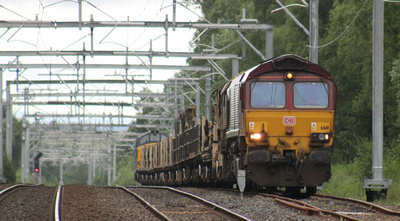
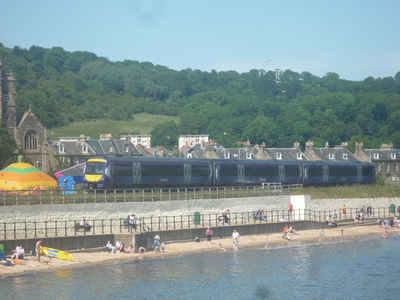 Heading back from holidays up north, we decided to come down the Fife Coast and stop off at Burntisland. Here the railway runs just behind the beach. 2 170's were spotted in the time I was there:
Heading back from holidays up north, we decided to come down the Fife Coast and stop off at Burntisland. Here the railway runs just behind the beach. 2 170's were spotted in the time I was there:
An Unidentified 170 heading northbound and 170471 heading southbound.
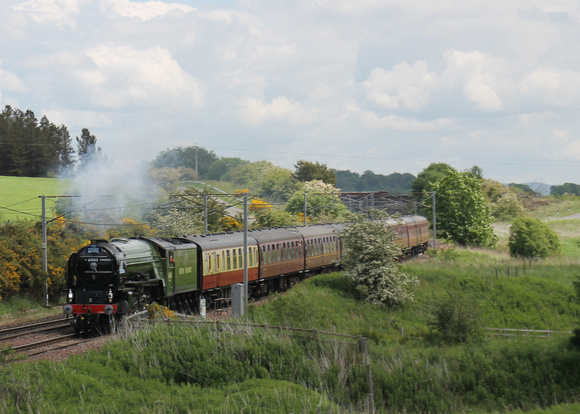 66168 waits in the loop at Carstairs with 6S36 Dalston - Grangemouth oil tankers
66168 waits in the loop at Carstairs with 6S36 Dalston - Grangemouth oil tankers
LNER Peppercorn Class A1 60163 'Tornado' in the passing loop at Carstairs with 1Z51 Carlisle - Carlisle via Paisley and Ayr 'Borders Reivers'
LNER Peppercorn Class A1 60163 'Tornado' passing Cartland with 1Z51 Carlisle - Carlisle via Paisley and Ayr 'Borders Reivers' 27.6.15
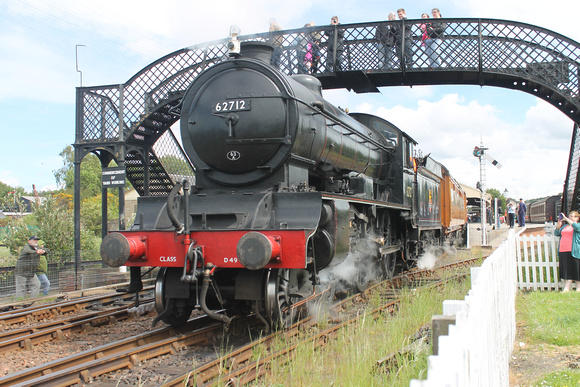 LNER D49 class number 62712 'Morayshire' in BR Black livery departs Boness with a service to Manuel
LNER D49 class number 62712 'Morayshire' in BR Black livery departs Boness with a service to Manuel
National Coal Board Fife Area No 19 and 2 Caledonian carriges at Boness Station
Newly repainted at overhauled for Mainline use, BR Blue 37025 stabled in the yard of the TMD at Boness
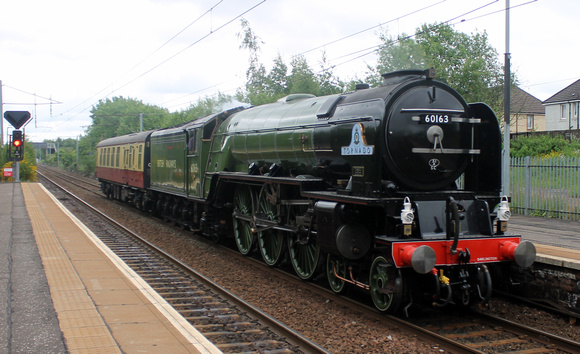 LNER Peppercorn Class A1 60163 'Tornado' passes through Holytown with its support coach on 5Z10 Millerhill - Stirling loco move (it would collect its coaching stock at Mossend)
LNER Peppercorn Class A1 60163 'Tornado' passes through Holytown with its support coach on 5Z10 Millerhill - Stirling loco move (it would collect its coaching stock at Mossend)
67004 passes through Carluke with 5C11 Polmadie - Edinburgh Waverley Sleeper ECS
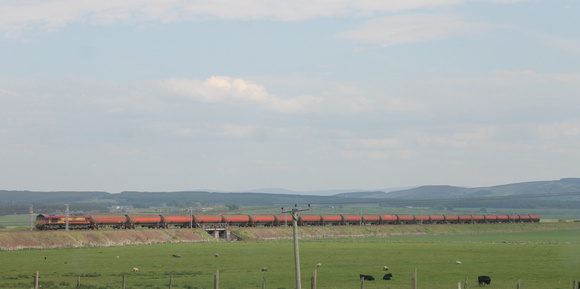 66170 waits a red signal at Carstairs South with 6S16 Robeston - Grangemouth tanker move
66170 waits a red signal at Carstairs South with 6S16 Robeston - Grangemouth tanker move
57316 top and tailed with 47786 arrives into Exhibition Centre with 1Z82 Ayr - Mallaig SRPS Railtour
156492 at Tyndrum with 1Y42 Mallaig - Glasgow Queen Street
47786 on the rear of 57316 at Fort William on 1Z82 Ayr - Mallaig SRPS Railtour
67004 and Sleeper Stock stabled at Fort William
156456+1564xx at Fort William
156453+156465 prepares to depart Fort William with a service to Mallaig
47786 stabled at Fort William
Black 5 45407 'The Lancashire Fusilier' prepares to depart Fort William in torrential rain with 1Z82 Ayr - Mallaig SRPS Railtour
Black 5 45407 'The Lancashire Fusilier' at Mallaig after arriving with the 1Z82 SRPS Railtour from Ayr 6.6.15
Black 5 45407 Black 5 45407 'The Lancashire Fusilier' crossing Glenfinnan Viaduct with 1Z83 SRPS Railtour from Mallaig - Ayr
47847 passes through Hartwood with 5Z47 Craigentinny - Glasgow Works Barrier Vehicle move
57314 approaches Gartcosh with 5Z57 Carnforth - Fort William ECS move 16.5.15
K1 Class 62005 'Lord of the Isles' approaches Hartwood with 5Z57 Grosmont - Dumbarton Loco and support coach working
66050 heads east through Hartwood with 6K05 Holytown Junction - Millerhill via Mossend Engineering working
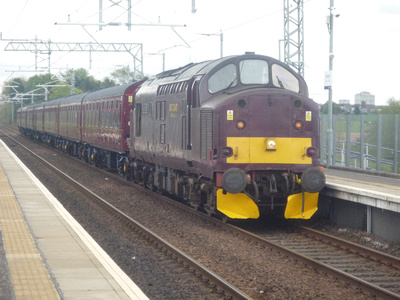 37516 approaches Gartcosh with 5Z51 Carnforth - Fort William via the GSW line Jacobite Coaching Stock ECS working 9.5.15
37516 approaches Gartcosh with 5Z51 Carnforth - Fort William via the GSW line Jacobite Coaching Stock ECS working 9.5.15
Spent the day in Inverness through the free ticket giveaway from Scotrail
The journey started from Motherwell with 320322 forming the 6.17 service to Glasgow Central via Bellshill
Arriving into Central I spotted 66735 topped and tailed with 66732 about to depart Glasgow Central with 1H88 Glasgow Central - Edinburgh Waverley Royal Scotsman. Unfortunately it had left the station by the time 320322 pulled into the platform. 4.5.15
Passing Aviemore, I saw BR 2-6-0 Class 2MT no. 46512 "E. V. Cooper, Engineer" on the Strathspey Railway at Aviemore
Stabled in Platform 1 at Inverness was 67010 newly reliveried into Caledonian Sleeper livery.
Prior to boarding the train home I saw 158721 and 158708 stabled
My train back to Glasgow 170403 with 1T99 Inverness - Glasgow Queen Street
Spotted at Perth was 66305 with 4D47 Inverness - Mossend Stobart intermodal
Last sighting of the day was 90024 stabled at Polmadie
Saw 47847 and 47812 through the fence at Polmadie from an industrail estate at the lineside.
47812 seen stabled at Polmadie Depot (taken from a street just off the M74 Junction 1A next to the Polmadie Car boot sale building) 47812 (and 47847) is due to be used to take / bring the Caledonian Sleeper ECS to / from Glasgow Central 19.4.15
BR Blue Large Logo liveried 47847 seen stabled at Polmadie Depot (taken from a street just off the M74 Junction 1A next to the Polmadie Car boot sale building) 47847 (and 47812) is due to be used to take / bring the Caledonian Sleeper ECS to / from Glasgow Central 19.4.15
some photos taken this week including 87002 at Edinburgh Waverley, 90035 in full sun at Carlisle and 68007 and 68004 on the Fife Circle ECS moves
Monday
156458 arrives at Kilmarnock with a service from Glasgow Central 13.4.15
All over grey liveried GBRF 66 66747 passes through Kilmarnock with 4S48 Doncaster - Greenburn Mining, empty coal working 13.4.15
380021 at Troon with a service from Ayr - Glasgow Central 13.4.15
66736 heads south through Troon with 6H97 Hunterston - Drax loaded coal 13.4.15
Wednesday
92036 heads north through Carlisle with 6S94 Dollands Moor - Caledonian Paper Mill, Irvine Slurry Tankers 15.4.15
66430 heads south through Carlisle with 6K05 Carlisle Yard - Crewe Basford Hall engineers 15.4.15
66849 heads south through Carlisle with 6J37 Carlisle Yard - Chirk loaded timber 15.4.15
66565 heads north through Carlisle with 4S41 Fiddlers Ferry - Hunterston empty coal 15.4.15
66529 heads north through Carlisle with 4S08 York Holgate - New Cumnock Up Law Mining empty coal 15.4.15
66155 heads south through Carlisle with 6E50 Carlisle Yard - Tyne Yard engineers 15.4.15
37605 stabled in Platform 8 at Carlisle 15.4.15
90035 on the centre track at Carlisle before heading south light engine 15.4.15
66129 heads south through Carlisle with an unidentified light engine movement 15.4.15
66549 heads north through Carlisle with 4s42 Fiddlers Ferry - Hunterston empty coal 15.4.15
DRS DBSO at Carlisle Kingmoor 15.4.15
Thursday
Borders Rail all over advert liveried 170414 seen stabled at Haymarket Depot 16.4.15
156457 prepared to depart Anniesland with a service to Glasgow Queen Street via Maryhill 16.4.15
318250 approaches Anniesland with a service from Dalmuir - Motherwell via Hamilton 16.4.15
314201 departs Pasley Gilmour Street with a Gourock - Glasgow Central service 16.4.15
37611+37059 passes through Paisley Gilmour Street with 6M22 Hunterston - Sellafield flasks 16.4.15
Newly refurbished and reliveried 318270 departs Whifflet with an ECS move following it working a Milngavie - Whifflet service 16.4.15
320322 arrives at Whifflet with a Cumbernauld - Milngavie service 16.4.15
Friday
90020+90039 pass through Holytown with 6X65 Didcot - Mossend Car Train 17.4.15
Caledonian Sleeper Liveried 87002 seen stabled in the Motorrail Bay at Edinburgh Waverley 17.4.15
DBSO 9702 leads a test train and 37603 through Holytown with 3Q14 Mossend - Heaton test train move 17.4.15
Scotrail liveried 68007 with matching set of Mark 2's pass through Holytown with 5G13 Motherwell TMD - Edinburgh Waverley Fife Circle ECS move 17.4.15
86605+86639 pass through Holytown with 4M74 Coatbridge - Crewe Basford Hall Freightliner Intermodal 17.4.15
66737 passes through Holytown with 6E45 Fort William - North Blyth Alcans 17.4.15
68004 and the DRS Mark 2 set pass through Holytown with 5L69 Motherwell - Edinburgh Fife Circle ECS working 17.4.15
4.4.15
Ardgarten
67004 1Y11 London Euston - Fort William Sleeper
5.4.15
Arrochar and Tarbert
156493+156466+156456 arrive into Arrochar and Tarbert with 1Y23 Glasgow Queen Street - Oban / Mallaig
156493+156466+156456 depart Arrochar and Tarbert with 1Y23 Glasgow Queen Street - Oban / Mallaig 5.4.15
6.4.15
Arrochar and Tarbert
156492 waits for the arrival of the Northbound Sleeper before departing Arrochar and Tarbert with 1Y20 Oban - Glasgow Queen Street
Caledonian Sleeper liveried 67004 stopped at Arrochar and Tarbert with 1Y11 London Euston - Fort William
Hartwood
Scotrail liveried 68007 with a set of DRS Mark 2 Coaches pass through Hartwood with 5L69 Motherwell TMD - Edinburgh Waverley ECS working 6.4.15
On Friday 10th April, 314206 worked the 18.51 Lanark - Glasgow Central service, covering for a class 380. This is the first time since the December timetable change that saw the Lanark services move into the High Level, that a 314 has operated to Lanark and possibly even the first time since they moved to the Cathcart Circle lines in October 1999 that they have operated here.
I did see it, however didnt have my camera with me so no photo unfortunately
68004 and a set of Scotrail liveried Mark 2 carriages heads east through Holytown with 5G13 Motherwell TMD - Edinburgh Waverley Fife Circle ECS move 8.4.15
66027 passes through Holytown with 0S94 Dollands Moor - Irvine light engine move (possibly started from Carlisle) 8.4.15
86605+86628 heads south through Holytown with 4M74 Coatbridge - Daventry freightliner intermodal 8.4.15
66737 passes through Holytown with 6E45 Fort William - North Blyth Alcans 8.4.15
Scotrail liveried 68006 and DRS liveried Mark 2 coaching stock approaches Hartwood with 5L69 Motherwell TMD - Edinburgh Waverley Fife Circle ECS move 8.4.15
66106 passes through Gartcosh with 6D16 Fort William - Mossend tankers 8.4.15
68006 waits in the loop at Coatbridge Central with 5L70 Cardenden - Motherwell TMD Fife Circle ECS movement 8.4.15
Scotrail liveried 68006 and DRS liveried Mark 2 coaching stock pass through Holytown with 5L69 Motherwell TMD - Edinburgh Waverley Fife Circle ECS move 9.4.15
Carlisle Kingmoor
57305 in Northern Belle Livery seen stabled at Carlisle Kingmoor
The cab of 68006 in Scotrail Saltire livery as seen from the Nature Reserve opposite Carlisle Kingmoor
Mark 2 Carriages in Scotrail Saltire livery seen at Kingmoor
Mark 2 carriage in Scotrail Saltire livery at Carlisle Kingmoor
68006 in Scotrail Saltire livery stabled at Carlisle Kingmoor. Photo taken from a gap in the hedge on the road between Kingmoor and Stainton
Carlisle
46115 'Scots Guardsman' prepares to depart Carlisle with 1Z87 Carlisle - London Euston via the Settle and Carlisle line
Hartwood 7.3.15
66107 passes through Hartwood with 6E69 Georgemas Junction - Hartlepool empty pipe train
Carluke 8.3.15
68003+68002 head south through Carluke with 4M48 Mossend - Daventry Stobart intermodal
Crawford 14.3.15
68004+68002 head north past Crawford with 4S43 Daventry - Mossend Stobart Intermodal
57314 top and tailed with 57313 heads north through Crawford with 1Z63 Cardiff - Fort William Winter Statesman
25.2.15
Dalmeny
68004 5Z68 Motherwell TMD - Motherwell TMD via the Fife Circle
27.2.15
Greenfaulds
66250 6G07 Hunterston - Longannet loaded coal working
Carstairs
86622+86605 4M74 Coatbridge - Crewe Basford Hall intermodal
28.2.15
Holytown
66512 approaches Holytown with 6K10 Ayr - Millerhill engineers working
Uddingston
90037+90018+90019 0B26 Polmadie - Mossend light engine movement
1.3.15
Hartwood
66621 6K12 Mossend - Millerhill Engineering working
66067+66132+66097 0K15 Millerhill - Mossend Light Engine movement
Carluke
66303+66422 head south through Carluke with 4M48 Mossend - Daventry Stobart Containers
Some photos from today
Holytown
68003 4S43 Daventry - Mossend Stobart Containers
Coatbridge Central
66735 6S45 North Blyth - Fort William Alcans
320309+320301 Milngavie - Cumbernauld
Cartland
66301 4S55 Daventry - Mossend Intermodal
320319 Glasgow Central - Lanark
380108 Edinburgh Waverley - Glasgow Central
66761+66723 6K14 Carlisle Yard - Mossend engineers working
A day out at Carlisle 13.2.15
57311 'Thunderbird'
156490 Carlisle - Barrow
68003 4S43 Daventry - Mossend Stobart Containers
350404 Manchester Airport - Glasgow Central
185104+1851xx Edinburgh - Manchester Airport
66525 4S11 Hunslett Yard - Hunterston empty coal working
DR73118 6U52 Carlisle High Wapping Sidings - Warrington Bank Quay
66174 6C20 Workington Docks - Carlisle Yard Silver Bullets
66304 6K05 Carlisle Yard - Crewe Basford Hall engineers working
66849 6J37 Carlisle Yard - Chirk logs
92041 4M25 Mossend - Daventry Intermodal
66551 4S41 Fiddlers Ferry - Hunterston empty coal working
68002
66588 4S08 York - New Cumnock Up Law Mining
68005 1Z68 Carmarthen - Edinburgh 6 Nations Welsh Rugby Fans Charter
68002
68002 1Z68 Carmarthen - Edinburgh 6 Nations Welsh Rugby Fans Charter
Crawford
68002 1Z68 Carmarthen - Edinburgh 6 Nations Welsh Rugby Fans Charter
In the past week, double headed 68's have been working on both the 4S43 Daventry - Mossend and 4M48 return Stobart Container trains.
Seen at Carluke on 8.2.15 is 68004+68007 working 4M48 Mossend - Daventry
Also seen was Saltire liveried 318251 on a Glasgow Central - Lanark service
A few photos from Carstairs from today
3504xx+3504xx Manchester Airport - Edinburgh Waverley
unidentified 390 London Euston - Glasgow Central
3504xx+3504xx Manchester Airport - Glasgow Central
unidentified 390 London Euston - Edinburgh Waverley
66747 6S50 Carlisle Yard - Millerhill Departmental
86638+86628 4M74 Coatbridge - Crewe Basford Hall intermodal
66563 4S41 Fiddlers Ferry - Hunterston empty coal
37259+37602 0K40 Millerhill - Carlisle Kingmoor light engine
97301 heads east through Bargeddie with 1Q22 Falkland Yard - Mossend Yard 5.2.15
Some photos taken today
Hartwood
66105 6E69 Georgemas Junction - Hartlepool empty pipes
Greenfoot Loop
37425 1Q75 Mossend - Inverness Test Train
Greenfaulds
318262 Milngavie - Cumbernauld
37425 1Q75 Mossend - Inverness Test Train
Holytown
66107 0K25 Kilwinning - Millerhill light engine
66204+66115 0T64 Mossend - Carlisle Yard light engine
Summerlee
Dusseldorf 392
311103
image 1
image 2
image 3
image 4
image 5
Some photos from the last few days
Carluke 7.1.15
66126 6E30 Dalziel - Lackenby empty steel
Unidentified 390 14.05 Glasgow Central - London Euston
37688+37605 6M22 Hunterston - Sellafield Flasks
Carstairs 9.1.15
66619 0XXX Oxwelllmains - Carlisle Yard Light Engine
66712 6S50 Carlisle Yard - Millerhill Departmental (Photo 2)
86638+86637 4M74 Coatbridge - Crewe Basford Hall Intermodal (photo 2)
Carluke 10.1.15
66422 6K11 Glengarnock - Carlisle Yard engineering
Hartwood 10.1.15
66425 tnt 66426 6K10 Glengarnock - Millerhill engineering
Here is GBRF's 66712 approaching Carstairs South Junction in the setting sun on 30.12.14 with 6S50 Carlisle Yard - Millerhill Departmental
66712 picture 1
66712 picture 2
66712 picture 3
Cartland
320319 15.20 Lanark - Glasgow Central
350404 15.05 Glasgow Central - Manchester Airport
320318 14.50 Glasgow Central - Lanark
Some photographs from this weekend's excellent Diesel Gala at Boness over the weekend, including Colas's 56105 and 66849, 55022, DCR's 31601 and GBRF's London Underground liveried 66721
D3558
http://scottishtrain....b8c3#h1060b8c3
20020
http://scottishtrain....74c1#h141f74c1
26038
http://scottishtrain....84d29#hde84d29
31601
http://scottishtrain...86f818#h986f818
http://scottishtrain....920ea#he3920ea
http://scottishtrain....17ce#h1a4317ce
37025
http://scottishtrain....5ba8c#h4b5ba8c
37403
http://scottishtrain....c0b81#h2fc0b81
http://scottishtrain....2f0e#h16c42f0e
37518
http://scottishtrain....a01f#h12a4a01f
37703
http://scottishtrain...0a5279#h90a5279
47643
http://scottishtrain....4ab31#h824ab31
http://scottishtrain....e37f#h1a53e37f
55022
http://scottishtrain....09c01#h5609c01
http://scottishtrain....ac7fb#hedac7fb
http://scottishtrain....6d19#h15046d19
http://scottishtrain....0d00#h145f0d00
56105
http://scottishtrain....b09d#h124cb09d
http://scottishtrain....5dc6#h12af5dc6
66721
http://scottishtrain....4931#h1eaa4931
http://scottishtrain....112e#h1a58112e
http://scottishtrain....f8ed5#h8df8ed5
66849
http://scottishtrain....5e4a#h15ba5e4a
http://scottishtrain....0614e#h150614e
303032
http://scottishtrain...88bb0#h15d88bb0
LMS Stanier 8F 45170 was built in 1942 as one of the 25 locomotives sold to the Turkish State Railway during the 2nd World War and was still in operation until the 1980's. 45170 was recovered from Sivas in Turkey by the Churchill 8F Trust in 2010 and moved to Shildon for a while. It was then purchased and will eventually be returned to operating condition by the SRPS and moved to Boness on 13.11.14. 45170 was shunted up and down the platform then into the loop by recently restored 0-6-0 Austerity British Coal Board No 19. Click on the link below for photos
Photos of 45170, no 19 and 68009
Here are my photos from the week of 20th - 25th October
20.10.14
Crawford
66422 0Z23 Carlisle Kingmoor - Slateford Light Engine
66302 6M49 Millerhilll - Carlisle Yard Departmental
66846 6Z66 Mossend - Carlisle Yard Engineers
Greenfaulds
66113 6D61 Riccarton - Grangemouth empty tanks
Camelon
170403 Edinburgh - Dunblane
57313 5Z75 Craigentinny - Gleneagles Royal Scotsman ECS
Greenfaulds
66077 4J08 Longannet - Hunterston empty coal
21.10.14
66737 6E45 North Blyth - Fort William Alcans
43306+43320 Aberdeen - Kings Cross
380103 North Berwick - Edinburgh Waverley
67028 6B45 Powderhall - Oxwellmains Bin Liner
Unidentified 221 Plymouth - Aberdeen
380109 Edinburgh Waverley - North Berwick
221121 Aberdeen - Penzance
220005+2200xx Birmingham - Aberdeen
91132 Edinburgh Waverley - London Kings Cross
220007 Aberdeen - Penzance
91117Edinburgh Waverley - Kings Cross
43317+43308 Aberdeen - Kings Cross
90039+66187 6X60 Millerhill - Tyne Yard empty rail carriers
66733 0S49 Tyne Yard - Millerhill Light Engine
67028 6B46 Oxwellmains - Powderhall Binliner
91101 Edinburgh Waverley - London Kings Cross
221118 Aberdeen - Penzance
43277+43319 Kings Cross - Aberdeen
91110 Edinburgh Waverley - London Kings Cross
221112 Penzance - Aberdeen
37425+37682 6M50 Torness - Carlisle Yard Nuclear Flasks
Carlisle 22.10.14
66232 6C25 Shap Quarry - Carlisle Yard Stone Working
350403 Manchester Airport - Glasgow Central
66423+66428 3J11 Carlisle Kingmoor - Carlisle Kingmoor RHTT
37409 5Z69 Carlisle Kingmoor - Crewe Gresty Bridge
350407 Glasgow Central - Manchester Airport
92024 4S43 Daventry - Mossend Stobart Containers
92037 0S94 Dollands Moor - Mossend light engine
68006 Kingmoor - Carlisle Yard loco test
66424 6K05 Carlisle Yard - Crewe Basford Hall engineers
92005 4M83 Coatbridge - Crewe Basford Hall intermodal
66507 4S41 Sudforth - Hunterston empty coal
66018 0E90 Carlisle Yard - Tyne Yard light engine
66005 0M76 Warrington Arpley - Carlisle Yard light engine
66232 0F76 Carlisle Yard - Warrington Arpley Light engine
Stoneblower
57302 6K27 Carlisle Yard - Crewe Basford Hall Ballast Train
66005 6V71 Carlisle Yard - Margam Stone working
66067 4S93 Milford West Sidings - Hunterston empty coal
24.10.14
Crawford
37608+37409 Hunterston - Sellafield Nuclear Flasks
66507 4S41 Drax - Hunterston empty coal
25.10.14
Hartwood
47790 tnt 57312 1Z38 Glasgow Central - Dunfermilne Northern Belle Lunch trip
Carluke
62005 5Z89 Fort William - Carnforth Loco Move
Some freight and a Diverted East Coast HST seen today and more
Crawford
92037 4S43 Daventry - Mossend Stobart Containers
43239+43206 Aberdeen - Kings Cross Diverted East Coast HST
350404 Edinburgh - Manchester Airport
350410 Manchester Airport - Glasgow Central
66101 4M16 Grangemouth - Daventry Intermodal
Cartland
47804+47786 1Z78 Crewe - Oban Compass Railtour
318264 17.23 Lanark - Dalmuir via Bellshill (new Saltire livery)
66550 tnt 66507 6Z20 Carlisle Yard - Mossend Engineers
I spent the weekend in Blackpool and luckily not only was the weather great but also Balloon 701 was being officially launched in its Heritage Routemaster Livery with a journey to Fleetwood.
701 approaching North Pier
701 at North Pier
701 arriving at Bispham
701 at Bispham
736 on an Illuminations Tour
737 on an Illuminations Tour
701 on an illuminations tour
Flexity 006 at Cabin
Flexity 014 at Cabin
Brush Car 290 (627) at Pleasure Beach
Flexity 016 at Burlington Road West
Flexity 006 at Cabin
Balloon 717 on an illumination tour
700, 717 and T2 at Rigby Road
Western Train at Cabin
Western Train at Rigby Road
Flexity 005 at Starr Gate
http://scottishtrain....4377#h36394377
The first of the Unbranded Chiltern liveried class 68s to run in Scotland, 68014 heads south through Greenfaulds with 4D47 Inverness - Mossend DRS Intermodal 23.9.14
Some photos from 20 minutes around Float Viaduct just south of Carstairs Junction.
92037 4S43 Daventry - Mossend Stobart Containers
390126 Edinburgh Waverley - London Euston
350401 Glasgow Central - Manchester Airport
68006+68005 0Z20 Motherwell TMD - Carlisle Kingmoor
Picture 2
61994 'Great Marquess' was seen at Carstairs earlier today with 1Z56 Preston - Glasgow Central 'The West Highlander'. Here are my photos
61994 in down goods loop being refilled with water
350410 passes by on the down main with a Manchester Airport - Glasgow Central Service
61994 departs heading north towards Glasgow
66002 heads north with 6S00 Carlisle Yard - Mossend Slurry Tanks
66421 heads south with 4M82 Coatbridge - Daventry DRS Intermodal
On Saturday I went on the Perth - York Compass Railtour. Here are my photos from the trip.
Wishaw
47804 tnt 47245 1Z08 Perth - York Compass Railtour
Carlisle Yard
66004
66104
Tyne Yard
66078 and 66120
Darlington
Unidentified 142
North of York
Unidentified DCR Class 31
York Station
68002
47804 tnt 47245
158860
158118
91106 and 158754
47245
82211
47804
221130
220008
185134
91127
185129
150134
37405
37423
185112
43277
47245
47804
222016
Near Leeds
Drax power station HTAs
Leeds Midland Road
Lineup of 66's
Lineup of 66's (2)
Line up of 66's (3)
Line up of 66's (4)
Engine Shed Junction Leeds
333014
Carlisle Kingmoor
68007
National Railway Museum Photos
I went up to Boness for the running night to mark 37703's debut on the passenger service at Boness.
37703 was leading with 20020 tucked in behind for brakeforce.
here are some photos from Boness
75254 stabled outside the steam shed
303032 stabled in the yard
37703+20020 arrive into Boness with a service from Manuel
37703 pauses by the steam shed whilst running round its train
Closely followed by 20020
37703+20020 wait before leaving the loop
and another pic of 37703+20020 waiting to leave the loop
20020+37703 arrive into the platform
37703+20020 waiting to depart with 6.15 service to Manuel
37703+20020 head along the shore at Boness
37703+20020 arrive at Manuel
37703 runs round at Manuel
closely followed by 20020
37703+20020 couple up again
68006 is seen passing through Gain Road near Cumbernauld with 4D47 Inverness - Mossend
I saw 68005 again today at Coatbridge Central on 4D47 Inverness - Mossend, though typically the sun vanished as it approached the station and reappeared after it passed the station.
http://scottishtrain....2ddd#h31022ddd
37425 3Z18 Carlisle Wapping - Inverness Test Train passing Magiscroft
My first sighting of a Class 68 on the Main Line, 68005 is seen working 4D47 Inverness - Mossend Intermodal past Gain Road near Cumbernauld
http://scottishtrain....1e34#h15651e34
Some photos from Carlisle taken on 23.7.14
Kingmoor
47832 with its Northern Belle Livery painted out
47802
Carlisle
57304
66238 6C25 Shap Quarry - Carlisle Yard loaded hoppers
350401
66847 6J37 Carlisle Yard - Chirk logs
350407
92002 4S43 Daventry - Mossend Stobart Containers
66302 0K05 Carlisle Yard - Crewe Basford Hall
48151 1Z52 Lancaster - Carlisle Fellsman Tour
London Midlands 350474 on hire to TPE on the rear of First TPE's 350404 at Carlisle with a service for Manchester Airport
37518
92030 6S94 Dollands Moor - Irvine slurry tanks
37518 with Fellsman coaches
66021 6E50 Carlisle Yard - Tyne Yard
142049
66419+66558 Tebay - Upperby Junction light engine
66305 passes 48151 at Carlisle as it heads south with 0F76 Carlisle Yard - Warrington Arpley
48151
156442
66535 4S08 York - New Cummnock Law mining empty coal
390030
66561 4S42 Fiddlers Ferry - Hunterston empty coal
158784
48151 1Z53 Carlisle - Lancaster Fellsman Charter
Here is 37025 at Boness, it is currently having work done to allow it to operate Railtours on Network Rail lines http://scottishtrain....b14e#h3597b14e
Here is 37703 newly arrived at Boness http://scottishtrain....c4e1#h3283c4e1
Here is 37518 and Black 5 45231 at Coatbridge and Holytown with 5Z46 Fort William - Carnforth empty stock move
http://scottishtrain....c4e1#h33c48326
http://scottishtrain....c4e1#h3aeeb476
37606 top and tailed with 20304 at Float with 6M50 Torness - Sellafield Nuclear Flasks
37602+37259 and Autoballasters at Hartwood with 6K16 Tain - Millerhill Engineers
67025 top and tailed 67030 pass through Polmont with 1Q01 Heaton - Derby via Glasgow Queen Street Network Rail Test Train 7.7.14
http://scottishtrain...413e9#h16d413e9
37610+37259 seen heading south through Greenfaulds with Autoballasters on 6K41 Achnasheen to Millerhill engineering working.
Also seen were
334033 Cumbernauld - Dalmuir
66114 6D18 Grangemouth - Mossend petrol tankers
Also seen were
334033 Cumbernauld - Dalmuir
66114 6D18 Grangemouth - Mossend petrol tankers
334004 Dalmuir - Cumbernauld
Here is 37218 in the new DRS livery at Float Viaduct near Carstairs as part of 6M50 Torness - Sellafield Nuclear Flasks
Other Sightings - Float Viaduct
Uid 390 Glasgow - London Euston
Uid 350 Manchester Airport - Glasgow Central
UID 325 1S03 Shieldmuir - Warrington Mail
UID 221 Glasgow - London via Birmingham
37218 tnt 37603 6M50 Torness - Sellafield Nuclear Flasks
92019 6O15 Mossend - Eastleigh Empty Cars
Carluke
86614+86627 4M11 Coatbridge - Crewe Basford Hall Intermodal
92030 4M48 Mossend - Daventry Stobart Containers
Not the best of photos but here is DRS's new class 68, 68003 stabled at Motherwell TMD, seen from the B&Q carpark 26.6.14
http://scottishtrain...156ea#h3ee156ea
Camelon
158712 Edinburgh - Dunblane
66421 4Z40 Grangemouth - Motherwell TMD empty flats
158740+158728 Edinburgh - Dunblane
158721 Dunblane - Edinburgh
66168 6S36 Dalston - Grangemouth Empty tankers
66103 tnt 66111 6K20 Mossend - Tomatin engineers
Falkirk Wheel
170477 unidentified working
Greenfaulds
66086 6G08 Hunterston - Longannet loaded coal
334036 Cumbernauld - Dalmuir
66213 4J08 Hunterston - Longannet empty coal
Coatbridge Central
320317 Motherwell - Cumbernauld
37602+605 1Z57 Fort William - London Euston '3 peaks challenge' railtour
37419 passing through Larbert with 1Q13 Craigentinny - Inverness Network Rail Test Train 11.5.14
http://scottishtrain...e3a7d#h13ce3a7d
Some Photos from today
Coatbridge
44871 tnt 45407 5Z45 Cadder Yard - Bury ECS
86605+86637 0M11 Mossend - Coatbridge
Holytown
92043 6S51 Carlisle Yard - Mossend Departmental
45407 tnt 44871 5Z45 Cadder Yard - Bury ECS
Carluke
45407 tnt 44871 5Z45 Cadder Yard - Bury ECS
Hartwood
66617 6B34 Viewpark - Oxwellmains empty cement
Carluke
86637+86605 4M11 Coatbridge - Crewe Basford Hall Intermodal
92019 4M48 Mossend - Daventry Stobart Containers
60009 'Union of South Africa' at North Queensferry with 1Z30 Linlithgow - Linlithgow SRPS Forth Circle tour
A couple of hours this afternoon saw alot of action with 60009 'Union of South Africa' being prepared for the SRPS Forth Circle Tour
WD75254 brought a service from Manuel into the station whilst the small diesel shunter moved 60009 around and brought a newly outshopped in BR Black 62712 'Morayshire'
37401 was also see and 47804 shunting the tour stock
60009
75254
62712
37401
47804
More photos at http://scottishtrain...o.com/p24898377
60009 'Union of South Africa' seen passing through Carluke with 5Z10 Carlisle - Boness loco and support coach earlier this evening
A few photos from today including no fewer than 4 x 37s!
Carstairs
92032 6S51 Carlisle Yard - Mossend Departmental
Cartland
92032 6S51 Carlisle Yard - Mossend Departmental
Carstairs South Junction
37516+37706 0Z33 Carnforth - Millerhill Light Engine
Float Viaduct
37409+37604 6M22 Hunterston - Sellafield Nuclear Flask Train
Auchengray
unidentified 221 Glasgow - Plymouth
37706 tnt 37516 5Z16 Millerhill - Carnforth Mail Vans
37419 and a Network Rail Test train timed to operate at 30mph worked 3Q15 Carlisle Yard - Mossend via the GSW and Ayrshire coast on 14.4.14.
Here it is at
Troon
Kilmarnock
Kilwinning
55002 passed through Dalmeny this evening with 1Z60 Aberdeen - York 'Deltic Aberdonian'
Here is a photo of it
55022 1Z60 - Aberdeen - York Deltic Aberdonian
Some photos taken on 11.4.14
Coatbridge Central
55022 6Z55 Glasgow Works - EG Steel (Hamilton)
Newton
55022 6Z56 EG Steel - Yoker
Magiscroft
320320 Springburn - Cumbernauld driver training
37706+47854 0z58 Carnforth - Boness Groundframe
66301 0M82 Grangemouth - Coatbridge Central Light Engine
66068 4J06 Hunterston - Longannet Loaded Coal
66110 6S36 Dalston - Grangemouth empty tanks
Holytown
92039 4S43 Daventry - Mossend Stobart Containers
Greenfaulds
66427 4N66 Coatbridge - Grangemouth Containers
Hartwood
66617 6B34 Viewpark - Oxwellmains Empty Cement Tanks
During a visit to Manchester on 10.4.14, I travelled around on the Metrolink system. Here are some of my photos
Picadilly Undercroft
3064
Cornbrook
3069
3012
Old Trafford
3023
Trafford Depot
1013
1026
1008
1004 or 1006
1013
1019
1014
1019 and 1020
2002
2002 and 2 unidentified T68's
1015
3054
3061
1021
1021 and 2 other T68s possibly 1017 and 1002?
3061+3054
Old Trafford
3045
3030 + 3028
3003
Queens Road Depot
1007, 1016, 2001, 1023
Bury
3034
3042+3027
Picadilly Gardens
3071
3073
Deansgate-Castlefield
3068
3004+3047
3060
Picadilly
3023
Some pictures from a day out in Manchester / Crewe
Carlisle
66510
East Lancashire Railway
37109 Picture 1 Picture 2
33109 Picture 1, Picture 2, Picture 3
33109, D1501 (47402), D9009 (55009)
Manchester Picadilly
170304
323227
175106
Crewe
60056
60028
08507
60038 and 60044
47853
60029
60044
60038
57309
350114
Manchester Picadilly
185132
158774+886
185107
323225
175104
158846+858
150205
150150
185106
156464
150267
Some Photos from Holytown and Boness from Wednesday
Holytown
9701 tnt 37601 1Q13 Craigentinny - Craigentinny test train
318254+318262 Milngavie - Lanark
Boness
37175 and 37401
20020
27001
25235
26004
303032
Holytown
92032 6S51 Carlisle Yard - Mossend Departmental
Some photos of the Trams at Beamish. Sunderland 101 (Ex Blackpool Balloon 703) and Blackpool Ex Towing Railcoach 280 (680) were in service.
Grimsby and Immingham 26 - Picture 1, Picture 2
Beamish 196 - Picture 1
Pantograph 167 - Picture 1, Picture 2
Ex Towing Railcoach 280 -Picture 1, Picture 2, Picture 3, Picture 4, Picture 5, Picture 6, Picture 7, Picture 8, Picture 9
Sunderland 101: Picture 1, Picture 2, Picture 3, Picture 4, Picture 5, Picture 6, Picture 7
Some photos from just over 1 hour at Greenfaulds on 7.4.14
66304 4N66 Coatbridge - Grangemouth containers
158720 Cumbernauld - Glasgow Queen Street
320301 Springburn - Cumbernauld Driver Training
170408 Glasgow Queen Street - Falkirk Grahamston
156495 Glasgow Queen Street - Cumbernauld
66068 4J08 Longannet - Hunterston empty coal
320301 Springburn - Cumbernauld Driver Training
66103 6D17 Grangemouth - Mossend empty tanks
Friday - Edinburgh
Tram 265 - Princes Street, St Andrews Square
Video of 265 at Princes Street
Edinburgh Waverley
67021
334026+334032
Saturday - Carluke
390121
66069 6S36 Dalston - Grangemouth empty tanks
Sunday - Hartwood
66099 6K02 Linlithgow - Mossend engineers
Holytown
66124 6K04 Linlithgow - Mossend engineers
http://scottishtrain....5ce8#h29052d29 6K08 Mossend - Linlithgow engineers
Carluke
320314
Unidentifed 221
Unidentified 390
66152+66124 0K04 Mossend - Carlisle Yard
BR Blue Large Logo Liveried 37401 'Mary Queen of Scots' seen at Boness during the 37401 running day at Boness
http://scottishtrain....com/p915909583
I had a visit to Carlisle yesterday and a very short visit to the Eden Valley and Stainmore railways before stopping off at Greenfaulds on my way home. Here are some of my sightings
Carlisle
66550 4M75 Leeds - Carlisle Empty Coal
92002 4S43 Daventry - Mossend Stobart intermodal
66426 4M44 Mossend - Daventry DRS Intermodal
350401 Manchester Airport - Glasgow Central
Carlisle Kingmoor
66xxx Crewe Basford Hall - Carlisle Yard
390xxx Glasgow Central - London Euston
Appleby
4979
Eden Valley Railway
37042
Ex 3rd Rail unit 2315
931105 and 2311
Stainmore Railway Kirby Stephen
31410
37674
47785
Greenfaulds
56078 6Z56 Aviemore - Mossend
66100 6D61 Riccarton - Grangemouth tanks
Here is DCR Railways BR Green liveried 31190 at Carstairs earlier tonight with 6Z41 Taunton - Mossend Railvac Move
Photo
http://scottishtrain....5148#h26b25148
Video
http://www.youtube.c....ature=youtu.be
Happy New Year to everyone.
Continuing on from a pair of 86's operating on 6S51 Carlisle Yard - Mossend (A GBRF working) on 31st December. Today we had a rare Combo of BR Blue Liveried 87002 and GBRF's 92010 both been driven seperately.
Here they are in the down goods loop at Carstairs
photo 1
Photo 2
Photo 3
Photo 4
Photo 5
Photo 6
and passing through Holytown
Photo 1
Whilst waiting for the train into Glasgow this morning at Uddingston, I saw the following
90029+90035 5B26 Polmodie - Mossend light engine
350403 11.10 Glasgow Central - Manchester Airport (only its 2nd run in service)
On to Holytown this afternoon and a couple of rare moves
57011+57009 6Z57 Carlisle Yard - Mossend Departmental
92030 4S43 Daventry - Mossend Stobart Containers
86605+86632 6S51 Carlisle Yard - Mossend Departmental (Freightliner 86's working in place of GBRF 92010 which failed)
57009+57011 0Z57 Mossend - Carlisle Kingmoor light engine move
This weekend was the Diesel Gala at Boness. Featuring were
26038
37175 - Making its final runs in preservation before going off to join the Colas fleet
37401 - making its preservation debut in BR Large logo livery and named 'Mary Queen of Scots'
47643
55022 - Deltic
56105 - Colas Liveried
56312 - DCR Grey Liveried
Here are my photos
26038
http://scottishtrain....5c96#h28e75c96
http://scottishtrain....5c96#h285b00d7
http://scottishtrain....5c96#h390f6347
http://scottishtrain....5c96#h2c4c159d
http://scottishtrain....5c96#h259a0491
http://scottishtrain....5c96#h3cf65efc
37175
http://scottishtrain....5c96#h2ae78cf1
http://scottishtrain....5c96#h274d4b91
http://scottishtrain....5c96#h2fb74b16
http://scottishtrain....5c96#h36adaa42
http://scottishtrain....5c96#h359524d8
http://scottishtrain....5c96#h27e6c0cf
37401
http://scottishtrain....5c96#h3d12713e
http://scottishtrain....5c96#h284527b4
http://scottishtrain....5c96#h24601d02
http://scottishtrain....5c96#h21d525d6
http://scottishtrain....5c96#h30eaa4c7
http://scottishtrain....5c96#h303f4c8f
http://scottishtrain....5c96#h23d44eed
http://scottishtrain....5c96#h396f919f
47643
http://scottishtrain....5c96#h215c3a36
http://scottishtrain....5c96#h22ba599e
55022
http://scottishtrain....5c96#h3d54dcc4
http://scottishtrain....5c96#h3cd687be
http://scottishtrain....5c96#h21e99a1b
56105
http://scottishtrain....5c96#h25827c19
http://scottishtrain....5c96#h33f78625
http://scottishtrain....5c96#h22c72769
56312
http://scottishtrain....5c96#h2ef9098c
http://scottishtrain....5c96#h2bf6df51
http://scottishtrain....5c96#h20a1b117
http://scottishtrain....5c96#h344cb919
On way back from an over night at Edinburgh, my train was over 30 minutes late in arriving into Edinburgh Waverley, so managed to get a bit of time to get some photos in the station.
Here are my sightings
221133+221xxx Glasgow Central - Plymouth
90019 stabled in Motorrail sidings
67016 towing Sky 1 HD Set in from Craigentinny
91125 in Sky 1 HD livery
Mark 4 in Sky HD Livery
82216 in Sky 1 HD livery
380102 in Platform 4
380105 at Platform 3
170417
170458
91101 Flying Scotsman Livery in Platform 2
I went to Carstairs this afternoon to catch a very colourful lineup on 4X25 Carlisle Yard - Mossend containers. The consist had EWS liveried 66181 leading with Grey 92029, DBS Red 90029 and Royal Liveried 67006 Dead in Tow. This working usually runs overnight as 4S25 from Daventry (I think) - Mossend, however 92029 which was hauling the consist north failed and the train was left at Carlisle Yard, leaving at 12.35 to head north to Mossend.
Here are some photos of the lineup:
Photo 1 - arriving in the down loop
Photo 2 - view from the footbridge
Photo 3 - waiting at the signal on the down loop
Photo 4 - heading north
Other sightings
380102 - North Berwick - Glasgow Central
92030 - 4S43 Daventry - Mossend Stobart Intermodal
37611+605 6M22 Hunterston - Sellafield Flasks
47501 tnt 47832 heads north at Abington with 1Z47 Crewe - Edinburgh Northern Belle
Between Crawford and Abington
Photo 1
Photo 2
Abington Loop
Photo 1
66007 Carlisle - Millerhill Engineers
Camelon
66433 4Z40 Grangemouth - Motherwell Tmd
158732 Dunblane - Edinburgh
66213 6S36 Dalston - Grangemouth empty tankers
Some photos from an hour at a freezing cold Holytown
unidentified RHTT vehicle passes through Holytown with 3S93 Slateford Depot to Slateford Depot RHTT vehicle
92029 passes through Holytown with 4S43 Daventry - Mossend Stobart Intermodal
37688 with 66427 DIT pass through Holytown with 0Z37 Cotbridge Central - Carlisle Kingmoor loco move
66736 heads south through Holytown with 6E45 Fort William - North Blyth Alcans
66525 heads north through Holytown with 4Z28 Fiddlers Ferry - Hunterston empty coal
92015 passes through Carluke with 4M48 Mossend - Daventry Stobart Containers 10.11.13
Diverted East Coast HST's seen between Abington and Crawford
The diversions were via the Cobbinshaw line from Edinburgh - Carstairs East Junction, then via the West Coast Main Line to Carlisle then along the Tyne Valley line to Newcastle then back on route from there
43318+43314 1F20 Newcastle - Edinburgh
43251+43257 1E13 Inverness - London Kings Cross
Also seen near Thankerton was
66101 6S36 Dalston - Grangemouth Empty Tanks
Some photos of freight in Ayrshire from earlier today
66108 at Paisley Gilmour Street 6G05 Hunterston - Longannet loaded coal
66598 at Kilwinning with 4S34 Leeds - Hunterston empty coal
66165 at Kilwinning with 6G07 Hunterston - Longannet loaded coal
37218 +37402 at Kilwinning with 6M22 Hunterston - Sellafield Flask train
66150 at Kilwinning with 4J06 Longannet - Hunterston empty coal
Some photos and a visit from Carlisle from today
66168 Carlisle - Oxenholme light engine movement
66301 4M44 Mossend - Daventry DRS Intermodal
92002 4S43 Daventry - Mossend Stobart Intermodal
66005 6S36 Dalston - Grangemouth empty tankers
66305 6K05 Carlisle Yard - Crewe Basford Hall departmental
45699 'Galatea' 1Z86 London Euston - Carlisle
56087 6J37 Carlisle Yard - Chirk log train
66595 4Z28 Fiddlers Ferry - Hunterston empty coal
66168+66198 6Z81 Oxenholme - Carlisle departmental
66150 6S94 Dollands Moor - Irvine Paper Mill slurry working
66066 4S70 Milford - Hunterston Empty coal
45699 'Galatea' 1Z89 Carlisle - London Euston
66535 6C28 Shap Summit - Carlisle Yard
66520 6M21 Hunterston - Ratcliffe loaded coal
66559 4S42 Fiddlers Ferry - Hunterston empty coal
Video of 45699 departing Carlisle
Some photos from Coatbridge , Summerlee and Holytown
Photos include 66011, Dusseldorf 392 and 92002 on the intermodal on hire to DRS
Photos here
Another shot of 55022 from earlier today at Croy
also
92039 with 90035 and 90036 DIT at Uddingston heading to Mossend with 5B26 Polmodie - Mossend
47818 with 47832 tnt with 1Z32 Helensburgh - Crewe Northern Belle
66097 4D31 Elgin - Mossend Whisky Train at Greenfaulds
Some photos from the running night at Boness
56105 + 47643 top and tailed with 26038 on the rear approaching Boness
26038 on the rear of 56105 and 47643
56105 preparing to go to the diesel depot for refuelling
26038 with 47643 dead on the rear heads along the shore of the River Forth towards Manuel
Photos from the DRS Open Day at Carlisle http://scottishtrain....com/p538349660
Photos include Cable thieves liveried 57307, 37425, 37604, 37038, 66434 and more
some photos from Boness and Holytown yesterday http://scottishtrain...com/p1042329668
Uddingston
320318 Dalmuir - Motherwell
37609+37409 6M22 Hunterston - Sellafield Nuclear Flasks
Magiscroft
158735 Falkirk Grahamston - Glasgow Queen Street
158702 Cumbernauld - Glasgow Queen Street
37218+37423 6z52 Strathcarron - Mossend empty ballast
Holytown
66622 6B34 Viewpark - Oxwellmains empty cement
I went to Carlisle today, here are my sightings
142023 Carlisle - Newcastle
66305 4M44 Mossend - Daventry Intermodal
66432+66433 4S43 Daventry - Mossend Stobart Containers
66113 6C27 Carlisle Yard - Shap Summit Quarry departmental
66431 6K05 Carlisle Yard - Crewe Basford Hall Departmental
390127 Glasgow Central - London Euston
390117 London Euston - Glasgow Central
44932+45231 1Z52 Lancaster - Carlisle 15 Guinea Fellsman
70013 6C16 Crewe Basford Hall - Carlisle Yard departmental
44932+45231 preparing to shunt into sidings next to platform 1
66056 6Z56 Shap Summit Quarry - Carlisle Yard Departmental
66529 4Z28 Fiddlers Ferry - Hunterston Empty coal wagons
350252 5C82 Preston - Carlisle Driver Trainer
31106 3Z03 Mossend - Derby RTC Test Train
44932+45231 preparing to shunt from siding into Platform 3
70013 6K27 Carlisle Yard - Crewe Basford Hall Departmental
44932+45231 1Z53 Carlisle - Lancaster 15 Guinea Fellsman
86259 'Les Ross' was at Edinburgh Waverley earlier with 1Z86 London Euston - Edinburgh Waverley and departed with 5Z86 at Southall
Here are some photos of it
86259
Number plate
Motif
Name Plate
90026 in the Motorrail bay
67021 in the Motorrail bay
334038+031
Some photos from today
Bellshill
67022 with 90021+90039 DIT 0B26 Polmodie - Mossend loco move
Hillend Loch
334016 Helensburgh - Edinburgh Waverley
Some photos from today
Bellshill
320305 Dalmuir - Motherwell
Cathcart
314208 Cathcart Inner Circle
314202 Newton - Glasgow Central via Maxwell Park
314210 Neilston - Glasgow Central (I've been trying to photo 210 for over 4 years now! My last 314 needed!)
Holytown
57004+012 4M82 Coatbridge - Daventry DRS Intermodal
66617 6B34 Viewpark - Oxwellmains Empty Cement
GBRF have now taken over the 6M49 Mossend - Carlisle Yard and 6S51 Carlisle Yard - Mossend Departmental workings from DBS. This working was almost exclusively worked by a class 92 under DBS and this looks to be continuing under GBRF. This week 92044 has been in charge of these workings, here it is at Holytown this afternoon. 92011 was the final loco to operate these workings for DBS (it was also the last loco to work 4S43 / 4M48 Daventry - Mossend and return Stobart Containers for DBS before DRS took it over last year)
92044 6S51 Carlisle Yard - Mossend Departmental
Some photos from Holytown last week including a pair of 57's on 4M82 Coatbridge - Daventry Intermodal
I was at Holytown earlier to catch the 2 37's on the Intermodal, here are my sightings
320308+318252 Milngaive - Lanark
66304+429 4S43 Daventry - Mossend Stobart Containers
66546 4S31 York - Hunterston Empty Coal
318258 Milngavie - Lanark
37602+606 4M82 Coatbridge - Daventry DRS intermodal
320320 Lanark - Milngavie
156509 Glasgow - Edinburgh
37425+37423 with 37409 seen earlier this afternoon passing south through Carluke with 5Z75 Aberdeen - Crewe Northern Belle ECS working
37425+37423 with 37409 5Z75 Aberdeen - Crewe Northern Belle ECS
Some rail photos from my holiday in Hamburg last week
Hamburg Rail photos
also photos from the worlds largest Model Railway in Hamburg
66850 6N47 Prestwick - Grangemouth empty oil tankers
Some photos from today
Dalmeny
170477 Glenrothes - Edinburgh Waverley
Edinburgh Waverley
334033
67008
90028
43357+43368 Bath - Edinburgh
43xxx+43290 Kings Cross - Inverness
Carluke
318263 Milngavie - Lanark
90026 5C11 Polmodie - Edinburgh Waverley Sleeper ECS
66426 0XXX Grangemouth - Carlisle Light Engine
Some photos from the last couple of days
Holytown
92039 6S51 Carlisle Yard - Mossend Departmental
Greenfaulds
158729 Motherwell - Cumbernauld
66103 6S36 Dalston - Grangemouth Empty Tanks
Hartwood
66107 6K01 Mossend - Cumbernauld via Shotts Engineering
Shotts
66102 6K02 Mossend - Cumbernauld via Shotts Engineering
A photo of DBS Liveried 60062 'Stainless Pioneer' passing through Carluke. The first Class 60 in Scotland in 11 months.
60062 6T03 Carlisle Yard - Mossend Auto Ballasters
I stopped off at Carluke for around 15 minutes between 9.40 and 9.55pm tonight
66614 6M61 Hunterston - Fiddlers Ferry Loaded Coal
92039 6M76 Mossend - Warrington Arpley Containers
433xx+43367 Plymouth - Glasgow Central XC
I went to Carluke yesterday and caught
37608+37259 1Z57 Fort William - London Euston 3 peaks tour
nipped up again today and caught newly reliveried 66001 in DBS Red
66001 0XXX Carlisle Yard - Mossend Light engine
I had hoped to catch 56301 which was supossed to be heading south from Mossend - Doncaster at 5pm, however it left at 11.45am more that 5 hours early and I missed it ![]()
Good news from Blackpool, 9 of the trams from the LTT owned fleet: Balloons 704, 715, Brush Cars 259 and 632, OMO 8, Coronation 304, Rocket 732, Standard 143 and Railcoach 279(679) are all returning to the Main Depot at Rigby Road following the LTT and Blackpool Transport reaching a deal . 4 of the 9 are in outside storage, 2 trams have already arrived at Rigby Road, 1 is on display as part of the illuminations and 2 are in the LTT sheds. Of the 9 trams, 715, 632, 8 and 304 could probably run without too much if any work being carried out on them, whilst 143 and 279 will need quite a bit of work done and the other 3 will need major overhauls.
Spent a long weekend in a warm and sunny Blackpool. I managed to spot 14 of the 16 Flexities, the only 2 I didnt see were 001 and 003.
Here are my photos
002 - Photo 1, Photo 2
004 - Photo 1, Photo 2, Photo 3
005 - Photo 1, photo 2, Photo 3
006 - Photo 1
008 - Photo 1, Photo 2
009 - Photo 1, Photo 2
011 - Photo 1, Photo 2
012 - Photo 1, Photo 2
013 - Photo 1, Photo 2, Photo 3
014 - Photo 1
015 - Photo 1, Photo 2, Photo 3
016 - Photo 1
Unfortunately none of the Heritage fleet were out but there was still plenty to see
Rigby Road Depot
Balloon 700 seen in the depot, this was the first time I'd seen this livery properly in the flesh on a Balloon and I quite like it, think it suits the Balloons
Photo 1
Standard 147
Photo 1
T2 (682) was seen peeking out of the depot
Photo 1
Rocket 732 was seen on display on the Roundabout at Gynn Square
Photo 1, Photo 2
Brush Car 627 on display at Pleasure Beach
Photo 1, Photo 2, photo 3
Broadwater Caravan Park
Centenary 643 in its new guise as a cafe, the livery is sort of like the 50's livery on a Coronation, livery suits the tram
Photo 1, Photo 2, Photo 3
Jacksons Yard
Twin Towing Car 671 seen at Jacksons Yard
Photo 1, Photo 2
Burton Road
OMO 8, Brush 632 and 259 and Balloons 704 and 715 are all stored in the open here, unfortunatley they seem to have had some of their windows smashed.
OMO 8
Brush 632
632, 704 and 715
704 and 715
I took my wee cousin along to the Day out with Thomas at Boness today, here are some photos of the day
Thomas
Photo1 Photo 2 Photo 3
Photo 4
Photo 5
Photo 6
Percy
photo 1 Photo 2
Henry
Photo 1
WD75254
Photo 1 Photo 2 Photo 3 Photo 4
37175
Photo 1 Photo 2
Diesel
Photo 1 Photo 2
Photo 3 Photo 4
Photo 5
Some photos from Holytown from yesterday
66304+66305 4S43 Daventry - Mossend Stobart Containers
92039 0Z28 Carlisle Yard - Mossend Light Engine
66434 4M82 Coatridge - Daventry DRS Intermodal
66606 4Z28 Fiddlers Ferry - Hunterston Empty Coal
66602 6B34 Viewpark - Oxwellmains Cement
Some engineers trains from this morning
66110 6K12 Mossend - Curriehill
66044 6K11 Mossend - Kirknewton
66101 tnt 66165 6K10 Mossend - Kirknewton
Was in Perth earlier and saw ex Blackpool Unrefurbished Balloon 716 at Ptarmigan Transport Solutions yard.
There was a notice in the window saying that it would be restored internally and externally and would receive some mahogany tables and be used as a meeting room.
716 (1)
716 (2)
716 (3)
716 (4)
716 (5)
716 (6)
716 (7)
716 (8)
716 (9)
I went to Dalmeny to catch Union of South Africa. Here are my photos
60009 photo 1 photo 2
Then I went to Boness
246 'Morayshire'
27001
303032
47643
Class 126
Engine (possibly from a 37?)
Class 126 (1 vehicle)
D3558
37401
37401 (2)
47786 and 47237
47786
47237
37401 (3)
Lady Victoria
D3558 and 20020
47237
303032 (2)
27001(2)
27001(3)
60009 photo 1 photo 2
Then I went to Boness
246 'Morayshire'
27001
303032
47643
Class 126
Engine (possibly from a 37?)
Class 126 (1 vehicle)
D3558
37401
37401 (2)
47786 and 47237
47786
47237
37401 (3)
Lady Victoria
D3558 and 20020
47237
303032 (2)
27001(2)
27001(3)
Some photos from Holytown and Greenfaulds from today
Holytown
66433+66429 4S43 Daventry - Mossend Stobart Containers
320311+3182xx Milngavie - Lanark
66735 6S45 Fort William - North Blyth Alcans
92037 6S51 Carlisle Yard - Mossend Departmental
Greenfaulds
158734 Cumbernauld - Queen St
170395 Queen St - Falkirk Grahamston
I went to Carstairs earlier to catch 60009 and 61994 working 5Z94 York - Thornton Yard loco move. Here are my photos
60009+61994 arrive in the down goods loop to take on water
390110 pass by on the down Fast line with a Euston - Glasgow Central service
60009 and 61994 taking on water in the down goods loop
Just as the locos were about to move:
66616 passes through with 6Z71 Ravenstruther - Ratcliffe loaded coal and stops at the signal beyond platform 1 blocking off a large portion of the platform
A quick dash up the platform allows the following 3 shots of 60009 and 61994 departing
Photo1
Photo2
Photo3
I headed out to Prestonpans for the first time today to catch Alycidon heading into Edinburgh, first few photos are from the station, the next few are from the lineside and right on cue, the sun disappeared behind a large cloud before 67007 passed and reappeared after Alycidon passed! Alycidon looked stunning, and its the first time I've seen a Deltic on the mainline and 1st time I've seen 67007 so was a good day out.
Here are my sightings
380105 North Berwick - Edinburgh Waverley
82206 + 91130 Edinburgh Waverley - London Kings Cross
91124 Kings Cross - Edinburgh
67007 6B44 Oxwellmains - Powderhall empty Binliner
170460 Edinburgh Waverley - Dunbar
D9009 (55009)'Alycidon' 1Z55 Crewe - Edinburgh 'the Ediyn Burgh Scot' Pathfinder tour
380108 Glasgow Central - North Berwick
Some photos of Edinburgh Trams at Gogar Depot 3.4.13
Photos
I spent the weekend in the Lake District and visited the Lakeside and Haverthwaite Railway on Saturday.
Here is a link to my photos http://scottishtrain...o.com/f56703399
I went to the bitterly cold Boness and Kinneil Railway earlier today, here are some photos including 37401
37175
Shunters
37175 (2)
Percy
303032
Class 126
Unidentified Steam loco
British Gypsum Shunter
D2767
26024
D3558
20020
26004
37401
37401(2)
47643
37401(3)
unidentified Steam Loco
27001
Boness Station
246 + 75254
246 + 75254(2)
27001(2)
246 'Morayshire'
WD75254
WD75254(2)
Some photos from Friday and Saturday at Holytown, Uddingston and Coatbridge
Holytown 15.3.13
156433 Edinburgh - Glasgow Express
92002 6S51 Carlisle Yard - Mossend Departmental
156505 Glasgow - Edinburgh Express
66737 6S45 Fort William - North Blyth Empty Alcans
66520 4Z28 Fiddlers Ferry - Hunterston empty coal
66424 4M82 Coatbridge - Daventry DRS Intermodal
Uddingston 16.3.13
320318+318260 Dalmuir - Motherwell
47826+47854 1Z58 Fort William - Milton Keynes Central Charter
Coatbridge Central 16.3.13
66005 6G07 Hunterston - Longannet loaded coal
http://scottishtrain....f934#h5859fb50 6C20 Longannet - Carstairs empty coal
156500 Motherwell - Cumbernauld
66111 6S36 Dalston - Grangemouth Empty Tanks
Here are some photos from Holytown yesterday
92039 6S51 Carlisle Yard - Mossend Departmental
66415 4Z28 Fiddlers Ferry - Hunterston Empty Coal
334040 Milngavie - Lanark
66301 4M82 Coatbridge - Daventry DRS Intermodal
92015 6X65 Didcot - Mossend Car Train
66597 4C07 Longannet - Ravenstruther empty coal
66618 6B34 Viewpark - Oxwellmains empty cement
I spent the day taking photos at a few locations here are my sightings
Carstairs
380103 8.30 Carstairs - Edinburgh
92003+66088 6M49 Mossend - Carlisle Yard Departmental
90021 5B26 Edinburgh Waverley - Polmodie Sleeper ECS
Uddingston
320317+320313 Dalmuir - Lanark
90019+90021 0B26 Polmodie - Mossend
Magiscroft
66169+66250 0K15 Dyce Raith's Farm - Mossend Light Engine
170426 1T98 Inverness - Glasgow Queen Street
158703 Motherwell - Cumbernauld
158707 Falkirk Grahamston - Glasgow Queen Street
66182 6G06 Hunterston - Longannet loaded coal
57304 0T60 Grangemouth - Polmodie Driver Training Run
66035 4J06 Longannet - Hunterston empty coal
Larbert
66423 4A13 Grangemouth - Aberdeen Intermodal
158731 ?????? - Dunblane
158738 Dunblane - Edinburgh
Edinburgh Waverley
170473
334019
91126 Kings Cross - Edinburgh Waverley
90026
380102
91109 Edinburgh Waverley - London Kings Cross
43314 - 43316 Edinburgh - Aberdeen
158740
I spent an hour at Coatbridge Central with plenty to see!
66733 0S45 North Blyth - Fort William Light Engine
158741 14.10 Cumbernauld - Motherwell
57304 6Z57 Glasgow Works - E.G. Steel Wagon works (Hamilton) Barrier Vehicle Move
66035 6G07 Hunterston - Longannet Loaded Coal
66110 6S36 Dalston - Grangemouth Empty Tanks
I was at Holytown earlier, here are my sightings
66182 4J79 Cockenzie - Hunterston empty coal
92002 6S51 Carlisle Yard - Mossend departmental
66019 6B72 Hunterston - Cockenzie loaded coal
66557 4Z28 Fiddlers Ferry - Hunterston empty coal
66303 4M82 Coatbridge - Daventry DRS intermodal
66597 4C07 Longannet - Ravenstruther empty coal
66110 1Z99 Mossend - Carfin Light engine * on way to rescue 6B72 which broke down at Carfin
I heard that the 2 DBS red 90's were at Mossend yesterday so caught the Motherwell - Cumbernauld train past Mossend Yard to try and catch a photo of them, however they were parked up behind a mail unit and 2 x 92's so couldnt catch them. However, I caught a new 92 for me, 92039.
92039 and 92003 stabled in Mossend Yard
Also seen at Mossend were 90046, 86609, 66110, 66111, 66113 and either 67005 or 67006, couldnt get photos of these either due to their positioning or the sun shining on the wrong side.
at Carstairs, I saw
66539 6M65 Ravenstruther - Carlisle Yard Loaded Coal
uid 221 15.00 Glasgow Central - Bristol TM XC Voyager
A couple of hours at Holytown
92036 6S51 Carlisle Yard - Mossend Departmental
320306+318251 Lanark - Milngavie
66737 6S45 Fort William - North Blyth Alcans
950001 2Q08 Mossend - Mossend via Glasgow Central
66431 4M82 Coatbridge - Daventry DRS Intermodal
66597 4C07 Longannet - Ravenstruther Empty Coal
Friday at Holytown
66109 6S51 Carlisle Yard - Mossend Departmental
I went to Hartwood yesterday to catch the snow train heading north.
37425 tnt 37688 6Z42 Slateford - Inverness Snow Train
Then a quick dash up to Carstairs where I saw the mega late Euston - Glasgow sleeper service (the first time I'd ever seen the sleeper in daylight)
90026 5s26 London Euston - Glasgow Central ECS
I spent an hour at Holytown this afternoon
318265 Milngavie - Lanark
66023 0Z66 Carlisle yard - Mossend Light Engine
66426+66421 4S43 Daventry - Mossend Stobart Containers
318258 Lanark - Milngavie
66102 6K10 Newbridge - Mossend engineering train with track panels
I went to an absolutely bitterly cold Uddingston and Holytown earlier
Uddingston
37425 top and tail 37688 6Z99 Derby - Glasgow Central Snow Train
Holytown
92036 6S51 Carlisle Yard - Holytown Departmental
66733 tnt 66737 6S45 Fort William - North Blyth Alcans
66547 0Z66 Carlisle Yard - Mossend
66428 4M82 Coatbridge - Daventry DRS Intermodal
I took advantage of the sunshine and headed out to take some photos.
First I went to Hillend Loch, on the Airdrie - Bathgate line between Blackridge and Caldercruix and saw
334006 with an Edinburgh - Milngavie service
334019 with a Milngavie - Edinburgh service
then onto Holytown where I saw
66623 6Z28 Mossend - Craigentinny with 2 empty coal wagons
318255 Lanark - Milngavie
320313 Milngavie - Lanark
156430 Edinburgh - Glasgow via Shotts
158871 5Z58 Haymarket TMD - Kilmarnock Works
66427+66305 4S43 Daventry - Mossend Stobart Containers
318264 Lanark - Milngavie
66197+66145 6C89 Carlisle Yard - Mossend Slurry Tanks
Photos from Holytown today
66428+66432 4S43 Daventry - Mossend Stobart Containers
318269 Milngavie - Lanark
Also some Photos of Glasgow Corporation tram 1017 at Summerlee
Photo 1
Photo 2
A brief visit to Holytown this afternoon as the light wasn't great
320316+3182xx Milngavie - Lanark
92037 with 66107 DIT 6S51 Carlisle Yard - Mossend
66847 0Z47 Carlisle Wapping Sidings - Stirling Sidings Colas Loco Swap
Happy New Year to everyone
Here are some photos from around the Glasgow area on 28.12.12 and 31.12.12
Uddingston 28.12.12
90026 0B26 Polmodie - Mossend
Newton 28.12.12
320316 Dalmuir - Larkhall Express
314206 Glasgow - Newton via Queens Park
Uddingston 31.12.12
90026+90036 0B26 Polmodie - Mossend
320316 Motherwell - Milngavie
314213 11.10 Newton - Glasgow Central via Maxwell Park
Glasgow Central
314208 Cathcart Inner Circle service
Paisley Canal
314204 12.35 Paisley Canal - Glasgow Central
Glasgow Central
314204 13.12 Glasgow Central - Paisley Canal
314208 14.15 Cathcart Inner circle Service
156430 14.12 Glasgow Central - East Kilbride
Newton
314211 14:40 Newton - Glasgow Central via Maxwell Park
My review of 2012
http://scottishtrain.../review-of-2012
I paid a visit to Coatbridge Central and Summerlee Museum earlier, here are my sightings
Coatbridge Central
66079 6G07 Hunterston - Longannet loaded coal
Summerlee
Dusseldorf tram 392 complete with Rudolf on the front and headlight passing as red nose
311103 looking forlorn at the back of Summerlee
Back to Coatbridge Central again
66545 4C20 Longannet - Carstairs empty coal
66110 6S36 Dalston - Grangemouth fuel tanks
Here are some photos from Holytown earlier this afternoon
320319+318270 Milngavie- Lanark
66429+66430 4S43 Daventry - Mossend Stobart containers
92036 6S51 Carlisle Yard - Mossend Departmental
I went to Carstairs yesterday and photoed both the Northern Belle and the Christmas statesman heading to Edinburgh. Here are my photos
47786+57601 1Z84 Hull - Edinburgh Christmas Statesman
Photo 1
Photo 2
Photo 3
Photo 4
47832+47853 1Z80 Crewe - Edinburgh Northern Belle
Photo 1
Photo 2
Photo 3
66101 4J79 Cockenzie - Hunterston Empty Coal at Holytown
Some photos from Holytown and Boness from yesterday and today
http://scottishtrain....com/p386661562
I went to Carlisle earlier today to Catch Princess Elizabeth, there was also the added bonus of Colas 56087 which was the 1st time I'd actually seen a 56 running. Here are my photos.
Princess Elizabeth ECS
Photo 1
Photo 2
Photo 3
Princess Elizabeth departing on 1Z96 Carlisle - Tylsley
Photo 1
Photo 2
56087 on 6J37 Carlisle - Chirk Logs
Photo 1
Photo 2
Kingmoor
37608+37609 on 3S77 Carlisle - Carlisle RHTT
37608
37609
66421+66301 on 3J11 Carlisle - Carlisle RHTT
66421
66301
Stabled at Kingmoor and Carlisle Yard
37422, 37427, 20309, 20315 and 66545
here is 37602+37606 at Carstairs earlier today
Some photos from Holytown and Magiscroft from yesterday and today. http://scottishtrain....com/p450131469
I went to Coatbridge and Holytown earlier today. Here are my sightings
Coatbridge Central
158725 - Cumbernauld - Motherwell
66430 - 0S82 Carlisle Kingmoor - Coatbridge Light Engine
86838+86612 - 0L89 Mossend - Coatbridge Light Engine
Holytown
92030 - 4S43 Daventry - Mossend Stobart Containers
92003 - 6S51 Carlisle Yard - Mossend Departmental
66598 - 4C07 Longannet - Ravenstruther Empty Coal
I was at Carlisle earlier today between 10am and 1pm,
Here are my sightings
66592 6M11 Killoch - Fiddlers Ferry
92030 4S43 Daventry - Mossend Stobart Containers
66553 4S12 Radcliffe- Ravenstruther empty coal
66432 4M44 Mossend - Daventry DRS intermodal
66529 6S11 Ferrybridge - Hunterston empty coal
66849 6J37 Carlisle Yard - Chirk logs
At Carlisle Kingmoor here is what I assume to be 37422, it seems to have had work done to its bogies.
On the way home I stopped off at Coatbridge Central
I saw
158732 on a Cumbernauld - Motherwell service
57316 0T62 Grangemouth - Motherwell TMD Virgin Trains Route Learner
I had my first visit to Edinburgh Waverley of the year earlier today following my 1st journey on the Airdrie - Bathgate line. Could only stay around 20 minutes but saw quite a bit in that time.
Sightings include
170461
380102
90039
67024
82210
91126
334020
334006
also at Holytown on the way home,
66174 4J74 Cockenzie - Hunterston empty coal
I went on the SRPS railtour from Linlithgow - Keighley yesterday. It was a brilliant day out with a few cops including 67021 at Newcastle, 86259 'Les Ross' at Carlisle (well the cab of it anyway, we werent allowed off the train as it was only reversing) and some 333's at Skipton and Keighley.
On the KWVR it self, there was L and Y 1300 and 43924 double headed on the service and numerous others seen in the sheds at Haworth and the museum at Oxenhope.
Photos from the railway here
Other photos from the journey down and on the mainline platforms at Keighley here
Spent the afternoon at Holytown, there wasnt as much out as usual, with no sign of the Alcans or 4S41.
Here are my sightings
92030 6S51 Carlisle Yard - Mossend Departmental
66075 4J72 Millerhill - Hunterston Empty Coal
66598 4C07 Longannet - Ravenstruther Empty Coal
66427 4M82 Coatbridge - Daventry DRS Intermodal
Went to Crawford earlier to catch 47810+47802 on the Northern Belle. Here's my photos
47810
47802
47810+47802 1Z39 Manchester - Edinburgh Northern Belle
66111 6S36 Dalston - Grangemouth Empty Fuel Tanks
Photos from Holytown earlier today
92041 6S51 Carlisle Yard - Mossend Departmental
66735 6S45 Fort William - North Blyth Alcans (didnt get a photo as I was bowled by 92041)
47804 1Z11 Fort William - Carnforth West Highlander tour
47760 tnt 47854 1Z20 Cambridge - Fort William Statesman Rail Tour
66598 4C07 Longannet - Ravenstruther Empty Coal
66510 4S41 Fiddlers Ferry - Hunterston Empty Coal
66434 4M82 Coatbridge - Daventry DRS Intermodal
66620 6B34 Viewpark - Oxwellmains empty cement
I was at Blackpool for the weekend and got some photos of the new updated tramway with numerous Flexities in service saw 3,4,5,8,9,10,11,12,13,14,15,16 , The Western Train, Frigate and Trawler and Twin set 272+t2 (672+682) were also out. Also seen was Brush 627 and Rocket 732 on display at Pleasure Beach and Gynn Square respectively. Photos here
Here's a link to my photos from Crawford where I went to see the ECML diversions with HST's and 91's eariler today http://scottishtrain....com/p940424119.
Here are some photos from Holytown this afternoon
66051 6s36 Dalston - Grangemouth Tanks
92030 4S43 Daventry - Mossend Stobart Tanks
320306+320316 Milngavie - Lanark
66737 6E45 Fort William - North Blyth Alcan Tanks
390050 Euston - Glasgow Central
318266+320305 Lanark - Milngavie
66093 0Z66 Carlisle Yard - Mossend
66425 4M82 Coatbridge - Daventry DRS Intermodal
66585 4S41 Fiddlers Ferry - Hunterston Empty Coal
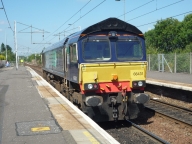
I took advantage of the good weather today to head off to Coatbridge Central and Holytown . Here are my photos from today.
Coatbridge Central
66426 4N76 Elderslie – Grangemouth Intermodal 13.00
66160 6S36 Dalston – Grangemouth Oil Tankers 13.14
66431 0M82 Carlisle Yard – Coatbridge Light Engine 13.58
86613+86638 0M11 Mossend – Coatbridge Light Engine 14.02
Holytown
92030 4S43 Daventry – Mossend Stobart Containers 14.49
66737 6E45 Fort William – North Blyth Alcans 14.57
92036 6S51 Carlisle Yard – Mossend Departmental 14.58
66597 6Z08 Ravenstruther – Longannet Loaded Coal 15.07
66525 6Z96 Leith – Killoch Loaded Coal 15.32
66506 4C07 Longannet – Ravenstruther Empty Coal 15.37
66431 4M82 Coatbridge – Daventry DRS intermodal 16.15
66595 4S41 Fiddlers Ferry – Hunterston empty coal 16.17
66545 6B34 Viewpark – Oxwellmains Cement Wagons 16.22

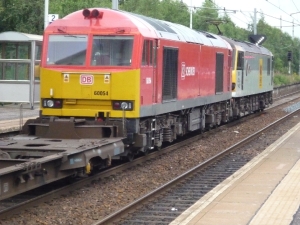
After missing 60054 on Friday, I wanted to make sure I didnt miss it today, so went to Holytown today to catch it being returned south DIT on 6O15 Mossend - Eastleigh Empty Cars. I wasnt dissapointed. Here it the photos
92037+600546O15 Mossend - Eastleigh Empty Cars
60054 shot of 60054 on its own
I visited Carstairs this afternoon to catch the Flask Train, and I wasn’t dissappointed. Even better was the appearance of 37419 which was the first time I’ve seen it in DRS livery. Incidentially the last time I saw 37419, it was being hauled north by 92031 after it broke down on its debut (and only appearance) in DB Schenker livery.
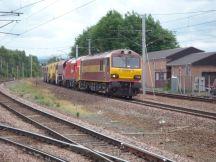
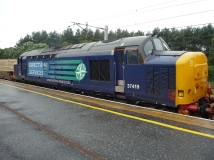
Sightings from today were:
37682+37419 6M22 Hunterston – Sellafield Neuclear Flasks 15.20
66515 4S41 Fiddlers Ferry – Hunterston Empty coal 15.23
92003 6S94 Dollands Moor – Irvine Slurry Tanks 15.55
37682
37419
the Boness Diesel Gala was held over this weekend.
There was 4 visiting Locomotives, these were newly restored and outshopped in BR Blue 26038, West Coast's BR Blue liveried 47270, GBRF liveried 66727 and Colas Rail 66850. In addition, a number of the home fleet were in use including 27001, 26024, 20020, D3558, D2767, 37175, 47643 and former Glasgow Blue Train 303032 which was seeing use for the first time since around 2005.
There was a number of highlights including the use of 47270, Class 08 shunter D3558 and Class 03 Shunter topping and tailing a service to Birkhill and the best of all, 303032 being worked in blue star mode by 26038, bringing back the memories of journeys into Glasgow on 303's. Everything from the sound of the air braked being released, the warning sound for the doors closing, the sound of the motors and even the problems they had getting the air operated doors to close at Birkhill were just as I remembered them!
I took lots of photos. See my photos from the Gala Here
Just back my holidays to the Lake District and was at the Lakeside and Haverthwaite railway.
The Lakeside and Haverthwaite Railway is a 3 1/2 mile long railway to the south of Lake Windermere in the Lake District. It was originally a 7 mile long railway connecting with the line to Barrow in Furness at Ulverston. The railway closed in 1965 and re opened as a preserved railway in 1973. It had to be shortened as a road was built over the track bed in part.
The line has some interesting Locomotives including the only 2 remaining Fairburn 2-6-4's in preservation, 2 Bagnal 0-6-0T's and a Barclay's 0-6-0T and an 0-4-0T. A class 20, 26, 2 class 03's an LMS Class 11 and a Class 110 DMU make up the Diesel Fleet.
My photos are here
I'm just back from Budapest, here are my photos from the Budapest Tramway. This system has over 30 routes covering the city.
My photos feature the Picturesque route 2 (one of the worlds top 10 senic tram routes apparently) with photos of the home made Ganz cars on the 'tram embankment', out side the Parliament and at the Margaret Bridge Terminus. The equally Picturesque routes 19 and 41 on the other side of the Danube, Siemens Combino's (the longest trams in the world) on routes 4 and 6 on the Margaret Island Bridge, more Ganz cars on the Small Boulevard routes 47 and 49. Finally some Tatra's on the not so picturesque terminus of route 14 at Lehel Ter.
Here are todays sightings
Boness
Holytown
66736 6S45 Fort William – North Blyth Alcans 14.57
92031 6S51 Carlisle – Mossend Departmental 15.01
390112 London Euston – Glasgow Central 15.05
66552 4C07 Longannet – Ravenstruther Empty Coal 15.41
66154 0L97 Carlisle Yard – Mossend Light Engine 15.50
320320 Milngavie – Lanark 15.56
66304 4M82 Coatbridge – Daventry DRS Intermodal 16.14
66545 6B34 Viewpark – Oxwellmains Cement 16.22
66518 6Z96 Leith – Killoch Coal 16.26
Carstairs
47805 tnt 47790 1Z59 Helensburgh – York Northern Belle 20.00
86609+86622 4L81 Coatbridge – Tilbury Freightliner intermodal 20.06
I went to Coatbridge Central today to catch 6D18 the Grangemouth – Mossend tanks, however they didn’t turn up. However I did see
66427 4M82 Coatbridge – Daventry DRS Intermodal 15.55
Then I moved to Bargeddie to catch 66719. Here are my sightings
66509 Unidentified westbound coal working 16.25
66719 5Z56 Glasgow Works – Bridgeton Yard TTA move 16.28
Spent the afternoon at a soaking wet Holytown. Here are my sightings
92041 6S51 Carlisle Yard – Mossend Departmental 14.55
390112 London Euston – Glasgow Central 15.03
*unusual to see a pendilino operate via Holytown especially during the day*
320322+318257 Lanark – Milngavie 15.18
320308 Milgavie – Lanark 15.55
66305 4M82 Coatbridge – Daventry DRS Intermodal 16.12
*was fully loaded*
66545 6B34 Viewpark – Oxwellmains Empty Cement 16.22
*unusually had cargowagons as well as cement tanks in consist, had to slam brakes on approaching the 20 mph speed restriction at the Shotts Junction*
66554 4S41 Rugeley – Hunterston empty coal 16.22
92019 6S94 Dollans Moor – Irvine Slurry Tanks 16.50
Metronet liveried 66719 and GBRF liveried 66736 were seen today heading west through Cleland Station on the Glasgow – Edinburgh via Shotts line in the pouring rain whilst working 0S66 Doncaster – Bridgeton Yard. 66736 is expected to head up the West Highland Line to remove the Alcan tankers rescued from the Tulloch Derailment back to Fort William, whilst 66719 is expected to work to Kilmarnock to collect a refurbished class 334.
GWR Castle 5043 ‘Earl of Mount Edgcumbe’ in British Railways Green Livery made its way to Edinburgh today from Tylsley as 1Z22 Tylsley – Edinburgh Vintage Trains Castle to Scotland Tour. Heading north in Glorious Sunshine 5043 with 47760 in tow as back up, was complete with a set of chocolate and cream coaches.
Here is 5043 at Abington
Photo 1, Photo 2, Photo 3, Photo 4, Photo 5
and at Carstairs
Photo 1, Photo 2, Photo 3, Photo 4
The Superb looking A4 no 4464 ‘Bittern’ in LNER Blue was operating on a tour of the Fife Circle this afternoon / evening with 1Z42 Edinburgh – Edinburgh via Alloa ‘Cathedrals Explorer’ by Steam Dreams.
Here it is at Dalmeny (South of the Forth Rail Bridge) Photo 1, Photo 2
and here it is at Polmont Photo 1
Here is a selection of 158′s and 170′s from Dalmeny and Polmont
158731, 158736, 170416, 170421, 170473, 170478
Finally from yesterday at Carstairs
66429 4M82 Coatbridge – Daventry DRS Intermodal
66555 4S41 Fiddlers Ferry – Hunterston empty Coal
Didn’t have too long today so went to Holytown for the very busy 3 freights in 15 minutes period. Here’s my sightings
66735 6E45 Fort William – North Blyth Alcans 14.45
92031 4S43 Daventry – Mossend Stobart Containers 14.48
320321+318263 Milngavie – Lanark 14.50
92041 6S51 Carlisle Yard – Mossend Departmental 14.53
There is a Colas Route Learner coming north tomorrow as they have won the tender to operate the Prestwick Airport, Linkswood and Sinfin (Derby) Oil Tankers. The route learner is travelling from Carlisle Kingmoor - Fouldubs Junction then from Fouldubs Junction to Motherwell TMD. Key times for the Lanarkshire area is are Carstairs 11.08, Motherwell 11.27, Coatbridge Central 11.42 for the northbound journey and 1.45 at Coatbridge Central for the return journey. As yet it is uncertain as to what traction will be in use, however it is likely to either be a 47 or a 66. (A 56 would be great!)
I went to Holytown this afternoon, here are my sightings
92036 4S43 Daventry – Mossend Stobart Containers 14.50
318257+252 Milngavie – Lanark 14.52
66735 6E45 Fort William – North Blyth Alcans 14.56
92031 6S51 Carlisle Yard – Mossend Departmental 14.59
A quick visit to Coatbridge Central for
66102 6D18 Grangemouth – Mossend Empty tanks 15.43
then the hail stones started so headed home and stopped back at Holytown for
66428 4M82 Coatbridge – Daventry DRS Intermodal 16.11
334032 Lanark – Milngavie 16.17
Was out and about yesterday and saw some more engineer workings, these were
66106 with coalfish at Carstairs
66132 with coalfish at Abington
66103 with coalfish between Abington and Crawford
Later in the afternoon and Euroshed 66249 was spotted stabled in Falkland Yard at Ayr.
Onto today and I headed to a wet, cold and miserable Carstairs. Spotted were
37069+608 1Z22 Dumbarton Central – Exeter St Davids Pathfinders Railtour Easter Chieftain
66106 unidentified light engine working
66111 4S43 Daventry – Mossend Stobart Containers (with 66 vice 92)
Then moved up to Holytown where the weather had improved and caught
66301 4M82 Coatbridge – Daventry DRS intermodal
334035 15.53 Lanark – Milngavie
92042 6S51 Carlisle Yard – Mossend Departmental
I decided to take a trip south to the Kirkby Stephen Vintage Vehicles Rally today. Enroute, I stopped off at Carlisle Kingmoor, spotted there was
37401, 37406, 37410, 37411, 37416, 37417, 37426, 37427, 37612, 37667, 57003, 57008
I then stopped off at Kirkby Stephen Station, it is one of the nicest stations I have seen. Here is 158794 arriving with a service for Carlisle. Next I went to the Stainmore railway at Kirkby Stephen. It was quite busy. Seen were
20169, 37146 31410, 37674, 47785, NER Fletcher 910 and FC Tingley
On the way home i nipped into the Eden Valley Railway at Warcrop to catch a photo of ex royal train loco 47799 and ex EWS 37042.
Heading back into Scotland I took the old A74 road home from the Beattock turnoff and spotted a number of engineering movements, these were
66187 6K10 Carlisle Yard – Beattock CoalFish (seen just north of Beattock)
66141 6K35 Carlisle Yard – Abington Down Loop Crane and Support Vehicles (Abington Loop)
66082 6K30 Carlisle Yard – Abington CoalFish (Abington)
66088 6K31 Carlisle Yard – Abington CoalFish (Abington)
66103 6K32 Mossend – Abington CoalFish (Wandel)
66132 6K38 Mossend – Abington CoalFish (Wandel)
Here are my sightings from Carstairs on Wednesday
185127 Manchester Airport – Glasgow Central 16.34
66304 4M82 Coatbridge – Daventry DRS Intermodal 16.46
221102 Birmingham – Glasgow Central 16.53
And here are todays sightings
156495 Edinburgh – Glasgow 14.35
156435 Glasgow – Edinburgh 14.43
92042 4S43 Daventry – Mossend Stobart intermodal 14.46
66735 6E45 Forth William – North Blyth Alcans 14.47
92030 (with 66106 DIT) 6S51 Carlisle Yard – Mossend Departmental 14.53
320314+320301 Lanark – Milgavie 15.14
66514 4C07 Longannet – Ravenstruther 15.34
Went to Holytown today for around 2 hours and saw 5 freights, these were
92015 4S43 Daventry- Mossend Stobart Intermodal 14.44
92011 6S51 Carlisle Yard – Mossend Departmental 14.58
66512 4C07 Longannet – Ravenstruther Empty Coal 15.42
70006 4S41 Rugeley – Hunterston Empty Coal 15.48
66432 4M82 Coatbridge – Daventry DRS Intermodal 16.22
I headed down to Wandel (about 1 mile north of Abington) today to see 70013 ‘Oliver Cromwell’ heading south with 1Z34 Edinburgh – Manchester Auld Reekie Railtour.
Here is 70013 at Wandel with 47760 on the rear.
Here is 70013 at Abington
On my way home, passing through Carstairs, 66523 was running round its train of empty coal hoppers before pulling into the sidings at Carstairs.
I went to Holytown for around 30 minutes this afternoon, as I got there 92037 was passing through with 4S43 Daventry – Mossend Stobart Containers, so didn’t get a picture. Passed at 14.50
Next up was 320312+318255 on a Milngavie – Lanark service, 320312 is one of the diminishing number of 320′s still in SPT livery and is named Sir William Alexander Smith, Founder of the Boys’ Brigade, hopefully it retains this name after its overhaul and relivery. Passed at 14.53
Hot on the heels of 320312+318255 was 66735 which crawled through the station heading onto the Edinburgh line with 6E45 Bridgeton Yard – North Blyth empty Alcans running approx 35 minutes early at 14.54.
Next was 92011 heading north through the station heading for Mossend yard with 6S51 Carlisle Yard – Mossend departmental with flats loaded with sleepers at 14.58.
Shortly after 66044 passed through with 4J74 Cockenzie – Hunterston empty coal at 15.03.
I nipped back at 16.15 and saw 334016 on a Lanark – Milngavie service at 16.16 followed by 66601 heading south on 6B34 Viewpark – Oxwellmains Cement train at 16.18.
In other news, DBS are exporting some of their class 92′s to Bulgaria, 92034 is said to be getting prepared to be the first to transfer.
Went to Holytown today as I heard that there were 2 92′s that I had never seen on 4S43 and 6S51, here are my sightings
320321 Lanark – Milngavie 14.13
156505 Glasgow Central – Edinburgh Waverley 14.25
92036 4S43 Daventry – Mossend Stobart Containers 14.47
66737 6E45 Fort William – North Blyth Alcans14.54
92030 6S51 Carlisle Yard – Mossend Departmental 14.54
66122 4J74 Cockenzie – Hunterston empty coal 15.00
156494 Glasgow Central – Edinburgh Waverley 15.25
Unfortunately I got bowled with 66737 and 92030 arriving at the same time got a good photo of 66737 but not 92030.

